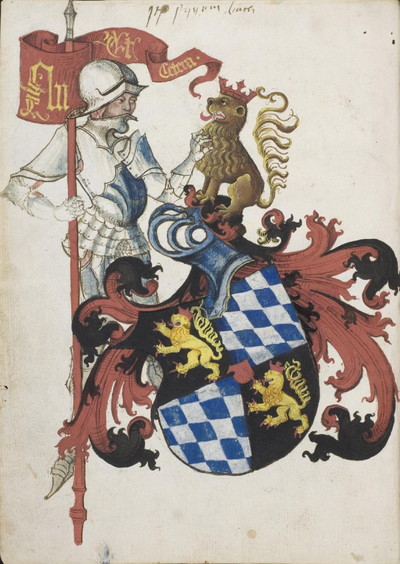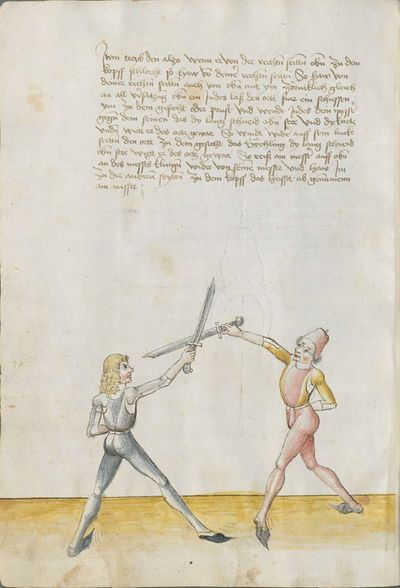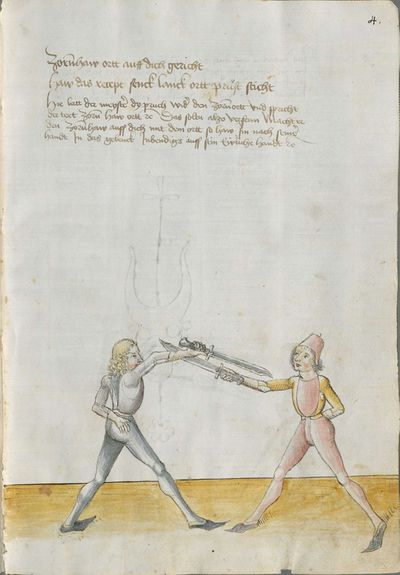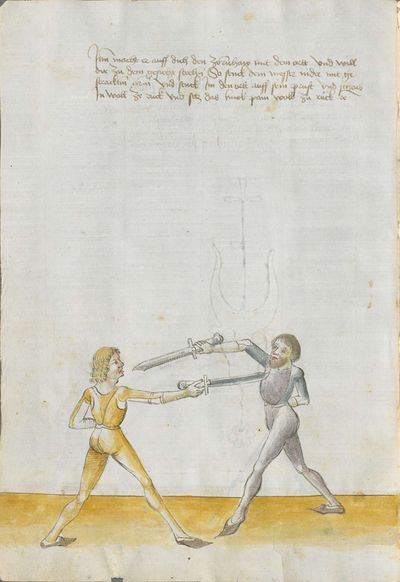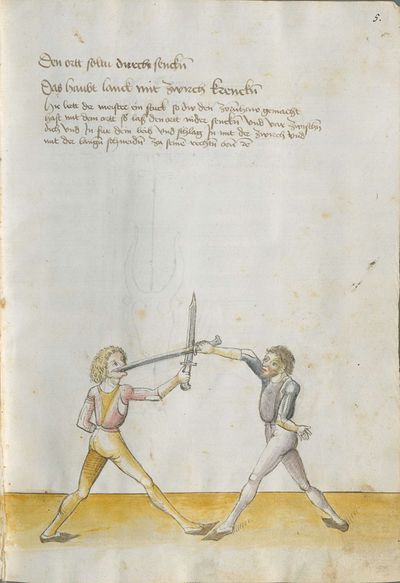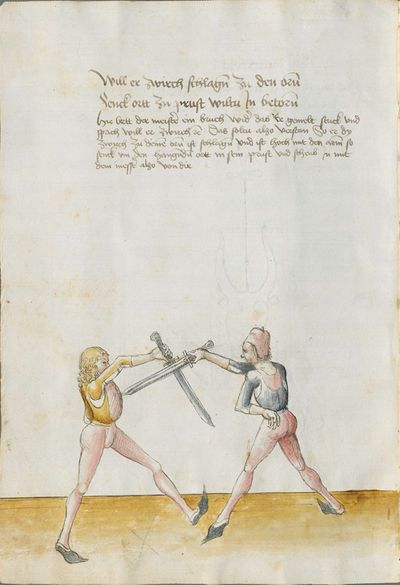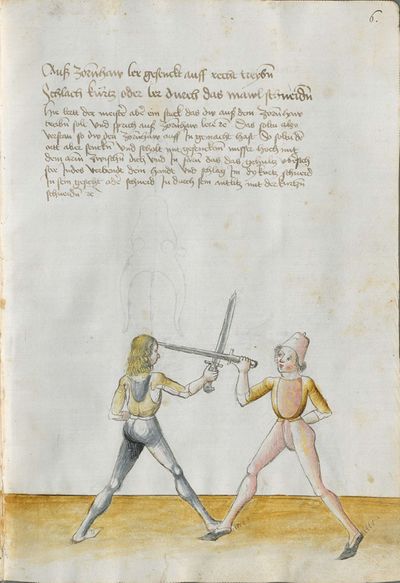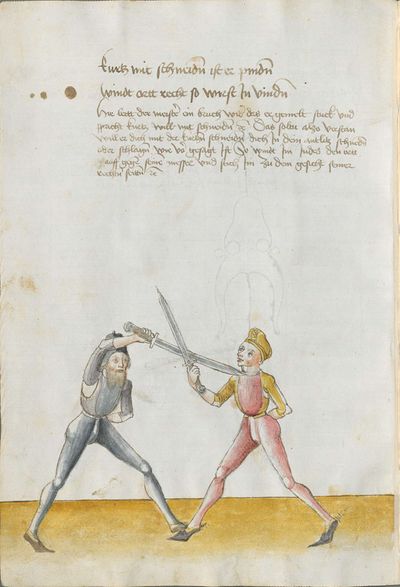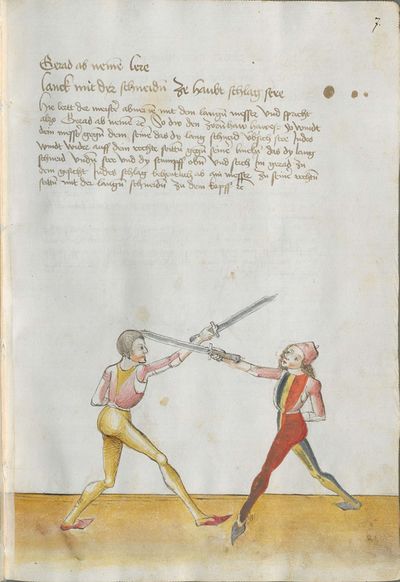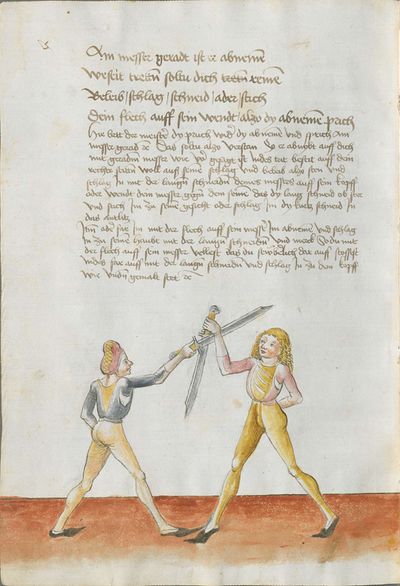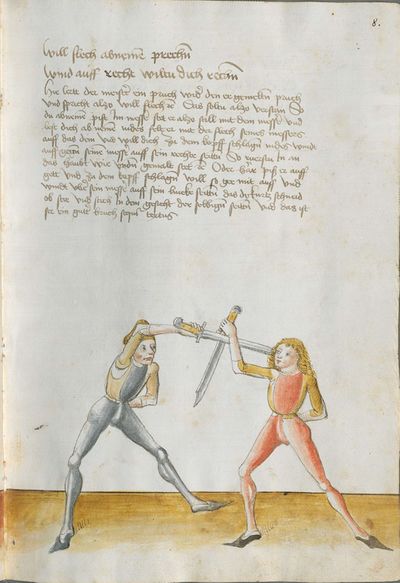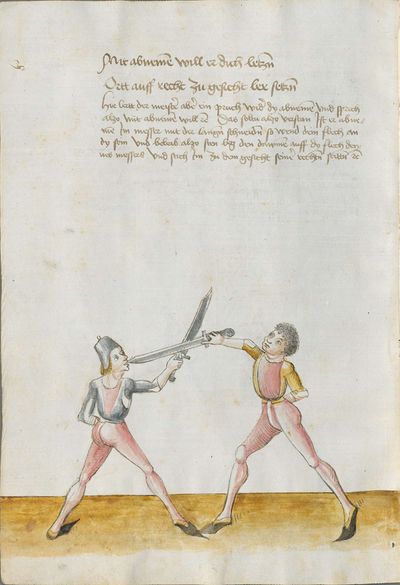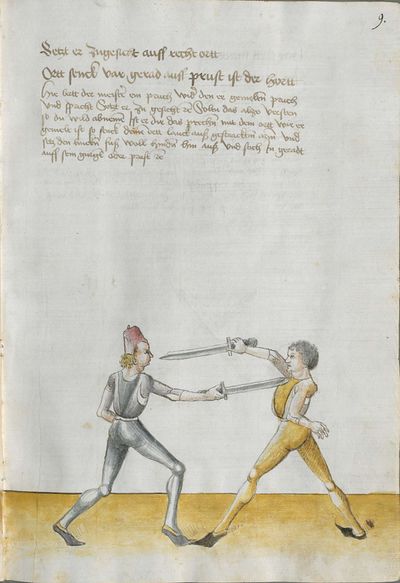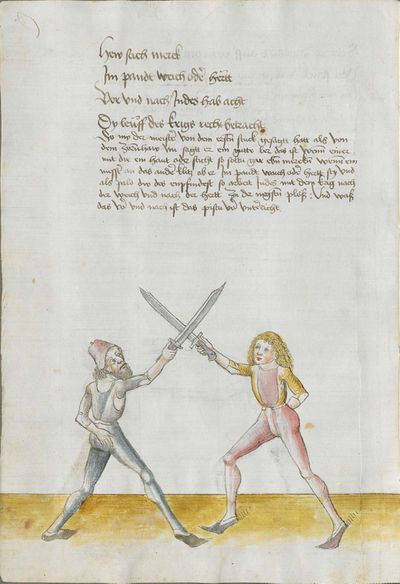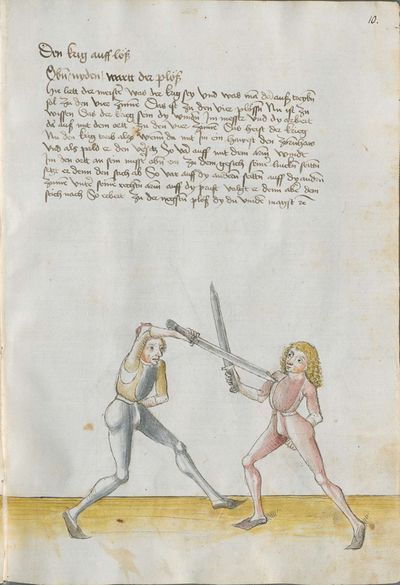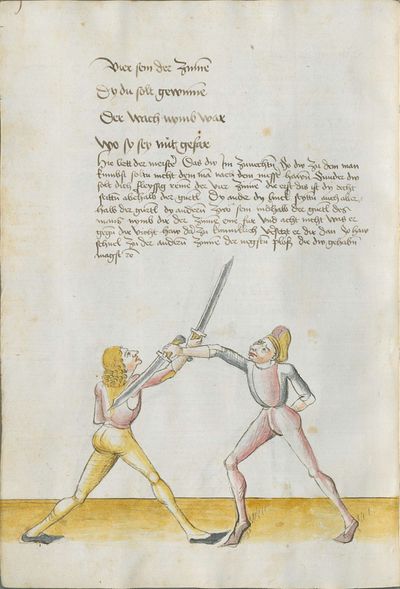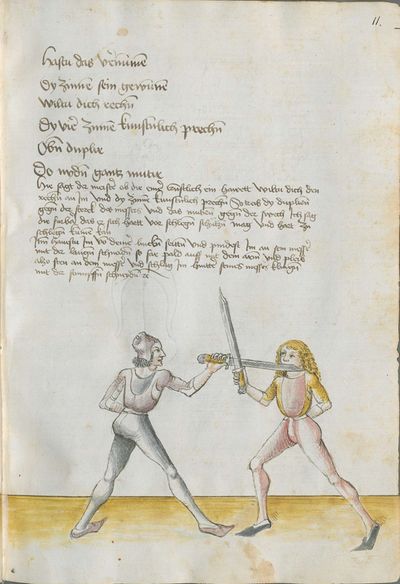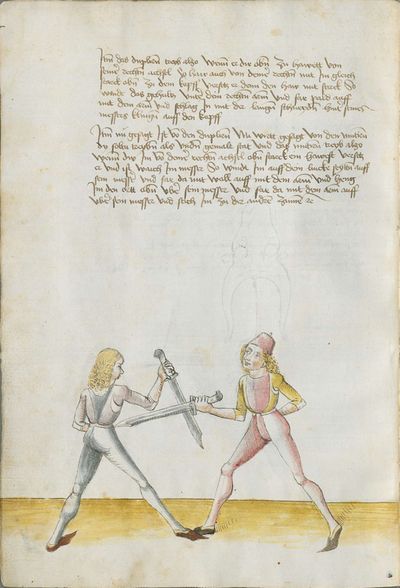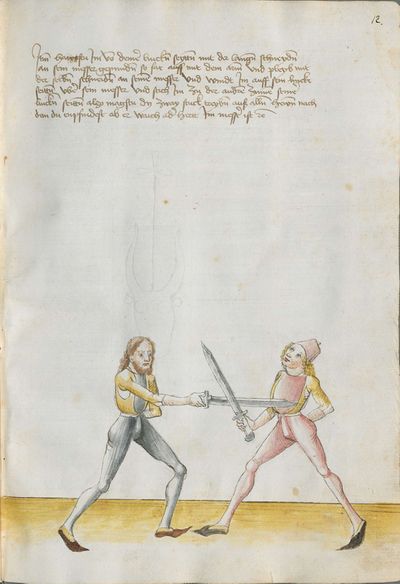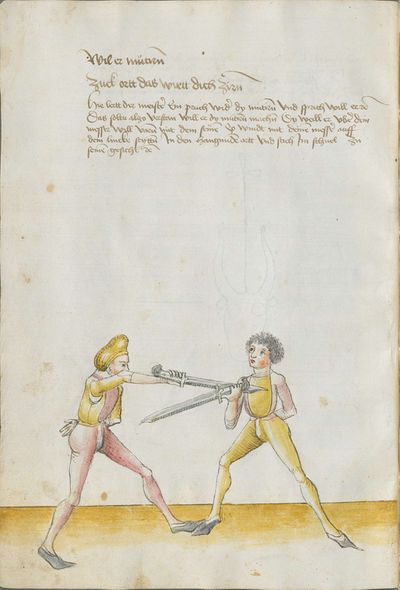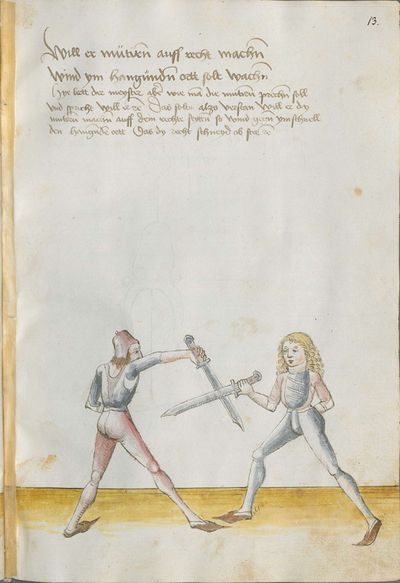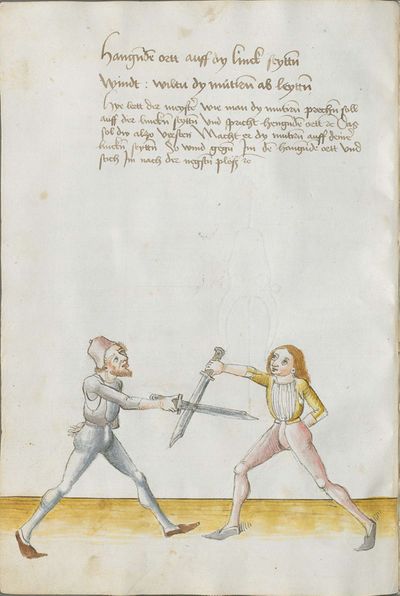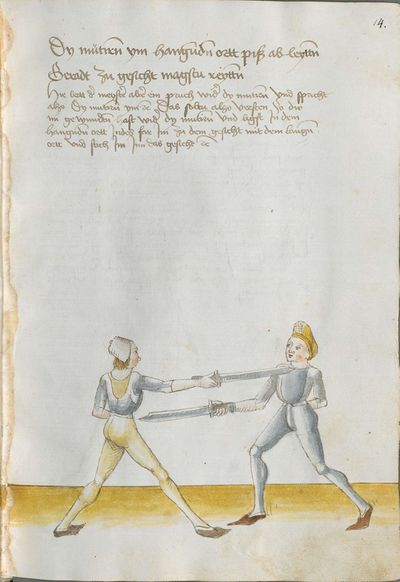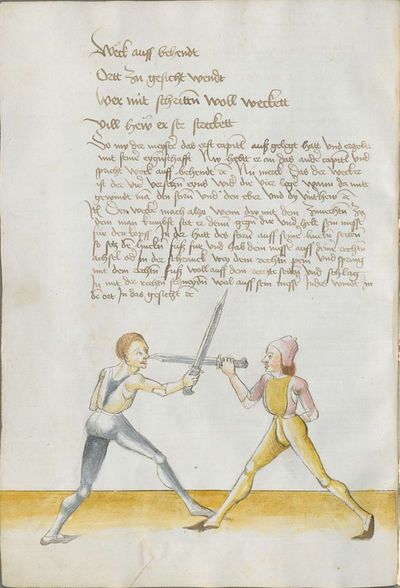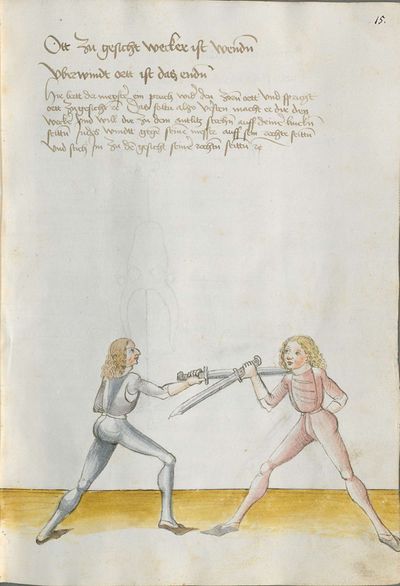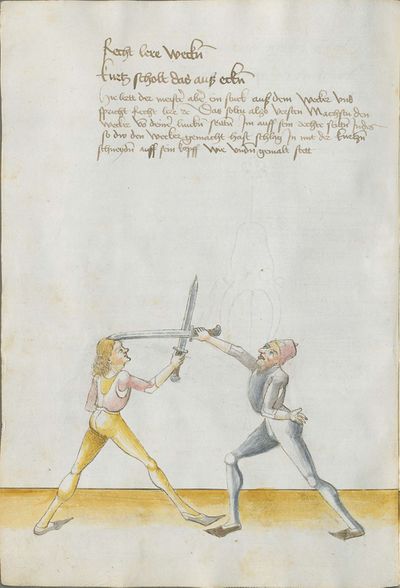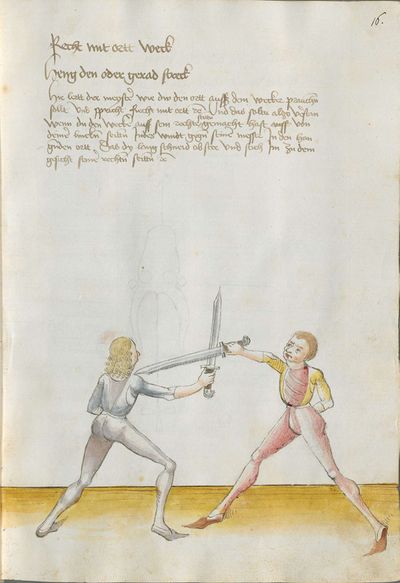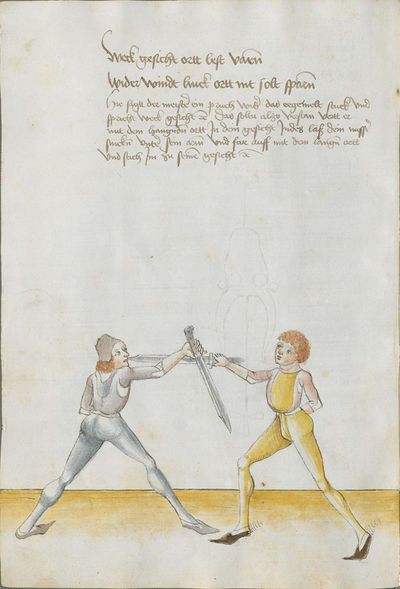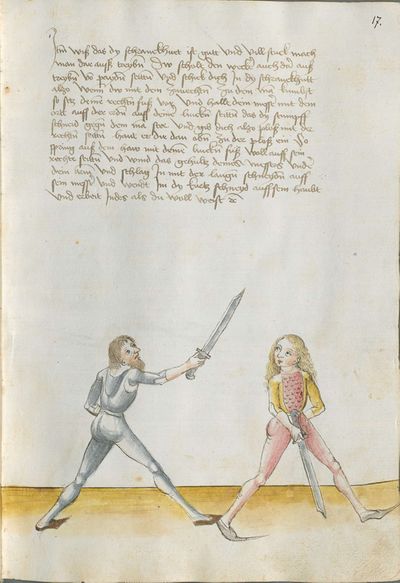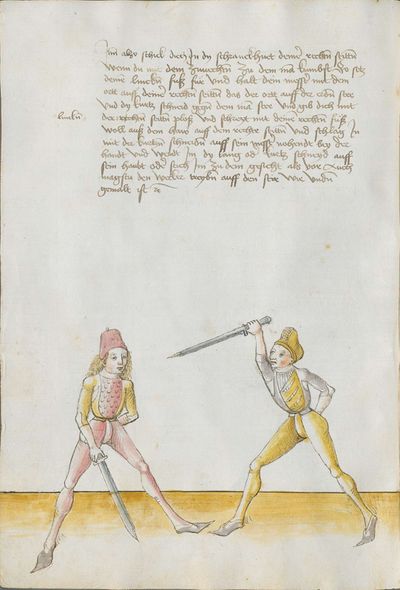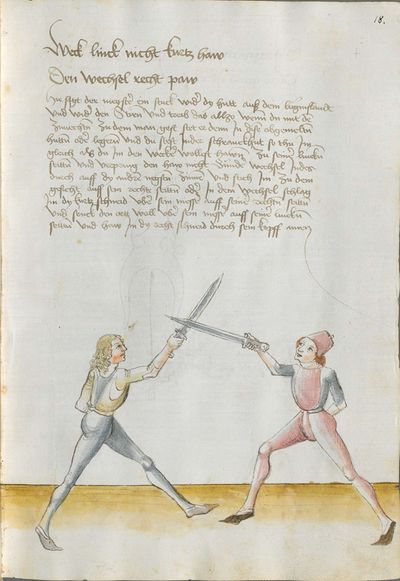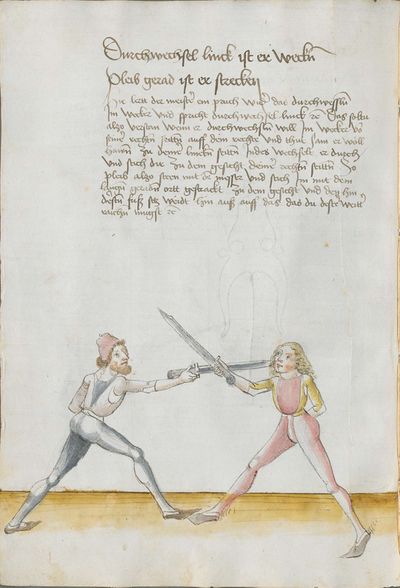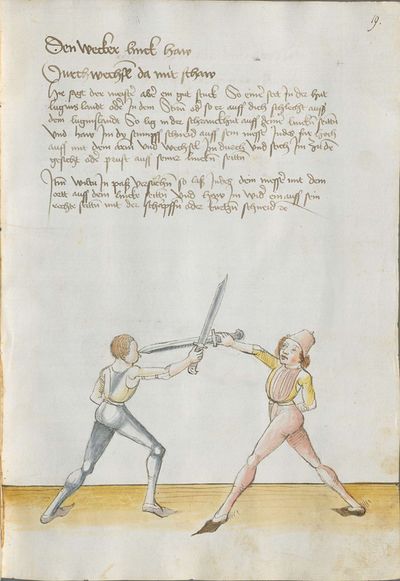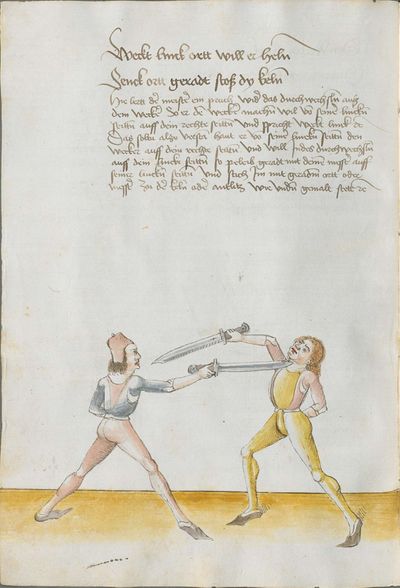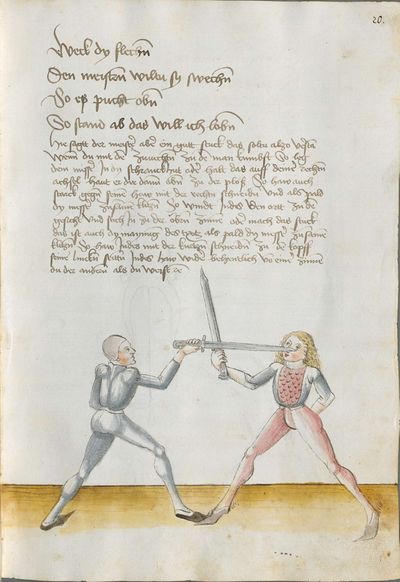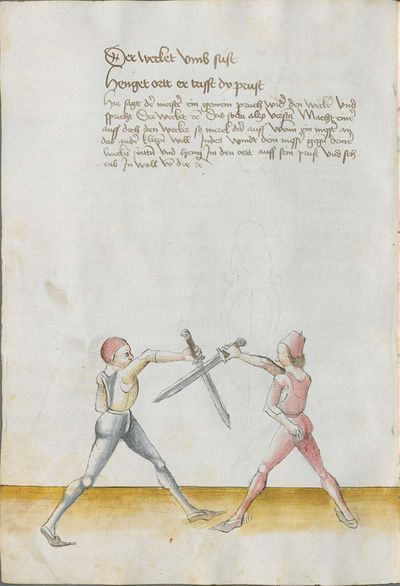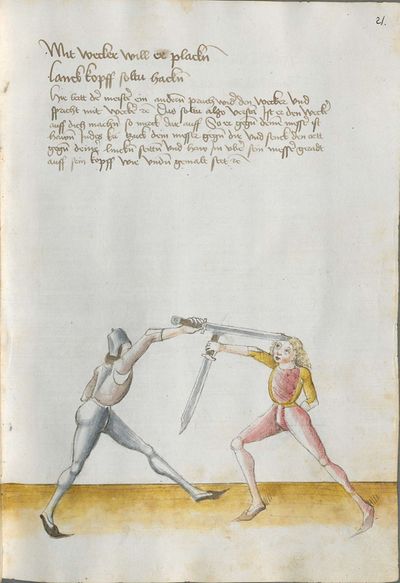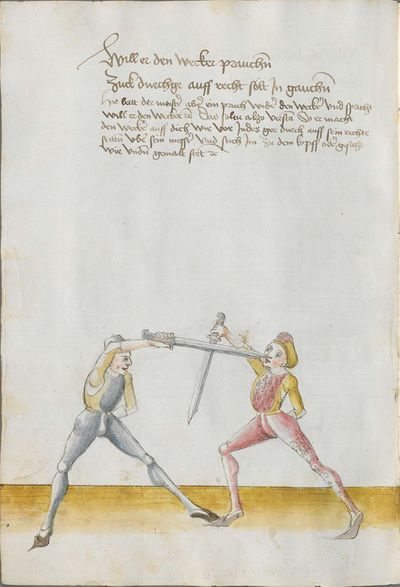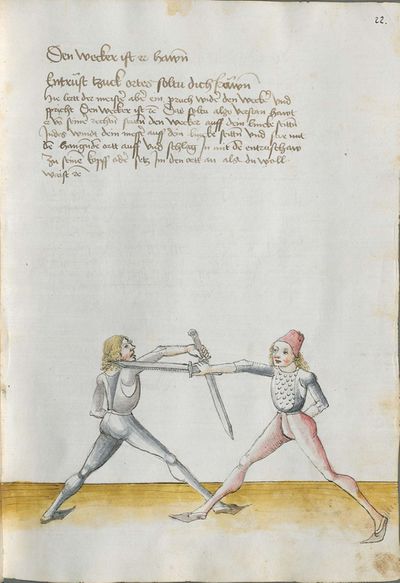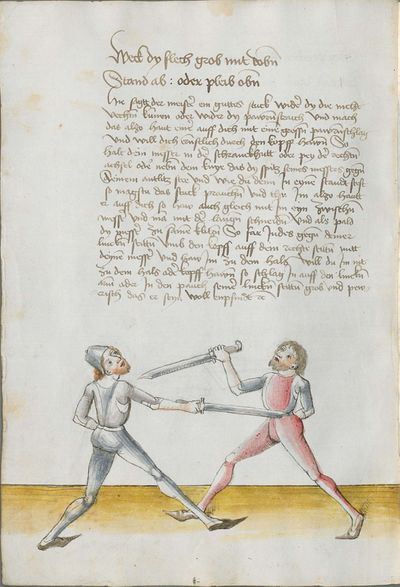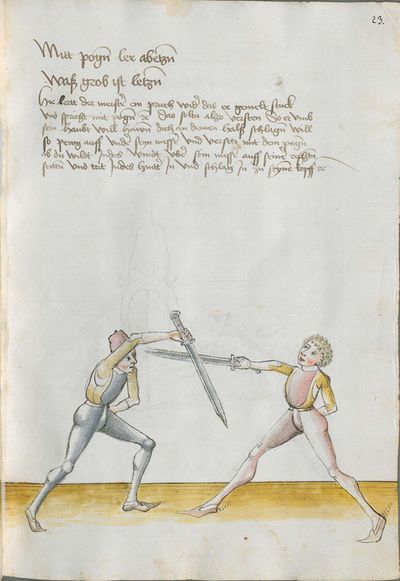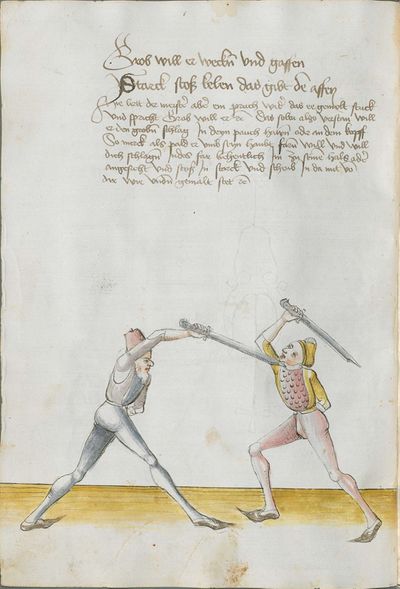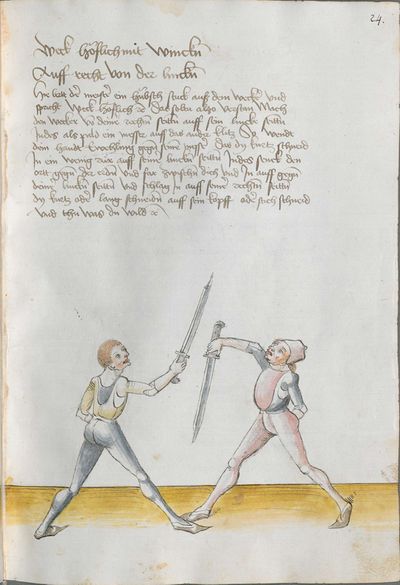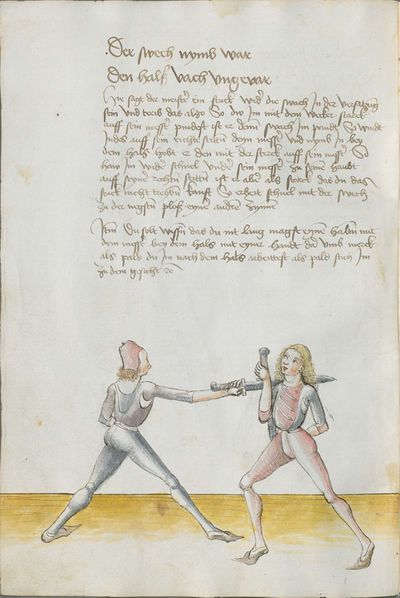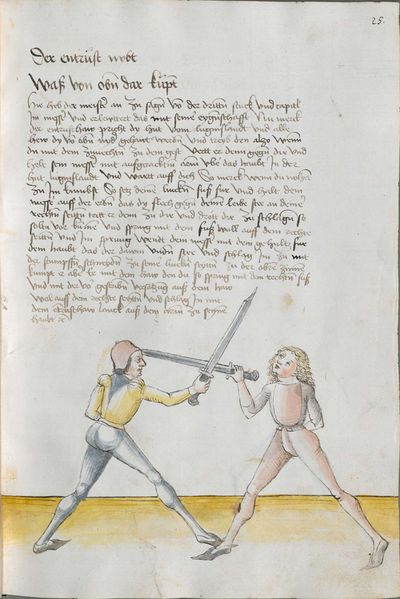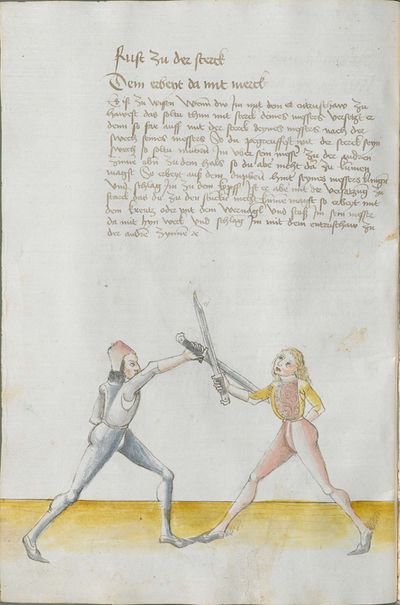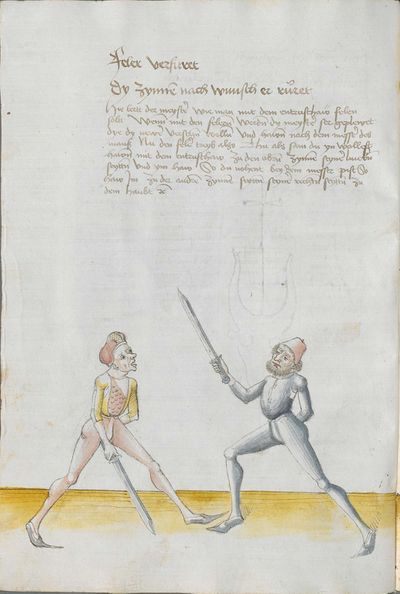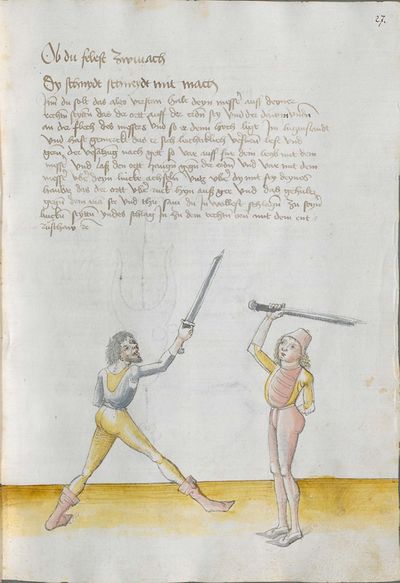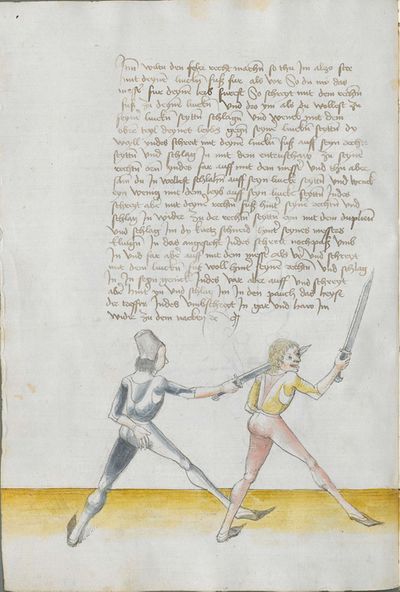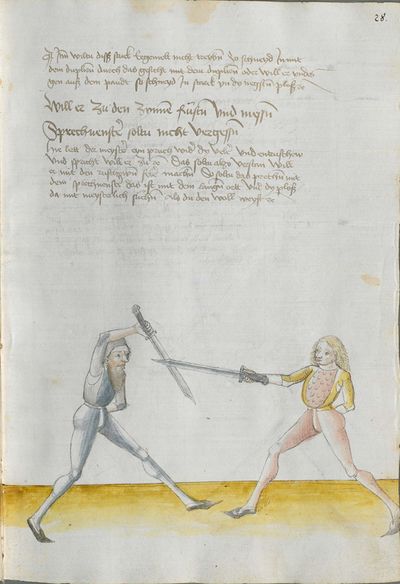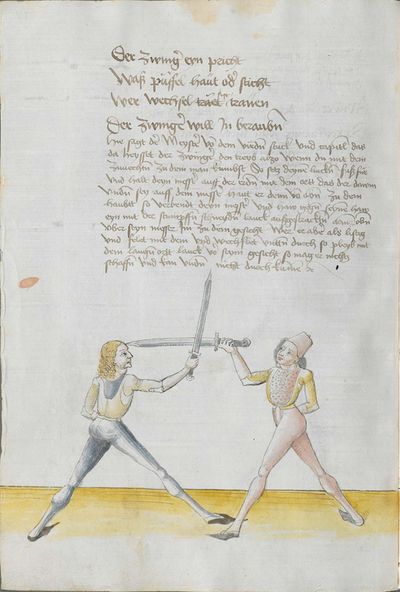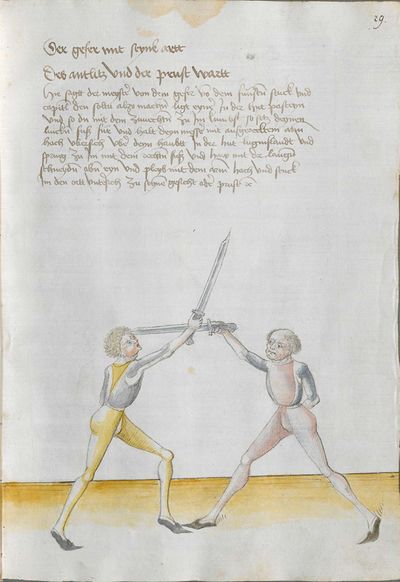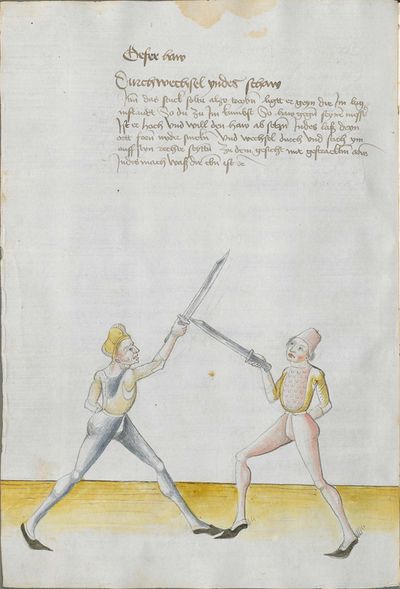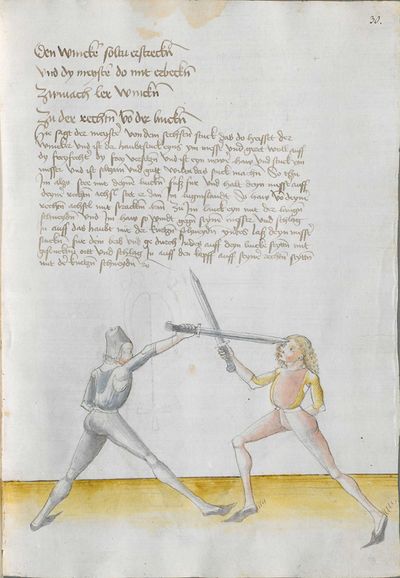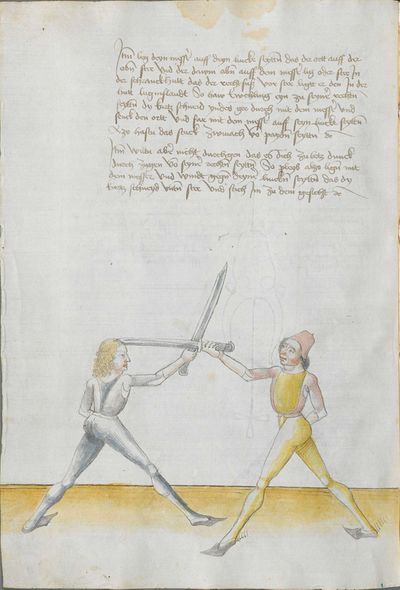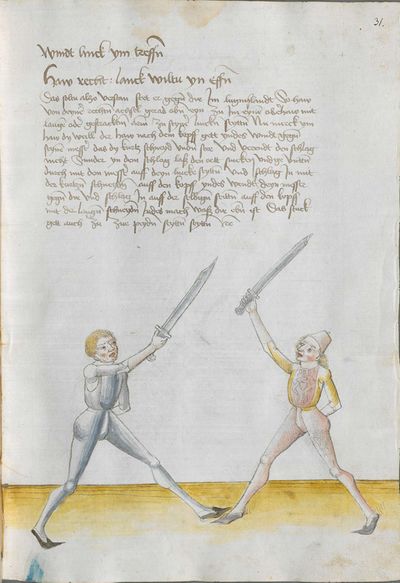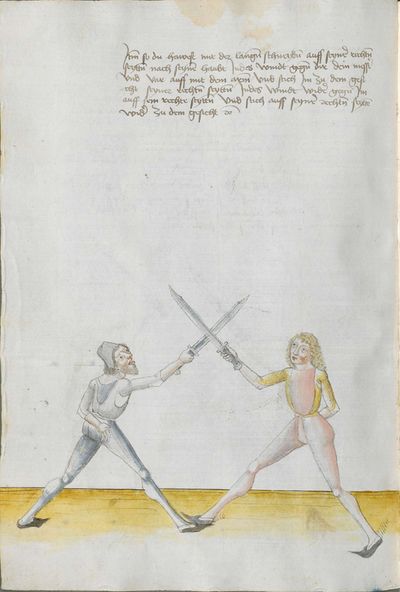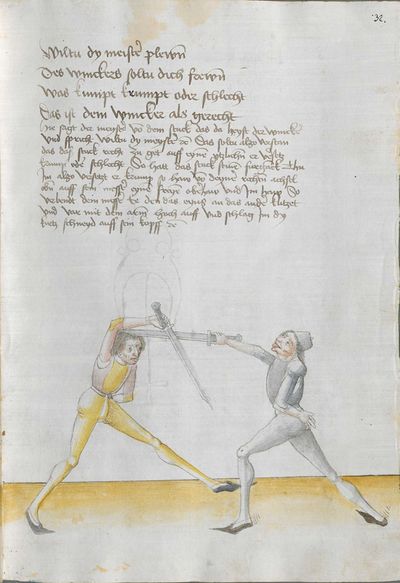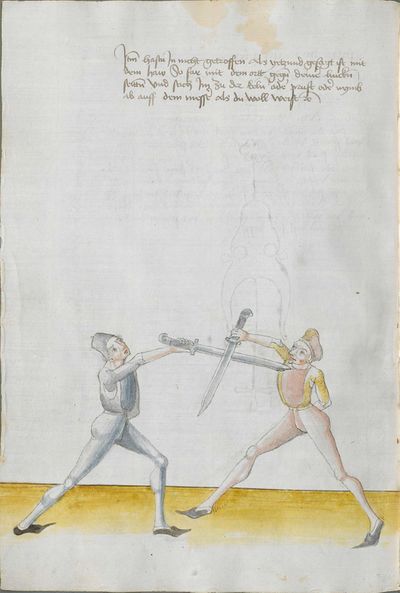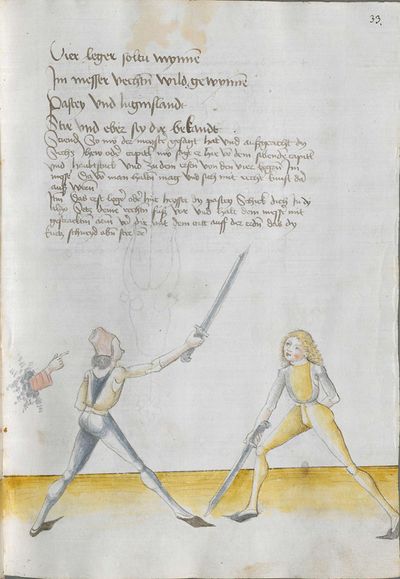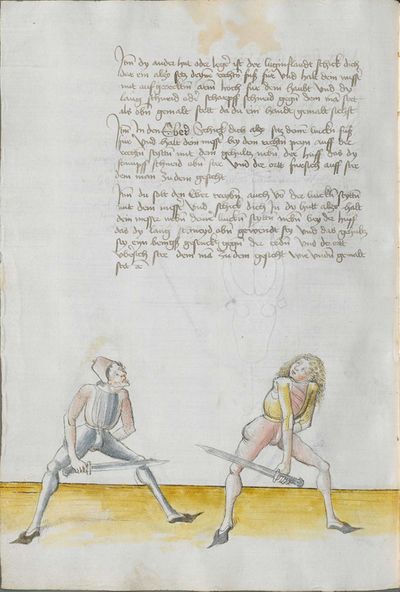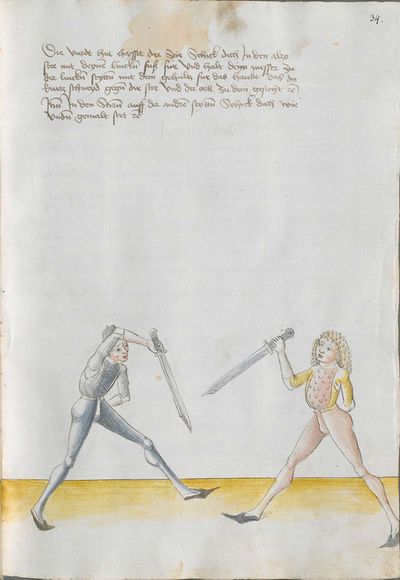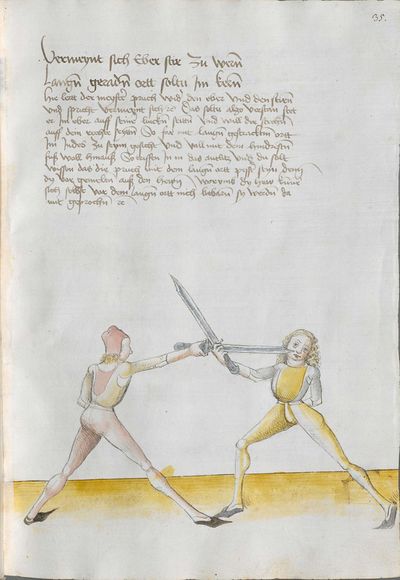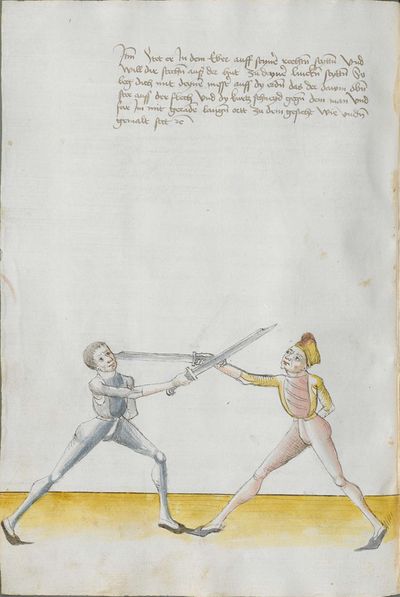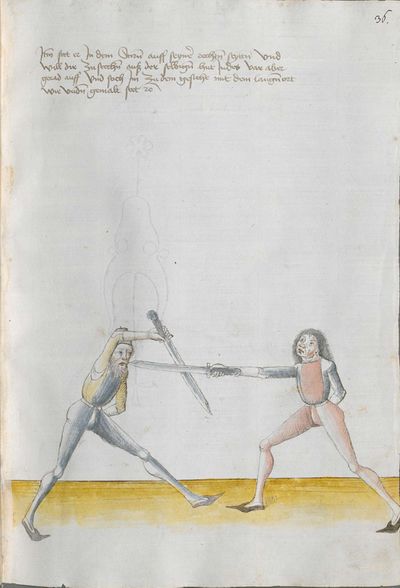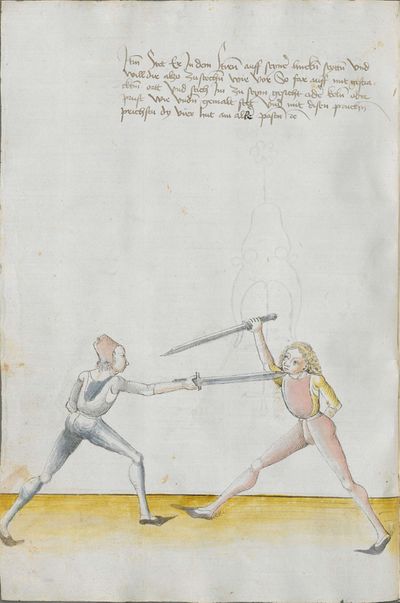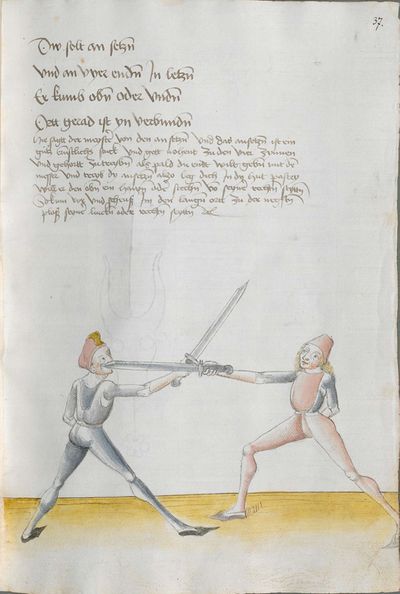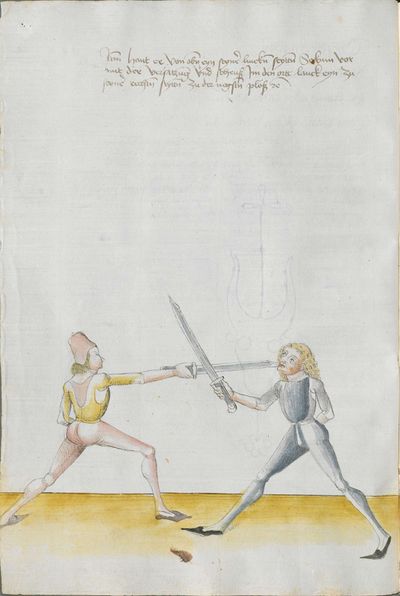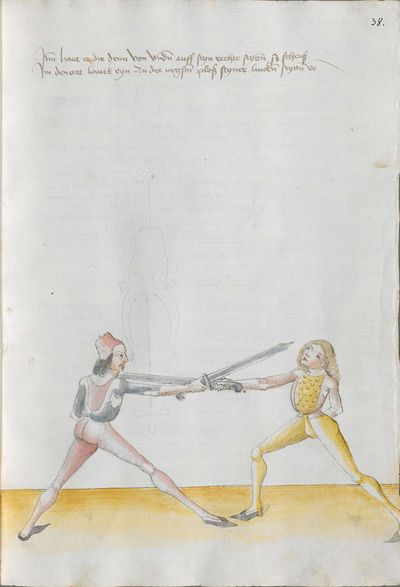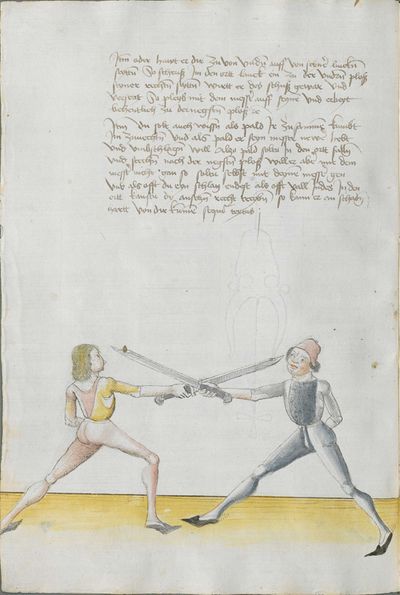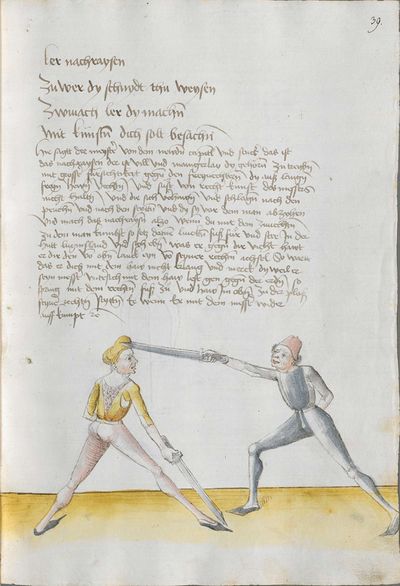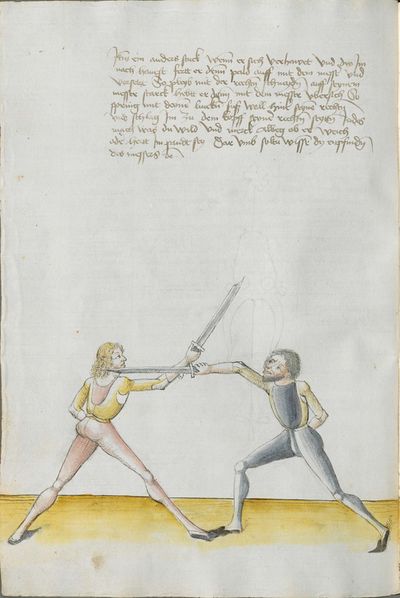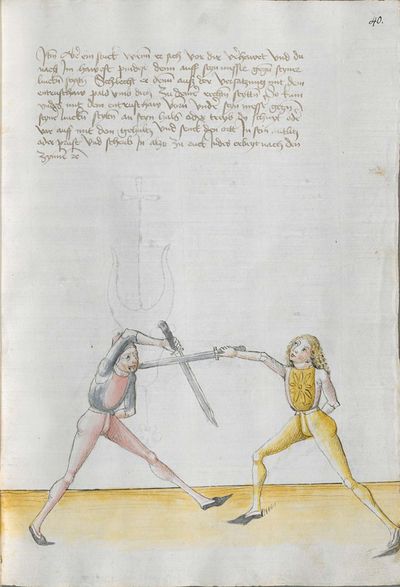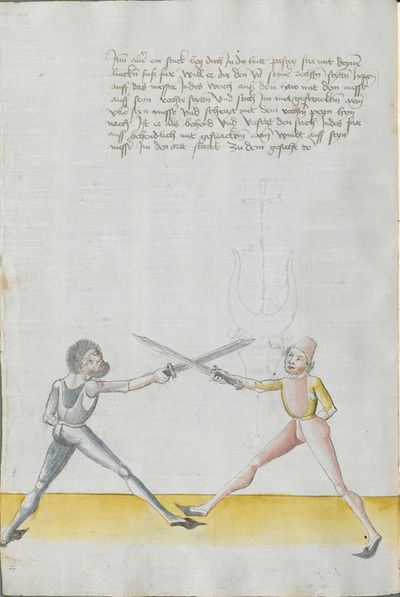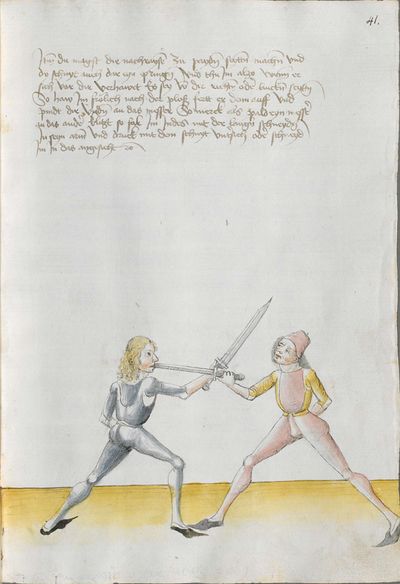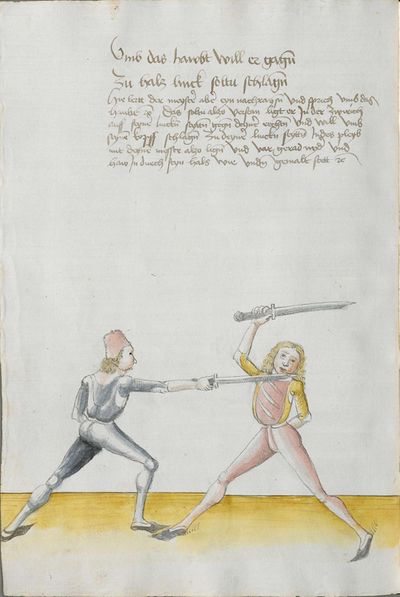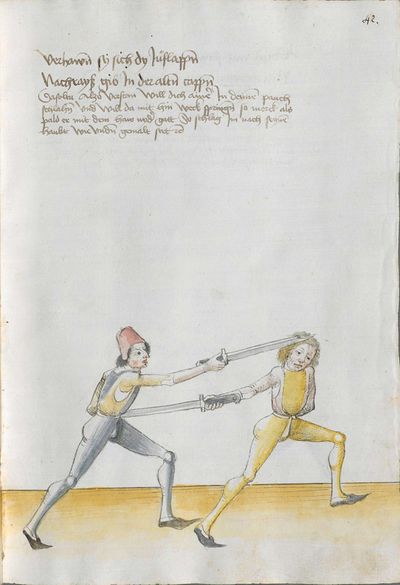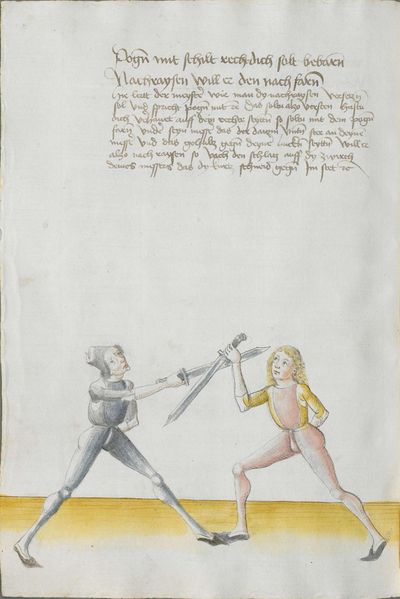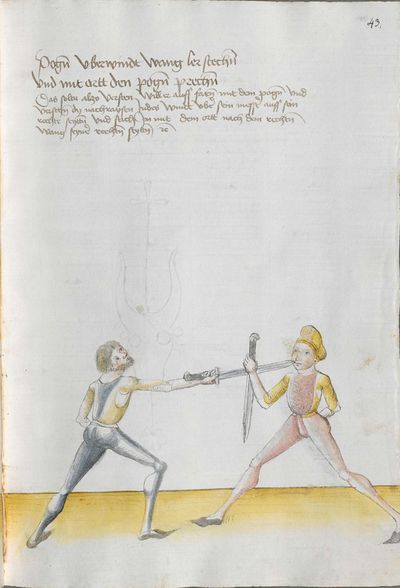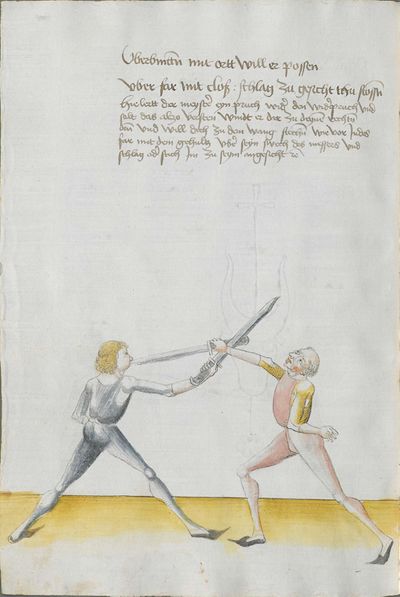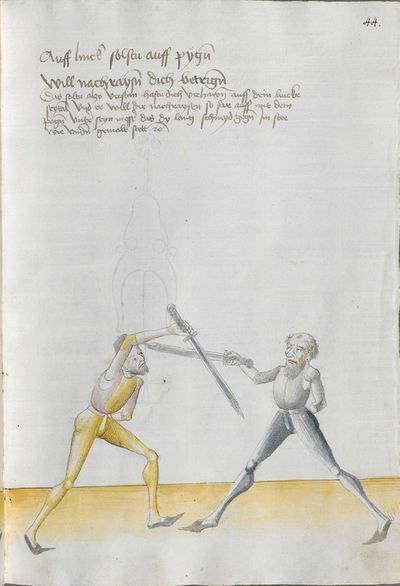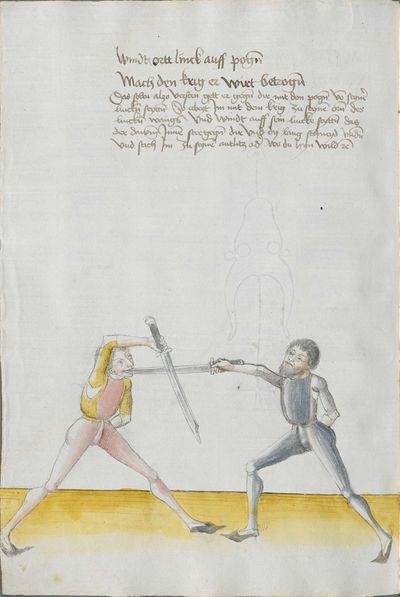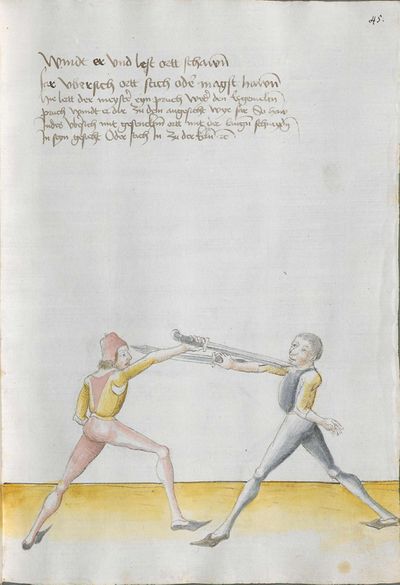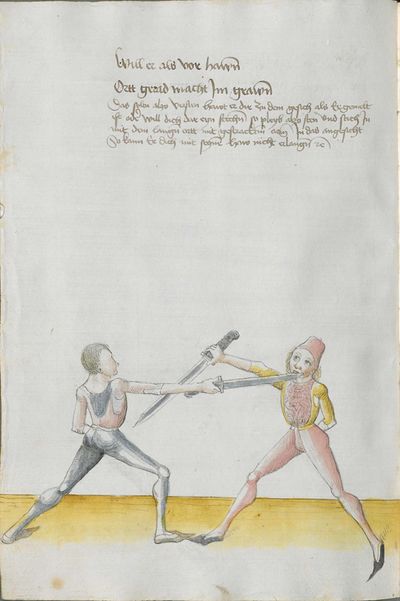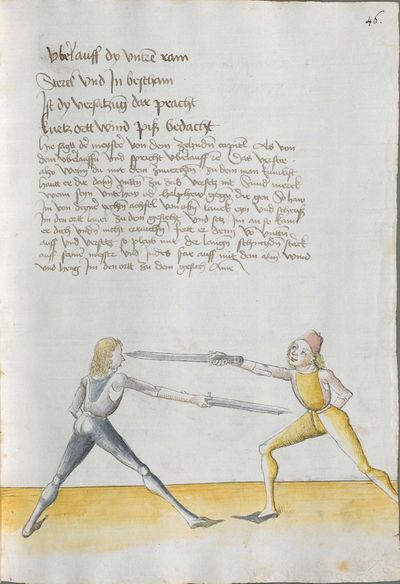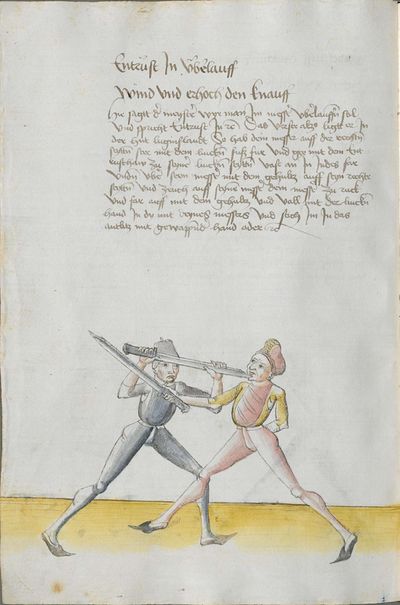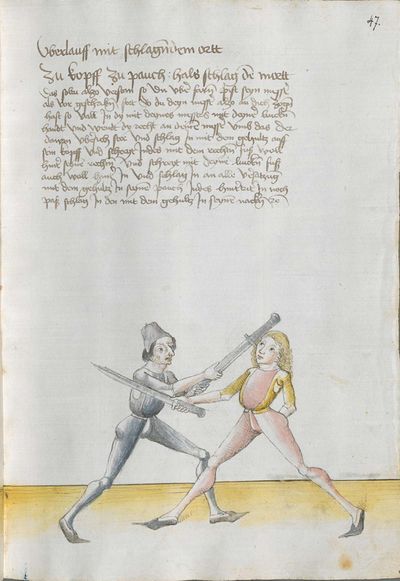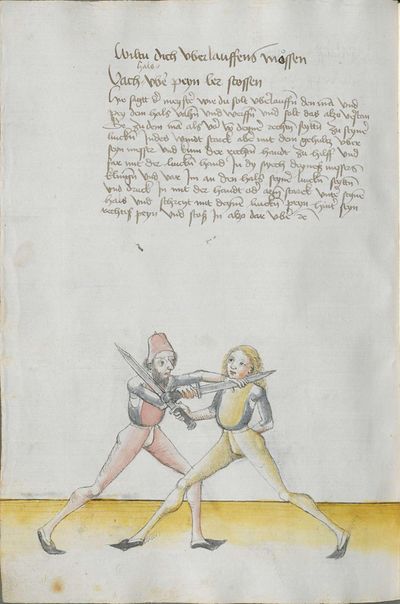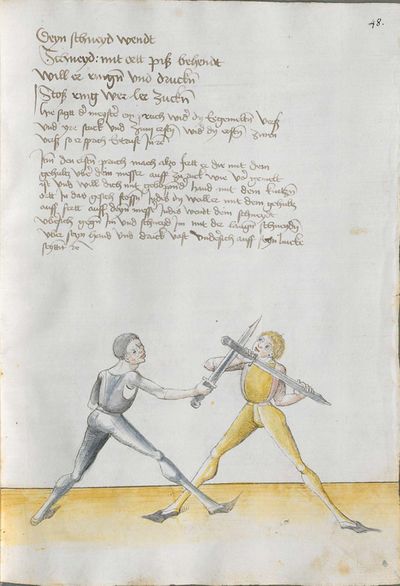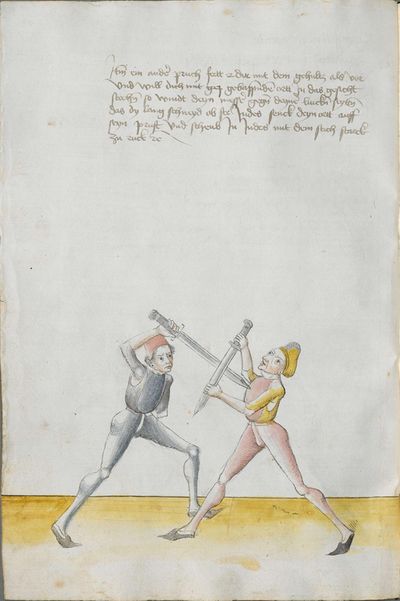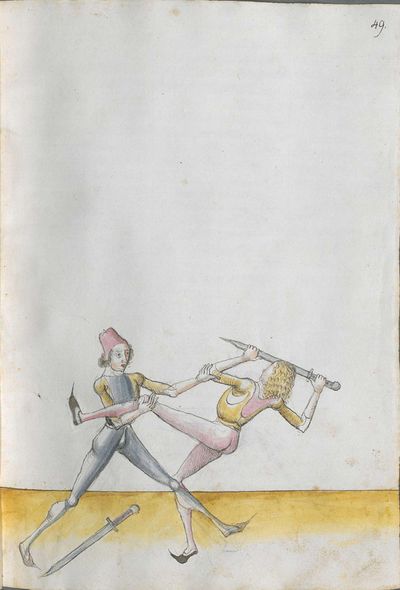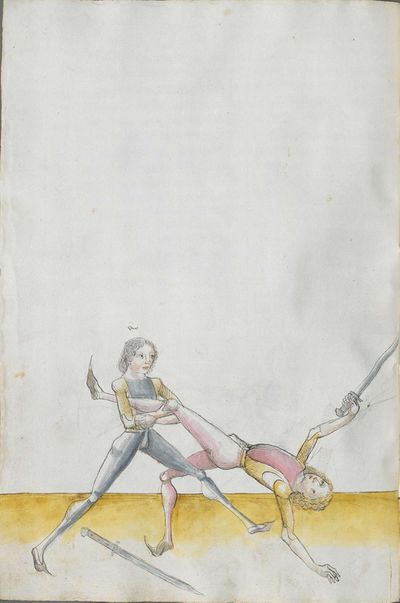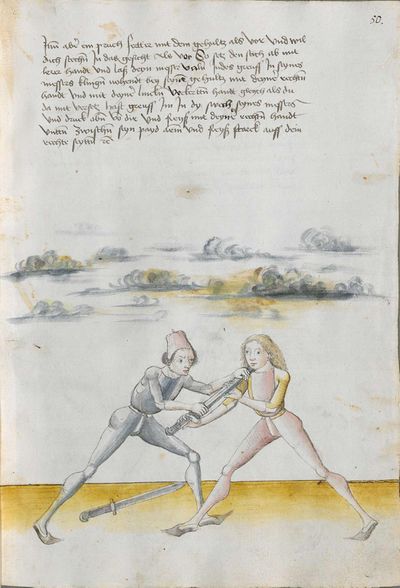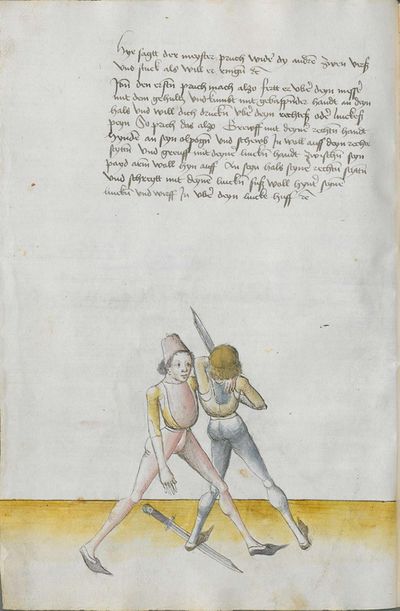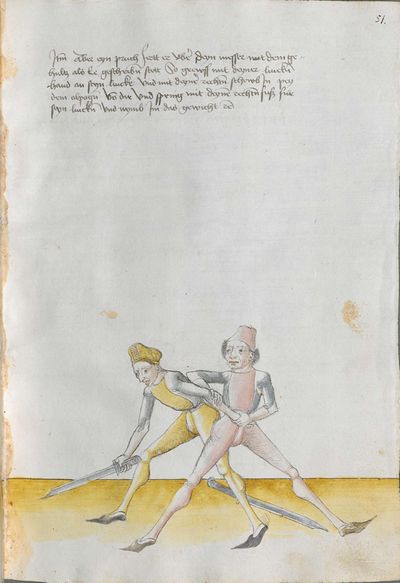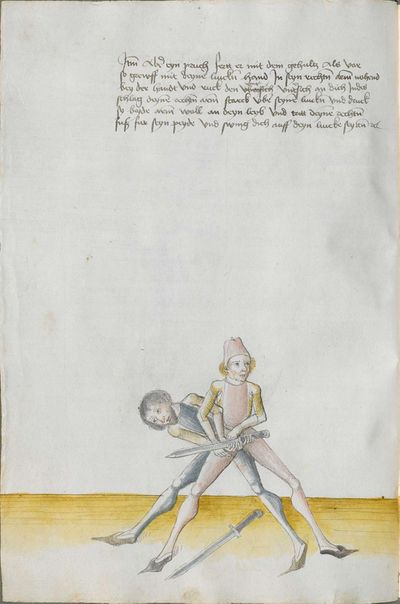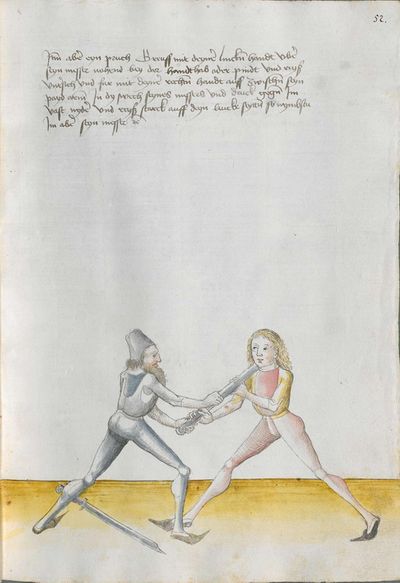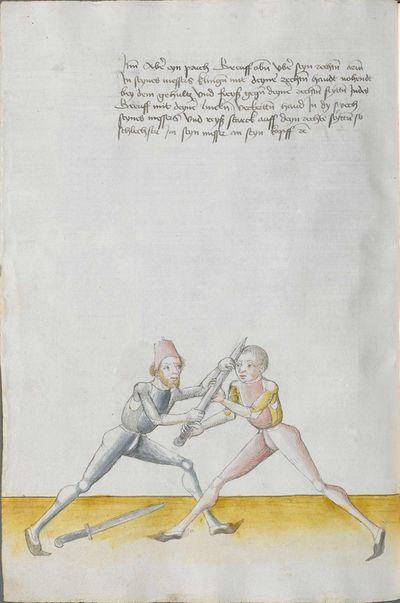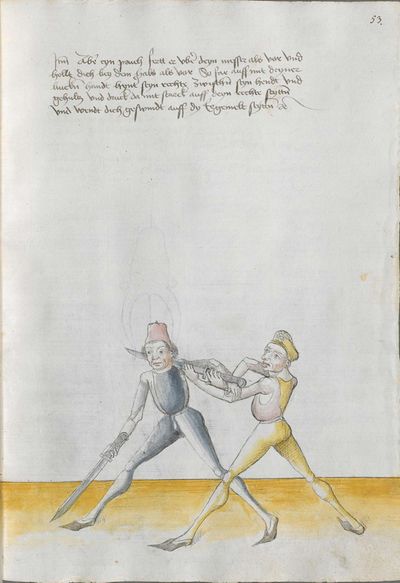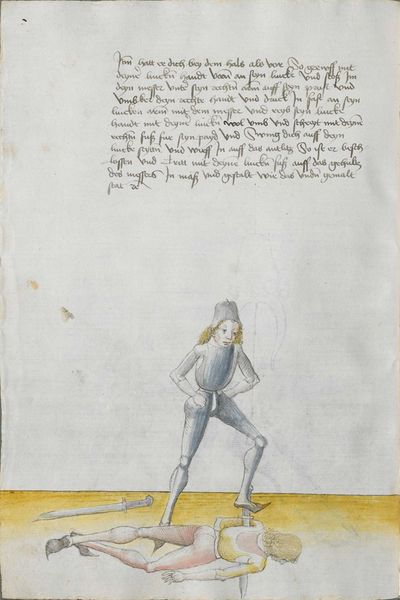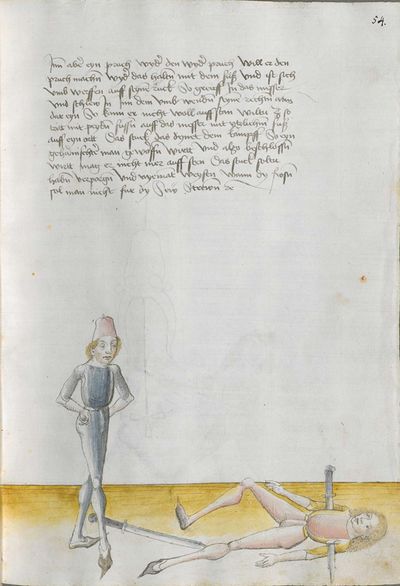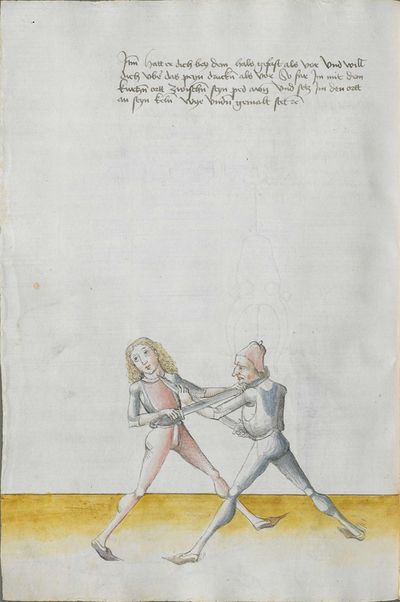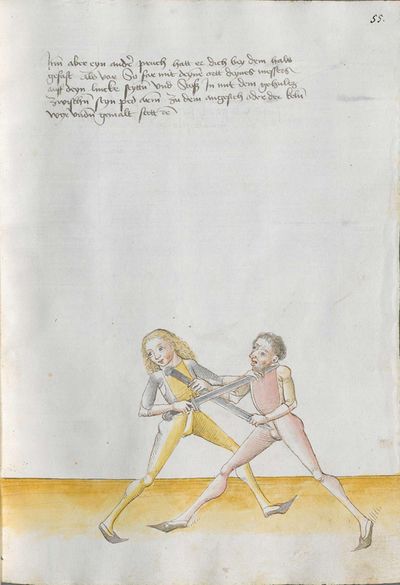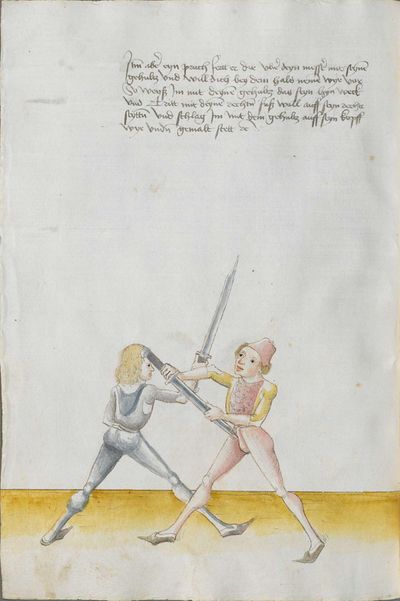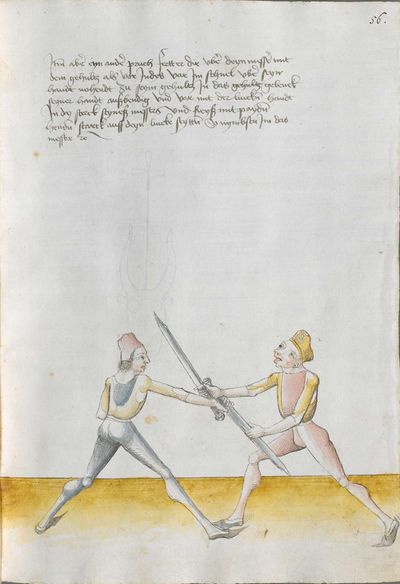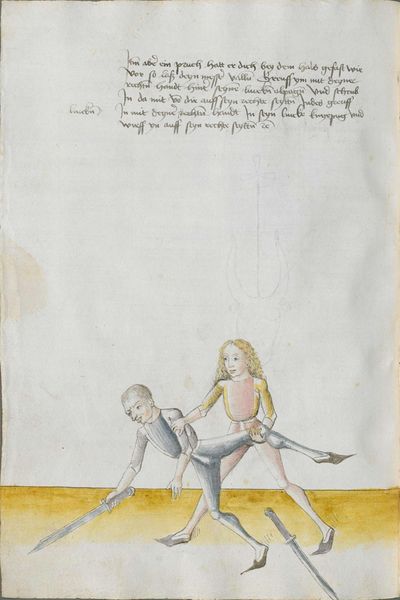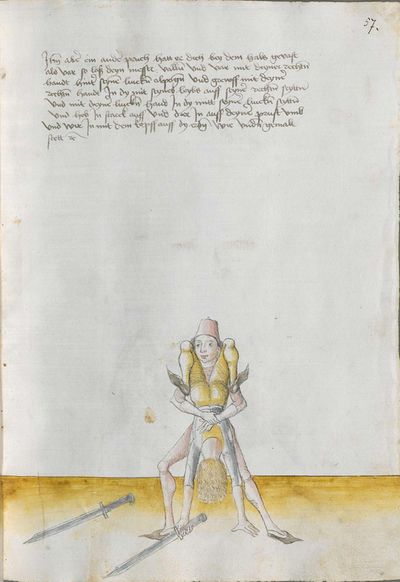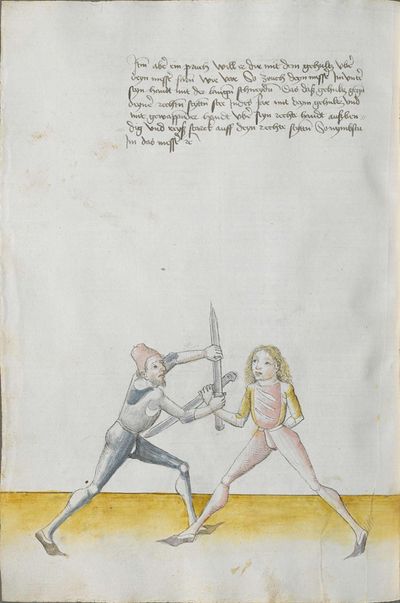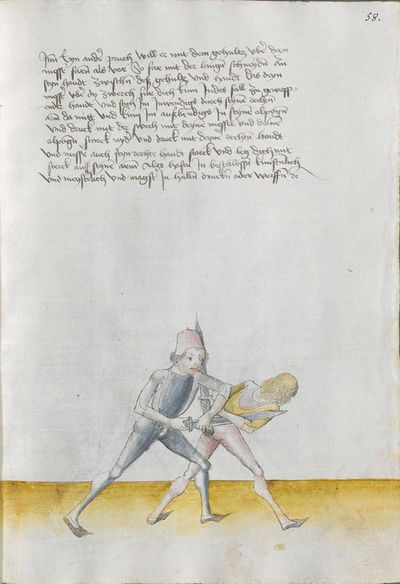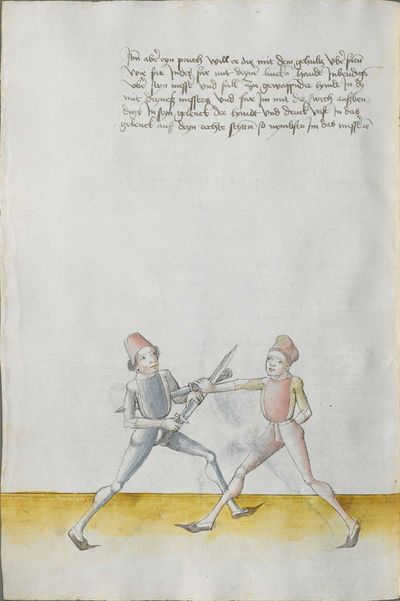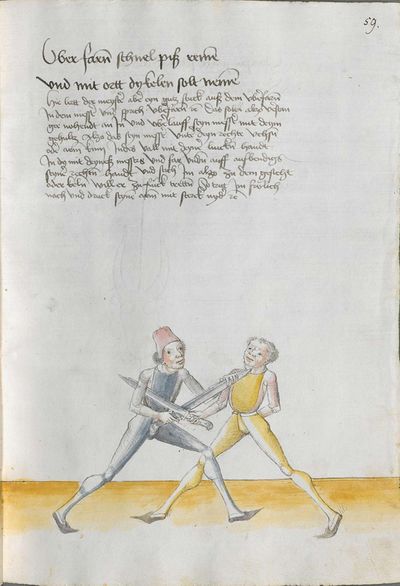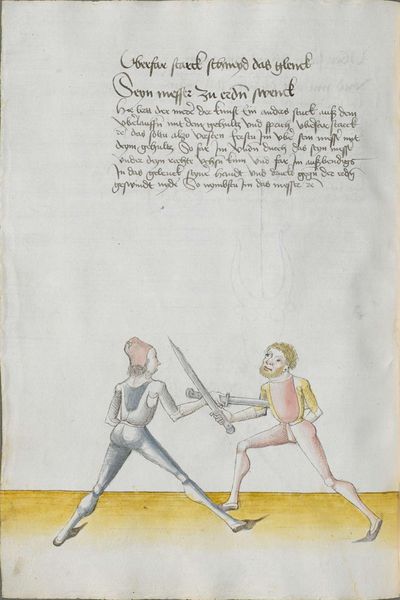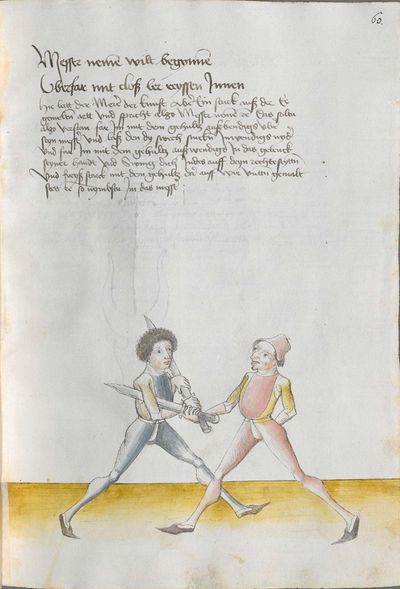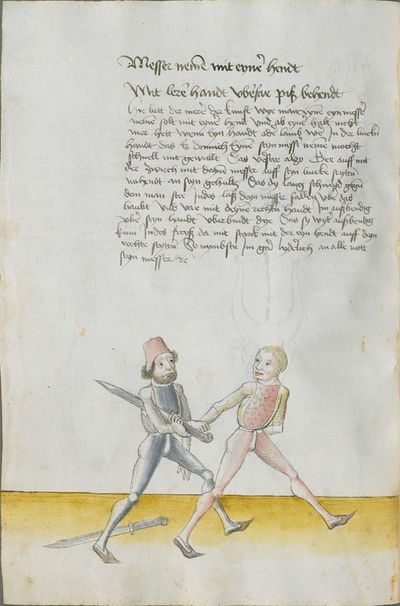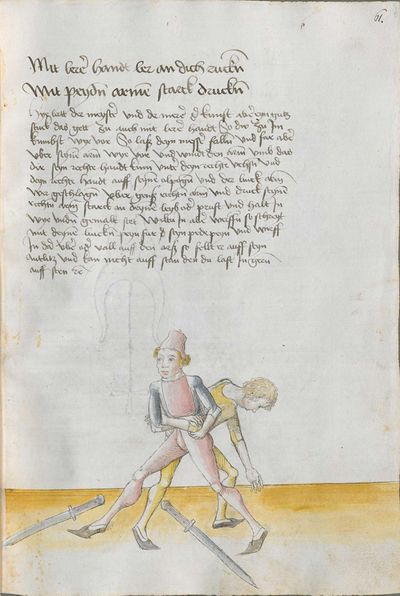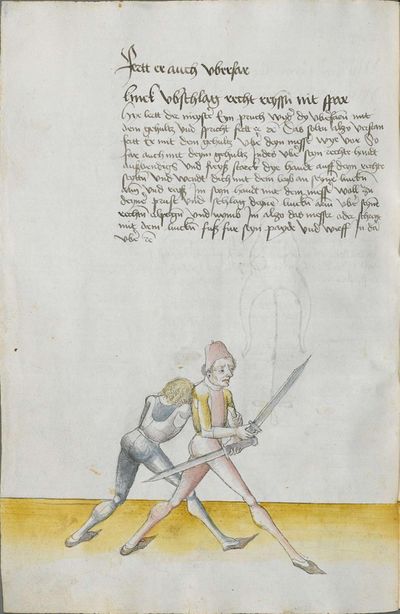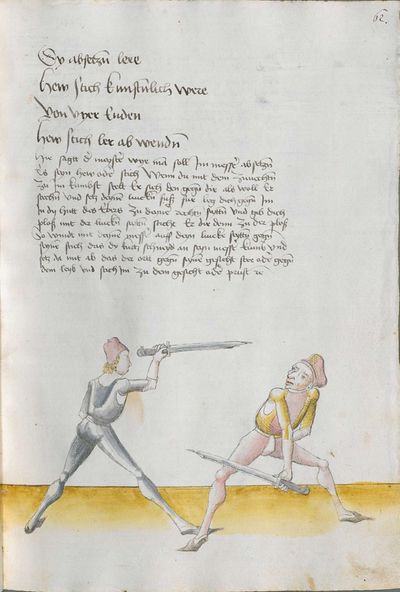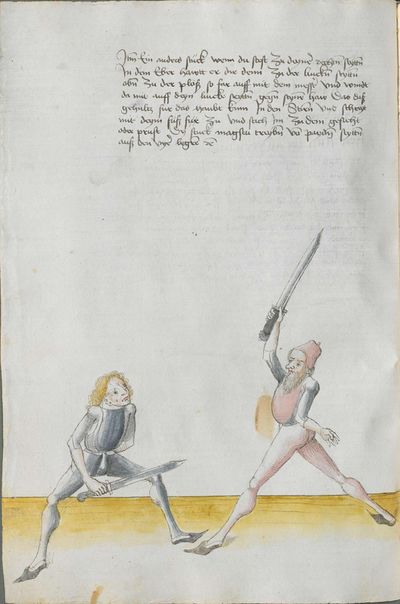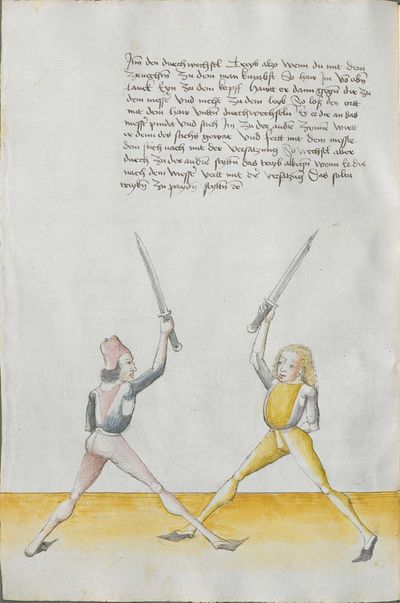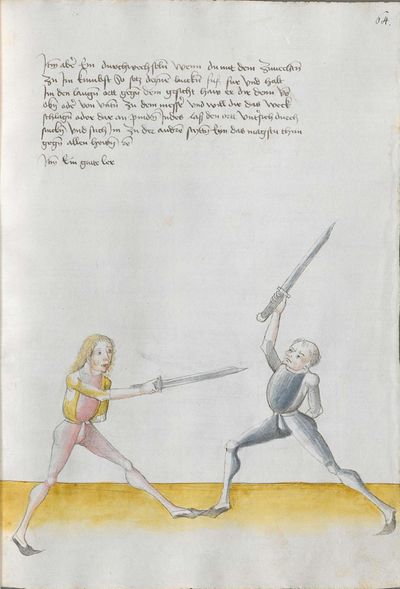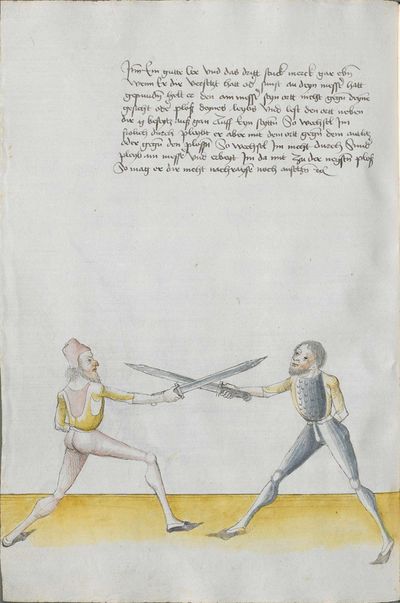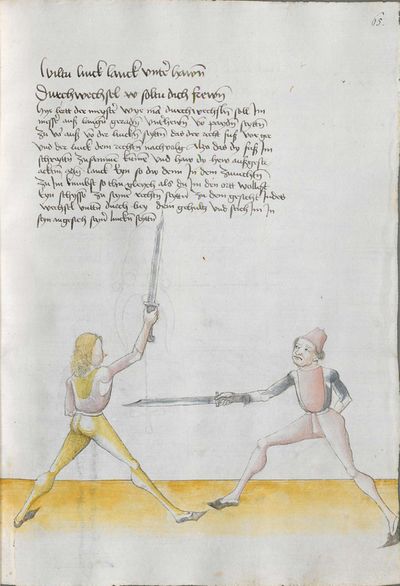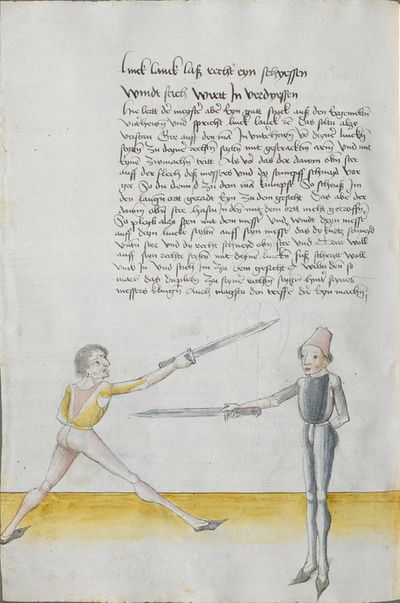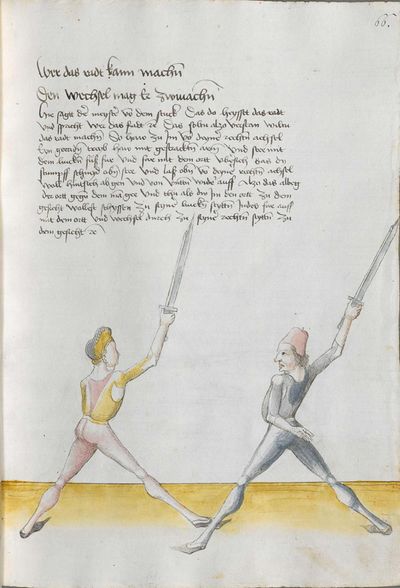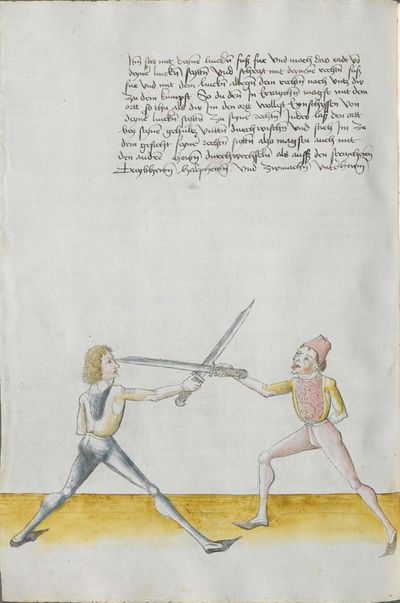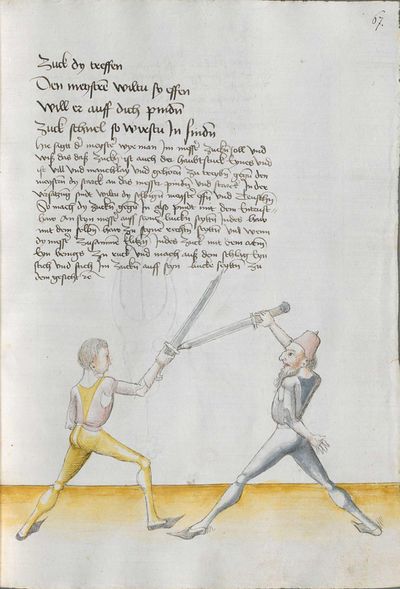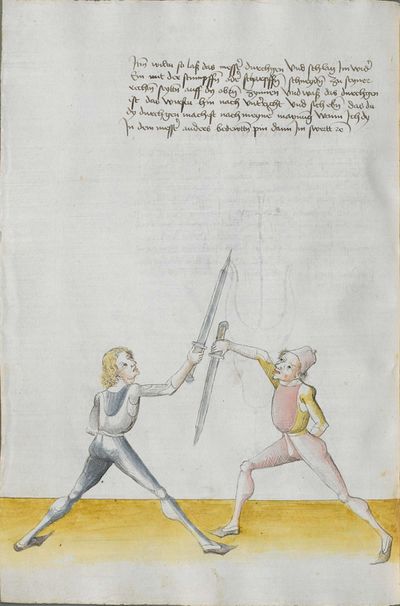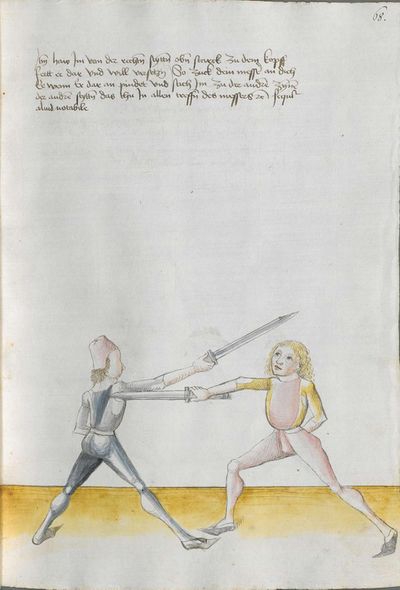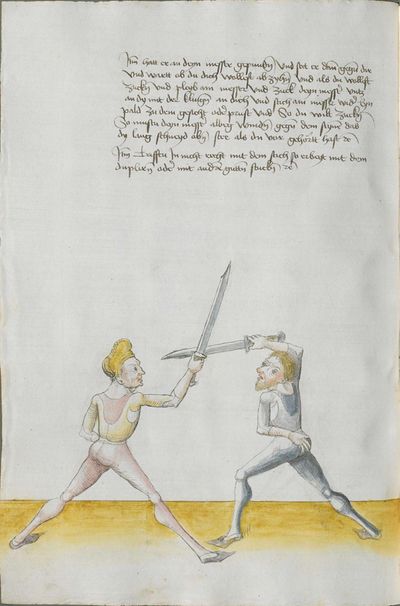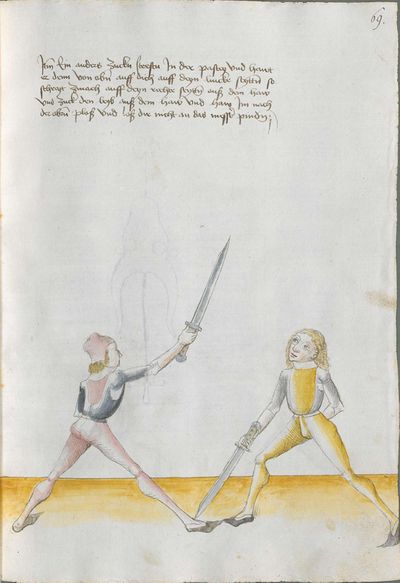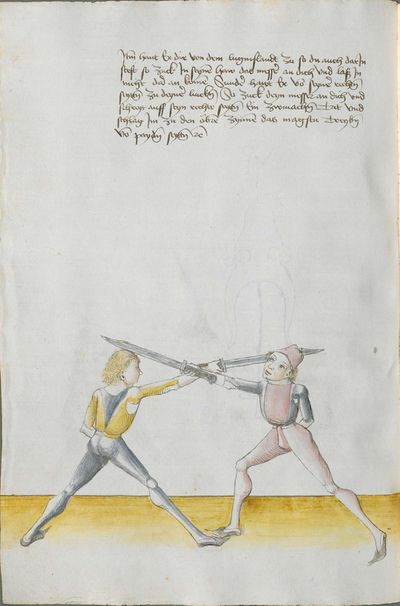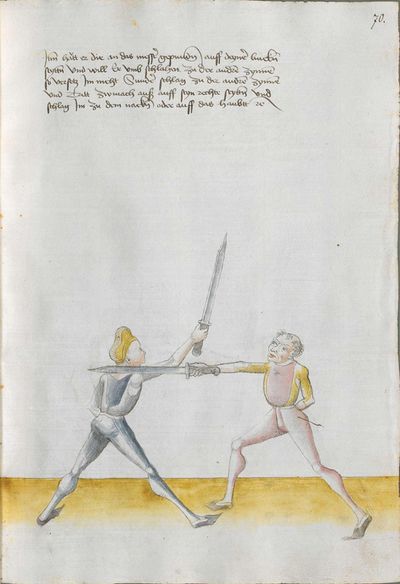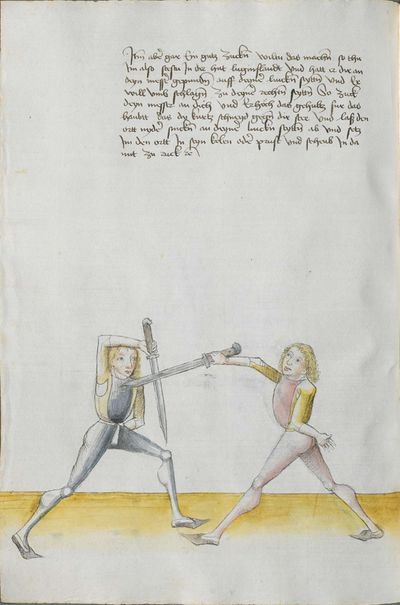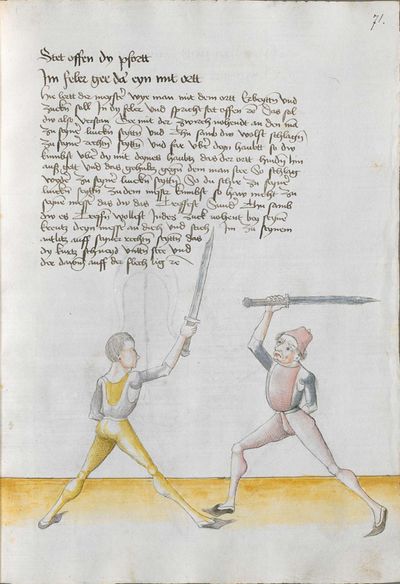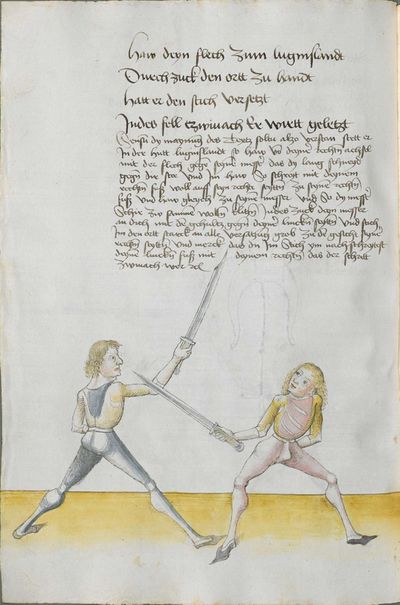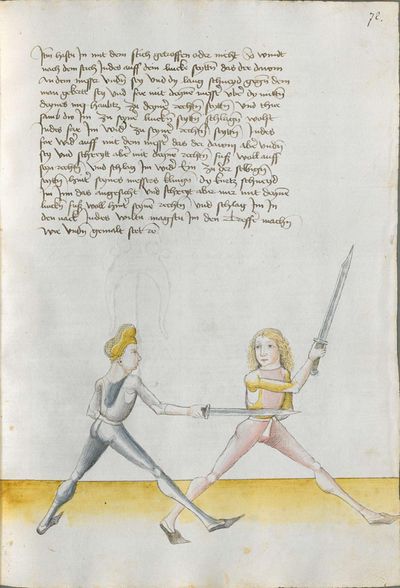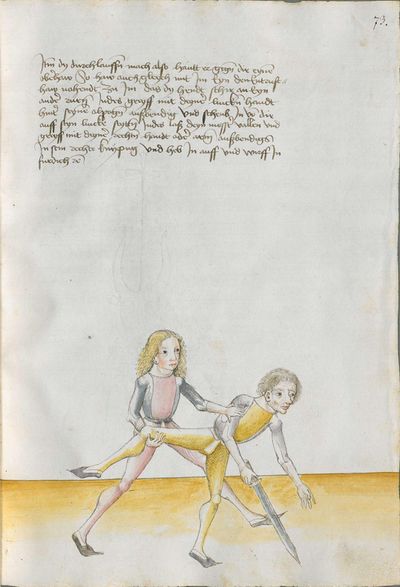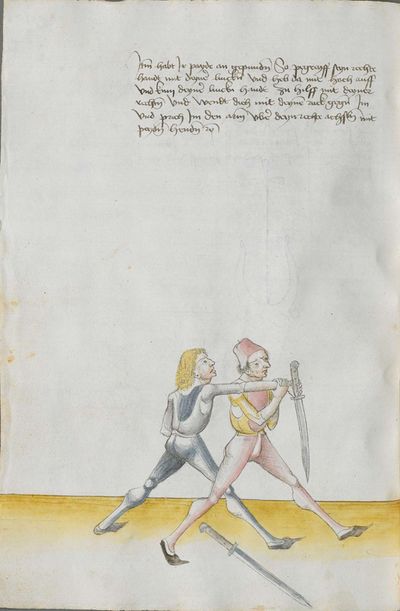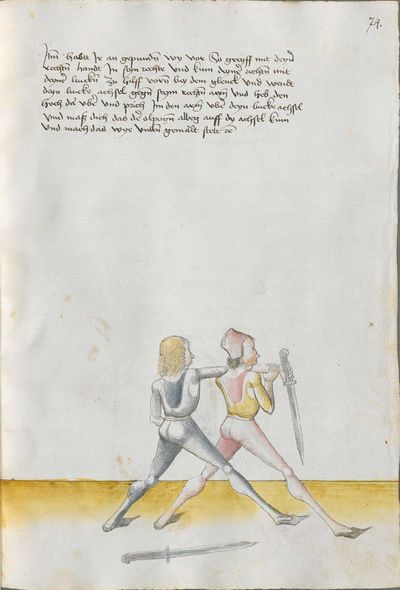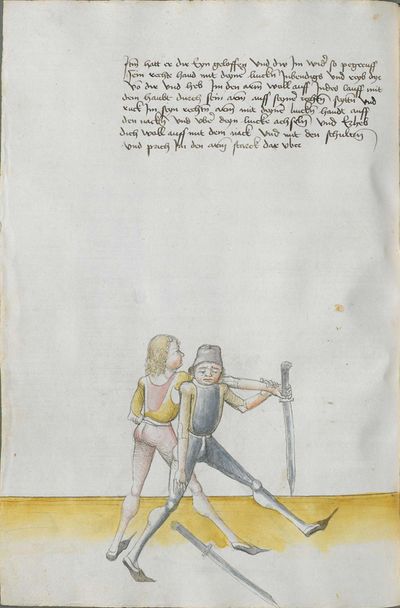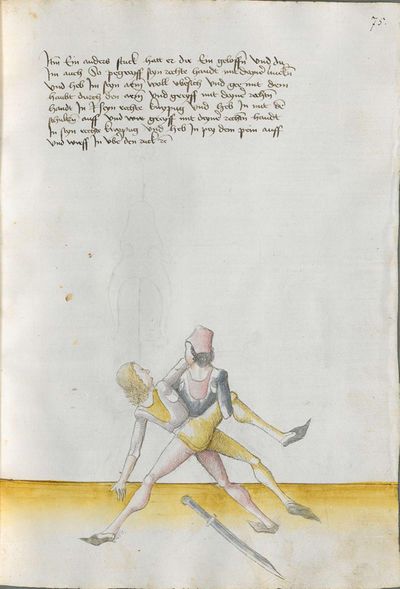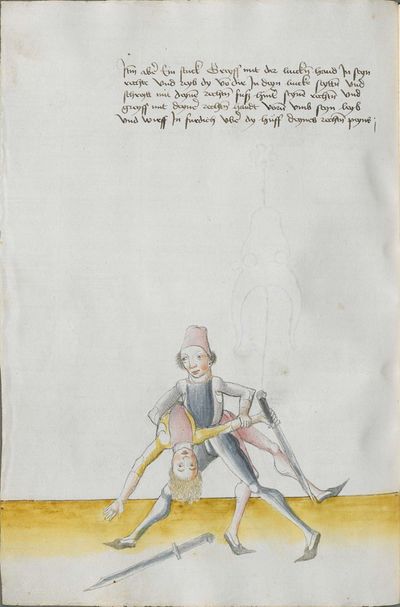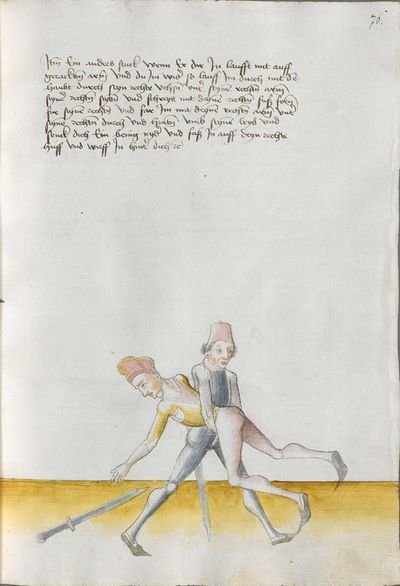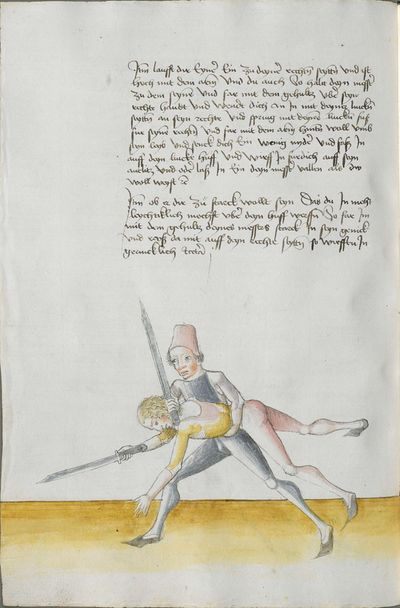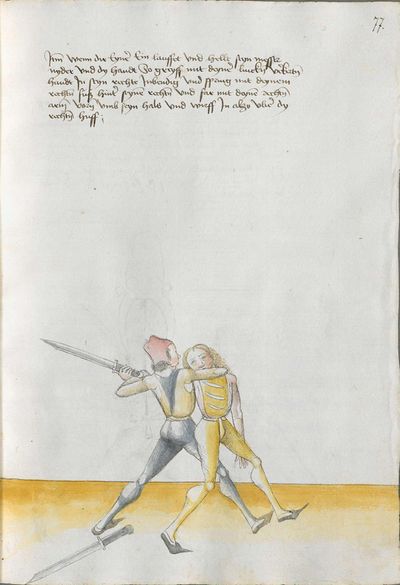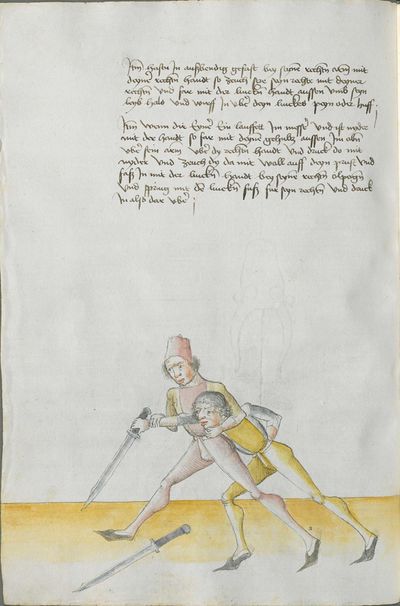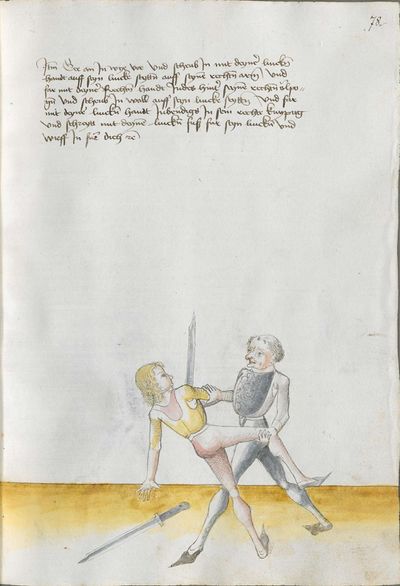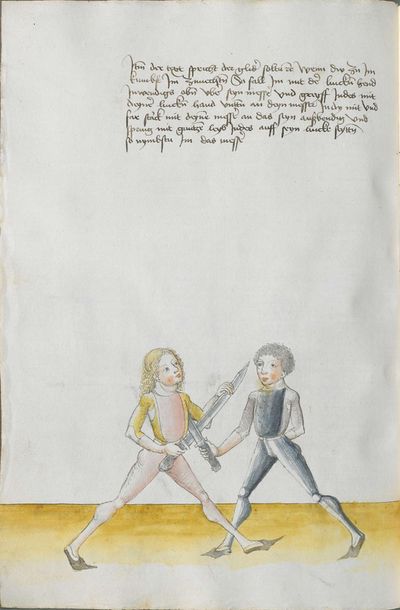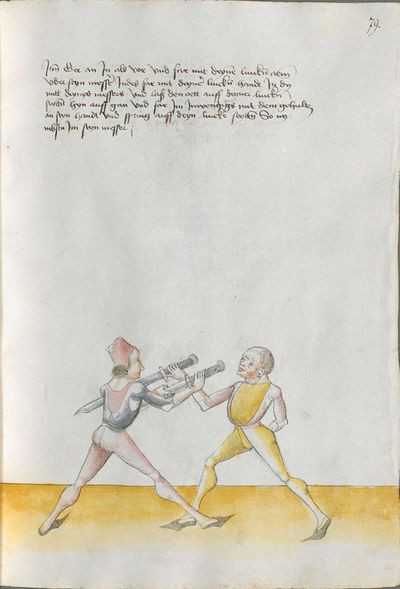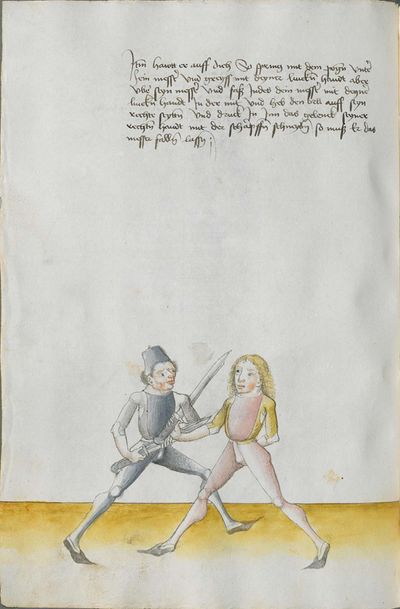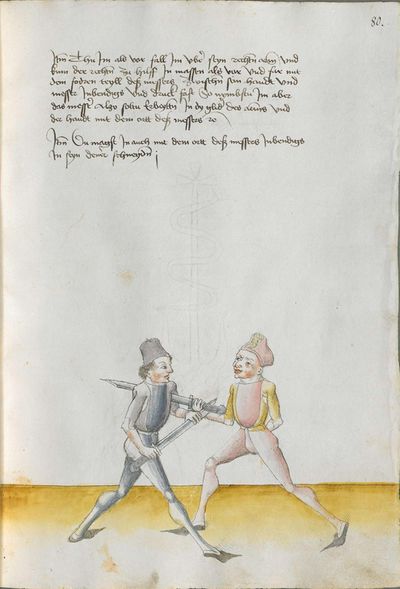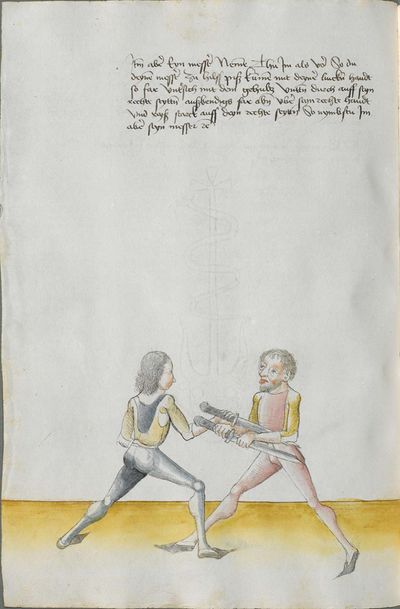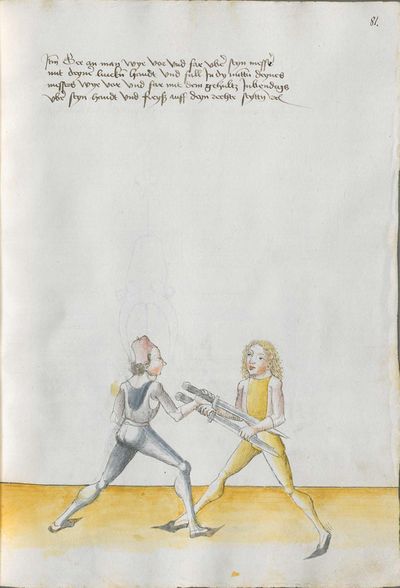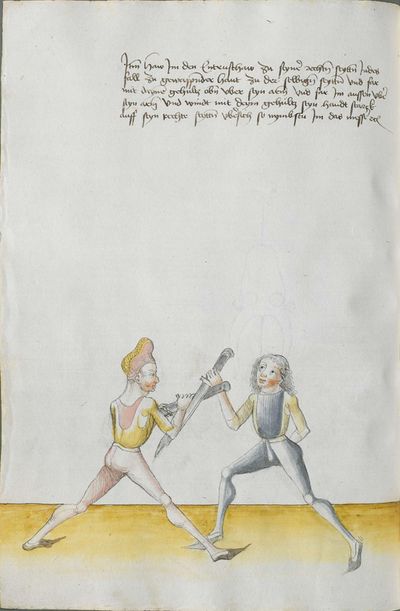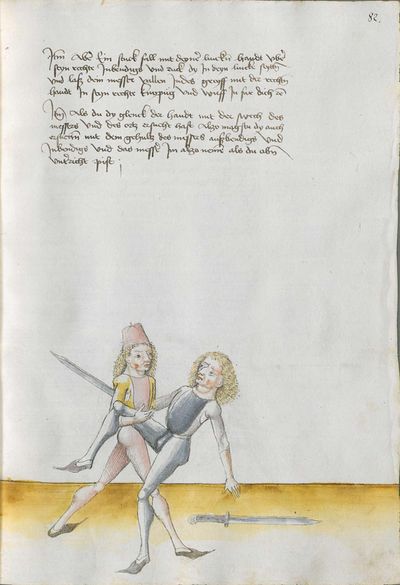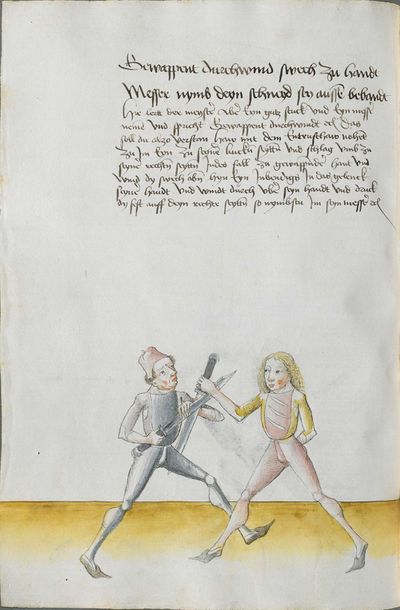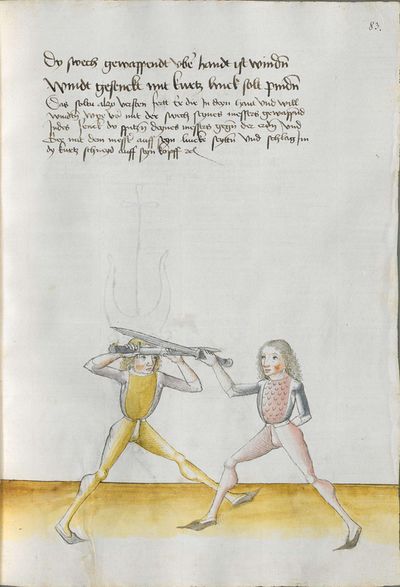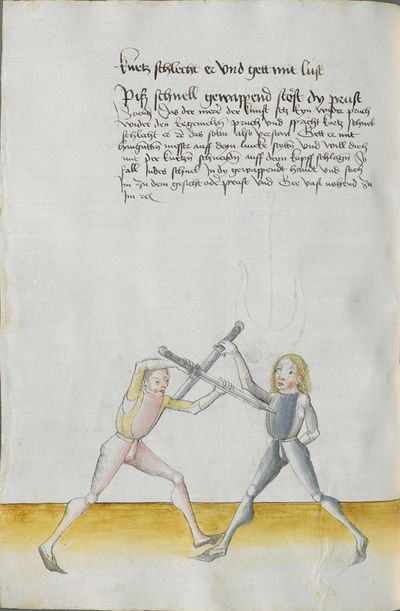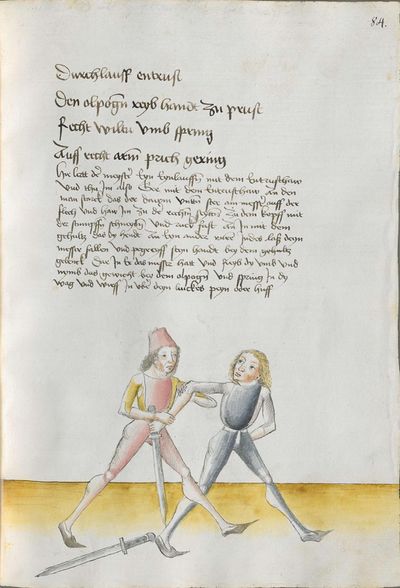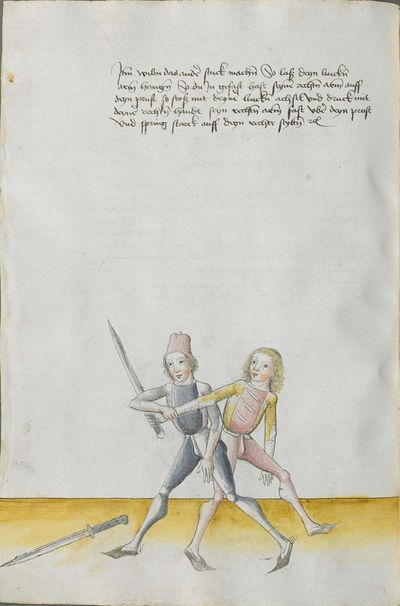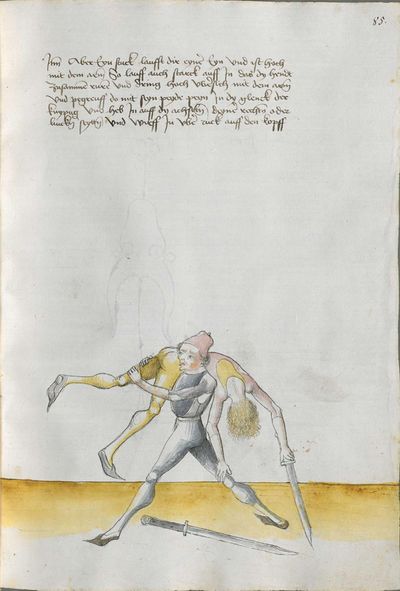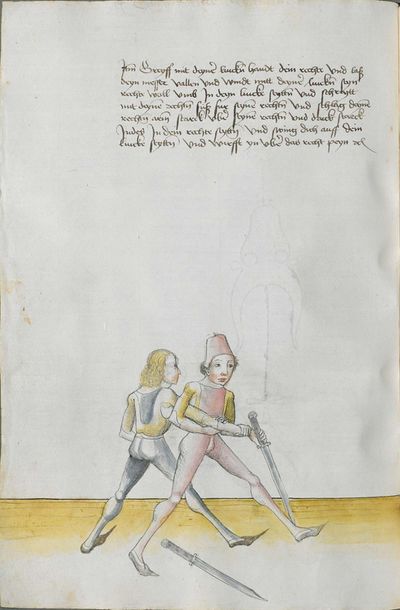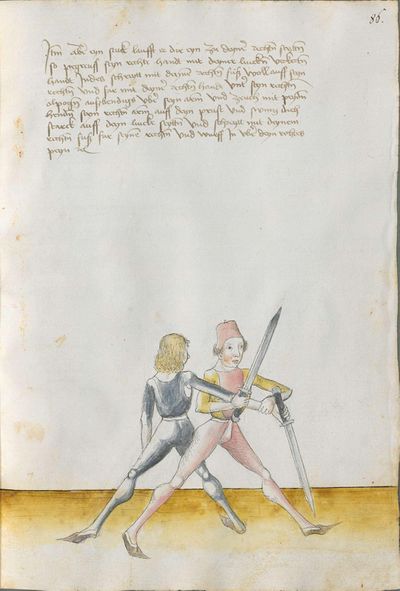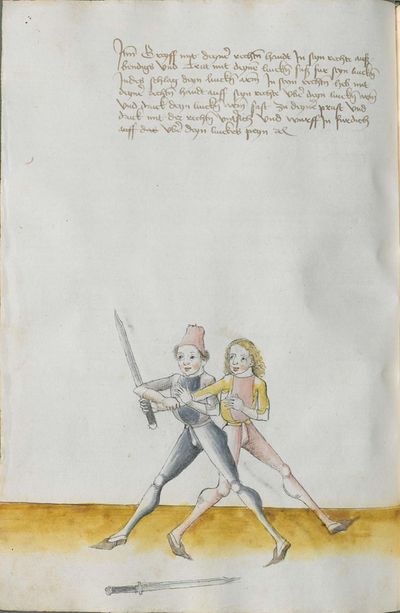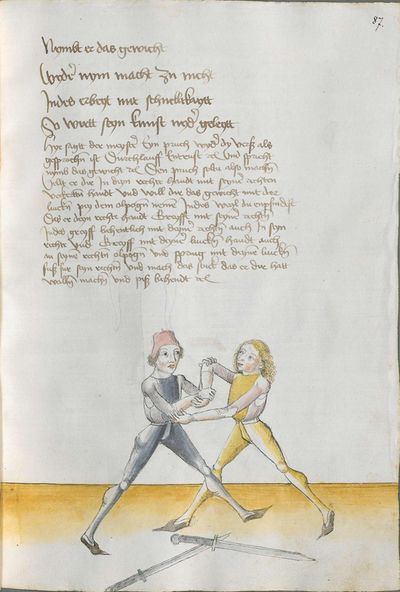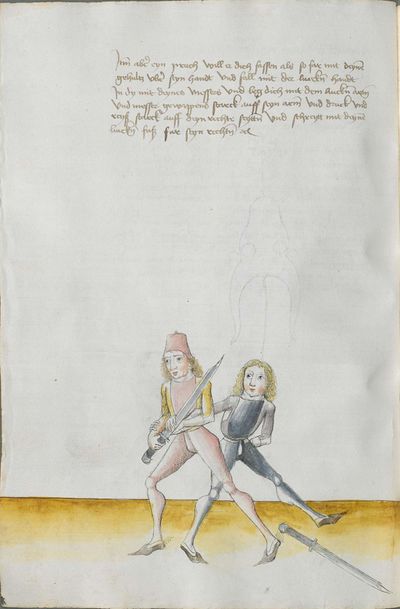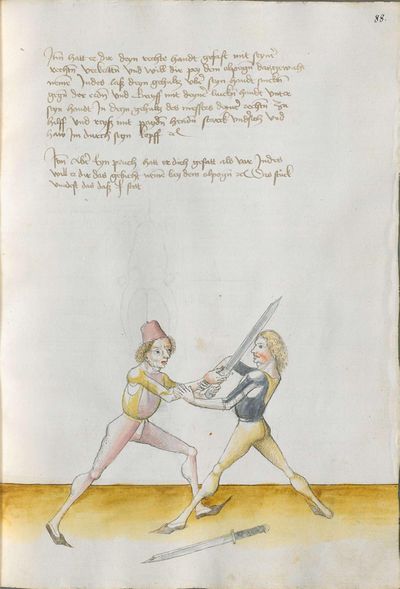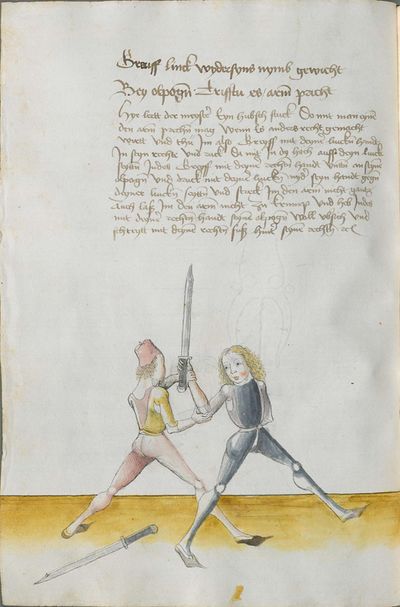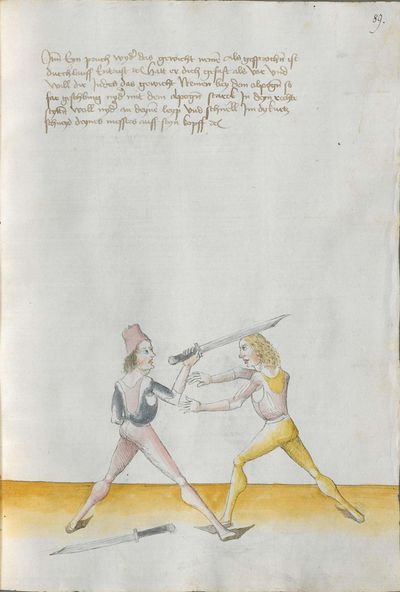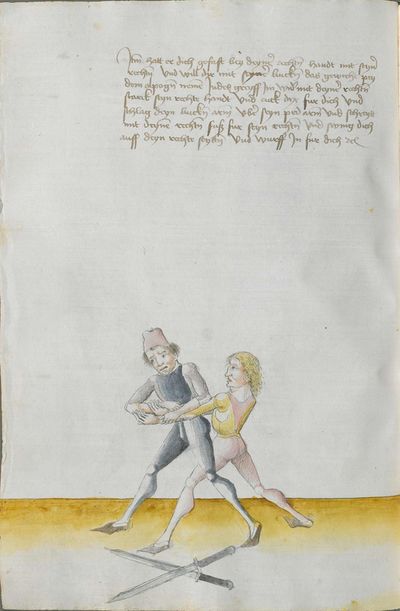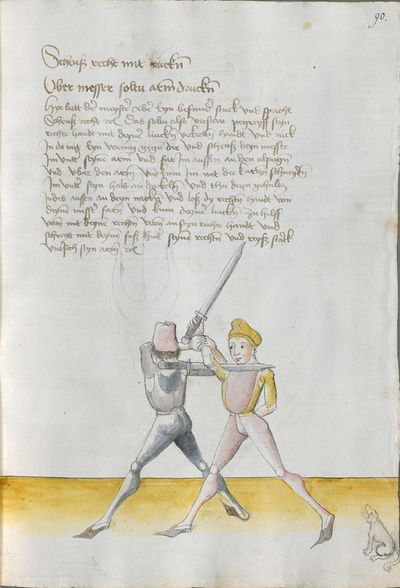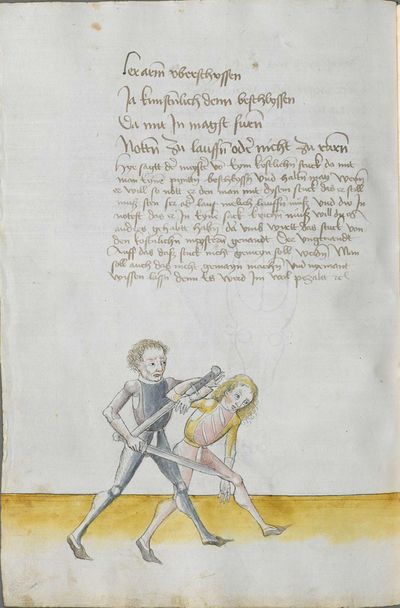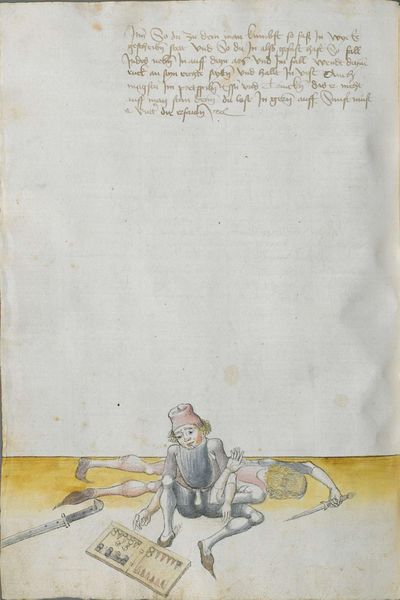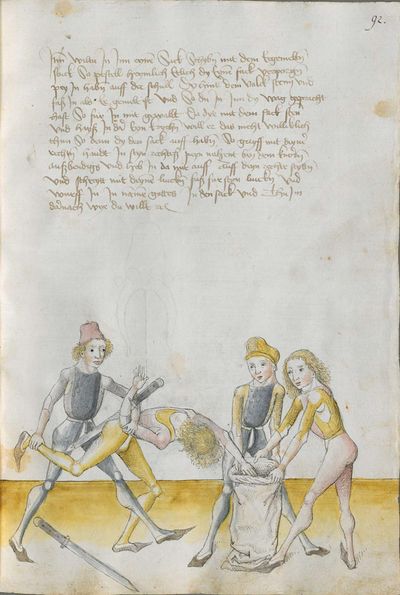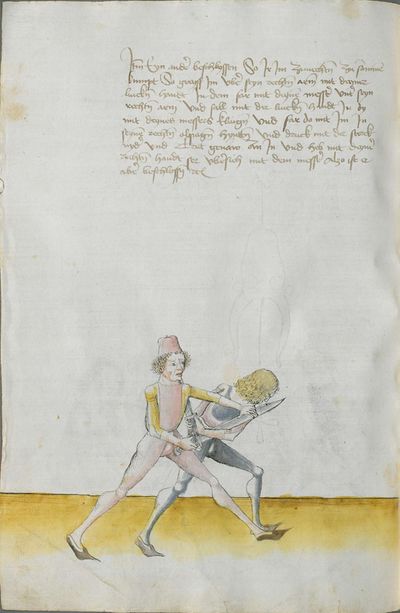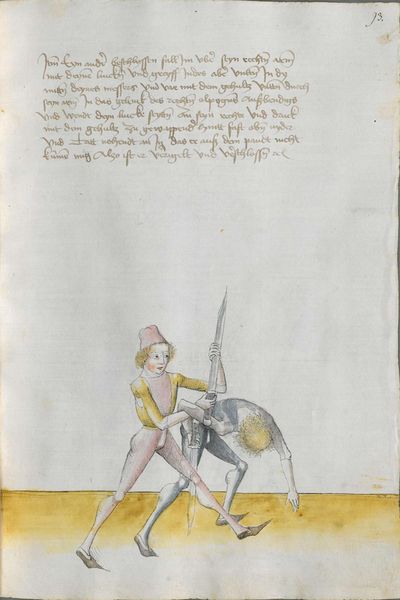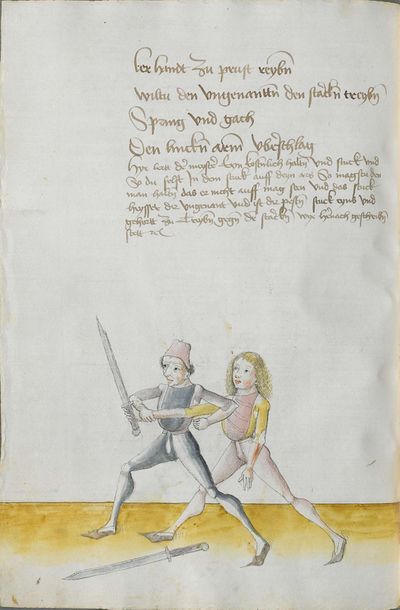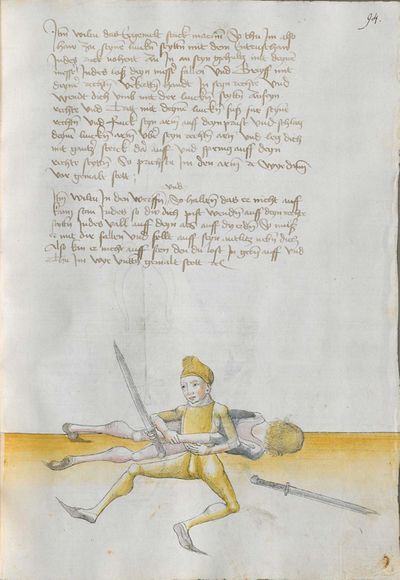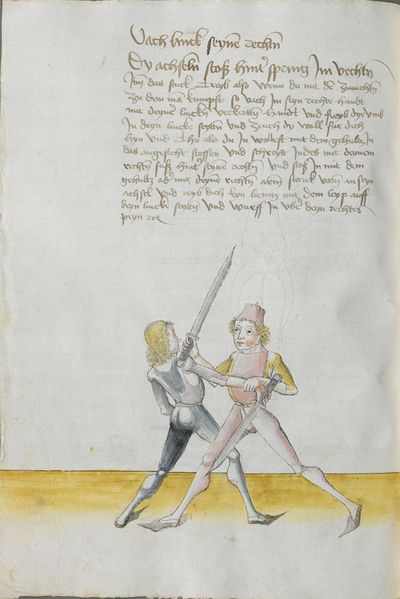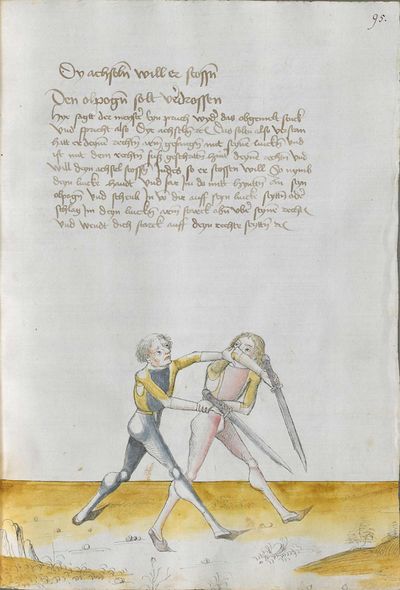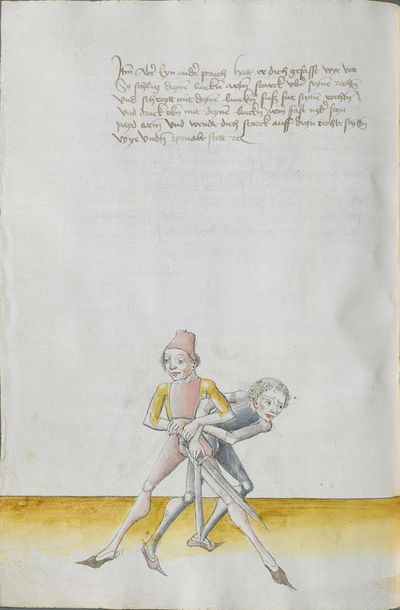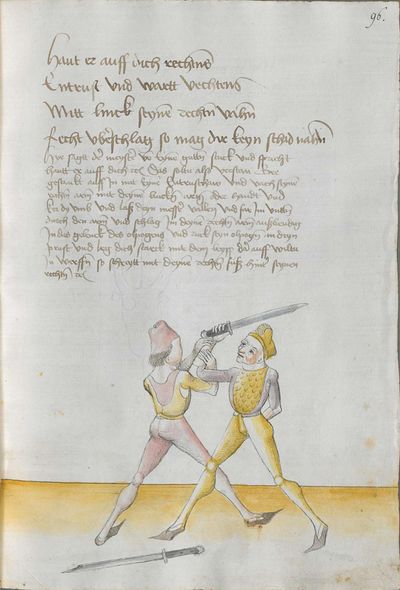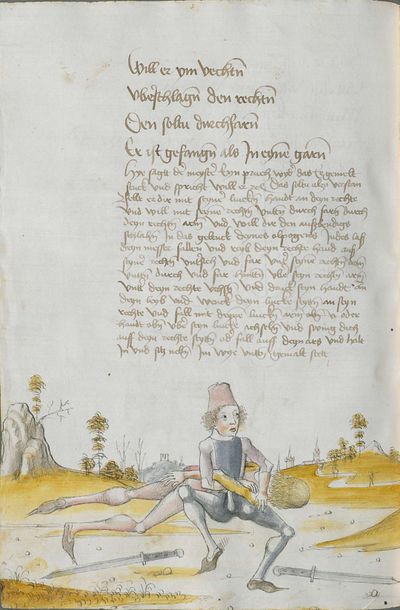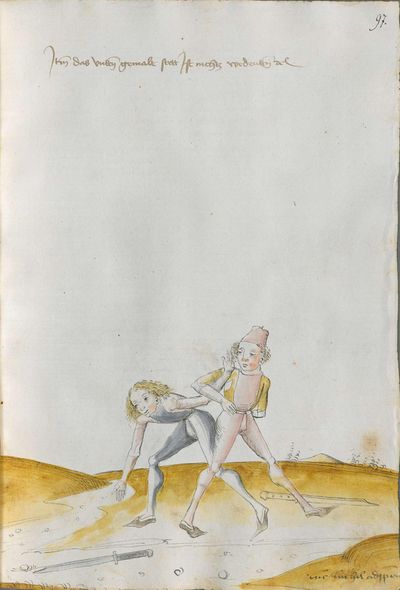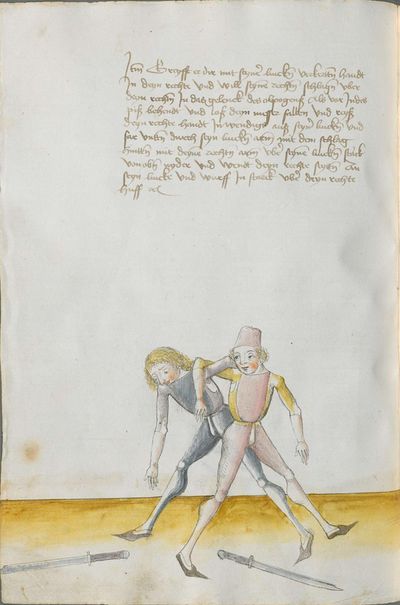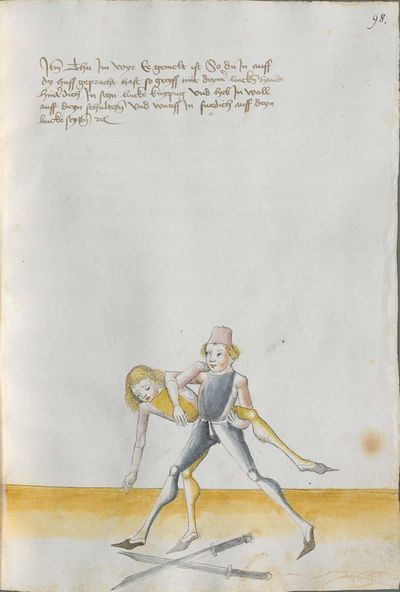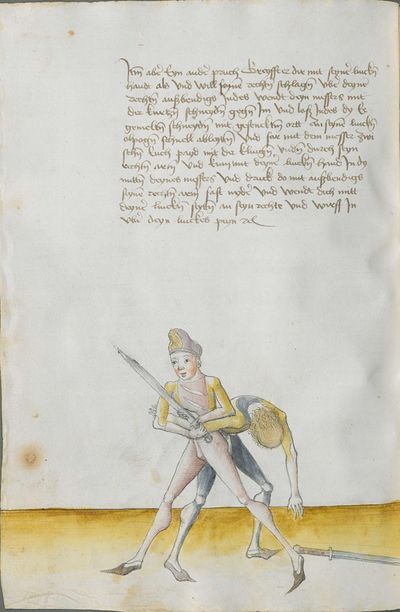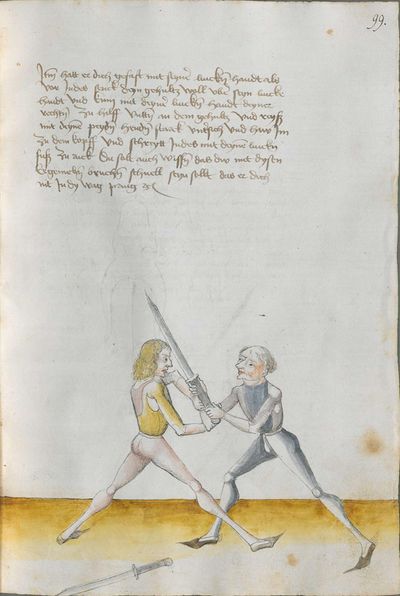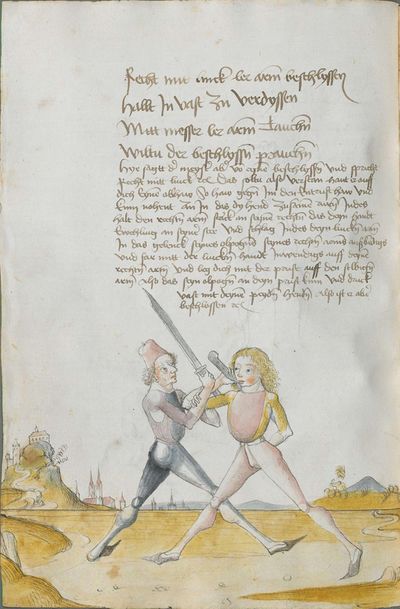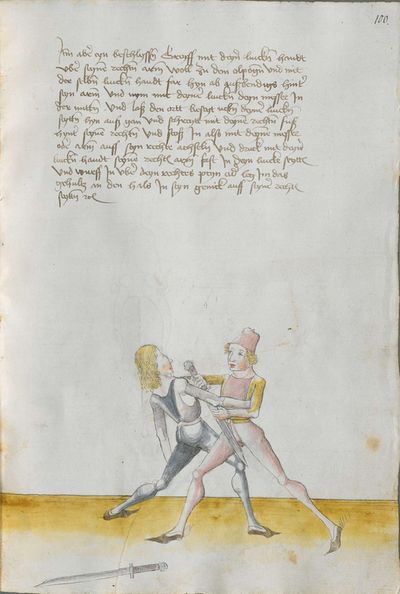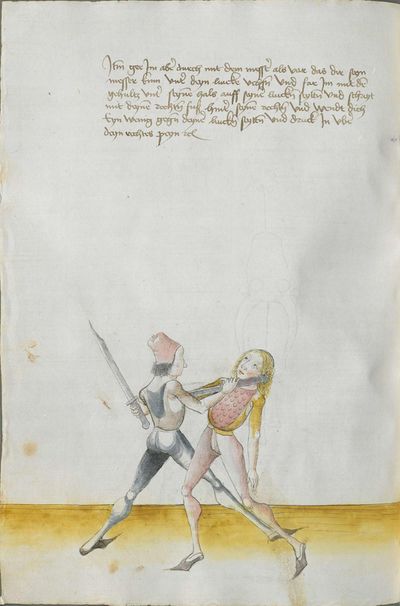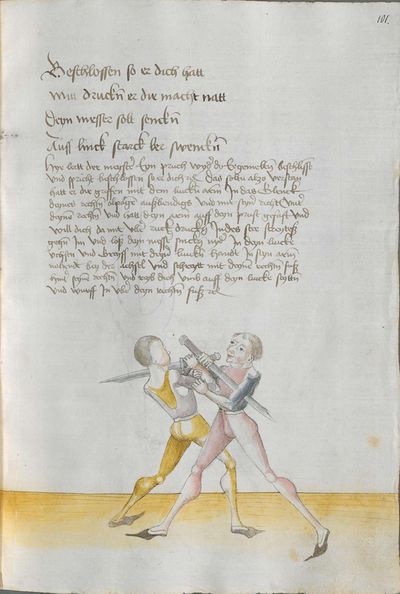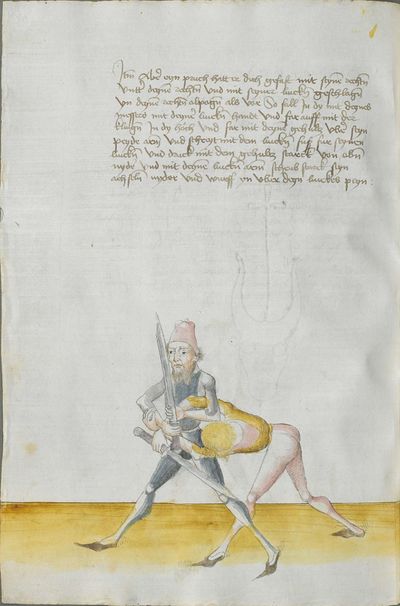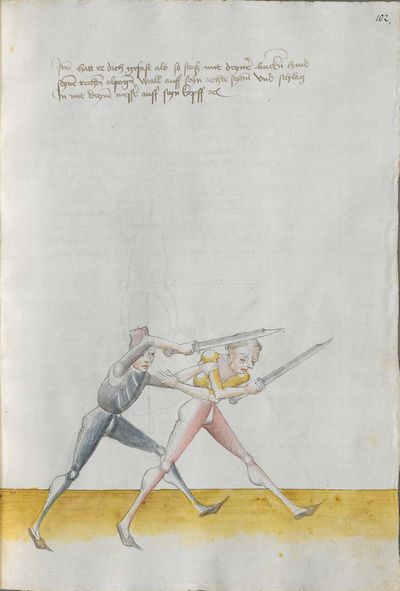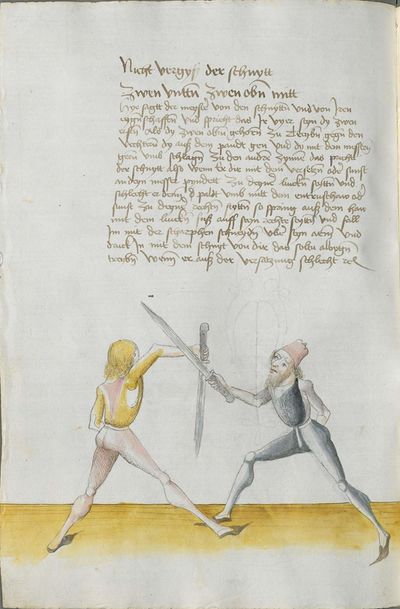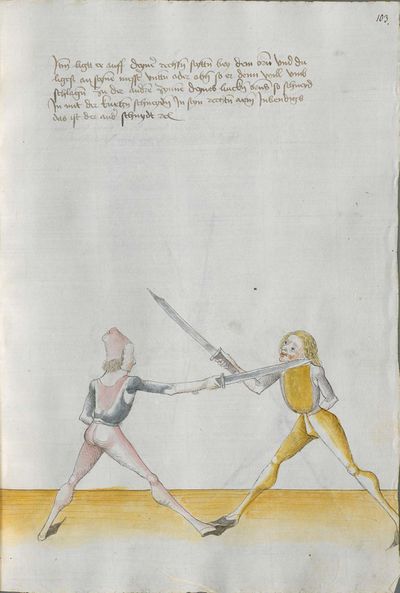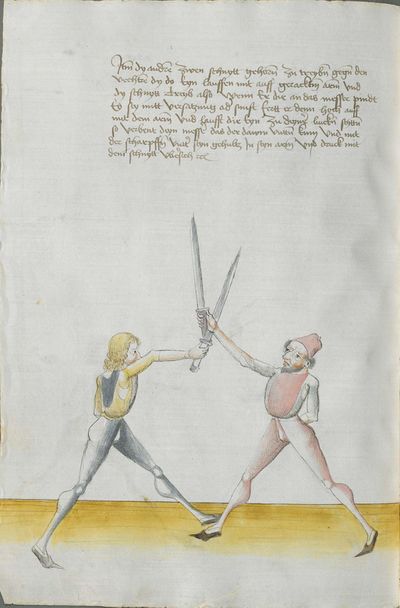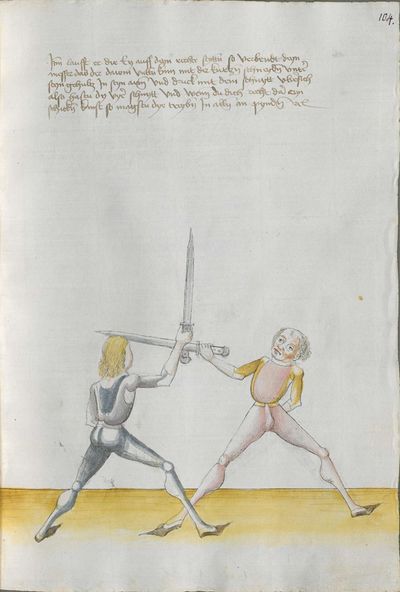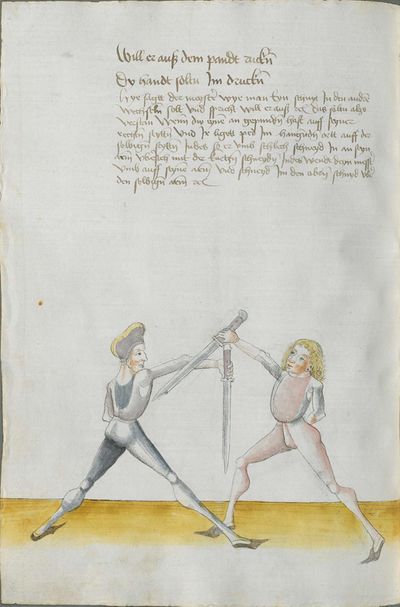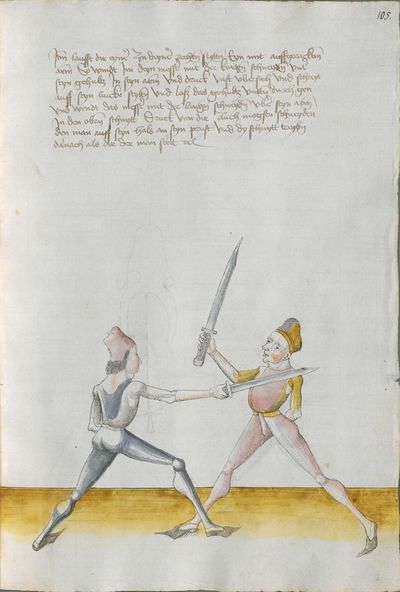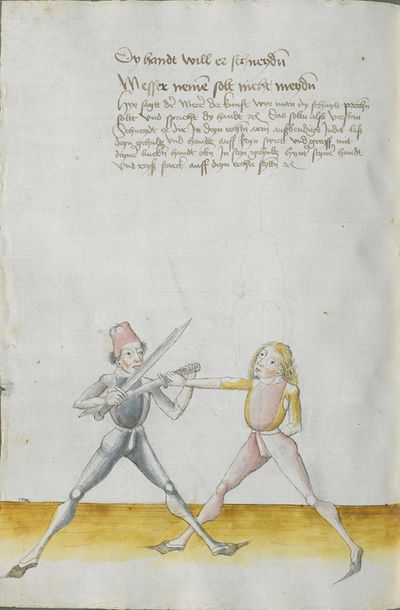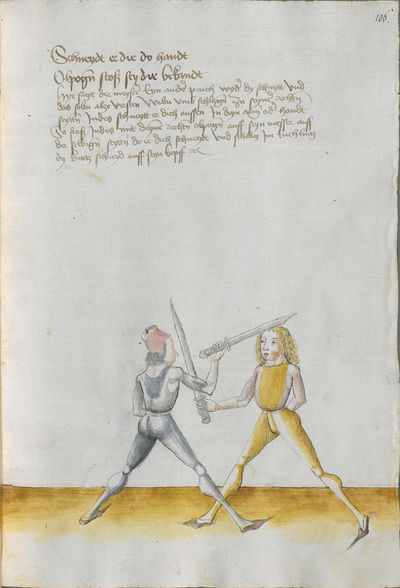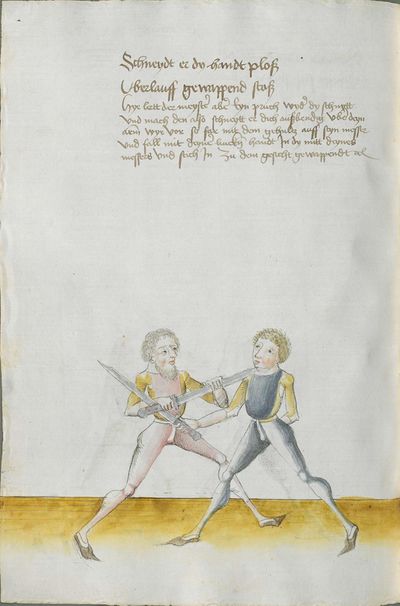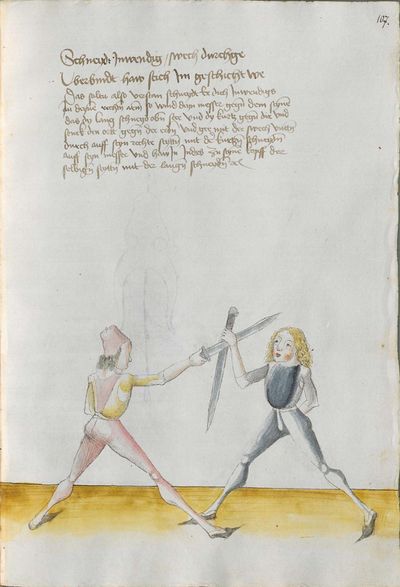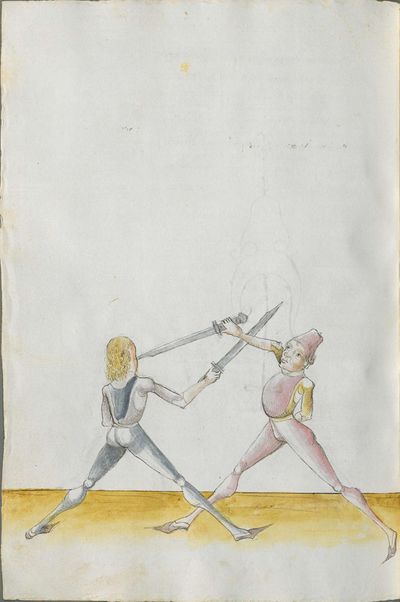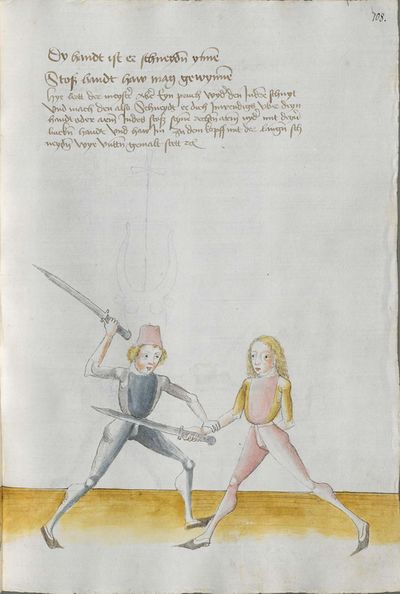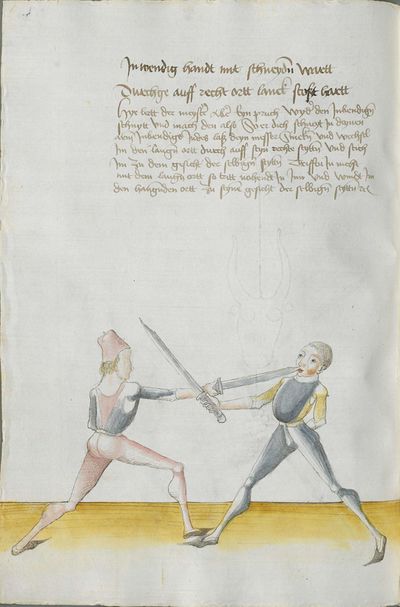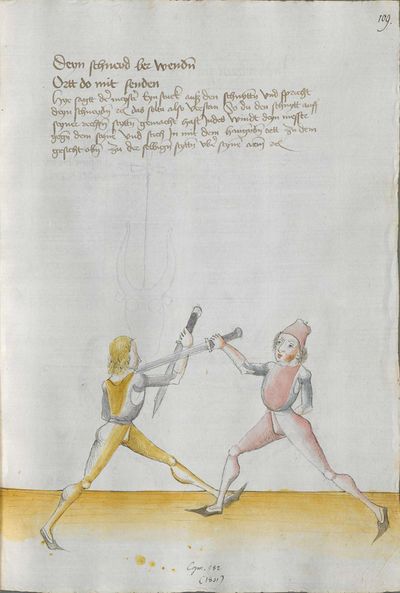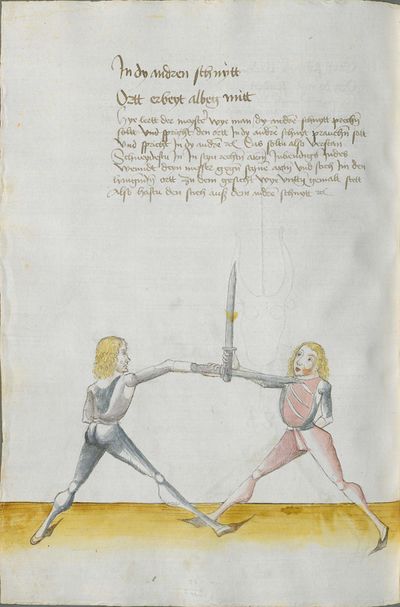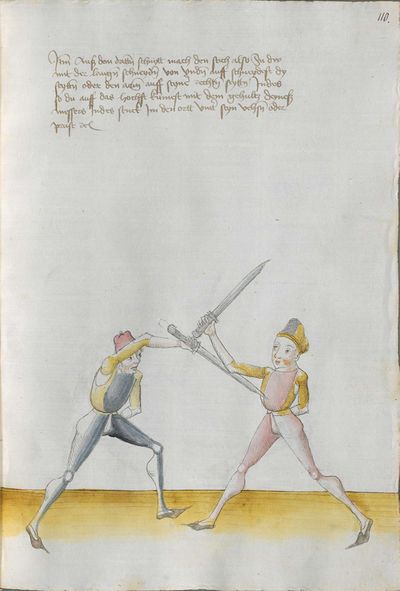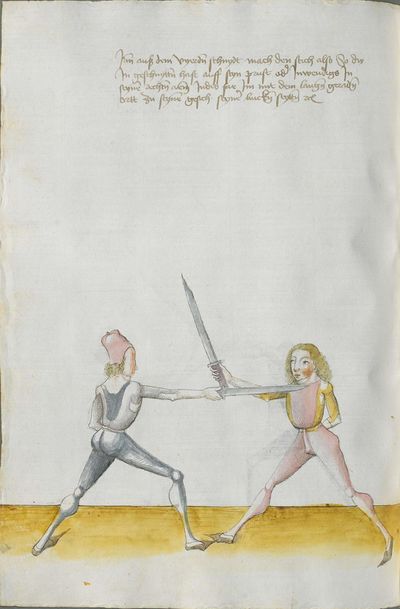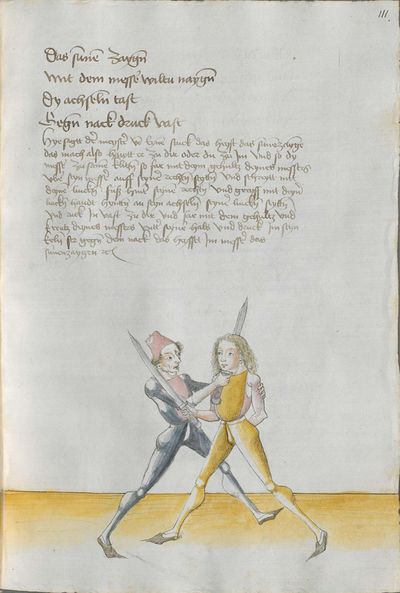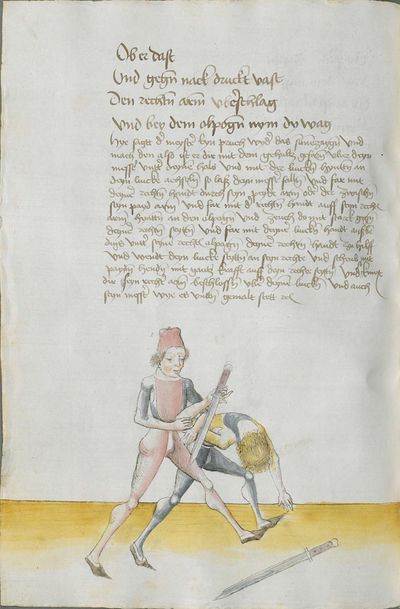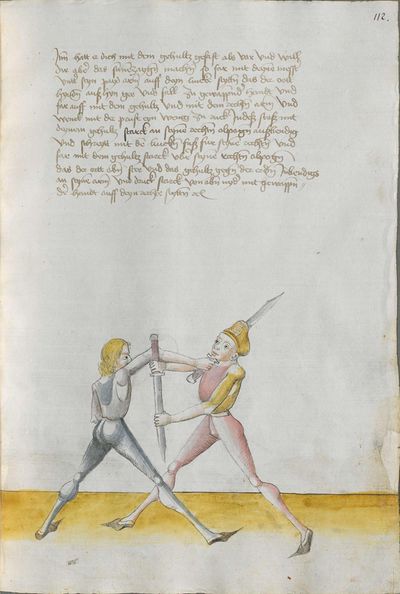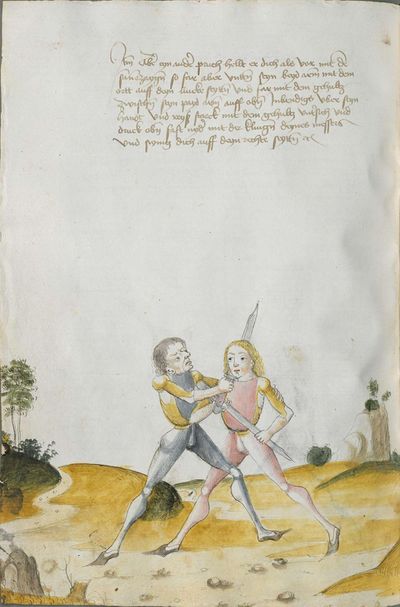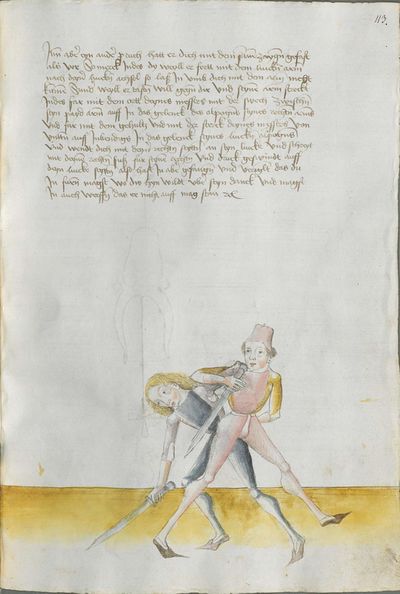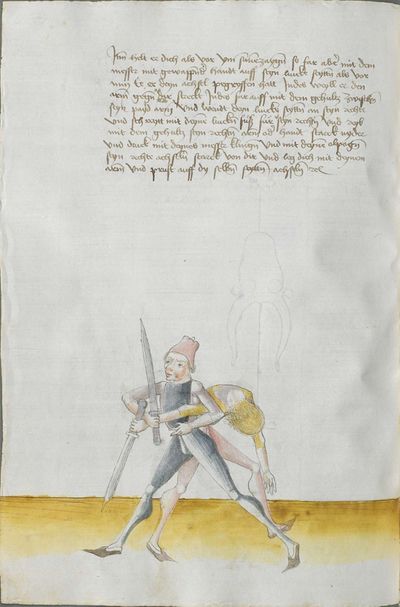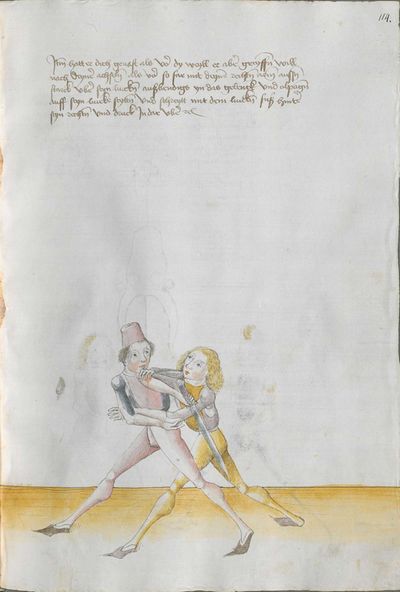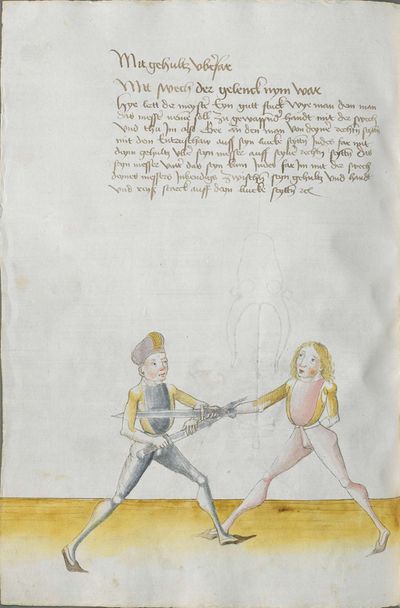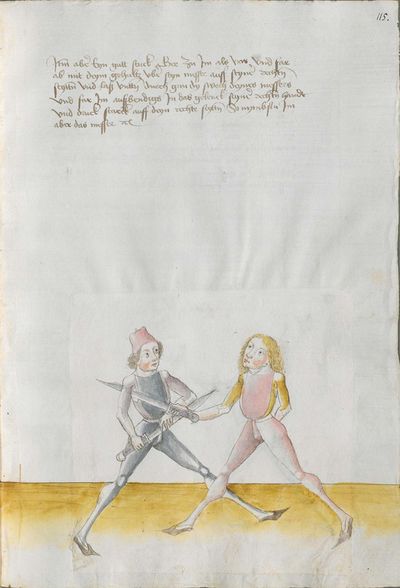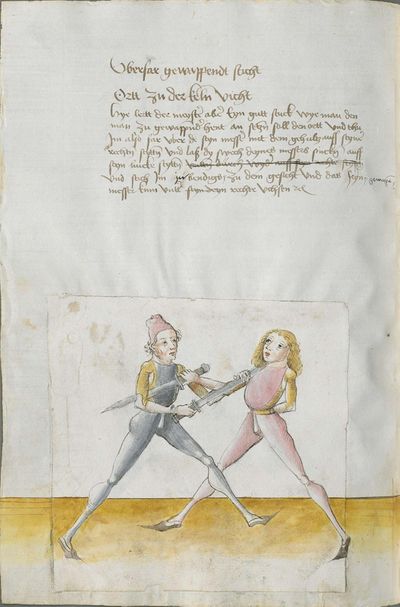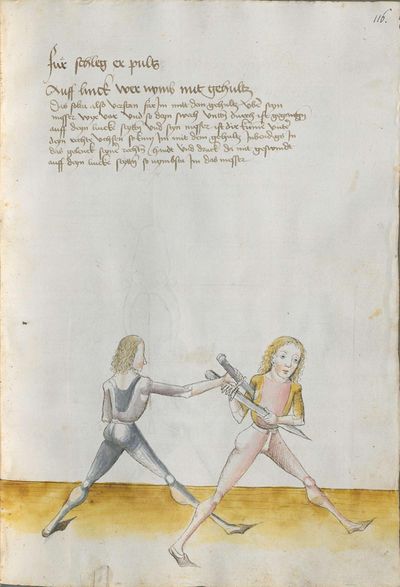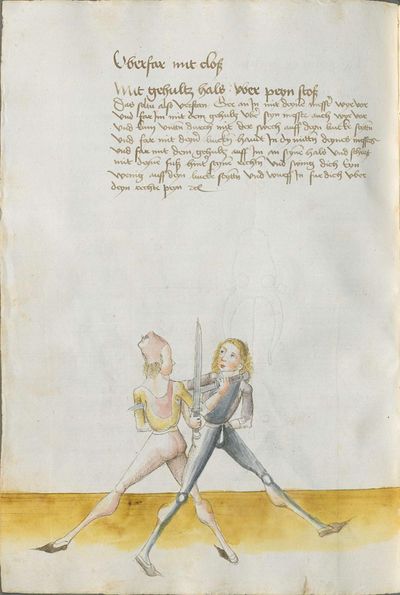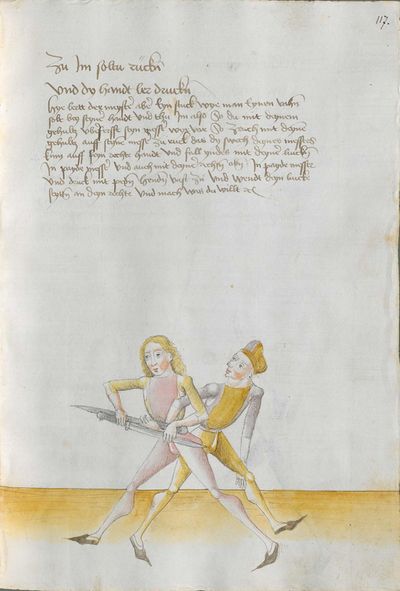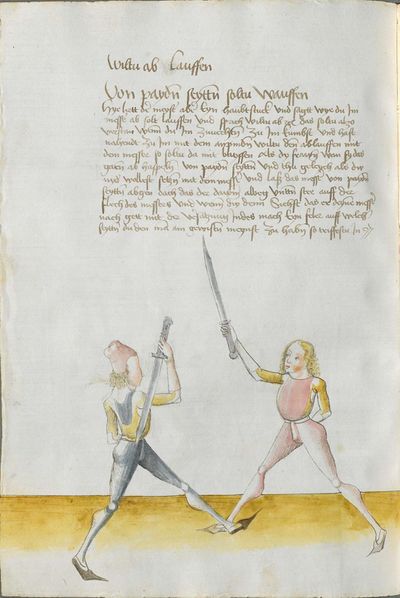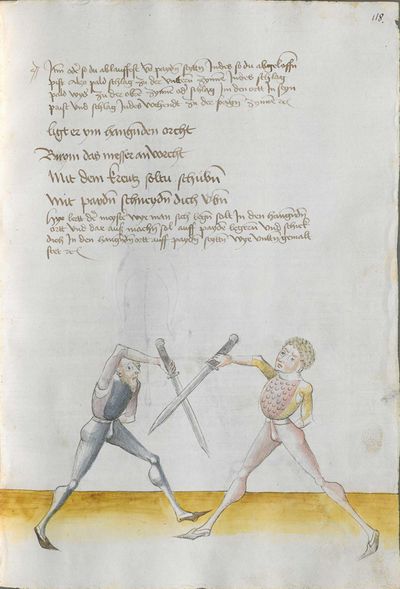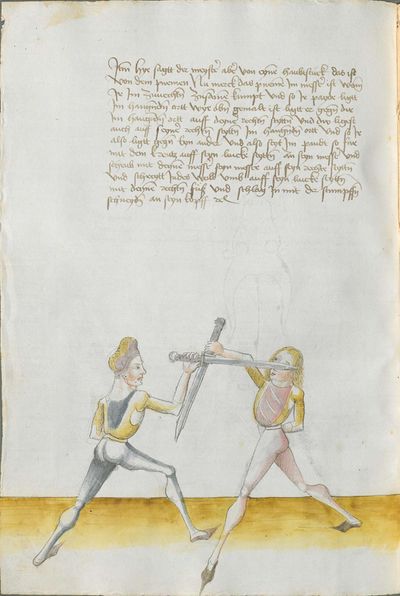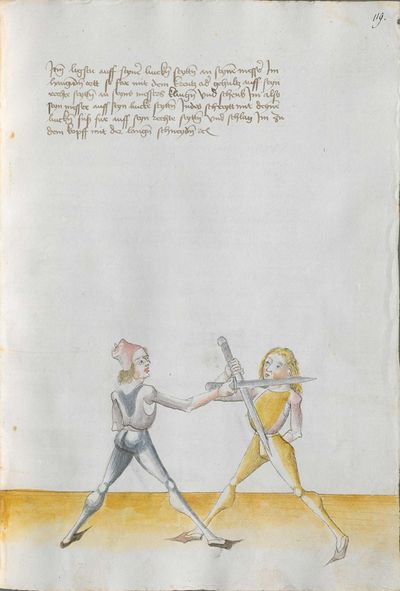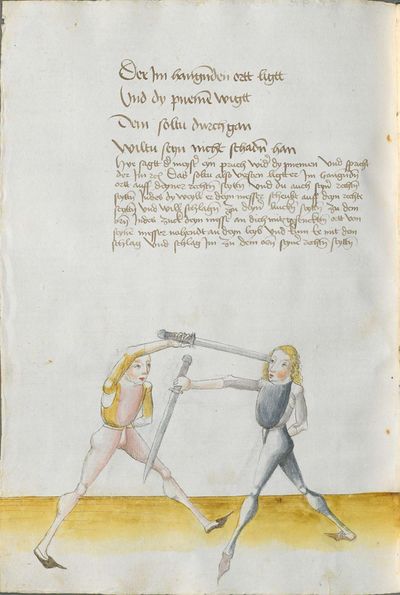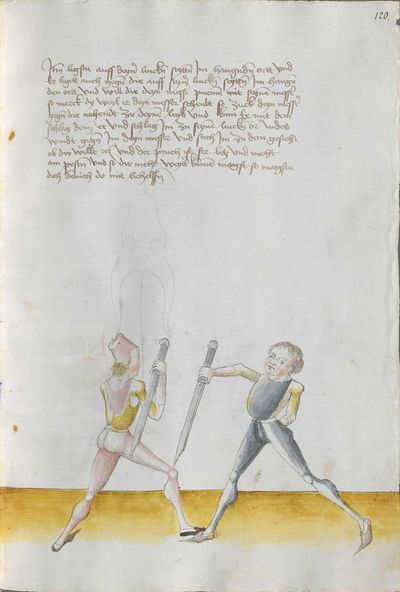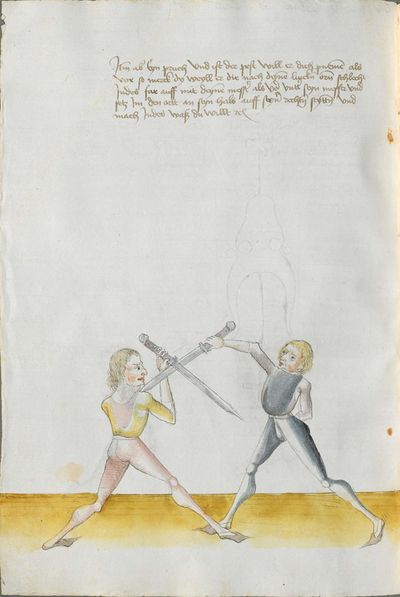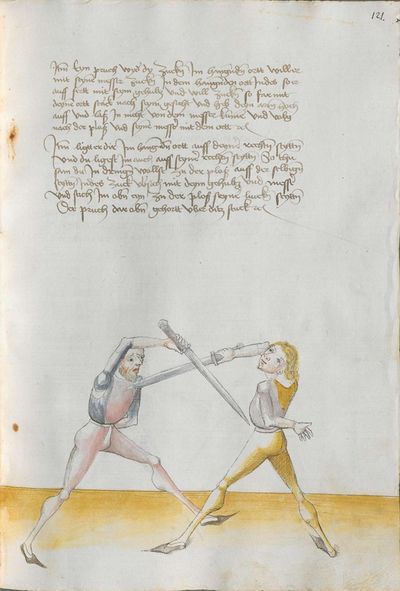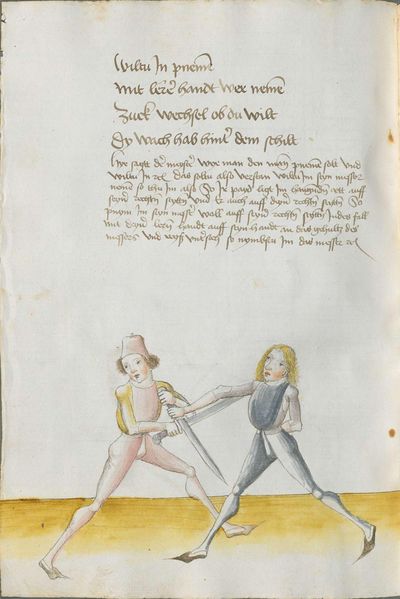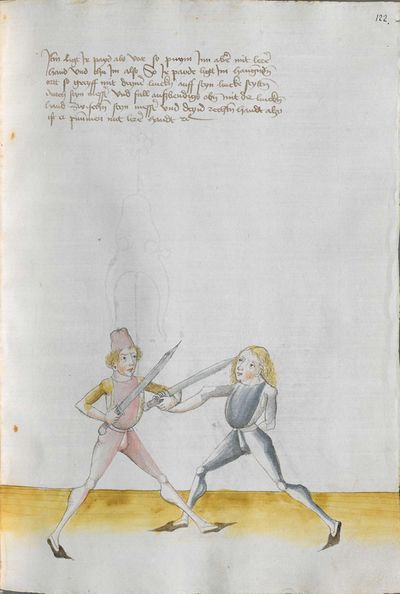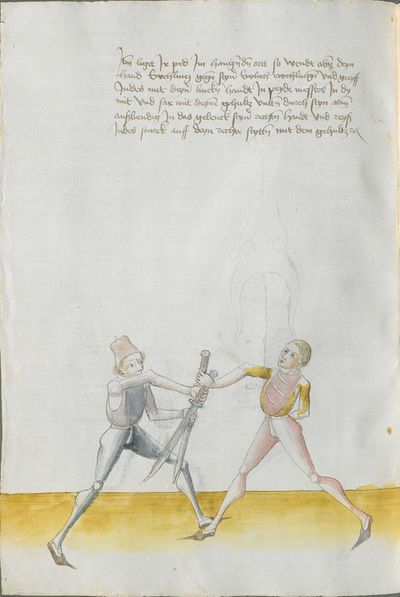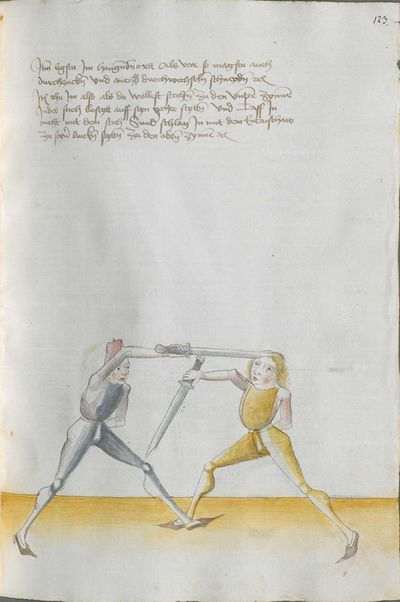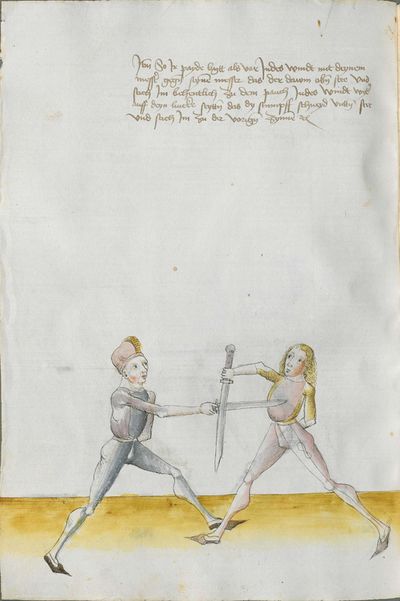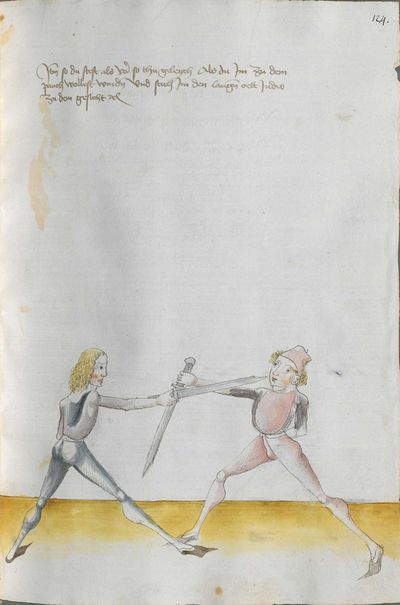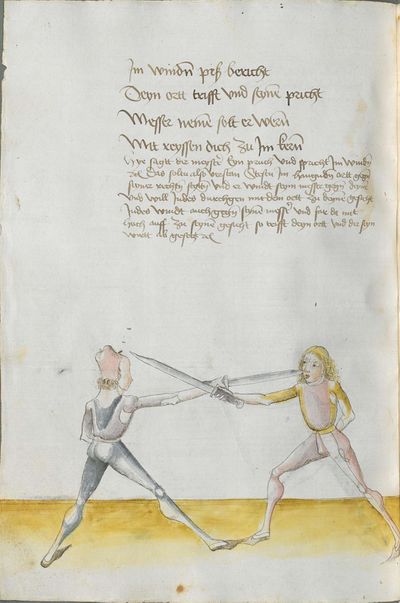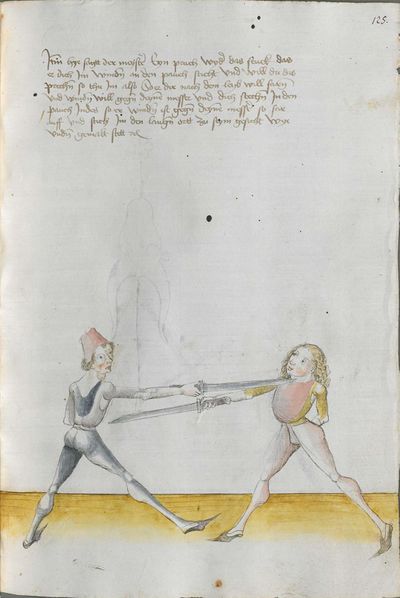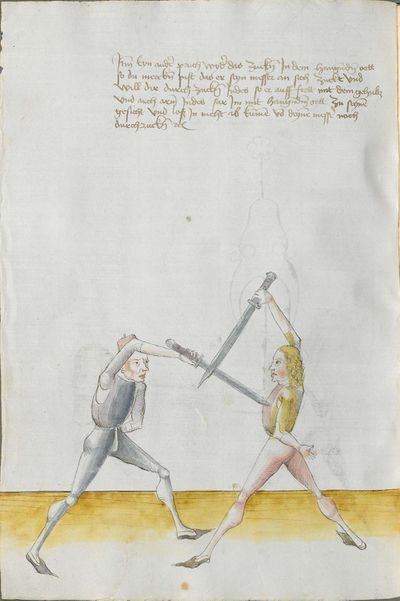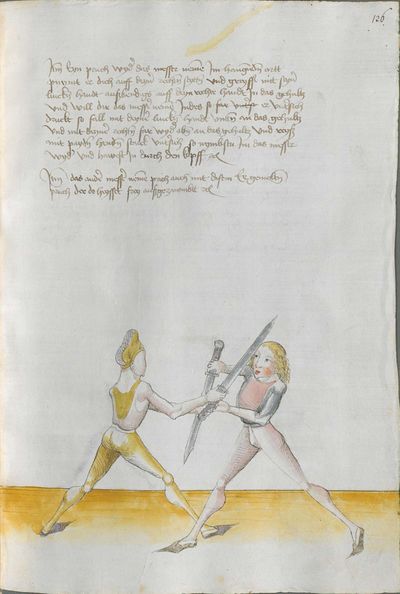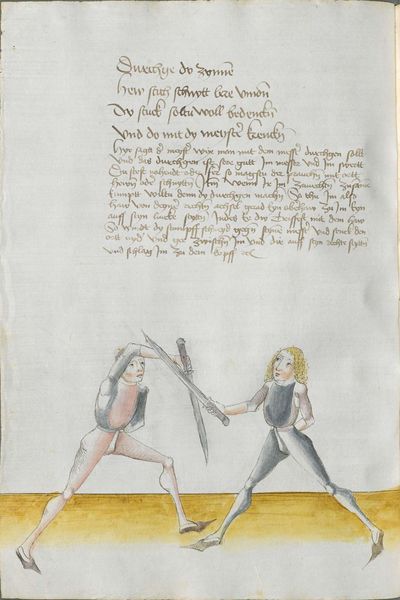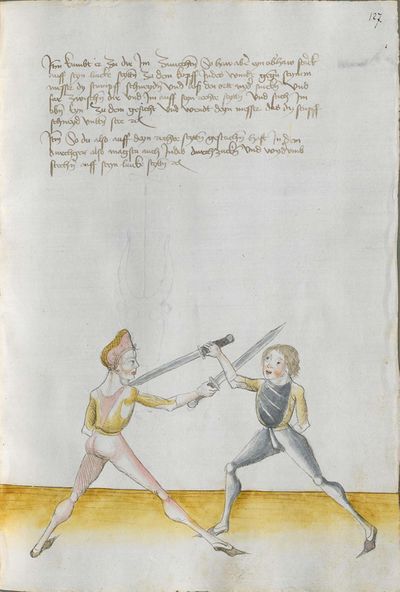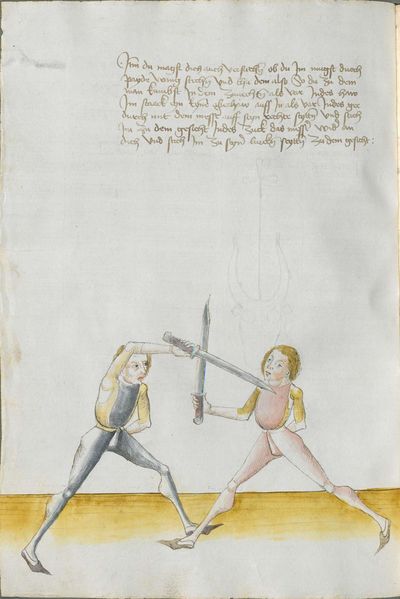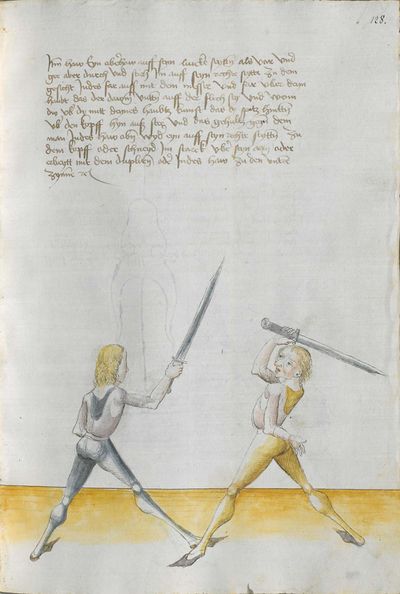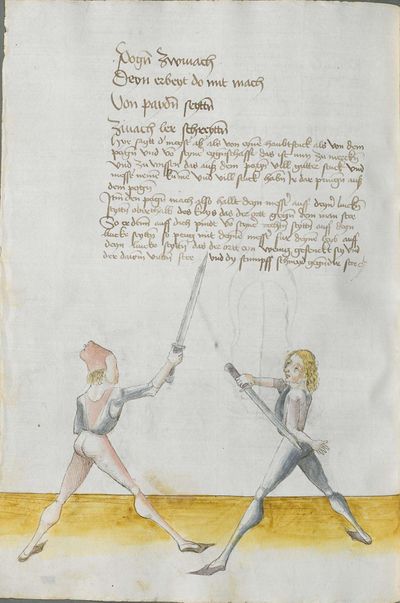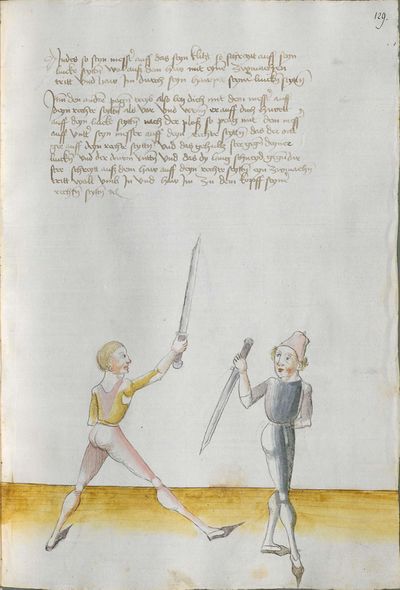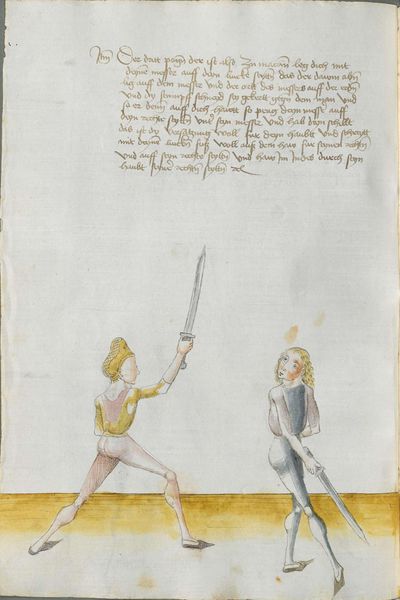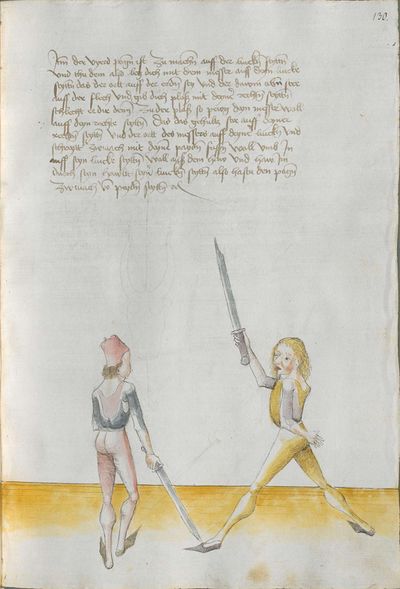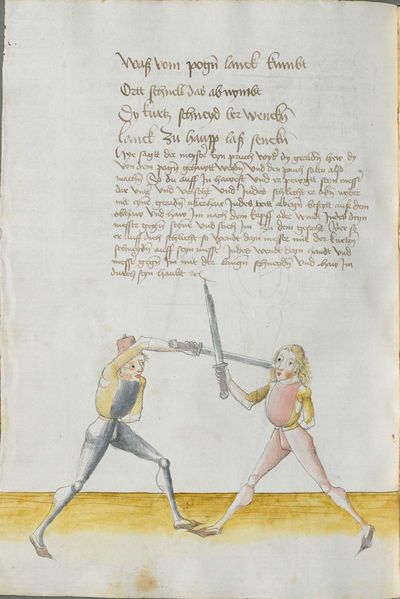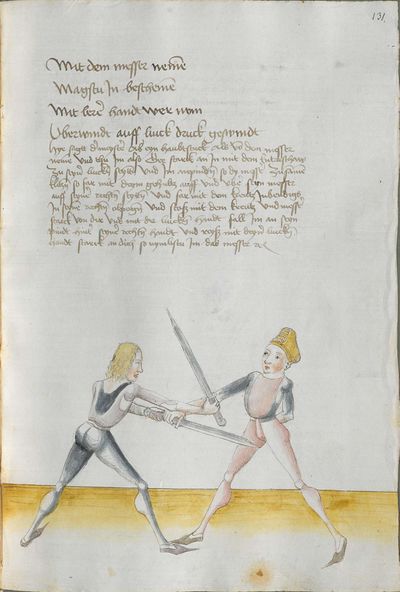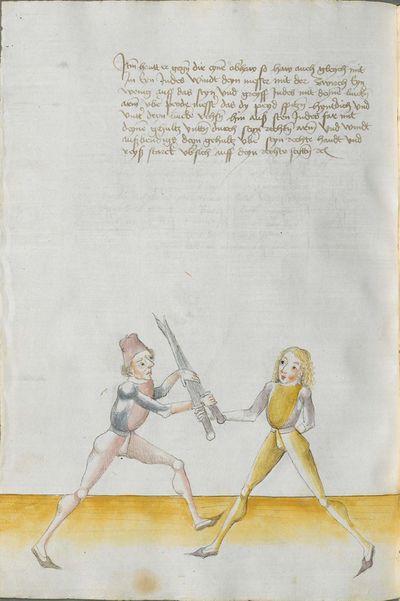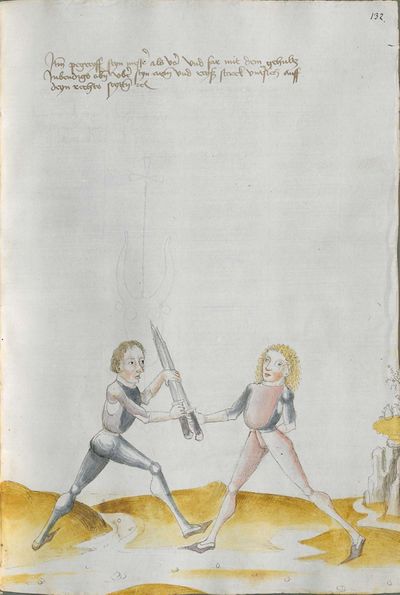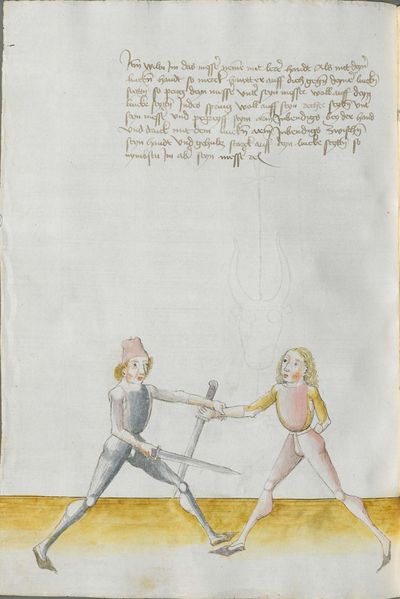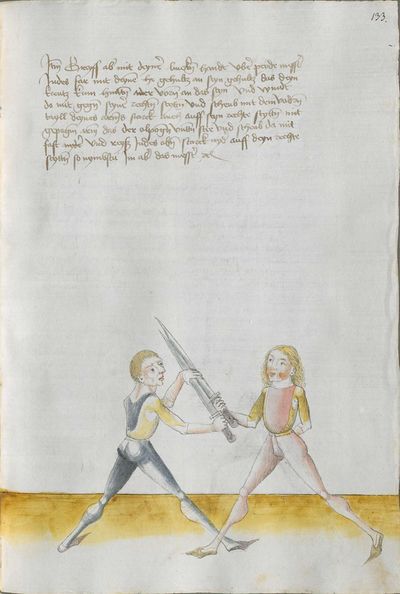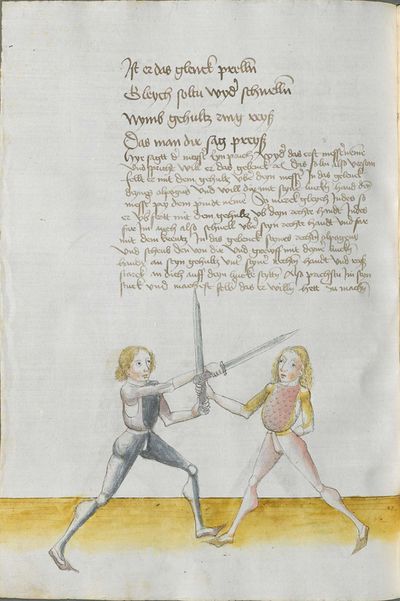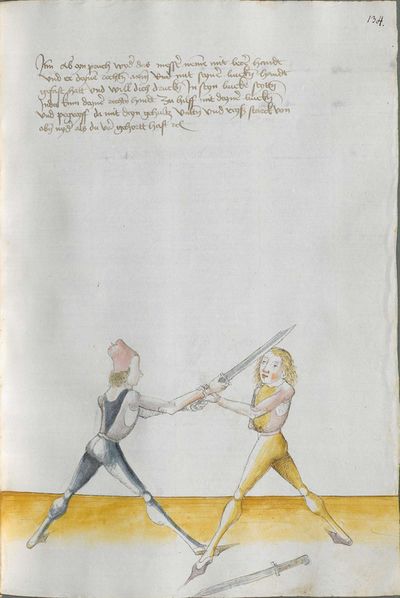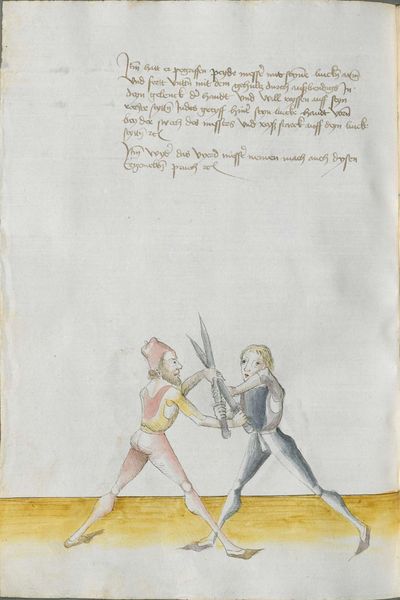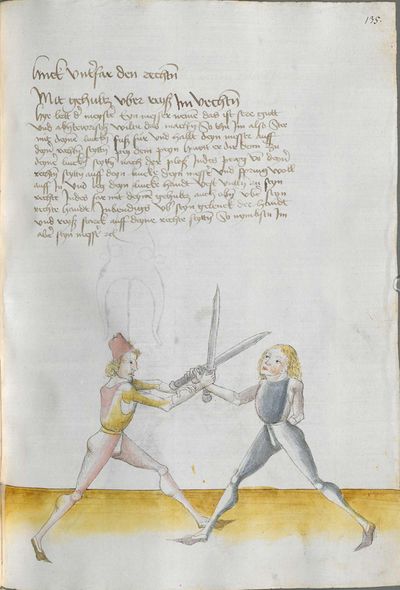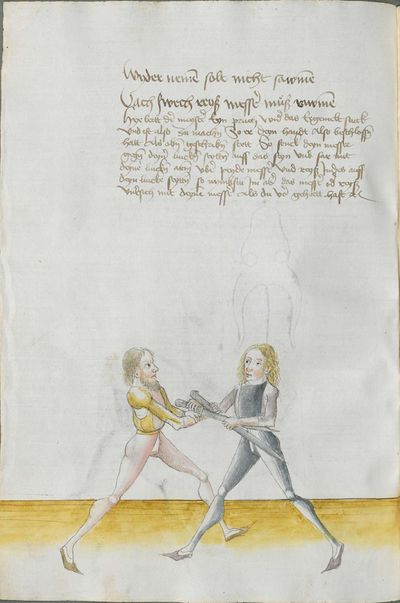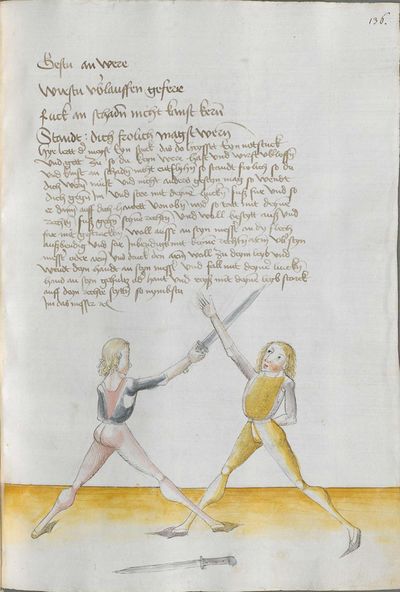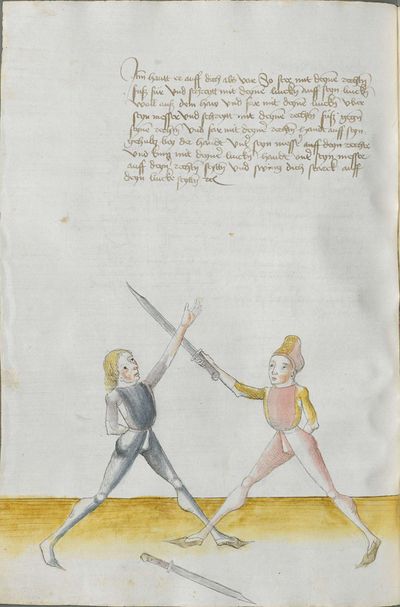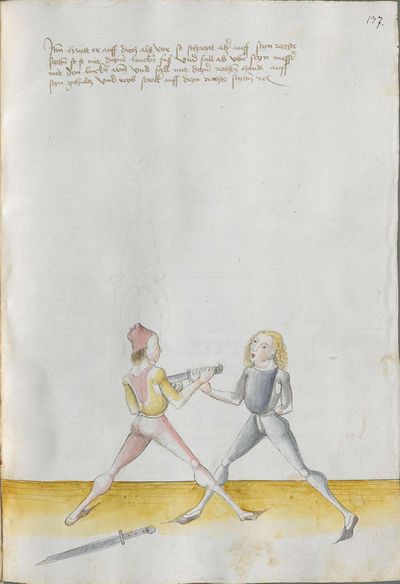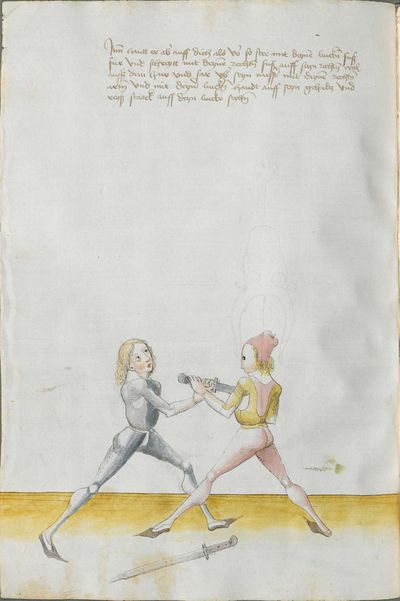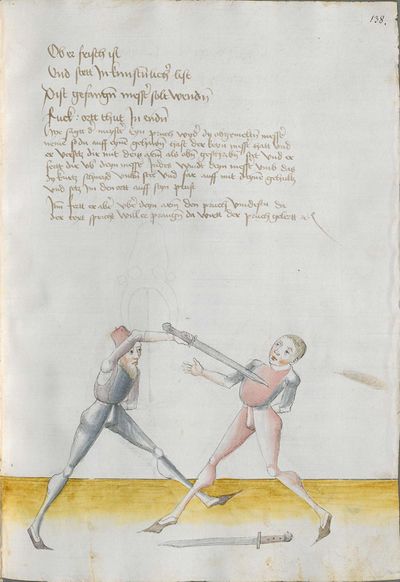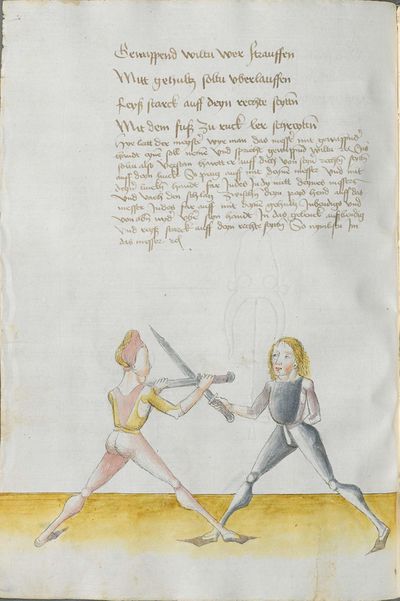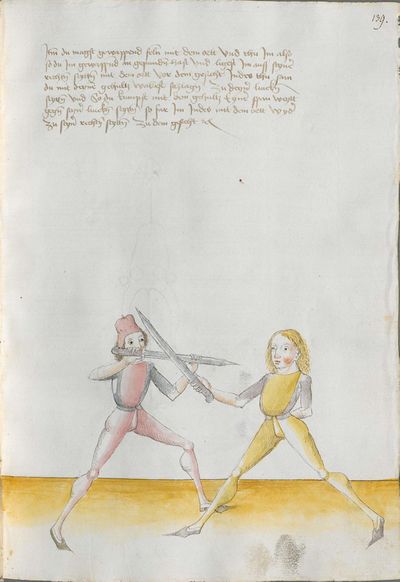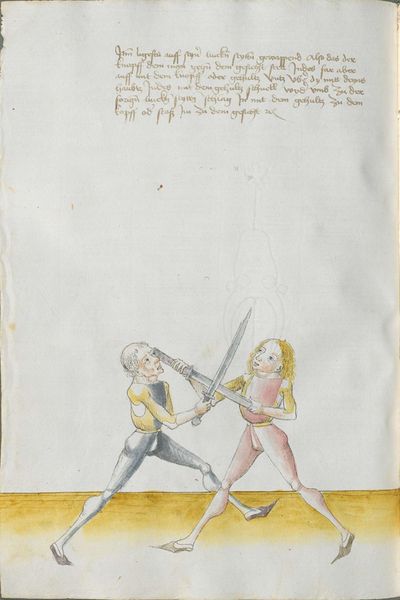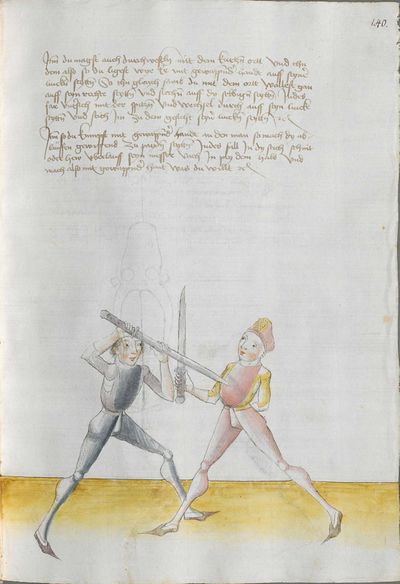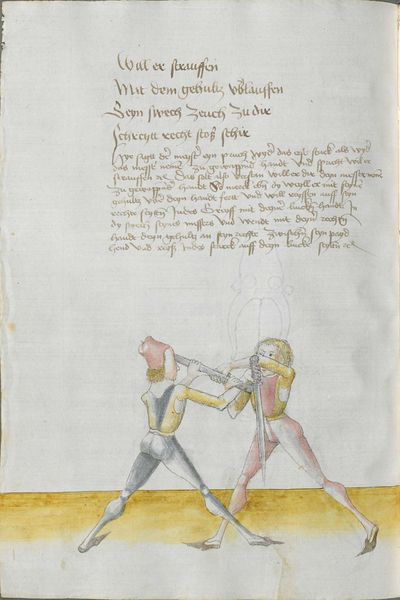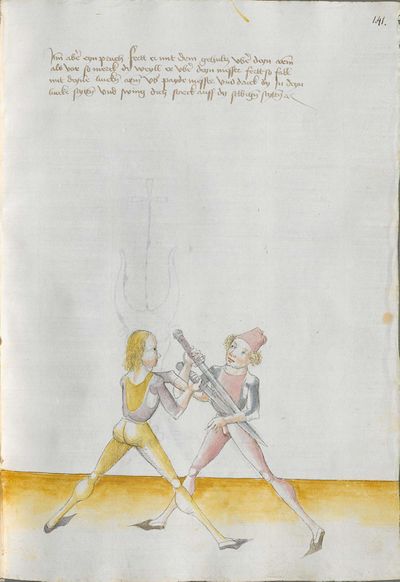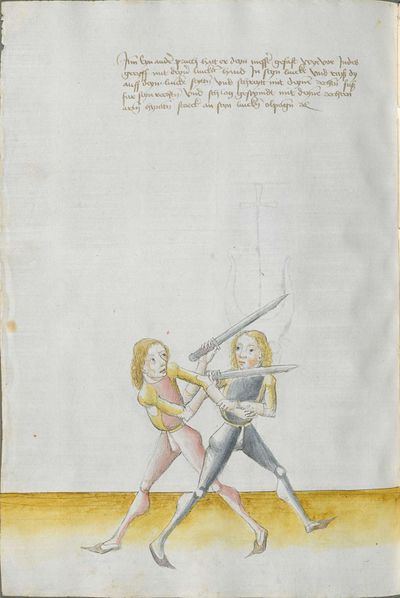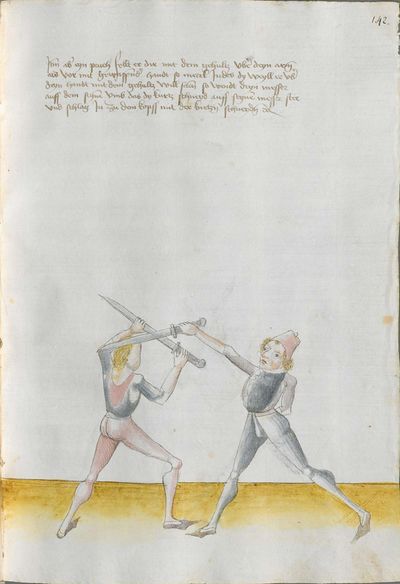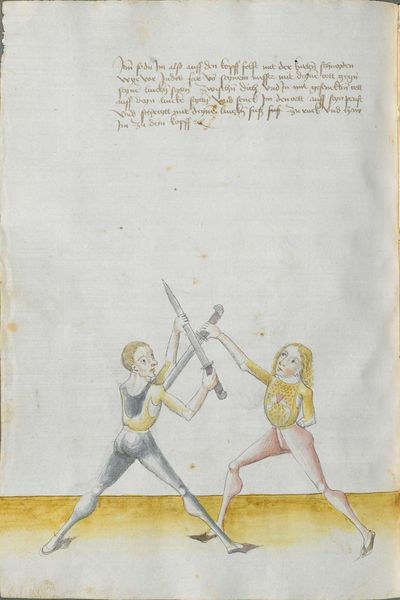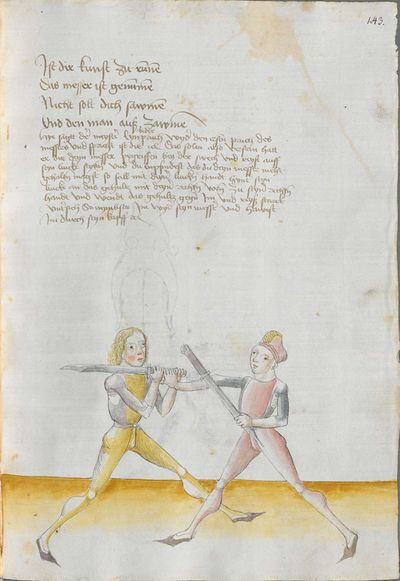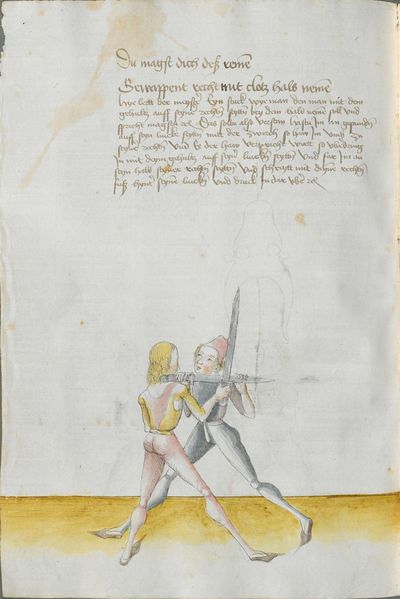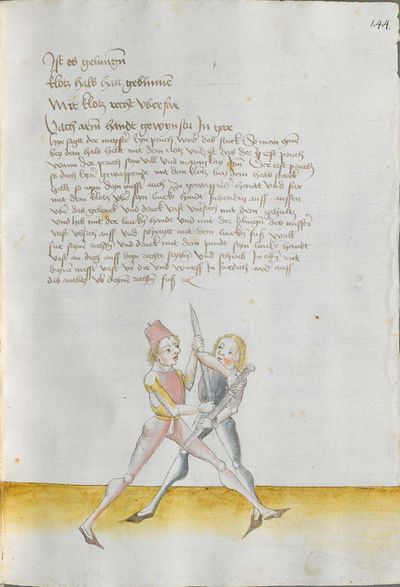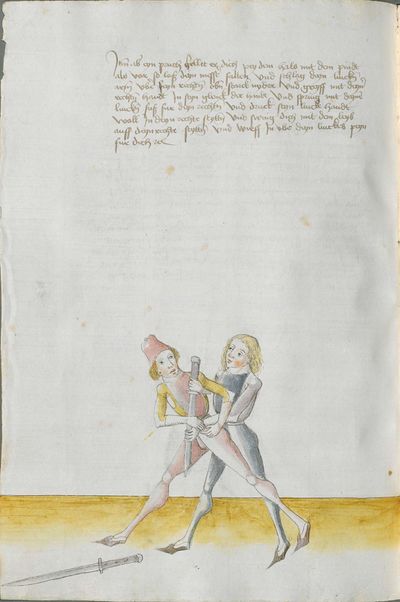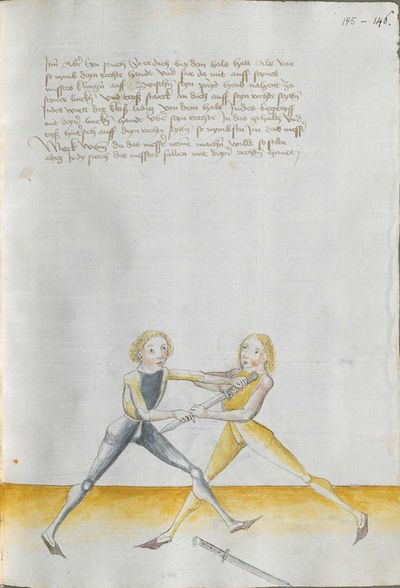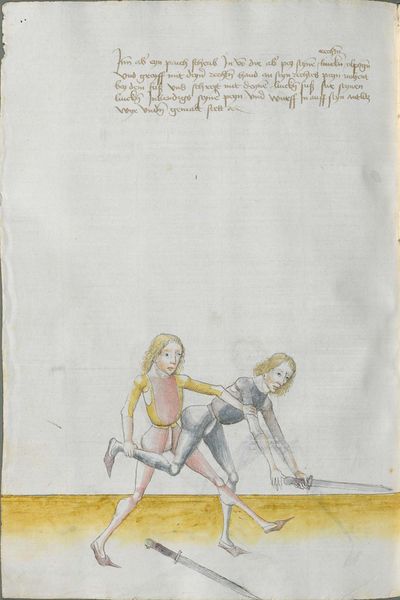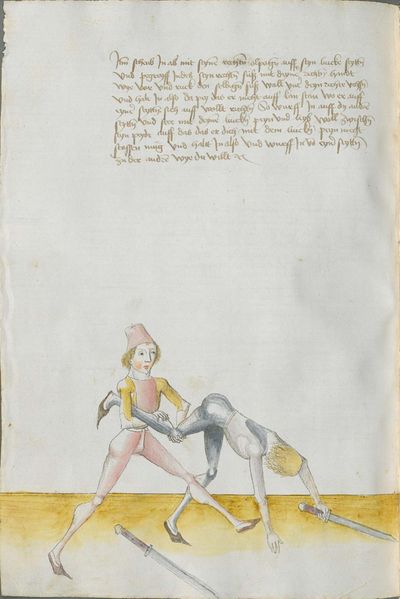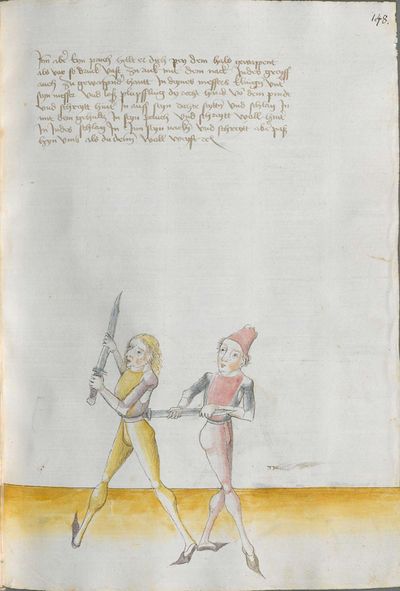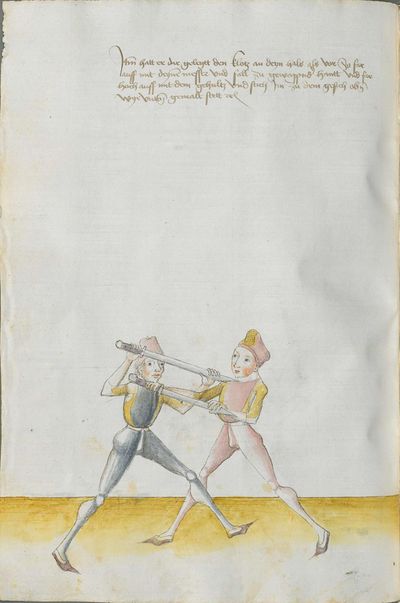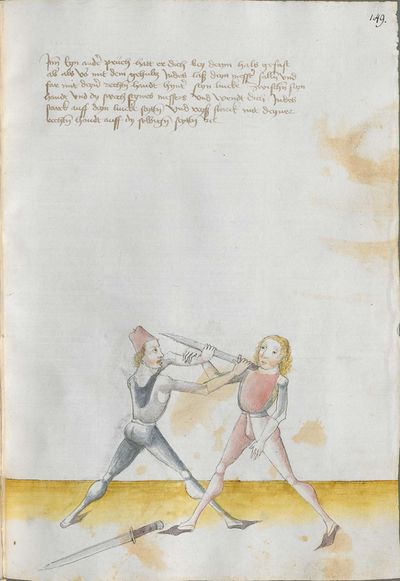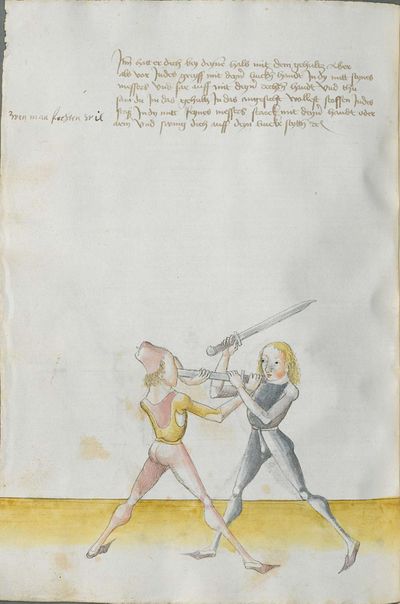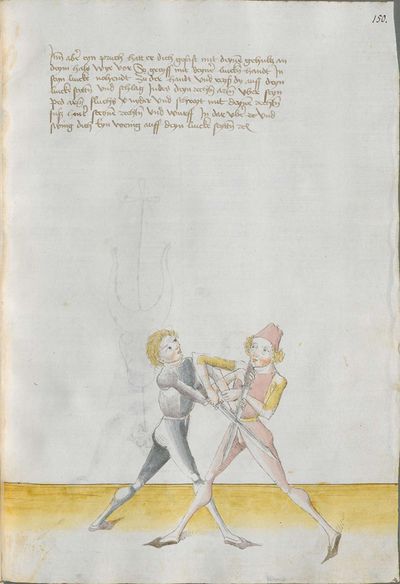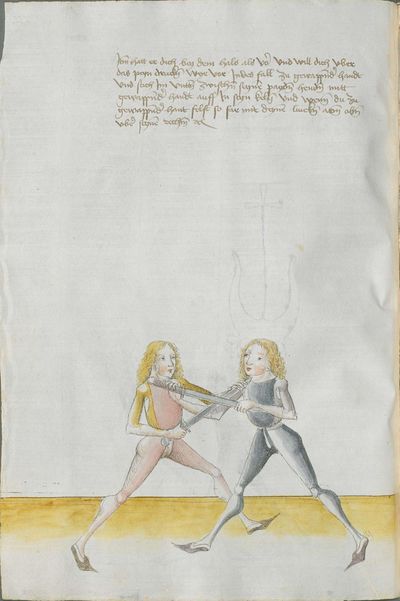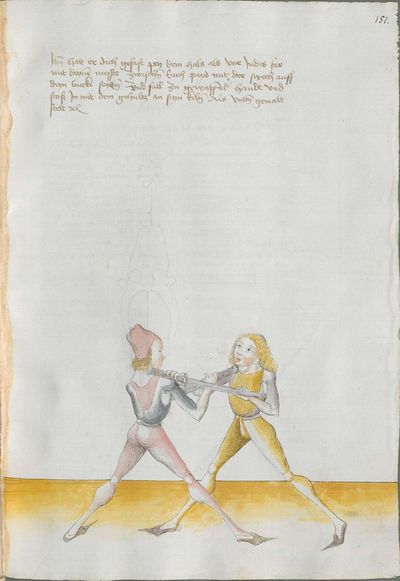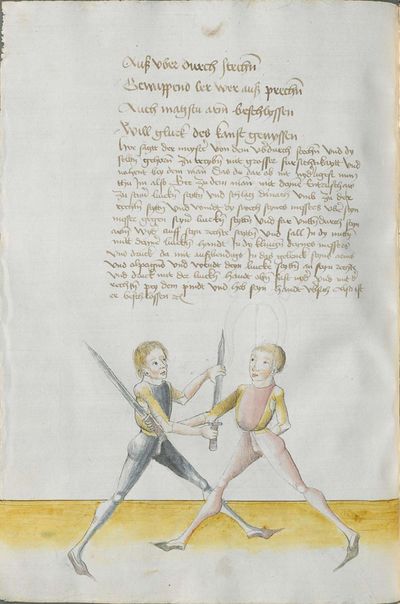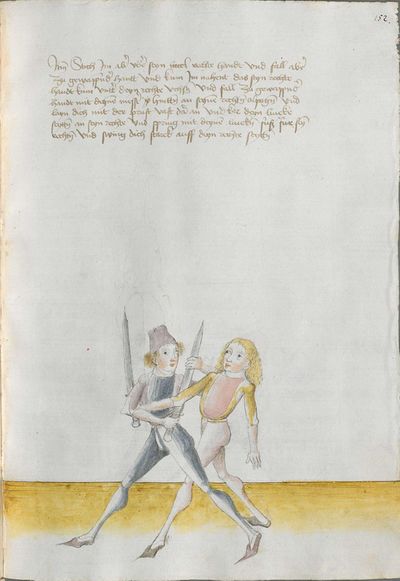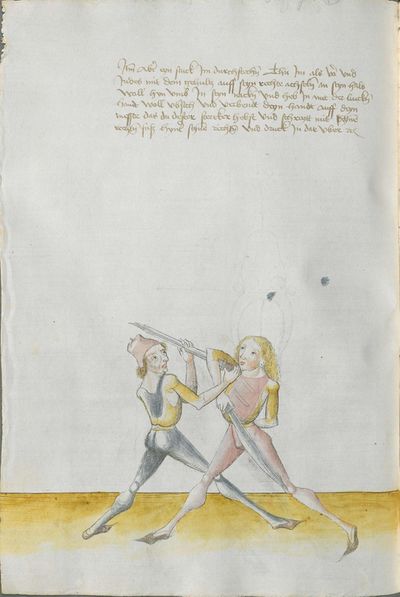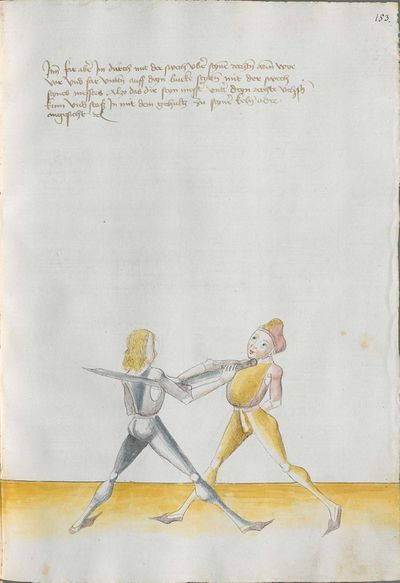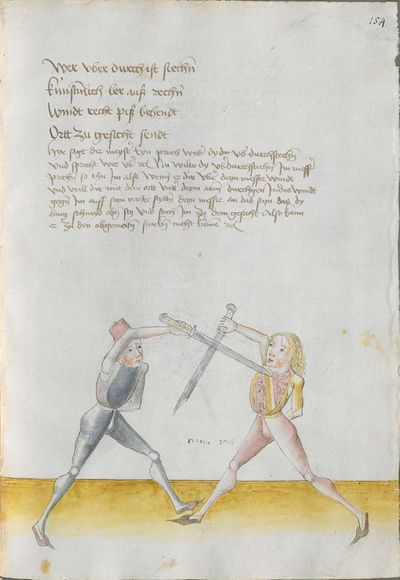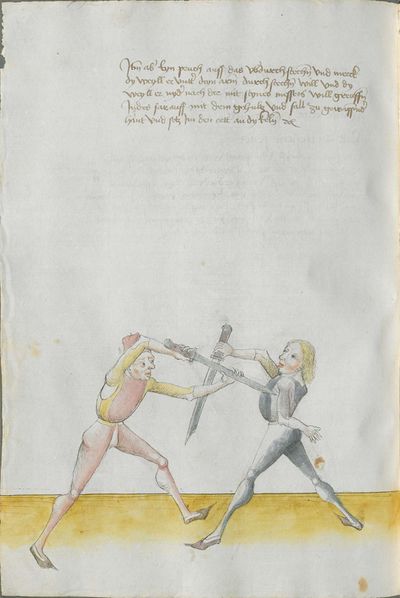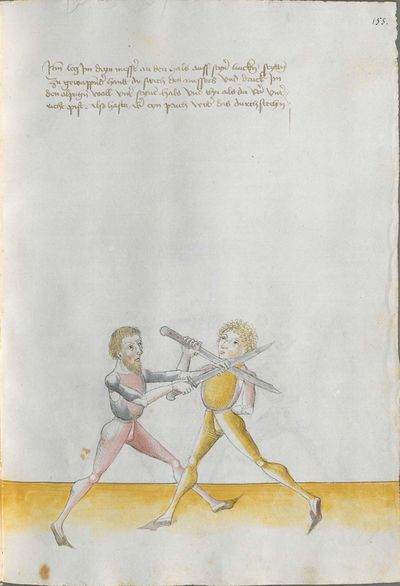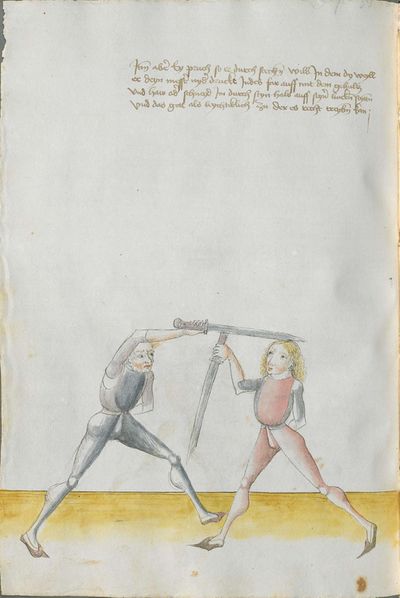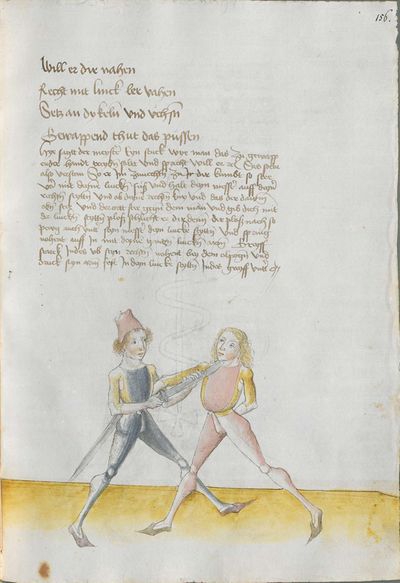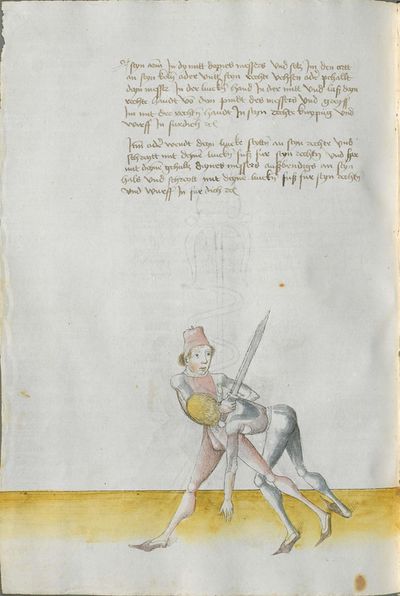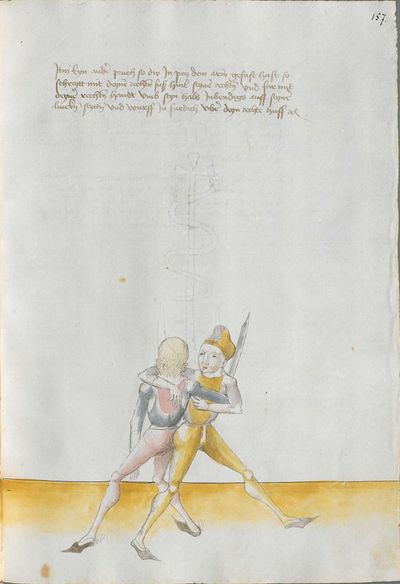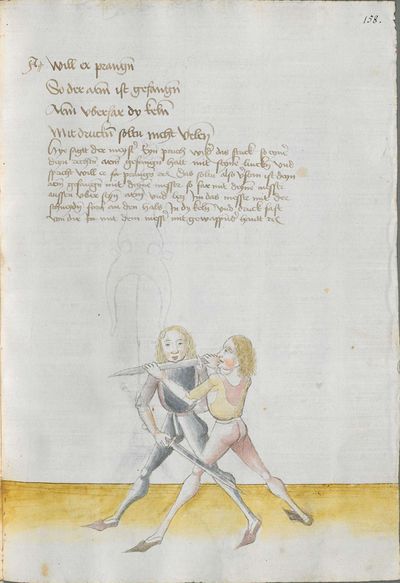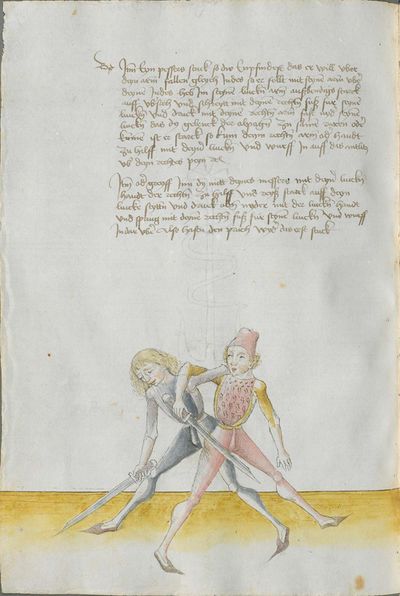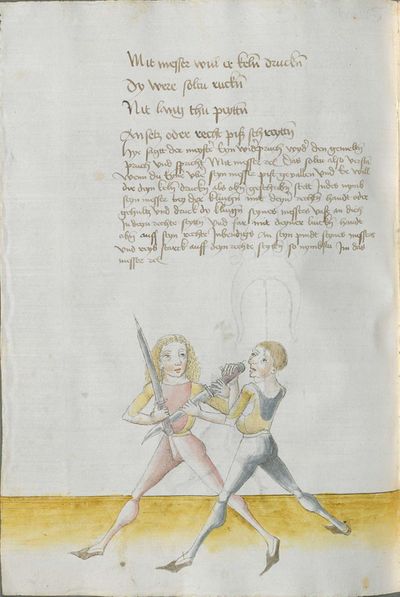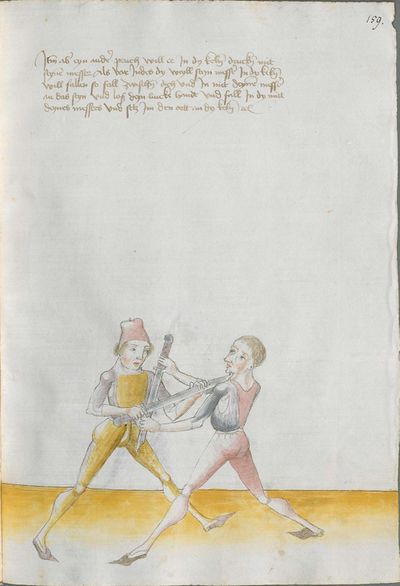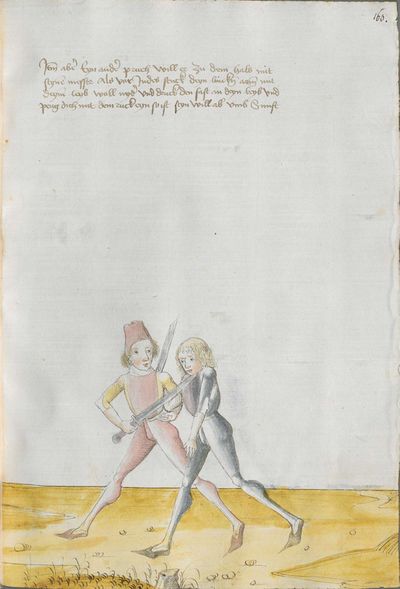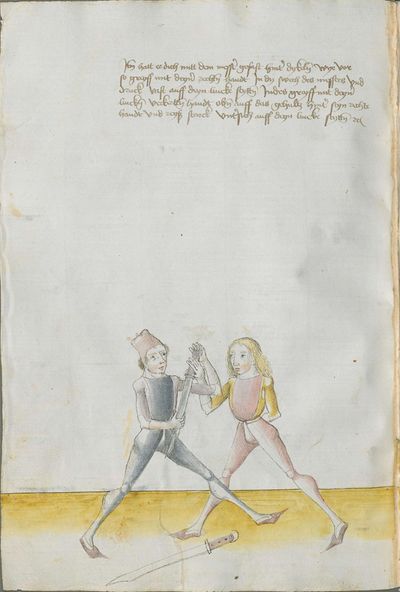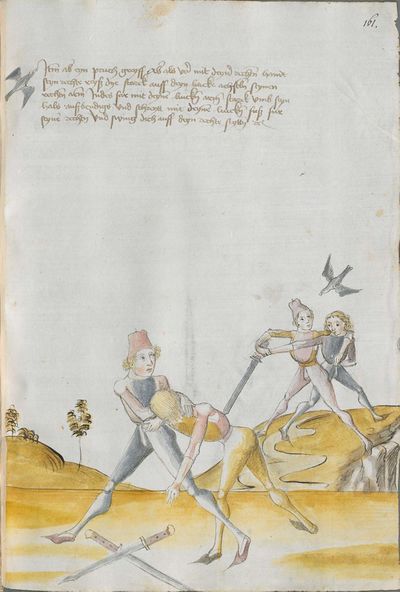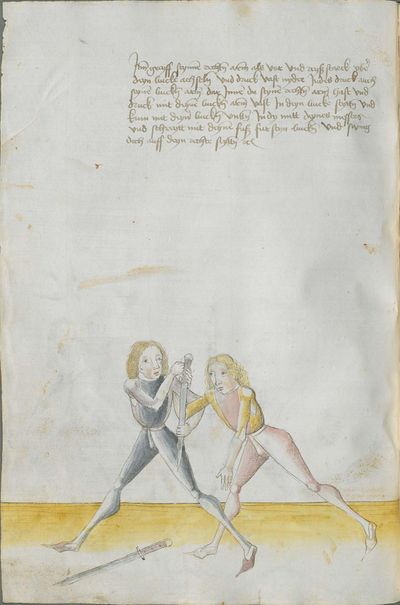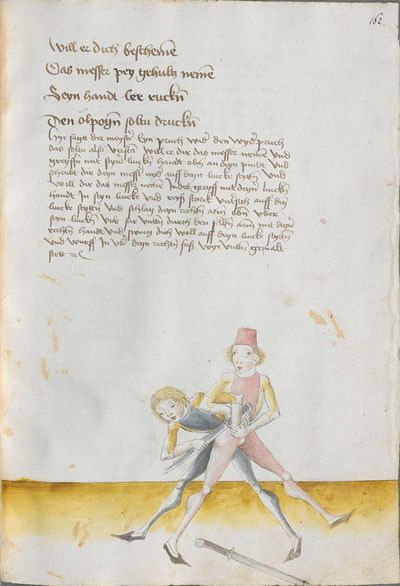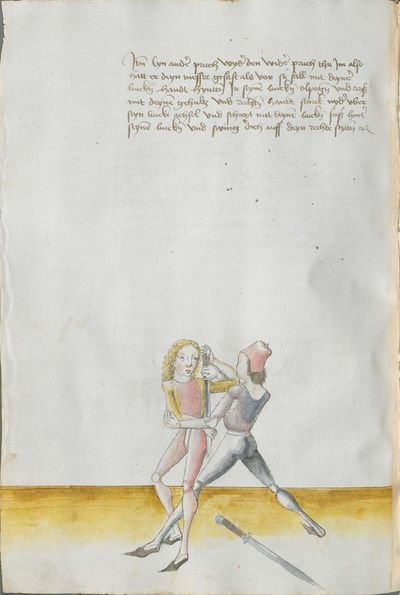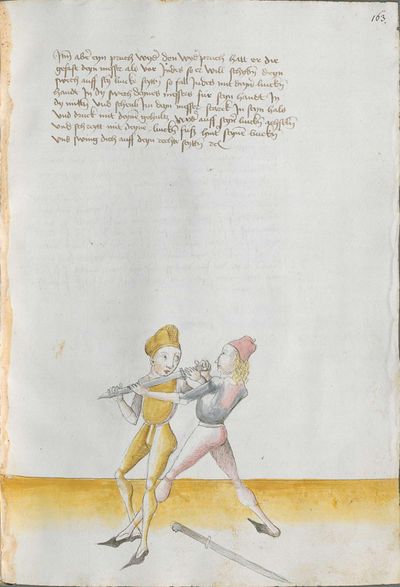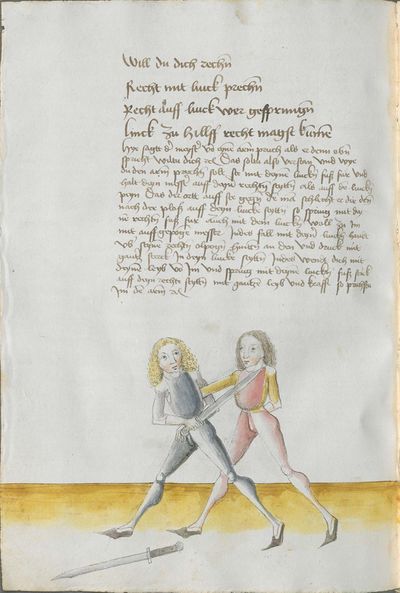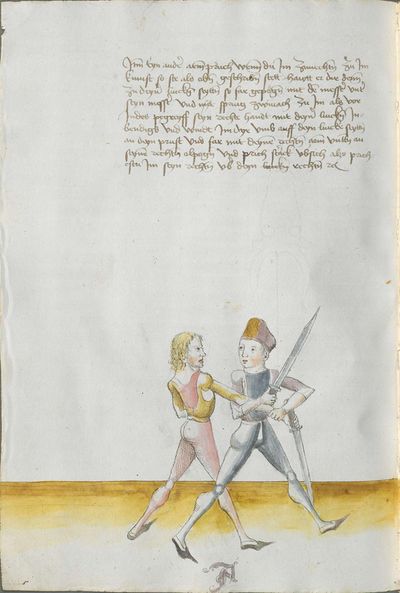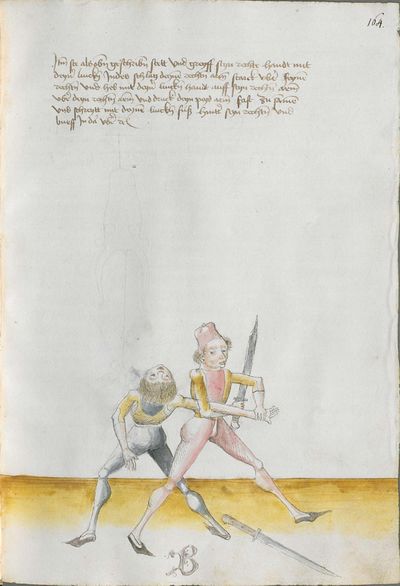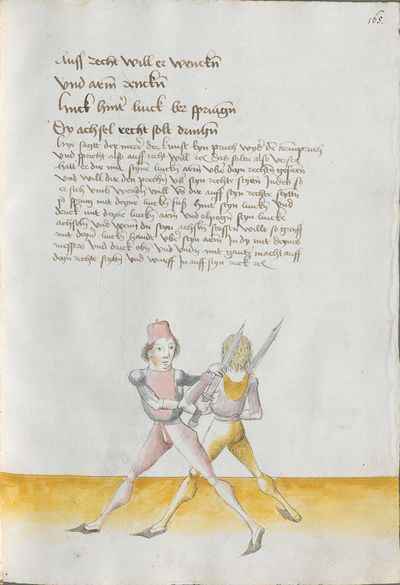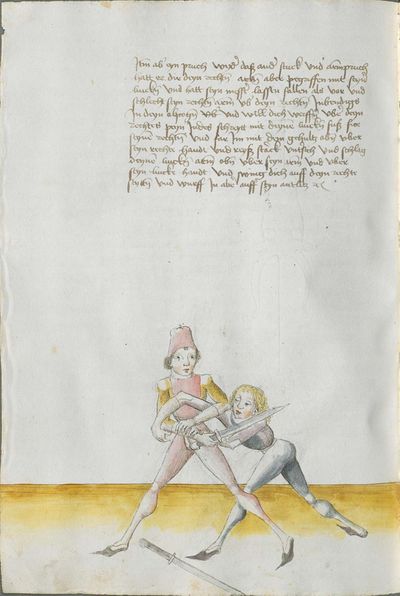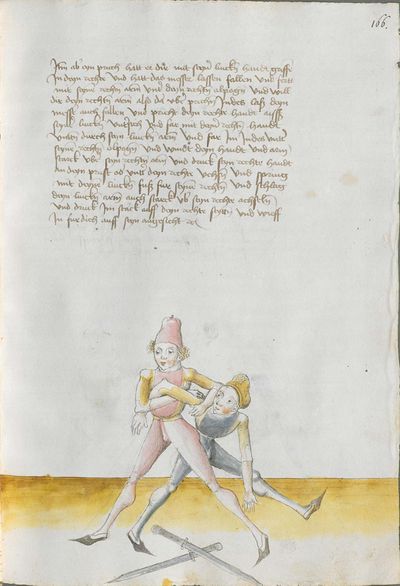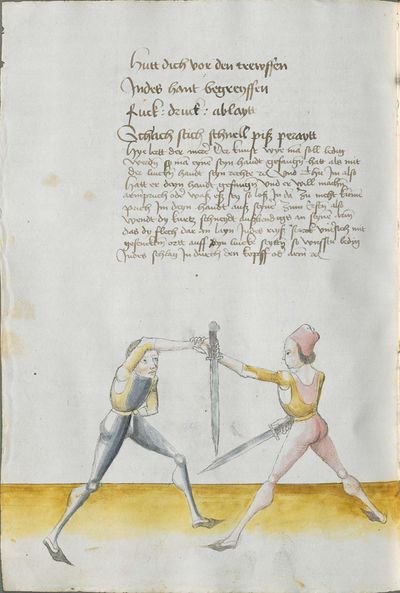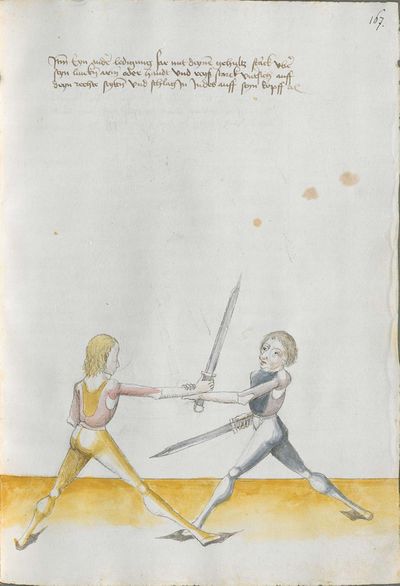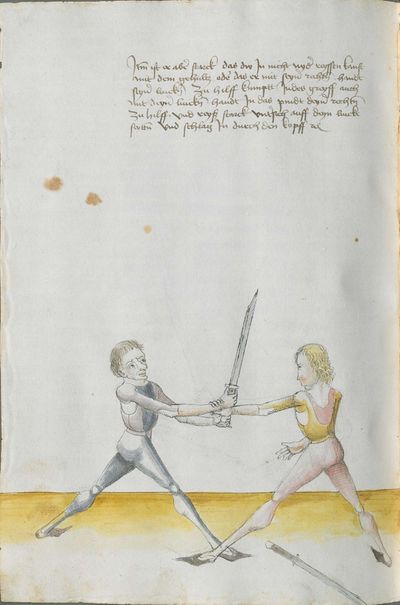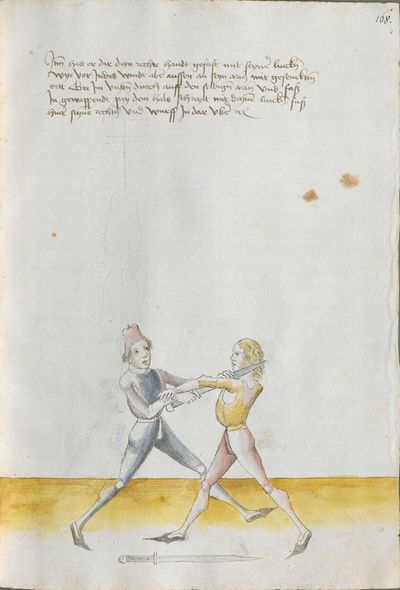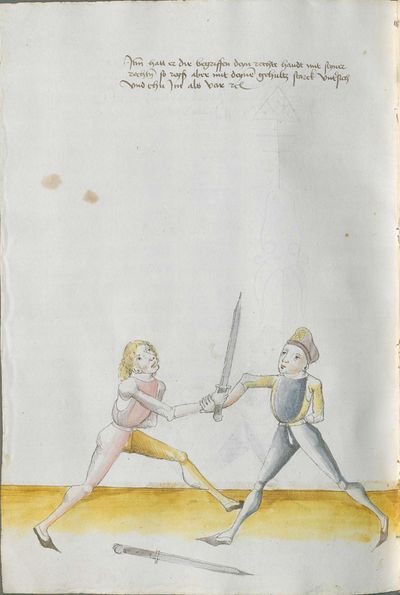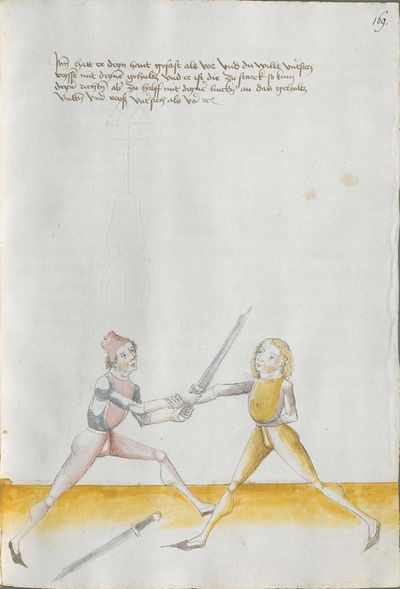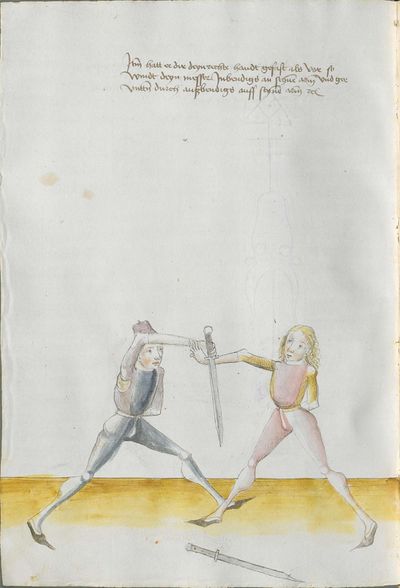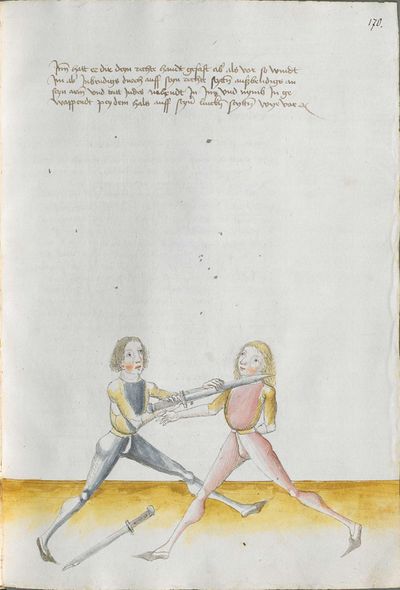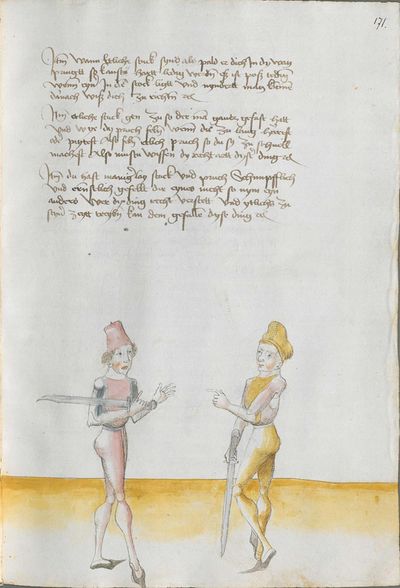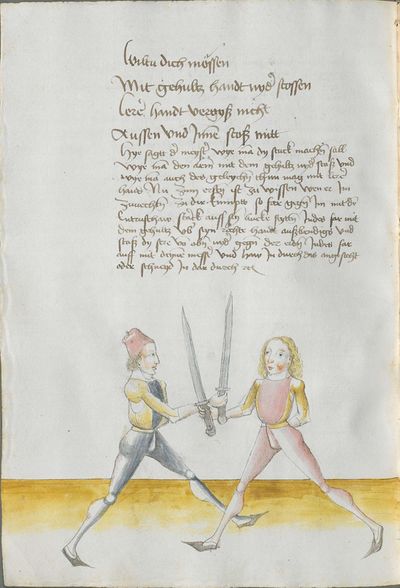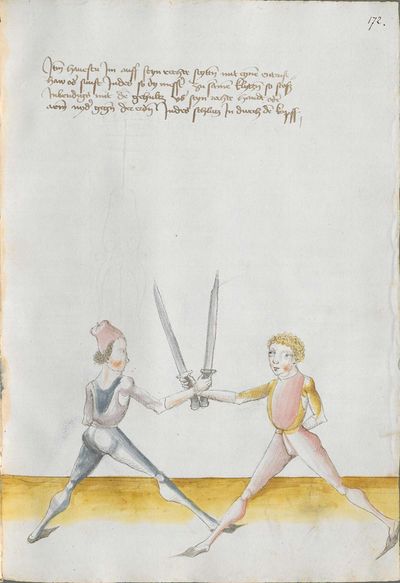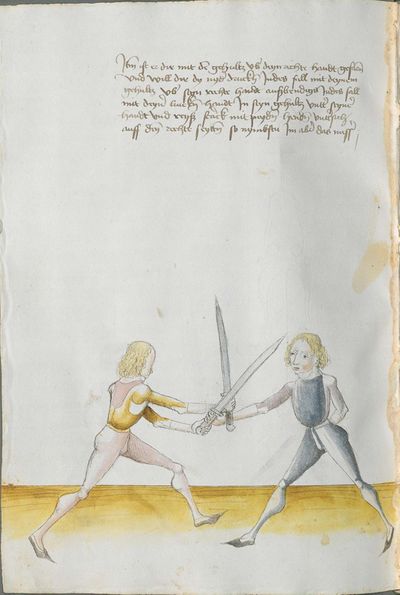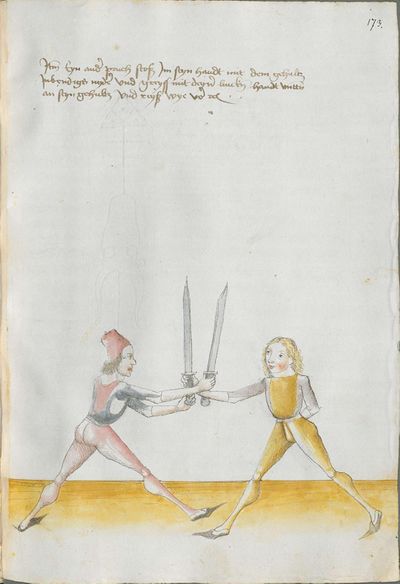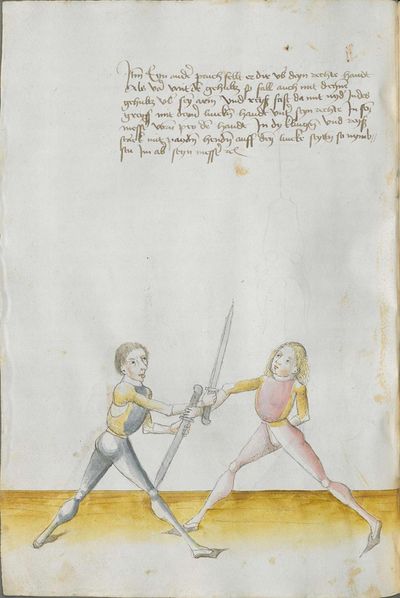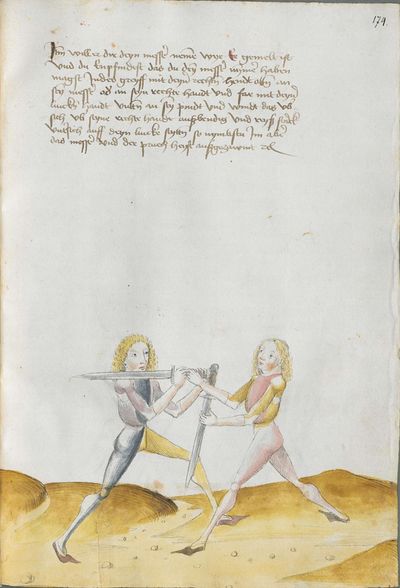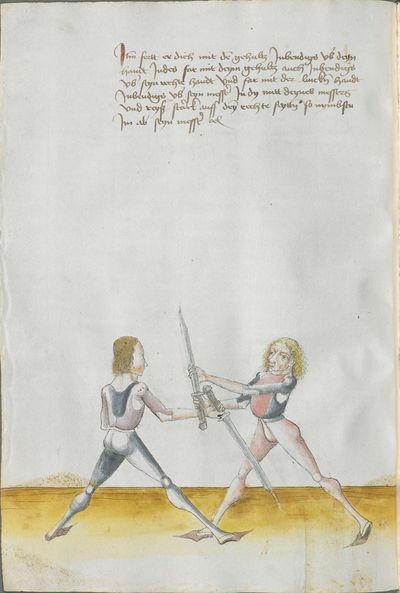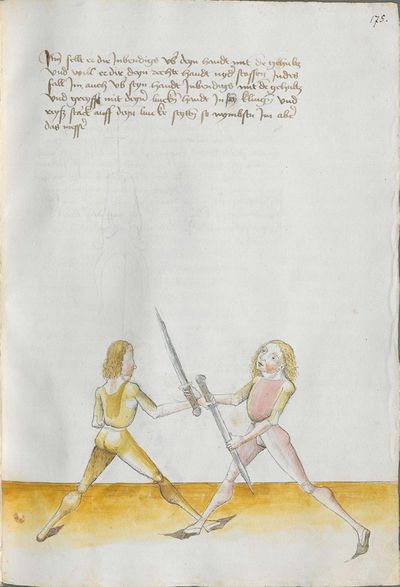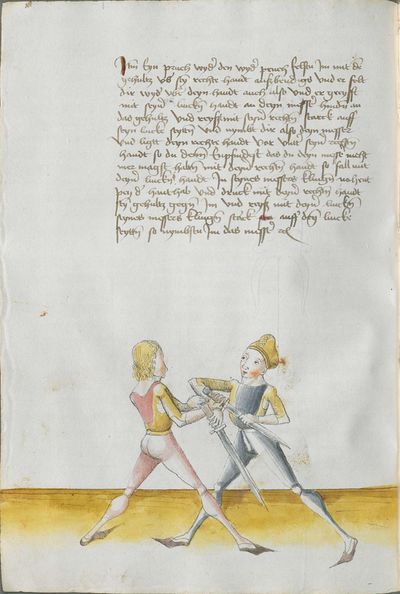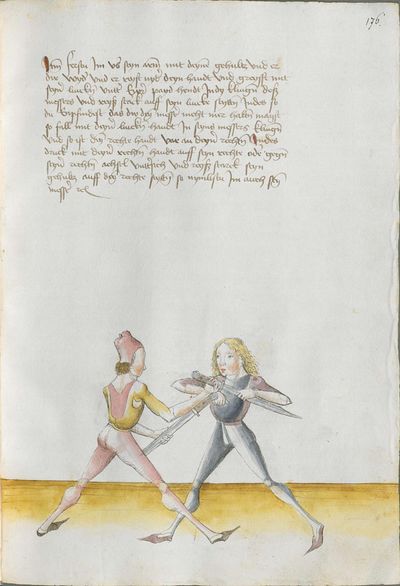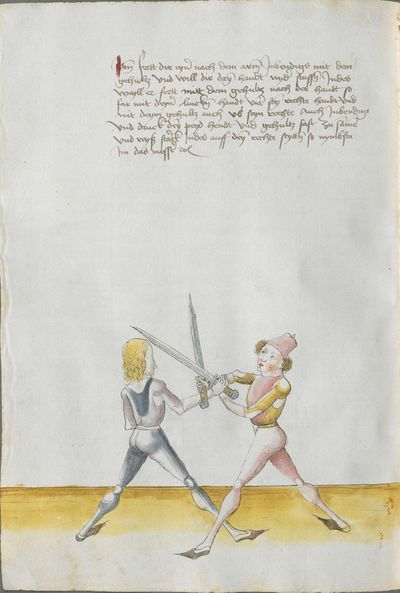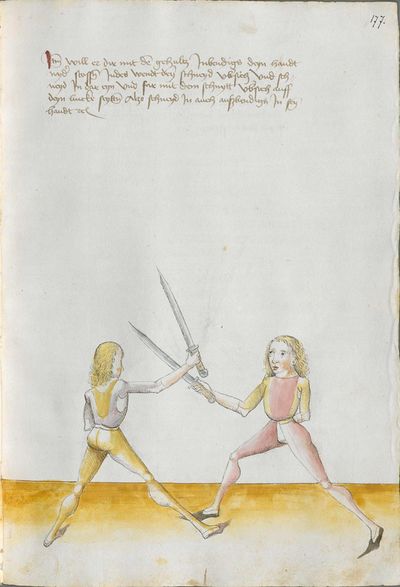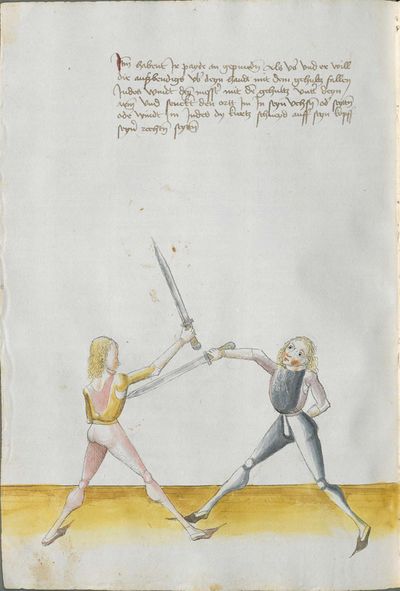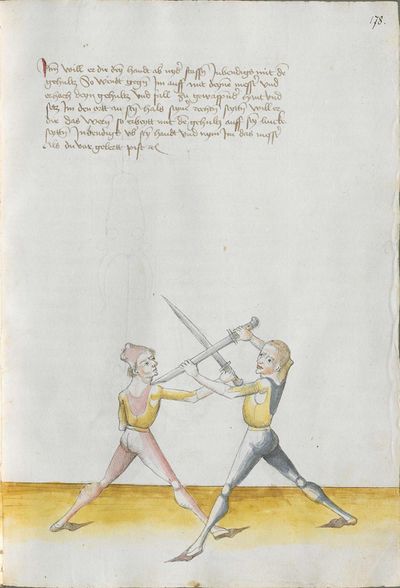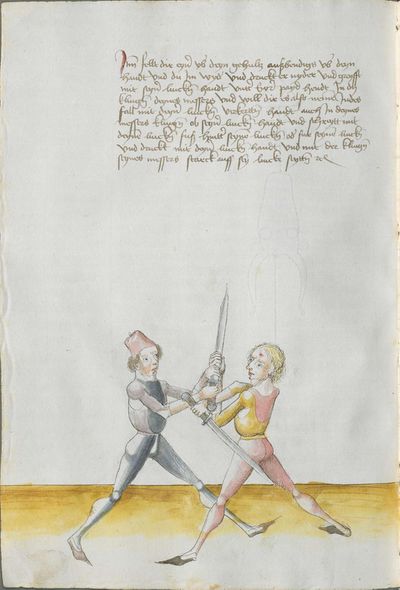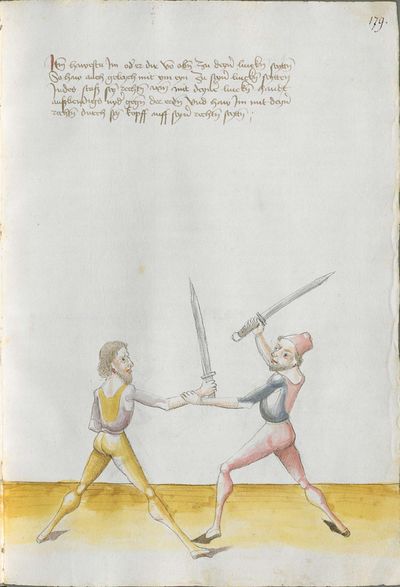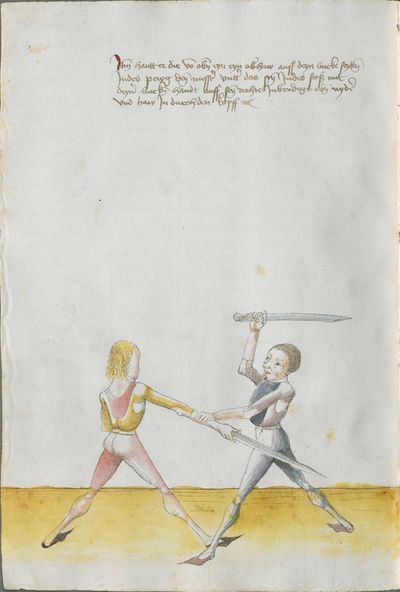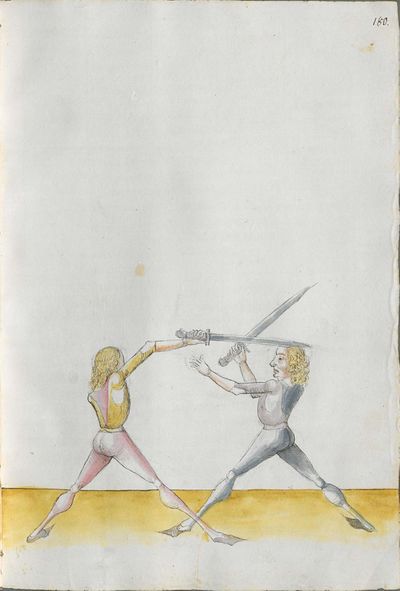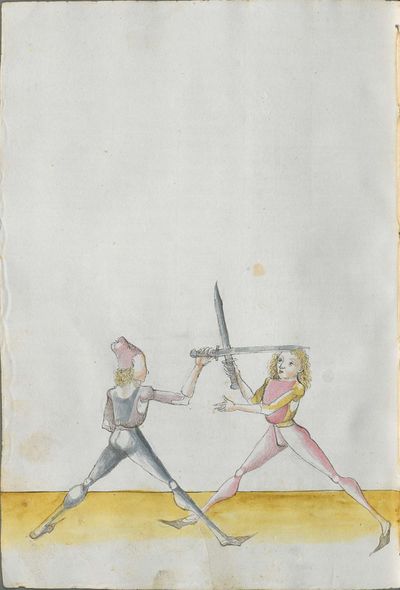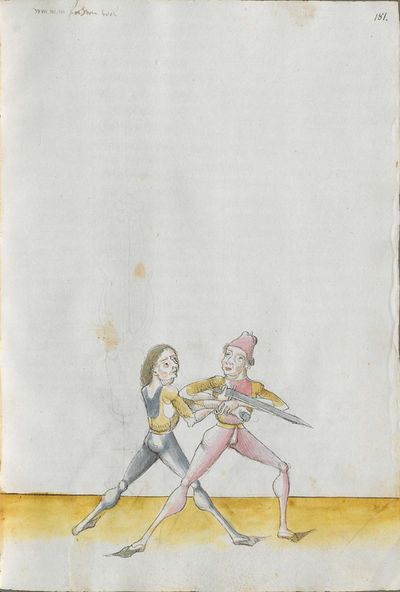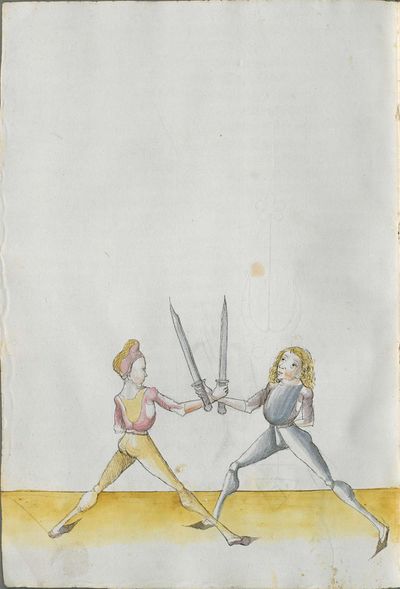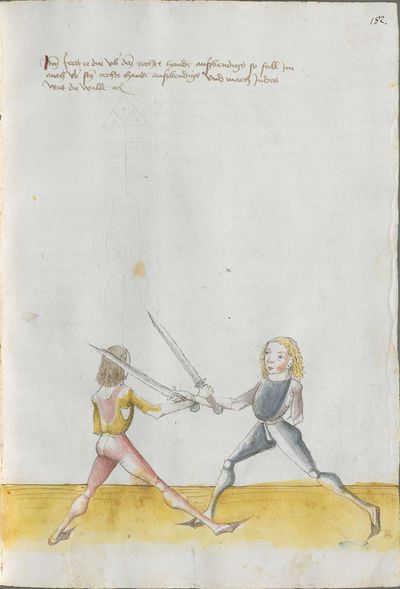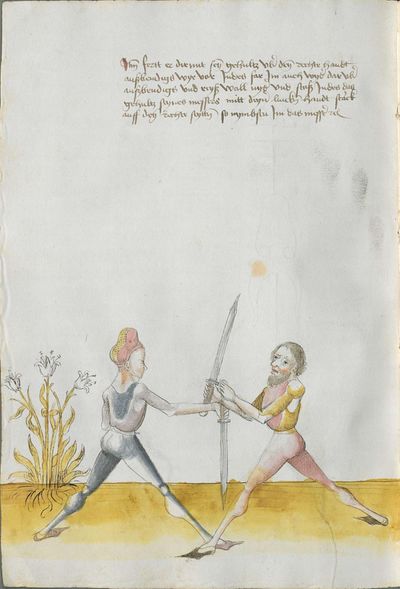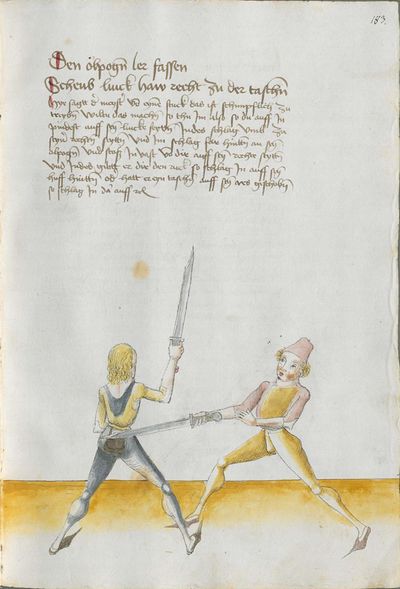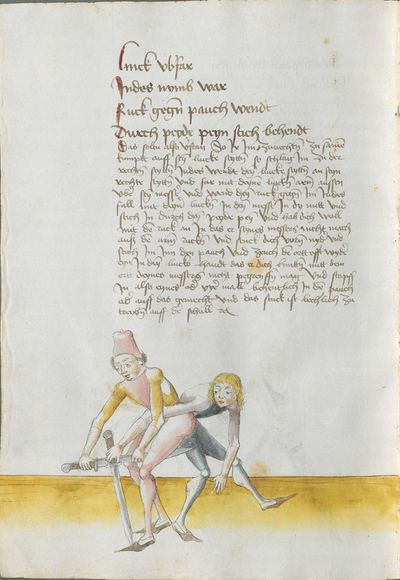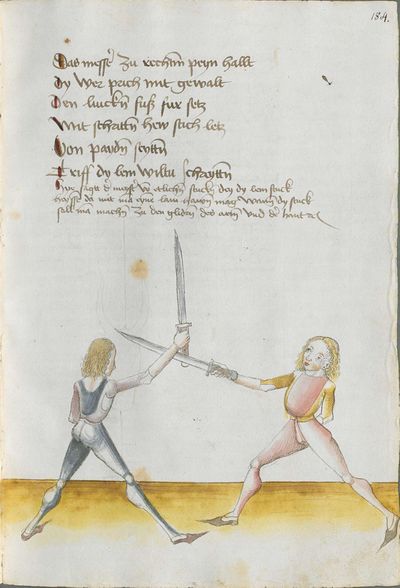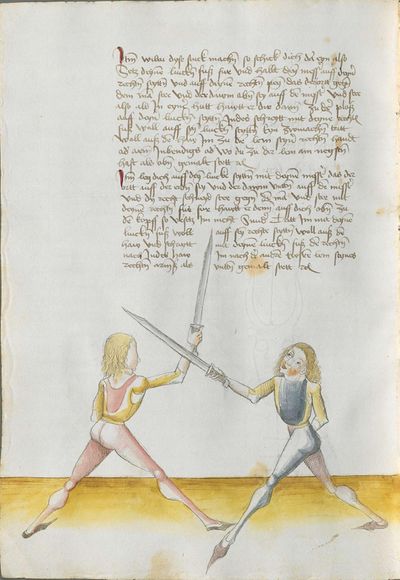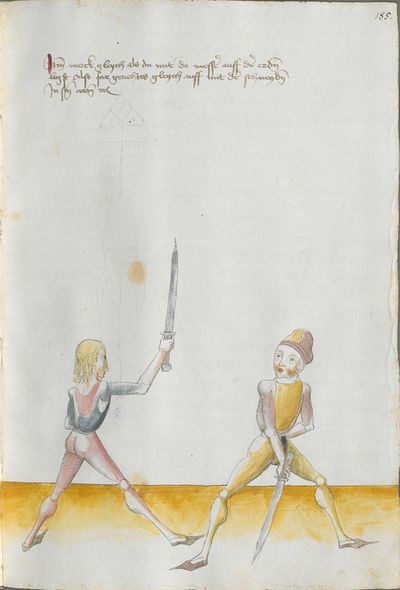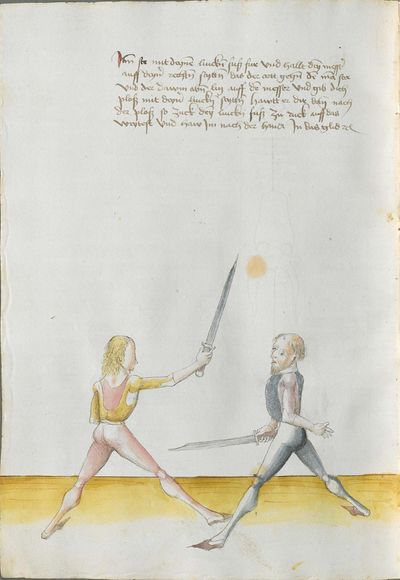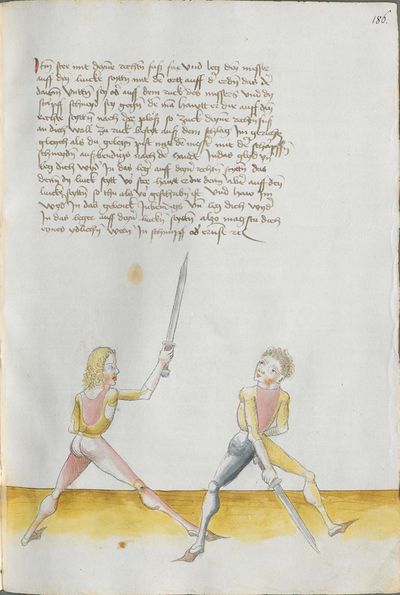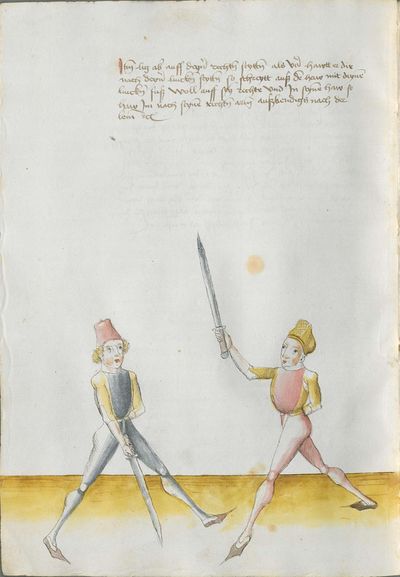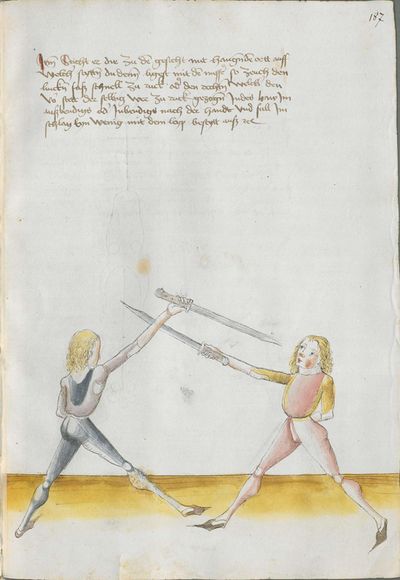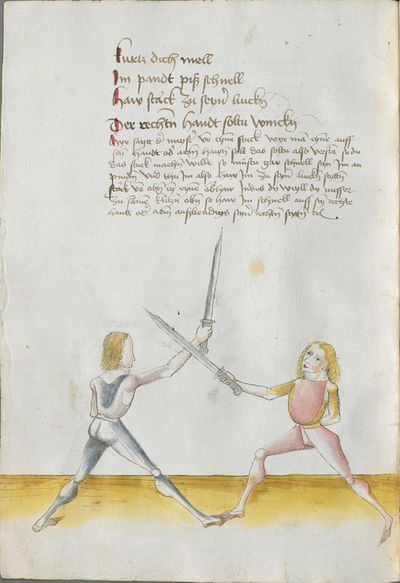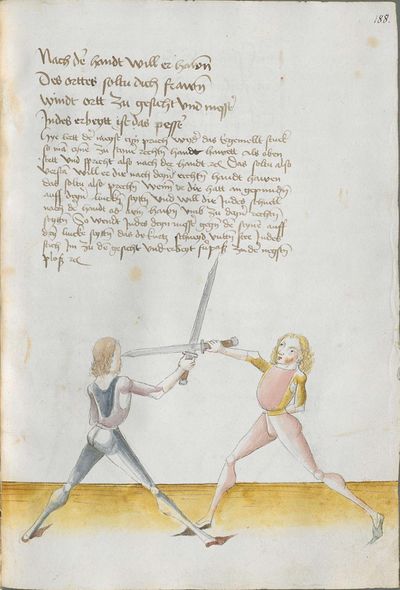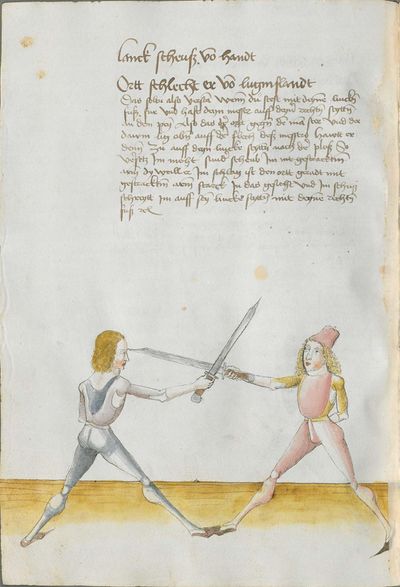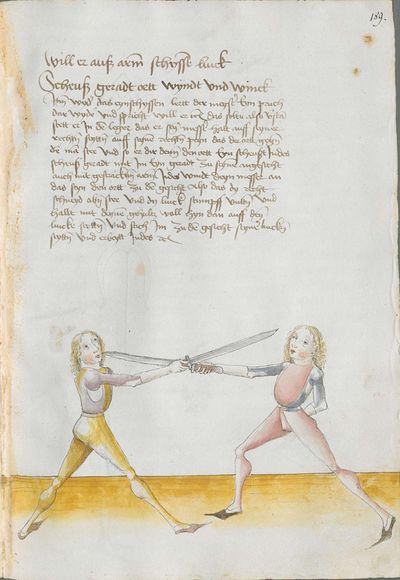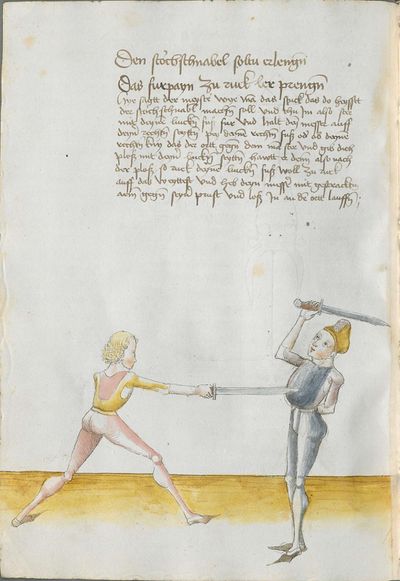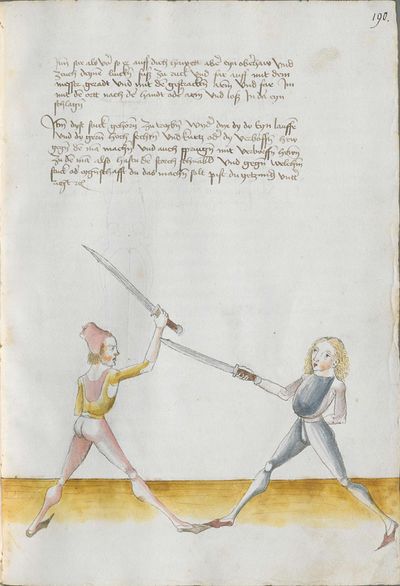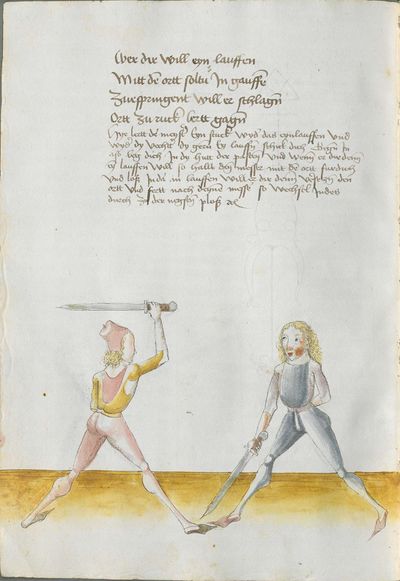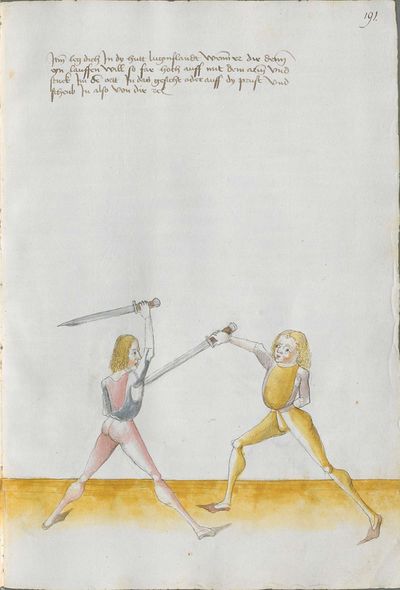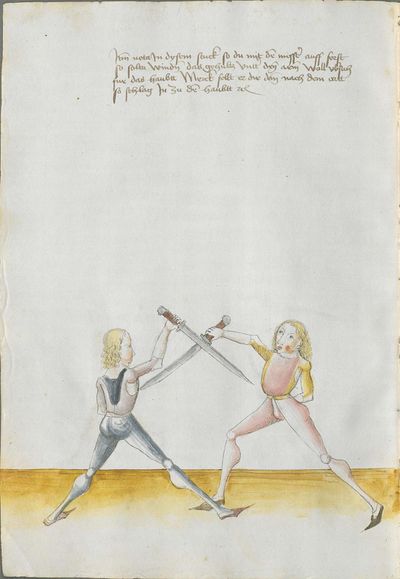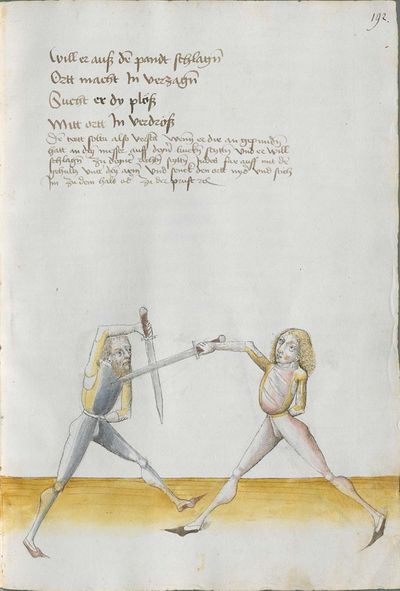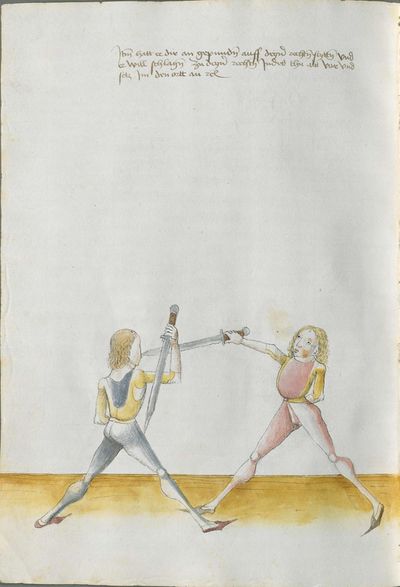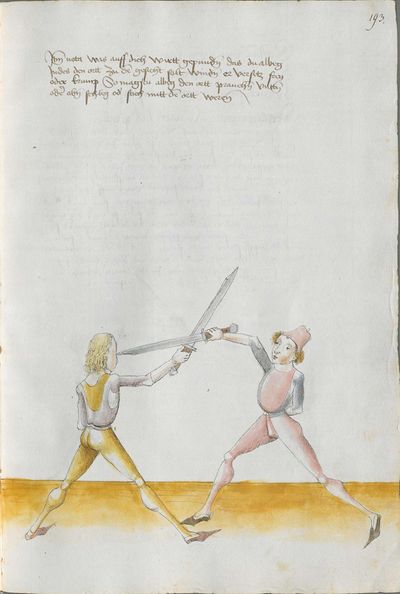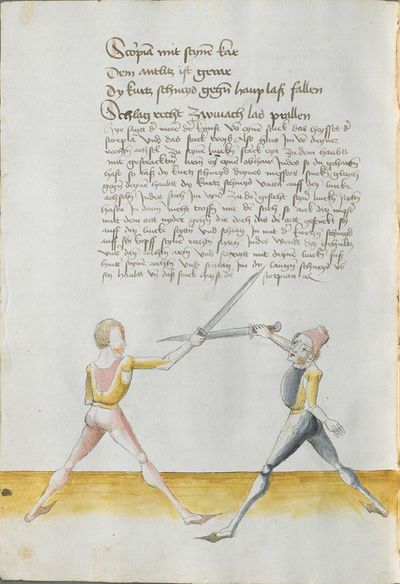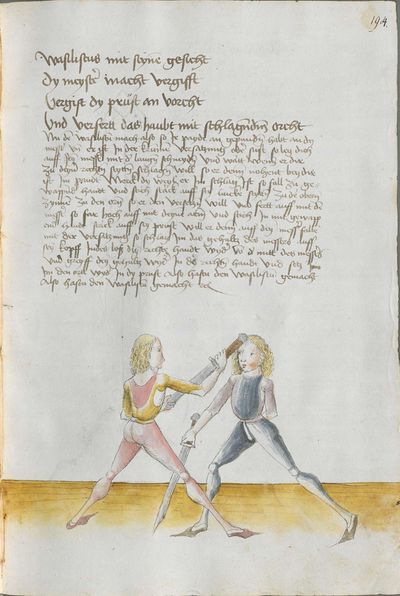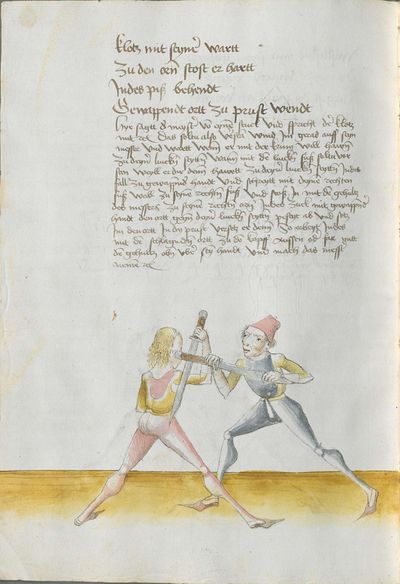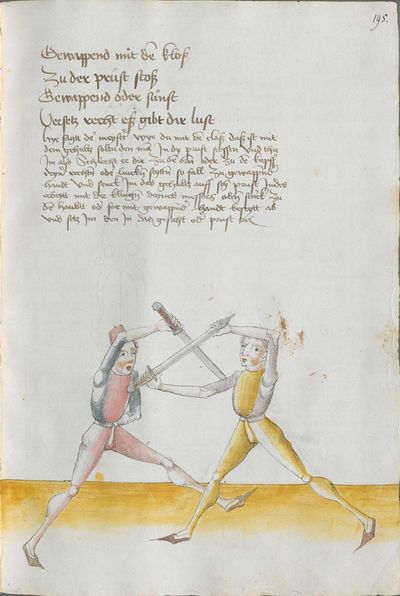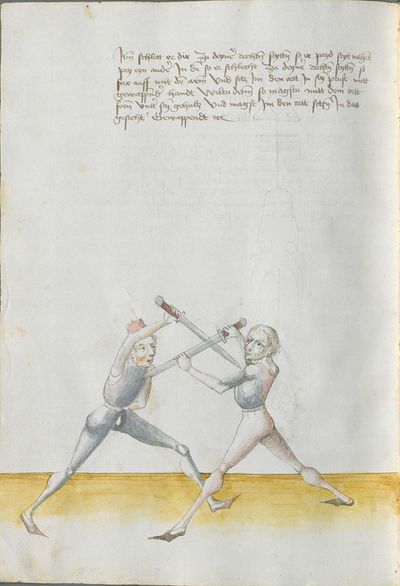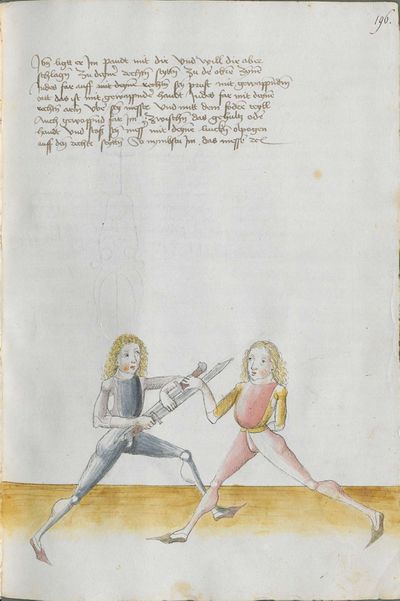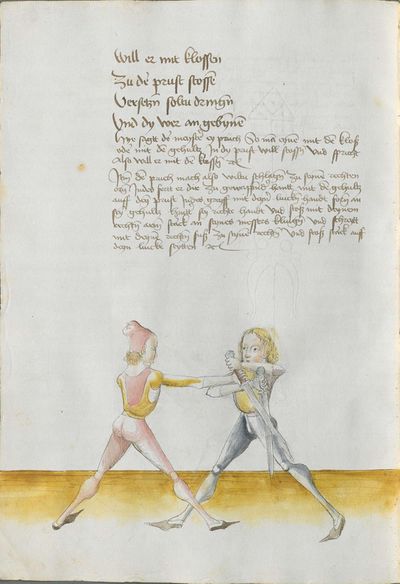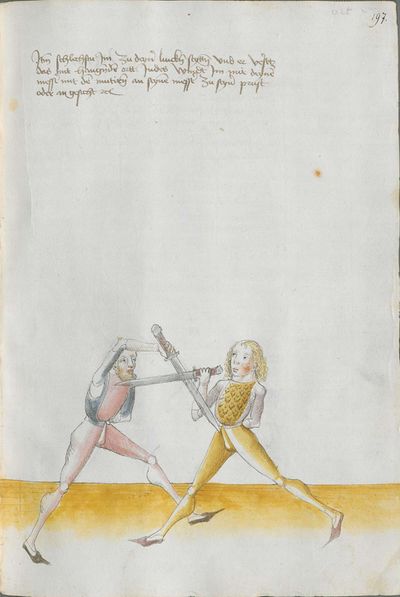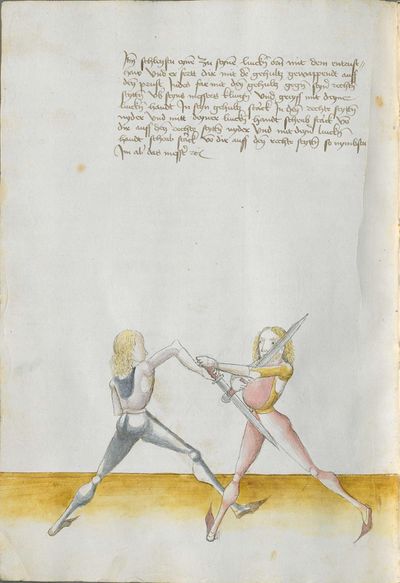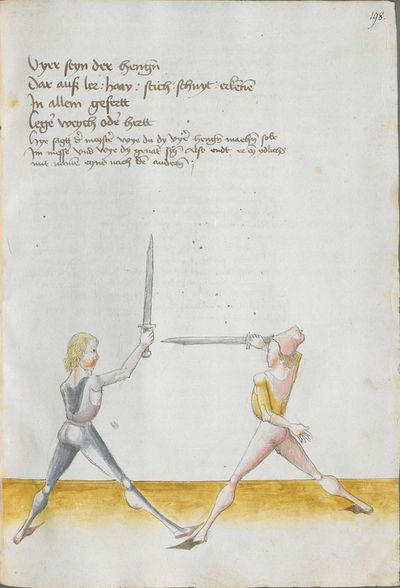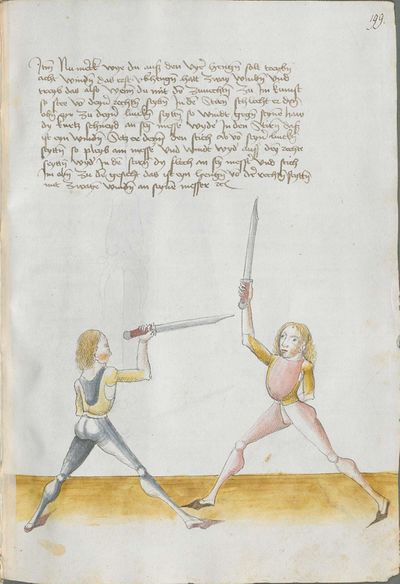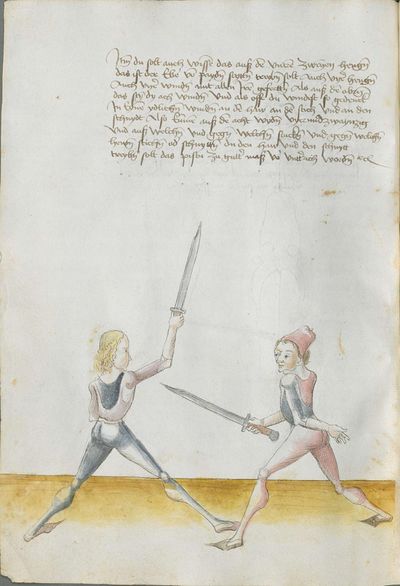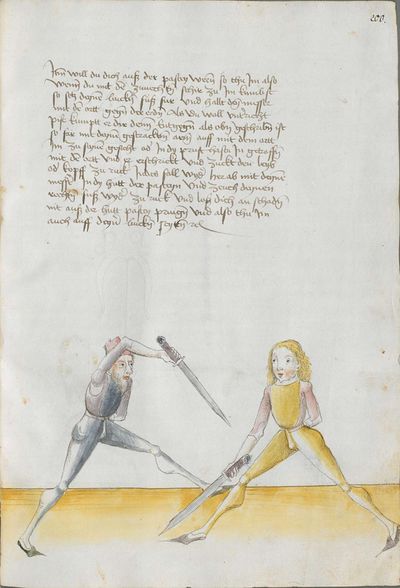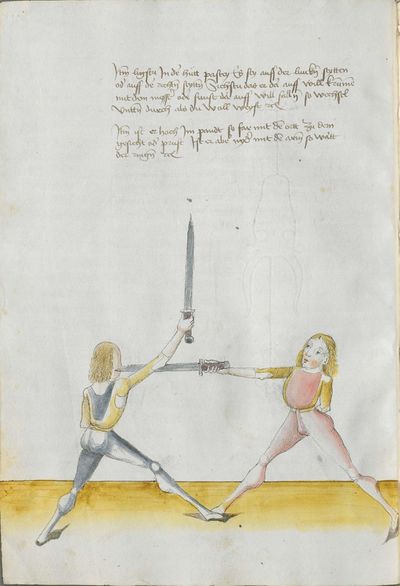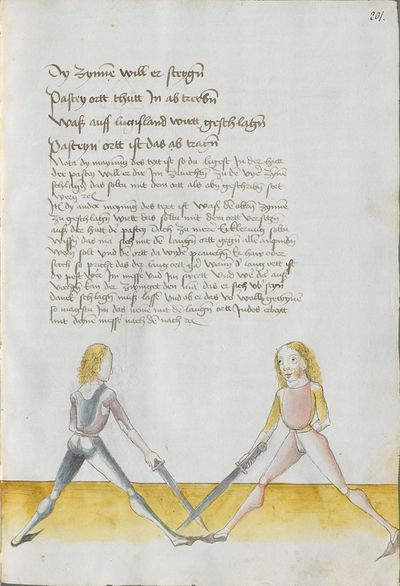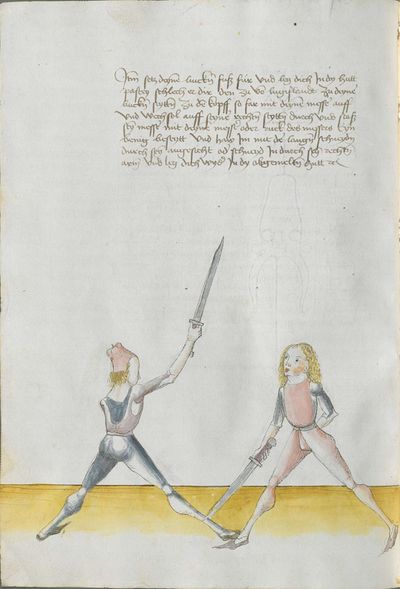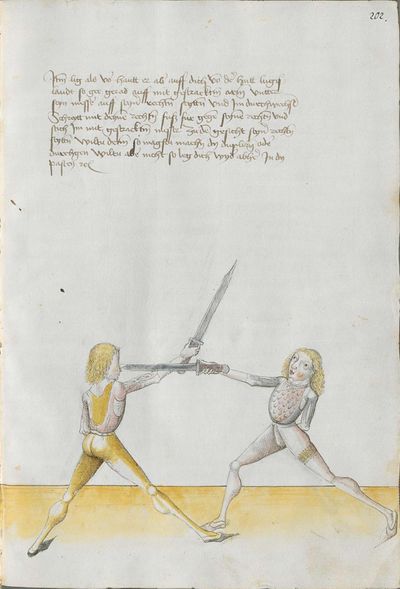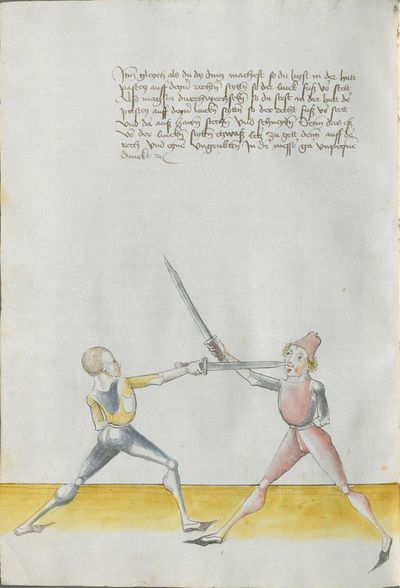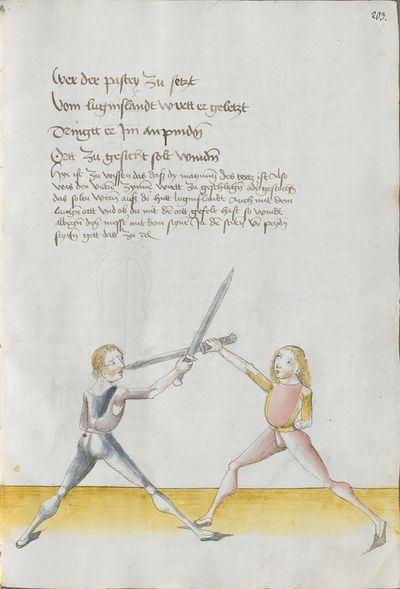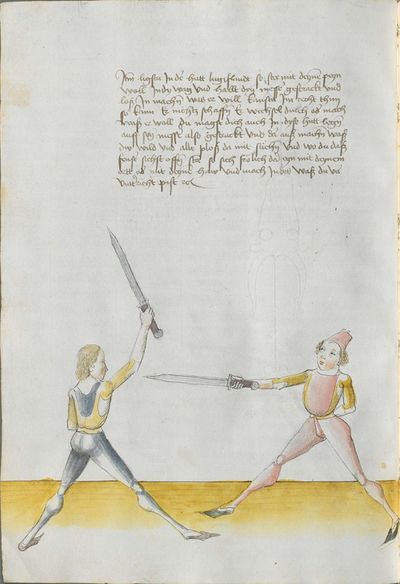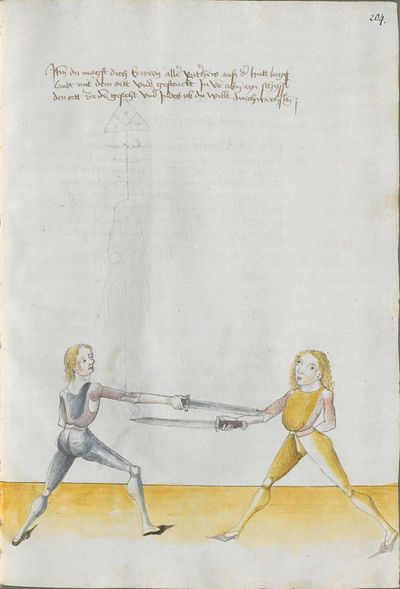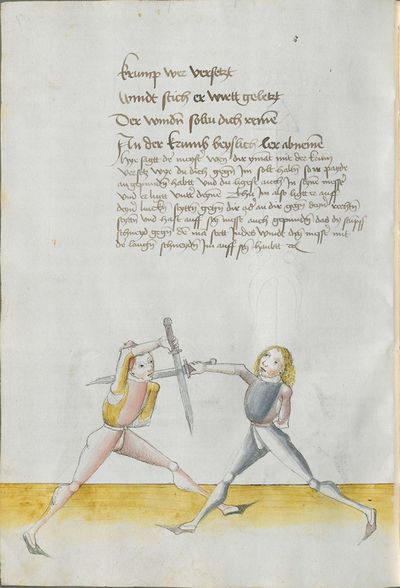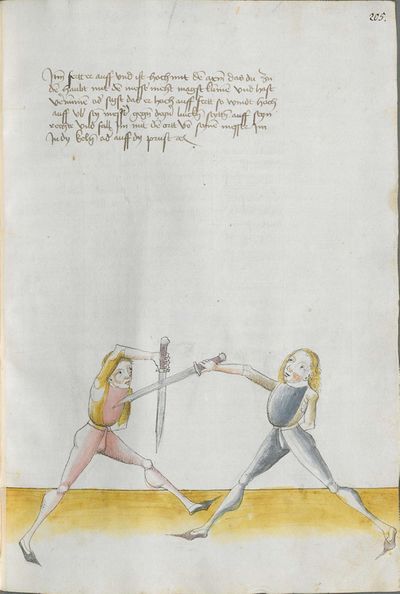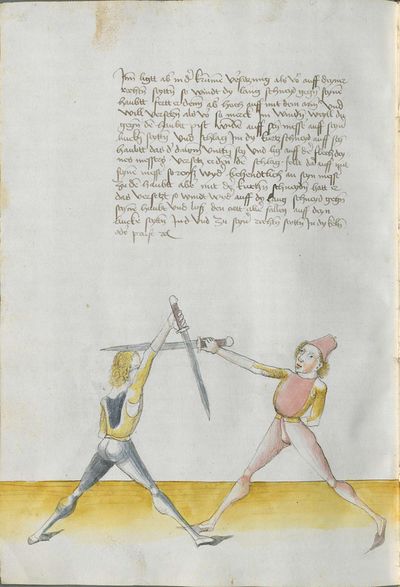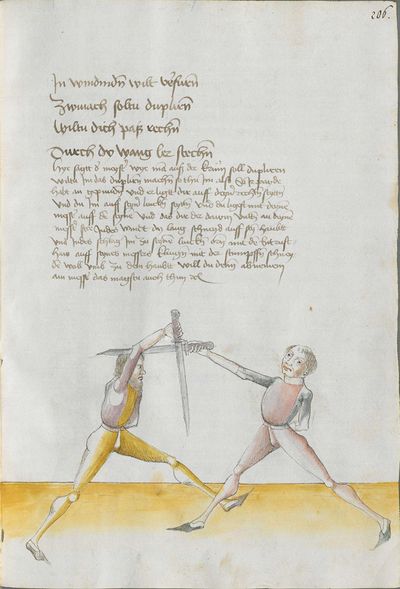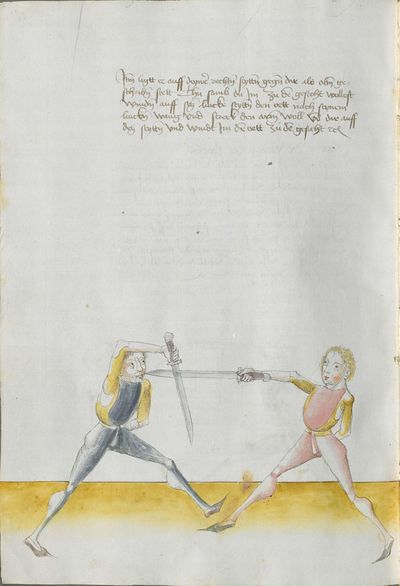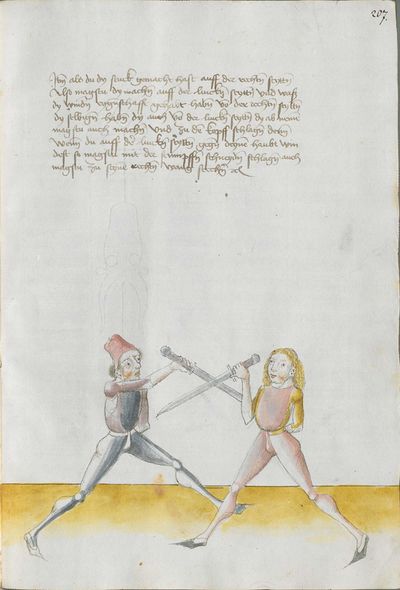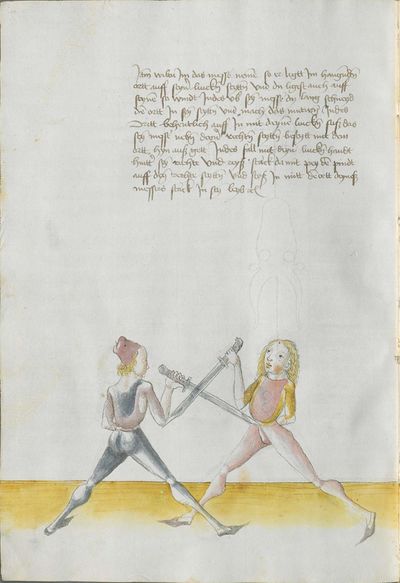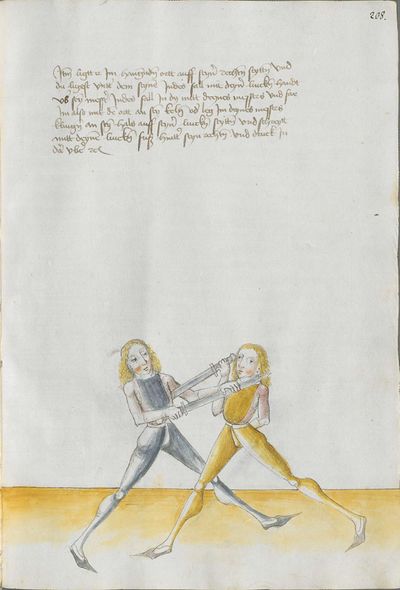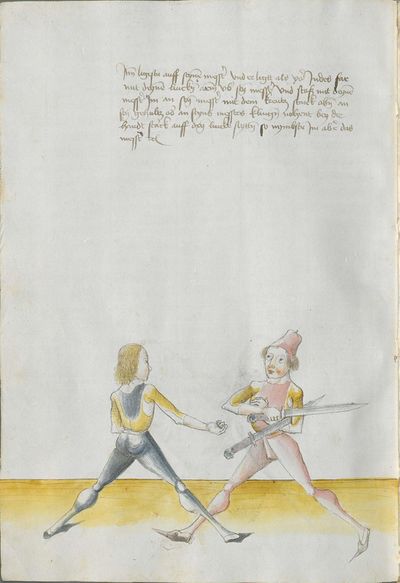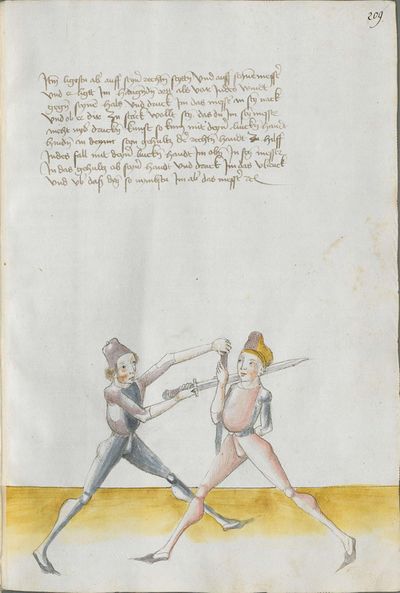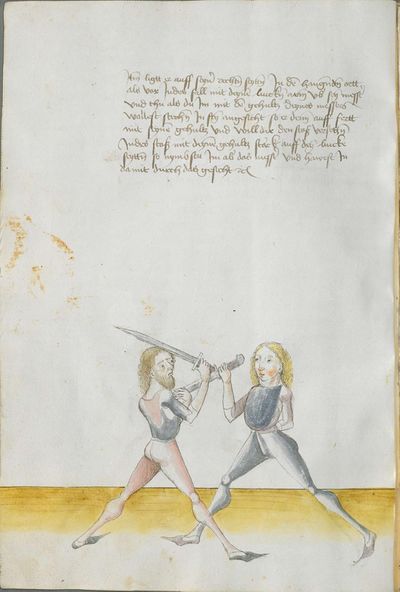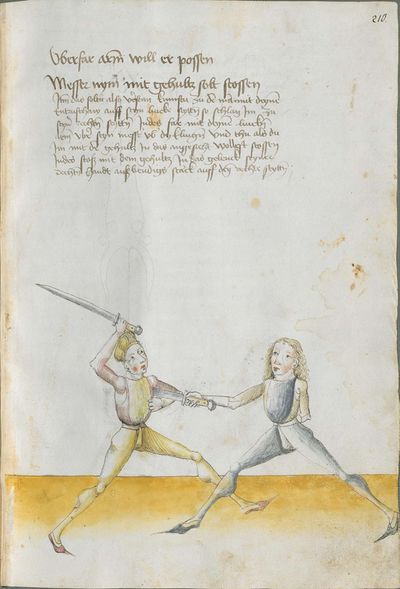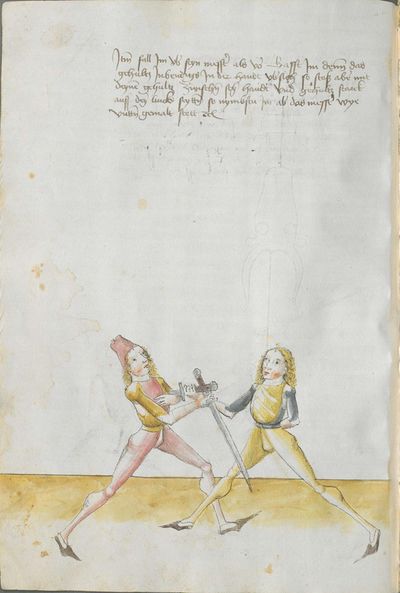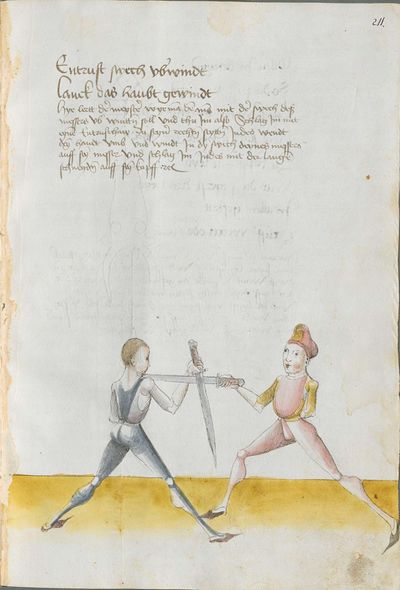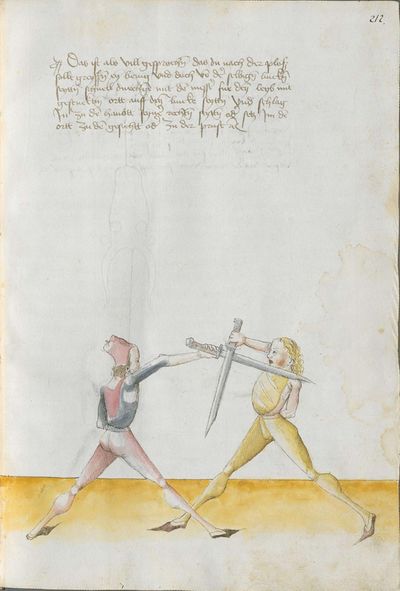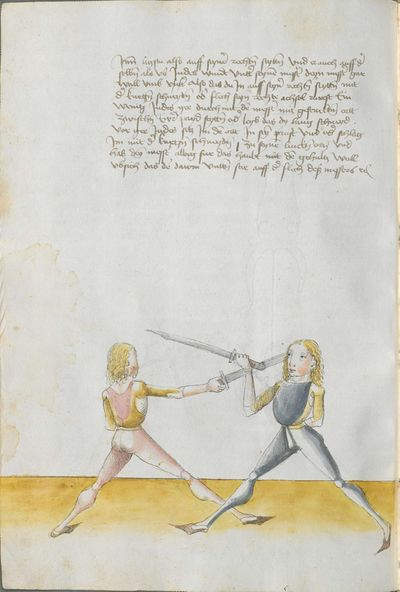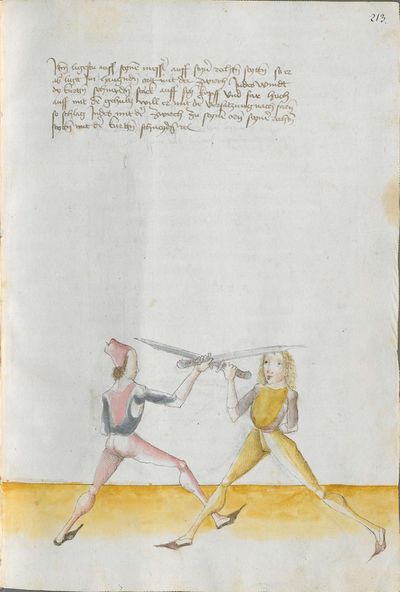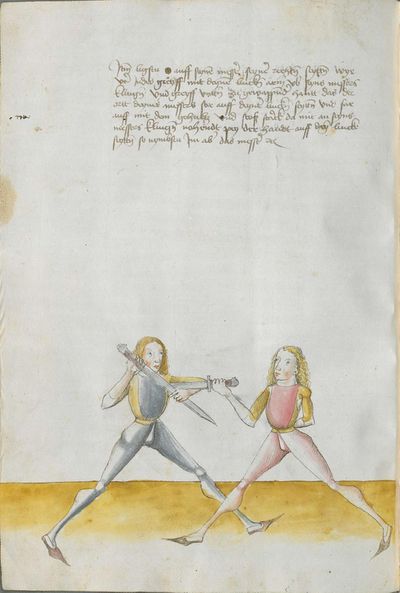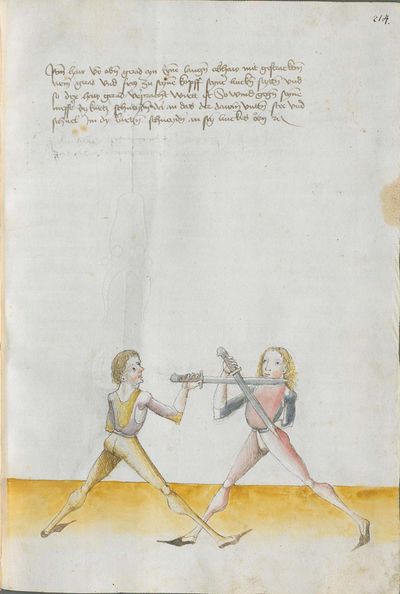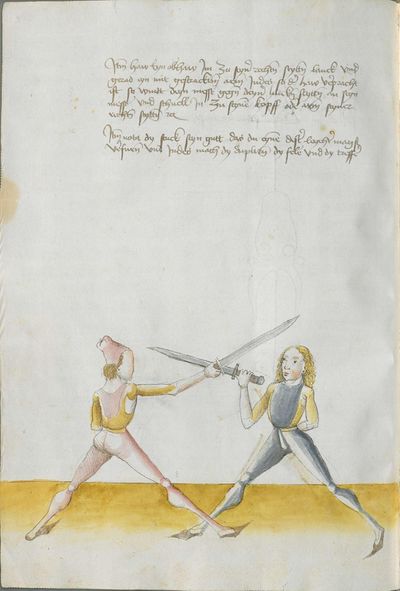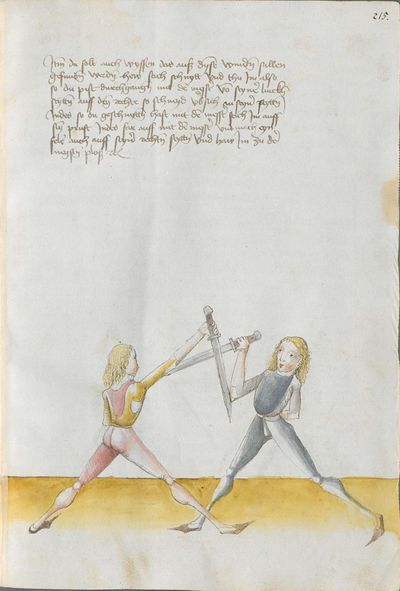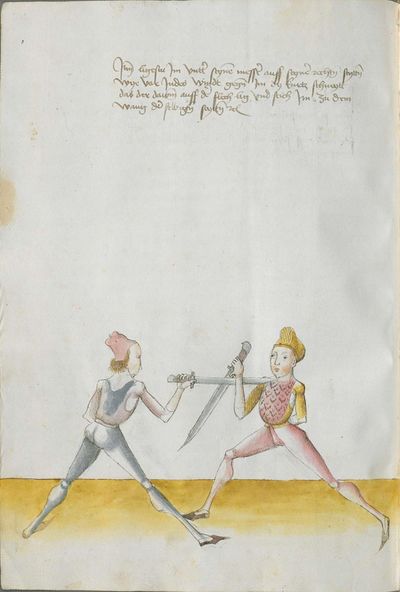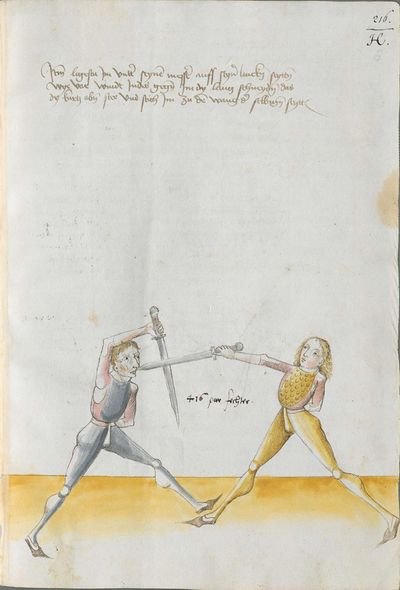|
|
You are not currently logged in. Are you accessing the unsecure (http) portal? Click here to switch to the secure portal. |
Difference between revisions of "Johannes Lecküchner"
| Line 1: | Line 1: | ||
{{Infobox writer | {{Infobox writer | ||
| name = [[name::Johannes Lecküchner]] | | name = [[name::Johannes Lecküchner]] | ||
| − | | image = | + | | image = File:Johannes Lecküchner.png |
| imagesize = 250px | | imagesize = 250px | ||
| caption = | | caption = | ||
| Line 58: | Line 58: | ||
Some 19th century scholars assumed that Lecküchner's name was a corruption of "Liechtenauer" and a reference to [[Johannes Liechtenauer]], the grand master of the primary German [[longsword]] tradition. However, biographical information from historical records, as well as the colophon in the manuscript itself, thoroughly disproves this theory. Lecküchner's system of [[Messer]] fencing does, however, seem to be related in some way to the longsword teachings of Liechtenauer from the previous century. His teachings are organized in a similar fashion using similar terminology, and often his [[epitome]] is nearly identical to that of Liechtenauer. | Some 19th century scholars assumed that Lecküchner's name was a corruption of "Liechtenauer" and a reference to [[Johannes Liechtenauer]], the grand master of the primary German [[longsword]] tradition. However, biographical information from historical records, as well as the colophon in the manuscript itself, thoroughly disproves this theory. Lecküchner's system of [[Messer]] fencing does, however, seem to be related in some way to the longsword teachings of Liechtenauer from the previous century. His teachings are organized in a similar fashion using similar terminology, and often his [[epitome]] is nearly identical to that of Liechtenauer. | ||
| − | Two autograph copies of Lecküchner's treatise, entitled ''Kunst des Messerfechtens'' ("The Art of Messer Fencing"), are preserved: the [[Kunst des Messerfechtens (Cod.Pal.Germ.430)|Codex Palatine German 430]], completed in 1478, and the [[Kunst des Messerfechtens (Cgm 582)|Cgm 582]], completed on 19 January 1482 (the year of his death).<ref>The [[Kunst des Messerfechtens (Cgm 582)|Cgm 582]] states on [http://daten.digitale-sammlungen.de/bsb00002184/image_434 folio 216v] that "This material was composed by the Reverend Johannes Lecküchner, at that time of the parish in Herzogenaurach, in the year of our Lord 1478, but this book was written and completed in the 82nd year on the eve of St. Sebastian." (''Composita est materia illa per domine Johanne Lecküchner tunc tempore plebanus jn Hertzogaurach Anno domini M°CCCC° septuagesimo octauo sed iste librum Scriptum est et completus Anno 8° secundo jn vigilia sancti Sebastiani'').</ref> The Cgm 582 mentions in the last paragraph that a previous draft had been produced, which is presumed to be a reference to the CPG 430. Despite the Cgm 582 being the more extensive and elaborate of the two, it is the CPG 430 that seems to be the source for all later repetitions of Lecküchner's teachings. A slightly abridged version of this treatise (probably based on a lost intermediary) was included by [[Hans von Speyer]] in the [[Codex Speyer (MS M.I.29)|MS M.I.29]] in 1491, and similar (but not identical) abridged versions were reproduced by [[Gregor Erhart]] in 1533, [[Paulus Hector Mair]] in the 1540s, and [[ | + | Two autograph copies of Lecküchner's treatise, entitled ''Kunst des Messerfechtens'' ("The Art of Messer Fencing"), are preserved: the [[Kunst des Messerfechtens (Cod.Pal.Germ.430)|Codex Palatine German 430]], completed in 1478, and the [[Kunst des Messerfechtens (Cgm 582)|Cgm 582]], completed on 19 January 1482 (the year of his death).<ref>The [[Kunst des Messerfechtens (Cgm 582)|Cgm 582]] states on [http://daten.digitale-sammlungen.de/bsb00002184/image_434 folio 216v] that "This material was composed by the Reverend Johannes Lecküchner, at that time of the parish in Herzogenaurach, in the year of our Lord 1478, but this book was written and completed in the 82nd year on the eve of St. Sebastian." (''Composita est materia illa per domine Johanne Lecküchner tunc tempore plebanus jn Hertzogaurach Anno domini M°CCCC° septuagesimo octauo sed iste librum Scriptum est et completus Anno 8° secundo jn vigilia sancti Sebastiani'').</ref> The Cgm 582 mentions in the last paragraph that a previous draft had been produced, which is presumed to be a reference to the CPG 430. Despite the Cgm 582 being the more extensive and elaborate of the two, it is the CPG 430 that seems to be the source for all later repetitions of Lecküchner's teachings. A slightly abridged version of this treatise (probably based on a lost intermediary) was included by [[Hans von Speyer]] in the [[Codex Speyer (MS M.I.29)|MS M.I.29]] in 1491, and similar (but not identical) abridged versions were reproduced by [[Gregor Erhart]] in 1533, [[Paulus Hector Mair]] in the 1540s, and [[Lienhart Sollinger]] in 1556. |
Preceding the treatises of Lecküchner and Liechtenauer in the MS M.I.29 are brief notes by a [[Magister Andreas]] explaining equivalences in concepts and terminology between the two,<ref>[[Hans von Speyer]]. Untitled [manuscript]. [[Codex Speyer (MS M.I.29)|MS M.I.29]]. Salzburg, Austria: [[Universitätsbibliothek Salzburg]], 1491. ff 5r-7r</ref> perhaps indicating that by this time Lecküchner's teachings had been integrated into the Liechtenauer school of fencing. This notion is further supported by the appearance of Lecküchner's epitome alongside Liechtenauer's in [[Marxbrüder]] captain [[Peter Falkner]]'s treatise of ca. 1495. | Preceding the treatises of Lecküchner and Liechtenauer in the MS M.I.29 are brief notes by a [[Magister Andreas]] explaining equivalences in concepts and terminology between the two,<ref>[[Hans von Speyer]]. Untitled [manuscript]. [[Codex Speyer (MS M.I.29)|MS M.I.29]]. Salzburg, Austria: [[Universitätsbibliothek Salzburg]], 1491. ff 5r-7r</ref> perhaps indicating that by this time Lecküchner's teachings had been integrated into the Liechtenauer school of fencing. This notion is further supported by the appearance of Lecküchner's epitome alongside Liechtenauer's in [[Marxbrüder]] captain [[Peter Falkner]]'s treatise of ca. 1495. | ||
Revision as of 01:12, 23 February 2014
| Johannes Lecküchner | |
|---|---|
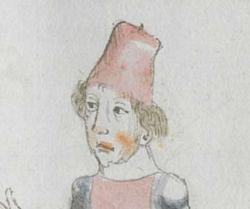 | |
| Born | ca. 1430s Nuremberg, Germany |
| Died | December 31, 1482 Herzogenaurach, Germany |
| Occupation | Fencing master Priest |
| Alma mater | University of Leipzig |
| Influences | Johannes Liechtenauer (?) |
| Genres | Fencing manual |
| Language | Early New High German |
| Notable work(s) | Kunst des Messerfechtens |
| Archetype(s) | Cod.Pal.germ. 430 (1478) Cgm 582 (1482) |
| Manuscript(s) |
MS E.1939.65.354 (1533)
|
| Concordance by | Michael Chidester |
| Signature | |
Johannes Lecküchner (or Hans Lebkommer; ca. 1430s – 1482) was a 15th century German cleric and fencing master. He was born in the Nuremberg area, and in 1455 he was inscribed at the University of Leipzig. In 1457, he received the title of baccalaureus, and he was consecrated as a Catholic acolyte in 1459. At some point before creating his first manuscript in 1478, Lecküchner was consecrated as a priest. From 1480 until his death on December 31, 1482, he was employed as a communal priest in Herzogenaurach, Germany.[1] Lecküchner dedicated his fencing manual to Philip "the Upright" of Wittelsbach, Elector Palatine of the Rhine, but the nature of his connection to the duke remains unclear.[2]
Some 19th century scholars assumed that Lecküchner's name was a corruption of "Liechtenauer" and a reference to Johannes Liechtenauer, the grand master of the primary German longsword tradition. However, biographical information from historical records, as well as the colophon in the manuscript itself, thoroughly disproves this theory. Lecküchner's system of Messer fencing does, however, seem to be related in some way to the longsword teachings of Liechtenauer from the previous century. His teachings are organized in a similar fashion using similar terminology, and often his epitome is nearly identical to that of Liechtenauer.
Two autograph copies of Lecküchner's treatise, entitled Kunst des Messerfechtens ("The Art of Messer Fencing"), are preserved: the Codex Palatine German 430, completed in 1478, and the Cgm 582, completed on 19 January 1482 (the year of his death).[3] The Cgm 582 mentions in the last paragraph that a previous draft had been produced, which is presumed to be a reference to the CPG 430. Despite the Cgm 582 being the more extensive and elaborate of the two, it is the CPG 430 that seems to be the source for all later repetitions of Lecküchner's teachings. A slightly abridged version of this treatise (probably based on a lost intermediary) was included by Hans von Speyer in the MS M.I.29 in 1491, and similar (but not identical) abridged versions were reproduced by Gregor Erhart in 1533, Paulus Hector Mair in the 1540s, and Lienhart Sollinger in 1556.
Preceding the treatises of Lecküchner and Liechtenauer in the MS M.I.29 are brief notes by a Magister Andreas explaining equivalences in concepts and terminology between the two,[4] perhaps indicating that by this time Lecküchner's teachings had been integrated into the Liechtenauer school of fencing. This notion is further supported by the appearance of Lecküchner's epitome alongside Liechtenauer's in Marxbrüder captain Peter Falkner's treatise of ca. 1495.
One final note of interest is that in 1531, printer Christian Egenolff published a fencing anthology entitled Der Altenn Fechter anfengliche kunst, and included in it a brief treatise on the Messer attributed to Master Hans Lebkommer. This is likely a misspelling or alternate rendering of "Lecküchner" given that the text appears to be a brief summary of Lecküchner's teachings, intermingled with the Messer teachings of Andre Paurñfeyndt (uncredited).
Contents
Treatise
Lecküchner's two manuscripts contain a number of substantial differences, some of which can be interpreted as corrections in the later edition and others which are less explicable. In this compilation, we've merged the translations of both texts and selected in most cases the longest or most detailed description available. While we judge that this will be of the most use to the practitioner, readers interested in a deeper cut should go straight to the source and read the original PDF prepared by Grzegorz Żabiński, Russell A. Mitchell, and Falko Fritz (see the sidebar); this excellent document not only separates out the two translations wherever the texts differ but also offers original transcriptions of both as well as a lengthy introduction to give them greater context.
| Images
from the Munich Version I |
Featured Translation |
Heidelberg Version (1478) | Munich Version I (1482)
by Julia and Carsten Lorbeer, Johann Heim, |
Salzburg Version (1491) | Vienna Version (1512) | Glasgow Version (1533) | Mair's Dresden Version I (1542) | Mair's Vienna Version I (1540s) [German] | Mair's Vienna Version I (1540s) [Latin] | Mair's Munich Version I (1550s) | Munich Version II (1556) |
|---|---|---|---|---|---|---|---|---|---|---|---|
| This is the art and charter on the Messer of Sir Hans Leckuchner of Nürnberg, which he did and put together himself, the text and the explanation of it to His Highness Prince and Duke Philip Palatine of Rhein, Arch-Cup-bearer and Prince Elector and Duke in Bavaria | [2r] Das ist herrn hansen Lecküchnerß von Nûrnberg künst und zedel ym messer dy er selbs gemacht und getichtt hatt den text und dÿ auslegüng daruber etc. | [1r] Das ist her[r] hanns[e]n Lecküchn[er] von Nur[e]nberg künst vnd zed[e]l ym messer dy er selbs gemacht vnd geticht hatt Den Text vnd dy auslegu[n]g dar übe[r] Dem hochgepor[e]n furst[e]n vnd her[re]n hertzog[e]n philipp[e]n phaltzgraffen Bey reyn Ertzdruckseß vnd kurfürst vnd hertzog yn Bayern [etc] | |||||||||
| The Foreword
Pay attention on the following Here begins the foreword on the Messer and states that who wants to fight well with the Messer, should learn the proper art and obey to this art and skill written below. This way, he will be able to stand with the rightful art in front of the princes and lords, and his art will be better rewarded to him than to other masters who do not know these things and cannot perform them. Namely, there are many masters of the sword who do not know the art of the Messer and cannot excogitate it properly. Who is able to perform this thing and this art, there are numerous serious elements by which he can beat the masters well and skillfully force them so that they must let themselves be beaten, thrust, led, thrown and held against their wish. |
Dye vor red.
Ob dw wild achten, Hye hebt sich an dy vor rede ym messer und sagtt wer woll vechten ym messer das er soll lerenen [2v] rechte kunst und sich geben auff dyse nach geschriben art und kûnst so mag er wol pestan mitt rechter kunst vor fuersten und vor herren ym soll aych pillicher seyner kunst paß geluenet werden den anderen meysteren dye dyser dinck nicht wyssen und sich nicht dar eyn kunnen schicken wann eß syn vill meysteren des swercz dye nicht wyssen von der artt deß messers noch rechtt aussynnen mugen wer sich aber yn dyse ding undartt schicken kann der findt vill ernestlicher stuck da mit er dy meyster wol mag uff wecken und kunstenlichen weschlyssen daß sy sich an danck schlagen stossen fueren werffen halten mussen lassen. Sequitur textus. |
Dy vor rede
Ob dw wilt achten Hye hebt sich an dy vor rede ym messer vnd sagt wer woll vecht[e]n ym messer Das er schül lern[en] rechte kunst vnd sich geb[e]n auff dyse nachgeschrib[e]n artt vnd kunst So mag er woll westan mit rechter kunst vor furst[e]n vnd vor her[r][e]n ym sol auch pillich seyne[r] kunst paß gelönet werd[e]n den ander[e]n meyster[e]n des dings nicht weysen vnd sy nicht dar eyn kun[n]en schick[e]n wenn es seyn vill meyste[r] des Swertz dy nicht wissen von der art des messers noch recht auß synne[n] müg[e]n wer sich yn dyse ding vnd art schick[e]n kan der syndt vill ern[n]stlicher stück do mit er dy meyster woll mag auff beck[e]n vnd kunst[e]nlich weschliss[e]n Das sy sich an danck schlag[e]n stossen furn[e] werffen halt[e]n müß lassen ; |
[46r]
[O]B du wilt achten Hie hebt sich an die vorred im messer vnd saget wer will leren vechten im messer daß er sol leren recht künst vnd sich geben vff disse artt vnd künst So mag er wil besten mit rechter künst vor fursten vnd vor heñ Im sol billicher siner künst baß gelonett werde~ dan andern meinstern die deß dings nit wissen vnd sich nit künde~ schicken wan eß sint viel meinster deß schwertz die nit wissen von der art deß messers noch recht vszenden mugen Wer sich in disse ding vnd art schicken kan der vint viel ernstlicher stueck do mit er die meinster wol mag vff wecken vñ künstlich beschliessen daß sie sich an danckñ schlage~ stoßen furen werffen halten muessen losßen ~ Sr text[us] |
[138r] Der zetel des Duseggen Fechtens
Ob du Nimpst acht Wellicher will Lernen Fechten Inn Duseggen. der soll Lernen rechte Kumst / vnnd sich geben auf dise Nachgeschribne Art. So mag Er wol bestan vor fursten vnnd herzen. Im soll auch seinner Kunnst billich bas gelonnt werden dann anndern Mai[138v]stern die des dinngs nit wissen. Vnnd. sy nit kinden darem schicken wann es seind vil Maister des schwerts die nichts wissen der Art des duseggen. noch recht auszinnen mögen. Wer sich Inn diese dinng vnnd art schicken kann. der finndt vil ernnstliche stuckh dar Inn er die Maister wol mag aufwecken. vnnd kunnstlich beschliessen. das sy sich on danck_ schlagen. stossen. fieren. werffen vnnd hallten muessen lassen. |
|||||||
Who displaces only Here the master ended the foreword and now he gives you a good teaching. Understand it this way: when you come to a man in the Zufechten, you should not stand still with the Messer and wait for his strokes. That is because the swordsmen who only want to displace are beaten a lot, because as they try to displace, they cannot perform any rightful art and this way, as they do not want to do anything but displace and they want to look at other men’s strokes and work, they are beaten and weakened in spite of their entire art. |
Wer newer verseczet, [3r] So nw der meyster geendet hatt dy vor der nw gibt er dir eyn gute ler dy verste alzo wen dw mit dem zw vechten zw dem man kumbst so soltu nicht stil sten mit dem messer und seynen hewen nach warten wan dy vechter dy newer wollen verseczen dy werden ser geschlagen wan dy weyll sÿ verseczen můgen sy kayn rechte kunst treyben und so sye anderß nicht thün wöllen dann verseczen und auff ander lewtt schleg und arbaytt newer wöllen sehen so werden sye geschlagen und geschwechtt pey allen yren künsten. |
Wer newer versetzet So nw der meyste[r] geendet hatt dy vor rede nw gibt er dir ein gutte ler dy verste alzo Wenn dw mit dem zwuechten ze dem man kumbst so soltu nicht stil sten mit dem messer vnd seyne[n] hewen nach wortten wenn dy vechte[r] dy newe[r] well[e]n versetz[e]n dy werd[e]n ser geschlag[e]n wann dy weil sy versetz[e]n müg[e]n sy [1v] kain rechte kunst treyb[e]n vnd so sy anders nicht thun woll[e]n dan versetz[e]n vnd auff ander lewt schleg vnd erbeyt woll[e]n sehen So werd[e]n sy geschlag[e]n vnd geswecht bey all[e]n iren kunst[e]n. |
[46v] Wer mir versetz So nue der meinster gendet hat die vorred Nü git er dir eyñ gutte~ lere die verste also wan du mit dem zuevechte~ zue dem man kümpst So soltu nit stil stan mit dinen messer vnd sienen haulben noch warte~ wan die vechter die nuer wellen versetzen die werdent sere geschlage~ dan die wiell sie versetzen mogen sie keÿn rechtt künst triben vnd so sie anders nit thuen wellen dan versetzen vnd vff ander luet schleg vnd arbeit wollen sehen So werdent sie geschlage~ vnd geschmecht by allen Iren kuensten etc Indes vor vnd nach |
Wer vil versetzt Item hie merckh ain gute Ler. Wann du zu dem Mann kumpst. so soltu nit still stan mit deinnem Duseggen / auch nit auf seinnen haw harzen. noch warten. wann die fechter die nur wöllen versetzen. mogen zu kainner rechten Arbait nit kummen. dann die da versetzen vnnd auf annder leut schleg vnnd arwait warten. die werden geschlagen. vnnd geschmecht bey allen Iren kunsten. |
|||||||
“Simultaneously,” “before” and “after,” these words Here the master states and announces the base of the Messer fencing and says: “simultaneously,” “before” and “after,” etc. You should understand it this way that you should learn properly before all other things these two things, that is the “before” and the “after” and the “strong” and the “weak,” and the word “simultaneously,” as the base of the entire art of fencing comes therefrom. And if you learn and understand these things properly, and additionally you do not forget the word “simultaneously” in all the elements you have performed, you can be well a good master of the Messer and you can teach the princes and lords so that they stand well with the rightful art in friendly and in serious combat. |
Yndeß vor und nach dy wortt, Hye sagt der meyster und meldt [3v] den gruntt deß messer vechtenß und spricht ÿndes vor und nach etc Daß soltu alzo verstan daß dw vor allen dingen recht vernemen sollt dy czwen dyng daß ist daß vor und daß nach und dy swech und dy sterck und daß wortt yndeß wann dar auß kumbt aller grund aller der künst deß vechtenß und wenn dw dy ding recht vernymbst und verstest und zw vor an deß worcz yndeß nicht vergist yn allen stucken dy dw treyben pist So magst dw wol eyn gutter meyster deß messerß seyn und magst leren fursten und herren daß sy mit rechter kunst wol bestan yn schympff und yn ernest etc. |
Yndes / vor / vnd /nach / dy wortt Hye sagt der meyste[r] vnd melt den grundt des messers vecht[e]ns vnd spricht yndes vo[r] vnd nach [etc] Das soltu alzo verstan das dw vo[r] all[e]n ding[e]n recht ve[r]neme[n] solt dy zway ding das ist das vor vnd nach . vnd dy swech vnd dy sterck vnd das wort yndes wann dar auß kumbt aller grundt aller der kunst des vecht[e]ns vnd wenn dw dy ding recht v[er]nymbst vnd ve[r]stest vnd zwvo[r]an des wortz yndes nicht v[er]gist yn all[e]n stuck[e]n dy dw treyb[e]n pist So magstu woll eyn gutt[er] meyste[r] des messers sein vnd magst fursten vnd her[r]en ler[e]n das sy mit recht[er] kunst wol bestann yn schimpff vnd yn ern[n]st |
Indes / vor / vnd noch / die wort Hie saget der meinster vnd meldett den gruent des messers vechtñ vnd sprichtt Indeß vor vnd noch etc Daß soltu also verstan daß du vor allen dingen recht verneme~ solt die zweÿ ding dz ist daß vor vnd noch vnd die schwech vnd sterck vnd daß wort indeß wan darueß kuemptt aller gru°ntt aller der künst deß messers vechtens vnd [47r] wen dü die ding recht vernÿempst vnd verstoest vnd zue vor an daß wortt Indes nit vergist In allen stuecken die du triben bist So magstu wol eyñ guetter meinster deß messers sin vnd magst fuersten vnd heren leren dz sie mit rechter kuenst woll besten In schÿmff vnd In ernst ~ |
[139r] Inndes vor vnnd nach Item hie findstu den Grund des Duseggen fechtens. das wort Indes. vnnd das vor vnnd nach. das soldu versteen. allso das du vor allem dinngen. recht vernemmen solt die zwaydinng. das ist das vor. vnnd das Nach. vnnd die schwech vnnd sterckhe vnnd das wort Indes. wann darausz kumpt aller Grvnnd des Duseggen fechtens vnnd wann du die dinng Recht vernimpst vnnd versteest vnnd zuuoran das wort Indes. so magstu wol ain guter Maister des Duseggen sein vnnd magst Fursten vnnd herzen lernen. das synnt rechter Kunst wol bestan Inn schiimpff vnnd Inn Ernnst. |
|||||||
Then, the “before” is that if you are coming with a stroke sooner than he so that he has to displace. So work “simultaneously” skillfully with the Messer in front of you or with other elements and do not let him come to any work afterwards. This way, you have acquired the “before.” |
Item daß vor ist do dw ee kumbst mit dem haw den er daß er dir verseczen müß So erbayt yndeß behentlich fuer dich mit dem messer oder mit andern stucken und laß yn dar nach zw kayner erbait kummen [4r] alzo hastu ym an gebunnen daß vor |
It[e]m das vor ist . So dw ee kumbst mit dem haw dann er das er dir versetz[e]n muß So erbayt yndes behendiklich mit dem messer fur dich oder ander[e]n stück[e]n vnd laß yn da[r] nach zw keyner erbeit kum[m]e[n] alzo hastu ym an gebune[n] das vor vnd |
das vor
Itm~ daß vor ist so du e kuempst mit dem haulb dan er daß er dir versetzen mueß So arbeytt Indes behendeglich mit dem messer fur dich vnd loß in darnoch zu keyner arbeytt kuemen also hastu Im an gewuende~ daß vor ~ |
Das vor
Item das vor Ist so du Ehe kumpst Mit dem Duseggen oder mit dem haw dann er. das er dir versetzen muosz. so ar[139v]bait Indes behenndigclich mit dem Duseggen fur dich oder sunnst mit anndern stuckhen vnnd lasz In darnach zu kainner arbait kummen also hastu Im abgenommen das vor. |
|||||||
And if he comes sooner than you with the work or with the stroke and you have to displace it, work “simultaneously” skillfully with the Messer or otherwise with the elements. This way, you take the “before” from him with your “after,” and this is called the “before” and “after.” |
Item wenn er ee kumbt mit der erbat oder mit dem haw denn dw daß dw ym verseczen mûst So arbayt yndeß behentlich mit dem messer oder sünst mit stucken so nymbstu ym daß vor mit dem nach und daß hayst daß vor und nach. |
wenn er ee kumbt mit der erbeyt od[er] mit dem haw denn dw vnd ym das versetz[e]n müst So erbeyt yndes behendicklich mit dem messer oder sunst mit stuck[e]n So nymbstu ym das vor mit dem nach vnd das heyst das vor vnd nach |
das noch
Itm~ wan er E kuempt mit dem haulb den du vñ Im das versetzen muest So arbeytt Indeß behendeglich mit dem messer oder suenst mit stueckñ So nyembstu Im daß vor mit dem noch vnd das heist das vor vnd das noch ~ |
Das nach
Item das nach Ist Wann er kumpt mit der arbait oder mit dem haw dann du. vnnd Im das versetzen muost. so arbait Indes behenndiglich mit dem duseggen oder sunnst mit stuckhen. so Nimpst du Im das vor mit dem nach. |
|||||||
Then, you should also know before all other things the “weak” and the “strong” of the Messer. Be aware that from the hilt to the middle of the Messer there is the “strong” and from the middle down to the point there is the “weak.” And how you should fence therefrom, you find written afterwards, and also what the word “simultaneously” is. |
Item dw solt auch vor allen dyngen wyssen dy swech und dy sterck deß messerß nw merck von dem gehülcz piß an dy mitte deß messerß daß ist dy sterck und von der mitten uncz an den ortt daß ist dy swech und wye dw dar auß vechten sollt daß findestu her nach geschriben und waß daß wortt ynder ist etc. |
Item dw solt auch vo[r] all[e]n ding[e]n wissen dy swech vnd dy sterck des messers nw merck von dem gehültz piß an dy mitten des messers das ist dy sterck vnd von der mitt[e]n vntz an den ortt das ist dy swech vnd wye dw da[r] auß vecht[e]n scholt das vindest dw her nach geschrib[e]n vnd was das wort yndes ist |
schvech vnd sterck
Itm~ du solt auch vor allen dingen wissen die schwech vnd sterck des messers Nu merck von dem gehultz biesß an die mitte des messers das ist die sterck Vnd von der mit biß an das ortt das ist die schwech vnd wie du dar vß vechten solt daß sechs haulb lere |
Die schwech vnd sterckh
Item du solt Auch vor allen dinngen Wissen die schwech vnnd sterckh des Duseggen. Nun merckh vonn dem gehultz bisz an die mitte des du |
|||||||
Learn six strokes Here teaches the master how one should hold himself in the Messer fencing and how one should prepare to it. And firstly, you should fence with one hand with the Messer and you should have the other one on the back. If you want to fight with the empty hand, as in Messer-taking, grasping, clenching the arms etc., you should turn the hand from the back to the chest when you want to perform something on him on the inside over the arm. |
Sechs hew lere, Hye lert der meyster wye man sych halten sol yn dem vechten deß messerß und wye man sich dar eyn sol schicken und züm ersten söltu mit eyner hendt vechten mit dem messer und dy ander soltu auff dem rück haben ob dw aber wild mit lerer hand vechten alz mit messer nemen ubergreiffen arm beschlyssen etc So solt dw dy hand von dem rück auff dy prust wenden waß dw ym wild ynbendig vber den armen treyben etc. |
Sechs hew lere Hye lert der meyste[r] wye ma[n] sich halt[e]n sol yn dem vecht[e]n des messer vnd wye ma[n] sich dar ein sol schick[e]n vnd zum erst[e]n So soltu mit eyner hendt vecht[e]n mit dem messer vnd dy ander soltu auff dem ruck hab[e]n ob dw abe[r] wildt mit lerer handt vecht[e]n alz mit mess[er] neme[n] vber greffy[e]n arm[e] beschliss[e]n So soltu dy handt von dem ruck auff dy prust wend[e]n waß dw ym wildt ynbendig vbe[r] den arm[e] treyb[e]n |
Sechs heulb lere Hie lert der meinster wie man sich schuecken sol in dem vechten deß messers vnd wie man sich darin schuecken sol vnd zuem ersten soltu mit eyner hant fechten mit dem messer vnd die ander vff dem ruecken halte~ Ob du aber willt mit lerer hant vechten als mit messer nemen vber grieffen arm beschlueßen etc So soltu die hant von dem rueck vff die bruest wende~ waß du wiltt Inlbendig uber den arm triben etc |
[140r] Wie du fechten solt Item Inn das Duseggen Fechten schickh dich also. zum ersten soltu mit ainner hannd fechten. mit deiner wehr vnnd die annder auf dem Ruckhen hallten. Aber wann du willst mit Leerer hannd fechten. als mit Duseggen nemmen. vbergreyffen. arm beschliessen. so soltu die hannd vonn dem Ruckhne auf die prust wennden. was du wild Innwenndig vber den arm treyben. |
|||||||
| Secondly, the six hidden strokes are described and mentioned in the text, from that many good elements come, if one can perform them right and know how to prepare them skillfully. And how you should perform them with three elements, you will be taught afterwards. | Item zw dem andren so werden yn dem text Sechß verporgen hew ge merckt und peruertt auß den kummen vill gutten stuck wer sye recht treyben kan und sich yn dye wayß kunstenlich zw schicken vnd wye dw dye treyben sölt mit dreyen stucken daß wirst hyne nach unter richt etc.
Sequitur textus. |
Item ze dem ander[e]n so werd[e]n yn dem text sechs ve[r]porg[e]n hew gemelt vnd werutt auß dem kum[m]e[n] vil gutt[er] stuck wer sy recht treyb[e]n kann vnd sych yn dy weyß kunst[e]nlich zw schick[e]n vnd wye dw dy treyb[e]n solt mit dreye[n] stuck[e]n das wirstu her nach vnt[er]richt. | Itm~ zu dem andern So werdent im text Sechs verborge~ haulb gemelt vnd beruerett auß dem kuemen vil guetter stueck were sie recht triben kan vnd In die wiße kunstlich sich zu schicken vnd wie du sie triben solt mit triehen stuecken daß wierstu hernach enttruechtt etc
zorn haulb wecker |
||||||||
The Zornhau, Wecker Here the master names the six hidden strokes, as each is called with its name, so that you can learn the elements in a better way. And he says that the first is called the Zornhau, the other the Wecker, the third the Entrüsthau, the fourth the Zwinger, the fifth the Geferhau and the sixth is called the Wincker. These are the six elements and are the main elements, as you will see afterwards. |
[5r] Czoren haw wecker, Hye nendt der meyster dy sechs verporgen hew wye yczlicher mit namen hayst auff daß dw dy stuck dester paß vernemen mügst und spricht daß der erst hayst der czoren haw der ander der wecker der dridt der entrust haw der feyert der czwinger fünft der gefer haw und der sechst hayst der wincker daß seyn sechß stuck und seyn der hawbt stuchk alz dw her nach horen wirst etc. Sequitur textus. |
Zor[e]n / haw / vecker Hye nendt der meyste[r] dy sechs ve[r]porg[e]n hew wye yetzlich[er] mit name[n] heyst auff das das dw dy stūck deste[r] paß ve[r]neme[n] mügst vnd spricht das der erst heyst der zor[e]n haw Der ande[r] der wecker der dritt der entrusthaw der vyerdt der zwinge[r] Der funft der gefer haw vnd der sechs hayst der wincker Das seyn sechs stuck vnd seyn der hawbt stuck alz dw her nach hör[e]n wirst ; |
Zorn haulb / wecker haulb / Hie nennet der meinster die sechs verborge~ haulb wie sie heissent mit namen vff daß du die stueck aller bast vernemen magst vnd sprichtt daß der erst heist der zorn haulb der ander der wecker d die pastey Sr text[us] |
Die sechs hew
Zornhaw / Weckherhaw |
|||||||
The Bastei, displace Here the master lists the other main elements: these are seventeen. The first are the four guards-they are referred to as the text says: the Bastei. |
Dy pasteyn versecz, Hye czelt der meyster dy andren hawbt stuck der seyn sybenczehen daß erst Das erst seyn dy vyer leger dy werden peruert so der text sprich dy pasteyn, |
Dy pasteyn / versetz Hye zelt de[r] meyste[r] dy ander[e]n hawbtstuck Der seyn sib[e]nzehe[n] Das erst seyn dy vyer lege[r] dy werd[e]n werūrt So der text spricht dy pastey[en] |
[48r] die pasteÿ / versetz / Hie zelt der meinster die andern haubt stueck der sint l sieben zehen daß erst das sint die vier leger die werdent berürett do der text spricht die pasteÿ |
[140v] Die vier Leger / Versetzen. / |
|||||||
| Then, the other element is called displacing-it is referred to as the text says: displace. | Item daß ander stuck haysset daß verseczen daß wirtt peruertt so der text sprich versecz, | It[e]m das ande[r] stuck heysset das versetz[e]n das wird beruert Soder text spricht versetz | Itm~ daß ander stueck heist das versetzen das wuertt be |
||||||||
| Then, the third are the drawing after-it is referred to as it is said: drawing after. | Item daß drit seyn dy nach raysen daß wirtt peruert So der text spricht nachrayß etc., | It[e]m Das dritt seyn dy nachreys[e]n das wirt beruert So gesproch[e]n wirtt |
Itm~ daß dritt syndt dz noch reissen das wurtt bereiret so der text sprich noch reiß ~~ | ||||||||
| Then, the fourth are overrunning-it is referred to as it is said: run over. | Item daß vyerd seyn dy uberlauffen dy werden peruert so gesprochen wirt uberlauff dye etc., | It[e]m das viert sein dy vb[er]lauff[e]n das wirt berütt So gesproch[e]n wirtt vber lauff dy | Itm~ daß vierd sint die vberlauffen dz wurt beruerett do der text sprichtt vberlauff ~~ | ||||||||
| Then, the fifth are setting off-it is referred to as it is said: set off. | [6r] Item daß fünft seyn dy abseczen daß wirtt peruert so gesprochen wirt absecz, | It[e]m Das funft seyn dy absetz[e]n das wirtt berütt so gesproch[e]n wertt absetz | Itm~ daß fünfft sint die ab setzen dz wurt berüret do der text sprichtt absetz ~~ | ||||||||
| Then, the sixth are changing through-the master refers to it as he says: change through. | Item daß segst syn dy durchwechsel daß peruert der meyster so er spricht wechsel durch, | It[e]m das sechst sein dy durch vechsel[e]n das berütt der meyste[r] so er spricht vechsel durch | Itm~ daß sechst daß sint die duerch wechschell daß wuertt beruerett so der text spricht wechschell durch ~~ | ||||||||
| Then, the seventh is called twitching-it is referred to as he says: twitch. | Item daß sybent haysset daß czucken daß wirt peruert so er spricht czuck, | It[e]m das sybent heyst das zuck[e]n das wirtt berurtt So er spricht zuck | Itm~ die siebende heist dz zuecken dz wuertt beruerett so er sprichtt zueck ~~ | ||||||||
| Then, the eighth are running through-they are referred to as it is said: run through. | Item daß acht daß syn dy dürchlauffen und dy werden peruert so gesprochen wirt lauff durch, | It[e]m Das acht sein dy durchlauff[e]n dy werd[e]n werütt so gesproch[e]n wirtt lauff durch | Itm~ daß achst sint die duerch lauffen dz ist so er spricht lauff durch etc ~ | ||||||||
| Then, the ninth are cutting off or the four cuts-it is referred to as it is said: cutting off. | Item daß newndt daß seyn dy abschnydt oder veÿer schnydt daß wirt peruert so gesprochen wirtt dy abschnydt, | It[e]m das newndt sein dy abschnidt oder dy vie[r] schnidt das wirtt beruret so gesproch[e]n wertt dy abschnidt | Itm~ daß Nünde sint die ab schnide~ oder die vier schnit dz wuert berueret so gesprochen wuerde ab schnide etc ~ | ||||||||
| Then, the tenth is called pressing the hands-it is referred to as he says: press. | Item daß zehendt daß hayst dy hend drucken daß wirt peruert so er spricht druck, | It[e]m das zehendt heyst dy hendt drūck[e]n das wirt beruret so er spricht druck | [48v] Itm~ daß zehende heist die hend drueck dz wuertt so er spricht druck ~ | ||||||||
| Then, the eleventh are running off-it is referred to as he says: run off. | Item daß eylfft syn dy ablauffen daß wirt peruert so er spricht ablauff, | It[e]m das eylfft sein dy ablauff[e]n das wirdt berütt So er spricht ablauff | Itm~ daß elfte sind die ab lauffen dz wurt beruerett so er sprichtt ab lauff ~~ | ||||||||
| Then, the twelfth are taking over-it is referred to as he says: take over. | [6v] Item daß czbelfft seyn dy pnemen daß peruert unß der meyster So er spricht pnym, | It[e]m das zwelfft seyn dy pneme[n] das wirdt perütt so er spricht pnym | Itm~ daß zwelffte sint die benemen dz wuertt berüret so der text spricht benÿm ~~ | ||||||||
| Then, the thirteenth are going through-it is referred to as he says: go through. | Item daß dreyzehent seyn dy durchgen daß wirtt peruert so er spricht durchgee, | It[em] das dreyzehent das sein dy durchgen vnd das wirtt berut so er spricht durchge | Itm~ daß xiij daß sint die duerch gen dz wuertt so er sprichtt durch ge ~~ | ||||||||
| Then, the fourteenth is called the bow-it is referred to as he says bow. | Item daß virzehent heyst der pogen daß wirt peruert So er spricht pogen, | It[e]m das virzehent heyst der pog[e]n das wirt beruert so er spricht pog[e]n | Itm~ daß xiiij sint die boge~ dz wu~t so er spricht boge~ | ||||||||
| Then, the fifteenth is called taking the Messer-it is referred to as it is said: take the defense. | Item daß fünftzehent heyst daß messer nehmen daß wirt perüert so gesprochen wirt wer nymb, | It[e]m das funftzehent heyst das messe[r] neme[n] das wirt beruett so er so gesproch[e]n wirtt wer nymb | Itm~ daß xv heist dz messer nemen dz ist so er sprichtt were nÿm ~~ | ||||||||
| Then, the sixteenth are the hangings-they are referred to as it is said: hang. | Item daß sechzehent daß seyn dy hengen dy werden peruertt So gesprochen wirtt heng, | [3r] It[e]m das sechzehndt sein dy heng[e]n dy werd[e]n berüert so gespro ch[e]n wirt heng | Itm~ das xvj daß die henge~ dz ist so er sprichtt henge | ||||||||
| Then, the seventeenth are winding with the Messer-the master refers to it for us as he says: wind against the openings. Thus, you have the main elements which are twenty-three. | Item daß sybentzehent daß syn dy wynden yn dem messer daß peruert unß der meyster So er spricht wynd gen den plossen alzo hastu daß der haubtstuck seyn dreÿ und czwaynczyg.
Sequitur. |
It[e]m das sibzehendt sein dy wind[e]n yn dem messe[r] das berue[r]t vns der meyste[r] so er spricht wind gen de[n] plössen Also hastu der hauptstuck sein dreyundzaynzig [etc] | Itm~ dz xvij sint die wende~ im messer So er spricht wende gege~ den plosßen also hastu dz der haubt stueck sintt waß uff dich wirtt gericht |
| |||||||
What is turned against you As the master divided the Messer fencing into the different techniques and described each of them with a name. Now he begins to speak about the first part of the division, that is about the Zornhau. And one is to know that the Zornhau Ort breaks all the strokes from above (Oberhäue) but is still nothing else but a simple peasant stroke. |
[7r] Waß auff dich wirtt gericht, So der meyster daß vechten deß messerß yn dy stuck getaylt hatt und eyn yetlichß mit namen genent hatt Nw hebt er an zw sagen von dem ersten glid der taylung alz von dem zoren haw und ist zw wyssen daß der czoren haw mit dem ortt pricth all öberhew und ist doch eyn schlechter paweren schlag. |
Was auf dich wirt gericht So de[r] meiste[r] das vecht[e]n des messers yn dy stuck geteylt hat vnd eyn ytlichs mit name[n] gene[n]t nw hebt er an ze sag[e]n vo[n] dem erst[e]n glid der tailu[n]g als vo[n] dem zor[e]nhaw vnd ist zw wiss[e]n das der zor[e]nhaw mit dem ortt bricht all öb[er]haw vnd ist doch eyn schlecht[er] pawr[e]n schlag |
Was vff dich wurt gericht So der meinster des messer vechtñ in die stueck geteilt hatt vnd eyn yttlichs mit name~ genãt hatt Nu hebt er an zue sagen von dem ersten glyett der teÿllüng als von dem zorn haulb ~~ |
[141r] Der Zornhaw mit Seinnen stuckhen
Was auf dich wirt gericht |
|||||||
Then, do it this way: when he strikes from above from the right side to the head, strike from your right side [repeated] also from above angrily [i.e., rapidly] above together to displace him. Then Let “simultaneously” your point shoot forwards towards his face or the chest and “simultaneously” turn your Messer against his, so that the long edge stands above and the short edge is below. If he becomes aware of the point, wind again the point on his left side towards the face, so that always the long edge is above. If he becomes aware of the point, pull up the Messer on the upper Messer’s blade against his Messer and strike to him at the other side to the head. This is called taking away on the Messer. |
Item treyb den alzo wenn er von der rechten seytten oben zw dem kopff schlecht so haw von deyner rechten seytten auch von oben mit ym zörnycklich gleych an alle versaczung oben eyn yndes laß den ort gerichtes füer eyn schyssen zw dem gesichtt [7v] oder prust und wendt deyn messer gegen dem seynen daß dy lang sneydt oben stee und dy kurcz unten wirt er deß orcz gebar so wyndt wyder auff seyn lincke seytten den ort zw dem gesicht daß ewchling dy lang schneyd oben stee wirt er deß orcz gewar so reysß am messer uff oben an deß messerß klingen von seynem messer und haw ym zw der andren seytten an seyneß messerß klyngen wyder zw dem kopff daß heysset abgenumen etc. |
[3v] It[e]m treyb den alzo wenn er von der recht[e]n seitt[e]n ob[e]n zu dem kopff schlecht so haw vo[n] deine[r] recht[e]n seitt[e]n So haw von deiner recht[e]n seitt[e]n auch von ob[e]n mit ym zörniklich gleich an all ve[r]satzu[n]g ob[e]n ein Indes laß den ortt fuer ein schiessen ym zu dem gesicht oder prust vnd wendt Indes dein mess[er] geg[e]n dem seinen das dy lang schneid ob[e]n stee vnd dy kurtz vnde[n] wirtt er des ortz gewar So windt wide[r] auff sein lincke seit[e]n den ortt zu dem gesicht das Ewchling dy lang schneid ob[e]n stee wirtt er des ortz gewar So reiß am mess[er] auff ob[e]n an des mess[er]s kling[e]n wider von seine[m] messer vnd haw Im zu der ander[e]n seytt[e]n zu dem kopff das heisset ab genom[m]enn am messer ; |
Itm~ den tribe also wan er von der rechten syte~ oben zue dem koppff schlecht So haulb von diner rechten syte~ auch von oben mit Im zorniclichñ glich an al versatzüng [49r] oben In Indeß loß den ortt fur In schuessen Im zue dem gesiecht oder brust vnd wend Indes din messer gege~ dem sinen dz die lang schnide oben ste vnd die kurtz vntte~ wuertt er dz orttz gewar so wende wider vff sin linckñ site~ den ort zu dem gesicht dz euechling die lange schnid oben ste wurtt er dz ortz geware so rieß im messer vff an das messers clinge~ wider võ sinen messer vnd haulb im von zu der andern site~ zu dem kopff dz heist ab genomen Im messer etc |
Den zornhaw mach also.
Wann er von der rechten seiten oben zu dem kopf schlecht. so haw von deiner Rechten seitten auch von oben mit Im zornigklich gleychem on alle versatzung. Indes lasz den ort fur dich einschiessen. Im zu dem gesicht. oder der prust. vnnd winnd Indes. dein Duseggen. gegen dem seinnen. das die Lanng schneid oben stee. vnnd die kurtz vnnde. Wirt er des ort gewar. so wind wider auf sein linnckhe seiten. den Ort zu dem gesicht. das alweg. en die lanng schneid oben stee. Wirt er des orts widerumb gewar. so Reyss. am Duseggen auf. an des Duseggen klinngen wider von seinnem Duseggen. vnnd haw Im zu der anndern seitten. zum kopff. das haist abgenomme Im Duseggen. |
|||||||
The Zornhau Ort is turned against you Here the master teaches the break against the Zornhau Ort, and the text states: The Zornhau Ort, etc. You should understand it this way: if he delivers the Zornhau with the Ort against you, strike to his hand on the wrist inside of his same hand |
[4r] Zor[e]nhaw ortt auff dich gericht Hie lertt der meyste[r] dy pruch wid[er] den zor[e]nortt vnd spricht der text zor[e]n haw ortt [etc] Das soltu alzo verstan Macht er den zor[e]nhaw auff dich mit dem ortt so haw Im nach seine[r] handt In das gelenck Inbendigs auff sein Ew[er]liche handt [etc] |
||||||||||
| Then, if he delivers the Zornhau Ort to you and wants to thrust at your face, lower your Messer with straight arm and lower the point to his chest and push him well back and put the left leg well back. | [4v] It[e]m macht er auff dich den zor[e]nhaw mit dem ortt vnd will dir zu dem gesicht stech[e]n So senck dein messer nider mit gestrackt[e]m arm[e] vnd senck Im den ortt auff sein prust vnd scheub In woll ze ruck vnd setz das linck pain woll zu rück [etc] | ||||||||||
You should lower through the point Here the master teaches an element: when you have done the Zornhau Ort, lower the point down between you and him in front of your body and strike to him with the cross stroke and with the long edge to his right ear |
[5r] Den ortt soltu durch senck[e]n Hie lertt der meister ein stuck so dw den zor[e]nhaw gemacht hast mit dem ortt so laß den ortt nider senck[e]n vnd var zwisch[e]n dich vnd In fur dein leib vnd schlag In mit der zwirch vnd mit der lang[e]n schneid[e]n zu seine[n] recht[e]n or[e]n [etc] |
||||||||||
Then, if he strikes from above his right side, strike also angrily together with him and turn the point to the face against the Messer, so that the right edge is above. If he becomes aware of the thrust, let your point “simultaneously" go down and go between you and him high with it and strike to his right side from above to the head with the long edge etc. |
Item hawt er von seyner rechten achseln so haw auch zornyklich mit ym eyn und wendt den ortt zw dem gesicht gegen seynem messer daß dy recht schneyd oben stee wirtt er deß stichß gewar so laß den ortt yndeß unter sincken und par czwischen dich und yn da mit auff und haw ym zw seyner rechten seytten oben zw dem kopff mit der langen schneyden etc. |
ein anders
Itm~ hautt er von siner rechtñ achsell So haulb auch zorniclich glich mit Im In vnd wend den ortt zu dem gesicht gege~ sinen messer dz die recht schnid oben ste wurtt er dz stichs gewar So loß den ortt Indes vnte~ sencken vnd far zwueschen dich vnd Im do mit gesencktem ortt vff vnd haulb im zue der rechte~ site~ oben zu dem kopff mit der lange~ schnide~ ~ |
|||||||||
If he wants to strike crosswise to the ears Here the master teaches a break against the element described above and says: If he wants to strike crosswise, etc. You should understand it in this way: If he is stroking the cross stroke to your ears and is high with the arms, lower the hanging point into his chest and push him with the Messer from you |
[5v] Will er zwirch schlag[e]n zu den or[e]n Hie lertt der meiste[r] ein bruch wide[r] das Ee gemelt stuck vnd sprich will er zwirche[n] [etc] Das soltu alzo verstan So er dy zwirch zu deine[n] or[e]n ist schlag[e]n vnd ist hoch mit den arm[e] so senck ym den hang[e]nd[e]n ortt in sein prust vnd scheub In mit dem messe[r] alzo von dir |
||||||||||
From the Zornhau, learn to deliver low to the right Here the master teaches an element that you should deliver out of the Zornhau, and says: From the Zornhau learn, etc. You should understand it this way: if you have done the Zornhau on him, you should lower the point and you should go with the lowered Messer with the arm high between you and him, so that the hilt is standing above. Then, “simultaneously” bend your hand and strike with the short edge in his face or cut through his face with the short edge. |
[6r] Auß zor[e]nhaw ler gesenckt auff recht treyb[e]n Hie lertt der meiste[r] abe[r] ein stuck das dw auß dem zor[e]nhaw treib[e]n solt vnd sprich auß zor[e]nhaw lere [etc] Das soltu alzo verstan so dw den zor[e]nhaw auff In gemacht hast So soltu de[n] ortt aber senck[e]n vnd schalt mit gesenckt[e]m messer hoch mit dem arm[e] zwisch[e]n dich vnd In far[e]n das das gehultz obe[r]sich stee Indes verbendt dein handt vnd schlag Im dy kurtz schneid In sein gesicht ode[r] schneid In durch sein antlitz mit der kurtz[e]n schneid[e]n [etc] |
||||||||||
| Then, you can also do it with the short edge and also strike or you can strike to the head with the Entrüsthau, as soon as you let the point sink, it all goes right, so that you can perform it rightfully. You can also do the doubling in it, which is also quite good in the work. | [8r] Item auch magstu daß thun mit der kurczen schneyden vnd auch alzo schlagen oder mit dem entrusthaw magstu zw dem kopff hawen alz offt dw den ort lest alzo sincken daß get alleß recht zw so dw daß recht treyben kanst Auch magstu dy dupliren dar eyn machen daß ist auch gar gut yn dy erbat | ||||||||||
If he has bound with the short edge Here the master teaches a breaking against the element described above, and he says: If he wants with the short edge, etc. You should understand it this way: if he wants to cut or strike at you with the short edge to your face, as it is described before, wind “simultaneously” the point against his Messer and thrust at his face on his right side. |
[6v] Kurtz mit schneid[e]n ist er pind[e]n Hie lertt der meiste[r] ein bruch wid[r] das ee gemelt stuck vnd spricht kurtz will mit schneid[e]n [etc] Das soltu alzo verstan will er dich mit er kurtz[e]n schneid[e]n dich In dein antlitz schne[i]d[e]n oder schlag[e]n wie vo[r] gesagt Ist So windt Im Indes den ortt auff gege[n] seine[m] messer vnd stich Im zu dem gesicht seiner recht[e]n seitt[e]n [etc] |
||||||||||
Learn to directly take away Here the master teaches the taking away with the long Messer and says: Directly to take away, etc. If you strike the Zornhau, wind your Messer against his one, so that the long edge is standing above itself. “Simultaneously” wind again to your right side against his left side, so that the long edge is below and the blunt one is above, and thrust straight at his face. “Simultaneously” strike skillfully along the Messer to his right side with the long edge to the head. |
[7r] Gerad ab neme[n] lere Hie lertt der meiste[r] abneme[n] mit dem lang[e]n messer vnd spricht alzo Gerad ab neme[n] [etc] So dw den zor[e]nhaw hawest so windt dein messe[r] geg[e]n dem seine[n] das dy lang schneid üb[er]sich stee Indes windt wider auff dein rechte seitt[e]n geg[e]n seine[r] linck[e]n das dy lang schneid vnd[e]n stee vnd dy stumpff ob[e]n vnd stich Im gerad zu dem gesicht Indes schlag behentlich ab am messer zu seine[r] recht[e]n seitt[e]n mit der lang[e]n schneid[e]n zu dem kopff [etc] |
||||||||||
If he has taken away straight on the Messer Here the master teaches the breakings against the takings away and says: On the Messer straight, etc. You should understand it this way: if he takes away on you with straight Messer, as it is stated above, “simultaneously” step aside to your right side well away out of his stroke and remain standing still, and strike to him with the long edge of your Messer on his head. Or turn your Messer against his one, so that the long edge is standing upwards, and thrust to his face or strike with the short edge to his face. |
[7v] Am messer geradt ist er abneme[n] Hie lertt der meiste[r] dy pruch wid[r] dy abneme[n] vnd sprich am messer gerad [etc] Das soltu alzo verstan So er abnybt auff dich mit gerad[e]m messer wie vo[r] gesagt ist Indes trit beseit auff dein rechte seitt[e]n woll auß seine[m] schlag vnd beleib alzo sten vnd schlag In mit der lang[e]n schneid[e]n deines messers auff sein kopff oder wendt dein messer geg[e]n dem seine[n] das dy lang schneid ob stee vnd stich Im zu seine[m] gesicht oder schlag Im dy kurtz schneid In das antlitz. |
||||||||||
| Then, or drive with the flat of your Messer on his Messer during the taking away and strike to his head with the long edge. And notice, as you fall with the flat on his Messer, that you hit it cleanly. “Simultaneously” go high with the long edge and strike to his head, as it is depicted below. | It[e]m od[er] far Im mit der flech auff sein mess[er] Im abneme[n] vnd schlag In zu seine[m] haubt mit der lang[e]n schneid[e]n vnd merck So du mit der flech auff sein messer vellest das du sewbe[r]lich dar auff stossest Indes far auff mit der lang[e]n schneid[e]n vnd schlag In zu dem kopff wie vnd[e]n gemalt stet [etc] | ||||||||||
Then, if he takes you away on the Messer, turn your Messer with the back of your Messer a bit on his one and strike at him from above to the opening, so that you strike through is head, amen. |
Item nymbt dir eyner ab am messer so wendt deyn messer mit dem ruck deyneß messerß eyn wenick auff daß seyn und haw ym oben nach der ploß so schleghstu yn durch den kopff amen |
ein anders
Itm~ nÿmpt dir eyner ab am messer So wind din messer mit dem rueck dines messers anwenig auff dz sin vñ haulb im oben noch der ploß so schlechstu In duerch den kopff |
[141v] Vom dupliern
Auch magstu die Duplieren darein mache ist auch gar guot zu der arbait. Item nimpt dir ainner ab an dem Duseggen. so wirff dein Duseggen mit dem ruckh ain wennig auff den seinnen vnnd haw Im oben nach der plöss. so hawstu In durch den kopff. |
||||||||
Then, another breaking against the taking away: “simultaneously” as he takes away, step sideways away from the stroke and work to his next opening with the stroke. |
Item eyn ander pruch wyder dy ab nehmen yndeß so er ab nymbdt so drit peseytt auß dem schlag vnd erbat ym zw der negsten plöß mit dem haw |
Itm~ eyn ander bruch wider die ab nemen Indes so er ab neÿmpt So drett besitz vß dem haulb oder schlag vnd arbeÿtt im zu der nesten ploß mit dem haulb ~ |
Ein pruch wider Die abnemmen
Item trit bey seytz Ausz dem schlag vnnd Arbait Im zu der rechten plosse / mit ain haw. |
||||||||
| Then, another breaking: “simultaneously” as he takes away, thrust at his face | Item aber eyn pruch yndeß so er abnymbt stich ym zw dem gesicht etc. | Itm~ eyn ander bruch Indeß so er ab nÿmpt Stich im zue dem gesichtt etc
Haulb szich merck / tex |
oder mit ain stich Im abnemmen zu dem gesicht. | ||||||||
If you want to break the taking away with the flat of the Messer Here the master teaches a breaking against the breaking described above and says: If you want the flat, etc. You should understand it this way: if you have taken away on the Messer and he stands still with the Messer and lets you take away and if “simultaneously” he falls with the flat of his Messer on your one, and wants to strike you to the head, “simultaneously” wind against his Messer on his right side, so that you touch him at the head, as it is depicted below. |
[8r] Will flech abneme[n] prech[e]n
|
||||||||||
| Or, wait till he goes high and wants to strike to the head-then, go also high and wind over his Messer to his left side, so that the short edge is standing above, and thrust to the face to the same side. This is a very good breaking. The text follows. | Oder har[r] piß er auff gett vnd zu dein kopff schlag[e]n will so gee mit auff vnd windt vbe[r] sein messe[r] auff sein lincke seitt[e]n das dy kurtz schneid ob stee vnd stich In dem gesicht der selbig[e]n seitt[e]n vnd das ist ser ein gutt[er] bruch
sequs textus |
||||||||||
If he wants to hurt you with taking away Here the master teaches a breaking against the takings aside and says: If he wants with taking aside, etc. You should understand it this way: if he has taken away on the Messer with the long edge, wind your flat on his one, and remain standing there. Then, put the thumb on the flat of your Messer and thrust to his face of his right side. |
[8v][7] Mit abneme[n] will er dich letz[e]n Hie lertt der meiste[r] abe[r] ein pruch wid[e]r1 dy abneme[n] vnd sprich alzo mit abneme[n] will [etc] Das soltu alzo verstan Ist er abneme[n] Im messer mit der lang[e]n schneid[e]n so wend dein flech an dy sein vnd beleib alzo sten leg den dawme[n] auff dy flech deynes messers vnd stich Im zu dem gesicht seine[r] recht[e]n seitt[e]n [etc] |
||||||||||
If he sets the point to the face to the right Here the master teaches a breaking against the breaking described above and says: If he sets to the face, etc. You should understand it this way: if you want to take away and he wants to break it with the point, as it is described above, lower your point with a straightened arm and put the left foot well back and thrust straight to his throat or chest. |
[9r] Setzt er zugesicht auff recht ortt Hie lertt der meiste[r] ein pruch wid[r] den ee gemelt[e]n pruch vnd spricht Setzt er zu gesicht [etc] Soltu das alzo versten so du wild abneme[n] Ist er dir das prech[e]n mit dem ortt wie ee gemelt ist so senck deine[n] ortt lanck auß gestrackt[e]m arm[e] vnd setz den linck[e]n fuß woll hind[e]n hin auß vnd stich In geradt auff sein gurg[e]l ader[6] prust [etc] |
||||||||||
Strike, thrust, notice Now, the master has said about the first element, that is about the Zornhau. Now he says a good teaching, that is, if one strikes or thrusts together with you, you should notice well, as one Messer sparks on the other, whether he is “soft” or “hard” in the binding. And as soon as you realise this, work “simultaneously” in the “war” according to the “soft” and to the “hard” to the next opening. |
Hew stich merck, So der meyster von dem ersten stuck hat gesagt alz von dem czornhaw Nü sagt er eyn gutte ler daß ist wen eyner mit dir eynhawet oder sticht So soltu gar eben mercken wen eyn messer an daß ander kliczt ob er ym pandt waych oder hert sey und alz pald dw daß empfindest so erbayt yndeß mit dem kryeg nach der waych und nach der hert zw der negsten plöß |
[9v] Hew stich merck So nw der meiste[r] von dem erst[e]n stuck gesagtt hat als von dem zor[e]nhaw nu sagtt er ein gutte ler das ist wen[ne] einer mit dir ein haut oder sticht so soltu gar eb[e]n merck[e]n wen[ne] ein messe[r] an das ande[r] klitz ob er Im pandt waich ode[r] hertt sey vnd als pald dw des empfindest so arbeit Indes mit dem krig nach der weich vnd nach der hertt zu der negst[e]n plöß : |
Haulb / stich / merck So nuen der meinster von dem ersten stueck hat gesaget als von dem zorn haulb Nu saget er eyn gut lere dz ist wan eÿner mit dir zue haulbt oder sticht So soltu eben mercken wan eyn messer an daß ander glitz ob er Im bandt wiechtt oder hart ist vnd als bald du daß entpfindest So arbeÿtt Indes mit dem krÿeg noch der weich vnd noch der hartt zu der nesten ploß / |
[142r] Die waiche vnd die herte
Haw stich merckh Item wann ainner Mit dir einhawt oder sticht. so soltu eben merckhen. wann ain Dusegg ann dem anndern glitz. ob er Im bannd waich oder hert sey vnnd als bald du das empfindst. so arbait Indes mit dem krieg nach der waich vnnd nach der hert. zu der nechsten Plosse / |
|||||||
| Know that if you can work properly with the “war” and you lead it well, he is hardly able to escape from you. You can do your work on him, so that he is hardly able to come from you without having been beaten. And what is “before” and “after,” you have been taught before, and what is the “war” you will be taught afterwards.
The text follows |
Wyß wenn dw mit dem krig recht erbaytten kanst und den recht füerst so kann er dir hartt entgen dw macht dwu ym erbat machen daß er kawm von dir vngeschlagen kumen mag und waß daß vor und daß nach ist daß hastu vor gehort und [9r] waß aber der kryeg ist daß wirstu hyn nach unterricht etc.
Sequitur textus |
Vnd waß das vo[r] vnd nach ist das pistu vo[r] unte[r]richtt | Wiß wan du mit dem kryeg recht arbeyte~ kanst vnd den rechtt fuerest So kan er dir hart engen du machst im arbeit machen dz er küm von dir vngeschlagen kümen mag Vnd waß dz vor vnd dz noch ist dz hastü vor gehortt vnd waß der krieg ist wuerstu hernoch entrichtt etc
den krieg uff loß |
||||||||
The war dissolve Here the master teaches what the “war” is and what one should work therefrom towards the four peaks, that is to the four openings. Now, it is to be known that the “war” are the “winding” in the Messer and the work therefrom with the point to the four peaks. This is called the “war”. |
Den kryg vff loß, Hye sagt der meyster waß der kryeg ist und waß man dar ausß treyben soll zw der vyer czynnen daß ist zw den vyer plössen Nw ist zw wyssen daß der kryg syn dy wynden ym messer und dy arbayt |
[10r] Den krig auff löß Hie lertt der meiste[r] was der krig sey vnd was ma[n] da[r]auß treyb[e]n sol zu den vier zinne[n] Das ist zu den vier plöss[e]n Nu ist zu wissen Das der krieg sein dy wind[e]n Im messer vnd dy arbeit da[r] auß mit dem ortt zu den vier zinne[n] Das heist der krieg |
Den krieg vff los Hie saget der meinster waß der krieg vnd waß man darüß triben sol zü den fuer zinnen daß ist zu den viern plossen Es ist ze wissen daß der krieg ist die vier wenden im messer vnd die arbeyt darvß mit dem ortt in die vier zÿnnen dz heißt der krieg |
[142v] Der Krieg
Den krieg auf losz Item hie merckh Was der krieg ist vnnd was man darausz treiben soll. zu den vier zinnen. das ist zu den vier Plossen. es ist zu wissen das der krieg ist die vier winden. Im Duseggen. vnnd die arbait darausz mit dem Ort. Inn die vier Zinnen. das haist der krieg. |
|||||||
| Now, you should perform the war this way: if you strike the Zornhau together with him, as soon as he displaces, go high with the arm and wind him the point on his Messer from above to the face to his left side.[8] If he sets the thrust aside, go to the lower peak to his right side and set him the point on. If he follows your Messer with the displacement, seek another peak with the point, downwards to the left side. If he becomes aware of the point, seek the fourth peak with the point, to the face to his right side. And when you want to prepare for the war, you should cleverly understand to always go high with the arm in front of the head, and sink the point to the peaks. I tell you that if you have practiced the war and its properties with prudence, your adversary will be weakened from above and from below.
The text follows |
Nü den kryeg soltu alzo treyben wenn dw mit ym eyn hawest den czorenhaw alzo pald er denn verseczt So far auff mit dem armen wyndt ym den ortt an seyn messer oben eyn zw dem gesicht seyner lincken seytten Seczt er denn den stich ab so far yn dy unteren czynnen auff seyn rechte seytten und secz ym den ortt an volgt er denn deynem messer nach mit der versaczung so suech mit dem ortt dy andern [9v] czynnen unten auff der lincken seytten wirtt er deß orcz gewar so süech dy vyertten czynnen mit dem ortt zw dem gesicht auff seyner rechten seytten und wenn dw dich alzo yn den kryg wild legen so soltu dich weyslich versehen daß dw albegen mit dem armen auff farest yn dy hoch fuer daß hawbtt und senck den ortt auff dy czynnen Ich sag dir so dw denn mit dem krÿg und mit seyner aygenschafft fertig pist treyben und mit fursichtikaytt so wirtt deyn wydersach oben und unten geswecht etc.
Sequitur textus |
Nu den krig treib alzo wenn[e] du mit Im ein hawest den zor[e]nhaw vnd als pald er den ve[r]setz So va[r] auff mit dem arm[e] windt Im den ortt an sein messe[r] ob[e]n ein zu dem gesich seine[r] linck[e]n seitt[e]n setzt er denn den stich ab So var auff dy ander[e]n seitt[e]n auff dy andr[e]n zinne[n] unte[r] seine[m] recht[e]n arm[e] auff dy prust volgt er denn abe[r] dem stich nach So arbeit zu der negst[e]n plöß dy du vinde[n] magst [etc] | Nu den krieg trib also wan du mit im zuhauelbest den zorn haulb als bald er den versetz So far vff mit dem arm wind im den ortt an sin messer oben In zu° dem gesichtt siner linckñ site~ Setz er den stich ab So far in in die vnttern zÿnnen vff sin rechte site~ vnd setz im den ortt an folget er dan dinen messer noch mit der versatzüng So stich mit dem ortt die [50r] die andern zÿnnen vntte~ vff die linck site~ wurtt er deß ortz gelbar so stich die vierde zynnen mit dem ortt zu dem gesicht vff siner rechte~ site~ vnd wend du dich in den krieg wil lege~ So soltu dich weißlich versehen dz du alllbegen mit dem arm vff farest in die hoege fur daz haupt vnd senck den ortt vff die zinnen So wuertt dir din widersach von dir geschmechtt von dir wan du den krieg recht triebst ~
vier sint der zynnen |
Item den krieg mach also. Wann du mit Im ein hawest. den zornhaw. als hab er den versetzt. so far auf mit dem arm. vnnd winnd Im den Ort an seinnem Duseggen oben ein zu dem gesicht seinner linncken seitten. setzt den stich ab. so far Inn die vnndern [143r] Zinnen seinner rechten seitten Vnnd setz Inn den Ort an. volgt er dann deinnem Duseggen nach mit der versatzunng so stich mit den Ort zu der anndern zinnen. vnnden auf die linnckh seitten. wirt er des orts gewar. so stich die vier zinnen mit dem Ort zum gesicht auf seinner rechten seitten. Vnnd wann du dich also Inn den krieg wildt Legen so soltu dich weyszlich fursehen. das du alwegen mit dem arm auf farest Inn die höche fur das haupt. vnnd sennckh den Ort fur die zinnen. Ich sag dir so du dann den krieg vnnd sein aigenschafft prauchst vnnd treibst mit fursichtig kait so wirt dein widersacher oben vnnd vnnden geschmecht vonn dir /. | |||||||
There are four peaks
Here the master teaches that you in the Zufechten, that is, while you come to the man, should not strike to his Messer, but you should remember the four peaks. |
Vyer seyn der czynnen,
Nw sagt der meyster daß dw ym [10r] zw vechten so dw zw dem man kumbst soeltu mit nicht dem man nach dem messer hawen Sünder dw soelt dich fleysig remen der vyer czynnen |
[10v] Vier sein der zinne[n]
Hie lertt der meiste[r] Das dw Im zuuecht[e]n So dw zu dem man kumbst soltu nicht dem ma[n] nach dem messer hawen Sunder dw solt dich fleyssig reme[n] der vier zinne[n] |
Vier sint der zinnen
Nu saget der meinster von den vier zÿnnen |
Vier sennd der zinnen [143v] Auszlegung der vier Zinnen Item wann du Mit em zufechten zu dem Mann kumpst. so soltu mit nichten dem Mann nach der wehr hawen. sonnder du solt gar fleyssig achtunng haben auf die vier zinnen. |
|||||||
The first one is the right side above the belt, the other is the left side also above the belt. The two other are below the belt of the man. |
dy erst czynnen dy ist dy erst rechtt seytten und dy ander dy linck seytten alz |
die erst das ist dy recht seitt[e]n obe[r]halb der gurt[e]l Dy ander dy linck seytt[e]n auch oberhalb der gurt[e]l dy ander[e]n zwö sein vnd[er]halb der gurt[e]l des mans |
Die erst zynne ist die recht site~ vnd die ander die lincke site~ als oberthalbt der gurttell des mans die andern zwueo vndern zÿnnen dz ist uff der rechtñ site~ vnd vff der lincken site~ niderthalbt der gurttell / des mans |
Die ersten zwu Zinnen
Die erst zinn ist die Erst recht seiten. vnnd die annder zinnen das ist die linnckh seitten als oberhalb der gurtel des Manns. / |
|||||||
Take the peaks with no fear and do not pay attention to what he does against you. Strike to it bravely; in case he displaces, strike quickly to the other peak, to the next opening that you can acquire. You should also wait for the body of the man and not for the Messer. The text follows |
nymb dir der czynnen eyne fuer und acht nicht waß er gegen dir vichtt haw dar zw kuenlich verseczt er dir denn so haw schnel zw der andren czynnen zw der negsten dy dw gehaben magst alzo soltu auß warten deß leybß des manß und nicht deß messers etc. Sequitur textus |
nymb dir der zinne[n] eine fur vnd acht nicht was er geg[e]n dir vicht haw da[r] zu kunniklich ve[r]setzt er dir dan So haw schnel zu der ander[e]n zinne[n] der negst[e]n ploß die dw gehab[e]n magst [etc] |
Nüem nÿme dir der zÿnnen eyne fuer vnd ach nit waß er gege~ dir vicht haulb dar zue kuenlich versetz er dir dan so haulb schell zu der andern zynnen zue der nesten die du gehaben magst also soltu vß warte~ deß liebs des mans vnd nichtt deß messers ~ hastu dz vernümen |
[144r] Die anndern zwen Zinnen
Item die anndern zwu Zinnen. dz ist die Linnckh seitten vnnd die recht vnnderhalb der gurtel des Mans. Nimb dir der Zinnen aine fur. vnnd acht nit was er gogen dir Ficht. haw darzu redlich / versetzt er dir dann. so haw schnel zu der anndern zinnen dir du gehaben magst. allso soltu auswarten. des Manns leyb vnd nit des Duseggen. |
|||||||
If you have grasped that Here the master says that if one strikes to you honestly and you want to take revenge on him and break skillfully the peaks, so that you can beat him at his own game, be it pleasant or painful to him, perform the doubling against the “strong” of the Messer and the mutating against the “weak.” I tell you for the truth that he is hardly able to guard himself against the strokes and is hardly able to come to the strokes before your strokes. |
Hastü daß vernümmen, Hye sagt der meyster ob dir eyner ernestlich eyn hawett wiltu dich denn rechen an ym und dy czynnen kunstenlich prechen daß dw yn uber seynen danck magst schlagen eß sey ym lyeb oder laydt so treyb dy dwpliren gegen der sterck deß messerß und daß mutiren gegen der swech Ich sag dir fuer war daß er dich hartt vor schlegen hutten kann und vor deynen schlegen hart zw schlegen kummen mag etc. |
[11r] Hastu das vernum[m]e[n] Hie sagt der meiste[r] ob dir eine[r] ern[n]stlich ein hawett wiltu dich den rech[e]n an Im vnd dy zinne[n] kunst[e]nlich prech[e]n So treib dy duplir[e]n geg[e]n der sterck des messers vnd das mutir[e]n geg[e]n der swech Ich sag dir furba[r] das er sich hartt vor schleg[e]n schütz[e]n mag vnd hart zu schleg[e]n kum[m]e[n] kan |
Hastu daß vernümen Hie sagett der meinster von eyner ernstlichen Inhaulbüng als von den zynne~ wie du dich regchen soltt vnd saget der meinster hie von dem dupliren ~ |
Hastu das vernommen Item wann dir ainner Ernstlich einnhawt. wildu dich ann Im Rechen vnnd die zinnen kunstlich prechen das du In vber seinn dannckh magst schlachen. es sey Im lieb oder laid. so treib das dupliern gegen der sterckh des Dusegens. vnnd dz Mutieren gögen der schwech. |
|||||||
| Then, if you strike to him from your left side and bind him on his Messer with the long edge, go quickly high with the arm and remain standing on the Messer and strike to him behind the blade of his Messer with the blunt edge. | [11r] Item hawstu ym von deyner lincken seytten zw und pyndest ym an seyn messer mit der langen schneyden so far pald auff mit dem armen und pleyb alzo sten am messer und schlag yn hynter seyneß messerß klyngen mit der stümpffen schneyden etc. | It[e]m hawstu Im vo[n] deine[r] linck[e]n seitt[e]n vnd pindest Im an sein messe[r] mit der lang[e]n schneid[e]n so far pald auff mit dem arm[e] vnd pleib alzo sten an dem messe[r] vnd schlag Im hintte[r] seines messers kling[e]n mit der stumpff[e]n schneyd[e]n [etc] | |||||||||
| Then, perform the doubling this way: if he strikes to you from above coming from his right shoulder, so strike from your right with strength the same way as he from above to the head. If he displaces the stroke with the strength, wind the hilt under your right arm and go quickly high with the arm and strike him with the long edge behind the blade of his Messer to the head. | [10v] Item daß dwpliren treyb also wenn er dir oben zw hawet von seyner rechten achsel so haw auch von deyner rechten mit ym geleich starck oben zw dem kopff versecz er denn den [11r] haw mit sterck so wendt daß gehultz unter deyn rechten armen und far pald auff mit dem armen und schlag yn mit der langen schneyden hynter seyneß messerß klingen auff den kopff. | [11v] It[e]m das duplir[e]n treyb alzo wenn[e] er dir ob[e]n zu hawet von seine[r] recht[e]n achsel So haw auch von deine[r] recht[e]n mit Im gleich starck ob[e]n zu dem kopff versetz er denn den haw mit sterck So wendt das gehultz vnde[r] dein recht[e]n arm[e] vnd far pald auff mit dem arm[e] vnd schlag In mit der lang[e]n schneyd[e]n hinte[r] seines messers kling[e]n auff den kopff. | Itm~ daß düpliren mach also wan er dir oben zu° haulbett von siner achsell So hauch von diner rechte~ achsell mit im glich starck zu dem kopff versetz er dan den haulb mit sterck So wind daß gehultz vntter den rechtñ arm vnd far balde vff mit dem arm vnd schlag in dan mit der lange~ schnide~ hinder sin messers klinge~ vff den kopff ~ | Ich sag dir fur war. das er von deinnen schlegen hart vngeschlagen kummen kann vnnd das Durplieren treib. allso Wann er dir oben zu hawt. vonn seinner Rechten Achsel. so haw auch vonn deinner Rechten achsel mit Im gleich starckh zu dem kopff / versetzt er dann den haw mit sterckh / so wind des gehultz vnnder den rechten Arm vnnd far bald auf mit dem Arm vnnd schlag In mit lannger schneidin hinnder seinns duseggen klinngen auf den kopff. /. | |||||||
Then, it was said about the doubling. Now, it is said about the mutating that you should perform as it is depicted below. And perform the mutating this way: if you strike to him from your right shoulder strongly from above and he displaces and is “weak in the Messer,” wind to him on your left side on to his Messer and go with it well high with the arms. Then, hang the point to him from above over his Messer and go with the arm high over his Messer, and thrust at him to the other peak. |
Item Nw gesagt ist von dem dwpliren und wye man daß treyben soel nw wirt gesagt von dem mutiren und daß mütiren treyb alzo wenn dw ym von deyner rechten achseln oben starck eyn hawest verseczt er und ist waych ym messer so wynd auff deyn lincke seytten an seynz messer und far woel auff mit dem armen und heng ym den ortt oben uber seyn messer und far da mit [11v] dem armen auff uber seyn messer und stich ym zw der anderen czynnen etc. |
It[e]m nü gesagt Ist vo[n] den duplir[e]n Nu wirtt gesagt von den mutir[e]n dy soltu treyb[e]n als vnd[e]n gemalt stat vnd das mutir[e]n treyb alzo wenn[e] dw Im vo[n] deine[r] recht[e]n achsel ob[e]n starck ein hawest versetz er vnd ist waich Im messer So windt Im auff dein lincke seytt[e]n auff sein messe[r] vnd far da mit woll auff mit dem arm[e] vnd heng Im den ortt ob[e]n vbe[r] sein messer vnd far da mit dem arm[e] auff vbe[r] sein messer vnd stich Im zu der andre[n] zinne[n] [etc] |
Itm~ Hie saget der meinst~ von dem mutiren vnd tribe also wan du von diner rechten achsell oben In starck haulbest versetz er dan vnd ist wiech im messer So wende vff din linckñ site~ vff sin messer vnd far do mit woll vff mit den armen vnd heng im den ort oben vber sin messer vnd far do mit dem arm vber sin messer vnd stich im zu° der andern zynnen ~ weck uff behende |
Das Mvnndiern
Item das Mvndiern treib also wann du von deinner rechten Achsel oben. ein starckh hawest. versetzt en vnnd ist waich Im Duseggen. so winnd auf dein Linncken seiten auf sein Dusegen. vnd [145r] far damit wol auf mit dem arm. Vnnd henng Im den Ort oben vber seinn duseggen. vnnd stich Im zu der anndern zinnen. |
|||||||
| Then, have you bound from your left side with the long edge at his Messer: go high with the arm and remain with the same edge at his Messer and wind to his left side over his Messer and thrust at him to the other peak of his left side. This way you can perform the two elements from all the strokes after you have feeled whether he is “soft” or “hard” “on the Messer.” | Item hastu ym von deyner lincken seytten mit der langen schneyden an seyn messer gepunden so far auff mit dem armen und pleyb mit der selbigen schneyden an seynem messer und stich zw der andren czynnen alzo magstu dy czway stück treyben auß allen hewen nach dem dw enpfindest ob er waych oder hertt ym messer ist etc.
Sequitur textus. |
[12r] It[e]m hawestu Im vo[n] deine[r] linck[e]n seytt[e]n mit der lang[e]n schneyd[e]n an sein messer gepund[e]n so far auff mit dem arm[e] vnd pleyb mit der selb[e]n schneid[e]n an seine[m] messer vnd windt Im auff sein lincke seitt[e]n vbe[r] sein messer vnd stich Im zu der andre[n] zinne[n] seine[r] linck[e]n seitt[e]n alzo magstu dy zway stuck treyb[e]n auß all[e]n hew[e]n nach dem du empfindest ob er waich oder hertt Im messe[r] ist [etc] | |||||||||
If he wants to mutate Here the master teaches a breaking against the mutating and and speaks: If he wants, etc. You should understand it this way: if he wants to do the mutating, at the moment when he wants to go over your Messer with his own one, wind with your Messer to your left side in the hanging point and thrust at him quickly to his face. |
[12v] Wil er mütir[e]n Hie lertt der meiste[r] Ein pruch wide[r] dy mutir[e]n vnd sprich will er [etc] Das soltu alzo verstan will er dy mutir[e]n mach[e]n Dy weill er vbe[r] dein messer will var[e]n mit dem seine[n] So windt mit deine[m] messe[r] auff dein lincke seitt[e]n In den hangunde[n] ortt vnd stich Im schnel zu seine[m] gesicht [etc] |
||||||||||
If he wants to do the mutating to the right Here the master teaches how one should break the mutating and speaks: If he wants, etc. You should understand it this way: if he wants to do the mutating to your right side, wind against him quickly the hanging point so that the right edge is above. |
[13r] Will er mütir[e]n auff recht mach[e]n Hye lertt der meyster abe[r] wie ma[n] die mutiren prech[e]n soll vnd spricht will er [etc] Das soltu alzo verstan will er dy mutir[e]n mach[e]n auff dein rechte seytt[e]n so wind geg[e]n ym schnell den hang[e]nde[n] ortt Das dy recht schneyd ob stee [etc] |
||||||||||
The hanging point to your left side Here the master teaches how one should break the mutating on the left side and speaks: The hanging point, etc. You should understand it this way: if he does the mutating on your left side, wind against him the hanging point and thrust at him to the next opening. |
[13v] Hang[e]nde[n] ortt auff dy linck seytt[e]n Hye lertt der meyster wie man dy mutiren prechen soll auff der lincken seytten vnd spricht heng[e]nd[e]n ortt [etc] Das sol dw alzo versten Macht er dy mutir[e]n auff deine[r] linck[e]n seytt[e]n So wind geg[e]n Im de[n] hang[e]nde[n] ortt vnd stich Im nach der negst[e]n plöß [etc] |
||||||||||
If you have deflected the mutating in the hanging point Here the master teaches a breaking against the mutating and says: The mutating in, etc. You should understand it this way: if you have wound against the mutating and you are in the hanging point, go “simultaneously” to his face with the long point and thrust at him into the face. |
[14r] Dy mütir[e]n ym hang[e]nd[e]n ortt pisz ab leytt[e]n Hie lertt d[er] meyste[r] abe[r] ein pruch wide[r] dy mutir[e]n vnd spricht alzo Dy mutir[e]n ym [etc] Das soltu alzo versten So dw nü gewund[e]n hast wide[r] dy mutir[e]n vnd ligst In dem hang[e]nd[e]n ortt Indes far Im zu dem gesicht mit dem lang[e]n ortt vnd stich Im Inn das gesicht [etc] |
| |||||||||
Do the Wecker skillfully Here the master has explained and told about the first chapter with his characteristics. Now he commences to the other chapter and says: Do the Wecker skillfully, etc. Now notice that the Wecker is one of the four displacements against the four guards, as with it one obtains the Stier and the Eber, and the strokes from below. |
Weck aüff behendt, So nw der meyster daß erst stuck auß gelegt hat und erczelt mit seyner eygenschafft nw hebt er an [12r] daß ander stuck und spricht weck auff wehendt etc Nw merck daß der wecker ist der vyer verseczen eyneß wyder dy vyer leger wann do mit gewynt man den stiren und den eber und dy unterhew etc. |
[14v] Wëck auff behendt So nw der meyste[r] das erst capit[e]l auß gelegt hatt vnd erzeltt mit seine[r] eyg[e]nschafft Nw hebtt er an das ande[r] capit[e]l vnd spricht weck auff behendt [etc] Nü merck Das der wecker ist der vie[r] versetz[e]n eyns wide[r] die vier lege[r] wann da mitt gewindt ma[n] den stir[e]n vnd den eber vnd dy vnte[r]hew [etc] |
Weck vff behind Hie saget der meinst~ von eyme~ haupt stueck vnd von [51r] eyne~ haulb vnd ist genat der wecker haulb der ander |
Der weckher haw mit seinnen stuckhen
Weckh auf behennd Nun merckh Das der wecker haw Ist der vier versetzen ainns wider die vier Leger. wann damit pricht man den Stier. den Eben vnnd die vnnderhaw |
|||||||
| Then, perform the Wecker this way: when you come to a man with the Zufechten and he stands against you and holds his Messer in front of the head in the guard of the Stier on his left side, put your left foot forwards and have your Messer on your right shoulder or in the Schrankhut at the right leg and leap with the right foot well to your right side and strike to him with the right edge well on his Messer. “Simultaneously” wind the point into his face. | Item den wecker mach alzo wenn dw mit dem zw vechten zw dem man kumbst stet er den gegen dir und hellt seyn messser fuer den kopff yn der hut deß stiren auff seyner lincken seytten So secz den lincken fueß fuer und hab deyn messer auff deyner rechten achseln oder yn der schranckhut pey deynem rechten payn und spring mit dem rechten fues wol auff deyn rechte seytten und schlag yn mit der rechten schneyden wol auff seyn messer yndeß wendt ym den ortt in daß gesicht etc. | It[em] Den wecke[r] mach alzo wenn dw mit dem zuuecht[e]n zu dem man kumbst stet er denn[e] geg[e]n dir vnd helt sein mess[er] für den kopff In der hutt des stir[e]n auff seine[r] linck[e]n seitt[e]n so setz de[n] linck[e]n füß fur vnd hab dein messe[r] auff deine[r] recht[e]n achsel od[er] In der schranck wey dem recht[e]n pein vnd spring mit dem recht[e]n fuß woll auff dein rechte seitt[e]n vnd schlag In mit der recht[e]n schneyd[e]n wol auff sein messe[r] Indes windt Im de[n] ort In das gesicht [etc] | Itm~ den wecker tribe also wan du mit dem zu° vechtñ zu dem man kümpt Stett er dan gege~ dir vnd hebt dz messer vor din kopff in der hut deß stiers vff siner linckñ site~ So setz dine~ linckñ fus fur und heb din messer vff diner rechten achßell oder in der schranckhutt by dinen rechtñ beyn vnd spring mit dinen rechtñ fus wol vß vff din rechtñ syte~ vnd schlag in mit der rechtñ schnide~ wol vff sin messer Indes wind im den ortt In daß gesichtt | [145v] Item den weckherhaw Mach allso wann du mit dem zufechten zum Mannd kumpst. steet er dann gogen dir vnnd hellt den Duseggen vornnen fur den kopff In der hut des Stiers auf seinner Linnckhen seitten so setz dein Linncken fuosz fur. vnnd halt dein Duseggen auf deiner Rechten achsel. oder Inn der. schrannckhut. bey deinnem rechten pain. vnnd sprinng mit deinem rechten fuosz wol auf dein rechte seitten vnnd schlag In mit Lannger schneid wol auf seinn Duseggen. Indes winnd Im den Ort Inn das Gesicht. | |||||||
The Wecker turns the point to the face Here the master teaches a breaking against the Zornhau Ort and speaks: The point to the face, etc. You should understand it this way: if he does the Wecker against you and wants to thrust to your face on your left side, “simultaneously” wind against his Messer on his right side and thrust to his face on his right side. |
[15r] Ortt zu gesicht wecker ist wend[e]n Hie lertt der meyste[r] ein pruch wide[r] den zor[e]n ortt vnd spricht ortt zu gesicht [etc] Das soltu alzo ve[r]sten macht er dir den wecke[r] vnd will dir zu dem antlitz stech[e]n auff deine[r] linck[e]n seitt[e]n Indes windtt gege[n] seine[m] messer auff sein rechte seitt[e]n vnd stich Im zu de[m] gesicht seine[r] recht[e]n seitt[e]n [etc] |
||||||||||
Learn to do the Wecker to the right Here the master teaches an element from the Wecker and speaks: Learn to the right, etc. You should understand it this way: if you do the Wecker from your left side against him on his right side, “simultaneously” as you have done the Wecker, strike against him with the short edge to his head, as it is depicted below. |
[15v] Recht lere weck[e]n Hie lertt der meiste[r] abe[r] ein stuck auß dem wecker vnd spricht Recht lere [etc] Das soltu alzo versten Machstu den wecker vo[n] deine[r] linck[e]n seitt[e]n Im auff sein rechte seitt[e]n Indes so dw den wecker gemacht hast schlag In mit der kurtz[e]n schneyd[e]n auff sein kopff wie vnd[e]n gemalt stett |
||||||||||
Do the wecker with the point to the right Here the master teaches how you should use the point from the Wecker, and speaks: To the right with the point, etc. And you should understand it this way: if you have done the Wecker on his right side from your left side, “simultaneously” wind against his Messer in the hanging point, so that the long edge is above and thrust to the face on his right side. |
[16r] Recht mit ortt weck Hie lertt der meyste[r] wie dw den ortt ausß dem wecker prauch[e]n sollt vnd spricht Recht mit ortt [etc] Vnd das soltu alzo ve[r]stan wenn du den wecke[r] auff sein rechte seitt[e]n[10] gemacht hast auff von deine[r] linck[e]n seitt[e]n Indes windt geg[e]n seine[r] messer In den hang[e]nden ortt Das dy lang schneid ob stee vnd stich Im zu dem gesicht seine[r] recht[e]n seitt[e]n [etc] |
||||||||||
Do the Wecker, let the point go to the face Here the master states a breaking against the element described above and speaks: Do the Wecker, to the face, etc. You should understand it this way: if he thrusts with the hanging point to your face, “simultaneously” let your Messer go down below his arm and go high with the long point and thrust to his face. |
[16v] Weck gesicht ortt lest var[e]n Hie sagt der meiste[r] ein pruch wide[r] das eegemelt stuck vnd spricht weck gesicht [etc] Das soltu alzo verstan vertt er mit dem hang[e]nd[e]n ortt In dein gesicht Indes laß dein mess[er] sinck[e]n vnte[r] sein arm[e] vnd far auff mit dem lang[e]n ortt vnd stich Im zu seine[m] gesicht [etc] |
||||||||||
Then, know that the Schranckhut is good and one can perform many elements therefrom. You should also perform the Wecker therefrom on both sides and perform the Schranckhut this way: |
Item wyß daß dy schranckhut güt ist und vil stuck mag man dar auß treyben und den wecker soltu dar [12v] auß machen von payden seytten nw yn dy schranckhütt schick dich alzo. |
[17r] It[e]m wiß das dy schranckhuet ist gutt vnd vill stuck mach man dar ausß treyb[e]n Dw scholt den wecke[r] auch da[r] auß treyb[e]n vo[n] payd[e]n seitt[e]n vnd schick dich In dy schranckhutt alzo |
Itm~ daß die schranckhüt güt ist vnd vil stueck mag man dar vß triben vnd den wecker soltu dar vß triben von beide~ site~ Nuer in die schranckhuett schick dich also |
Von der schrannckhut
Item merckh das die Schrannckhut. guot ist vnnd vil stuckh mag man darausz treiben. vnnd den wecker soltu darausz treiben von baiden seitten Nunn Inn die schrannckhut schickh dich also |
|||||||
| Then, assume the Schranckhut on the left side this way: if you come with the Zufechten to the man, put your right foot forwards and hold your Messer with the point at your left side on the ground, so that the short edge is above on the Messer. And expose yourself with the right side. If he strikes from above to your opening, leap out of the stroke with your left foot well to your left side and wind the hilt of your Messer under your arm and strike at him while stepping with the long edge on his Messer near the hand and turn the short edge[11] to his head or thrust at his face and work “simultaneously” as you know it well. | Item alzo schick dich yn dy schranckhut zw der lincken seytten wenn dw mit dem zw vechten zw dem man kümbst so secz den rechten fuß fuer und hallt deyn messer mit dem ort neben deyner lincken seytten uff der erden daß dÿ kurcz schneyd an dem messer oben stee und gib dich mit der rechten seytten ploß hawt er dir den zw der plöß so schreyt mit dem lincken füß wol ausß dem haw auff deyn lincke seytten und schlag yn mit yn dem schrit mit der kurczen schneyd uber seyn messer pey der hand und wendt ym dy lang schneyd uff seyn hawbt oder stich ym zw dem gesicht alz vor etc | wenn[e] dw mit dem zuuecht[e]n zu dem ma[n] kumbst so setz dein[e]n recht[e]n fuß vor vnd hallt dein mess[er] mit dem ortt auff der erd[e]n auff deine[r] linck[e]n seitt[e]n das dy stumpff schneid geg[e]n dem ma[n] stee vnd gib dich alzo ploß mit der recht[e]n seitt[e]n haut er dir dan ob[e]n zu der ploß ein So spring auß dem haw mit deine[m] linck[e]n füß woll auff sein rechte seitt[e]n vnd wind das gehultz deines messers vnde[r] dein arm[e] vnd schlag In mit der lang[e]n schneyd[e]n auff sein messe[r] vnd wendt Im dy kurtz schneyd auff sein haubt vnd erbeit Indes als du woll weist [etc] | Wan du mit dem zu vechten zu dem man kümpst so setz dinen linckñ fus fur vñ halt din messer mit dem ort vff diner rechten site~ vff der erde~ dz die stümpff schnid oben gewendet sy am messer vnd gib dich also ploß mit der linckñ syte~ haut er dan dir zu der ploß oben In so spring vß den haulb mit dem rechtñ fus wol uff die rechte site~ vnd wind dz gehultz dz messers vntter din arm vnd schlag in mit der kurtzñ schnide~ vff sin haubtt | wann du mit dem zufechten zu dem Mann kompst. so setz den linncken fuosz fur. vnnd halt dein Duseggen mit dem Ort auf deinner Rechten seiten auf der Erden. das die kurtz schneid oben stee an dem Duseggen. vnnd gib dich also plosz ander linncken seitten hawt er dann zu der plosz oben ein. so spring ausz dem haw mit dem rechten fuosz. wol auf dein Rechte seitten vnnd wennd das [146r] gehultz des Duseggen vnnder dein Arm vnnd schlag. In mit der kurtzen schneid auf seinn Duseggen bey der hannd. vnnd wind Im die stumpff schneide auf sein haupt vnnd arbait Indes als du wol bericht bist seinner nechsten plösse zu. | |||||||
| Then, perform the Schranckhut on your right side in this way: when you come with the Zufechten to the man, put your left foot forwards and hold your Messer with the point to your right side so that the point is on the ground and the short edge* be turned upwards on the Messer, and expose yourself with the left side. If he strikes to you from above to the opening, leap out of the stroke with your right foot well to your right side and strike to him with the short edge on his Messer close to the hand.[12] Then, turn the long or the short edge on his head or thrust to his face as before. You can also perform the Wecker to the Stier, as it is depicted below. | Wenn dw mit dem zw vechten zw dem man kümbst so secz deyn lincken fues fuer und hallt deyn messer mit dem ortt auff deyner rechten seytten auff der erden daß dy lang schneyd oben gebendt sey am messer und gib dich alzo ploß mit der lincken seytten hawtt er dir den zw der ploeß oben eyn so spring ausß dem haw mit dem rechten fueß wol auff dy recht seytten und wynd daß gehulcz deß messerß unter deyn armen und schlag ym mit der langen schneyden auff seyn messer und wendt ym dy stumpff schneyd auff seyn hawbt | [17v] It[e]m alzo schick dich In dy schranckhuet deine[r] recht[e]n seitt[e]n wenn du mit dem zuuecht[e]n zu dem ma[n] kumbst So setz deine[n] linck[e]n fuß für vnd halt dein mess[er] mit dem ortt auff deine[r] recht[e]n seitt[e]n das der ortt auff der erd[e]n stee vnd dy kurtz schneid geg[e]n dem ma[n] stee vnd gib dich mit der recht[e]n linck[e]n seitt[e]n ploß vnd schreyt mit deine[m] rechten füß woll auß dem haw auff dein rechte seitt[e]n vnd schlag In mit der kurtz[e]n schneid[e]n auff sein mess[er] nohendt bey der handt vnd wendt Im dy lang ode[r] kurtz schneyd auff sein haubt ode[r] stich Im zu dem gesicht als vor auch magstu den wecker treyb[e]n auff den stir wie vnd[e]n gemalt ist [etc] | Itm~ Also schick dich in die schranckhutt zu der linckñ site~ wan du mit dem zu vechtñ zu dem man kümpst so setz din rechtñ fus für vnd halt dein messer mit dem ortt [51v] nahent diener lincken site~ vff der erde~ dz die kürtz schnid im messer obñ sy vnd gib dich mit der rechtñ site~ ploß haut er dir dan zu der ploß So schrit mit dine~ lincken fuß wol vß dem haulb vff din lincke site~ vnd schlag in mitte~ der kurtzen schnide~ uber sin messer by der hant vnd wind im die lang schnid vff sin hauptt oder stich im zu dem gesicht
Sr weck linck nicht kurtz haulb |
Item schickh dich aber Inn die Schrannckhut so zu der linncken seiten wann du mit dem zufechten zu dem Man kumpst. so setz dein rechten fuosz fur. vnnd halt dein Duseggen mit dem ort neben deinner linncken seitten auf der Erden. das die kurtz schneid oben stee. vnnd gib dich mit der Rechten seitten plosz. hawt er dir dann zu der plosz so schreit mit deinnem linncken fuosz. wol ausz dem haw auf linncken seitten vnnd schlag In mit der kurtzen schneid vber sein Duseggen bey der hannd. vnnd winnd Im die Lanng scheide auf sein haupt. oder stich Im zu dem gesicht als vor. | |||||||
Do not do the Wecker to the left, strike short
Here the master states an element against the guard from the Luginsland and against the Stier. And perform it in this way: when you come with the Zufechten to the man and he stands in these guards or stances announced above, and you stand in the Schranckhut, do as if you wanted to strike the Wecker to him to his left side, but do not deliver the stroke. Instead, “simultaneously” change through to the other next peak and thrust at his face to his right side, or as you change, strike the short edge over his Messer to his right side and let the point fall well over his Messer to his left side, and strike with the right edge through his head. Amen. |
[13r] Weck linck nicht kürcz haw,
Hye sagt der meyster eyn prüch wyder dy hut auß dem luginsland und auß dem stiren den pruch treyb alzo wenn dw mit dem zw vechten zw dem gest stet er den yn dysen ob gemelten hutten eyner und dw stest yn der schranckhuet so thw sam dw ym den wecker wollest hawen zw seyner lincken seytten und verpring den haw nicht sunder wechsel yndeß [13v] durch uff dy andern negsten czynnen und stich ym zw dem gesicht oder ym wechsel so schlag dy kurcz schneyd uber seyn messer auff seyner rechten seytten und senck den ort wol uber seyn messer uff seyner lincken seytten und haw ym dy recht schneyd durch seyn kopff amen. Sequitur textus. |
[18r] Weck linck nicht kurtz haw
Hie sagt der meyste[r] ein stuck wide[r] dy hutt auß dem lüginslandt vnd wide[r] den Stir[e]n vnd treib das allzo wenn[e] du mit de[m] zuuecht[e]n zu dem man gest stet er denn In dise[n] obgemelt[e]n hutt[e]n ode[r] leger[e]n vnd du stest Inder schranckhut so thu Im gleich als du Im den wecke[r] wollest haw[e]n zu seine[r] linck[e]n seitt[e]n vnd verpring den haw nicht Sünde[r] wechsel Indes durch auff dy andre[n] negst[e]n zinne[n] vnd stich Im zu dem gesicht auff sein rechte seitt[e]n ode[r] In dem wechsel schlag Im dy kurtz schneid vbe[r] sein mess[er] auff seine[r] recht[e]n seitt[e]n vnd senck den ortt woll vbe[r] sein mess[er] auff seine[r] linck[e]n seitt[e]n vnd haw Im dy recht schneid durch sein kopff amen |
Weck linck/ nicht kürtz haulb
Hie saget der meinster eyn bruch wider die hu°t lu°ginßland vnd vß dem stier den bruch trib also wan du mit dem zu vechten zu dem man gest Stot er dan In den obgemelten hutten oder leger eynem vnd stest in der schranckhutt So thün glich alß dü im den wecker wollest haulben zu siner lincken site~ vnd verspring den haulb nicht Sünder wechsell Indeß durch vff die andern nesten zynnen vnd stich Im zu dem Sr text[us] Sr den wecker linck haulb |
Weckh Linck nit kurtz haw [146v] Item aber ain gut stuckh Inn der hut Luginslannd oder Inn dem Stier den pruch treib allso wann du mit dem zufechten zum Mann geest. steet er dann Inn disen obgemellten hutten. oder leger ainnem vnnd du steest Inn der schrannckhut. so thu gleych alls du Inn den weckher wolest hawen. zu seinner linncken seitten vnnd verpring den haw nit sonnder wechsel Indes durch auf die annder nechst zinnen vnd stich In zum gesicht auf sein rechten seitten. oder Inn dem wechsel. so schlag In mit der kurtzen schneid vber seinnen Duseggen. auf sein rechten seitten vnnd sennckh den Ort wol vber sein Duseggen auff seinner linncken seitten. vnd haw Im dir recht schneid durch seinnen kopf. |
|||||||
If he has done the Wecker to the left with changing through Here the master teaches a breaking against the changing through in the Wecker and speaks: Changing through to the left, etc. You should understand it this way: if he wants to change through in the Wecker from his right side to your right and does as if he wanted to strike to your left side, “simultaneously” as he changes through and thrusts at your face to your right side, remain standing with the Messer and thrust at him with the long direct point in a stretched manner to the face. And put the rear foot far outside so that you are able to reach further. |
[18v] Durchwechsel linck ist er weck[e]n Hie lertt der meiste[r] ein pruch wide[r] das durchwess[e]ln Im wecker vnd spricht durchwechsel linck [etc] Das soltu alzo verstan wenn er durchwechs[e]n will Im wecker vo[n] seine[r] recht[e]n seitt[e]n auff dein rechte vnd thut Sam er wöll haw[e]n zu deine[r] linck[e]n seitt[e]n Indes wechselt er durch vnd stich dir zu dem gesicht deine[r] recht[e]n seitt[e]n So pleib alzo steen mit de[m] messer vnd stich Im mit dem lang[e]n gerad[e]n ortt gestrackt zu dem gesicht vnd den hin de[r]st[e]n fuß setz weidt hin auß auff das das du deste[r] weitt[er] raich[e]n mugst [etc] |
||||||||||
Strike the Wecker to the left Here the master states a good element. If one stands in the guard of the Luginsland or in the Stier or so, and strikes to you from the Luginsland, rest in the Schranckhut on your left side and strike to him with the blunt edge to his Messer and “simultaneously” go high with the arm and change through and thrust at his face or chest to his left side. |
Den wecker linck haw, Hye sagt der meyster aber eyn gutt stuck so eyner stet yn der huet luegynsland oder yn dem Stiren oder so er auff dich schlecht ausß dem luginsland So lig yn der schranckhut uff deyner lincken seytten und haw dy stumpff schneyd auff seyn messer yndeß far hoch auff mit dem armen und wechsel ym durch und stich ym zw dem gesicht oder prust auff seyner lincken seytten etc. |
[19r] Den wecker linck haw Hie sagt der meiste[r] abe[r] ein gut stuck So eine[r] stet in der hut lunginslandt ode[r] In dem Stir[e]n od[er] so er auff dich schlecht ausß dem luginslandt So lig in der schranckhut auff deine[r] linck[e]n seitt[e]n vnd haw Im dy stumpff schneid auff sein mess[er] Indes far hoch auff mit dem arm[e] vnd wechsel Im durch vnd stich Im zu de[m] gesicht ode[r] prust auff seiner linck[e]n seitt[e]n. |
[52r] den wecker linck haulb Hie saget der meinster aber eyn gut stuck in der hat lugeßlant oder in den stier oder so er vff dich schlecht vß dem luginßlant So lig in der schranckhu°tt vff diner linckñ site~ vnd haulb die stümpff schnid vff sin messer Indes far hoch vff mit dem arm vñ wechschell im durch vnd stich im zu dem gesichtt oder brust vff siner lincken site~ |
Den weckher linck haw Item mer ain gut stuckh Inn der hut luginsland oder Inn dem Stier oder so er auf dich schlecht ausz dem luginslannd. so lig Inn der schrannckhut. auf der linncken seitten vnnd haw die stumpff schneid [147r] auf sein Duseggen. Indes far hoch auf Mit dem Arm. vnnd wechsel Im durch vnnd stich Im zum gesicht oder der prust auf sein lincke seitten. |
|||||||
| Then, if you want to try him, let ”simultaneously“ your Messer with the point to your left side and strike to him again to his right side with the sharp or the short edge. | It[e]m wiltu In paß versüch[e]n so laß Indes dein mess[er] mit dem ortt auff dein lincke seitt[e]n vnd haw Im wide[r] ein auff sein rechte seitt[e]n mit der scha[r]pff[e]n oder kurtz[e]n schneid [etc] | ||||||||||
Then, if you want to try him, let “simultaneously” your Messer with the point to his left side and strike to him again to his left side with the long or the blunt edge. |
[14r] Item wiltu yn paß versuechen So laß yndeß deyn messer mit dem ortt auff seyn lincke seytten und haw ym starck wyder eyn auff seyn lincke seytten mit der langen schneyden oder stumpffen etc. |
ein anders
Itm~ Wiltu In baß versuchen so loß im dz messer mit dem ortt uff din lincken site~ sencken vnd haulb im wider vff die rechte site~ mit der scharpffen oder stümpffen schnide~ uff sin lipt ~ Sr weck die flech |
|||||||||
If he strikes the Wecker from the left and wants to save the point Here the master teaches a breaking against the changing through from the Wecker, if he wants to do the Wecker from his left side to your right side, and speaks: If he strikes the Wecker from the left, etc. You should understand it this way: if he strikes the Wecker from his left side to your right side and “simultaneously” wants to change through to your left side, remain directly with your Messer to his left side and thrust at his with the direct point or Messer to the throat or the face, as it is depicted below. |
[19v] Weckt linck ortt will er hel[e]n Hie lertt de[r] meiste[r] ein pruch wide[r] das durchwechsl[e]n auß dem wecke[r] So er de[n] wecke[r] mach[e]n wil vo[n] seine[r] linck[e]n seitt[e]n auff dein rechte seitt[e]n vnd spricht weckt linck [etc] Das soltu alzo versta[n] haut er vo[n] seine[r] linck[e]n seitt[e]n den wecker auff dein rechte seitt[e]n vnd will Indes durchwechsl[e]n auff dein lincke seitt[e]n so peleib geradt mit deine[m] messe[r] auff seiner linck[e]n seitt[e]n vnd stich Im mit gerad[e]m ortt oder mess[er] zu de[r] kel[e]n ode[r] antlitz wie vnd[e]n gemalt stett [etc] |
||||||||||
Do the Wecker to the flats Here the master states a good element that you should perform this way: if you come to the man with the Zufechten, put your Messer on your right side in the Schranckhut or hold it on your right shoulder. If he strikes to you from above to the opening, strike also firmly against his stroke with the right edge. And as soon as the Messers spark together, wind “simultaneously” to the face with the point and thrust at him to the upper peaks. Or do the element that is also meant in the text: as soon as the Messers spark together, strike “simultaneously” with the short edge to the head to his left side. And “simultaneously” strike skillfully to the other opening to his right side. “Simultaneously” skillfully again to the other lower peak of his left side, “simultaneously” again to the upper peak of his right side, etc. |
Weck dy flechen, Hye sagt der meyster aber eyn gut stuck daß soltu alzo treyben wenn dw mit dem zwvechten zw dem man kümbst so leg deyn messer uff deyn rechte seytten yn dy schranckhüett oder hallt daß auff deyner rechten achsel hawt er dir dann oben zw der plöß so haw starck gegen seynem haw mit der rechten schneyden und alz pald dy messer zwsammen kliczen [14v] So wynd yndeß zw dem gesicht den ort und stich ym zw der obreren czynnen oder mach daß stuck daß ist auch dy maynung deß textz alz bald dy messer zw sammen kluczen so haw yndeß mit der kurczen schneyden zw dem kopff yndeß pehendtlich haw zw der andren czynnen auff seyn rechte seytten yndeß pehentlich wyder zw der anderen unteren czynnen seyner lincken seytten yndeß wyder zw der oberen czynnen seyner rechten seytten etc. |
[20r] Weck dy flech[e]n Hie sagtt der meiste[r] abe[r] ein gutt stuck das soltu alzo ve[r]sta[n] wenn[e] du mit de[m] zuuecht[e]n zu de[m] man kumbst So leg dein mess[er] In dy schranckhut ode[r] halt das auff deine[r] recht[e]n achsel haut er dir dann[e] ob[e]n zu der plöß So haw auch starck geg[e]n seine[n] haw mit der recht[e]n schneid[e]n vnd als pald dy messe[r] zusam[m]e[n] klitz[e]n So windt Indes den ortt zu de[m] gesicht vnd stich In zu der öbr[e]n zinne[n] ode[r] mach das stuck das ist auch dy maynu[n]g des textz als pald dy messe[r] zusam[m]e[n] klitz[e]n So haw Indes mit der kurtzen schneid[e]n zu de[m] kopff seine[r] linck[e]n seitt[e]n Indes haw wide[r] behentlich vo[n] eine[r] zinne[n] zu der ander[e]n als du weist [etc] |
Weck die flech Hie saget der meinster aber ein gut stueck dz soltu also verstan wan du mit dem zu vechtñ zu dem man kümpst oder halt daß vff diner rechten achsell haut er dir dan oben zu der ploß so haulb auch starck gege~ sinem haulb mit der rechten Sr der swech nÿm war ~ |
Weckh dir flechen Item das soltu allso versteen Wann du mit dem zufechten zu dem Mann kumpst so leg dein Duseggen Inn die schrannckhut. oder halt In auf der Rechten Achsel. hawt er dann oben zu der plösz so haw auch starckh gegen seinnem haw mit der Rechten schneid vnnd bald die Duseggen zusammen glitzen. so wind Indes den Ort zum gesicht. vnnd stich Im zu der obern zinnen welliche dir werden mag. |
|||||||
He does the Wecker around so Here the master states a common breaking against the Wecker and speaks: He does the Wecker, etc. You should understand it this way: if one does a Wecker on you, notice, as one Messer is going to spark on the other, “simultaneously” wind your Messer against your left side and hang the point to his chest and push him well from you. |
[20v] Der wecket vmb süst[13] Hie sagtt de[r] meiste[r] ein gemein pruch wide[r] den wecke[r] vnd spricht Der wecket [etc] Das soltu alzo versta[n] Macht eine[r] auff dich den wecker so merck da[r] auff wenn[e] ein mess[er] an das ande[r] klitz[e]n will Indes windt dein mess[er] geg[e]n deine[r] linck[e]n seitt[e]n vnd heng Im den ortt auff sein prust vnd scheub In woll vo[n] dir [etc] |
||||||||||
If he is going to expose himself with the Wecker Here the master teaches another breaking against the Wecker and speaks: With the Wecker, etc. You should understand it this way: if he has done the Wecker on you, notice, as he has stroke against your Messer, “simultaneously” twitch your Messer towards you and let the point go down towards your left side and strike to him over his Messer directly to his head, as it is depicted below. |
[21r] Mit wecker will er plack[e]n Hie lertt de[r] meiste[r] ein ander[e]n pruch wide[r] den wecker vnd spricht mit weck[er] [etc] Das soltu alzo versta[n] Ist er den wecke[r] auff dich mach[e]n so merck dar auff So er geg[e]n deine[m] messe[r] ist haw[e]n Indes ku tzuck dein messer geg[e]n dir vnd senck den ortt geg[e]n deine[r] linck[e]n seitt[e]n vnd haw Im vbe[r] sein mess[er] geradt auff sein kopff wie vnd[e]n gemalt stet [etc] |
||||||||||
If he wants to use the Wecker Here the master teaches a breaking against the Wecker and speaks: If he wants to use the Wecker, etc. You should understand it this way: if he does the Wecker on you as above, “simultaneously” go through to his right side over his Messer and thrust at him to the head or face, as it is depicted below. |
[21v] Will er den wecker prauch[e]n Hie lertt der meiste[r] abe[r] ein pruch wide[r] den wecke[r] vnd spricht will er den wecker [etc] Das soltu alzo versta[n] So er macht den wecke[r] auff dich wie vor Indes gee durch auff sein rechte seitt[e]n vbe[r] sein mess[er] vnd stich Im zu dem kopff ode[r] gesicht wie vnd[e]n gemalt stet [etc] |
||||||||||
If he has stroke the Wecker Here the master teaches a breaking against the Wecker and speaks: If he has done the Wecker, etc. You should understand it this way: if he strikes the Wecker from his right side to your left side, “simultaneously” wind your Messer to your left side and go with the hanging point high and strike to him with the Entrüsthau to his head. Or, set him the point on, as you know it well. |
[22r] Den wecker ist er haw[e]n Hie lertt de[r] meiste[r] abe[r] ein pruch wide[r] den wecke[r] vnd spricht Den wecker ist [etc] Das soltu alzo verstan hawt er vo[n] seine[r] recht[e]n seitt[e]n den wecker auff dein lincke seitt[e]n Indes windt dein mess[er] auff dein lincke seitt[e]n vnd far mit de[m] hang[e]nde[n] ortt auff vnd schlag In mit de[m] entrusthaw zu seine[m] kopff ode[r] setz Im den ortt an als du woll waist [etc] |
||||||||||
Do the Wecker to the flat roughly with commoners Here the master states a good element against these who cannot fight or against the “peasant strokes.” And do it this way: if one strikes to you with a great peasant stroke, and wants to strike you honestly through the head with the Messer, hold your Messer in the Schranckhut or at the right shoulder or at the knee, so that the point of your [lit: his] Messer is against his face. And as you stand then in a stance, you can use the element, and do it on him this way: if he strikes to you, strike also together with him between the Messer and the man with the long edge. And as soon as the Messers spark together, go “simultaneously” to your left side around the head towards your right side with the Messer, and strike him to the neck. If you do not want to hurt him hard, strike to his arm. If it occurs at a “Fechtschul” tournament, strike to his stomach to his left side, roughly and peasantly, so that he feels it well. The text follows |
Weck dy flech grob mit doben, Hye sagt der meyster eyn gut stuck wyder dye dy nicht vechten kunnen oder wyder dy paweren straych und macht daß alzo hawt eyner auff dich mit eynem grossen pawren schlag und wyll dich durch den kopff ernestlich hawen mit dem messer so haltt deyn messer aber yn der schranckhüt [15r] oder pey der achsel oder ob dem knÿ daß dy spicz gegen dem antlicz stee deß manß und wye dw den yn eynem stant stest so magstu daß stuck prauchen und thw ym alzo hawt er auff dich so haw gleych mit ym eyn czwischen messer und man mit der langen schneydern und alz pald dy messer zw sammen kliczen so far umb den kopff mit dem messer und haw ym zw dem halz wiltü yn nicht hart wünden so schlag yn auff den armen ist aber daß auff eyner vechtschullz so schlag yn yn den pawch auff seyner lincken seytten grob und pewrisch daß erß wol enpfindt etc. Sequitur textus |
[22v] Weck dy flech grob mit dob[e]n Hie sagtt der meiste[r] ein guttes stuck wide[r] dy die nicht vecht[e]n kun[n]en oder wider dy pawr[e]nstraich vnd mach das alzo haut eine[r] auff dich mit eine[m] gross[e]n pawr[e]nschlag vnd will dich ern[n]stlich durch den kopff haw[e]n So halt dein messer in de[r] schranckhutt oder pey de[r] recht[e]n achsel ode[r] neb[e]n dem knye das dy spitz seines messers geg[e]n Seinem[14] antlitz stee vnd wie du denn In eyne[m] standt stest so magstu das stuck prauch[e]n vnd thu Im alzo hautt er auff dich so haw auch gleich mit Im eyn zwisch[e]n messe[r] vnd ma[n] mit de[r] lang[e]n schneid[e]n vnd als pald dy messe[r] zu sam[m]e[n] klitz[e]n So far Indes geg[e]n deiner linck[e]n seitt[e]n vmb den kopff auff dein rechte seitt[e]n mitt deyne[m] mess[er] vnd haw Im zu dem hals will du Im nit zu dem hals ode[r] kopff haw[e]n so schlag In auff den linck[e]n arm[e] oder In den pauch seine[r] linck[e]n seitt[e]n grob vnd pewerisch das er seyn woll empfindt [etc] |
[147v] Weckh die flech grob mit doben Item aber ain gut stuckh Wider die puffel schleg vnnd das mach allso. hawt amer auf dich mit ainnem grossen pauren straich vnnd will dich Ernstlich durch den kopff hawen. so halt dein Duseggen Inn der schrannckhut. oben bey der Rechten Achsel oder neben dem knie. das der spitz deinnes Duseggen gegen seim [sic : seinem] angesicht stee [wie du damit dein stand stest]. so magstu das stuckh prauchen. vnnd thu Im also. hawt Er auf dich so haw auch gleich mit Im ein zwischen Duseggen. vnnd dem Man. mit der lanngen schneidin. so bald die Duseggen zusammen glitzen. so far Indes gegen deinner linncken seitten. vmb den kopff auf dein Rechte seitten. mit dem Duseggen vnnd haw Im zu dem hals. wiltu In nit zu dem kopff schlagen. so schlag In auf seinen linncken arm oder wo du hin wildt. |
||||||||
Learn to set off with the bow Here the master teaches a breaking against the element announced above and speaks: With the bow, etc. You should understand it this way: if he wants to strike around his head and wants to strike to your neck, bend under his Messer and displace with the bow if you want [i.e., avoid the stroke by means of bowing forwards]. “Simultaneously” wind over his Messer to his right side and “simultaneously” step behind him and strike to his head. |
[23r] Mitt pog[e]n ler abetz[e]n Hie lertt der meiste[r] ein pruch wid[r] das ee gemelt stuck vnd spricht mit pog[e]n [etc] Das soltu alzo versten So er vmb sein haubt will haw[e]n dich an deinen halß schlag[e]n will so pewg auff vnde[r] seyn messe[r] vnd versetz mit dem pog[e]n ob du wildt Indes windt vbe[r] sein messe[r] auff seine[r] recht[e]n seitt[e]n vnd trit Indes hintt[er] In vnd schlag In zu seyne[m] kopff [etc] |
||||||||||
If he wants to do the Wecker and look roughly Here the master teaches a breaking against the element announced above and speaks: If he wants to roughly, etc. You should understand it this way: if he wants to strike a rough stroke to your stomach or to your head, notice, as soon as he wants to go around his head and wants to strike to you, go “simultaneously” skillfully to his neck or face. And thrust at him and push him with it from you, as it is depicted below. |
[23v] Grob will er weck[e]n vnd gaffen Hie lertt der meiste[r] abe[r] ein pruch wid[r] das ee gemelt stuck vnd spricht Grob will er [etc] Das soltu alzo verstan will er den grob[e]n schlag In deyn pauch haw[e]n od[e]r an dein kopff So merck als pald er vmb seyn haubt far[e]n will vnd will dich schlag[e]n Indes far behentlich Im zu seine[m] hals ode[r] angesicht vnd stoß In starck vnd scheub In da mit vo[n] dir wie vnd[e]n gemalt stet [etc] |
||||||||||
Do the Wecker politely with squinting Here the master teaches a nice element from the Wecker and speaks: Do the Wecker politely, etc. You should understand it this way: do the Wecker from your right side to his left side and “simultaneously,” as soon as one Messer sparks on the other, turn your hand always against his Messer, so that the short edge touches him slightly on his left side. “Simultaneously” let your point go down towards the ground and go between yourself and him high to your left side and strike to him to his right side, with the short or the long edge to the head. Or, thrust, cut or do what you want. |
[24r] Weck höflich mit winck[e]n Hie lertt de[r] meiste[r] ein hübsch stuck auß dem wecke[r] vnd spricht weck höflich [etc] Das soltu alzo verstan Mach den wecker vo[n] deine[r] recht[e]n seitt[e]n auff sein lincke seitt[e]n Indes als pald ein messer auff das ander klitz So wendt dein handt Ewchling geg[e]n seine[m] mess[er] Das dy kurtz schneid In ein wenig rür auff seine[r] linck[e]n seitt[e]n Indes senck den ortt geg[e]n der erd[e]n vnd far zwisch[e]n dich vnd In auff geg[e]n deine[r] linck[e]n seitt[e]n vnd schlag In auff seine[r] recht[e]n seitt[e]n dy kurtz ode[r] lang schneid[e]n auff sein kopff ode[r] stich schneid vnd thu was du wild [etc] |
||||||||||
Notice the weak Then, the master states an element against the “weak” in the displacement and perform it this way: if you have bound him firmly with the Wecker on his Messer, and he is “weak in the binding”, wind “simultaneously” your Messer to his right side and take him by his neck. And come to help your right hand with the left one on the “binding,” and as you have pressed him a bit down, let the left hand go from the Messer, and hold him firmly with the right one. If he raises his Messer with the “strong,” strike to him again quickly below his Messer to his head or neck to his right side. If he is so “strong” that you cannot perform this element and you want to wind to the neck, work quickly with the “weak” to the next peak of the other side. |
Der swech nymb war, Hye sagt der meyster eyn stuck wyder dye swach yn der versaczung sÿn und treyb daß alzo so dw ym mit dem [15v] wecker starck auff seyn messer pyndest ist der den swach ym pant so wyndt yndeß auff seyn rechte seytten deyn messer und nymb yn pey dem halz und kum der rechten zw hilfft mit der lincken an daß pandt und so dw yn eyn wenick nyder gedruckt hast so laß dy lincken hant wyder von dem messer und hallt yn mit der rechten vest hebt er den mit der sterck auff seyn messer so haw ym wÿder snel unter seyn messer zw seynem hawbt oder halz Ist er aber sterck so dw zw dem halz wynden wild so erbayt mit der swech schnel zw dem negsten andren czynnen etc |
[24v] Der swech nymb war Hie sagt der meiste[r] ein stuck wide[r] die swach In der versatzu[n]g sein vnd treib das alzo So dw Im mit dem wecker starck auff sein mess[er] pindest ist er denn[e] swach Im pandt So windt Indes auff sein rechte seitt[e]n deyn mess[er] vnd nymb In bey dem hals hebt er den mit der sterck auff sein mess[er] So haw Im wide[r] schnel vnde[r] sein mess[er] zu seine[m] haubt auff seyne[r] recht[e]n seitt[e]n ist er abe[r] als starck das du das stuck nicht treyb[e]n kanst So erbeit schnel mit der swech zu der negst[e]n plöß eyner andre[n] zynne[n] |
der schwech nim war Hie saget der meinster eyn stueck wider die die schwach in versatzüng sint Vnd tribe dz also so du Im mit dem wecker starck vff sin messer bindest Ist er dan schwach im pand so wende Indeß vff sin rechte~ site~ din messer vnd nÿm In bÿ dem hals vnd küm diner rechtñ site~ zu hilff vnd so du In ein wenig nider getruck hast mit den messer so loß din linckñ hãt wider von dem messer vnd halt In mit diner rechtñ hant fest hebt er dan mit der sterck uff sine messer so haulb im wider schnell vntter sin messer zu° sine~ haupt oder hals ist er aber also starck so du zu dem hals winden wiltt So arbeit mit der schwech schnell zu der andern nesten zÿnnen Sr der entrust haulb nympt |
[148r] Der schwech Nymb war Item aber ain gut stückh Wider die / die schwach Inn der versatzunng seind vnnd treib das also. so du Im mit dem wecker haw starckh auf sein duseggen pindest. Ist er dann schwach Im bannd. so wind Indes auf sein rechten seitten seins Duseggens vnnd Nimb In bey dem hals vnnd kum der Rechten hannd zu hilff. mit deinner linncken hinden an das pannd. vnnd so du In ain wennig Nider getruckht hast. mit dem Duseggen. so lasz dein linncke hannd wider vonn dem Duseggen vnd halt Im mit der rechten hannd veest. hellt er dann mit der sterckh auf sein Duseggen. so haw Im wider schnell auf sein haupt oder hals. Ist er aber zu starckh. so arbait mit der schwech Im zu den vnndern zwu zinnen. |
|||||||
| Then, you should know that you cannot have one for long with the Messer on his neck with one hand. | Item dw solt wyssen daß dw eynem nicht lang magst pey dem halz mit eyner hand ym messer halten | It[e]m Du solt wiss[e]n das du nit lang magst eyne[n] halt[e]n mit dem mess[er] bey dem hals mit eyner handt | auch soltu wissen das du ainnem nit lanng bey dem hals magst hallten mit ainer hand am Duseggen. | ||||||||
| That is why notice that as soon as you work towards his throat, thrust at him to his face or do as it is stated above. As when you go to the throat, the meaning is not that you should hold him there for long, but that you also deceive them and “simultaneously” do what you want.
[The text] follows |
dar umb merck alz pald dw ym nach dem halz arbayttest alzo pald stich ym zw dem gesicht oder thw alz oben stet wann so dw zw dem halz ferst ist dy maynung nichtt daß dw yn da lang halten soelt sünder [16r] daß dw yn auch verfuerest und yndeß machest waß dw wild etc.
Sequitur |
da[r] vmb merck als pald du Im nach dem hals arbeittest als pald stich Im zu dem gesicht [etc] | Darumb Merckh alsz bald du Im nach dem hals arbaitest. allso bald stich Im zum gesicht oder duo, als oben steet. dann so du zu dem hals ferst mit dem Duseggen. Ist die Warnnung nit das du Inn lanng hallten sollest. sonder das du In verfierest darmit vnd Indes machest was du wildt. |
| |||||||
The Entrüsthau takes Here the master commences to speak about the third element and paragraph in the Messer and explains it with its features and speaks: the indignation etc. Now notice that the Entrüsthau breaks the guard from the Luginsland and all the strokes that are struck from above downwards. And perform it this way: if you come to him with the Zufechten and he stands against you and holds his Messer with the stretched arm over the head in the guard Luginsland, and waits for you, notice, as you come close to him, put your left foot forwards and hold your Messer to the ground, so that the flat is against your torso on your right side. If he steps to you and endangers you with a stroke, you should go “before” and leap with the foot well to your right side. And while leaping turn your Messer with the hilt in front of your head, so that the thumb is downwards. And strike to him with the blunt edge to his left side to the upper peak. However, if he comes sooner with the stroke than you, leap with the right foot and with the displacement described above out of the stroke well to your right side and strike to him with the Entrüsthau long from the arm to his head. |
Er entrüst nymbt, Hye hebt der meyster an zw sagen von dem tritten stück ym messer und erlewttert daß mit seyner aygenschafft und sprich der entrust etc Nw merck der entrüsthaw pricht dy hüt vom lüginsland und alle hew dy von oben nyder gehawt werden und treyn den alzo wenn dw mit dem zw vechten zw dem man gest stet er denn gegen dir und helt seyn messer mit auff geracktem armen uber daß hawbt yn der hüt und wart auff dich so merck wenn dw nohent zw ym kümbst so secz deynen lincken fuß fuer und hallt deynn messer auff der erden daß dy flech gen dem leyb stee an deyner rechten seytten drit er den zw dir und tzawet dir [16v] zw schlagen so soltu vor kummen und spring mit dem fuß woll auf deyn rechtne seytten und ym sprung wendt deyn messer mit dem gehulcz fuer deyn hawbt daß der dawm unten stee und schlag ym zw mit der stumpffen schneyden zw seyner lincken seytten zw der oberen czynnen kumbtt er aber ee mit dem haw den dw so spring mit dem rechten fuß und mit der vorgeschriben versaczung auß dem haw wol auff deyn rechte seytten und schlag yn mit dem entrusthaw lanck auß dem armen zw seyner haubt |
[25r] Der entrüst ny[m]bt Hier heb der meiste[r] an zu sag[e]n vo[n] der dritt[e]n stuck vnd capitl Im mess[er] vnd erlewttert das mit seine[r] eyg[e]nschafft Nu merk der entrusthaw pricht dy hut vom luginslandt vnd alle hew dy vo[n] ob[e]n nyd[er] gehawt werd[e]n vnd treibt den alzo wenn[e] du mit dem zuuecht[e]n zu dem gest vertt er denn geg[e]n dir vnd helt sein mess[er] mit ausgerackt[e]m arm[e] vbe[r] das haupt In der hut luginslandt vnd wartt auff dich So merk wenn du nohe[n]t zu Im kumbst So setz deine[n] link[e]n fuß fur vnd halt dein messe[r] auff der erd[e]n das dy flech geg[e]n deine[m] leibe stee an deine[r] recht[e]n seitt[e]n tritt er denn zu dir vnd drött dir zu schlag[e]n so soltu vor kum[m]e[n] vnd spring mit dem fuß woll auf dein rechte seitt[e]n vnd Im sprung wendt dein mess[er] mit dem gehultz fur dem haubt das der dawm vnd[e]n stee vnd schlag Im zu mit der stumpff[e]n schneyd[e]n zu seine[r] linck[e]n seytt[e]n zu der obr[e]n zinne[n] kumpt er abe[r] Ee mit dem haw den du so spring mit dem recht[e]n fuß vnd mit der vo[r] gestrib[e]n[15] versatzu[n]g auß dem haw wol auff dein rechte seytt[e]n vnd schlag In mit dem e[n]trusthaw lanck auß dem arm[e] zu seine[m] haubt [etc] |
der entrüest nÿmpt Hie saget der meinster von dem entrusch haulb Nü merck den entruest haulb wan du mit dem zu fechtñ zu dem man kümpst fertt er dan gege~ dir vnd helt sin messer mit vff gerechtten arm vber dz haubtt in der hutt vnd wartt vff dich So merck wan du nahent zu im kümpst So setz din lincken fus fur vnd halt din messer vff der erde~ dz die flech gege~ dem lieb stee an diner rechtñ sytñ drit er dan zu dir vnd dreulbett dir zu schlage~ So soltu vor kumen So spring mit dem fuß woll vff din rechte~ site~ vnd im sprüng wende din messer mit dem gehultz fur din haueptt dz der thuem vntte~ ste vnd schlag inn zu° mit der stümpffe~ schnide~ den zu siner linckñ site~ zu der obern zÿnnnen kümpt er abe ee mit dem haulb wan du So spring mit dem rechten fuß vnd mit der vor geschribenen versatzüng vß dem haulb woll vff din rechte~ site~ vnd schlag in mit dem entruescht haulb langck vß dem Sr Ruest zu der sterck Ser text[us] |
[149r] Der entristhaw mit Seinnen stücken
Item merckh der Enntristhaw. pricht die hut Luginslannd vnnd alle hew die von oben nidergehawen werden. den haw mach also wann du mit zufechten zum Mann kumpst. fert er dann gegen dir vnnd hellt sein weher mit aufgerecktem arm vber sein haupt Inn die hut vnnd wart auf dich. so merckh wann du nahent zu Im kumpst. so setz deinnen lincken fuosz fur. vnnd halt dein Duseggen auf der Erden das die flech gogen dir stee an deinner Rechten seitten trit er dann zu dir vnnd treuwet dir zuschlagen. so spring mit dem linncken fuosz wol auf dein rechten seitten. vnnd Im sprunng wennd dein Duseggen mit dem gehultz fur dein haupt. das der dawm vnnden stee. vnd schlag Im zu seinner linncken seitten zu der obern zinnen. |
|||||||
Do the Entrüsthau to the strong It is to be known that when you strike to him with the Entrüsthau, you should do it with the “strong” of your Messer. If he displaces, go high with the “strong” of your Messer to the “weak” of his Messer. If you grasp with the “strong” his “weak,” you should mutate to him over his Messer to the other peak from above to the neck. In case you cannot come to this, work from the doubling behind the blade of his Messer and strike to his head. If he is too strong in the displacement, so that you cannot come to these elements, work with the crosspiece or with the “guarding nail” and push his Messer with it aside, and strike with the Entrüsthau to the other peak. |
Rust zw den czynnen, Hye wirst gelertt daß dw dich fleyssig solt remen der vyer czynnen so magstu den man dester gewyser haben und den künstenlichen zw hawen und nicht haw zw dem messer alz dw den vor unterricht pist wenn [17v] eyner mit dem zw vechten zw dir kumbt stet er denn gegen dir ynn der hüt luginslandt So spring mit dem rechten fuß gegen ym woll auff deyn rechte seytten und schlag yn mit dem entrust haw zw der oeberen czynnen versecz er den so schlag aber pald zw der unteren czynnen seyner rechten seytten alzo haw den haw von eyner czynnen zw der anderen und wildw daß dir geling so soltu mit yetlichen entrust haw zw den oberen czynnen schlagen versecz er den so schlag aber pald zw der oberen czynnen seyner rechten seytten alzo haw den haw von eyner czynnen zw der anderen und wildw daß dir geling so soltu mit ytlichem entrusthaw weyt auß springen auff eyn seytten und mit dem armen gib dich wol hyn umb so hastu den man dester gewyser und magst ym an seyn haubt eyn gute ruer geben yndeß soltu dich pebaren daß dw deyn schilltt daß ist dy versaczung soltu woll fuer deyn hawbt etc. Sequitur textus. |
[25v] Rust zu der sterck Es ist zu wissen wenn[e] dw Im mit dem et entrusthaw zu hawest das soltu thun mit sterck deines messers versetzt er denn so far auff mit der sterck deynes messers nach der swech seines messers So du pegreuffest mit der sterck seyn swech so soltu mutir[e]n Im vber sein mess[er] zu der andren zinne[n] ob[e]n zu dem hals so du abe[r] nicht da[r] zu kum[m]en magst So erbeyt auß dem duplir[e]n hint[er] seynes messers kling[e]n vnd schlag Im zu dem kopff Ist er abe[r] mit der versatzu[n]g zu starck das du zu den stück[e]n nicht kum[m]e[n] magst so erbeyt mit dem kreutz oder mit dem wernag[e]l vnd stoß Im sein messer da mit hyn weck vnd schlag Im mit dem entrusthaw zu der andre[n] zynne[n] [etc] |
[53v] Ruest zu der sterck Hie saget der meinster wan dü mit dem entruesch haulb zu haulbest daß soltu thun mit sterck dineß messers versetz er dan So far vff mit der sterck dineß messers noch der schwech sines messers So du begriffest mit der sterck sin schwech So soltu mütire~ Im vber sin messer zu der anderñ zynnen oben zu dem hals Aber so dü nit dar zü kümen magst So arbeit vß dem duppliren hinder sins messers clinge~ vnd schlag im zu dem kopff Ist er aber mit der versatzung so starck dz du zu dem stueck nit kümen magst So arbeit mit dem crutz oder mit dem werenagell Stoß sin messer do mit hÿn wegck vnd schlag in mit dem entruscht haulb zu der anderñ zÿnnen ~ Sr Feler verfurett |
[149v] Rist zu der sterckh Item es ist zu wissen Wann du Im mit dem Entristhaw zu hawest. soltu es thun mit sterckh deinnes Duseggens. versetzt er dann so far auf mit sterckh deinnes Duseggen nach der schwech seines dussegen so begreifstu mit der sterckh seinn schwech. Indes Muttier Im vber sein Duseggen zu der anndern zinnen. oben zu dem hals aber so du mit zukummen magst. so arbait mit dem Duplieren hinder seinnes duseggen klingen vnnd schlag. In zu dem kopff. ist er aber mit der versatzunng zu starckh. das du zu den stucken nit kummen magst so arbait mit dem Creytz oder wehr nagel. vnnd stosz sein Duseggen. damit wegck vnnd schlag In mit dem Entristhaw zu der anndern zinnen. |
|||||||
Do the Entrüsthau to the peaks Here you are taught that you should always remember the four peaks, so that you can have the man the surer and you can strike to him bravely. And do not strike to the Messer, as you were taught before. If one comes to you in the Zufechten and stands against you in the guard of the Luginsland, leap with the right foot against him well to your right side and strike to him with Entrüsthau to the upper peak. If he displaces, strike quickly to the lower peak of his right side-that is, strike the stroke from one peak to the other and if you want to be successful, you should strike with every Entrüsthau to another peak. If he displaces, strike quickly to the upper peak of his right side-that is, strike the stroke from one side to the other and if you want to be successful, you should leap far with every Entrüsthau to the side, and move well around with your arm. This way, you have the man the surer and you can give a good stroke to his head. “Simultaneously” you should pay attention that you hold your shield, that is, the displacement, well in front of your head. |
Rust zw den czynnen, Hye wirst gelertt daß dw dich fleyssig solt remen der vyer czynnen so magstu den man dester gewyser haben und den künstenlichen zw hawen und nicht haw zw dem messer alz dw den vor unterricht pist wenn [17v] eyner mit dem zw vechten zw dir kumbt stet er denn gegen dir ynn der hüt luginslandt So spring mit dem rechten fuß gegen ym woll auff deyn rechte seytten und schlag yn mit dem entrust haw zw der oeberen czynnen versecz er den so schlag aber pald zw der unteren czynnen seyner rechten seytten alzo haw den haw von eyner czynnen zw der anderen und wildw daß dir geling so soltu mit yetlichen entrust haw zw den oberen czynnen schlagen versecz er den so schlag aber pald zw der oberen czynnen seyner rechten seytten alzo haw den haw von eyner czynnen zw der anderen und wildw daß dir geling so soltu mit ytlichem entrusthaw weyt auß springen auff eyn seytten und mit dem armen gib dich wol hyn umb so hastu den man dester gewyser und magst ym an seyn haubt eyn gute ruer geben yndeß soltu dich pebaren daß dw deyn schilltt daß ist dy versaczung soltu woll fuer deyn hawbt etc. Sequitur textus. |
[26r] Rüst zu den zynnen Hie wirst gelertt das du dich fleyssig solt reme[n] der vye[r] zynne[n] So magstu den man deste[r] gewiser hab[e]n vnd dem kun[e]lich zu haw[e]n vnd nicht haw zu dem messer als du den vo[r] vnte[r]richt pist wenn[e] eine[r] mit dem zuuecht[e]n zu dir kumbt stet er dann[e] geg[e]n dir yn der hut luginslandt So spring mit de[m] recht[e]n fuß geg[e]n Im woll auff deyn rechte seytt[e]n vnd schlag In mit dem entrusthaw zu der obre[n] zynne[n] ve[r]setzt er den so schlag abe[r] pald zu der vndre[n] zynne[n] seyne[r] recht[e]n seytt[e]n alzo haw den haw vo[n] eyne[r] zynne[n] zu der andre[n] vnd wiltu das dir geling so soltu mit ytlich[e]m entrusthaw zu der obr[e]n zynne[n] schlag[e]n versetzt er denn So schlag abe[r] pald zu der obre[n] zynne[n] seyne[r] recht[e]n seytt[e]n alzo haw den haw vo[n] eyne[r] seytt[e]n zu der andre[n] vnd wiltu das dir geling so soltu mit ytliche[n] Entrusthaw weyt auß spring[e]n auff eyn seytt[e]n vnd mit dem arm[e] gib dich woll hyn vmb So hastu den man deste[r] gewyste[r] vnd magstu Im an seyn haubt woll eyn gutte Rür geb[e]n Indes soltu dich pewar[e]n das du dein schilt das ist dy versatzu[n]g woll fur dein haubt haltest [etc] |
Rust zu den Zinnen [150r] Item hie wirst Gelert das du dich fleyssen solt der vier plössen oder zinnen so magstu den Mann dester gwiser haben Im auch gar kecklich zu hawen vnnd nit haw dem duseggen zu. als du dann vor vnnderricht bist. Wann ainner mit dem zufechten zu dir kumpst. steet er dann gegen dir Inn der hut luginslannd. so spring mit dem rechten fuosz gegen Im wol auf sein rechte seitten vnnd schlag Im mit dem Enntrusthaw zu der obern zinnen. versetzt er dann so schlag aber bald zu der vnndern zinnen seinner Rechten seitten. also haw den haw vonn ainner zinnen zu der anndern. vnnd wiltu das dir geling. so soltu mit Jetlichem Entrusthaw soltu weit ausz sprinngen. auf ain seit. vnnd mit dem arm gib dich wol hinnumb. so hastu den Man dester gewiser vnnd magst Im an sein haupt ain gute Ruor geben. Indes soltu dich bewaren. das du den schildt. das ist die versatzunng wol fur dein haupt haltest. |
||||||||
The feint deceives Here the master teaches how one should feint with the Entrüsthau, as with the feints the masters who want to displace only and who strike to one’s Messer are duped a lot. |
[18r] Feler verfüret, Hye lert der meyster wye man mit dem entrüsthaw felen solt wann mit denn feleren werden dy meyster ser geplewtt dye dy newer verseczen woellen und hawen nach dem messer deß manß und nicht ni zw den czynnen deß mannß |
[26v] Feler verfuret Hie lertt der meyste[r] wie man mit dem entrusthaw felen soltt wenn[e] mit den feler[e]n werd[e]n dy meyster ser geplewet dye dy newe[r] versetz[e]n woll[e]n vnd haw[e]n nach dem messe[r] des manß |
Feler verfueret Hie saget der meinster wie mã mit dem entrusch haulb fellent sol wan mit dem feller werdent die meinster sere gepluet die do nuer versetzñ willentt [54r] vnd haulbñ noch dem messer des mans vnd nichtt zu den zÿnnen des mans |
Feler verfieret Item merckh wie man mit dem Entrusthaw felen soll wann mit dem feler werden die Maister seer betriebt. die damit versetzen wollen vnnd hawen nach dem Duseggen des Mans. vnnd nit nach der plosse des Manns. |
|||||||
Now, perform the feint this way: do as if you wanted to strike with the Entrüsthau to the upper peaks of his left side, and while striking, as you are close to the Messer, stike to him to the other peak of his right side to the head. |
Nw den feler treyb alzo Thu samb dw ym woellest hawen mit dem entrusthaw zw der oberen czynnen seyner lincken seytten und ym haw so dw nohent pey seynem messer pist so haw ym zw der anderen czynnen seyner rechten seytten zw dem haubt etc. Sequitur textus. |
Nu den fele[r] treyb alzo Thu als sam du yn wollest hawen mit dem entrusthaw zu den obr[e]n zynne[n] seyne[r] link[e]n seytt[e]n vnd ym haw So du nohent bey dem messer pist So haw ihm zu der andre[n] zynne[n] seytt[e]n seyne[r] recht[e]n |
Nu den feller tribe also thün sam du wollest haulben mit dem entruest haulb zu der obern zÿnnen siner linckñ site~ vnd im haulb So du nahent by dem messer bist so haulb im zu der andern zÿnnen siner rechtñ site~ zu dem hauptt ~ Sr ob du fellest zwifach |
[150v] Der feler
Item den feler mach allso thu als Dam du wollest hawen mit dem Entrusthaw zu der obern zinnen seinner linncken seitten vnnd Imm haw so du nachent bey dem Duseggen bist so haw Im zu der anndern zinnen seinner Rechten seitten zu dem haupt. |
|||||||
If you feint in a double manner Then, you should understand it this way: hold your Messer on your right side, so that the point is on the ground and the thumb is below on the flat of the Messer. And when he is high in the Luginsland and you have noticed that he let himself be deceived easily and follows eagerly with the displacement, go high in front of your body with the Messer and let the point hang towards the ground and go with the Messer above your left shoulder till over the middle of your head, so that the point goes out over the back and the hilt is against the man. And do as if you wanted to strike to his left side and “simultaneously” strike to his right ear with the Entrüsthau. |
Ob dw felest czwiüach, Item daß soltu alzo verstan haltt deyn messer auff deyner rechten seytten [18v] daß der ortt auff der erden sey undt der dawm unter auff der flech deß messers und so er den hoch ligt ym luginsland und dw hast gemerckt daß er sich leychtiklich verfuren lest und gerne der versaczung nach get so far auff fuer deyn leyb mit dem messer laß den ort hangen gegen der erden und far mit dem messer uber deyn lincke achsel und uber dy mit deynes hawbcz daß der ortt uber ruck hyn auß gee und das gehulcz gegen dem man stee und thw sam dw yn woellest schlagen zw seyner lincken seytten yndeß schlag yn zw dem rechten oren mit dem entrusthaw. |
[27r] Ob du felest zwiuach It[e]m du solt das alzo verstan halt deyn mess[er] auff deyner recht[e]n seytt[e]n das der ortt auff der erd[e]n sey vnd der dawm vnd[e]n an der flech des messers vnd so er denn hoch ligt Im lunginslandt vnd hast gemerckt das er sich leichtiklich ve[r]fur[e]n lest vnd gern[e] der ve[r]satzu[n]g nach gett so var auff fur deyn leyb mit dem messe[r] vnd laß den ort hang[e]n geg[e]n der erd[e]n vnd var mit dem mess[er] vbe[r] deyn linke achsel[e]n vntz vbe[r] dy mit sey deynes haubtz das der ortt vbe[r] ruck hyn auß gee vnd das gehultz geg[e]n dem ma[n] ste vnd thu sam du In wollest schlag[e]n zu seyn[er] linck[e]n seyt[e]n yndes schlag In zu dem recht[e]n or[e]n mit dem entrüsthaw [etc] |
Ob du fellest zwiffach Daß soltu also verstan halt din messer vff diner messer vff diner rechtñ site~ dz der ortt vff der erden ste vnd der thu°m vntten an der flech des messers vnd so er dan hoch lu°tt Im luginßlant vnd du hast gemerck daß er sich lu°chtiglich verfuren lest vnd gern der versatzung noch gett So far vff fur din lieb mit dem messer laß den ortt hange~ gege~ der erden vnd far mit dem messer vber din lincke achschell vntz vber die mit dines hauptes dz der ortt vber ru°ck hynu°ßgee vnd daß gehultz gege~ dem man ste vnd thu°nsam du zu° wollest schlage~ zu siner linckñ syte~ Indeß schlag in zu dem rechten oren mit dem entru°st haulb ~ Sr der zwinger in prichtt |
Ob du felest zwifach Item das soltu Also versteen. hallt dem Duseggen auf deinner rechten seitten. das der Ort auf der Erden stee. vnnd der dawm vnnden stannd an der flech. des duseggens vnnd so er dann hoch leit Im luginslannd vnnd hast gemerckt das er sich leychtlich verfieren last. vnnd geren der versatzunng nach geet. so far auf mit dem leyb vnnd lasz den Ort hanngen. gegen der Erden. vnnd far mit dem Duseggen vber[151r]sein rechte achsel. vnnden vber die Mitte deinnes hals das der Ort vberzuckh hinnausz gee. vnnd das gehultz gegen dem Mann stee. vnnd thu samm du Im wollest schlagen seinner linncken seitten zu. Indes schlag zum rechten arm. mit dem Entrusthaw. |
|||||||
Then, if you want to do the feint to the right, do this way: stand with the left foot forwards as above. While you lead your Messer in front of your body, step with the right foot to your left one and menace him as if you wanted to strike to his left side. Then, nod with the upper part of your body towards his left side for a moment and “simultaneously” step with your left foot towards his right side and strike with the Entrüsthau to his right ear. “Simultaneously” go high with the Messer and do as if you wanted to strike to his left side and nod a bit with the body to his left side. “Simultaneously” step with your right foot behind his right one and strike again to his right side with the doubling and strike the short edge behind the blade of his Messer to his face. “Simultaneously” step again around him and go high with the Messer as above, and step with the left foot well behind his right one and strike to his neck. “Simultaneously” go high and step behind him and strike to his stomach-this is called the hitter. “Simultaneously” even step around him well and strike again to his neck. |
Item wiltu den feler recht machen so thu ym alzo stee mit dem lincken fuß fuer alz vor so dw nw daß messer fuer deynen leyb ferwest so schreytt mit dem rechten fuß zw deynem lincken und traw ym alz dw wollest zw seyner lincken seytten schlagen und wenck mit dem obren tayl deyneß leybs [19r] gegen seyner lincken seytten dy weyl yndeß schreyt mit dem lincken fuß auff seyn rechte seytten und schlag yn mit dem entrusthaw zw dem rechten oren yndeß far auff mit dem messer und thu aber sam dw woellest schlagen auff seyn lincke seytten und wenck eyn wenick mit dem leyb uff seyn lincke seytten yndeß schreyt aber mit dem rechten fusß hynter seynen rechten und schlag yn wyder zw der rechten seytten eyn mit dem dupliren und schlag ym dy kurcz schneyd hynter seyneß messerß klingen yn daß an gesichtt yn deß schreytt nach paß umb yn und far aber auff mit dem messer alz vor und schreytt mit dem lincken füß wol hynter seynen rechten und schlag yn ynn seyn genick yndeß far aber auff und schreyt aber hyn hynter und schlag yn ynn den pauch daß hayst der treffer yndeß umbschreyt yn gar und haw ym [19v] wyder zw dem nack etc. |
[27v] It[e]m wiltu den feler recht mach[e]n so thu Im alzo stee mit deyne[m] linck[e]n fuß fur als vor So du nw das mess[er] fur deyne[n] leib furest So schreyt mit dem recht[e]n fuß zu deyne[n] linck[e]n vnd dro ym als du wollest zu seyne[r] linck[e]n seytt[e]n schlag[e]n vnd wenck mit dem obre[n] teyl deynes leybs geg[e]n seyne[r] linck[e]n seytt[e]n dy weyll yndes schreit mit deyne[m] lincke[n] fuß auff seyn rechte seytt[e]n vnd schlag In mit dem entrusthaw zu seyne[n] recht[e]n or[e]n yndes far auff mit dem messe[r] vnd thu aber sam[m] du In wollest schlah[e]n auff seyn lincke seytt[e]n vnd wenck eyn wenig mit dem leyb auff seyn lincke seytt[e]n Indes schreyt abe[r] mit deyne[r] recht[e]n fuß hint[er] seyne[n] recht[e]n vnd schlag In wider zu der recht[e]n seytt[e]n eyn mit dem duplir[e]n vnd schlag Im dy kurtz schneid hint[er] seynes messers kling[e]n In das angesicht Indes schreit nochpaß vmb In vnd far abe[r] auff mit dem mess[er] als vo[r] vnd schreyt mit dem linck[e]n fuß woll hint[er] seyne[n] recht[e]n vnd schlag In In seyn genick Indes var aber auff vnd schreyt abe[r] hint[er] yn vnd schlag Im in den pauch das heyst der treffer Indes vmbschreyt In gar vnd haw Im wider zu dem nacken [etc] |
Mer von dem Feler
Item wiltu den Feler machen. so thuo also. stannd mit dem linncken fuosz fur. alsz vor. so du Nun den Duseggen vor deinnem leyb fierst. so schreit mit dem rechten fuosz zu seinem linncken vnnd treib In also als wollestu zu seinner Rechten seitten schlagen. vnnd wennck mit dem obern thail deinnes leybs zu seinner linncken seitten. Indes schreit mit deinnem linncken fuosz auf sein rechten vnnd schlag In mit dem Entristhaw zu dem rechten arm. Indes far auf mit deinnem Duseggen vnnd thu aber als wollestu schlagen auf sein linncken seitten vnnd wennck ain wenig mit dem leyb auff sein linncken seitten. vnnd Indes schreit aber mit deinnem Rechten fuosz hinder seinnen rechten. vnnd schlag Im wider zu seiner rechten seitten mit dem Dupliern vnd schlag Im die kurtz schneidin hinder seinnes Duseggen klingen In das angsicht. Indes schreit nach vas vmb In. vnnd far auf mit dem Duseggen. als vor. schreit mit dem linncken [151v] fuosz wol hinnder seinnen rechten Vnnd schlag In Inn sein geinckh Indes far auf schreit aber hin hinndert vnnd schlag In Inn den pauch vnd das haist der treffer Indes vmb schreit In gar vnnd haw Im wider zu dem nackh. |
||||||||
| Then, if you do not want to perform this element announced above, cut him with the doubling through his face. Or, if he wants to go “simultaneously” from the binding, cut him firmly to the next opening. | Item wiltu dyser stuck nicht treyben so schneyd yn mit dem dupliren durch daß maull oder will er yndeß gen auß dem pandt so schneyd yn starck yn dy negsten ploß etc.
Sequitur textus. |
[28r] It[e]m wiltu disß stuck Eegemelt nicht treyb[e]n So schneyd In mit dem duplir[e]n durch das gesicht mit dem duplir[e]n oder will er yndes gen auß dem pandt so schneyd In starck yn dy negst[e]n ploß [etc] | vnnd wiltu diese stuckh nit treiben so schneid In mit dein Dupliern durch das maul oder will er Indes geen ausz dem pand so schneid In starckh Inn die nechst plosse die du finndest | ||||||||
If he wants to do the Entrüsthau and measure to the peaks Here the master teaches a breaking against the feints and Entrüsthaue and speaks: If he wants to, etc. You should understand it this way: if he wants to do feintswith the Entrüsthau, you should break it with the Sprechfenster, that is with the long point, and seek the openings with it in a masterly way, as you know it well. |
Will er zu den zynne[n] Rüsten vnd mess[e]n Hie lertt der meyste[r] eyn pruch wide[r] dy vele[r] vnd entrusthew vnd spricht will er zu [etc] Das soltu alzo verstan will er mit den rusthew[e]n fele[r] mach[e]n So soltu das prech[e]n mit dem sprechuenste[r] das ist mit dem lang[e]n ortt vnd dy plöß da mit meysterlich süch[e]n als du den woll weyst [etc] |
| |||||||||
The Zwinger breaks Here the master says about the fourth element and chapter that is called the Zwinger. Perform it this way: if you come with the Zufechten to the man, put your left foot forwards and hold your Messer on the ground with the point, so that the thumb is below on the Messer. If he strikes from above to the head, turn your Messer and strike against his stroke with the blunt edge long from the stretched arm from above over his Messer to his face. If he defends against it cleverly, and falls with this, and changes through below, remain with the long point long in front of his face, so that he is able to do nothing and cannot come through below. |
[D]Er czwynger eyn pricht, Hye sagt der meyster von dem vyerden stuck daß do heysset der czwynger den treyb alzo wenn dw mit dem zw vechten zw dem man kumbst so secz deynen lincken fuß fuer und halt deyn messer uff der erden mit dem ort daß der dawm unter sey uff dem messer hawt er dan von oben [20r] zw dem hawbt so verbendt deyn messer und haw gegen seynem haw eyn mit stumpffer schneyden lanck auß gestracktem armen oben uber seyn messer ym zw dem gesicht Wer er aber alz listig und felet mit dem haw und wechslet unten durch so pleyb mit dem langen ort lanck auß gestrackten armen vor seym gesicht so mag er nicht schaffen noch schaden und kann dir unten nicht wol durch kumen etc. |
[28v] Der zwinge[r] eyn pricht Hie sagt de[r] Meyste[r] vo[n] dem vird[e]n stuck vnd capit[e]l das da heysset der zwinge[r] den treyb alzo wenn du mit dem zuuecht[e]n zu dem man kumbst So setz deyne[n] linck[e]n fuß für vnd halt deyn mess[er] auff der erd[e]n mit dem ortt das der dawm vnd[e]n sey auff dem mess[er] haut er denn vo[n] ob[e]n zu dem haubtt so verbendt deyn messe[r] vnd haw geg[e]n seyne[n] haw eyn mit der stumpff[e]n schneyde[n] lanck außgestrackt[e]n arm[e] ob[e]n vber seyn messer Im zu dem gesicht Wer er abe[r] als listig vnd felet mit dem vnd wechslet vntt[e]n durch so pleyb mit dem lang[e]n ortt lanck vo[r] seym gesicht so mag er nichtz schaff[e]n vnd kan vnd[e]n nicht durch kum[m][e]n [etc] |
[54v] Der zwinger yn pricht Hie saget der meinster von dem vierde~ stueck dz do heissett der zwinger Den tribe also wan du mit dem zu°üechtñ zu dem man kümpst So setz dinen lincken fus für vnd halt din messer an der erde~ mit dem ortt dz der thu°m vnte~ ste vff dem messer haut er dan von oben ze dem haupt So verwind din messer vnd haulb gege~ sine~ haulb In mit stümppfer schnide~ lang vß dem gestrackten arm oben vber sin messer im zu dem gesichtt were er aber als lu°stig vnd felett mit dem haulb vnd wechschelt vntte~ durch So blytt mit dem lange~ ortt lang vß gestracktñ arm vor sin gesichtt so mag er nit Schaffen noch schade~ vnd kan dir vntte~ nichtt woll durch ku°men ~ |
Der zwinngerhaw Mitt seinnen stuckhen.
Der zwinnger einbricht [152r] Item den zwinnger Mach allso wan du mit dem zufechten zu dem Mann. kumpst. so setz deinnen linncken fuosz fur vnnd hallt dein Duseggen. an der Erden mit dem ort. das dein dawmen vnden sey auf deImem [sic : deinnem] duseggen hawt er dann von oben zu dem haupt. so verwend dein duseggen vnnd haw gegen seinnem haw mit ausz gestracktem arm. oben vber sein Duseggen zu dem gesicht ist er aber so listig vnnd fellt mit dem haw vnnd wechslet vnnden durch. so bleib mit lanngen Ort. lanng mit ausz gerecktem arm vor seIm [sic : seinn] gesicht. so mag er nichts schaffen noch schaden. vnd kann dir vnnden. nit wol durch kummen vnnd |
|||||||
Then, you can break this with the Zwinger when one wants to thrust at you from the Eber. And this goes from both sides, and if you want otherwise, from above. |
[20r] Item dw magst mit dem czwynger daß prechen so dir eyner wil zw stechen auß dem eber und daß get von payden seytten zw wildw dich anderß sunst uber etc |
ein anders
Itm~ du magst mit dem zwinger dz brechen [55r] So dir eÿner will zu° stechen vß dem eber vnd dz gatt von beÿde~ syte~ zu° wiltu dich dan sünst vben ~ |
magst mit dem zwinger das prechen. so dir ainer will zustechen ausz dem Eber vnnd das geet von baiden seitten. wiltu dich annderst sunst geben. |
| |||||||
The Geferhau with its point Here the master speaks about the Geferhau, the fifth element and chapter. You should do it this way: if one stands in the guard of the Bastei, and as you come with the Zufechten to him, put your left foot forwards and hold your Messer with the stretched arm high above your head in the guard of the Luginsland. Then, leap to him with the right foot and strike with the long edge from above, and remain with your arm high and move your point downwards to his face or chest. |
[D]Er gefer mit seyner artt, Hye sagt der meyster von dem funften [20v] stueck alz von dem geferhaw den soltu alzo machen ligt eyner inder hut der pasteyn und so dw mit dem zwvechten zw ym kumbst so secz deynen lincken fues fuer und halt deyn messer mit auff gerackten armen hoch uber deyn hawbt yn der hut luginsland und spring zw ym mit dem rechten fuß und haw mit der langen schneyden oben eyn und pleyb mit dem armen hoch und senck ym der ort untersich zw seynem gesicht oder prust etc. |
[29r] Der gefer mit seyner art Hie sagtt der meyste[r] von dem gefer vo[n] dem fünft[e]n stuck vnd capit[e]l den soltu alzo mach[e]n ligt eyne[r] In der hut pasteyn vnd so du mit dem zuuecht[e]n zu Im kumbst so setz deynen lincken fuß für vnd halt deyn messe[r] mit aufgerecktem arm[e] hoch vbersich vbe[r] deyn haubtt In der hut luginslandt vnd spring zu Im mit dem recht[e]n fuß vnd haw mit der lang[e]n schneyd[e]n ob[e]n eyn vnd pleyb mit dem arm[e] hoch vnd senck Im den ortt vnte[r]sich zu seyne[m] gesicht od[e]r prust [etc] |
Der gefer mit siner art Hie sagett der meinster von dem fuenfften stueck als von dem gefer haulb den soltu also machen lig eÿner in der huett der pasteÿn vnd so du mit dem zu° fechten zu° im kümpst So setz din lincken fus fur vnd halt din messer mit vß gestrecktem arm hoch vber din hauptt Inder huett lueginßlantt vnd spring zu ym mit dem rechtñ fus vnd haulb mit der lange~ schnide~ oben In vnd pleyb mit dem arm hoch vnd senck Im den ortt vnter stich ze synen gesicht oder bru°st ~ Sr textus Sr der gefer haulb |
[148v] Der Beferhaw mit Seinnen stucken
Item den Beferhaw Mach allso. ligt ainner Inn der hut der pastey vnnd du mit dem zufechten zu Im kumpst. so setz dem linncke fuosz fur vnnd halt dein Duseggen mit ausz gestrecktem arm hoch vber dein haupt Inn der hut luginslannd vnnd sprinng zu Im mit dem rechten fuosz vnnd haw mit der lanngen schneidin oben ein bleib mit dem arm hoch vnnd sennckden ort vnndersich zu seinn gesicht oder seinner prust |
|||||||
Then, you should deliver the element this way: if he stands against you in the Luginsland, as you come to him, strike against his Messer. If he goes high and wants to set the stroke aside, “simultaneously” let your point go down forwards and change through and thrust to his right side at the face with the stretched arm, and “simultaneously” do what you prefer. |
Item daß stuck soltu alzo treyben ligt er gen dir ym luginslandt so dw zw ym kumbst so haw gegen seynem messer ist er hoch und wil dir den haw abseczen yndeß laß deyn ort foren nyder sincken und wechsel durch und stich ym auff seyn rechte seytten [21r] zw dem gesicht mit gestracktem armen yndeß mach waß dir eben ist etc. |
It[e]m das stuck soltu alzo treyb[e]n ligtt er gegn dir Im luginslandt So du zu Im kumbst So haw geg[e]n seine[m] mess[er] Ist er hoch vnd will den haw ab setz[e]n Indes laß deyn ortt far[e]n nyder sinck[e]n vnd wechsel durch vnd stich ym auff seyn rechte seytt[e]n zu dem gesicht mit gestrackt[e]m arm[e] Indes mach waß dir eb[e]n ist [etc] |
Daß stueck soltu also tryeben ligt er gege~ dir im lügeinßlant So du zu Im kümpst So haulb gege~ sine~ messer Sr der wincker |
Befer haw mit seiner art [149r] Item das stuckh mach Allso Ligt er Im luginslannd gegen dir. so haw gegen seinem duseggen. Ist er hoch vnnd will den haw absetzen so lasz Indes dein ort vornen nider senncken vnnd wechsel durch vnnd stich Im auf sein rechten seitten zu dem gesicht mit gestracktem arm Inndes mach was du wildt. |
| ||||||
You should shoot the Wincker Here the master speaks about the sixth element that is called the Wincker and is one of the main elements in the Messer and strikes well the “free fighters” who displace freely, and is a new stroke and element in the Messer, and is peculiar and good. If you want to do the element, do to him this way: stand with your left foot forwards and hold your Messer on your right shoulder. If he stands in the Luginsland, strike from your right shoulder with the stretched arm long to him with the long edge. And as you strike wind against his Messer and strike to his head with the short edge. “Simultaneously” let your Messer go down towards your body and go through “simultaneously” to your left side with the lowered point and strike to his head towards his left side with the short edge. |
[D]En Wyncker soltu erstrecken, Hye sagt der meyster von dem sechsten stuck daß da heysset der wyncker und ist der hawbtstuck eyneß ym messer und geret woll auff dy freyvechter dy frey verseczen und ist eyn newer haw und stuck ym messer und ist setlzam und gut wiltu daß stuck machen so thw ym alzo stee mit deynem lincken fuß fuer und halt deyn messer auff deyner rechten achseln stet er denn ym luginslandt so haw von deyner rechten [21v] achseln mit gestracktem armen zw ym lanck eyn mit der kurczen schneyden und ym haw so wyndt gegen seynem messer und schlag yn auff daß hawbt mit der kurczen schneyden yndeß laß deyn messer sincken fuer deyn leyb und ge durch yndeß auff se deyn lincke seytten mit gesencktem ortt und schlag yn auff den kopff auff seyner rechten seytten mit der kurczen schneyden etc. |
[30r] Den wincke[r] soltu erstreck[e]n Hie sagt der meyste[r] von dem sechst[e]n stuck das do heisset der wincker vnd ist der hauptstuck eyns ym mess[er] vnd geret woll auff dy freyfecht[er] dy frey versetz[e]n vnd ist eyn newe[r] haw vnd stuck ym messer vnd ist seltzam vnd gutt wiltu das stuck mach[e]n So thu Im alzo stee mit deyne[m] linck[e]n fuß fur vnd halt deyn messe[r] auff deyne[r] recht[e]n achsl stet er dan Im luginslandt So haw vo[n] deyne[r] recht[e]n achsel mit strackt[e]m arm[e] zu Im lanck eyn mit der lang[e]n schneyd[e]n vnd Im haw so windt geg[e]n seyn[e]m messer vnd schlag In auff das haubt mit der kurz[e]n schneyd[e]n yndes laß deyn messe[r] sink[e]n fur dein leib vnd ge durch Indes auff deyn lincke seytt[e]n mit gesenckt[e]n ortt vnd schlag In auff den kopff auff seyne[r] recht[e]n seytt[e]n mit der kurtz[e]n schneyd[e]n [etc] |
Den wincker soltu erstrecken Hie sagett der meinster von dem sechsten stueck dz do heissett der wincker vnd ist der haubt stueck eyns im messer vnd gehoerett woll vff die frÿen vechtern die da frÿ versetzen vnd ist eyn nulber haulb vnd stueck im messer [56r] Vnd ist seltzam Vnd gu°t Wiltu dz stu°ck mache~ So ste mit dine~ lincken fuß fur vnd halt deyn messer vff diener rechtñ achsell Stott er dan In lügenßlant So haulb von dÿner rechtñ achsell mit gestracken arm zu° Im lang In mit der lange~ schnide~ Vnd im |
Der winnckerhaw Mit seinnen stuckhen
Den winncker solltu erstrecken Item den wincker haw Mach allso. stee mit deinnem linncken fuosz fur. vnnd halt dein Duseggen auf deinner Rechten Achsel. steet er dann Im luginslannd. so haw von deinner rechten Achsel mit geschrenncktem arm zu Im mit der lanngen schneidin vnnd Im haw winnd gegen seinnem Duseggen. vnnd schlag In auf das haupt. mit der kurtzen schneidin. Indes lasz dein duseggen sincken fur dein leyb. dann gee durch Indes auf dein lincken seitten mit gesencktem Ort vnnd schlag In auf den kopff. auf seiner lincken seitten mit der kurtzen schneidin. |
|||||||
Then, put your Messer on your left side, so that the point remains on the ground and the thumb is above on the Messer, or stand in the Schranckhut, so that the right foot is forwards. If he stands in the guard of the Luginsland, strike always to his right side with the short edge. “Simultaneously” go through with the Messer and lower the point and go with the Messer to his left side. This way, you have the element in a double manner from both sides. |
Item leg deyn messer uff deyn lincke seytten daß der ortt uff der erden stee und der dawm oben auff dem messer lige oder stee yn der schranckhutt daß der recht füß vor stee ligt er den ynder hut luginsland so haw ewchling eyn zw seyner rechten seytten dy kurcz schneyd yndeß gee durch mit dem messer und senck den ortt und far mit dem messer uff seyn lincke seytten alzo hastu daß stuck czwiuach von [22r] paeden seytten etc. |
[30v] It[e]m leg deyn mess[er] auff deyn lincke seytt[e]n das der ortt auff der erd[e]n stee vnd der daum ob[e]n auff dem messe[r] lig oder stee In der schranckhutt das der recht fuß vor stee ligtt er den In der hutt luginslandt So haw Ewchling eyn zu seyne[r] recht[e]n seytt[e]n dy kurtz schneid yndes gee durch mit dem messe[r] vnd senck den ortt vnd far mit dem mess[er] auff seyn lincke seytt[e]n alzo hastu das stuck zwiuach vo[n] payd[e]n seytt[e]n [etc] |
Ein ander stueck
Itm~ leg dyn messer vff dyn lincken syten dz der ortt vff der erde~ ste vnd der thu°m obñ vff dem messeg [!] lig oder ste in der schranckhutt dz der rechtt fuß vor ste lyett er dan in der hu°t lueginßlant So haulb eÿchling In zu° siner rechten syte~ die ku°rtz schnid Indes gee dürch mit dyem messer vnd senck den ortt vñ far mit dem messer vff syn lincken siten also [56v] hastu dz stueck zwyffach von beyten seÿten |
Item leg dein Duseggen auf dein linncke seiten das der ort auf der Erden stee. vnnd der dawm oben auf der wehr[153r]Lig oder stee Inn der schrannckhut das der Recht fuosz vor stee. leit er dann Inn der hut luginslannd. so haw Im ein zu seiner rechten seitten. die kurtz. schneidin. Indes gee durch mit deinnem duseggen. vnnd senckh den Ort vnnd far mit dem Duseggen auf sein lincken seitten. also hastu das stuckh zwifach von baiden seitten. |
|||||||
| Then, if you do not want to go through, so that it is the last thing for you to go through from his right side, remain standing with the Messer and wind towards your left side, so that the short edge is below, and thrust at him at the face. | Item wiltu aber nicht durchgen daß eß dich zw lecz dunckt durch zw gen von der rechten seytten so pleyb alzo ligen mit dem messer und wynd gegen deyner lincken seytten daß dy kurcz schneyd unten stee und stich ym zw dem gesicht etc. | It[e]m wiltu abe[r] nicht durchgen das er dich zu letz dunck durch zugen vo[n] seyne[r] recht[e]n seytt[e]n So pleyb alzo lig[e]n mit dem messer vnd windt geg[e]n dyne[r] linck[e]n seytt[e]n das dy kurtz schneyd vnt[e]n stee vnd stich Im zu dem gesicht [etc] | Itm~ wiltu aber nicht durch gin dz eß dich zueletz duenck durch zu gen von syner rechte~ syten So blib also lÿgen mit dem messer vñ wind geger sÿner lincken sytñ dz die kuertz schnid Sr weck linck im treffen |
wiltu aber nit von der rechten seitten. so bleib also. ligen mit dem duseggen. vnnd wind gogen deiner lincken seitten das die kurtz schneid vnndern stee. vnnd stich Im zu dem gesicht. | |||||||
Wind to the left in hitting You should understand it this way: if he stands against you in the Luginsland, strike from your right shoulder directly from above an upper stroke to him with the long or stretched arm to his left side. Now notice, in the stroke, as the stroke goes to the head, “simultaneously” wind towards his Messer, so that the short edge is below, and do not complete the stroke. Instead, in the stroke, let your point go down and go down through with your Messer to your left side and strike to him with the short edge to the head. “Simultaneously” wind your Messer towards you and strike to him to the same side to the head with the long edge, and “simultaneously” do what you prefer. This element can also be done on both sides. |
Winck linck ym treffen, Daß soltu alzo verstan stet er gegen dir ym luginsland so haw von deyner rechten achsel gerad oben eyn zw ym Ee eyn oberhaw mit langen gestracktem armen zw seyner lincken seytten Nw merck ym haw dy weyl der haw nach dem kopff gett yndeß wynd gegen seynem messer daß dy kurcz schneyd oder stumpff schneyd unten stee und verendt den schlag nicht sünder [22v] ym schlag laß den ort sincken und gee unter durch mit dem messer auff deyn lincke seytten und schlag yn mit der kurczen schneyden uff den kopff ynder wenndt deyn messer gegen dir und schlag yn auff der selbigen seytten auff den kopff mit der langen schneyden yndeß mach waß dir eben ist daß stuck get zw zw payden seytten etc. |
[31r] Windt linck ym treff[e]n Das soltu alzo verstan stet er geg[e]n dir Im luginslandt So haw von deyne[r] recht[e]n achsel gerad ob[e]n eyn zu Im eyne[n] obe[r]haw mit lange[m] ode[r] gestrackt[e]m arm[e] zu seyne[r] linck[e]n seytt[e]n Nu merck ym haw dy weill der haw nach dem kopff gett yndes windt geg[e]n seyne[n] mess[er] das dy kurtz schneyd vnd[e]n stee vnd verendt den schlag nicht Sunder yn dem schlag laß den ortt sincken vnd ge vntt[e]n durch mit dem messe[r] auff deyn lincke seytt[e]n vnd schlag In mit der kurtz[e]n schneyd[e]n auff den kopff yndes wendt deyn messer geg[e]n dir vnd schlag In auff der selbig[e]n seitt[e]n auff den kopff mit der lang[e]n schneyd[e]n Indes mach waß dir eb[e]n ist Das stuck gett auch zu zue peyd[e]n (sic) seytt[e]n seytt[e]n [etc] |
Winck linck ym treffen Daß soltu also verstan Stott er gege~ dir in lügenßlant So haulb von dÿner rechten achßell gerad obñ In zu Im In eynem ober haulb mit langem ortt gestracktem arm zu syner lincken syten Nu merck Im haulb dÿweill der haulb nach dem kopf get Indeß wind gege~ synenm messer dz die kuertz schnid vnte~ stee vnd verend den schlag nicht sünder In dem schlag loß den ortt sincken vnd ge vnte~ duerch mit dem messer vff din lincken syte~ [57r] vnd schlag In mit der kurtzen schnide~ vff den kopff Indes wind din messer gege~ dir vnd schlag in vff die selbige~ syten vff den kopff mit der lange~ schnide~ Indes mach wz dir eben ist dz stueck gat auch zue beÿden seyten ~ |
Winck linck Im treffen Item das soltu also Verst on. steet er gegen dir Im luginsland. so haw von deinner Rechten Achsel gerad oben ein zu Im einen oberhaw mit der lanngen schneid oder mit gestracktem arm. zu seinner linncken seitten Nun merckh Im haw. dieweil der haw nach dem kopff geet. so wind gegen seinnem duseggen das die kurtz schneid vnden stee. vnnd verwend den schlag mit svnnder In dem schlag lasz den ort lincken vnnd ge vnnden durch mit dem duseggen. auf dein lincken seitten. vnd schlag In mit der kurtzen schneid Indes mach was dir eben ist. das stuckh[153v]geet auch zu baiden seitten. |
|||||||
Then, as you strike with the long edge to his right side to his head, “simultaneously” wind your Messer towards yourself and go high with the arm and thrust at his face to his right side. “Simultaneously” wind again towards him to his right side and thrust to his right side again to his face. |
Item so dw hawest mit der langen schneyden auff seyner rechten seyttenn nach seynem hawbtt yndeß wyndt gegen dir deyn messer und far auff mit dem armen und stich ym zw dem gesicht seyner rechten seytten yndeß wyndt wyder gegen ym auff deyn rechten seytten und stich ym auff seyner rechten seytten wyder zw dem gesicht etc. Sequitur textus. |
[31v] It[e]m so du hawest mit der lang[e]n schneyd[e]n auff seyne[r] recht[e]n seytt[e]n nach seyn[e]m haubt Indes windt geg[e]n dir dein mess[er] vnd var auff mit dem arm[e] vnd stich Im zu dem ges icht seyner recht[e]n seytt[e]n Indes windt wide[r] geg[e]n Im auff sein rechte seytt[e]n vnd stich auff seyne[r] recht[e]n seytt[e]n wide[r] zu dem gesicht [etc] |
ein anders
Itm~ so du haulbest mit der lange~ schnide~ vff syner rechtñ syte~ noch seÿnem hauptt Indes wind gege~ dir din messer vnd far vff mit dem arm vnd stich im zu dem gesichtt syner rechten syten Indes wind wider gegen Im vff syn rechtñ seyten vnd stich Im vff syn rechte syte~ wider zu dem gesicht ~ Sr wiltu die meinster plulbñ |
vnnd so du hawest Mit der lanngen schneidin zu seinner rechten seitten nach seinnem haupt. so wind dein duseggen gegen dir vnnd far auf mit dem arm vnnd stich Im zu dem gesicht seinner rechten seitten. Indes winnd wider auf sein rechten seitten. vnnd stich Im aber zu seinnem gesicht. |
|||||||
If you want to deceive the masters Here the master speaks about the element that is called the Wincker and speaks: If you want… the masters, etc. You should understand it this way that this element goes rightfully to anyone who displaces in a crooked manner or wrongly, then this element has its priority [i.e., is faster or better]. |
Wiltu dy meyster plewen, Hye sagt der meyster von dem stuck daß do heysset der wincker und spricht wiltu dy meyster etc das soltu alzo verstan daß daß stuck recht zw gett auff eynem ytlichen er versecz krump oder schlecht so hatt daß stuck seynen fuerganck und wer dem stuck rechtt kann thun der schlecht gar vil lewt und |
[32r] Wiltu dy meiste[r] plew[e]n Hie sagt der meyste[r] vo[n] dem stuck das da heyst der wincke[r] vnd spricht wiltu dy meyst[r] [etc] Das soltu alzo verstan das daß stuck recht zu get auff eyne[m] ytzlich[e]n er ve[r]setz krump ode[r] schlecht So hatt das stuck seine[n] furga[n]ck |
Wiltu die meinster pleulben Hie saget der meinster von dem stueck dz do heÿssett [57v] der wincker vnd spricht wiltu die meinster plu°lbñ daß soltu also verstan dz daß stuck recht zu gett vff eym ÿttlichem er versetz kruem oder schlechtt So hat dz stuck synen fur ganck vnd were dem stuck rechtt kan thu°n der schlecht gar viell luede ~~ |
Wiltu die Maister plewen Item das soltu also Verstan. das des stuckh recht zu geet. auf ain Jetlichen. er versetzt krum oder schlecht. so hat das stuck seinnen vorganng. vnnd wer dem stuckh recht kann thun der schlecht gar vil lewt. |
|||||||
| Do to him this way: if he displaces in a crooked manner, strike from your right shoulder from above a free upper stroke to his Messer and as you strike, turn your Messer before one sparks on the other, and go high with the arm and strike the short edge to his head. | thw ym alzo verseczt er krump so haw von deyner rechten achsel oben auff seyn messer eyn freyen oberhaw und ym haw so verbendt deyn messer dan dw daß seyn ruerest und far mit dem armen hoch auff und schlag ym dy kurcz schneyd uff seyn kopff. | Thu Im alzo versetzt er krump so haw vo[n] deyne[r] recht[e]n achsel ob[e]n auff sein mess[er] eyne[n] freye[n] obe[r]haw vnd Im haw So verbendt dein messe[r] Ee den das eyns an das ande[r] klitzet vnd var mit dem arm[e] hoch auff vnd schlag Im dy kurtz schneyd auff sein kopff [etc] | Itm~ thün Im also versetzt er kruem So haulb võ oben |
vnnd das stuckh mach also. versetzt er krumb so haw vonn oben deiner rechten Achsel oben auf sein duseggen. ain freyen oberhaw. vnnd Im haw verwennd deinnen duseggen. Ee das ains an das annder kumpt. vnd far mit dem Arm hoch auf vnnd schlag Im dein kurtzen schneidin auf den kopf. | |||||||
| Then, if you have not hit him, as it is already stated, with the stroke, go with the point against your left side and thrust at his throat or chest, or take away on the Messer, as you know it well. | hast yn nicht getroffen mit dem haw so far mit dem ortt [23v] auff deyn lincke seytten und stich ym czw der kelen oder prust oder nymb ab auff dem messer etc. | [32v] It[e]m hastu In nicht getroffen als yetzund gesagt ist mit dem haw So far mit dem ortt geg[e]n deine[r] linck[e]n seytt[e]n vnd stich Im zu der kel[e]n ode[r] prust ode[r] nymb ab auff dein messe[r] als du woll weist [etc] | hastu In nit getroffen mit dem haulb So far mit dem ortt vff dyn lincke syte~ vnd stich im zu° der kellen oder bru°st oder nÿm ab vff dem messer als du dan woll weÿst ~ | hastu In nit getroffen mit dem haw. so far mit dem ort auf dein [154r] linncke seitten. vnnd stich Im zu der Kelen oder prust. oder Nimb ab auf dem Duseggen. als du dann wol bericht bist. |
| ||||||
You should praise the four guards It is to be known that the master has stated and explained the six strokes or chapters. Now he speaks here about the seventh chapter and main element. And first about the four stances in the Messer, which one can consider and defend himself from them with the rightful art. |
Vyer leger solt absynnen, So nw der meyster gesagt und außgericht hatt dy sechß hew nw sagt er von den andren hawbt stuck und czwm ersten wirt gesagt von den vyer legeren ym messer da von man halten solt und sich mit rechter kunst dar auß sol weren. |
[33r] Vier leger soltu mynne[n] Saend[17] So nw der meyste[r] gesagt hat vnd außgericht dy Sechs hew ode[r] capit[e]l nw sagt er hie vo[n] dem sibende[n] capit[e]l vnd haubtstuck vnd zu dem erst[e]n von den vier leg[e]rn im messe[r] Da vo[n] man halt[e]n mag vnd sich mit recht kunst da[r] auß wer[e]n |
Vier leger soltu ab sende~ [58r] So nü der meinster gesagt vnd vß gerichtt hatt die sechs haulb Nu sagett er von andern hauptt stuck vnd zu dem ersten saget er von den viern legern im messer do von halte~ mag vnd sich mit rechter kuenst daruß weren |
Die vier Leger
Vier leger soltu absynnen Item so Nun die sechs hew Imm Duseggen ausz gelegt vnnd erklert worden seinnd. so volgen Nun hernach die anndern Siben zehen hauptstuck. vnnd erstlich vonn der vier legern Inn dem duseggen. darausz man sich mit rechter Kunnst wehren kann. |
|||||||
Then, the first stance or guard is called the Bastei. Assume it this way: put your right foot forwards and hold your Messer with the stretched arm in front of you with the point on the ground, so that the short edge is above. |
Item daß erst leger oder hut dy heyst dy pasteyn und schick dich yn dy also secz deynen lincken fuß fuer und halt [24r] deyn messer mit gestracktem armen vor dir mit dem ort uff der erden daß dy kurcz schneyd oder stumpff oben stee etc. |
It[e]m Das erst lege[r] oder hüt heysset dy pastey Schick dich in dy alzo Setz deine[n] recht[e]n füß vor vnd halt dein messe[r] mit gestrackt[e]m arm[e] vo[r] dir mit dem ortt auff der erd[e]n das dy kurtz schneyd ob[e]n stee [etc] |
der erst leger
Itm~ dz erst leger oder hutt heÿssett die pastein Schick dich in die also Setz dyne~ lincken fus vor vnd halt din messer mit gestracktem arm vor dir mit ortt vff der erde~ dz die kurtz schnid oder stümpff schnid oben stee ~~ |
[154v] Die Pastey
Item das erst Leger oder hut haist die Pastey darein schickh dich also. setz deinnen linncken fuosz fur vnnd halt deinnen Duseggen. mit gestracktem Arm vor dir mit dem ort auf der erden. die kurtz schneid oben. |
|||||||
Then, the other guard or stance is the Luginsland-assume it this way: put your right foot forwards and hold your Messer with the stretched arm high in in front of your head and the long edge or the sharp edge stands against the man, as it is depicted above, where you can see a depicted hand. |
Item dy ander hut oder leger heyst der luginsland dar eyn schick dich alzo secz deynen lincken fuß fuer und hallt deyn messer mit auff geracktem armen hoch fuer deyn hawbt und dy lang schneyd oder dy scharpff schneyd fur und stee alzo ynn der hüt etc.. |
[33v] It[e]m dy ander hut oder lege[r] ist der luginslandt schick dich dar ein alzo setz deyne[n] recht[e]n fuß für vnd halt dein mess[er] mit aufgereckt[e]m arm[e] hoch fur dein haubt vnd dy lang schneid ode[r] scharpff schneid geg[e]n dem ma[n] stet als ob[e]n gemalt stett da du ein handt gemalt sichst |
der ander
Itm~ die ander hutt oder leger heÿst der lugginßlant darin schick dich also Setz dinen lincken fus vor vnd halt din messer mit vff gestrecktem arm hoch fur din hauptt vnd die lang oder |
Der luginslannd
Item die annder hüt oder leger haist der luginslannd darein schickh dich also. setz deinnen linncken fuosz fur. vnnd hallt dein duseggen mit auf gerecktem arm hoch fur. dein haupt. das die lang schneid fur gee. stee also Inn der hut. |
|||||||
Then, assume the Eber this way: put your left foot forwards and hold your Messer at the right leg on the right side with the hilt at the hip, so that the blunt edge is above and the point is forwards against the face of the man. |
Item dy vyerdt hut hayst der eber yn dy schick dich alzo halt deyn [24v] messer bey dem rechten payn auff der rechten seytten mit dem gehultz neben der hüff daß dy stumpff schneydt oben stee und der ortt fur sich auff stee dem man gegen dem gesicht etc. |
It[e]m In den Eber[er] Schick dich alzo setz deine[n] linck[e]n füß fur vnd halt dein messe[r] bey dem recht[e]n payn auff der recht[e]n seytt[e]n mit dem gehultz neb[e]n der hüff das dy stumpff schneid ob[e]n stee vnd der ortt fursich auff stee dem man zu dem gesicht |
[58v] Itm~ die vier hut heyßt der eber in die schick dich also Setz din lincken fus vor vnd halt din messer bÿ dem rechten beyn vff der rechtñ syte~ mit dem gehultz nebent der huefft dz die stümpff schnid oben ste vnd der ortt for sich vff ste dem man zu dem gesichtt ~ |
[155r] Der Eber
Item die viert hut oder Leger haist der Eber darein schickh dich also. setz deinnen lincken fuosz fur vnd halt dein duseggen bey dem rechten pain auf der rechten seitten. mit dem gehultz neben der hufft. das die kurtz schneid oben stee. vnnd der Ort fursich auf stee dem Mann zu dem gesicht. |
|||||||
| Then, you should also perform the Eber from the left side with the Messer. And assume the guard this way: hold your Messer at your left side at the hip, so that the long edge is turned upwards and the hilt is a bit lowered towards the ground and the point stands upwards against the face of the man, as it is depicted below. | Item dw magst dy hut ausß der lincken seytten auch treyben mit dem messer und schick dich yn dye alzo haltt deyn messer neben deyner lincken seytten untersich auff dy lincken huff daß dy lang schneyd oben gewendt sey und der ort ubersich stee dem man zw dem gesicht etc.
Sequitur textus. |
It[e]m du solt den Eber treyb[e]n auch vo[n] der linck[e]n seytt[e]n mit dem mess[er] vnd schick dich In dy hutt alzo halt dein messer neb[e]n deine[r] linck[e]n seytt[e]n neb[e]n bey der hüff das dy lang schneyd ob[e]n gewendt sey vnd das gehultz sey eyn benigß gesenckt geg[e]n der erd[e]n vnd der ort vbe[r]sich stee dem ma[n] zu dem gesicht wie vnd[e]n gemalt stet [etc] | Itm~ du magst die hutt vß der linckñ site~ auch triben mit dem messer Vnd schick dich also halt din messer nebent diner lincke~ syte~ vnttersich vff nebend diner lincken huefft dz die lang schnid oben gewind sy vnd der ortt vbersich ste dem man zu° den aügen oder gesichtt ~~
Sr die versetzñ soltu mynnen |
so magstu die hew von der lincken seitten auch treiben. vnnd schickh dich allso darein hallt dein duseggen neben deinner linncken [seitten vntersich neben deinnen lincken] hufft das die lanng schneid oben gewennt sey. vnd der Ort vnndersich stee. dem mann zu dem gesicht. | |||||||
The fourth guard is called the Stier. Assume it this way: stand with your left foot forwards and hold your Messer on the right side with the hilt in front of your head, so that the short edge is against you and the point against the face. Then, assume the Stier on the other side side as it is depicted below. |
Item yn den stiren schick dich alzo stee mit deynem lincken fuß fuer und hallt deyn messer zw der lyncken seytten mit dem gehulcz fur daß hawbt daß dy kurcz schneyd gegen dir stee und hallt ym den ortt alzo zw dem gesicht etc. |
[34r] Die vierdt hut heysset der Stir Schick dich In den alzo stee mit deyne[m] linck[e]n fuß fur vnd halt deyn messer zu der linck[e]n seytt[e]n mit dem gehultz fur das haubt das dy kurtz schneyd geg[e]n dir stee vnd der ortt zu dem gesicht [etc] It[e]m In den Stir[e]n auff der andre[n] seytt[e]n Schick dich wie vnd[e]n gemalt stet [etc] |
[58r] Im stier ~
Itm~ Inden stÿer schick dich also Ste mitt dine~ lincken fus fur vnd halt din messer zu der linckñ syte~ mit dem gehultz fur dz hauptt dz die kuertz schnid gege~ dir stee vnd halt im den ortt gege~ dem gesicht ~~ |
Der Stier
Item die drit hüt oder leger haist Der Stier darein schickh dich allso. setz deinnen linncken fuosz fur. vnnd halt dein duseggen zu deinner linncken seitten mit dem gehultz fur dein haupt. das dir kurtz schneid gegen dir stee. vnnd halt den Ort zu dem gesicht |
| ||||||
You should refrain from the four displacements Here the master speaks about the eighth chapter or element. These are the four displacements that break the four guards. Now you should know that there are four displacements and know that no displacement against the four guards belongs here because the four strokes which break the four guards. |
[V]ÿer verseczen soltü mynnen, [25r] Hye sagt der meyster von dem achten stuck daß syn dy vyer verseczen dy selber prechen dy vyer huet Nw soltu wissen waß dy vyer verseczen syn und wyssen daß kayn verseczen nicht wyder dy vyer huet gehort den dy vyer hew prechen dy vyer hüt. |
[34v] Vier versetz[e]n soltu ab synne[n] Hie sagt der meyste[r] von dem acht[e]n capit[e]l ode[r] stuck |
[58v] Die versetzen soltu mynnen Hie saget der meinster von dem achsten stueck dz sintt die vier versetzen die selbige~ die brechen [59r] die fuer hutt Nu soltu wissen wz die vier versetzüng syntt Vnd wiß dz keyn versetzen wider nichtt wider die vier hut gehortt dan die vier haulb brechen die vier hutt ~~ |
[155v] Die vier versetzen
Wenden soltü die versetzen Item das sennd die Vier versetzen dieselben prechen die vier hut. Nun soltu wissen. das kain versetzen mit nichten. wider die vier hutten gehoren dann die vier haw prechen die vier hutten. |
|||||||
| Then, the first stroke is the Wecker. It breaks the guard from the Stier. | Item daß erst daß ist der wecker der pricht dy hut auß dem stiren etc. | It[e]m der erst haw ist der wecker Der pricht dy hut auß dem Stir[e]n | Itm~ der erst haulb ist der wecker der bricht die hut vß dem stÿer ~~ | [156r] Item der erst haw ist der Weckerhaw der pricht die hutt ausz dem Stier | |||||||
| The other is the Entrüsthau. It breaks the guard from the Luginsland. | Item daß erst daß ist der wecker der pricht dy hut auß dem stiren etc. | Der ande[r] ist der entrußthaw der pricht dy hut vo[m] luginslandt | Itm~ der ander haulb ist der entruest haulb brichtt die hut luginßlant ~~ | Der annder haw Ist der Entrusthaw. der pricht dir hut luginslannd. | |||||||
| Then, the third is called the Zwinger. It breaks the guard from the Eber. | Item daß erst daß ist der wecker der pricht dy hut auß dem stiren etc. | It[e]m der dritt heysset der zwinge[r] der pricht dy hut auß dem eber | Itm~ der dritt ist der zwinger oder schierler der brichtt die hut vß dem Eber ~~ | Der drit haw Ist der zwinnger der pricht die hutt ausz dem Eber | |||||||
| Then, the fourth is the Geferhau. It breaks the guard that is called the Bastei. How you should perform the elements, you have been taught to a great degree before, as the strokes are dealt with, and how one should break the four guards with them. | Item daß vyerd ist der geferhaw der pricht dy hut dy do hayst pasteyn wye dw dy stuck treyben solt daß pistu zw guter maß wol unterricht da forne da man dy hew erczelet und wye man dy vyer hut da mit prechen soel | It[e]m der vierd ist der geferhaw der pricht dy hut dy da heyst dy pastey wie du dye stuck treyb[e]n solt das pistu zu gutt[er] maß woll unt[er]richt Da vorn[e] da dy haw erzelt werd[e]n vnd wye ma[n] dy vier hutt prech[e]n soll | Itm~ der vierd ist der geferre haulb oder scheÿttler der bricht die hut der pastein vnd wie du die stueck triben solt dz biestu woll vntterichtt da die haulb gezellt werde~ vnd wie mã die vier hut brechen soll ~~ | Der viert haw Ist der Befererhaw der pricht die hut der Pastey vnnd wie du die stuckh. treiben solt. das bistu wol vnnderricht worden. davon die hew gezelt werden. vnnd wie man die vier huten prechen soll. | |||||||
| Then, the text also speaks: Mind yourself not to displace. This to say that you should not displace a lot, if you do not want to be ashamed and beaten otherwise, as you have been taught before. | Item eß spricht der text von verseczen [25v] dich huet etc Daß ist alz vil geredt daß dw nicht vil verseczen solt wil dw anderß nicht geschendt und geschlagen werden alz dw denn vor unterrichtt | It[e]m Es spricht auch der text vo[r] versetz[e]n hutt dich Das ist als vill geredt das du nicht vill versetz[e]n sollt willtu anders nicht geschendt vnd geschlag[e]n werd[e]n als du den vor unt[er]richt pist [etc] | Itm~ sprichtt auch der textt vor versetzen hutt dich dz ist also viell geredt dz du nit viel versetzen solt ~~
Sr du solt an setzñ |
auch spricht der text vor versetzen hiet. dich. das Ist so vil geredt. das du nit solt versetzen | |||||||
If the Eber and the Stier intend to defend themselves Here the master teaches a breaking against the Eber and the Stier and speaks: If… intend, etc. You should understand it this way: if he stands in the Eber on his left side and wants to thrust at you to your right side, go with long stretched point “simultaneously” to his face, and fall with the rear foot well outside, so that you hit him at his face. And you should know that the breakings with the long point are better than these announced above from the strokes, as the strokes cannot protect themselves on their own against the long point and they are broken with it. |
[35r] Vermeynt sich Eber stir zu wer[e]n Hie lertt der meyste[r] pruch wide[r] den eber vnd den stir[e]n vnd spricht vermeynt sich [etc] Das soltu alzo verstan stet er Im eber auff seine[r] linck[e]n seitt[e]n vnd will dir stech[e]n auff dein rechtn seytt[e]n So far mit lang[e]n gestrackt[e]m ortt Im Indes zu seym gesicht vnd vall mit dem hindrest[e]n fuß woll hinauß So trifstu In in das antlitz vnd du solt wissen das die pruch mit dem lang[e]n ortt pesse[r] seyn denn[e] dy vor gemelt[e]n auß den hew[e]n worvmb dy hew kun[n]e[n] sich selbst vor dem lang[e]n ortt nich bebar[e]n sy werd[e]n da mit geproch[e]n [etc] |
||||||||||
| Then, if he stands in the Eber on his right side and wants to thrust at you from the guard to your left side, put the Messer on the ground so that the thumb is above on the flat and the short edge is against the man, and go with the ready long point to his face, as it is depicted below. | [35v] It[e]m Stet er In dem Eber auff seyne[r] recht[e]n seytt[e]n vnd will dir stech[e]n auß der hut zu deyne[r] linck[e]n seytt[e]n So leg dich mit deyne[m] mess[er] auff dy erd[e]n das der dauwm ob[e]n stee auff der flech vnd dy kurtz schneyd geg[e]n dem man vnd far Im mit gerade[m] lang[e]n ortt zu dem gesicht wie vnd[e]n gemalt stet [etc] | ||||||||||
| Then, if he stands in the Stier on his right side and wants to thrust at you from the same guard, “simultaneously” go readily high and thrust at his face with the long point, as it is depicted below. | [36r] It[e]m stet er in dem Stir[e]n auff seyne[r] rechten seytt[e]n vnd will dir zu stech[e]n auß der selbig[e]n hut Indes var aber gerad auff vnd stich Im zu dem gesicht mit dem lang[e]n ort wie vnd[e]n gemalt stet [etc] | ||||||||||
| Then, if he stands in the Stier on his left side and wants to thrust at you as before, go high with the stretched point and thrust at his face or throat or chest, as it is depicted below. And with these breakings you break the four guards always in the best way. | [36v] It[e]m Stet Er In dem Stir[e]n auff seyne[r] linck[e]n seytt[e]n vnd will dir alzo zu stech[e]n wie vor So far auff mit gestrackt[e]m ortt vnd stich Im zu seym gesicht ode[r] kel[e]n oder prust wie vnd[e]n gemalt stet vnd mit disen pruche[n] prichstu dy vier hut am alle[r] past[e]n [etc] | ||||||||||
You should set on Here the master speaks about the settings on and the setting on is a good honest element and it goes close to the four peaks. And it should be performed as soon as you want to finish with the Messer, and perform the settings on this way: assume the guard of the Bastei, and if he wants to strike or thrust from above from his right side, come “before” and shoot the long point to his next opening of his left or right side. |
[D]w soelt an seczen, Hye sagt der meyster von dem [blank space for one word] stuck alz von den anseczen und daß ist eyn gucz ernestlichß stuck und gat nohent den vyer czynnen und gehort zw treyben alz pald dw end wild geben mit dem messer und treyb dy anseczen alzo leg dich yn dy hut deß stiren oder deß eberß will er [26r] den oben eyn hawen oder stechen von seyner rechten seytten so kum vor und schewß ym den langen ort eyn zw der negsten plöß seyner lincken seytten und wart albeg daß dw ym an seczest etc. |
[37r] Dw solt an setz[e]n Hie sagtt der meyste[r] von den an setz[e]n vnd das ansetz[e]n ist ein gutz ern[n]stlichs stuck vnd gett nohent zu den vier zynnen vnd gehortt zu treyb[e]n als pald du endt wilt geb[e]n mit de[m] messer vnd treyb dy ansetz[e]n alzo leg dich In dy hut pastey will er den ob[e]n ein haw[e]n ode[r] stech[e]n vo[n] seyne[r] recht[e]n seytt[e]n (Sic) Sokum vor vnd scheuß Im den lang[e]n ortt zu der negst[e]n ploß seyne[r] linck[e]n oder recht[e]n seytt[e]n [etc] |
Du solt an setzen ~ Hie saget er von an setzen vnd dz ist die ansetzñ ist ein gut gantz erntstlich stuck vnd gat nahentt die vier zÿnnen vnd gehorett ze triben als bald du endt willt geben mit dem messer vnd trib die an setzen also leg dich in die huett des stÿer oder des ebers wil er dan oben In haulben oder stechñ von syner rechte~ syte~ so küm vor vnd schuß im den lange~ ortt In zu der nesten ploß siener linckñ syte~ vnd wart allbegen dz du im an setzest ~~ |
[156v] Du sollt ansetzen Item das ansetzen ist ain gut Vnnd ernstluch stuckh. vnnd geet nachent den vier zinnen. vnnd gehort zu treiben alszbald du ennd wildt geben mit dem Duseggen. vnnd treib die ansetzen also. leg dich Inn die hut des Stiers oder Ebers. will er dann einhawen oder. steest vonn seinner Rechten seitten. so kum vor. vnnd scheusz Im den lanngen ort ein zu der nechsten plosse seiner linncken seitten. vnnd wart alweg das du Im ansetzest. |
|||||||
| Then, if he strikes from above from his left side, come “before” with the displacement and shoot the long point long to his right side to the next opening. | Item oder hawt er dir von oben eyn von seyner lincken seytten so kum vor mit der versaczung und schewß ym den ort lanck eyn zw seyner rechten seytten zw der negsten plöß. | [37v] It[e]m haut er von ob[e]n eyn seyne[r] linck[e]n seytt[e]n Sokum vor mit der versatzu[n]g vnd scheuß Im den ortt lanck eyn zu seyne[r] recht[e]n seytt[e]n zu der negst[e]n plöß [etc] | Itm~ hautt er dir von oben In von sÿner lincken sytñ So küm vor mit diner versatzung vnd schuß im den ortt lang in zu syner rechte~ syte~ ~~ | Item hawt er dann von oben ein Vonn seinner linncken seitten. so kum vor mit deiner versatzunng vnd scheusz Im dem lanngen Ort ein zu seiner rechten seitten. | |||||||
| Then, if he strikes at you from below [from] his right side, shoot the point long to him to the next opening of his left side. | Item hawt er dir von unten auff von seyner rechten seytten so schewß ym den ortt lanck eyn zw der negsten ploeß seyner lincken seytten etc. | [38r] It[e]m haut er dir denn von vnd[e]n auff seyn rechte seytt[e]n so scheuß Im den ortt linck eyn zu der negst[e]n ploß seyner linck[e]n seytt[e]n [etc] | Itm~ hautt er dir von vntte~ vff von syner rechte~ sytñ So schuß im den ortt lang eyn zu der nesten ploß syner lincken seytte~ ~ | ||||||||
| Then, or if he strikes to you from below from his left side, shoot the point long to him to the lower opening of his right side. If he becomes aware of the shoot and displaces, remain with the Messer on his one, and work skillfully to the next opening. | Item oder hawt er dir zw von unden auff von seyner lincken seytten so scheuß den ortt lanck eyn zw der unteren plöß seyner rechten seytten wirt er deß schuß gebar und verseczt so pleyb mit dem messer auff seynem und arbayt pehentlich zw der negsten ploeß etc. | [38v] It[e]m oder hawt er dir zu von vnd[e]n auff von seyne[r] linck[e]n seytt[e]n So scheuß Im den ortt lanck ein zu der vndr[e]n ploß seyner recht[e]n seytt[e]n wirtt er deß schuß gewar vnd versetzt So pleyb mit dem mess[er] auff seyne[m] vnd erbeyt behentlich zu der negst[e]n ploß [etc] | [60r] Itm~ oder haulbt er zu von vntte~ vff von syner lincken site~ So schuß im den ortt lang eyn zu der vntter ploß siner rechtñ syte~ wurtt er deß schuß geware vnd versetzt so plÿb mit dem messer vff seÿnem vnd arbeÿtt behendeglich zu der nesten ploß ~~ | [157r] Item oder hawt er dir Von vnden auf von seinner lincken seitten so scheusz Im den lanngen ort ein zu der vnndern plosse seinner rechten seitten. wirt er des schusz gewar vnnd versetzt. so bleib mit dem Duseggen. auf dem seinnen vnnd arbait behenndigclichen zu der nechsten plossen. | |||||||
| Then, you should also know that as soon as you come together in the Zufechten, and as soon as he only raises his Messer and wants to strike around, you should fall in the point and thrust at the next opening. If he does not want to go with the Messer, you should go yourself with your Messer. And as often as you end a stroke, fall “simultaneously” in the point. If you can perform the settings on properly, he is hardly able to go without injury from you.
The text follows. |
Item dw solt auch daß wyssen alz pald [26v] Ir zwsammen kumbt und alz pald dy er seyn messer newer hebtt und umb schlagen will alz pald soltu yn den ortt fallen und stechen nach der negsten ploß will er aber nicht mit dem messer gen So soltu selbß gen mit deynem messer und alz offt dw eyn schlag endest alz offt fall yndeß yn den ortt kanstu dy anseczen rechte treyben so kann er sich hart regen oder wegen er mueß dir eyn fedren lassen etc. | It[e]m du solt auch wiss[e]n als pald Ir zu samme[n] kumbt Im zuuecht[e]n vnd als pald er seyn messer newe[r] hebt vnd vmbschlag[e]n will alzo pald soltu In den ortt fall[e]n vnd stech[e]n nach der negst[e]n ploß will er abe[r] mit dem mess[er] nicht gan so soltu selbst mit deyne[m] mess[er] gen vnd als offt du eyn schlag endest als offt vall Indes In den ortt kanstu dy ansetz[e]n recht treyb[e]n so kann er an schad[e]n hartt von dir kum[m]e[n] sequir textus ; | Itm~ du solt auch wissen als bald als ir zu samet kümpt im zuvechten vnd als bald er sin messer nuet hebt vnd vmb schlagen will also bald soltu in den ortt fallen vnd stech nach der nesten ploß wil er aber mit dem messer nicht geen vnd als vfft du ein schlag endest als vfft fall indeß in den ortt kanstu die absetzen recht triben So mag er sich hartt regen oder wege~ er müß dir eyn ruer loßen
Sr ler noch reyssen |
Item du solt wissen Allsbald Ir zusammen kumpt Im zufechten. vnnd alsbald er sein duseggen erhept. vnnd vmb schlagen will alsbald soltu Im den ort fallen. vnnd stechen nach der nechsten plosze / will er aber mit dem duseggen nit gan. so merckh als offt du ain schlag endest. also offt fell Indes den ort kanstu die ansetzen recht treiben so mag er sich hart regen oder wegen. er muosz dir ain Fur lassen |
| ||||||
Learn to draw after Here the master speaks about the tenth element, that is the drawing after, which are numerous and diversified, and should be practiced with great care against the “free fighters,” who fight with long free strokes and do not know the rightful art of the Messer and against those who cannot do much in the rightful art but still believe that they know a lot, although they know nothing. And against those who strike to the stomach and grab at the openings for the sake of being praised. The drawing after should also be done against those who deliver strokes that miss and strike to the breakings and to the sides and who withdraw from the man. |
[L]er nach raysen, Hÿe sagt der meyster vonn dem zehenten stuck daß ist daß nach reysen daß ist vil und manigerlay und daß gehortt zw treyben mit grosser fursichtikayt gegen den freyfechteren dy ausß [27r] langen freyen hewen fechten und suest von rechter kunst deß messerß nicht halten und zw den dy nicht vill kunnen in rechter kunst und si doch maynen si wyssen will wye wol si nichtz wyssen und wÿder dye dy dem nach nach dem pauch schlagen und greuffen nach den ploessen von romeß wegen auch gehoren dy nachraysen auff dye dy sich vor dem man abczyhent oder sich verhawen etc. |
[39r] Ler nachraysen Hie sagtt der meyste[r] von dem newd[e]n capit[e]l vnd stuck das ist das nachrayßen der ist vill vnd manigerlay dy gehör[e]n zu treyb[e]n mit gross[er] fürsichtikeyt geg[e]n den freyuechter[e]n dy auß lang[e]n frey[e]n hew[e]n vecht[e]n vnd su[n]st von recht[er] kunst des messers nicht halt[e]n vnd die sich ve[r]haw[e]n vnd schlag[e]n nach den peuch[e]n vnd nach den seytt[e]n vnd dy sy vor dem man abzyhen |
Lere noch reisen [60v] Hie saget der meinster von dem Nuende stueck dz ist dz noch reÿssen der ist viel vnd mangeleÿ vnd gehortt zue triben mit grosser fuersichtikeÿtt gegen den frÿen vechtern die vß frÿhen lange~ haulbñ fechtnt vnd sünst von künst deß messers nicht haltñ Vnd zu den die nicht viel künnen in rechter künst vnd sie doch meÿnen sie wissen vil wie woll sie nicht wissen vnd wider die die dem man noch dem buch haulben oder schlage~ vnd griffen nach den plasen von ruemes wege~ auch gehoret die noch ryesen vff die die vor dem man sich abzehent mit dem messer oder sich vorhaulben |
Der nachraysen
[157v] Zwu schneyden Item der nachraisen Send vil vnd mancherlay vnnd gehoren zutreiben mit grösser fursichtigkait. gegen den freyen Vechtern die ausz lanngen frewen hewen fechten. vnnd sunst von kunst des duseggen nichts hallten vnnd zu den. die nit vil finden. Inn rechter Kunst. vnnd sy doch mainnen sy wissen vil. die weil sy nit wissen. vnnd wider die / die dem Mann nach dem pauch schlagent vnd greiffen nach der plosse von Koms wegen. auch gehoren die nachraisen auf die / die sich vor dem Mann. abziechen mit dem Duseggen. oder sich verhawn. |
|||||||
And do the drawing after this way: if you come with the Zufechten to the man, put your left foot forwards and stand in the guard of the Luginsland and see what he does against you. If he strikes from above long from his right shoulder to you, make sure he does not reach you with the stroke and notice, in the moment as he lets his Messer go down towards the ground with the stroke, leap with the right foot and strike to him from above to the opening of his right side sooner than he comes high again with the Messer. |
Item daß erst stuck auß dem nachraysen wenn dw mit dem zw vechten zw dem man kumbst so secz deynen lincken fuß fuer und stee ynder hut luginsland und sich eben waß er gen dir vicht hawt er dir dann oben lanck eyn von seyner rechten achseln So wart daß er dich nicht mit dem haw erlang und merck dy weyl er seyn messer untersich mit dem haw lest gen gegen der erden so spring mit dem rechten fuß zw und haw ym oben zw der ploeß seyner rechten [27v] seytten ee wenn er mit dem messer auff kumbt so ist er gar genawen geschlagen etc. |
vnd mach das nachrays[e]n alzo wenn[e] du mit dem zuuecht[e]n zu dem man kumbst so setz deyne[n] linck[e]n fuß für vnd stee In der hutt luginslandt vnd sich eb[e]n was er geg[e]n dir vicht hawt er dir den vo[n] ob[e]n lanck eyn vo[n] seyner recht[e]n achsel so wartt das er dich mit dem haw nicht erlang vnd merck dy weil er seyn mess[er] vnte[r]sich mit dem haw lest gen geg[e]n der erd[e]n so spring mit dem recht[e]n fuß zü vnd haw Im ob[e]n zu der ploß seyne[r] recht[e]n seytt[e]n Ee wenn Er mit dem mess[er] wider auff kumpt [etc] |
Ein noch reisen
Itm~ daß noch rÿßen ist wan du mit dem ze vechtñ zu dem man kümpst so setz dÿnen lincken fus fur vnd ste in der hut luginßlant vnd sich oben waß er gegen dir tribt oder vichtt hautt er dan oben lang in von syner rechten achßell So wartt dz er dich mit dem haulb mit erlange Nu merck die will er sin messer vnttersich mit dem haulb let gen gege~ der erde~ So spring mit dem rechten fus zu vnd haulb im oben ze der ploesß syner rechten syten [61r] e wan er mit dem messer kümptt So ist er gar gnaulb gesclage~ ~~ |
[158r] Item das nachraisen Ist Wann du mit dem zufechten zu dem Mann kumpst. so setz dein linncken fuos fur In der hut luginslannd. vnnd sich was er gogen dir treibt. hawt er dann obenn lanngein von seinner rechten Achsel. so wart das er dich mit dem haw gegen der Erden lasz geen. spring mit dem rechten fuos hinfur. vnd haw Im oben zu der plosz seinner rechten seitten Ehe. wann er mit dem duseggen kumpt. so ist er gar gnach geschlagen. |
|||||||
Then, another element. If he delivers a stroke that misses and you strike to him “after,” and he goes quickly high with the Messer and displaces, remain firmly with the right edge on his Messer. If he raises his Messer, leap with you left foot well behind his right one and strike to his head to his right side. “Simultaneously” do what you want to do |
Item eyn anderß stuck wenn er sich verhawet und dw ym nach hawest fert er den pald auff mit dem messer und verseczt so pleyb mit der rechten schneyden auff seynem messer starck hebt er dann mit dem messer ubersich so spring mit deynem lincken fuß wol hynter seynem rechten und schlag ym zw dem kopff seyner rechten seytten yndeß mach waß dw wild etc |
[39v] It[e]m ein anders stuck wenn[e] er sich verhawet vnd dw Im nach hauest fertt er denn[e] pald auff mit dem messe[r] vnd versetzt So pleyb mit der recht[e]n schneyd[e]n auff seynem messer starck hebtt er denn[e] mit dem messer vbersich So spring mit deyne[m] link[e]n fuß woll hint[er] seyne[n] rechte[n] vnd schlag Im zu dem kopf seyne[r] recht[e]n seyt[e]n Indes mach waß du wild vnd merck albey ob er weich |
Ein nachraisen so Sich ainner verhawt
Item ainannders stuck Wann er sich verhawt. vnnd du Im nach hawest. steet er dann bald auf mit dem duseggen. vnnd versetzt. so bleib mit der rechten schneidin auf seim [sic] duseggen starckh. hebt er dann mit dem duseggen vbersich. so sprinng mit deinnem lincken fuos wol hinder seinen Rechten. vnnd schlag Im zu seinner rechten seitten. seinnes kopfs Indes mach was du wilt |
||||||||
and notice always whether he is “soft” or “hard” in the binding. That is why you should know the “feeling of the Messer.” |
und merck albeg ob er waych oder hert ym pandt seyn dar umb soltu wyssen dye enpfynden ym messer. |
ode[r] hertt im pandt sey Dar vmb soltu wisse[n] dy enpfind[e]n des messers [etc] |
[158v] Ob er waich oder hert ist.
Item merckh alwegen ober waich oder hert sey pand darumb soltu wissen die empfindung des Duseggen. wie offt gemelt ist. |
||||||||
Then, an element: if he delivers a stroke that misses in front of you, and you strike at him “after,” and then you bind on his Messer towards his left side. If he strikes then from the displacement with the Entrüsthau quickly around you to your right side, come “simultaneously” with the Entrüsthau forwards under his Messer against his left side to his neck. Or, perform the cuts, or go high with the hilt and lower the point to his face or chest and push him backwards. “Simultaneously” work towards the peaks. |
Item aber eyn stuck wenn er sich vor dir verhawet und dw nach hawest pyndest dan uff seyn messer gegen seyner lincken seytten schlacht er dann auß der versaczung mit dem entrusthaw pald umb dich zw deyner rechten seytten so kumb yndeß mit dem entrusthaw foren unter seyn messer gegen seyner [28r] lincken seytten an seynen halz oder treybn dy schnydt oder far auff mit dem gehultz und senck den ort yn seyn antlicz oder prust und schewb yn alzo zw ruck yndeß erbat nach den czynnen etc. |
[40r] It[e]m abe[r] ein stuck wenn[e] er sich vor dir ve[r]hawet vnd du nach Im hawest pindest denn auf seyn messer geg[e]n seyner linck[e]n seytt[e]n Schlecht er denn[e] auß der versatzung mit dem entrusthaw pald vmb dich Zu deine[r] recht[e]n seytt[e]n So kum yndes mit dem entrusthaw vorn[e] vnde[r] seyn mess[er] geg[e]n seyne[r] linck[e]n seytt[e]n an seyn hals oder treyb dy schnyt ode[r] var auf mit dem gehultz vnd senk den ortt In sein antlitz ader[6] prust vnd scheub In alzo zu ruck Indes erbeyt nach den zynne[n] [etc] |
Mer ain nachraisen So sich ainner Verhawt
Item wann er sich vor dir verhawt vnd du Im nachhawest. pindstu dann auf sein duseggen gegen seinner lincken seitten. vnnd er schlecht bald vmb. ausz der versatzung mit dem Entrusthaw. zu deinner rechten seitten. so kum Indes. mit. vornen vnden sein Duseggen. gegen seinner lincken seitten. an seinnen hals. vnnd treib die schnit oder far auf mit dem gehultz. vnnd senckh den Ort In sein gesicht oder prust. vnnd scheub In also von Ruckh. Indes arbait nach den vier zinnen. |
||||||||
Then, a drawing after: if you stand in the guard of the Bastei and he falls with his Messer on yours before you raise it, remain below “on the Messer” and raise up. If he wants to strike at you “on the displacement” or wind in “on the Messer,” do not let him come away “from the Messer” and work “simultaneously” to the next peak. |
Item aber eyn nachreysen ligstu ynder hut pasteyn felt er den mit dem seyn messer uff daß deyn ee den dw uff kumbst so peleyb alzo unten auff dem messer und heb ubersich wil er dir den an der versaczung eyn hawen oder am messer eyn wynden so laß yn von dem messer nich ab kummen erbayt yndeß zw den negsten czynnen. |
[159r] Ein annders nachraisen
Item mer ain Nachraisen. ligstu In der hut der Pastey. fellt er dann mit seinnem duseggen. auf den deinen. Ee dann du auf kumpst. so bleib also vnnden auf dem duseggen. vnnd heb vbersich. will dir dann an der versatzung einhawen oder andem Duseggen ein winden. so lasz In von dem duseggen nit abkumen vnd volg Im daran nach Indes arbait nach der nechsten plosse. |
|||||||||
Then, an element: assume the guard of the Bastei, stand with your left foot forwards, and if he wants to strike from his right side to the Messer, “simultaneously” avoid the stroke with the Messer on his right side and thrust at him with the stretched arm over his Messer and step with the right leg after it. If he is skilled and displaces the stroke, go high skillfully with the stretched arm, wind to his Messer the point firmly at his face. |
Item aber eyn stuck leg dich yn dy hut pasteyn und stee mit eynem lincken fuß fuer will er dir den von seyner rechten seytten hawen auff daß messer yndeß weych auß dem haw mit dem messer auff seyn rechte seytten und stich ym mit gestracktem armen uber seyn messer ist eyner alzo pehendt [28v] und verseczt den stich yndeß far auff mit gestracktem armen behendlich wyndt auff seyn messer ym den ort starck zw dem gesicht. |
[40v] It[e]m abe[r] ein stuck leg dich In dy hut pastey stee mit deyne[m] linck[e]n fuß fur will er dir den vo[n] seyne[r] recht[e]n seytt[e]n haw[e]n auff das messer Indes weich auß dem haw mit dem mess[er] auff seyn rechte seytt[e]n vnd stich Im mit gestrackt[e]m arm[e] vbe[r] seyn messe[r] vnd schreyt mit dem recht[e]n peyn hyn nach Ist er als behend vnd versetzt den stich Indes far auff behendlich mit gestrackt[e]m arm[e] windt auff seyn mess[er] Im den ort starck zu dem gesicht [etc] |
Mer ain nachraisen
Item leg dich Inn die hut der Pastey vnd stee mit deinem lincken fuosz fur. will er dir dann von seiner rechten seitten einhawen. so weich ausz dem haw mit dem Duseggen auf sein rechten seitten. vnnd stich Im mit [159v] gestracktem armen vber sein Duseggen. Versetzt dir den stich. so far Indes. auf mit gestracktem arm. behendigclich vnnd wind auf sein Duseggen mit dem ort starckh zu dem gesicht. |
||||||||
Then, you can do the drawing after on both sides and also bring cuts to it. And do him this way: if he delivers a stroke that misses in front of you, be it from the right or the left side, strike to him merrily to the opening. If he goes high and binds you from below on the Messer, notice as soon as one Messer sparks on the other, go “simultaneously” with the long edge to his arm, and press with the cut downwards, or cut “simultaneously” through his face. |
Item dw magst dy nachraysenn zw payden seytten machen und dy schnydt auch dar eyn pringen und thw ym alzo wenn er sich von dir verhawet eß sey von der rechten oder von der lincken seytten so haw ym frolich nach der ploß wie fert er dan auff und pyndt dir unten an daß messer So merck alz pald eyn messer an daß ander kliczet so fal ym yndeß mit der langen oder scharpffen schneyden auff seyn armen und druck mit dem schnydt untersich oder schneyd yn mitt dem yndes yndaß angesicht etc. |
[41r] It[e]m du magst die nachrays[e]n zu payd[e]n seytt[e]n mach[e]n vnd dy schnyt auch dar eyn pring[e]n vnd thu Im alzo wenn[e] er sich vor dir verhawet Es sey vo[n] der recht[e]n od[e]r link[e]n seytt[e]n So haw Im fröhlich nach der ploß fertt er dann auff vnd pindt dir vnd[e]n an das messer So merck als pald eyn messe[r] an das ande[r] klitzt so fal Im Indes mit der lang[e]n schneyd[e]n In seyn arm[e] vnd druck mit dem schnyt vnte[r]sich ode[r] schneyd Im In das angesicht [etc] |
Itm~ du magst die noch ryssen zu beÿde~ syte~ triben vnd die vnd die schnitt darin bringe~ vnd thuen im also wan er sich vor dir verhaulbett eß sy von der rechten oder lincken sytñ So haulb im frelich noch der ploß fertt er dan vff pindt dir vntte~ an daß messer Somerck als bald eyn messer an dz ander glitzett So fall im ÿndes mit lange~ oder scharffen schnide~ vff sin arm vnd trueck mit dem schnid vndesich oder schnid im mit |
Nachraisen von baiden Seitten
Item du magst Die Nachraisen. vonn baiden seitten treiben. vnnd thu Im allso/ wann Er sich vor dir verhawt. es sey von der rechten oder linncken seitten. so haw Im frolich nach. der plöss / fert er dann auf / vnnd pindt dir vnnden an den duseggen. so merck als bald ain. duseggen an den anndern glitz. so fall Im Indes mit lannger oder scharpffer schneidin auf sein Arm vnd truckh mit dem schnit vnndersich oder schneid In Inn das angesicht / |
|||||||
If he wants to sway around the head Here the master teaches a drawing after and speaks: Around the head, etc. You should understand it this way: if he remains in the horizontal stance on his left side against your right, and wants to strike around his head to your left side, remain “simultaneously” with your Messer and go readily down and strike to his neck, as it is depicted below. |
[41v] Umb das hawbt will er gag[e]n Hie lertt der meyste[r] abe[r] eyn nachrays[e]n vnd sprich vmb das haubtt [etc] Das soltu alzo verstan ligt er In der zwirch auff seyne[r] link[e]n seytt[e]n geg[e]n deyne[r] recht[e]n vnd will vmb seyne[n] kopff schlag[e]n zu deyne[r] linckn seytt[e]n Indes pleyb mit deyne[m] messer alzo lig[e]n vnd var gerad nyd[er] vnd haw In durch seyn hals wie vnd[e]n gemalt stett [etc] |
||||||||||
If the duffers deliver strokes that miss You should understand it this way: if one wants to strike to your stomach, and wants to leap away with it, notice, as soon as he goes down with the stroke, strike to his head, as it is depicted below. |
[42r] Verhaw[e]n sy sich dy Iüflapp[e]n Dasoltu alzo verstan will dich aine[r] In deyne[n] pauch schlag[e]n vnd will da mit hin weck spring[e]n so merk als pald er mit dem haw nyd[er] gett So schlag Im nach seyne[m] haubt wie vnd[e]n gemalt stet [etc] |
||||||||||
Bowing with the shield to the right should defend you Here the master teaches how one should displace the drawing after and speaks: Bowing with, etc. You should understand it this way: if you have delivered a stroke that missed to your right side, you should go with bowing under his Messer, so that the thumb is below on your Messer and the hilt is against your left side. If he wants to draw after, catch the stroke on the flat on your Messer, so that the short edge is against him. |
[42v] Pog[e]n mit schilt recht dich solt bebar[e]n Hier lertt der meyste[r] wie man dy nachraysen versetz[e]n sol vnd spricht pog[e]n mit [etc] Daß soltu alzo versten hastu dich ve[r]hauet auff dein rechte seytt[e]n so soltu mit dem pog[e]n far[e]n vnde[r] seyn mess[er] daß der dawm vnt[e]n stee an deyne[m] messe[r] vnd das gehultz geg[e]n deyne[r] linck[e]n seytt[e]n will er alzo nach raysen so vach den schlag auff dy zwirch deines messers das dy kurtz schneid geg[e]n Im stet [etc] |
||||||||||
Overwind the bowing, learn to thrust at the cheek You should understand it this way: if he wants to go high with the bowing and displace the drawing after, wind “simultaneously” over his Messer to his right side and thrust with the point to his right cheek to his right side. |
[43r] Pog[e]n vberwindt wang ler stech[e]n Das soltu alzo versten will er auff far[e]n mit dem pog[e]n vnd versetz[e]n dy nachraysen Indes windt vbe[r] sein messe[r] auff sein rechte seytt[e]n vnd stich Im mit dem ortt nach dem recht[e]n wang seyne[r] recht[e]n seytt[e]n [etc] |
||||||||||
If he wants to enjoy the overwinding with the point Here the master teaches a breaking against the counter-breaking and you should understand it this way: if he winds to your right ear and wants to thrust at your cheek as before, “simultaneously” go with the hilt over his “weak” of the Messer and strike or thrust at his face. |
[43v] Vberbintt[e]n mit ortt will er possen Hie lertt der meyste[r] eyn pruch wid[er] den wid[er]pruch vnd solt das alzo versten windt er dir zu deyne[n] recht[e]n or[e]n vnd will dich zu dem wang stech[e]n wie vor Indes far mit dem gehultz vb[e]r seyn swech des messers vnd schlag od[e]r stich Im zu seym angesicht [etc] |
||||||||||
You should bow to the left You should understand it this way: if you have delivered a stroke that missed to yout left side and he wants to attack you after, go with the bowing under his Messer, so that the long edge is against him, as it is depicted below. |
[44r] Auff linck solstu auff pÿg[e]n Das soltu alzo verstan hastu dich verhaw[e]n auff dein lincke seytt[e]n vnd er will dir nachraysen so far auff mit dem pog[e]n vnte[r] seyn messe[r] das dy lang schneyd geg[e]n Im stee wie vnd[e]n gemalt stett [etc] |
||||||||||
Wind the point to the left to the bowing You should understand it this way: if he goes against you with the bowing from his left side, work against him with the war to his ear of his left cheek and wind to his left side, so that the thumb is inside against you and the long edge is below, and thrust at his face or where you want. |
[44v] Windt ortt linck auff pog[e]n Das soltu alzo versten gett er geg[e]n dir mit dem pog[e]n vo[n] seyne[r] linck[e]n seytt[e]n So erbeyt Im mit dem krig zu seyne[n] or[e]n des linck[e]n wangs vnd windt auff sein lincke seytt[e]n das der dawm[en] Inne[n] stee geg[e]n dir vnd dy lang schneyd vnd[e]n vnd stich Im Zu seyne[m] antlitz od[er] wo du hyn wild [etc] |
||||||||||
If he winds and lets the point show Here the master teaches a breaking against the breaking announced above. If he winds to your face as above, strike “simultaneously” high with the lowered point with the long edge to his face or thrust at his throat. |
[45r] Windt er vnd lest ortt schaw[e]n Hie lertt der meyste[r] eyn pruch wyd[er] den Eegemelt[e]n pruch windt er dir zu dem angesicht wye for So haw Indes vbe[r]sich mit gesenkt[e]m ortt mit der lang[e]n schneyd[e]n In seyn gesicht Oder stich In zu der kel[e]n [etc] |
||||||||||
If he wants to strike as before You should understand it this way: if he strikes to you face as announced above, or he wants to thrust at it, remain standing and thrust with the long point with the stretched arm at his face, thus he is not able to reach you with his stroke. |
[45v] Will er als vor haw[e]n Das soltu alzo versten hawt er dir zu dem gesich als Eegemelt ist ode[r] will dich dar eyn stech[e]n so pleyb alzo sten vnd stich In mit dem lang[e]n ortt mit gestrackt[e]m arm[e] In das angesicht So kann er dich mit seyne[m] haw nicht erlang[e]n [etc] |
| |||||||||
Overrun the lower hurt Here the master speaks about the tenth[18] chapter, that is about the overrunning, and speaks: Overrun, etc. Understand it this way: if you come with the Zufechten to the man and he strikes to you from below, do not displace it but notice, as his lower stroke or half-stroke goes to you, strike to him from your right shoulder from above long and shoot the point long to his face, and set on to him, so that he is not able to reach you from below. If he goes from below high and displaces, remain with the long edge firmly on his Messer and “simultaneously” go high with the arm, wind and hang the point to his face. Amen. |
[U]ber lauff dy unteren ram, Hye sagt der meyster von dem eylften zehenden stuck alz von dem uberlauffen und spricht uberlauff etc Daß vernymb alzo wenn dw mit dem zw vechten zw dem man kumbst hawt er dir dan unten zw daß versecz ym nicht sunder merck wenn seyn unterhew oder halphew gegen dir genen so haw ym von deyner rechten achsel von oben lanck eyn und scheuß ym den ort lanck eyn czw dem gesicht und secz ym an so kann er dich unten nicht der raychen fert er dan von unten auff und ferseczt so pleyb mit der langen oder scharpffen schneyden starck auff seynem messer und yndeß far auff mit dem armen wynd und heng ym den ort zw dem gesicht amen. Sequitur textus. |
[46r] Vbe[r]lauff dy vntre[n] ram Hie sagtt de[r] meyste[r] von dem zehnd[e]n capit[e]l als von dem vbe[r]lauff[e]n vnd spricht vbe[r]lauff [etc] Das verstee alzo wenn[e] du mit dem zuuecht[e]n zu den man kumbst hautt er dir dann[e] vntt[e]n zu das versetz nit Sund[er] merck wenn seyn vnte[r]hew oder halphew geg[e]n dir gen So haw Im von deyne[r] recht[e]n achsel von ob[e]n lanck eyn vnd scheuß Im den ortt lanck zu dem gesicht vnd setz Im an so kann er dich vnd[e]n nicht erraich[e]n fertt er denn vo[n] vntt[e]n auf vnd versetzt so pleyb mit der lang[e]n schneyd[e]n sta[r]ck auff seyne[m] messer vnd Indes far auff mit dem arm[e] wind vnd heng Im den ortt Zu dem gesich amen |
Vber lauf die vnder raem Hie saget der meinster von dem zehende~ stueck als von dem vberlauffen vnd spricht vberlauffen Daß verste also wan du mit dem ze vechten [61v] ze dem man kümpst hautt er dir dan vntte~ zu° daß vesetz im nicht Sünder merck wan syn vntter haulb oder halb haulb gegen dir gegent So haulb im von diner rechtñ achßell von oben lang in vnd schus im den ortt lang in zue dem gesicht vnd setz im an So kan er dich vntte~ nicht gereÿchen fertt er dan von vntte~ vff vnd versetzt So plyb mit lange~ ortt oder schnide~ starck vff sin messer vnd indes far vff mit dem arm wind vnd henge im den ortt zu° dem gesichtt ~~ Sr Entreest in vber laufft |
[160r] Das vberlaüffen
Vberlauff die vnder kam Item das vberlaüffen Merckh allso. wann du mit dem zufechten zu dem Man kumpst. hawt er dir vnnden zu. so versetzt nit. svnder merckh wie sein vnnderhaw oder halb haw gegen dir geet. so haw Im von deinner rechten Achsel oben lanng ein. vnd scheutz Im den Ort lanng ein zu dem gesicht / vnnd setz Im an. so kann er dich nit anrieren / fert er dann von vnnden auf / vnd versetzt. so bleib mit starcker oder scharpffer schneidin auf seinnem Duseggen. vnd far Indes auf mit dem Arm. wind. vnd heng Im den ort zu dem gesicht. |
|||||||
Strike the Entrüsthau to him, overrun Here the master says how one should overrun in the Messer and speaks: Strike the Entrüsthau to him, etc. Understand it this way: if he stands in the guard of the Luginsland, hold your Messer on the right side, stand with the left foot forwards and go with the Entrüsthau to his left side, quickly to him. “Simultaneously” go from below above his Messer with the hilt to your left side and pull your Messer on his Messer back, and go high with the hilt, and strike with the left hand in the middle of your Messer. Then, thrust at his face with the armed hand or “simultaneously” hit him with a “thunderstroke” to his head or go with the “weak” downwards to his lower peaks. |
[29v] Entrust yn uberlaüff, Hye sagt der meyster wye man ym messer uberlauffen soel und spricht entrust yn etc daß verstee alzo ligt er yn der hut luginsland so hab deyn messer auff der rechten seytten stee mit dem lincken fuß fur und gee mit dem entrusthaw zw seyner lincken seytten fast an yn yndeß far unten uber seyn messer mit dem gehulcz auff seyn rechte seytten und czeuch uff seynem messer deyn messer zw ruck und far auff mit dem gehuelcz und fal mit dem lincken hant yn dy mit deyneß messerß und stich ym yn daß antlicz mit gewapender hant oder yndeß schlag ym den donnerschlag auff seyn hawbt oder far ym mit der swech nyder zw der unteren czynnen. |
[46v] Entrüst in übe[r]lauff Hie sagtt d[er] meyste[r] wye man Im messe[r] vbe[r]lauff[e]n sol vnd spricht Entrust In [etc] Das verste alzo ligtt er In der hut luginslandt So hab dein messer auff der recht[e]n seytt[e]n stee mit dem linck[e]n fuß fur vnd gee mit dem Ent rusthaw zu seyne[r] linck[e]n seytt[e]n vast an In Indes far vnd[e]n vbe[r] seyn messe[r] mit dem gehultz auf seyn rechte seytt[e]n vnd zeuch auff seyne[m] messe[r] dein messe[r] zu ruck vnd far auff mit dem gehultz vnd vall mit der linck[e]n hand In dy mit deynes messers vnd stich Im In das antlitz mit gewapp[e]nd[er] hand oder [etc] |
Entruest in vberlauff Hie saget der meinster wie man mit dem messer vber lauffen sol vnd spricht entruest etc. Daß verste also ligt er in der hut lueginßlant so hab din messer vff diner rechtñ site~ Ste mit dinem lincken fus vor vnd ge mit dem entrueest haulb ze syner lincken site~ vast an In Indes far vnte~ vff uber sin messer mit dem [62r] gehueltz vff sin rechten syten vnd zueck vff sin messer din messer ze ru°ck vnd far vff mit dem gehultz vnd fal mit der lincken hant in die mit dines messers vnd stich im in dz antluetz mit gewoppnetter hantt/ oder indes schlag im den dimessers schlag vff sin hauptt oder far im mit der schwech wider zu der vndern zÿnnen ~~ Sr wiltu dich vber lauffens [illegible deletion] |
[160v] Entrist In vberlaüff Item hie findstu Wie man ausz dem Entrist vberlauffen soll. vnnd thu Im also. ligt er Inn der hut luginsland / so heb dein Duseggen auf der rechten seitten. vnnd stee mit dem lincken fuosz vor. vnnd gee mit dem Entristhaw zu seinner lincken seitten fast an In / Indes far vnnden vber sein Duseggen mit dem gehultz auf sein rechten seitten vnd zuckh auf sein duseggen dein Duseggen. zuruckh vnnd far auf mit dem gehultz. Indes fall mit der lincken hand Inn die mit deinnes Duseggen. vnd stich Im Inn das angesicht mit gewappneter hand. oder schlag Im Indes den dunnerschlag auf sein haupt. oder far Im mit der schwech nider zu der vndern zinnen / |
|||||||
Overrun with the striking point You should understand it this way: as you have gone over his Messer, as it is stated before, and you have pulled your Messer towards yourself, strike in the middle of your Messer with your left hand and turn the right hand on your Messer around, so that the thumb stands above, and strike to him with the hilt at his head. Then, step “simultaneously” with the right foot well behind his right one and step with your left foot also well behind him and strike to him with no displacement with the hilt at his stomach. “Simultaneously” step behind him once again and strike to him with the hilt at his neck. |
[47r] Vberlauff mit schlag[e]ndem ortt Das soltu alzo verstan so Du vbe[r] far[e]n pist seyn mess[er] als vor geschrib[e]n stet So du deyn messe[r] alzo an dich zog[e]n hast so vall In dy mit deynes messers mit deyne[r] linck[e]n handt vnd wendt dy recht an deyne[m] messe[r] vmb das der dawm vbe[r]sich stee vnd schlag In mit dem gehultz auff sein kopff vnd schreyt Indes mit dem recht[e]n fuß woll hint[er] seyne[n] recht[e]n vnd schreyt mit deyne[m] linck[e]n fuß auch woll hinte[r] In vnd schlag In an alle ve[r]satzu[n]g mit dem gehultz In seyne[n] pauch Indes hinte[r]trit In noch paß schlag In den mit dem gehultz In seyne[n] nack[e]n [etc] |
Wiltu dich uber lauffens mossen Hie saget der meinster wie du im solt vberlauffe~ den man by dem hals vohen vnd werffe~ vnd solt dz also versten ge ze dem man als vor von diner rechtñ sytñ ze syner lincken syten Indeß wind starck aber mit dem gehultz vber sin messer vnd küm der rechten hant zu hilff vnd far mit der lincken hant in die schwech dines messers clinge~ vnd far im in den hals syner lincken site~ vnd druck in mit dem elnboge~ starck vntter sin hals vnd schrit mit dem rechten peyn hintter syn rechtes peyn oder mit dinen lincken [62v] hinter sin rechtes beyn vnd stoß Im also darueber Sr din schnid wind |
Wiltü dich vberlauffens massen Item das soltü Allso verstan Gee zu dem Mann als vor. von deinner rechten seitten. zu seinner linncken. Indes wind starckh. [161r] Mit dem gehultz vber sein duseggen Kum der rechten hannd zu hilff. vnnd far mit der linncken hannd Inn die schwech deinnes Duseggen klingen. far Im an den hals. seinner lincken seitten truckh In mit dem Elenpogen starckh vnnder seinnen hals. vnnd schreit mit dem Rechten pain vnnder sein rechts pain. vnnd stosz In also daruber |
||||||||
If you want to get through with overrunning Here the master says how you should overrun the man and grab at the neck and throw. And you should understand it this way: go to the man as before from your right side to his left, and “simultaneously” wind firmly with the hilt over his Messer and come to help to your right hand. Then, go with the left hand in the “weak” of your Messer blade and go to his throat to his left side. Then, press him firmly with the hand or arm below his throat and step with your left leg behind his right leg and push him over it. |
Wiltu dich uberlauffenß moessen, Hye sagt der meyster wye dw solt ym uberlauffen den man pey dem halß vahen und werffen und solt daß alzo verstan gee czw dem man alz vor von deyner rechten seytten czw seyner lincken seytten yndeß wyndt starck aber mit dem gehultz uber seyn messer und kum der rechten hand zw hilff und far mit der lincken hant yn dy swech deyneß messerß und far ym an den halz seyner lincken seytten und druck yn mit den oelpogen starck unter seyn halz und schreyt mit dem rechten payn hynter seyn rechteß payn oder mit dem lincken hynter seyn rechteß peyn und stoß yn dar uber etc. Sequitur textus. |
[47v] Wiltu dich vberlauffens mössen Hie sagtt d[er] meyste[r] wie du solt vbe[r]lauff[e]n den ma[n] vnd pey dem hals vah[e]n vnd werff[e]n vnd solt das alzo ve[r]stan Ge zu dem ma[n] als vo[r] vo[n] deyne[r] recht[e]n seytt[e]n zu seyne[r] linck[e]n Indes windt stark abe[r] mit dem gehultz vber seyn messer vnd kum der recht[e]n handt zu hilff vnd far mit der linck[e]n hand In dy swech deyneß messers kling[e]n vnd var Im an den hals seyne[r] linck[e]n seytt[e]n vnd druck In mit der handt od[er] arm[e] starck vnte[r] seyne[n] hals vnd schreyt mit deyne[m] link[e]n peyn hint[er] seyn rechteß peyn vnd stoß In alzo dar vbe[r] [etc] |
|||||||||
Turn your edge Here the master states a breaking against the verses announced before and their elements. And first of all, against the first two verses, as he speaks: Strike the Entrüsthau to him, etc. |
Deyn schneyd wendt, Hye sagt der meyster pruch wyder dy wye ee gemelten verß und yren stuck und zum ersten wyder dy ersten czwen verß so er spricht Entrust yn etc. |
[48r] Deyn schneyd wendt Hie sagtt d[er] meyste[r] ein pruch wid[er] dy Eegemelt[e]n verß vnd yre stuck vnd zum erst[e]n wid[er] dy erst[e]n zwen verß so er sprich Entrust In [etc] |
Din schnid wendt Hie saget der meinster wider die egmelte~ versz vnd ir stueck vnd zuem ersten wider die ersten verß do er spricht etc |
Dein schneyde wend Hernach volgent Die pruch vber die vorhemellten versz. vnnd Ire stuckh |
|||||||
Then, do the first breaking this way: if he goes high with the hilt over your Messer back as it is announced before, and wants to thrust at your face with the armed hand with the short point, “simultaneously” as he goes high with the hilt to your Messer, windt your edge over against him and cut him with the long edge over his hand and press firmly downwards to his left side. |
Item den ersten pruch mach alzo fert er dir mit seym gehultz uber deyn messer und fert |
It[e]m den erst[e]n pruch mach alzo fertt er dir mit dem gehultz vbe[r] dein messer auff zu ruck wie vo[r] gemelt ist vnd will dich mit gebopp[e]nde[r] hand mit dem kurz[e]n ortt In das gesicht stoss[e]n Indes dy weill er mit dem gehultz auff fertt auff deyn[em] messe[r] Indes wendt dein schneydt vbe[r]sich geg[e]n Im vnd schneyd Im mit der lang[e]n schneyd[e]n vber seyn hand vnd druck vast vnde[r]sich auff seyn lincke seytt[e]n [etc] |
der erst bruch
Itm~ den ersten bruch mach also fert er dir mit dem gehultz vber din messer vnd fertt vff dyne~ messer vff ze rueck vnd wil dich mit gewopnetter hant mit dem kurtz ortt in daß gesicht stossen Indes die wil er mit dem gehultz vff fertt vff dynen messer Indes wind si din schnid vbersich gegem Im vnd schnid im mit der lange~ schnide~ vber sin hant vnd druck fast vber sich vff syn linckñ syte~ ~ |
[161v] Der erst pruch
Item den ersten Pruch Mach also. fert Er dir mit dem gehultz vber dein duseggen. vnnd will dich mit gewappneter hannd mit dem kurtzen ort Inn das gesicht stössen. Indes dieweil er mit dem gehultz auf fert auf dein duseggen. so wind dein schneid vber sich gegen Im. vnnd schneid In mit der lanngen schneidin vber sein hannd vnnd truckh fast vnndersich auf sein lincken seitten |
|||||||
Then, another breaking: if he goes with the hilt as before and wants to thrust at your face with the armed point, wind your Messer against your left side so that the long edge is above and “simultaneously” lower your point to his chest and push him “simultaneously” with the thrust firmly backwards. |
Item eyn ander pruch fert er dir mit dem [31r] gehulcz alz vor und wil dich mit geboppenden ort yn daß gesicht stechen so wynd deyn messer gegen deyner lincken seytten daß dy lang schneyd oben stee yndeß senck den ort auff seyn prust und ym stich scheub yn da mit zw ruck amen etc. |
[48v] It[e]m ein ande[r] pruch fertt er dir mit dem gehultz als vor vnd will dich mit |
der ander ~
Itm~ eyn ander bruch fertt er dir mit dynem gehultz als vor vnd will dich mit gewoppneter ortt in daß gesichtt stossen So wind din messer [63r] gege~ syner lincken syte~ dz die lang schnid oben ste Indes senck din ortt vff sin brust vnd im stich schüb in ze rueck ~ |
Der annder Pruch
Item fert er dir Mit dem gehultz als vor vnnd will dich mit dem Ort Inn das gesicht stossen. so wind dein duseggen. gegen seinner linncken seitten. das die lanng schneid oben stee. Indes senckh dein ort auf die prust. vnnd Im stich scheub In zuruckh. |
|||||||
| [49r] [No text] | |||||||||||
| [49v] [No text] | |||||||||||
Then, a breaking: if he goes with the hilt as before and wants to thrust at your face as before, set the thrust aside with the empty hand and drop your Messer. “Simultaneously” grab the blade of his Messer close at his hilt with your right hand, and also with your left turned hand, as you have displaced with it. Grab the “weak” of his Messer and press upwards from you and pull with your right hand below between both his arms and pull firmly to your right side. |
Item aber eyn pruch fert er dir mit dem gehulcz alz vor etc und will dich stechen yn daß gesicht alß vor so secz den stich ab mit lerer hand und laß deyn messer fallen yndeß greuff yn seyneß messerß klingen nohent pey seym gehulcz mit deyner rechten handt und mit deyner lincken verckerten hand gleich alz dw da mit versecz hast greuff yn dy swech seyneß messerß und druck oben von dir und reyß mit der rechten hand unter nyder czwischen seyner payden armen starck auff deyn rechte seytten so nymbstu ym seyn messer etc. |
[50r] It[e]m abe[r] ein pruch fertt er mit dem gehultz als vor vnd wil dich stech[e]n In das gesicht als vor So setz den stich ab mit lerer handt vnd laß deyn messer val[e]n Indes greuff in seynes messers kling[e]n nohendt bey seyne[m] gehultz mit deyne[r] recht[e]n handt vnd mit deyne[r] linck[e]n verkertt[e]n handt gleych als du da mit versetz hast greuff Im In dy swech seynes messers vnd druck ob[e]n vo[n] dir vnd Reyß mit deyne[r] recht[e]n handt vntt[e]n zwisch[e]n seyn payd arm[e] vnd Reyß starck auff dein rechte seytt[e]n [etc] |
ander bruch
Itm~ ey~ ander bruch fertt er dir mit dem gehultz als vor vnd will dich stechen in dz gesicht als vor So setz den stich ab mit lerer hant vnd loß din messer fall~ Indes griff in sins messers clinge~ nohent by syne~ gehultz mit diner rechte~ hant vnd mit dyner lincke~ verkerte~ hant glich als du do mit versetzt hast griff im in die schwech sines messers vnd druck oben von dir vnd riß mit der rechte~ hant vnte~ nider zwuschen synen beÿde~ armen vnd riß starck vff din rechte seyte~ So nÿmpstu Im daß messer ~~ |
[162r] Der drit Pruch
Item will er dich Inn das BGsicht stossen. als vor. so setz den stich ab mit lerer hand vnnd lasz dein duseggen fallen. Indes greiff In seins duseggen klingen nachent bey seinnem gehultz mit der rechten hannd vnnd mit deinner linncken verkerten hand thu gleich als du versetzen wöllest / vnnd greiff Im Inn die schwech seines duseggens. vnnd truckh oben von dir vnnd Reysz mit der rechten hannd vnnden nider zwischen seinnen baiden Armen. auf sein rechten seitten. so Nimbstu Im den duseggen vnnd magst In auch werffen. |
|||||||
Here the master states breakings against the other two verses and elements, as: If he wants to fight hand-to-hand, etc. |
[31v] Item hye sagt der meyster pruch wyder dy andere czwen verß und stuck alz wildu dich etc. |
[50v] Hye sagtt der meyster pruch wide[r] dy andre[n] zwen verß vnd stuck als will er ring[e]n [etc] |
Der viert Prüch | ||||||||
| Then, do the first breaking this way: if he goes over your Messer with the hilt and comes with the armed hand on your neck and wants to push you through his right or left leg, break it this way. Grab with your right hand from behind at his elbow and push him well to your right side, and grab with your left hand between both his arm well at his throat to his right side. Then, step with your left foot well behind his left one and throw him over your left hip. | Item den ersten pruch mach alzo fertt er uber deyn messer mit dem gehulcz und kumbt mit gewappender hand an deyn halz und wil dich drucken uber seyn rechteß oder linckeß payn so prich daß alzo greuff mit der rechten handt hynter an seyn olpogen und scheub yn wol auff seyn rechte seytten und greuff mit deyner lincken hand czwischen seynen payden armen wol hyn auff an seyn halz seyner rechten seytten und schreyt mit deynem lincken fuß wol hyner seynen lincken und wirff yn uber deyn lincke huff etc. | It[e]m den erst[e]n pruch mach alzo fertt er vbe[r] deyn messe[r] mit dem gehultz vnd kumbt mit gebapp[e]nder handt an deyn hals vnd will dich druck[e]n vbe[r] deyn rechteß ode[r] linckeß peyn So prich das alzo Grewff mit deyne[r] recht[e]n handt hynde[n] an seyn olpog[e]n vnd schewb In woll auff deyn rechte seytt[e]n vnd greuff mit deyne[r] linck[e]n handt zwische[n] seyn payd arm[e] woll hyn auff an seyn hals seyne[r] recht[e]n seytt[e]n vnd schreytt mit deyne[m] linck[e]n fuß woll hynt[er] seyne[n] linck[e]n vnd wirff In vbe[r] deyn linke huff [etc] | Item fert er vnder dein Duseggen mit dem gehultz vnnd kumpt dir an deinnen hals. vnnd will dich trucken vber sein rechten oder linncken fuosz. so prich das also. greiff mit der rechten hannd. hinnden In sein Elenpogen. vnnd scheub In wol auf sein rechten seitten. vnd greiff [162v] mit deinner linncken hannd Zwischen seinne beed Arm wol hinausz. an seinnen hals. seinner rechten seitten vnnd schreit mit deinnem lincken fuosz wol hinnder seinnen lincken. vnnd wirff In vber die linckh huff. | ||||||||
Then, another breaking: if he goes over your Messer with the hilt, as it is stated before, grab with your left hand at his left one and with your right push him at the elbow from you. Then, leap with your right foot to his left and deprive him of his balance. |
Item aber eyn pruch fert der uber deyn messer mit dem gehulcz alz ee geschriben stet so greuff mit deyner lincken hand an seyn lincke und mit deyner rechten scheub yn von dir und spring mit deynem rechten fuß fur seynen lincken und nym ym daß gewicht. |
[51r] It[e]m aber ein pruch fertt er vbe[r] deyn messer mit dem gehultz als Ee geschrib[e]n stett So grewff mit deyner linck[e]n hand an seyn lincke vnd mit deyne[r] recht[e]n schewb In pey dem olpog[e]n vo[n] dir vnd spring mit deyne[m] recht[e]n fuß für seyn linck[e]n vnd nymb Im das gewicht [etc] |
Der funfft Prüch
Item ainannderer Pruch. fert er vber dein Duseggen mit dem gehultz. als oben geschriben steet so greiff mit deiner linncken hannd an sein lincke. vnnd mit der rechten scheub In von dir. Indes. spring mit deinnem Rechten fuosz fur seinnen lincken vnd Nimb Im das gewicht |
||||||||
Then, another breaking: if he goes with the hilt as before, grab with your left hand in his right arm close at the hand and pull it downwards on you. “Simultaneously” hit with your right arm firmly over his left one and press both arms well to your body. Then, step with your right foot to his both feet and swing to your left side. |
[32r] Item aber eyn pruch fert er mit dem gehulcz alz vor etc So greuff mit deynem lincken hand yn seyn rechten armen nohend pey der hand und ruck den untersich an dich yndeß schlag deynen rechten armen starck uber seynen lincken und druck seyn payde armen wol an deyn leyb und trit mit dem rechten fuß fuer seyn payde und swyng dich uff deyn lincke seytten etc. |
[51v] It[e]m abe[r] eyn pruch fertt er mit dem gehultz als vor so grewff mit deyne[r] linck[e]n hand In seyn recht[e]n arm[e] nohend bey der handt vnd ruck den |
Der sechst Pruch
Item mer ain Pruch. fert Er mit dem gegultz als vor. so greiff mit deinner lincken hannd In seinnen rechten arm nachent [163r] bey der hannd vnnd ruckh den Vndersich an dich. Indes schlag deinnen rechten arm starckh vber sein linncken vnd gee durch seinne beed arm/ wol an seinnen leib. vnnd trit mit dem rechtne fuosz wol fur seinne bed fusz. vnnd schwing dich auf dein lincken seitten. so wirfstu In. |
||||||||
Then, if he holds you as before, thrust at him between both his arms with the “weak” over his right arm at the joint and raise with the hilt firmly to his left arm at the joint of the elbow and press from above downwards firmly to his right side. The text follows. |
Item helt er dich alz vor so stich ym yndeß czwischen seyn pede armen mit der swech uber seynen rechten armen yn daß gelenck und heb mit dem gehulcz starck auff seynen lincken armen pey dem gelenck deß olpogenß und druck von oben nyder starck auff seyn rechte seytten etc. Sequitur textus |
Der sibent pruch
Item helt Er dich Alls vor. so greiff mit deiner rechten hannd zwischen seinne baid Arm von vnnden auf Inn seinnen Duseggen. nachent bey dem gehultz. Indes greyff auff. sein prust zwischen seinnem duseggen. mit der linncken verkerten hannd In die schwech seinnes Duseggen vnnd Reysz starckh auf dein rechtne seitten. |
|||||||||
Then, another breaking: grab with your left hand over his Messer close to the handle or bind and pull down and go high with your right hand between his both arms in the “weak” of his Messer and press towards him firmly down. Then, pull firmly to your left side, so that you take his Messer. |
Item aber eyn ander pruch greuff mit deyner lincken hand uber seyn messer nohend pey der hand hab und reyß untersich und far mit deyner rechten hand uff czwischen seyn pede arem yn dy swech seyneß messerß und druck gegen ym fast nyder und reyß starck auff deyn lincke seytten so nymbstu ym aber daß messer etc. |
[52r] It[e]m abe[r] eyn pruch Greuff mit deyne[r] linck[e]n handt vbe[r] seyn messer nohend bey der handthab[20] oder pindt vnd reyß vnt[er]sich vnd far mit deyne[r] recht[e]n handt auff zwisch[e]n seyn payd arm[e] In dy swech seynes messers vnd druck geg[e]n Im vast nyde[r] vnd reyß starck auff deyn lincke seytt[e]n so nymbstu Im abe[r] seyn messer [etc] |
Der Acht pruch
Item greyff mit deinner lincken hand vber sein duseggen. nachent bey dem hefft darmit vnndersich. vnnd far mit deinner rechten hanndt auf zwischen seinne baid arm Inn die schweche seinnes Duseggen. [163v] vnnd truckh gegen Im fast. Nider vnnd reisz starckh auf sein lincken seitten. so nimbstu Im den duseggen. |
||||||||
Then, another breaking: grab above over his right arm in the blade of his Messer with your right hand close at the hilt and pull towards your right side. “Simultaneously” grab with your left turned hand in the “weak” of his Messer and pull firmly to your right side, in that way you strike his Messer at his head. |
Item aber eyn pruch greuff oben uber seynen rechten armen yn seynß messerß klyngen mit deyner rechten hand nohent zw dem gehulcz und reyß gegen deyner rechten seytten yndeß greuff mit deyner lincken verckerten hand yn dy swech seyneß messerß und reyß starck [32v] auff deyn rechte seytten so schlegstu ym seyn messer an seyn kopff etc. |
[52v] It[e]m abe[r] eyn pruch Greuff ob[e]n vbe[r] seyn recht[e]n arm[e] In seynes messers kling[e]n mit deyne[r] recht[e]n handt nohendt bey dem gehultz vnd Reyß geg[e]n deyne[r] recht[e]n seytt[e]n Indes Greuff mit deyne[r] linck[e]n verkertt[e]n hand In die swech seynes messers vnd reyß stark auff deyn rechte seytt[e]n so schlechstu Im seyn messer an seyn kopff [etc] |
Der Nevndt Prüch
Ainn annderer Pruch greiff oben vber sein rechten Arm Inn seinnes Duseggen klingen. mit deinner rechten hannd. nachent zu dem gehultz vnnd Reyst gogen deiner rechten seitten. Indes greiff mit deinner linncken verkerten hand. Inn die schwech seinnes duseggen. vnnd Reysz. starckh auf dein rechten seitten. so schlechstu Im seinnen Duseggen an seinnen kopff. |
||||||||
Then, another breaking: if he stands as before and has you at the throat as before, and you grab at his Messer over his right arm and you feel that he is too strong for you and you cannot pull the Messer to your right hand, “simultaneously” grab with your left hand behind his right hand at the hilt and pull downwards firmly to your left side. |
Item aber eyn ander pruch stet er alz vor und hat dich pey dem halz alz vor und dw greufft ym yn seyn messer uber seyn rechten armen und dw enpfyndest daß er dir zw starck ist und daß messer nicht reyssen kanst auff deyn rechte seytten yndeß greuff mit deyner lincken hand hynter seyn rechte hand an daß gehulcz und reyß unter sich starck auff deyn lincke seytten etc. |
Der Zehend Prüch
Item fert Er als vor Vnd hat dich aber bey dem hals. vnnd du greyffest Im Inn sein Duseggen. vber seinnen rechten-[164r] Arm.vnnd du aber empfindest. das Er dir zu starckh. ist. das du Im sein duseggen nit kanst reissen. auf sein rechten seitten. so greiff mit deinner linncken hannd hinder sein rechte an das gehultz. vnnd Reisz vnnder sich starckh auf dein lincke seiten. so nimbstu Im den Duseggen. |
|||||||||
Then, a breaking: if he goes over your Messer as before and holds you at your neck as before, go high with your left hand behind his right one between his hands and hilt, and press with it firmly to your right side and turn quickly to the side announced before. |
Item aber eyn ander pruch fert er uber deyn messer alz vor und helt dich pey dem halz alz vor so far auff mit deyner [33r] lincken hand hynter seyn rechte czwischen seyn hand und gehulcz und druck da mit starck auff deyn rechte seytten und wend dich geswynd auff dy ee gemelt seytten etc. |
[53r] It[e]m abe[r] eyn pruch fertt er vbe[r] deyn messer als vor vnd hellt dich bey dem hals als vor So far auff mit deyner linck[e]n handt hynt[er] seyn rechte zwisch[e]n seyn hendt vnd gehultz vnd druck da mit starck auff deyn rechte seytt[e]n vnd wendt dich geswindt auff dy Eegemelt seytt[e]n [etc] |
Der Anlfft Pruch
Item fert Er uber dein Duseggen als vor / so far auf mit deinner lincken hannd sein rechte zwischen seinner hand. vnnd gehultz vnnd truckh damit starckh auf sein rechte seitten. vnnd wind dich geschwind auf dein Ergemellte seitten. so hastu In. aber gewunnen / |
||||||||
Then, if he holds you as before, thrust at him between both his arms with the “weak” over his right arm at the joint and raise with the hilt firmly to his left arm at the joint of the elbow and press from above downwards firmly to his right side. The text follows. |
Item helt er dich alz vor so stich ym yndeß czwischen seyn pede armen mit der swech uber seynen rechten armen yn daß gelenck und heb mit dem gehulcz starck auff seynen lincken armen pey dem gelenck deß olpogenß und druck von oben nyder starck auff seyn rechte seytten etc. Sequitur textus |
Itm~ helt er dich als vor So stich im indes zwuschñ sin beid arm mit der schwech vber syn rechte arm in dz geleng vnd heb mit dem gehultz starck vff sin lincken arm bÿ dem gelenckg deß elnbogens vßwendig vnd druck von oben nider starck vff syn rechte~ seyte~ ~ Seqr Sr die ab setzen lere text[us] |
Der zwelfft prüch
Item hellt Er dich als vor. so stich Im Indes seinne baid Arm mit der schwech vber sein rechte arm. Inn das gelaich. vnnd heb mit- [164v] dem gehultz starckh auf sein lincken Arm bey dem gelaich des Elenpogens. auszwenndig vnnd truckh von oben nider starckh auf seinn rechte seitten |
||||||||
| Then, he has you at your neck as before: grab with your left hand forwards to his left one and push your Messer under his right arm to his chest and turn yout right hand around. Then, press him firmly on his left arm with the Messer and turn his left hand with your left one well around and step with your right foot to his both ones. Then, swing to your left side and throw him on the face. This way he is clenched, and step with your left foot on the hilt of the Messer in the measure and form, as it is depicted below. | [53v] It[e]m hatt er dich bey dem hals als vor So grewff mit deyne[r] linck[e]n handt vorn[e] an seyn lincke vnd stoß Im deyn messer vnte[r] seyn recht[e]n arm[e] auff seyn prust vnd vmbker deyn rechte handt vnd druck In fast an seyn lincken arm[e] mit dem messer vnd reyb seyn lincke handt mit deyne[r] linck[e]n wol vmb vnd schreyt mit deyne[m] recht[e]n fuß fur seyn payd vnd Swing dich auff deyn lincke seytt[e]n vnd wirff In auff das antlitz So ist er beschlossen vnd Tritt mit deyne[m] linck[e]n fuß auf das gehultz des messers in mäß vnd gestalt wie das vnd[e]n gemalt stat [etc] | ||||||||||
| Then, another breaking against the counter-breaking. If he wants to do the breaking against the holding with the foot, and he is about to throw himself on his back, grasp the Messer and strike at him as he turns around to his right arm, so that he cannot stand up well. If you want, step with both feet on the Messer, with each foot on the end [i.e., the point and the pommel]. This element serves for the combat, as an armoured man is thrown and clenched, so that he is not able to stand up. You should keep this element in secret and not show it to anyone, as one should not strew the roses for the swine.[21] | [54r] It[e]m abe[r] eyn pruch wyd[er] den wyd[er]pruch will er den pruch mach[e]n wyd[er] das halt[e]n mit dem füß vnd ist sich vmb werffen auff seyne[n] ruck So grewff In das messer vnd schlew In Inn dem vmbwend[e]n seyne[n] recht[e]n arm[e] dar eyn So kann er nicht woll auff stan wiltu Z so tritt mit peyd[e]n fuss[e]n auff das messer mit ytzlich[e]m fuß auff eyn ortt Das stuck das dynet dem kampff So eyn geha[r]nischte[r] man gewo[r]ff[e]n wirtt vnd alzo beschloss[e]n wirtt mag er nicht mer auff sten Das stuck soltu hab[e]n verporg[e]n vnd nyema[n]t weysen wann dy Ros[e]n sol man nicht fur dy Sew Streuw[e]n [etc] | ||||||||||
| Then, if he has grabbed you at the neck as before and wants to push you over the leg, go with the short-point to him between his both arms and set the point on his throat, as it is depicted below. | [54v] It[e]m hatt er dich bey dem hals gefast als vor vnd will dich vbe[r] das peyn druck[e]n als vor So far Im mit dem kurtz[e]n ortt zwisch[e]n seyn ped arm[e] vnd setz Im den ortt an seyn kel[e]n wye vnd[e]n gemalt stet [etc] | ||||||||||
| Then, another different breaking: if he has grabbed you at the neck as before, go with your point of your Messer to your left side and hit him with the hilt between both his arms at the face or the throat, as it is depicted below. | [55r] It[e]m aber eyn ande[r] pruch hatt er dich bey dem hals gefast als vor So far mit deyne[m] ortt deynes messers auff deyn lincke seytt[e]n vnd Stoß In mit dem gehultz zwisch[e]n seyn ped arm[e] zu dem angesich ader[6] der kel[e]n wye vnd[e]n gemalt stett [etc] | ||||||||||
| Then, another breaking: if he goes over your Messer with his hilt and wants to take you at the neck as before, push his hilt away with yout hilt and step with your right foot well to his right side and strike to him with the hilt at his head, as it is depicted below. | [55v] It[e]m abe[r] eyn pruch fertt er dir vbe[r] deyn messe[r] mitt seyne[m] gehultz vnd will dich bey dem hals neme[n] wye vor So weyß Im mit deyne[m] gehultz das seyn hyn weck vnd Tritt mit deyne[m] recht[e]n fuß woll auff seyn rechte seÿtt[e]n vnd schlag Im mit dem gehultz auff seyn kopff wye vnd[e]n gemalt stett [etc] | ||||||||||
| Then, another different breaking: if he goes over your Messer with the hilt as before, “simultaneously” go quickly over his hand close to his hilt at the joint of his hand on the outside. Then, go with the left hand to the “strong” of his Messer and pull with both hands firmly to your left side, so that you take his Messer. | [56r] It[e]m abe[r] eyn ande[r] pruch fertt er dir vbe[r] deyn messe[r] mit dem gehultz als vor Indes var Im schnel vbe[r] seyn handt nohendt zu seym gehultz In das |
||||||||||
| Then, another breaking: if he has grabbed you at the neck as before, drop your Messer. Grab him with your right hand behind his left elbow and push him with it from you to his right side. “Simultaneously” grab him with your left hand in his left knee-bending and throw him to his right side. | [56v] It[e]m abe[r] ein pruch hatt er dich bey dem hals gefast wie vor so laß deyn messe[r] vall[e]n Greuff ym mit deyner recht[e]n handt hint[er] seyne[n] linck[e]n olpog[e]n vnd scheub In da mit vo[n] dir auff seyn rechte seytt[e]n Indes greuff In mit deyne[r] linck[e]n[22] |
||||||||||
| Then, another different breaking: if he has grabbed you at the neck as before, drop your Messer and go with your right hand behind his left elbow and grab with your right hand in the middle of his body on his right side, and with your left hand in the middle of his left side. Then, lift him firmly up and turn him around on your chest and throw him with the head to the ground, as it is depicted below. | [57r] It[e]m abe[r] ein ande[r] pruch hatt er dich bey dem hals gevast als vor so loß deyn messer vall[e]n vnd var mit deyner recht[e]n handt hint[er] seyne[n] linck[e]n olpog[e]n vnd grewff mit deyne[r] recht[e]n handt In dy mit seynes leybs auff seyne[r] recht[e]n seytt[e]n vnd mit deyne[r] linck[e]n hand In dy mitt seyne[r] linck[e]n seytt[e]n vnd heb In starck auff vnd dree In auff deyne[r] prust vmb vnd wir[f] In mit dem kopff auff dy erd[e]n wie vnd[e]n gemalt stett [etc] | ||||||||||
| Then, another breaking: if he wants to go with the hilt over your Messer as before, pull your Messer under his hand with the long edge, so that the hilt is against your right side. “Simultaneously” go with your hilt and with the armed hand over his right hand from outside and pull firmly to your right side, so that you take his Messer. | [57v] It[e]m abe[r] ein pruch will er dir mit dem gehultz vbe[r] deyn mess[er] far[e]n wie vor So zeuch deyn messe[r] Im vnte[r] seyn handt mit der lang[e]n schneyd[e]n Das daß gehultz geg[e]n deyne[r] recht[e]n seytt[e]n stee Indes far mit deym gehultz vnd mit gewapp[e]nder handt vbe[r] seyn rechte handt außbendig vnd reyß starck auff deyn rechte seytt[e]n So nymbstu Im das mess[er] | ||||||||||
| Then, another breaking: if he wants to go with the hilt over your Messer as before, go with the long edge on his hand between the hilt and the hand, so that your Messer comes over the horizontal in front of you. “Simultaneously” take to the armed hand and thrust at him on the inside through his arm with it. Then, come on the outside to his elbow and press with the “weak” with yout Messer and your elbow firmly down, and press with your right hand and Messer also his right hand firmly. Then, lay down firmly on his arm. This way you have clenched him skillfully and masterly and you can hold, press or throw him. | [58r] It[e]m Eyn ande[r] pruch will er mit dem gehultz vbe[r] deyn messe[r] far[e]n als vor So far mit der lang[e]n schneyd[e]n an seyn handt zwisch[e]n deß gehultz vnd handt Das deyn mess[er] vbe[r] dy zwerch fur dich kum Indes fall zu gewappnder handt vnd stich Im Inwendigs durch seyne[n] recht[e]n arm[e] da mitt vnd kum Im außbendigs In seyne[n] olpog[e]n vnd druck mit der swech mit deyne[m] messer vnd deyne[m] olpog[e]n starck nyd[er] vnd druck mit deyne[r] recht[e]n handt vnd messe[r] auch seyn rechte handt starck vnd leg dich mit sterck auff seyne[n] arm[e] alzo hastu In beschloss[e]n kunst[e]nlich vnd meyste[r]lich vnd magst In halt[e]n druck[e]n oder werf[e]n [etc] | ||||||||||
| Then, another breaking: if he wants to go over with the hilt as before, go “simultaneously” with your left hand on the inside over his Messer and take to the armed hand in the middle of your Messer and go with the “weak” from outside on his joint of the hand, and press firmly in the joint to your right side, so that you take his Messer. | [58v] It[e]m abe[r] eyn pruch will er dir mit dem gehultz vbe[r] far[e]n wie ( sic ) far Indes far mit deyne[r] linck[e]n handt Inbendigs vbe[r] seyn mess[er] vnd fall zu gewapp[e]nder handt in dy mit deyneß messers vnd far Im mit der swech außbendigs In seyn gelenck der handt vnd druck vast In das gelenck auff deyn rechte seytt[e]n so nymbstu Im das messe[r] [etc] | ||||||||||
Pass over, aim quickly Here the master teaches a good element from going over in the Messer and speaks: Going over, etc. You should understand it this way: go close to him and overrun his Messer with your hilt, so that his Messer comes under your right shoulder or arm. “Simultaneously” fall with your left hand in the middle of your Messer and go up beneath and outside his right hand and thrust at his face or throat. If he wants to withdraw, step merrily after him and press his arm down with force. |
[59r] Vberfaren schnei piß remen Hie lertt der meyster aber eyn gutz stuck auß dem vberfaren In dem messer vnd sprich vberfaren etc Das soltü alzo verstan gee nohendt an In vnd vberlauff seyn messer mit deym gehultz alzo das seyn messer vnter deyn rechte vchsen oder arme kum Indes vall mit deyner lincken handt In dy mit deyneß messers vnd far vnden auff ausbendigs seyner rechten handt vnd stich Im alzo zu dem gesicht oder kelen will er zu Rück tretten So tritt Im frölich nach vnd druck seynen arme mit sterck nyder etc |
||||||||||
Go over firmly, cut the joint Here the propagator of the art teaches another element from the overrunning with the hilt and speaks: Go over firmly, etc. You should understand it this way: if you go over his Messer with your hilt, go down through, so that his Messer comes under your right shoulder. Then, go on the outside to the joint of his hand and press towards the ground quickly down, so that you take his Messer. |
[59v] Vberfar[e]n schnel piß reme[n] Hie lertt der meyste[r] abe[r] eyn gutz stuck auß dem vbe[r]far[e]n In dem messe[r] vnd sprich vbe[r]far[e]n [etc] Das soltü alzo ve[r]stan gee nohendt an In vnd vbe[r]lauff seyn messe[r] mit deym gehultz alzo das seyn mess[er] vnte[r] deyn rechte vchse[n] ode[r] arm[e] kum Indes vall mit deyne[r] linck[e]n handt In dy mit deyneß messers vnd far vnd[e]n auff ausbendigs seyne[r] recht[e]n handt vnd stich Im alzo zu dem gesicht oder kel[e]n will er zu Rück trett[e]n So tritt Im frölich nach vnd druck seyne[n] arm[e] mit sterck nyd[er] [etc] |
||||||||||
If you want to start the Messer taking Here the propagator of the art teaches an element from the above depicted art and speaks this way: Messer taking, etc. You should understand it this way: go with the hilt on the outside over his Messer and let then your “weak” go down inside, and go with the hilt from outside to the joint of his hand. Then, swing “simultaneously” to your right side and pull firmly with the hilt on it, as it is depicted below, so that you take his Messer. |
[60r] Messer neme[n] wilt begynne[n] Hie lertt der Mere[r] der kunst abe[r] Ein stuck auß der Ee gemelt[e]n artt vnd spricht alzo Messer neme[n] [etc] Das soltu alzo verstan far Im mit dem gehultz außbendigs vbe[r] seyn messe[r] vnd laß den dy swech sinck[e]n Inwendigs yd[er] vnd far Im mit dem gehultz außwendigs In das gelenck seyner handt vnd Swing dich Indes auff deyn rechte seytt[e]n vnd Reyß starck mit dem gehultz da[r] auff wie vntt[e]n gemalt stett [etc] so nymbstu Im das messe[r] ; |
||||||||||
The Messer taking with one hand Here the propagator of the art teaches how one should take the other’s Messer with one hand, and when one has one hand only or is lame in the left hand, so that he even though can take the other’s Messer quickly and with force. Understand it this way: go across with your Messer to his left side close to his hilt, so that the long edge is against the man. “Simultaneously” drop your Messer over the head and go with your right hand on the outside over his hand. Wind over them, so that they come outside again and “simultaneously” pull with it firmly with the one hand to your right side, so that you take his Messer easily without any trouble. |
[60v] Messer neme[n] mit eyne[r] hendt Hie lertt der mere[r] der kunst wye man ayne[n] eyn messe[r] neme[n] solt mit eyne[r] hendt vnd ob eyne[r] halt nicht mer hett wenn Eýn handt ode[r] lamb we[r] In der linck[e]n handt das Er dennich Eyne[m] seyn messe[r] neme[n] mocht schnell mit gewallt Das ve[r]stee alzo Gee auff mit der zwirch mit deyne[m] messer auff seyn lincke seytt[e]n nohendt an seyn gehultz Das dy lang schneyd geg[e]n dem man stee Indes laß deyn messer fallen vbe[r] das haubt vnd var mit deyne[n] recht[e]n handt Im außbendig vbe[r] seyn handt vberbindt dye Das sy wyd[er] außbendig kum Indes Reyß da mit starck mit der eyn hendt auff deyn rechte seytt[e]n So nymbstu Im ga[r] lyde[r]lich an alle nott seyn messer [etc] |
||||||||||
Learn to pull with an empty hand towards yourself Here the master and the propagator of the art teaches a good element that works also with an empty hand. If you come to him as before, drop your Messer and go over his arm as before. Then, wind the arm around so that his right hand comes under your right shoulder and your right hand on his elbow, and the left arm is stroke over his right arm. Then, press his right arm firmly to your body or chest and hold him as it is depicted below. If you want to throw him, step with your left leg in front of his both legs and throw him over it. Or, fall on your arse, so that he falls on his face and cannot stand up unless you let him cordially stand up. |
[61r] Mit lere[r] handt ler an dich ruck[e]n Hye lertt der meyste[r] vnd der mere[r] d[er] kunst abe[r] eyn gutz stuck das gett zu auch mit lere[r] handt So dw zu Im kumbst wye vor So laß deyn mess[er] fall[e]n vnd far abe[r] vber seyne[n] arm[e] wye vor vnd windt den arm[e] vmb das dir seyn rechte handt kum vnte[r] deyn rechte vchs[e]n vnd deyn rechte handt auff seyne[n] olpog[e]n vnd der linck arm[e] wer geschlag[e]n vber genß recht[e]n arm[e] vnd druck seyne[n] recht[e]n arm[e] starck an deyne[n] leyb od[er] prust vnd halt In wye vnd[e]n gemalt stet wiltu In abe[r] werff[e]n so schreyt mit deyne[m] linck[e]n peyn fur d seyn pede peyn vnd wirff In da[r] vbe[r] od[er] vall auff den arß so fellt er auff seyn antlitz vnd kan nicht auff stan den du last In gern[e] auff sten [etc] |
||||||||||
If he also goes, go over Here the master teaches a breaking against the going over with the hilt and speaks: If he goes, etc. You should understand it this way: if he goes with the hilt over your Messer as before, go also with your hilt “simultaneously” over his right hand on the outside and pull firmly the hand to your right side. Then, turn with your body to his left arm and pull his hand with the Messer well to your chest. Then, strike your left arm over his right elbow and take his Messer. Or, step with the left foot in front of his both ones and throw him over it. |
[61v] Fertt er auch vberfar Hye lertt der meyste[r] Eyn pruch wyd[er] dy vbe[r]far[e]n mit dem gehultz vnd spricht fertt er [etc] Das soltu alzo verstan fertt Er mit dem gehultz vbe[r] deyn mess[er] wye vor So far auch mit deym gehultz Indes vbe[r] seyn rechte handt außbendigs vnd Reyß starck dye handt auff deyn rechte seytt[e]n vnd wendt dich mit dem leyb an seyne[n] linck[e]n arm[e] vnd reyß Im seyn handt mit dem mess[er] woll zu deyne[r] prust vnd schlag deyne[n] linck[e]n arm[e] vbe[r] seyne[n] recht[e]n olpog[e]n vnd nymb Im alzo das messer oder schreyt mit dem linck[e]n fuß fur seyn payde vnd wirff In da[r] vbe[r] [etc] |
| |||||||||
Learn the Absetzen, Here the Master explains how to do the Absetzen in Messer fencing. If you come to him in the Zufechten and he stands as if to thrust at you, set your left foot in front and be in the guard Eber on your right side. Show him an opening on your left side. If he thrusts at this opening, turn your Messer to your left side against his thrust with the back edge against his Messer and set it off. Aim your point at his face or body and thrust at his chest or face. |
[D]y abseczen lere, Hye sagt der meyster wye man sol ym messer abseczen eß seyn hew oder stich merck wenn dw mit dem zwvechten [33v] zw ym kumbst stelt er sich dan gegen dir alz woll er stechen so secz deynen lincken fuß fuer und leg dich gegen ym yn dy hut deß eberß zw deyner rechten seytten und gib dich ploß mit deyner lincken seytten sticht er dir den zw der ploß so wynd mit deynem messer auff deyn lincke seytten gegen seynem stich daß dy kurcz schneyd an seyn messer kum und secz da mit ab daß deyn ort gegen seym gesicht stee oder gegen dem leyb und stich ym zw dem gesicht oder zw der prust etc. |
[62r] Sy absetz[e]n lere Hie sagtt d[er] meyste[r] wye ma[n] soll Im messe[r] absetz[e]n Es seyn hew ode[r] stich Wenn du mit dem zuuecht[e]n zu Im kumbst stelt Er sich den geg[e]n dir als woll Er stech[e]n vnd setz deyne[n] linck[e]n fuß fur leg dich geg[e]n (sic) Im In dy hut des Ebers zu deyne[r] recht[e]n seytt[e]n vnd gib dich ploß mit der linck[e]n seytt[e]n sticht Er dir denn zu der ploß So windt mit deyne[m] mess[er] auff deyn lincke seytt[e]n geg[e]n seyne[n] stich das dy kurtz schneyd an seyn mess[er] kumb vnd setz da mit ab das der ortt geg[e]n seyne[m] gesicht stee ode[r] geg[e]n dem leyb vnd stich Im zu dem gesicht ode[r] prust [etc] |
[63v] Die absetzen lere Hie saget der meinster wie mã sol absetezen im messer Es sihent heulb oder stich wan du mit dem ze vechte~ zu dem man kümpst stelt er dan gege~ dir als weller stechen So setz dine~ lincken fus fur vnd leg dich gege~ im in die hut des ebers zu diner rechte~ syte~ vnd gib dich ploß mit diner linckñ site~ stich er dan dich zu der ploß So wind mit dinem messer vff din lincke syte~ gege~ syne~ stich die kurtz schnid an sin messer küm vnd versetz do mit ab dz der ort gege~ sinen gesicht ste oder gege~ dem lib vnd stich zu dem gesicht oder zu der bruest ~ |
Das absetzen
Die absetzen Leer Item merckh wie Mann soll absetzen Im Duseggen. es seien haw oder stich. vnnd machs allso. wann du mit zufechten zu dem Mann kumpst. stellt er sich dann gogen dir als woll er stechen. so setz. deinnen lincken fuosz fur vnnd leg dich gogen Im. Inn die hut des Ebers zu deinner rechten seitten. vnnd gib dich plosz mit deiner lincken seitten sticht- [165r] er dich oben zu der plösz. so winnd Mit deinnem Duseggen. auf dein linncken seitten gogen seinnem stich. die kurtz schnein an sein Duseggen. vnnd setz dennt ab. das der Ort gegen seinem gesicht stee. oder gegen dem leyb. vnnd stich zu dem gesicht oder prust. |
|||||||
Then, another element: if you stand on your right side in the Eber and he strikes to your left side from above to the opening, go high with the Messer and wind with it to your left side against his stroke, so that the hilt comes in front of the head to the Stier. Then, step with your [right] foot forwards and thrust at his face or chest. You can perform these elements on both sides from the four guards. |
Item eyn anderß stuck wenn dw stest zw deyner rechten seytten yn dem eber haut er dir dan zw der lincken seytten oben zw der ploeß und wynd da mit auff deyn lincke seytten gegen seynem haw daß daß gehultz fuer daß haubt kum yn den stiren und schreyt mit dem rechten fuß zw und stich ym zw dem gesicht oder prust dy stuck magstu auch treyben von payden seytten auß dysen legeren etc. |
[62v] It[e]m Ein anders stück wenn du stest zu deyne[r] recht[e]n seytt[e]n In dem Eber hawtt er dir denn zu der linck[e]n seytt[e]n ob[e]n zu der plöß so far auff mit dem messe[r] vnd windt da mit auff deyn lincke seytt[e]n geg[e]n seyne[n] haw Das daß gehultz fur das haubt kum In der Stir[e]n vnd schreyt mit deym füß fur zu vnd stich Im zu dem gesicht oder prust Dy stuck magstu treyb[e]n vo[n] payd[e]n seytt[e]n auß den vye[r] legre[n] [etc] |
eyn anders
Itm~ eyn ander stuck wan du stest zu dyner rechte~ syte~ in dem eber hautt er dir zu der lincken siten oben zu der ploß So far vff mit dem messer vnd wind do mit vff die lincke seyten [64r] gege~ synen haulb dz dz gehultz vor dz hauptt kuem in den stier vnd schrit mit dem fus zu vnd stich im zu dem gesicht oder brust die stich magstu triben vß den viern legern ~ Sr durch wechsel dz stuck |
Ein annders absetzen
Item wann du steest zu seinner Rechten seitten In dem Eber. hawt er dir dann von der linncken seitten oben zu der Plose. so far auf mit dem Duseggen vnnd wind damit auf dein lincke seitten. gegen. seinnem haw. das des gehiltz fur. das haupt kum In den stier. Indes schreit mit dem rechten fuosz hinein vnnd stich Im zu dem gesicht oder prust / die stich magstu treiben ausz den Vier legern. |
| ||||||
Changing through, this element Here the master speaks about the changing through and speaks: Change through, etc. |
[34r] Durchwechseln daß stuck, Hye sagt der meyster von dem dürchwechselen und spricht durchwechseln daß stuck etc |
[63r] Durchwechsel das stuck Hye sagtt de[r] meyste[r] von dem durchwechsel vnd spricht Durchwechsel das [etc] |
Dürch wechsel daß stuck Hie saget der meinster von dem durch wechschelln vnd spricht durch wechseln dz stu°ck etc ~ |
Das durchwechszlen
[165v] Dürchwechsel das stückh |
|||||||
| Now it is to be known that the changing through are numerous and various. You can do them from all the strokes against the fighters who strike to the Messer and not to the peaks of the man. Now, you should perform the changing through with great care so that one does not set on against you while you change through. | nw ist zw wyssen daß der durchwechseln vil ist und mangerlay dy magstu treyben auß allen hewen gegen den vechteren dy do hawen zw dem messer und nicht zw den czynnen deß manß nw den durchwechseln soltu treyben mit grosser fursichtikayt daß man dit nicht an secz dy weyl dw durchwechselst. | Nu ist zu wissen das der durchwechsel vill sind vnd manch[er]lay du magst dy mach[e]n auß all[e]n hew[e]n Geg[e]n den vechtere[n] Dy do haw[e]n zu den messer[e]n vnd nicht zu den zynne[n] des mannes Nu den durchwechsel soltu treyb[e]n mit gross[er] fursichtikeyt das man dir nicht ansetz Dy weyll dw durchwechselt [etc] | Nu ist zu wissen dz der durch wechschell vil sint vnd mangeleÿ du mag die triben vß allen haulben gege~ den vechtern die do haulbñ zu den messern vnd nit zu den zÿnnen des manes Nu den durch wechschell soltu triben mit grossem fursichtiglich oder fursichtikeytt dz mã dir nit absetz die will du° du°rch wechscheltt ~~ | Item der durchwechsel Ist vil vnnd Manckerlay / vnnd magst die treiben ausz allen hewen. gegen den Fechtern die da hawen zu dem Duseggen. vnnd nit zu der plösse des Mans. du solt aber en durchwechsel treiben mit aller. fursichtigkait. das man dir nit ansetz. die weil du durchwechszlest. | |||||||
Then, another changing through: if you come with the Zufechten to him, set your left foot forwards and hold the long point against his face. If he strikes at you from above or from below to the Messer and wants to strike it away or bind on it, “simultaneously” let the point go down through below, and thrust at him to the other side. You can do it against all the strokes. |
Item den durchwechseln treyb alzo wen dw mit dem zw vechten zw dem man kumbst so haw ym oben lanck eyn zw dem kopff hawt er dan gegen dir zw dem messer und nicht zw dem leyb so laß den ort mit dem haw unter durchwischen ee er dir an daß [34v] messer pyndet und stich ym zw der andren czynnen wirt er dan deß stichß gewar und fert mit dem messer dem stich nach mit der versaczung so wechsel aber durch zw der andren seytten daß treyb albeg wenn er dir nach dem messer fert mit der versaczung daß soltu treyben zw payden seytten etc. |
[63v] It[e]m den durchwechsel Treyb alzo wenn du mit dem zuuecht[e]n zu dem man kumbst So haw Im vo[n] ob[e]n lanck Eyn zu dem kopff hawtt er dann geg[e]n dir zu dem mess[er] vnd nicht Zu dem leyb So loß den ortt mit dem haw vntt[e]n durchwechsel[e]n Ee er dir an das mess[er] pindet vnd stich Im Zu der andre[n] zynne[n] wirtt er denn das stichs gewar vnd fertt mit dem messer dem stich nach mit der versatzung So wechsel aber durch Zu der andre[n] seytt[e]n das treyb albeg[e]n wenn Er dir nach dem messe[r] vertt mit de[r] versatzu[n]g Das soltu treyb[e]n zu payd[e]n seytt[e]n [etc] |
durch wechsel mach
[64v] Itm~ den durch wechsell trib also wan du mit dem zubechte~ zu dem man kümpst So haulb im obñ lang in zu dem kopff haut er dan gege~ dir zu dem messer vnd nit zu dem lib So loß den ortt mit dem haulb vnte~ durch wechsell ee er dir in daß messer pÿndt vnd stich zu der andern zÿnnen wurtt er dan dz stichs gewar vnd fert mit dem messer dem stich noch mit der versatzüng so wechsell aber durch zu der andern syte~ daß tribe also wan er dir noch dem messer fertt mit der versatzüng dz soltu triben zü peÿden seyten ~ |
Item den durchwechsel treib Allso Wann du mit dem zufechten zu dem Mann kumpst. so haw Im oben. lanng ein dem kopff / hawt er dann gogen dir zu dem duseggen. vnnd nit zu dem leyb. so lasz den ort mit dem haw vnnden. durchwechslen. Er dir an den duseggen pindt. vnnd stich Im zu der anndern plösz wirt er dann des stichs gewar / vnnd fert. mit dem duseggen dem stich nach mit der versatzung. so wechsel zu der andern seitten. das treib also. wann Er dir nach dem Duseggen fert. mit der versatzung das solltu treiben zu baiden seitten. |
|||||||
Then, another changing through: if you come with the Zufechten to him, set your left foot forwards and hold the long point against his face. If he strikes at you from above or from below to the Messer and wants to strike it away or bind on it, “simultaneously” let the point go down through below, and thrust at him to the other side. You can do it against all the strokes. |
Item aber eyn durchwechsellen wen dw mit dem zw vechten zw ym kumbst so secz deynen lincken fuß fuer und halt ym den langen ort gegen dem gesicht hawt er dir den von oben oder von unden zw dem messer und wil dir daß hyn weck schlagen oder dar an pynden yndeß laß den ort untersich durchsincken und stich ym zw der anderen seytten eyn und daß magstu thun gegen allen hewen. |
[64r] It[e]m abe[r] Ein durchwechsel[e]n wenn du mit dem zuuecht[e]n zu Im kumbst So setz deyne[n] linck[e]n fuß fur vnd halt Im den lang[e]n ortt geg[e]n dem gesicht haw er dir denn vo[n] ob[e]n ode[r] von vnt[e]n zu dem messe[r] vnd will dir das weck schlag[e]n oder dar an pind[e]n Indes laß den ortt vnt[er]sich durch sinck[e]n vnd stich Im zu der andre[n] seytt[e]n Eyn das magstu thun geg[e]n allen hew[e]n [etc] |
aber ey~s
Itm~ aber eyn durch wechschell wan dü mit dem |
[166r] Ein annders dürchwechszlen
Item wann du Mitt dem zufechten zu dem Mann kumpst. so setz deinnen Lincken fuos fur / vnnd halt Im den lanngen Ort zu dem gesicht. hawt Er dir dann von oben oder vnnden zu dem duseggen / vnnd will dir das hinnweckh schlagen oder daran pinden. so lasz Indes dein ort vnndersich durch sincken. vnnd stich Im zu der anndern seitten. das magstu thun gegen allen hewen. |
|||||||
| Then, a good teaching
Then, notice a good teaching and the third element. If he has displaced or has bound otherwise on your Messer, and he does not hold his point on the Messer against your face or the opening of your body, and lets his point go out sideways at you to the side, change through merrily. But if he remains with the point against the face or against the openings, do not change through, but remain on the Messer and work with it to the next opening, so that he is not able to draw after to you or set on. |
Item eyn gutte ler daß dritt stuck merck gar eben da wenn er dir verseczt hat oder sunst an deyn messer hat gepunden hellt er den am messer seyn ort nicht [35r] gegen dem gesicht oder ploß deyneß leybß und lest den ort neben dir peseyt außgan uff dy seytten so wechsel ym kunlich durch pleybt er aber mit dem ort vor dem gesicht oder gegen den ploessen so wechsel ym nicht durch sunder peleyb am messer und erbatt ym da mit zw der negsten ploeß so mag er dir nich nach geraysen noch an seczen etc Sequitur textus. |
It[e]m Ein gutte ler
[64v] It[e]m Ein gutte ler vnd das dritt stuck merck gar eb[e]n wenn Er dir versetzt hatt od[er] sunst an deyn mess[er] hatt gepund[e]n helt er den am mess[er] seyn ortt nicht geg[e]n deyne[m] gesicht od[er] plöß deynes leybs vnd lest den ortt neben dir |
ey~n gut lere
Itm~ eyn gut lere Vnd dz. tridt stueck mach gere eben wan er dir versetz hat oder sünst an [65r] din messer hat gebünde~ helt er dan am messer sin ortt nicht gege~ dem gesichtt oder bloß dines libes vnd lest den ortt nebent sich besitz vß gon vff eyn syte~ So wechsel im frelichñ durch plibet er aber mit dem ortt gege~ dem antluetz oder gege~ den ploßen So wechsell im nicht durch sünder plyb im messer vnd arbeytt im do mit zu der nesten ploß So mag er dir nit noch reÿßer oder an setzen ~ Sr wiltu linck lanck vntter haulben |
Mer ain durchwechsel
Item wann Er dir versetzt Hawt. oder sunst an dein duseggen. gepvnden hat. hellt er dann am duseggen. sein ort gegen deinnem gesicht oder prust deines leibs nit. vnnd lest den ort neben sich beyseytz. auszgeen auf ain seitten. so wechsel Im frolich durch. bleibt er dann mit dem Ort. gegen dem angesicht oder gegen den plossen. so wechsel Im nit durch sonder bleib am dusegen vnd Arbait Im damit zu der nechsten plosse. so mag er dir nit nachraisen oder ansetzen. |
|||||||
If you want to strike long from the left from below Here the master teaches how one should change through in the Messer from long straight strokes from below from both sides and firstly from [to] the left side. Notice, go to him with strokes from below from your left side, so that the right foot goes forwards and the left one follows the right and the feet come together while stepping. And strike the strokes from a straightened arm long. Thus, if you come in the Zufechten to him, do as if you wanted to shoot the point to his right side at the face, and “simultaneously” change through from below close at the hilt and thrust at his face to his left side |
Wiltu linck lanck unterhawen, Hye lert der meyster wye man durchwechsellen solt ym messer auß langen geraden unterhewen von payden seytten zw vor auß zw der lincken seytten Nota gee zw ym yn unterhewen von deyner lincken seytten daß der recht fuß vor gee und der linck dem rechten nachvolg alzo daß dy fuß yn schritten zw sammen kummen und haw dy hew außgerackten armen lanck eyn so dw den yn dem zw vechten czw ymb kumbst so thw geleich [35v] alz dw ym den ort wollest eyn schyssen zw seyner rechten seytten zw dem gesicht yndeß wechsel unten durch nohent bey dem gehulcz und stich ym yn seyn angesicht auff seyner lincken seytten etc. |
[65r] Wiltu linck lanck vnte[r] haw[e]n Hye lertt der meyste[r] wye ma[n] durchwechsl[e]n soll Im mess[er] auß lang[e]n gerad[e]n vnt[er]hewen vo[n] payd[e]n seytt[e]n zu vo[r] auß vo[n] der linck[e]n seytt[e]n das der recht fuß vor gee vnd der linck dem recht[e]n nachvolg alzo das dy fuß Im schreytt[e]n zusamme[n] kum[m]e[n] vnd haw dy hew außgestrackt[e]m arm[e] lanck Eyn so dw denn In dem zuuecht[e]n zu Im kumbst so thu gleych als du Im den ortt wollest Eyn schysse[n] zu seyne[r] recht[e]n seytt[e]n zu dem gesicht Indes wechsel vntt[e]n durch bey dem gehultz vnd stich Im In seyn angesich seyn[er] linck[e]n seytt[e]nt Indes wechsel vntten durch bey dem gehultz vnd stich Im In seyn angesich seyner lincken seytten |
Wiltu linck lang vnter haulben Hie leret der meinster durch wechsell man sol im messer vß lange~ geradnen vnter haulbñ von beide~ site~ zu vor vß von der linckñ site~ dz der recht fus fur ste vol ge zu im in vntter haulbñ vnd der linck dem rechte~ noch volget also dz die fus in schritte~ zu samen kümen vnd haulb die heulb vß gestrackten arm lanckg in So du dan im zu vechte~ zu im kümest So thun glich als du im den ortt in wollest schissen zu siner rechte~ site~ zu dem gesicht Indes wechsches vntte~ durch [65v] bÿ dem gehueltz vnd stich im in sin angesichtt vff siner lincken syte~ ~ Sr linck lanck loß recht in schissen |
Wiltu linckh lang vnder hawen Item solltu verrer Durchwechslen Ausz Lanngen geraden vnnderhawen. von baiden seitten. zuuoraus von der linncken seitten. das der recht fuosz vor stannd volg zu Im Inn vnnderhewen. also das die fuesz Im schrit zusammen kumen vnnd haw. die hew gestrackten armen. lanng ein. so du dann Im zufechten zu Im kumpst. so thu gleich als du Im den Ort wollest einschiessen. vnnden durch zu seinner rechten seitten zu dem gesicht / Indes wechsel vnnden durch bey dem gehultz vnnd stich In Inn das angesicht auf seinner linncken seitten. |
| ||||||
From the left let shoot long to the right Here the master teaches a good element from the strokes from below announced before and says: From the left long, etc. |
Linck lanck laß recht eyn schvessen, Hye lert der meyster aber eyn gutt stuck auß dem ee gemelten unterhewen und spricht linck lanck etc |
[65v] Linck lanck laß recht eyn schyessen Hie lertt de[r] meyste[r] abe[r] Eyn gutt stuck auß den Eegemelt[e]n vnt[er]hew[e]n vnd spricht linck lanck [etc] |
linck lanck loß recht in schussen Hie lert der meinster aber eyn gu°t stuck vsz dem gemelte~ vntter haulb vnd spricht wiltu linck lanck etc |
Linckh. lang lasz recht einschiessen |
|||||||
You should understand it this way: go to the man with a stroke from below from your left side to your[23] right side with the straightened arm and with a twofold step as before, so that the thumb is above on the flat of the Messer and the blunt edge goes forwards. Then, if you come to the man, shoot the long point directly to his face, so that the thumb is above. If you have not hit him with the point, remain standing with the Messer and wind your Messer to your left side on his Messer, so that the short edge is below[24] and the right edge is above.[25] Then, step well to his right side with your left foot, and step well around him and thrust at his face. If you want, do “simultaneously” the doubling to his right side behind the blade of his Messer. You may hit him with it, but before you hit him you should do a double feint. |
daß soltu also verstan gee auff yn yn eynem unterhaw von deyner lincken seytten zw seyner rechten seytten mit gestracktem armen und mit eynem czwiuachen trit alz vor daß der dawm oben auff der flech lig deß messerß und dy stumpff schneyd for gee so dw dan zw dem man kumbst so scheuß ym den langen ort gerad eyn zw dem gesicht daß der dawm oben stee hastu yn dan mit dem ort nicht getroffen so pleyb alzo stan mit dem messer und wind deyn messer uff [36r] deyn lincke seytten gegen seynem messer daß dy kurcz schneyd oben stee und dy recht schneyd unden und trit wol auff seyn rechte seytten mit dem lincken fuß schreyt wol auff seyn rechte und stich ym zw dem gesicht wiltu den so mach yndeß daß dupliren zw seyner rechten seytten hinter seyneß messerß klyngen auch magstu den treffer dar eyn machen dw solt aber vor dem treffer machen eyn czwiuachen feler |
Das soltu alzo verstan Gee auff den ma[n] In vnte[r] ew[e]n vo[n] deyne[r] linck[e]n seytt[e]n zu deyne[r] recht[e]n seytt[e]n mit gestrackt[e]m arm[e] vnd mit Eyne[m] zwiuach[e]n tritt als vo[r] das der dawm obe[n] stee auff der flech deß messers vnd dy stumpff schneyd vor gee So du denn |
dz stuck mach
Daß stueck soltu also verstan ge vff den man mit vnter haulben von diner lincken site~ zu siner rechte~ site~ mit gestracktem arm vnd mit eyne~ zwieffachen drÿtt als for dz der thu°m oben ste vff der flech des messers vnd die stümpff schnide~ vor ge So du dan zu dem mã kümpt so schueß im den lange~ ortt gerad In zu dem gesicht dz aber der thüm oben sy hastü in dan mit dem ort nicht getroffe~ So blib also sten mit dem messer vnd winde din messer vff din lincke syte~ an sin messer dz die kurtz schnid vnte~ ste vnd die rechte obñ vnd dritt wol vff sin rechte mit dim linckñ fus schrit woll vmb in vnd stich im noch dem gesicht wiltu dan so magstu Indes dupliren zu siner rechten Hinder sins messers clinge~ auch machstu den treffer [66r] darin machen du solt aber vor dem treffer machen ein zwiffachen feller ~ |
[167r] Item mer ain guts stuckh ausz Den vnnderhawen. vnnd mach das also. gee auf denMan. mit vnnderhewen. von deinner linncken seitten. zu seinner rechten. mit gestrackten armen. vnnd mit ainnem zwifachen trit. als vor. das der daum oben stee. auf der flech des Duseggens vnnd die kurtz schneid vorstee. so du dann zu dem Mann kumpst. so scheusz Im den lanngen Ort gerad ein zu dem gesicht. das aber der dawm oben sey / hastu In dann mit dem ort nit getroffen. so bleib also stehen mit dem duseggen. vnnd wind dein duseggen auf dein linncke seitten an sein duseggen. das die kurtz schneid vnnden stee. vnnd dir recht schneid oben Indes trit mit dem lincken fuosz auf sein rechten. seitten. schreit wol vmb In vnnd stich Im zu dem gesicht. Wiltu dann so magstu duplieren zu seinner rechten seitten. hinnder seinnes duseggen klingen. auch magstu ain treffen darein machen. oder ain zwifachen feler. |
|||||||
Who can do the wheel Here the master speaks about the element that is called the wheel and speaks: Who can do the wheel, etc. |
Wer daß rad kan machen, Hye sagt der meyster von dem stuck daß do heysset daß rad und spricht wer daß rad etc |
[66r] Wer das radt kann mach[e]n Hie sagtt de[r] meyste[r] vo[n] dem stuck Das do heysset das radt vnd spricht wer das Radt [etc] |
Wer das Rad kan machen Hie saget der meinster von dem stuck dz do heist daß rade Vnd spricht were dz rad kan machñ ~ |
Das Rad
Wer das Rad kam machen |
|||||||
| You should understand it this way: if you want to do the wheel, strike at him from your right shoulder a direct driving stroke with the stretched arm and stand with the left foot forwards and go with the point above yourself so that the blunt edge is above. And let it go away from above from your right shoulder well behind yourself and again high from below, so that the point is always against the man. And do as if you wanted to shoot the point at his face to his left side and “simultaneously” go high with the point and change through to his right side at the face. | daß soltu alzo verstan wiltu daß rad machen so haw zw ym von deyner rechten achsel eyn geraden treybhaw mit gestracktem armen und stee mit dem lincken fuß fur und far mit dem ort ubersich [36v] daß dy stumpff schneyd oben stee und laß oben von deyner rechten achsel wol hyntersich abgen und von unten wyder auff alzo daß albeg der ort gegen dem man stee und thu sam dw ym den ort zw dem gesicht wollest schyssen zw seyner lincken seytten yndeß far auff mit dem ort zw seyner rechten seytten zw dem gesicht. | Das soltu alzo verstan wiltu das radt mach[e]n So haw zu Im vo[n] deyne[r] recht[e]n achsel Eyn gerad[e]n treyb haw mit gestrackt[e]n arm[e] vnd stee mit dem linck[e]n füß fur vnd far mit dem ortt vbe[r]sich das dy stumpff schneyd ob[e]n stee vnd laß ob[e]n vo[n] deyne[r] recht[e]n achsel woll hint[er]sich abgen vnd von vntt[e]n wide[r] auff alzo das albeg der ortt geg[e]n dem ma[n] gee vnd thu als dw Im den ortt zu dem gesicht wolltest schyssen zu seyne[r] linck[e]n seytt[e]n Indes far auff mit dem ortt vnd wechsel durch zu seyne[r] recht[e]n seytt[e]n zu dem gesicht [etc] | Daß soltu also verstan wiltu dz rad machen So haulb zu Im von diner rechte~ syte~ ey~ geraden trib haulb mit gestracketn arm vnd ste mit dem lincken fus vor vnd far mit dem ortt vbersich dz die stümpff schnid oben ste vnd loß oben von deyner rechte~ achsell woll hin° sich ab gen vnd von vnte~ wider vff also dz der ort albwege~ gege~ dem mã ge vnd thu°n als du im den ortt gege~ dem gesicht wollest schuessen zu siner lincken site~ Indes far vff mit dem ortt vnd wechsell durch zu siner rechten site~ zu dem gesicht ~ | [167v] Item [wiltu] das Rad machen So thu Im also. haw zu Im vonn deinner rechten Achsel. ain geraden treib haw mit gestracktem arm. vnnd stee mit deinnem lincken fuosz vor. vnnd far mit dem Ort vbersich. das die kurtz schneid oben stee. vnnd lasz oben von deinner rechten Achsel wol hinnder sich abgeen vnnd von vnnden wider auff / das allweg der ort gegen dem Mann stee. vnnd thu als wollestu Im den Ort gegen seinner linnckhne seitten einschiessen. Indes far auf vnnd wechsel durch zu seinner rechten seitten. zu dem gesicht. | |||||||
Then, stand with your left foot forwards and do the wheel from your left side and step with your right foot forwards and with the left foot always follow the right one till you come to it. When you can reach him with the point, do as if you wanted to shoot the point from your left side to his right side and “simultaneously” let the point sway through down at his hilt and thrust at his face to his right side. Thus, you can also change through with the other strokes, as from the strokes from below, driving strokes, half-strokes and twofold strokes from below. |
Item stee mit deynem rechten fuß fuer und mach daß rad von deyner lincken seytten und schreyt mit deynem rechten fuß und mit deynem lincken alzeit dem rechten nach uncz dw zw ym kumbst so dw yn den eraychen magst mit dem ort so thu alz dw ym den ort wollest eyn schyssen von deyner lincken seytten zw seyner rechten seytten yndeß laß den ort pey dem gehultz unten durch wischen und stich ym zw dem gesicht seyner rechtten seytten alzo magstu auch mit den anderen hewen durch wechselen alz auß den straych hewen treybhewen etc Sequitur textus. |
[66v] It[e]m stee mit deine[m] linck[e]n fuß fur vnd mach das radt vo[n] deyne[r] linck[e]n seytt[e]n vnd schreyt mit (sic) deynene[m][26] recht[e]n fuß fur vnd mit dem linck[e]n albeg[e]n dem recht[e]n nach vntz dw zu dem kumpst So du den[n] In Erraych[e]n magst mit dem ortt so thu als dw Im den ortt wollest Eynschyssen von deyne[r] linck[e]n seytt[e]n zu seyne[r] recht[e]n Indes laß den ortt bey seyne[m] gehultz vntten durchwisch[e]n vnd stich Im zu dem gesicht seyne[r] recht[e]n seytt[e]n alzo magstu auch mit den andre[n] hew[e]n durchwechsel[e]n als ausß den streychew[e]n Treybhew[e]n halphew[e]n vnd zwiuach[e]n vnte[r]hew[e]n |
eyn ander stueck //
Itm~ Ste mit dinem rechten fus fur Vnd mach dz rad von diner lincken site~ vnd schrit mit dynem rechten fus fur vnd mit dem lincken [66v] alwege~ dem rechten noch vntz du zu dem mã kümpst So du dan in errauechen magst mit dem ortt So thuen du als wollest den ort eyn schuessen von diner lincken syte~ zu siner rechte~ site~ Indes loß den ort bÿ sinem gehultz vntte~ durch wueschen vnd stich im zu dem gesicht siner rechtñ syte~ also magstu auch mit dem andern haulben durch wechschell als vß den streich haulben vnd zwiffach vnter haulben Sr zuck die treffen |
Ein annders stückh Vonn dem Rad.
Item stee mit deinnem Rechten fuosz vor. vnnd vmach das rad von deinner lincken seitten. Indes volg mit dem lincken schennckel hinnach. vnnd thu als wollestu. Im den ort einschiessen. von deinner linncken seitten zu seinner rechten Indes lasz den ort bey seinnem gehultz vnnden durchwischen. vnnd stich Im zu dem gesicht. seinner rechten seitten. also magstu mit dem vnnderhewen. durchwechslen. als ausz den straichhewen. vnnd zwifachen vnnderhewen. |
| ||||||
Twitch from the hits Here the master says how one should twitch in the Messer and know that twitching is also one of the main elements and twitchings are numerous and various, and they are to be performed against the masters who bind firmly on the Messer [and are strong in] with the displacement and also against those who remain standing “on the Messer” and wait whether one wants to get away from them. If you want to dupe and deceive such masters, do the twitching against him. Bind with the Entrüsthau on his Messer on his left side and “simultaneously” strike with the same stroke to his right side and as the Messers spark together, “simultaneously” twitch [a little] back with the arm and do a thrust from the stroke, and thrust in the twitching to his left side at the face. |
[37r] Czuck dy treffen, Hye sagt der meyster wye man ym messer czucken soel und wiß daß daß czucken ist auch der haubtstuck eynß und der czucken ist vil und manigerlay und gehoren zw treyben gen den meysteren dy starck an daß messer pynden mit der versaczung und auch gegen den dy am messer sten peleyben und warten ob man sich vor yn woel ab hawen wil dw dy selben meyster teuschen oder effen so mach dy czucken gegen yn alzo pynd mit dem entrusthaw gegen ym an seyn messer auff seyn lincke seytten yndeß haw mit dem selben haw zw seyner rechten seytten und wen dy messer zw sammen czkliczen yndeß [37v] czuck mit dem armen zw rück und mach außdem schlag eyn stich und stich ym czucken ym auff seyn lincke seytten zw dem gesicht |
[67r] Zuck dy treffen Hie sagtt d[er] meyste[r] wye man Im messe[r] zuck[e]n soll vnd wiß das daß zuck[e]n ist auch der haubtstuck Eynes vnd ist vill vnd manchlay vnd gehor[e]n zu treyb[e]n geg[e]n den meystr[e]n dy starck an das messer pind[e]n vnd starck In der versatzu[n]g sindt wiltu dy selbig[e]n meyste[r] eff[e]n vnd Teusch[e]n So mach dy zuck[e]n geg[e]n In also pindt mit dem Entrusthaw an seyn mess[er] auff seyne[r] linckn seytt[e]n Indes haw mit dem selb[e]n haw zu seyne[r] recht[e]n seytt[e]n vnd wenn dy mess[er] zusamme[n] klitz[e]n Indes zuck mit dem arm[e] Eyn benigs zu ruck vnd mach auß dem schlag Eyn stich vnd stich Im zuck[e]n auff seyn lincke seytt[e]n zu dem gesicht [etc] |
Zueck die treffen Hie saget der meinster wie mã im messer zuecken sol Vnd wiß dz zuchcken ist auch der haupt stueck eins der ist auch vil vnd mancheleÿ vnd gehoertt zu triben vff die meinstern die starck an das messer pinde~ vnd starck in der versatzüng sin vnd auch gege~ den die im messer stan plyben vnd warte~ ob man sich [67r] vor im wil ab zyehen oder verhaulben wiltu die selbige~ meinst° tueschen vnd effen So mag die zuecken gege~ im also pind mit dem entruest haulb an sin messer vff siner lincken siten vnd wan die messer zu° samen glitzen Indes zueck mit dem arm eyn wenig zue ruck vnd mach vß dem haulb eyn streich vnd stich im zuecken vff sin lincke site~ zu dem gesicht |
[168r] Das Zuckhen
Zückh die treffen Item der zückhen seind vil Vnd Mannicheerlay vnd gehoren zutreiben gegen den Maistern. die starckh an den duseggen pinden. vnnd starckh Inn der versatzung send vnd auch gegen den die am duseggen stehen bleiben. vnnd warten. ob man sich vor In well abziechen oder verhawen. wiltu die Maister teuschen. vnd effen. so mach die zucken gegen Im also. pind mit dem Entrusthaw an sein duseggen auf seiner linncken seiten. Indes. haw mit dem selbigen haw zu seinner rechten seitten. vnnd wann die Dusegen zusammen glitzen. so zuckh mit dem Arm. ain wenig zuruckh. vnnd mach ausz dem schlag ain stich auf sein linncke seitten zu dem gesicht. |
|||||||
| Then, if you want, let the Messer go through and strike at him again with the blunt or the sharp edge at his right side to the upper peak. And what the going through is, you will be taught afterwards. And make sure that you do the going through according to my meaning, as I have stated them to be different in the Messer than in the sword. | wiltu den so laß daß messer durchgen und schlag ym wyder eyn mit der stumpffen oder scharpffen schneyden zw seyner rechten seytten auff dy oebren czynnen etc und waß daß durchgen ist deß wirst hyn nach unterricht. | [67v] It[e]m wiltu so laß das mess[er] durchgen vnd schlag Im wid[er] Ein mit der stumpff[e]n ode[r] scharpff[e]n schneyd[e]n zu seyner recht[e]n seytt[e]n auff dy obr[e]n zynnen vnd waß das durchgen ist das wirstu hin nach vnte[r]richt vnd sich eb[e]n das du dy durchgen machest nach meyne[r] maynu[n]g wann Ich dy In dem mess[er] anders bedewtt[e]n pin dann Im swertt [etc] | Wiltu dan so loß das messer durch gan vnd schlag im wider In mit der stümpffen oder scharffen schnide~ zu siner rechte~ site~ vff sin obern zÿnnen vnd wz dz duerch gen ist dz wuerstu her nach enttichtt vnd sich eben dz du die durch gen machest noch mÿner meÿnug wan ich die ym messer anders betuett dan Im schwertt | wiltu dann so lasz den Duseggen. durchgeen. vnnd schlag Im wider ein mit der kurtzen oder scharpfen schneidin zu seiner Rechten seitten. auf die obern plosse. vnd was das /.- [168v] durch geen ist. das wirstu hernach bericht Vnnd sich oben das du die durchgeen machest nach meinner Mainnung. wann ich die Im duseggen annderst bedeut dann Im schwert | |||||||
Then, strike to him from the right side from above firmly to the head. If the goes to it and wants to displace, twitch your Messer to yourself before he binds on it and thrust at his other peak of the other side. Do it in all the hittings of the Messer. Another important matter follows. |
Item haw ym von der rechten seytten oben starck eyn zw dem kopff fert er dar und wil verseczen so czuck deyn messer an dich ee wan er dar an pyndet und stich ym zw der andren czynnen der andren seytten daß thu yn allen treffen deß messerß etc. |
[68r] It[e]m haw Im von der recht[e]n seytt[e]n ob[e]n starck zu dem kopff fertt er dar vnd will verstetz[e]n So zuck dein mess[er] an dich Ee wenn Er dar an pindet vnd stich Im zu der andre[n] zy[n]ne[n] der andre[n] seytt[e]n das thu In allen treff[e]n das messers [etc] sequir aliud notabile |
ein anders
Itm~ Haulb im von der rechte~ site~ oben In starck zu dem kopff fert er dar vnd will versetzen so zueck din messer an dich e er dan an pindt vnd stich Im nach der andern zÿnnen der andern site~ dz thu°n In allen treffen des messers ~ |
Ein annder Zückhen
Item haw Im von der Rechten seitten. oben starckh ein zu dem kopff. fert er dar / vnnd will versetzen. so zuckh dein duseggen an dich Ee wann er daran pindes. vnnd stich Im zu der ander zinnen seinner linncken seitten. das thu Inn allem treffen des duseggen. |
|||||||
Then, if he has bound on your Messer and stands against you on the Messer and waits whether you want to pull back, do as if you wanted to pull back and do as if you wanted to twitch, and remain on the Messer and twitch your Messer till the middle of the blade towards yourself. Then, thrust on the Messer again quickly at the face or chest. And if you want to twitch, you always have to wind your Messer against his one, so that the long edge is above, as you have heard it before. |
Item hat er an deyn messer gepunden und stet er den gegen dir am messer und wart ob dw dich wollest abczyhen so thu alz dw dich wollest abczyhen und thu alz dw wollest czucken und pleyb am [38r] messer und czuck deyn messer uncz an dy mit der klingen an dich und stich am messer wyder eyn pald zw dem gesicht oder prust |
[68v] It[e]m hatt er an deyn messer gepund[e]n vnd stet er dan[n] geg[e]n dir vnd wartt ob du dich wollest ab zyh[e]n vnd als du wollest zuck[e]n vnd pleyb am messer vnd zuck deyn mess[er] vntz an dy mit der kling[e]n an dich vnd stich am messer wid[er] Eyn pald zu dem gesicht ode[r] prust vnd So du wilt zuck[e]n So mustu deyn mess[er] albeg wind[e]n geg[e]n dem seyne[n] das dy lang schneyd ob[e]n stee als du vor gehörtt hast [etc] |
ein anders
Itm~ hat er an din messer gebünde~ vnd stat er dan gege~ dir am messer vnd wartt ob du dich wellest ab ziehen So thu°n als ob du dich [67v] Wellest ab ziehen vnd also du wellest zuecken vnd blib im messer vnd zueck din messer vntz an die mitt der clinge~ an dich vnd stich am messer wider in pald zu° dem gesichtt oder brust So du also wilt zucken So müstu din messer alwege~ winde~ gege~ sinem dasz die lang schnid oben ste als du vor gehortt hast ~ Sr haulb din flech züm lugenßlant |
Mer ai_ anders Zucken
Item hat er dir an dein Duseggen. gepvnden. vnnd steet daran still vnnd wart ob du dich wollest abziechen. so thu gleich als wollest. abziechen oder vom duseggen zuckhen / zuckh aber nit. sonder bleib dar[169r]an stehen. vnnd zuckh dein duseggen. Mit der klinngen an dich. vnnd stich am duseggen wider bald ein zu dem gesicht oder prust. so du allso wildt zucken. so magstu dein duseggen allweg wennden gegen dem seinnen / das die lanng schneid oben stee. alls du vor gehort hast. |
|||||||
| Then, if you do not hit him rightly with the thrust, work with the doubling or with other good elements. | Item drifst dw yn nicht recht mit dem stich so arbayt mit dem dupliren oder mit andren stucken etc. | It[e]m Trifstu In nicht recht mit dem stich so erbeyt mit dem duplir[e]n ode[r] mit andre[n] gutt[e]n stuck[e]n [etc] | Ainn annders stückh trifstu In nit recht mit dem stich. so arbait mit dem duppliern oder anndern guten stucken zu Im behenndigclich ein | ||||||||
Then, another twitching. If you stand in the Bastei and he strikes from above at you to your left side, step in a twofold manner to your right side out of the stroke and twitch your body out of the stroke. Then, strike at his upper opening and do not let yourself be bound on the Messer. |
Item eyn anderß czucken steestu ynder pasteyn und hawt er den von oben auff dich auff deyn lincke seytten und so schreyt dw czwiuach auff deyn rechte seytten auß dem haw und czuck den leyb auß dem haw und haw ym nach der oberen ploß und laß dir nicht an daß messer pynden. |
[69r] It[e]m Ein anders zuckn steestu In der pastey vnd hawt er denn von ob[e]n auff dich auff deyn lincke seytt[e] so schreyt ziuach auff deyn rechte seytt[e]n auß dem haw vnd zuck den leyb auß dem haw vnd haw Im nach der obr[e]n ploß vnd loß dir nicht an das mess[er] pind[e]n ; |
Einn zückhen so Du Inn der Pastey steest.
Item steestu Inn der Pastey / hawt Er dann von oben auf dein linncken seitten. so schreit du zwifach auf dein rechten seitten. vnnd zuckh den leyb ausz dem haw. vnnd haw Im nach der obern plosse / vnd merckh das du dir nit an dein duseggen pinden lassest |
||||||||
Then, if he strikes at you from the Luginsland and you also stand it in, twitch your Messer to yourself while he strikes and do not let him come on it. Instead, if he strikes from his right side to your left one, twitch your Messer to yourself and step to his right side with a twofold step and strike at his upper peaks. You can perform it on both sides. |
Item haut er dir von dem luginsland zw so dw auch dar ynnen stet so czuck yn seynem haw deyn messer an dich und laß yn nicht dar an kommen sunder hawt er von seyner rechten seytten zw deyner lincken so czuck deyn messer an dich und schreyt auff seyn rechte seytten eynen czwiuachen trit und schlag yn zw den obren czynnen daß magstu treyben von payden seytten. |
[69v] It[e]m haut Er dir von dem luginslandt zu so du auch dar In stest so zuck In seyne[m] haw das mess[er] an dich vnd laß In nicht da[r] an kome[n] Sunde[r] hawt Er vo[n] seyne[r] recht[e]n seytt[e]n zu deyne[r] linck[e]n So zuck deyn messer an dich vnd schreyt auff seyn rechte seytt[e]n Ein zwiuach[e]n Trit vnd schlag Im zu den öbre[n] zynne[n] das magstu Treyb[e]n vo[n] payd[e]n s[e]ytt[e]n [etc] |
[169v] Ein zuckhen so du Inn dem luginslannd steest.
Item hawt er dir von Im luginsland zu vnnd du auch dar Innen steest. so zuckh ausz seinnem haw. dein duseggen. an dich. vnnd lasz In nit daran kumen svnnder hawt Er von seinner rechten seitten zu deinner linncken. so zuckh dein duseggen. an dich vnnd schreit auf seinn rechte seitten. ain zwifachen trit. vnnd schalg Im zu der obern plosse / das magstu treiben zu baiden seitten |
||||||||
Then, if he has bound you on the Messer on your left side and wants to strike around to the other peak, do not displace. Instead, strike to the other peak and step in a twofold manner away to his right side and strike at his neck or at his head. |
[38v] Item hat er dir an daß messer gepunden auff deyner lincken seytten und will er umb schlagen zw der andren czynnen So versecz ym nicht sunder schlag zw der andren czynnen und trit czwiuach auß auff seyn rechte seytten und schlag ym zw dem nacken oder auff daß hawbt. |
[70r] It[e]m hǔtt er dir an das mess[er] gepund[e]n auff deyne[r] linck[e]n seytt[e]n vnd will Er vmb schlahen zu der andre[n] zynne[n] so versetz Im nicht Sunde[r] schlag zu der andre[n] zynne[n] vnd Tritt zwiuach auß auff seyn rechte seytt[e]n vnd schlag Im zu dem nack[e]n oder auff das haubtt [etc] |
Ein zücken ausz dem Anpvnd
Item hat Er dir an dein duseggen gepvnden. Auff deinner linncken seitten. vnnd will sich vmb schlagen zu der anndern zinnen. so versetzt Im auf dein rechten seitten. vnnd schlag In zu dem Rackh oder auf das haupt |
||||||||
Then, a quite good twitching. If you want to do it, do it this way: if you stand in the guard of the Luginsland and he has bound you on your Messer on your left side and wants to strike around to your right side, twitch your Messer towards yourself and raise the hilt to the head, so that the short edge is against you, and let the point go down to your left side. Then, set the point in his throat or chest and push him with it backwards. |
Item aber gar eyn gucz czucken und ist eyn guldenß stuck wiltu daß machen so thue ym alzo stest dw ynder hut luginsland und hat er dir an deyn messer gepunden auff deyner lincken seytten und will er umb schlagen zw deyner rechten seytten so czuck deyn messer an dich daß dy kurcz schneyd gegen dir stee und laß den ort nyder sincken an deyner lincken seytten ab und secz ym den ort an seyn kelen oder prust und scheub yn da mit zw ruck etc. |
[70v] It[e]m abe[r] gar Ein gutz zuck[e]n wiltu das mach[e]n so thu Im also stestu In der hut luginslandt vnd hatt er dir an deyn mess[er] gepund[e]n auff deyne[r] linck[e]n seytt[e]n vnd Er will vmb schlag[e]n zu deyne[r] recht[e]n seytt[e]n So zuck deyn messer an dich vnd Erhöch das gehultz fur das haubtt das dy kurtz schneyd geg[e]n dir stee vnd laß den ortt nyde[r] sink[e]n an deyne[r] linck[e]n seytt[e]n ab vnd setz Im den ortt In seyn kelen ode[r] prust vnd scheub In da mit zu ruck [etc] |
[170r] Einn annders Zuckhen
Item merckh ain gar guott. Ernnstlichstuckh / wiltu das machen so thu Im also / steestu Inn der hut luginslannd / vnnd hat er an dein duseggen gepvnnden. auf deinner linncken seitten. vnd will vmb schlagen zu seinner rechten seitten so zuckh dein duseggen ann dich vnnd erhoch das gehultz fur dein haupt. das die kurtz schneid gegen dir stee. vnd lasz den Ort nider sennckhen. an deinner linncken seitten ab. vnnd setz Im den ort Inn sein keel oder prust / vnnd stosz In allso damit zuruckh. |
||||||||
If the gate stands open Here the master teaches how one should work with the point and how to twitch in the feints, and speaks: If stands open, etc. You should understand it this way: go crosswise close to the man to his left side and do as if you wanted to strike to his right side. Go over your head so that you come above the middle of your head so that the point comes out backwards and the hilt is against the man. Then, strike again to his left side, and as you surely come to his left side to the Messer, do not strike to his Messer so that you hit it. Instead, do as if you wanted to hit it and “simultaneously” twitch your Messer close at his crosspiece towards yourself, and thrust at his face to his right side, so that the short edge is below and the thumb lies on the flat. |
[71r] Stet offen dy pfortt Hie lertt der meyste[r] wye man mit dem ortt Erbeytt[e]n vnd zuck[e]n soll In dy feler vnd spricht stet offen [etc] Das sol dw also verstan Gee mit der zwirch nohendt an den ma[n] zu seyne[r] linckn seytt[e]n vnd Thu samb[27] dw wolst schlag[e]n zu seyne[r] recht[e]n seytt[e]n vnd far vbe[r] deyn haubtt so dw kumbst vbe[r] dy mit deynes haubtz das der ortt hind[e]n hin auß gett vnd das gehultz geg[e]n dem man stee So schlag wyde[r] zu seyne[r] linck[e]n seytt[e]n So du schir zu seyne[r] linck[e]n seytt[e]n zu dem messer kumbst so haw nicht zu seyne[m] mess[er] das dw das Treffest Sund[er] Thu samb dw es Treffen wollest Indes zuck nohendt bey seyne[m] kreutz deyn mess[er] an dich vnd stich Im zu seynem antlitz auff seyner recht[e]n seytt[e]n das dy kurtz schneyd vntt[e]n stee vnd der dawm[en] auff der flech lig [etc] |
||||||||||
Strike your flat to the Luginsland The sense or the meaning of the text you should understand this way: if he stands in the guard of the Luginsland, strike from your right shoulder with the flat against his Messer, so that the long edge is against you. And as you strike, step with your right foot well to his right side to his right foot and strike equally to his Messer. And as the Messers are surely to spark together, “simultaneously” twitch your Messer to yourself with the hilt against your left side, and thrust the point firmly with no displacement rudely at his face to his right side. And make sure that you step after your left foot with your right foot as you thrust, so that the step is twofold. |
Haw deyn flech zum luginslandt, Daß solt dw alzo verstan stet er yn der hut luginslandt so haw von deyner rechten achseln mit der flecht gegen seynem messer daß dy lang schneyd gegen dir stee und ym haw so schreyt mit deynem rechten fuß wol auff seyn rechte seytten zw seynem rechten fuß und haw gleich zw seynem messer und so dy messer schir zw sammen wellen kliczen yndeß czuck deyn messer an dich mit dem gehulcz gegen deyner lincken seytten und stich ym den ort starck und grob zw dem gesicht seyner rechten seytten und merck daß dw ym stich ym nach schreytest deynen lincken fuß mit deynem rechten alzo daß der schrit czwiuach wer etc. |
[71v] Haw deyn flech zum luginslandt Sen[e]su[28] dy maynu[n]g des Textz soltu alzo verstan stett er In der hutt luginslandt so haw vo[n] deyne[r] recht[e]n achsel mit der flech geg[e]n seyne[m] mess[er] das dy lang schneyd geg[e]n dir stee vnd Im haw So schreyt mit deynem recht[e]n fuß woll auff seyn rechte seytt[e]n zu seyne[m] recht[e]n fuß vnd haw gleych zu seyne[m] messer vnd So dy mess[er] Schir zu samme[n] woll[e]n klitz[e]n Indes zuck deyn messer an dich mit de[m] gehultz geg[e]n deyne[r] linck[e]n seytt[e]n vnd stich Im den ortt starck an alle versatzu[n]g grob zu de[m] gesicht seyne[r] recht[e]n seytt[e]n vnd merck das du Im Stich ym nachschreytest deyne[n] linck[e]n fuß mit deynem recht[e]n das der schritt zwiuach wer [etc] |
Haulb din flech zuem lueginßlant Die meÿnüng des text Soltu also verstan Stat er in der hut lüginßlant So haulb von diner rechte~ site~ oder achschell mit der flech gege~ sinem messer dz die lang schnid gege~ dir ste vnd im haulb so schrit mit dinem rechte~ fus woll vff sin rechte~ site~ zu sinem rechte~ fus vnd haulb glich zu sinem messer vnd so die messer schier zu° samen glitzen Indes zueck din messer an dich mit [68r] gehultz gege~ diner lincken site~ vnd stich im den ortt strack an alle versatzüng grob zu dem gesicht siner rechte~ site~ vnd merck daß dü im stich Im noch schritteßt dinen lincken fus mit dinen rechte~ dz der schrit zwieffach wer ~ |
Haw dein flech zum lüginsland [170v] Item das soltu allso Verstan. steet Er. Inn der hut luginslannd. so haw von deinner rechten Achsel oder seitten. mit flech gegen seinnem Duseggen. das die lanngschneid gegen dir stee. vnnd Im haw so schreit wol auf sein rechten seitten. mit deinnem Rechten fuosz zu seinem rechten schennckel. Indes haw gleich zu seinnem duseggen. vnnd so die duseggen schier zusammen glitzen. so zuckh dein Duseggen an dich mit dem gehultz gegen deinner linnckhen seitten. vnnd stich Im den ort starckh on alle ver versatzung zu dem gesicht seinner rechten seitten. vnnd merckh das du Im stich nach schreitest. mit deinnem linckhen fuosz vnnd mit dem Rechten auch hinnach / damit der trit zwifach wird. |
|||||||
Then, whether you have hit him with the thrust or not, wind after the thrust “simultaneously” to your left side, so that the thumb is below on the Messer and the long edge is turned against the man. And go with your Messer over the middle of your head to your right side and do as if you wanted to strike at his left side. “Simultaneously” go again to his right side and “simultaneously” go again high with the Messer so that the thumb is below. And step with your right foot well to his right one and strike again at him to the same side behind the blade of his Messer, with the short edge to his face. And step well with your left foot behind his right one and strike at his neck. “Simultaneously,” if you want, you can hit him, as it is depicted below. |
Item hastu yn mit dem stich getroffen oder nicht so wynd nach dem stich yndeß auff deyn lincke seytten daß der dawm an dem messer unten sey und dy [39v] lang schneyd sey gegen dem man gekert und far mit deynem messer uber dy mit deyneß haubcz zw deyner rechten seytten und thu samb dw ym zw seyner lincken seytten schlagen wollest yndeß schlag ym wyder zw seyner rechten seytten yndeß far wyder auff mit dem messer daß der dawm aber unten sey und schreyt aber mit deynem rechten fuß woll auff seyn rechten und schlag ym wyder eyn zw der selben seytten hynter seyneß messerß klingen dy kurcz schneyd ym yn daß angesicht und schreyt aber mer mit deynem lincken fuß woll hynter seynem rechten und schlag yn yn den nack wiltu denn so magstu den treffer dar eyn auch machen etc. |
[72r] It[e]m hastu In mit dem stich getroffen oder nicht So windt nach dem stich Indes auff dein lincke seytten das der dawm an dem messer vnd[e]n sey vnd dy lang schneyd geg[e]n dem man gekertt sey vnd far mit deyne[m] messe[r] vbe[r] dy mitt[e]n deynes |
ein anders
Itm~ hastu In mit dem stich troffen oder nit so wind noch dem stich indes vff sin lincke site~ dz der thuem an dem messer [illegible deletion] vnte~ sy vnd die lang schnid gege~ dem man kerett vnd far mit dem messer vbor die mit dines hauptes zu der rechte~ site~ vnd thuen starck zu der lincken site~ schlage~ wellest Indes far im wider zu siner rechte~ site~ Indes far wider vff mit dem messer dz der thu°m aber vntte~ sÿ vnd schritt aber mit dine~ rechte~ fus wol vff sin rechte~ vnd schlag im wider In zu der selbige~ siten Hinder sins messers klingen die kuertz schnid im in daß an gesicht vnd schrit aber mere mit dinem lincken fus wol hinter sin rechten vnd schlag In in den nack wiltu dan so muestu den treffer auch gar wol darin machen ~ Sr ob er starck ist Ser text[us] |
Item hastu In Mit dem stich troffen oder nit so wind Indes nach dem stich auf sein. linncke seitten. das der daumen an an dam duseggen vnnden stee. vnnd die lanng schned gegen dem Mann stee Indes schlag Im zu seinner rechten seitten. vnnd far wider auf mit dem Duseggen / das der dawn aber vnnden ste. vnnd schreit mit deinnem rechten fuosz wol auf sein rechten seitten Indes schlag Im. wider ein zu derselben seitten hinnder seinnes Duseggen klingen die kurtz schneid Inn sein angesicht. auch magstu den treffer wol darein machen. |
| ||||||
If he is strong Here the propagator of the art speaks about a main element, that is about the running through and how one should run through the other. Now notice that the running through and hand-to-hand combat is to be performed against the masters who rush in eagerly and are high with the arms and displacement, and want to push you over with force. |
Ob er starck ist, Hye sagt der meyster aber von eynem haübtstuck alz von dem dürchlaüffen und wye man den man dürchlauffen soel nw merck dy dürchlaüffen und dy ryngen dy gehoeren gegen den meysteren dy geren eyn lauffen und hoch auff mit dem armen und versaczung lygen und dye dich wollen mit sterck uber dryngen |
[72v] Ob er starck ist Hie sagtt der mere[r] der kunst abe[r] vo[n] Eyne[m] haubtstuck als vo[n] dem durchlauff[e]n vnd wye ma[n] dem man durchlauff[e]n soll Nu merck dy durchlauff[e]n vnd dy ring[e]n dy gehor[e]n den meyster[e]n zu treyb[e]n dy gern[e] Ein lauffen vnd hoch auff mit den armen vnd versatzung lig[e]n vnd dy dich mit sterck wellen vbe[r] dring[e]n [etc] |
[68v] Ob er starck ist Hie saget der meinster aber von eynem hau°bt stuck als vom durch laufen vnd wie mã durchlauffe~ sol Nu merck die durchlauffen vnd die ringe~ gehoren gege~ den meinstern die gern eyn lauffen vnd hoch vff mit den armen vnd in versatzung lige~ vnd die dich mit sterck wollen vber tringe~ |
[171r] Das dürchlaüffen
Ob er Starckh ist |
|||||||
| Then, do the running through this way: if he strikes against you with an upper stroke, strike also together with him the Entrüsthau closely to him, so that the hands touch surely on each other, and “simultaneously” grab with your left hand behind his elbow on the outside and push him from you to his left side. “Simultaneously” drop your Messer and grab with your right hand or arm on the outside at his right knee-bending and lift him up and throw him away in front of you. | nw dy dürchlaffen mach also hawt er gegen dir mit eynem oberhaw so haw auch gleych mit ym eyn den entrusthaw nohent daß schir dy hend an eyn ander rüeren yndeß greüff mit deynem lincken hand hynter seynen oelpogen aüßbendigß und scheüb yn von dir auff seyn lincke seytten yndeß laß deyn messer fallen und greuff mit deyner rechten hand oder armen außbendigß yn seyn rechte knyepueg [40v] heb yn auff und wirff yn von dir etc. | [73r] It[e]m dy durchlauff[e]n mach also hautt er geg[e]n dir eyne[n] obe[r]haw So haw auch gleych mit Im Eyn den Entrusthaw nohendt zu Im das dy hendt schir an Eyn ande[r] rür[e]n Indes greyff mit deyne[r] linck[e]n handt hint[er] seyne[n] olpog[e]n außbendig vnd scheub In vo[n] dir auff seyn lincke seytten Indes laß deyn mess[er] vallen vnd greyff mit deyne[r] recht[e]n handt ode[r] arm[e] außbendigs In sein rechte kn:pug vnd heb In auff vnd wirff In furdich [etc] | Nu die durchlauffen mach also haut er gege~ dir ein ober haulb so haulb auch glich mit im in den entruest haulb nahent dz bÿ die hend an eynnandern rueren Indes griff mit diner lincken hant hinder sin elnboge~ vszwendig vnd schuebe In von dir vff syn lincken site~ Indes s laß din messer fallen vnd grÿff mit diner rechte~ hãt oder arm vßwendig in sin knue buege heb in vff vnd wuerff in ~ | Item das durchlauffen Mach all. so hawt Er gegen dir ain oberhaw. so haw auch gleich mit dem Entristhaw. das baid hend an ainannder kumen Indes. greiff mit deinner lincken hand hinder seinnen Elenpogen auszwendig. vnnd scheub In von dir auf sein lincken seitten Indes lasz dein duseggen falle. vnnd greiff mit deinner rechten hannd auszwenndig Inn sein kniepuge. heb In auf. so wirfstu In. | |||||||
Then, if you both have bound, grab his right hand with your left one and raise with it high, and come to help your left hand with your right hand. Then, turn with your back against him and break his arm over your right shoulder with both hands. |
Item habt Ir payde an gepünden so pegreuff seyn rechte hand mit deyner lincken und heb da mit hoch aüff und kümb deyner lincken hand zw hilff mit deyner rechten und wendt dich mit dem ruck gegen ym und prich ym den armen uber deyn rechte achsel mit payden henden etc. |
[73v] It[e]m habt Ir payde an gepund[e]n So pegreyff seyn rechte handt mit deyne[r] linck[e]n vnd heb da mit hoch auff vnd kum deyne[r] linckn handt zu hilff mit deyner recht[e]n vnd wendt dich mit deyne[m] ruck geg[e]n Im vnd prich Im den arm[e] vbe[r] deyn rechte achs[e]ln mit payd[e]n hend[e]n [etc] |
ein anders
[69r] Itm~ habt ir beide an gebünde~ So begriff sin rechte hant mit diner lincken vnd heb do mit hoch vff vnd kum diner lincken hãt zu hilff mit diner rechte~ vnd wind dich mit dem ruck gege~ im vnd brich im den arm vber din rechte~ |
[171v] Einn durchlauffen Ausz dem anpvnnd.
Item hapt Ir baid Ainannder angepvnden. so begreiff sein rechte hannd. mit deinner linncken. vnnd heb hoch vbersich auf. Indes kum deinner lincken hannd zu hilff mit deinner rechten. vnnd wennd dich mit dem Rucken gegen Im vnnd prich Im den Arm vber dein rechten achsel mit baiden hennden. |
|||||||
Then, if you both have bound as before, grab with your right hand at his right one and come to help your right hand with your left hand forwards at the joint, and turn your left shoulder against his right arm. Then, raise it high above it and break his arm over your left shoulder. And take care that the elbow comes always on the shoulder, and do it as it is depicted below. |
[74r] It[e]m habtt Ir an gepund[e]n wy vor So greyff mit deyn[er] recht[e]n handt In seyn rechte vnd kum deyne[r] recht[e]n mit deyne[r] linck[e]n zu hilff vorn[e] bey dem gelenck vnd wendt deyn lincke achsel geg[e]n seym recht[e]n arm[e] vnd heb den hoch da[r] vbe[r] vnd prich Im den arm[e] vbe[r] deyn lincke achsel vnd maß dich das de[r] olpog[e]n albeg auff dy achsel kum vnd mach das wye vntt[e]n gemalt stett [etc] |
||||||||||
Then, if he has run into you and you against him, grab his right hand with your left one on the inside and turn it from you. Then, raise his arm well high and “simultaneously” run with the head through his arm to his right side, and put his right arm with your left hand on the neck and over your left shoulder. Then, rise well high with the neck and with the shoulders and break his arm firmly over it. |
Item hat er dir eyn geloffen und dw ym wyder so pegreuff seyn rechte hand mit deyner lincken ynbendigs und reyb dy von dir und heb ym den armen wol auff yndeß lauff mit dem haubt dürch seyn armen auff seyner rechten seytten und ruck ym seyn rechten armen mit deyner lincken hand auff deyn nack und uber deyn lincke achsellen und erheb dich woll auff mit dem nack und mit den schülteren und prich ym den armen starck dar uber etc. |
[74v] It[e]m hatt er dir Eyn geloffen vnd dw Im wid[er] so pegreuff sein rechte hand mit deyne[r] linck[e]n Inbendigs vnd reyb dye vo[n] dir vnd heb Im den arm[e] woll auff Indes lauff mit dem haubt durch sein arm[e] auff seyne[r] recht[e]n seytt[e]n vnd ruck Im seyn recht[e]n arm[e] mit deyne[r] linck[e]n handt auff den nack[e]n vnd vbe[r] deyn lincke achs[e]ln vnd Erheb dich woll auff mit dem nack vnd mit den schult[e]rn vnd prich Im den arm[e] starck dar vber |
ein anders
Itm~ hat er dir ein gelauffe~ vnd du im wider so begriff im sin rechte~ hant mit diner linckñ Inwendig vnd rieb die von dir vnd heb im den arm woll vff Indes lauff mit dem hauptt durch sin arm vff siner rechte~ site~ vnd rueck im sin rechte~ arm mit diner lincken hãt vff din nack vnd vber din lincken achsell vnd erheb dich woll vff mit dem nack vnd mit den schultern vnd brich im den arm starck darvber ~ |
Ainn annders Durch lauffen
Item Ist Er dir Eingelauffen. vnnd du Im Wider so begreiff sein rechte hannd mit deinner linncken Innwendig vnd reib die von dir. vnnd reib Im den arm wol auf. Indes lauf mit deinnem haupt durch sein arm. auf sein rechten seitten. vnnd ruckh Im den Arm mit deiner lincken hand auf den nackh vnnd vber dein lincken achsel er heb dich wol auf mit dem Rackh vnnd mit den schultern. vnnd prich Im den arm starckh Dariber. |
|||||||
Then, another element: if he has run into you and you have also done so, grab his right hand with your left one and lift his arm well above you. Then, go with the head through the arm and grab with your right hand at his right knee-bending, and lift him up with the shoulders. Then, grab with your right hand in his right knee-bending and lift him up at the leg and throw him over the back. |
Item eyn anderß stuck hat er dir eyn geloffen und dw ym auch so pegreuff [41r] seyn rechte handt mit deyner lincken und heb ym seyn armen wol ubersich und gee mit dem haubt dürch den armen und greuff mit der rechten handt yn seyn rechte knyepug und heb yn mit den schultren und pey den payn aüff und wirff yn uber den ruck auff den kopff. |
[75r] It[e]m Ein anders stuck hatt er dir Ein geloff[e]n vnd du Im auch So pegreyff seyn rechte handt mit deyne[r] linck[e]n vnd heb Im seyn arm[e] woll vbe[r]sich vnd gee mit dem haubt durch den arm[e] vnd greyff mit deyne[r] recht[e]n handt In |
ein anders
Itm~ ein anders hat er dir in gelauffen vnd du im auch So begriff sin rechte hãt mit diner lincken vnd heb im sin arm wol vber sich vnd gee mit dem haupt durch den arm vnd griff mit der rechte~ hant in sin rechte knuegbueg vnd heb in mit den schultern pÿ dem beyn vff vnd würff in vber din rueck vff den kopff ~ |
[172r] Mer ainn durchlauffen
Item Ist dir Einnge lauffen vnnd du Im auch. so begreiff dein rechten hannd mit deinner lincken. vnd heb Im sein arm wol. wol. [sic : bis. rep.] vbersich. Indes gee mit dem haupt durch sein arm. vnnd greiff mit der rechten hannd Inn sein rechten kniepug. heb In mit der schultern bey dem bain. vnnd wirff. In vber dein rucken auf den kopff. |
|||||||
Then, an element: grab with your left hand in his right one and turn it from you to your left side. Then, step with your right foot behind his right one and grab with your right hand from the front around his body and throw him forwards over the hip of your right leg. |
Item aber eyn anderß stuck greuff ym mit der lincken hand yn seyn rechte und reyb dy von dir yn deyn lincke seytten und schreyt mit deynem rechten fuß hynter seynen rechten und greüff mit deyner rechten hand voren umb seyn leyb und wirff yn furdich uber dy huff deyneß rechten paynß etc. |
[75v] It[e]m abe[r] Ein stuck Greyff mit der linck[e]n hand In seyn rechte vnd reyb dy vo[n] dir In deyn lincke seytt[e]n vnd schreytt mit deyne[m] recht[e]n fuß hint[er] seyne[n] recht[e]n vnd greyff mit deyne[r] recht[e]n handt vorn[e] umb seyn leyb vnd wirff In furdich vbe[r] dy hüff deynes recht[e]n peyns; |
ein anders stuck
[69v] Itm~ aber eyn stueck griff in mit der linckñ hant in sin rechte vnd rieb dir die von dir in din lincke site~ vnd schrit mit dine~ rechten fus hinder sin rechte~ vnd griff mit diner rechte~ hant vorn vmb sin lip vnd wurff in for dich vber die huefft dines rechte~ peins ~ |
||||||||
Then, another element: if he runs into you with the stretched arm and you do against him, run him through with the head through his right shoulder under his right arm on his right side, and step with your right foot in front of his right one. Then, go with your right arm under his right one and around his body from behind and lower your stance a bit, and grab him on your right hip and throw him behind yourself. |
Item eyn anderß stuck wenn er dir eyn laüfft mit auff geracktem armen und dw ym wyder so lauff ym durch mit dem haubt unter seyn rechten armen zw seyner rechten seytten und schreyt mit dem rechten fuß voren fur seynen rechten und far ym mit dem rechten armen unter seyn rechten armen [41v] durch hynten umb seyn leyb und senck dich eyn benig nyder und faß yn auff deyn rechte hüff und wirff yn hynterdich etc. |
[76r] It[e]m Ein anders stuck wenn Er dir In laufft mit auff gerackt[e]m arm[e] vnd du Im wid[er] so lauff Im durch mit de[m] haubt durch seyn rechte vchs[e]n vnt[er] seyne[n] recht[e]n arm[e] seyne[r] recht[e]n seytt[e]n vnd schreytt mit deyne[m] recht[e]n fuß forn[e] fur seyne[n] recht[e]n vnd far Im mit deyne[m] recht[e]n arm[e] vnt[er] seyne[n] recht[e]n durch vnd hint[e]n umb seyne[n] leyb vnd senk dich Ein benig nyd[e]r vnd faß In auff deyn rechte hüff vnd wirff In hint[er] dich [etc] |
ein ander stuck
Itm~ eyn ander stuck wan er dir in lauffett mit vf gerechte~ armen vnd du im wider so lauff im durch mit dim haupt vntter sin rechte~ arm siner rechte~ vnd schritt mit dinem rechte~ fus vorn fur sin rechte~ vnd far im mit dinem rechte~ arm vnt° sin rechte~ durch vnd hinte~ vmb sin lib vnd senck dich eyn wennick nider vnd faß in vff din rechte~ huefft vnd wurff in hinder dich ~ |
||||||||
Then, if one runs into you to your right side and is high with the arms, and you are also, hold your Messer at his one and go with the hilt over his right hand and turn yourself to him with your left side towards his right one. And leap with your left foot in front of his right one and go with the arm well around his body from behind, and lower your stance a bit. Then, catch him on your left hip and throw him forwards on his face. Or, let him fall on your Messer, as you certainly know. |
Item laüfft dir eyner eyn zw deyner rechten seyten und ist hoch mit dem armen und du auch so halt deyn messer zw dem seynen und far ym mit dem gehulcz uber seyn rechte hand und wendt dich an yn mit deyner lincken seytten an seyn rechte und spring mit deynem lincken fuß fuer seyn rechten und far mit dem armen hynter wol umb seyn leyb und senck dich eyn wenig nyder und faß yn auff deyn lincke huff und wirff yn furdich auff seyn antlicz oder laß yn ynn deyn messer fallen. |
[76v] It[e]m laufft dir Eyne[r] Ein zu deyne[r] recht[e]n seytt[e]n vnd ist hoch mit dem arm[e] vnd du auch So haltt deyn mess[er] zu dem seyne[n] vnd far mit dem gehultz vbe[r] seyn rechte handt vnd wendt dich an In mit deyner linck[e]n seytt[e]n an seyn rechte vnd spring mit deyne[m] linck[e]n fuß fur seyne[n] recht[e]n vnd far mit dem arm[e] hint[e]n woll vmb seyn leyb vnd senck dich Ein wenig nyde[r] vnd faß In auff deyn lincke hüff vnd wirff In furdich auff seyn antlitz |
ein anders
Itm~ laüfft dir eyner eyn zu diner rechte~ site~ vnd ist hoch mit dem arm vnd du auch so halt din messer zu dem seynen vnd far im mit dem gehultz vber sin rechte hãt vnd wind dich an In mit diner lincken site~ an sin rechte vnd spring mit dem lincken fus fur sin rechte~ vnd far mit dem arm wol hinte~ vmb [70r] sin lib vnd senck dich ein wenig nider vnd fas in vff din lincke huefft vnd wurff in fur dich vff sin antzlutz oder laß in In din messer fallen als du woll weÿst ~ Sr durch lauff entruest |
||||||||
| Then, if he is too strong for you, so that you cannot throw him easily over your hip, go with the hilt of your Messer firmly on the nape of his neck and pull with it to your right side, so that you throw him certainly. | It[e]m ob er dir zü starck wollt seyn Das du In nicht leychtiklich mochst vbe[r] deyn hüff werff[e]n So far Im mit dem gehultz deynes messers starck In seyn genick vnd reyß da mit auff deyn rechte seytt[e]n so wirffstu In geruicklich[31] treten | ||||||||||
| Then, if one runs into you and holds his Messer and his arms low, grab with your left turned hand in his right one on the inside and leap with your right foot behind his right one. Then, go with your right hand from the front around his neck and throw him over the right hip. | Item wenn er dir eyn laüffet und helt seyn messer nyder und dy hand so greuff mit deyner lincken verkerten hand seyn rechte ynbendig und spring mit dem rechten fuß hynter seynen rechten und far mit dem rechten armen voren umb den halz und wirff yn alzo uber [42r] dy rechten huff etc. | [77r] It[e]m wenn dir Eyne[r] Ein lauffet vnd hellt seyn messer nyder vnd dy handt So greyff mit deyne[r] linck[e]n ve[r]kert[e]n handt In seyn rechte Inbendig vnd spring mit deynem recht[e]n füß hint[er] seyne[n] recht[e]n vnd far mit deyne[m] recht[e]n arm[e] vorn[e] vmb seyn hals vnd wirff In alzo vbe[r] dy recht[e]n huff ; | |||||||||
| Then, if you have grabbed him on the outside at his right arm with your right hand, pull his right one firmly with your right one, and go with the left hand around his neck on the outside and throw him over your left leg or hip. | Item hastu den aüßwendigß gefast bey seyner rechten handt mit deyner rechten so czeüg sere seyn rechte mit deyner rechten auff deyn prüst und far mit der lincken hand ausser umb seyn halz und wirff yn uber deyn linckeß payn oder huff etc. | [77v] It[e]m hastu In außbendig gefast bey seyne[m] recht[e]n arm[e] mit deyne[r] recht[e]n handt so zeuch sere seyn rechte mit deyner recht[e]n vnd far mit der linck[e]n handt aussen vmb seyn |
|||||||||
| Then, if one runs into you on the Messer and holds his hand low, go with your hilt on the outside up over his arm over the right hand, and press with it firmly down. Then, pull it well to your chest and grab him with the left hand at his right elbow and leap with the left foot in front of his right one and push him over it. | It[e]m wenn dir Eyne[r] Ein lauffett Im messe[r] vnd ist nyder mit der handt so far mit deyne[m] gehultz aussen Im ob[e]n vbe[r] sein arm[e] vbe[r] dy recht[e]n handt vnd druck do mit nyder vnd zeuch dy da mit woll auff deyn prust vnd faß In mit der linck[e]n handt bey seyne[m] recht[e]n olpog[e]n vnd spring mit de[m] linck[e]n fuß fur seyn recht[e]n vnd druck In also dar vbe[r] ; | ||||||||||
| Then, go to him as before and push him with your left hand to his left side on his right arm and go with your right hand “simultaneously” behind his right elbow and push him well to his left side. Then, go with your left hand on the inside to his right knee-bending and step with your left foot in front of his left one and throw him in front of you. | [78r] It[e]m Gee an In wye vor vnd scheub In mit deyne[r] linck[e]n handt auff seyn lincke seytt[e]n auff seyne[n] recht[e]n arm[e] vnd far mit deyne[r] Recht[e]n handt Indes hint[er] seyne[n] recht[e]n ölpog[e]n vnd scheub In woll auff seyn lincke seytt[e]n vnd far mit deyne[r] linck[e]n handt Inbendigs In sein rechte knypug vnd schreytt mit deyne[m] linck[e]n fuß fur seyn linck[e]n vnd wirff In für dich [etc] | ||||||||||
| Then, the text speaks: The joints you should, etc. If you come to him in the Zufechten, fall with the left hand on the inside from above over his Messer and grab “simultaneously” with your left hand down to your Messer in the middle of it. Then, go firmly with your Messer on his one on the outside, and leap with the entire body “simultaneously” to his left side, in this way you take his Messer. | Item der text spricht der glider etc daß soltu alzo verstan wenn dw zw ym kümbst ym zwvechten und er zw dir so fall ym mit der lincken handt [42v] ynbendigs oben uber seyn messer und greuff mit deyner lincken hand unten an deyn messer yn dy mit deyneß messerß und far starck mit deynem messer an seyn messer und spring mit ganczem leibn yndeß auff deyn lincke seytten so nymbstu ym daß messer. | [78v] It[e]m der text spricht der glid[er] soltu [etc] Wenn dw zu Im kumbst Im zuuecht[e]n So fall Im mit de[r] linck[e]n hend Inwendigs ob[e]n vbe[r] seyn messe[r] vnd greyff Indes mit deyne[r] linck[e]n hand vntt[e]n an deyn messer In dy mit vnd far sta[r]ck mit deyne[m] mess[er] an das seyn außbendig vnd spring mit gantze[m] leyb Indes auff seyn lincke seytt[e]n so nymbstu Im das mess[er] | |||||||||
| Then, go on him as before and go with your left arm over his Messer. “Simultaneously” go with your left hand in the middle of your Messer and let the point go out on yout left side. Then, go from inside with the hilt on his hand and leap to your left side, in that way you take his Messer. | [79r] It[e]m Gee an In als vor vnd far mit deyne[m] linck[e]n arm[e] vber seyn mess[er] Indes far mit deyne[r] linck[e]n handt In dy mitt deynes messers vnd laß den ort auff deyner linck[e]n seytt[e]n hyn auff gan vnd far Im Inwendigs mit dem gehultz an seyn handt vnd spring auff deyn lincke seytt[e]n So nymbstu Im seyn messer ; | ||||||||||
| Then, if he strikes at you, leap with the bowing under his Messer and grab with your left hand over his Messer. Then, grab “simultaneously” your Messer with your left hand in the middle, and raise the point to his right side, and press into his wrist of his right hand with the sharp edge, in that way he has to drop the Messer. | Item hawt er auff dich so spring mit dem pogen unter seyn messer und greuff mit deyner lincken hand aber uber seyn messer und faß yndeß deyn messer mit der lincken hand in der mit und heb den ort auff seyn rechten seytten und drück yn ynn daß gelenck seyner rechten hand mit der scharpfen schneyden so müeß er daß messer fallen lassen etc. | [79v] It[e]m hawtt er auff dich So spring mit dem pog[e]n vnte[r] sein mess[er] vnd greyff mit deyner linck[e]n handt aber vbe[r] seyn mess[er] vnd faß Indes dein messe[r] mit deyne[r] linck[e]n handt In der mit vnd heb den ortt auff seyn rechte seytt[e]n vnd druck In Inn das gelenck seyner recht[e]n handt mit der scha[r]pff[e]n schneyd[e]n so muß Er das messer fall[e]n lass[e]n ; | |||||||||
| Then, do him as before: fall over his right arm and come to help the right hand in the reach as before, and go with the front part of the Messer between his and the Messer on the inside and press firmly, in that way you take his Messer. This way you should work in the joints of the arm and the hand with the point of the Messer. | Item thue ym alz vor fall ym uber seyn rechte armen und kumb der rechten zw hilff yn maß alz vor und far mit dem fodren teyl deß messerß czwischen seyn hand und messer und druck fast so nymbstu ym aber daß messer [43r] alzo soltu erbaytten yn dy glider deß armens und der handt etc. | [80r] It[e]m Thu Im als vor fall Im vbe[r] seyn recht[e]n arm[e] vnd kum der recht[e]n zu hilff In massen als vor vnd far mit dem fodren teyll deß messers zwisch[e]n sein handt vnd messer Inbendigs vnd druck fast So nymbstu Im aber das mess[er] alzo soltu Erbeytt[e]n In dy glid[er] des arm[e]s vnd der handt mit dem ortt deß messers [etc] | |||||||||
| Then, you can also cut with the point of the Messer on the inside into his palm. | It[e]m Du magst In auch mit dem ortt deß messers Inbendigs In seyn dener[32] schneyd[e]n; | ||||||||||
| Then, a Messer-taking. Do him as before: if you have come with the left hand to help your Messer, go down with the pommel or the hilt, go through below to his right side, and on the outside go up over his right hand and pull firmly to your right side, in that way you take his Messer again. | Item aber eyn messer nemen thu ym alz vor so dw deynem messer zw hilff pist kummen mit der lincken hand so far untersich mit dem knauff oder gehulcz auff seyn rechte seytten ynbendigß oben uber dy hand ynn daß glenck und reyß starck auff deyn rechte seytten So nymbstu ym aber daß messer | [80v] It[e]m abe[r] Eyn messe[r] Neme[n] Thu Im als vo[r] So du deyne[m] mess[er] zu hilff piß kum[m]e[n] mit deyne[r] linck[e]n handt so far vnt[er]sich mit dem gehultz vntt[e]n durch auff seyn rechte seytt[e]n außbendigs far ob[e]n vbe[r] seyn rechte handt vnd reyß starck auff deyn rechte seytt[e]n So nymbstu Im abe[r] seyn messer [etc] | |||||||||
| Then, go to the man as before and go over his Messer with your left hand and fall in the middle of your Messer as before. Then, go with the hilt on the inside over his hand and pull to your right side. | [81r] It[e]m Gee an man wye vor vnd far vbe[r] seyn messe[r] mit deyne[r] linck[e]n handt vnd fall In dy mitt[e]n deynes messers wye vor vnd far mit dem gehultz Inbendigs vbe[r] seyn handt vnd Reyß auff deyn rechte seytt[e]n [etc] | ||||||||||
| Then, strike the Entrüsthau at his right side, and “simultaneously” fall with the armed hand to the same side, and go with your hilt up over his arm. Then, go outside over his arm and wind his hand with your hilt firmly to his right side above, in that way you take his Messer. | [81v] It[e]m haw Im den Entrusthaw zu seyne[r] recht[e]n seytt[e]n Indes fall zu gewapp[e]nder hant zu der selbig[e]n seytt[e]n vnd far mit deyne[m] gehultz ob[e]n vber seyn arm[e] vnd far Im aussen vbe[r] seyn arm[e] vnd windt mit deym gehültz seyn handt starck auff seyn rechte seytt[e]n vbe[r]sich so nymbstu Im das messe[r] [etc] | ||||||||||
| Then, an element: fall with your left hand over his right on the inside and pull it to your left side. Then, drop your Messer, and “simultaneously” grab with the right hand in his knee-bending and throw him in front of you. | Item aber eyn stück fal mit deyner lincken hand uber seyn rechte ynbendigß und ruck dye yn deyn lincke seytten und laß deyn messer fallen yndeß greuff mit der rechten hand yn seyn rechte knyepug und wirff yn alzo furdich etc. | [82r] It[e]m abe[r] Ein stuck fall mit deyne[r] linck[e]n handt vbe[r] seyn rechte Inbendigs vnd ruck dy In deyn lincke seytt[e]n vnd laß dein messer vallen Indes greyff mit der recht[e]n handt In seyn rechte knypüg vnd wirff In fur dich [etc] | |||||||||
| Then, as you have found the joints of the hand with the “weak” of the Messer and the point, you can also find them with the hilt of the Messer on the outside and inside, and you can take his Messer, as you have been taught above. | It[e]m als du dy glenck der handt mit der swech des messers vnd des ortz ersicht hast alzo magstu dy auch ersuch[e]n mit dem gehultz des messers außbendigs vnd Inbendigs vnd das mess[er] Im alzo neme[n] als du ob[e]n vnt[er]richt pist ; | ||||||||||
Armed wind the weak through to the hand Here the master teaches a good element and a Messer-taking and speaks: Armed wind through, etc. You should understand it this way: strike with the Entrüsthau close to him at his left side and strike around to his right side. “Simultaneously” fall to the armed hand and wind the “weak” over on the inside to the joint of his hand and wind through over his hand and press it firmly to your right side, in that way you take his Messer. |
[82v] Bewappent durchwind swech zu handt Hie lertt der meyste[r] abe[r] Eyn gutz stuck vnd Eyn mess[er] neme[n] vnd spricht Bewappent durchwindt [etc] Das soll du alzo verstan haw mit dem Entrusthaw nohe[n]t zu Im Eyn zu seyne[n] linck[e]n seytt[e]n vnd schlag vmb zu seyne[r] recht[e]n seytt[e]n Indes fall zu gewapp[e]nde[r] hant vnd wind dy swech ob[e]n hyn Eyn Inbendigs in das gelenck seyne[r] handt vnd windt dürch vbe[r] seyn handt vnd druck dy fest auff deyn rechte seytt[e]n so nymbstu Im seyn messe[r] [etc] |
||||||||||
If he has wound the armed weak over the hand You should understand it this way: if he goes into your hand and wants to wind as before with the “weak” of his Messer in the armed way, lower “simultaneously” the point of your Messer towards the ground and go with the Messer to his left side, and strike the short edge onto his head. |
[83r] Dy swech gewappendt vbe[r] handt ist wind[e]n Das soltu alzo versten fertt Er dir In deyn hant vnd will windt[e]n wye vo[r] mit der swech seynes messers gewapp[e]nd Indes senck dy spitz[e]n deynes messers geg[e]n der erd[e]n vnd Gee mit dem mess[er] auff seyn lincke seytt[e]n vnd schlag Im dy kurtz schneyd auff seyn kopff [etc] |
||||||||||
If he strikes short and goes eagerly It is to be known that the propagator of the art states a counter-breaking against the breaking announced above and speaks: if he strike short, etc. You should understand it this way: if he goes with the hanging Messer to your left side and wants to strike at your head with the short edge, fall “simultaneously” quickly in the armed hand and thrust at his face or chest. And go rapidly close to him. |
[83v] Kurtz schlecht er vnd gett mit lust Saend[33][34] Das der meze[r] der kunst setz Ein wider pruch wider den Eegemelt[e]n pruch vnd spricht kurtz |
||||||||||
| Das abschneiden
Schneyd ab die herten [172v] Item das Ist ain Pruch Wider die vberwinnden des duseggens vnnd treib das also Wann du zu Im ficht ausz vnnderhewen. oder ligst gegen Im Inn dem Eber fellt er dir dann mit seim duseggen auf den deinnen. Ee wann du mit dem duseggen auf kumest. so bleib vnnden am duseggen. vnnd heb mit der kurtzen schneidin fast vbersich. truckht Er dann vast nider. so streich vnnden mit dem Duseggen an seins duseggen klinngen hindersich ab. vnnd haw Im bald wider oben ein zu dem gesicht. |
|||||||||||
| Das henndtruckhen
Das mach also Wann er dir einlaufft. zu deinner lincken seitten. mit auf gereckten armen. so verwend dein duseggen mit der. lanngen schneidin vnnder sein gehultz In sein arm vnnd truckh fast vbersich. vnnd schreit damit auf sein rechten seitten. Indes wind den knopff mit vnnder durch. vnnd kum mit dem Duseggen nit von seinen armen. vnd wind den duseggen ausz dem vndern schnit Inn den obern vber sein Arm. mit der lanngen schneidin. |
|||||||||||
Run through, strike the Entrüsthau, Here the master teaches a running into with the Entrüsthau and do him this way: go with the Entrüsthau to the man firmly, so that the thumb is below on the Messer on the flat and strike to his right side to the head with the blunt edge. Then, pull firmly to him with the hilt, so that the hands touch each other, and “simultaneously” drop your Messer and grab his hand at the joint, in which he has the Messer, and turn it around and take the balance at the elbow. Then, leap into the scale, and throw him over your left leg or hip. |
Dürchlauff entrust, Hye lert der meyster eyn eynlaüffen mit dem entrusthaw und verste den text alzo gee mit dem entrusthaw an den man starck daß der dawm unten stee am messer auff der flech und haw ym zw der rechten seytten zw dem kopff mit der stümpffen schneyden und ruck fast an yn mit dem gehulcz daß dy hend an eyn ander rueren yndeß laß deyn messer fallen und pegreuff seyn hand pey dem gelenck dar yn er daß messer hat und reyb dye umb und nymb daß gebicht bey dem oelpogen und spryng yn dy wag und wirff yn uber deyn linckeß payn |
[84r] Durchlauff entrust Hie lertt de[r] meyste[r] Eyn Eynlauff[e]n mit dem Entrusthaw vnd thu Im also Gee mit dem Entrusthaw an den man starck das der dawm vntt[e]n stee am mess[er] auf der flech vnd haw Im zu de[r] recht[e]n seytt[e]n zu dem kopff mit der stumpff[e]n schneyd[e]n vnd ruck fast an In mit dem gehultz das dy hendt an Eyn ander rure[n] Indes laß deyn messer fallen vnd pegreyff seyn handt bey dem |
Durch lauff entruest Hie lert der meinster ein In lauffen mit dem entruest haulb vnd thün Im also ge mit dem entruest haulb an den man starck dz der thüme~ vnte~ ste am messer vff der flech vnd haulb im noch der rechte~ site~ zu dem kopff mit der stümpfen schnide~ vnd ruck fast an In mit dem gehultz dz die hende an ey~ander rüren Indeß loß din messer fallen vnd begriff sin hãt bÿ dem gelenck darin er daß messer hatt vnd rieb die vmb vnd nyem dz gewichtt pÿ dem elnboge~ vnd spring in die woge vnd wuerff in vber din lincken beyn oder heufft ~ |
[173r] Das ablaüffen
Ablauff enntrist Item haw Im zu der rechten seitten Zum kopff mit dem Entristhaw. das der daum vnnden stee am Duseggen. auf der fleche. vnnd mit der kurtzen schneid truckh fast an In mit dem gehultz. das die hennd anainannder Fierent. Indes lasz dein duseggen fallen. ergreiff dz gelaich seinner hannd dar Inn Er den duseggen hat reib die vmb vnnd Nimbs gewicht mit dem Elenpogen. sprinng Inn die wag. vnd wirff In vber dein linckhs pain. |
|||||||
Then, if you want to do another element, let your left arm hang, and as you have grabbed his right arm on your chest, hit with your left shoulder at his elbow from behind and pull with your right hand his right one to your chest and press with the right hand his right one firmly over your chest, and leap firmly to your right side. |
Item wiltu daß ander stuck machen so laß deyn lincken armen hangen und stoß mit deyner lincken achsel hynten an seynen olpogen und czeüch mit deyner rechten hand seyn rechte auff deyn prust und druck mit der rechten handt seyn rechte fast uber deyn prust [44r] und spring starck auff deyn rechten seytten etc. |
[84v] It[e]m wiltu das ande[r] stuck mach[e]n So laß deyn linck[e]n arm[e] hang[e]n So du In gefast hast seyne[n] recht[e]n arm[e] auff deyn prust so stoß mit deyne[r] linck[e]n achsel vnd druck mit deyne[r] recht[e]n handt seyn recht[e]n arm[e] fast vbe[r] deyn prust vnd spring starck auff deyn rechte seytten [etc] |
ein anders
[70v] Itm~ wiltu dz ander stuck machen So loß din lincken arm |
||||||||
| Then, an element: if one runs into you and holds his arms high, run also firmly to him, so that the hands come together, and rush high upwards with the arms and “simultaneously” drop your Messer and go down with the arm and grab with them both his legs in the joints of the knee-bending and raise him on the shoulder of your right [or left] side, and throw him over the back on the head. | Item aber eyn stuck laüfft dir eyner eyn und ist hoch mit den armen so laüff auch starck zw ym daß dy hend zw sammen rüeren und dring hoch ubersich mit dem armen yndeß laß deyn messer fallen und far untersich mit den armen und pegreuff da mit seyn pede payn yn dy gelenck der gelenck der knyepüg und heb yn auff dy achsel deyner rechten seytten und wirff yn uber ruck auff den kopff. | [85r] It[e]m aber Ein stuck laufft dir eine[r] Eyn vnd ist hoch mit dem arm[e] So lauff auch starck auff In das dy hendt zusamme[n] rure[n] vnd dring hoch vbe[r]sich mit dem arm[e] vnd pregreuff do mit seyn peyde peyn In dy glenck der knypug vnd heb In auff dy achsel[e]n deyne[r] recht[e]n oder linck[e]n seytt[e]n vnd wirff In vbe[r] ruck auff den kopff | Itm~ laüfft dir eyner In vnd ist hoch mit dem arm So lauff aüch starck vff in dz die hend zu samen rüren vnd dring hoch vber h sich mit dem indes loß din messer fallen vnd far vnttersich mit den armen vnd begriff do mit sin peÿde~ |
||||||||
| Then, grab with your left hand your right one and drop your Messer, and wind with your left one his right one well around to your left side, and step with your right foot towards his right one. Then, strike your right arm firmly over his right one and press firmly “simultaneously” to your right side and swing to your left side, and throw him over the right leg. | [44v] Item greuff mit deyner lincken hand yn seyn rechte und laß deyn messer fallen und wynd mit deyner lincken seyn rechten umb woll yn deyn lincke seytten und schreit mit deynem rechten fuß fur seynen rechten und schlag deyn rechte armen starck uber seynen rechten und druck starck yn deyn rechte seytten und swyng dich auff deyn lincke seytten und burff yn uber daß recht payn etc. | [85v] It[e]m Greyff mit deyne[r] linck[e]n handt dein rechte vnd laß deyn messer vallen vnd windt mitt deyne[r] linck[e]n seyn rechte woll vmb In deyn lincke seytt[e]n vnd schreytt mit deyne[m] recht[e]n füß fur seyne[n] recht[e]n vnd schlag deyne[n] recht[e]n arm[e] starck vbe[r] seyne[n] recht[e]n vnd druck starck Indes In dein rechte seytt[e]n vnd swing dich auff dein lincke seytt[e]n vnd wirfst yn vbe[r] das recht peyn [etc] | |||||||||
Then, an element: if one runs into you to your right side, grab his right hand with your left turned hand, and “simultaneously” step with your right foot well onto his right one, and go with your right hand under his right elbow on the outside over his arm. Then, pull his right arm with both hands to your chest and swing firmly to your left side and step with your right foot to his right one and throw him over your right leg. And this is an element by Master Andreas of armoured combat.[35] |
[44r] Item aber eyn stuck laufft dir eyner eyn zw deyner rechten seytten so pegreüff seyn rechte hand mit deyner lincken verkerten handt yndeß schreyt mit deynem rechten fuß wol auff seyn rechte und far mit deyner rechten hand unten seyn rechten olpogen uber seyn armen mit der rechten hand und czeüg mit payden henden seyn rechten armen auff deyn prust und swing dich starck auff deyn lincke seytten [44v] und wirff yn uber deyn rechteß payn und daß ist meyster andreß stuck von chamb |
[86r] It[e]m aber eyn stuck laufft er dir eyn zu deyne[r] recht[e]n seytt[e]n so pegreuff seyn rechte handt mit deyner linck[e]n verkert[e]n handt Indes schreytt mit deyne[m] recht[e]n füß woll auf seyn recht[e]n vnd far mit deyne[r] recht[e]n handt vnt[er] seyn recht[e]n olpog[e]n außbendigs vbe[r] seyn arm[e] vnd zeuch mit peyd[e]n hend[e]n seyn recht[e]n arm[e] auff deyn prust vnd swing dich starck auff deyn lincke seytt[e]n vnd schreytt mit deynem recht[e]n fuß fur seyne[n] recht[e]n vnd wurff In vbe[r] deyn rechtes peyn [etc] |
ein anders
Itm~ laufft dir eyner In zu diner rechte~ syten so begriff sin rechte~ hant mit diner lincken verkerte~ hant indes schrit mit dine~ rechten fus wol vff syn rechten vnd far mit diner linckent hãt hant vnder din rechten elnboge~ vßwendig vber sin arm mit der rechten hãt vnd zueck mit beÿde~ hende~ sin rechtñ arm vff din brust vnd zwing dich starck vff din linckñ site~ vnd schrit mit dinem rechte~ fus fur sinen rechte~ vnd wuerff in vber din rechtes beyn ~ Sr nÿmpt er dz gewichtt Sr tex[us] |
||||||||
| Then, grab with your right hand in his right one on the outside and step with your left foot to his left one. “Simultaneously” strike your left arm into his right one, lift with your right hand to his right over your left arm and press your left arm firmly to your chest and press with the right downwards and throw him in front of you over your left leg. | Item greuff mit deyner rechten hand seyn rechte außwendigß und trit mit deynem lincken fuß fur seynen lincken yndeß schlag deynen lincken armen yn seynen rechten und heb mit deyner rechten hant auff seyn rechte uber deynen lincken armen und druck den lincken armen fast zw deyner prust und druck mit der rechten untersich und wirff yn furdich uber deyn linckeß payn etc. | [86v] It[e]m Greyff mit deyne[r] recht[e]n handt In seyn rechte außbendigs vnd Tritt mit deyne[n] linck[e]n füß fur seyn linck[e]n Indes schlag deyn linck[e]n arm[e] In seyn recht[e]n heb mit deyne[r] recht[e]n handt auff seyn rechte vbe[r] deyn linck[e]n arm[e] vnd druck deyn linck[e]n arm[e] fast zu deyne[r] prust vnd druck mit der recht[e]n vnt[er]sich vnd wirff In furdich |
|||||||||
If he takes the balance Here the master states a breaking against the verses as it is stated: Run through, strike the Entrüsthau, etc. And he speaks: Take the balance, etc. |
[45r] Nÿmbt er daß gebicht, Hye sagt der meyster eyn pruch wyder dy verß alz gesprochen ist durchlauff entrust etc und spricht der wyder nymbt er etc |
[87r] Nymbt er das gewicht Hye sagtt der meyste[r] Eyn pruch wyd[er] dy verß als gesproch[e]n ist Druchlauff Entrust [etc] Vnd spricht nymb das gewicht [etc] |
[71r] Nimpt er daß gewicht Hie saget der meinster ey~ bruch wider die verß als gesprochen ist durch lauff enttruest ~ vnd spricht nymb dz gewiecht etc |
[173v] Einn pruch wider das obgeschriben stuckh.
Nimpt Er das gewicht Item hat Er dir dein rechte hannd Allso gefast vnd. will dir dz gewicht nemmen bey dem Elenpogen. so far geschwind nider mit dem Elennpogen starckh an dein leib. Indes schlag Im mit deinem duseggen. zu seinem haupt. |
|||||||
| You should do the breaking this way: if he falls to your right hand with his right turned hand and wants to take the balance with the left hand at your elbow, “simultaneously,” as you feel that he grabs your right hand with his right, “simultaneously” grab skillfully with your right one also in his right one and grab with your left hand also in his right elbow and leap with your left foot in front of his right one and do the element that he wanted to do on you and be skillful. | Den pruch soltu alzo machen fellt er dir yn deyn rechte hant mit seyner rechten verckerten hand und wil dir daß gebicht mit der lincken bey deynem oelpogen nemen yndeß beyl dw enpfindest daß er deyn rechte hant greuft mit seyner rechten yndeß greuff behentlich mit deyner rechten auch seyn rechte und greuff mit der lincken hand auch an seynen rechten oelpogen und spring mit deynem lincken fuß fuer seynen rechten und mach daß stuck daß er dir hat wollen machen und piß schnel und pehendt etc. | Den pruch soltu also mach[e]n Vellt er dir In deyn rechte handt mit seyne[r] rechten verkertt[e]n handt vnd will dir das gewicht mit der linck[e]n pey dem olpog[e]n neme[n] Indes weyl du empfindest Das er deyn rechte handt Greyfft mit seyne[r] recht[e]n Indes greyff behentlich mit deyne[r] recht[e]n auch In seyn rechte vnd Greyff mit deyne[r] linck[e]n handt auch an seyne[n] recht[e]n olpog[e]n vnd spring mit deyne[m] linck[e]n fuß fur seyn recht[e]n vnd mach das stuck das er dir hatt woll[e]n mach[e]n vnd piß behendt [etc] | Itm~ den bruch soltu also machen fellet er dir in dyn rechte hant mit siener rechtm~ [!] verkerte~ hant vnd wil dir dz gewiecht mit diner lincken by dÿnem elnboge~ nemen Indes diewiell du° entpfindest dz er dyn recht hant griefft mit syner rechte~ Indes begriff behendiklich mit dyner rechte~ auch in syne rechte vnd griff mit der lincken hant auch an syn elnboge~ vnd spring mit dyne~ lincke~ fus fur sinen rechte~ vnd mach dz stuck dz er dir hat wellen machen beß schnell vnd behend etc | [174v] Item Ligt Er dir Also an deinner rechten seitten. vnnd du Im gegen der seinnen angepvnnden hast. so far mit dem Creutz oder gehultz an sein linncken seitten am Duseggen. scheubs zur rechten Indes schreit wol zu seinner linncken mit dem fuos. vnnd schlag In mit der kurtzen schneid | |||||||
Then, a breaking: if he wants to grab you as [before], go with your hilt over his hands and fall with the left hand in the middle of your Messer and assume an armed stance with your left arm and Messer firmly on his arm. Then, press and pull firmly to your right side, and step with your left foot in front of his right one. |
[45v] Item aber eyn pruch will er dich fassen alz vor so far mit deym gehulcz uber seyn hant und fal mit der lincken hand yn dy mit deyneß messerß und leg dich mit dem lincken armen und messer geboppend starck auff seyn armen und druck und reyß starck auff deyn rechte seytten und schreyt mit dem lincken fuß fuer seyn rechte etc. |
[87v] It[e]m abe[r] eyn pruch will er dich fassen als so far mit deyne[m] gehultz vbe[r] seyn handt vnd fall mit der linck[e]n handt In dy mit deynes messers vnd leg dich mit dem linck[e]n arm[e] vnd messer gewappend starck auff seyn arm[e] vnd druck vnd reyß starck auff deyn rechte seytt[e]n vnd schreytt mit deyne[m] linck[e]n fuß fur seyn recht[e]n [etc] |
ein ander bruch
[71v] Itm~ ey~ ander bruch will er dir fassen als vor so far mit dyne~ gehultz uber sin hant vnd fal mit der lincke~ hant In die mit dyneß messers vnd leg dich mit dem lincke~ arm vnd messer gewoppnet starck vff syn arm vnd drück vnd rieß starck vff din rechte syte~ vnd schrit mit dynen lincke~ fus fur synen rechte~ ~ |
||||||||
Then, if he has grabbed your right hand with his right turned one, and wants to take the balance at your elbow, “simultaneously” let your hilt go down over his hand towards the ground, and grab with your left hand below his hand in your hilt of the Messer in order to help your right hand. Then, pull with both hands firmly downwards and strike through his head. |
Item hat er deyn rechte hant gefast mit seyner rechten verkerten und wil dir bey dem olpogen daß gebicht nemen yndeß laß deyn gehulcz uber seyn hant sincken gegen der erden und greuff mit deyner lincken hant unter seyn handt yn den gehulcz deß messerß deyner rechten zw hiff und reyß mit payden henden starck untersich und haw ym durch seyn kopff etc. |
[88r] It[e]m hatt er dir deyn rechte handt gefast mit seyne[r] recht[e]n verkertt[e]n vnd will dir pey dem olpog[e]n das gewicht neme[n] Indes laß deyn gehultz vbe[r] seyn handt sinck[e]n geg[e]n der erd[e]n vnd Greyff mit deyne[r] linck[e]n handt vnter seyn handt In deyn gehultz des messers deyne[r] recht[e]n zu hilff vnd reyß mit payd[e]n hend[e]n starck vnd[er]sich vnd haw Im durch seyn kopff [etc] |
eyn ander
Itm~ hat er dir dyn rechte~ gefast mit dyner rechte~ verkerte~ vnd wil dir by dem elnboge~ dz gewiechtt nemen Indes loß dÿn gehultz vber syn hant sincken gege~ der erde~ vnd griff mit dyner lincken hant vnter syn hãt In dÿn gehultz des messers dyner rechte~ zu° hilff vnd riß mit peyde~ hende~ starck vntte° sich vnd haulb im durch syn kopff ~ |
||||||||
Then, a breaking: if he has grabbed you as before and “simultaneously” wants to take the balance at your elbow, etc. You find this element as this one that stands before. |
It[e]m abe[r] Eyn pruch hatt er dich gefatt[36] als vor Indes will er dir das gebicht neme[n] bey dem olpog[e]n [etc] Das stück vindest das daß F[37] stett |
aber ey~ bruch
Itm~ aber ey~ bruch hat er dich gefast als vor Indes wil er dir dyn gehultz nemen bÿ dem elnboge~ so far geswind nider mit dem elnboge~ starck vnd wol nider vnd an din lib vnd schnell [72r] In mit dyne~ messer vff syn koppff ~ Sr ler arm uber schussen |
|||||||||
Grab left in the opposite manner, take the balance Here the master teaches a nice element with that one can break one`s arm if it is done otherwise properly. And do him this way: grab with your left hand into his right one and pull with it high to your left side. “Simultaneously” grab with your right hand below at his elbow and press with your left one below his hand towards your left side, and do not stretch him the arm completely, and do not let his arm be too crooked, either. Then, “simultaneously” lift his elbow with your right hand well upwards and step with your right foot behind his right one. |
[88v] Greuff linck wydersyns nymb gewicht Hye lertt der meyste[r] Eyn hubsch stuck Do mit man eyne[n] den arm[e] prech[e]n mag Wenn Es anders recht gemacht wirtt vnd thü Im also Greyff mit deyne[r] linck[e]n handt In seyn rechte vnd ruck Da mit In dy höch auff deyn lincke seytt[e]n Indes Greyff mit deyne[r] recht[e]n handt vntt[e]n an seyne[n] olpog[e]n vnd druck mit deyne[r] linck[e]n nyd[er] seyn handt geg[e]n deyner linck[e]n seytt[e]n vnd streck Im den arm[e] nicht gantz auch laß Im den arm[e] nicht zu krump vnd heb Indes mit deyne[r] recht[e]n handt seyne[n] olpog[e]n woll vbe[r]sich vnd schreytt mit deyne[m] recht[e]n fuß hint[er] seyne[n] recht[e]n [etc] |
||||||||||
| Then, a breaking against taking the balance, as it was stated: Run through, strike the Entrüsthau. If he has grabbed you as before and “simultaneously” wants to take the balance at your elbow, go well downwards with the elbow firmly to your right side, quickly downwards to your body and flick the short edge of your Messer on his head. | Item aber eyn prüch hat er dich gefast alz vor yndeß weyl er dir daß gebicht will nemen bey dem oelpogen so far geswynd nyder mit deynem oelpogen [46r] starck woll nÿder und an deyn leÿb und schnel yn mit deynem messer auff seÿn kopff etc.
Sequitur textus |
[89r] It[e]m Eyn pruch wyd[er] das gewicht neme[n] als gesproch[e]n ist durchlauff Entrust [etc] Hatt er dich gefast als vor vnd will dir Indes das gewicht Nemen bey dem olpog[e]n so far geschbing nyd[er] mit dem olpog[e]n starck In deyn rechte seytt[e]n woll nyd[er] an deyne[n] leyp vnd schnell Im dy kurtz schneyd deynes messers auff seyn kopff [etc] | |||||||||
| Then, if he has grabbed you at your right hand with his right one and wants to take the balance with his left one at your elbow, “simultaneously” grab against with your right one firmly at his right hand and pull it towards yourself. Then, strike your left arm over his both arms and step with your right foot in front of his right one and swing to your right side and throw him in front of you. | [89v] It[e]m hatt er dich gefast bey deyne[r] recht[e]n handt mit seyn[er] recht[e]n vnd will dir mit seyne[r] linck[e]n das gewicht pey dem olpog[e]n neme[n] Indes greyff Im wid[er] mit deyne[r] recht[e]n starck seyn rechte handt vnd ruck dye fur dich vnd schlag deyn linck[e]n arm[e] vbe[r] seyn ped arm[e] vnd schreytt mit deyne[m] recht[e]n fuß fur seyn recht[e]n vnd swing dich auff deyn rechte seytt[e]n vnd wurff In fur dich [etc] | ||||||||||
Shoot right with pulling Here the master teaches a special element and speaks: Shoot right, etc. You should understand it this way: grab his right hand with your left turned hand and pull it with it a bit to yourself and shoot your Messer under his arm and go outside on his elbow and over his arm. Come with the short edge below his neck on his throat, and put your hilt “simultaneously” outside on the nape of your neck and let your right hand go from your Messer and come to help your left one forwards with your right one forwards on his right hand. Then, step with your foot behind his right one and pull his arm firmly downwards. |
[90r] Scheuß recht mit ruck[e]n Hie lertt de[r] meyste[r] abe[r] Eyn besund[er] stuck vnd spricht Scheuß recht [etc] Das soltu also verstan pegreyff seyn rechte handt mit deyne[r] linck[e]n verkertt[e]n handt vnd ruck In da mit Eyn wenig geg[e]n dir vnd scheuß deyn messer Im vntt[er] seyne[n] arm[e] vnd far Im aussen an den olpog[e]n vnd vber den arm[e] vnd kum Im mit der kurtz[e]n schneyd[e]n Im vntt[er] seyn hals an dy kel[e]n vnd thu deyn gehultz Indes aussen an deyn nack[e]n vnd loß dy recht[e]n handt von deyne[m] messe[r] far[e]n vnd kum deyne[r] linck[e]n zu hilff vorn[e] mit deyne[m] recht[e]n vorn[e] an seyn rechte handt vnd schreytt mit deyne[m] fuß hint[er] seyne[n] recht[e]n vnd reyß sta[r]ck vnt[er]sich seyn arm[e] [etc] |
||||||||||
Learn to shoot over the arms Here the master speaks about a skillful element with which one can bind and clench and hold one. And when one wishes, one forces the man with this element that he must stand still. And when you want to do it, so that he must run quickly or slowly-thus, he must do it. And you also force him so that he himself has to crawl into a bag, if you want to have it done. That is why the element is called by skilled masters the “Hidden Grab,” as this element should not become common. One should also not make it common or let any-one know it, thus it will be well-paid to him. |
Ler armen uberschyssen, Hye sagt der meyster von eynem kunstenlichen stuck da mit man eynen pynten und beschlyssen und halten mag und wenn er will so nöt er den man mit dysen stuck daß er still muß stan und wenn dw wild machen daß er ser oder gmelich soel lauffen alzo muß er thuen dw noetest yn ach mit dysem stuck daß er selbs yn eyn sack muß krychen so dw eß gehabt wild haben und darumb wirt daß stuck von den meystern genandt der verporgengriff auff daß daß man daß stuck nicht gemayn sol machen und nymant sol lassen wyssen denn daß stuck wer wol peczalt |
[90v] Ler arm[e] vberschyssen Hye sagtt de[r] meyste[r] vo[n] Eym ku[n]stlich[e]n stuck da mit man Eyne[m] pyntt[e]n[38] beschlyss[e]n vnd halt[e]n mag wenn[e] er will so nott er den man mit dysem stuck das er still muß sten ser od[er] |
Ler arm vber schussen Hie saget der meinster von eyne~ kuestlichem stueck do mit mã eyne~ bynde~ vnd bescluessen mag vnd halten vnd wan er will so noet er den man mit dissem stueck dz er still mueß stan vnd wan du wilt machen dz er sere oder gemach sol lau°ffen also mueß er thu°n du nottest In auch mit dyssem stueck dz er selbs In eyne~ sack mueß kryechen wiltu es anders gehet haben daruemb so wuertt daß stueck von koestlichen meinstern der verborge~ griff genãt vff dz dz mã stueck nit gemeyn sol mache~ vnd neymã [72v] sol loßen wissen den dz stueck werd gar woll bezalt |
||||||||
| Then, you should not spread the element depicted above to the careless men or masters who want to spread this element out of wicked will, so that they are praised by the other. “As one should not throw noble pearls or roses for the swine, so that they are not profaned and trampled down into the mud by them.”[21] | Eß ist auch schad daß leichtfertig lewt oder meyster daß stuck sollen wyssen dy daß stuck gemayn machen von römeß wegen daß sy dar durch gelobt wellen werden von den leutten | [91r] It[e]m du solt das Ee gemalt stuck nicht off[e]nbar[e]n leychfertig[e]n lewtt[e]n oder meyst[e]rn dye durch Römß will[e]n das stuck gemayn mocht[e]n mach[e]n auff das/das sy von andren gelobt soll[e]n berd[e]n wann[e] man soll dy edl[e]n margaritt[e]n oder ros[e]n nicht fur dy sweyn strew[e]n Das sy durch dy selbig[e]n nich vngeertt werd[e]n vnd getrett[e]n In das kott | Es ist auch schad dz luechtfertig luede oder meinster dz wissen sollñ die dz stuck gemeyn machen von rüembs wege~ dz sie dar durch gelobt sollend werde~ ~ | ||||||||
Now, it you want to do the element, do him this way: if he runs into you in the Messer, drop your Messer or hold it in your right hand, and grab with your right turned hand into his right one on the outside, and turn the hand downwards around. And with your left hand grab him at his right elbow and leap with your left foot in front of his right one and lift his right hand up with your right hand. If you still have your Messer in your hand, raise the same right hand up with the crosspiece of your Messer and hit it over your left arm and raise it with it upwards and press firmly down with your left hand. Or, if he defends firmly, grab with your right hand from above at his right shoulder and acquire the balance on him, so that you can lead, throw, strike, hold or force him as you wish. Namely, you have this element, as it is depicted above before. |
Item wiltu daß stuck machen so thue ym alzo wenn er dir eyn lauffet ym messer so laß deyn messer fallen und verker deyn rechte hand und pegreuff da mit seyn rechte und reyb dy hand untersich umb und mit deyner lincken handt faß yn da mit bey dem rechten olpogen und spring mit dem lincken fuß fuer und heb seyn rechte hand auff und stoß dye uber deynen lincken armen und heb yn da mit ubersich auff ob er aber ser starck wer so greuff mit deyner rechten hand oben auff seyn rechte achsel und gebyn ym dy wag an so magst yn furen schlagen werffen und halten und thuen waß dw [47r] wild etc. |
Nu will du das stuck mach[e]n So thu Im alzo wenn Er dir Eyn lauffett In dem messer So laß deyn mess[er] vall[e]n od[er] behaltz In deyne[r] recht[e]n handt vnd Greiff mit deyne[r] recht[en] verk ert[e]n handt In seyn rechte außbendig vnd reyb dy handt vnt[er]sich vmb vnd mit deyne[r] linck[e]n hand faß In bey seyne[m] recht[e]n olpog[e]n vnd spring mit deyne[m] lincke[n] fuß fur seyn[e]n recht[e]n vnd heb seyn rechte handt auff mit deyner recht[en] handt hastu abe[r] deyn messe[r] noch In deyne[r] hendt so heb dy selbig seyn rechte handt auff mit dem kreutz deynes messers vnd stoß dye vbe[r] deyn linck[e]n arm[e] vnd heb In da mit vb[er]sich auff vnd druck starck nyde[r] mit deyne[r] linck[e]n handt Ob abe[r] er so sta[r]ck wer So greyff mit deyne[r] recht[e]n handt ob[e]n auff seyn rechte achsel vnd Gebyn Im dy wag an so magstu In fur[e]n werff[e]n schlag[e]n halt[e]n nött[e]n wye du willt alzo hastu das stuck wye ob[e]n vo[r] gemalt stett [etc] |
ein ander stuck
Itm~ wiltu dz stuck machen so thu°n Im also wan er dir In laufft im messer So loß din messer vallen vnd verkere din rechte hant vnd begriff do mit syne rechte vßwendig vnd rib die hant vbersich vmb vnd mit diner lincke~ hant fas in do mit dyne~ rechte~ elnboge~ vnd spring mit dyne~ lincke~ fus for vnd heb sin rechte hant vff vnd stos die mit dyne~ lincke~ arm vnd heb in do mit vbersich vff ob aber er starck were so griff mit dyner rechte~ hant oben vff syn rechte achsell vnd gewind im die woge ab so magstu In furen schlage~ werffen vnd halte~ ~ |
||||||||
Then, if you do not want to drop your Messer, as you have done the element depicted above, go to him with the Entrüsthau or with an upper stroke and go precisely to him, so that the hands touch together. “Simultaneously” go with the hilt high over his right arm to the joint of the hand with the cross, and raise his hand with the hilt over your left arm |
Item wiltu aber deyn messer nicht fal len lassen so dw daß ee gemelt stuck pist machen so gee an yn mit dem entrusthaw oder mit eynem oberhaw und gee genaw an yn daß dy hend zw sammen rueren yndeß far mit dem gehulcz auff uber seynen rechten armen yn daß gelenck der handt mit dem kreucz und heb seyn hand mit dem gehulcz uber s deyn lincke armen etc |
aliud
Itm~ wiltu aber din messer vallen loßen so thu°n dz egemelt stück wilt machen so ge an in mit dem entruest haulb oder mit eynen ober [73r] haulb gnaülb an In dz die hend zue samen rüren Indes far vff mit dem gehultz vber sin rechte arm in dz glenck der hend mit dem kruetz vnd heb sin hant mit dem gehultz vber din lincken arm ~ Sr ler hant zu brust riben |
|||||||||
| Then, if you come to the man, grab him as it is stated before, and as you have grabbed him, fall “simultaneously” close to him on your arse, and as you fall, turn your back on his right side and hold him firmly. You can also play board games, eat and drink, so that he cannot stand up unless you let him cordially up, otherwise he has to rot under you. | [91v] It[e]m So du zu dem man kumbst so faß In wye Ee geschrib[e]n stett vnd So du In also gefast hast So fall Indes neb[e]n In auff deyn ars vnd Im fall wendt deyne[n] ruck an seyn rechte seytt[e]n vnd hallt In vest auch magstu Im pretspil[e]n Ess[en] vnd Trinck[e]n das er nicht auff mag stan denn[e] du lost In gern[e] auff Sunst must er vntt[er] dir erfaul[e]n [etc] | ||||||||||
| Then, if you want to throw him into a bag with the element announced before, so secretly appoint some men who have a hidden bag with them at the swordsmanship competitions and stand behind the people. Then, grab him as it is depicted before, and as you have brought him in the scale, tell the two to raise the bag and lead him with force to these who stand with the bag and press him firmly and make him crawl to it. If he does not want to do it voluntarily, when they hold the bag open, grab with your right hand at his right leg close at the bone on the outside at his right knee-bending and lift him with it high to your right side and step with your left foot in front of his left one and throw him into the bag in the name of God and then do to him what you want. If you do not want to throw him, keep your Messer and make him do as you wish with it. | Item wiltu yn ynn eynen sack schyben so pestel heymlich czwen mit deynem sack dye hinter dem volck stenen und faß yn alz ob gemelt ist und hayß dy czwen den sack auff haben und druck yn fast und noet yn daß er daß eyn krich wil er aber nicht dar eyn krychen so greuff mit deyner rechten hand außwendigß yn seyn rechte kynepug und wirff yn eyn gotteß namen dar eyn etc. [47v] Item wiltu yn aber nit werffen So pehallt deyn messer und noet yn da mit wye dw wild etc. | [92r] It[e]m wiltu In Inn eyne[n] Sack schyb[e]n mit dem Eegemelt[e]n stuck So pestell heymlich Etlich dy Eyn[e]n sack verporg[e]n pey In hab[e]n auff der schull Dy hintt[er] dem volck stenn vnd faß In als Ee gemelt ist vnd So du In Inn dy wag gepricht hast So für In mit gewallt Da dye mit dem sack sten[n] vnd hayß In da[r] Eyn krych[e]n will er das nicht williklich thun So denn dy den sack auff halt[e]n So greyff mit deyne[r] recht[e]n handt In seyn rechteß peyn nohent bey dem knoch[e]n[40] außbendigs vnd heb In da mit auff auff deyn rechte seytt[e]n vnd schreytt mit deyne[m] linck[e]n fuß fur seyn linck[e]n vnd wurff In In nam[m]e[n] gottes In den sack vnd Thu Im da[r]nach wye du willt [etc] | |||||||||
| Then, another clenching: as you come together in the Zufechten, grab him above his right arm with your left hand, and as you do it, go with your Messer below his right arm and fall with the left hand in the middle of the blade of your Messer, and go with it to his right elbow from behind. Then press firmly down and step exactly to him and raise with your right hand firmly up with the Messer, in that way he is clenched again. | Item eyn anderß peschlyssen so ir ym zw vechten zw sammen kumbt so greuff ym uber seyn rechten armen mit deyner lincken hand yn dem griff far mit deynem messer unter seynen rechten armen und fal mit der lincken hand yn dy mit der klyngen und far da mit ym yn seyn olpogen hynten und druck mit sterck nyder und trit genaw an yn und heb mit deyner rechten hand ser ubersich mit dem messer alzo ist er aber peschlossen etc. | [92v] It[e]m Eyn and[er] beschlyssen So Ir Im zuuecht[e]n zu sam[m]e[n] kumpt So greyff Im vbe[r] seyn rechte[n] arm[e] mit deiner linck[e]n hantt In dem far mit deyne[m] mess[er] vnt[er] seyn recht[e]n arm[e] vnd fall mit der linck[e]n handt In dy mit deynes messers kling[e]n vnd far do mit Im In seine[n] recht[e]n olpog[e]n hyntt[e]n vnd druck mit der sterck nyd[er] vnd Tritt genaw an In vnd heb mit deyn[er] recht[e]n handt ser vb[er]sich mit dein mess[er] alzo ist er abe[r] beschloss[e]n [etc] | |||||||||
| Then, another clenching with the Messer. Do as before and press the arm on the outside firmly down and turn to him with your left side as before. If he is strong, so that you cannot press him down and you cannot come to the element, turn again your right side quickly to him to his right side, and wind on the inside up with the hilt to the joint of the elbow, so that the hilt comes outside under the arm to the elbow and the weak of the Messer comes to the hand. And lay with the body firmly on his arm and take his hand and do not let him from the clench and step with your right foot behind his right one and push him over it. | Item eyn anderß peschlyssen aber mit dem messer Thu ym alz vor und druck ausbendigß den armen fast nyder und wendt dich an yn mit deyner lincken seytten alz vor ist er den starck daß dw yn nicht nyder drucken kanst und zw dem stuck nicht kumen magst so wendt dich wyder schnel gegen ym deyn rechte seytten an seyn rechte und wynd ynbendigß [48r] auff mit dem gehulcz yn daß gelenck deß oelpogenß daß daß gehulcz aussen unter den armen kum an den olpogen und dy swech deß messerß kum an dy handt und gib dich mit dem leib fast an seyn armen und nymb seyner handt war und lauß yn nicht auß dem schloß und schreyt mit deynem rechten fuß hyn ter seynem rechten und druck yn dar ueber etc. | ||||||||||
| Then, another clenching: fall over his right arm with your left one and grab “simultaneously” below in the middle of your Messer and go with the hilt below through his arm in the joint of the right elbow on the outside and turn your left side on his right one and press with the hilt with the armed hand quickly from above downwards and step close to him, so that he cannot come out from the binding. This way you have locked and closed him. | Item eyn ander peschlossen fall ym aber uber seyn rechten armen mit deynem lincken und greuff yndeß aber unter yn dy mit deyneß messerß und far mit dem gehulcz unten durch seyn armen yn daß gelenck deß olpogenß und wendt deyn lincke seytten an seyn rechte und druck fast nyder und trit nohent an yn daß er auß dem pandt nicht kummen mag alzo hastu yn aber verrygelt und verschlossen etc. | [93r] It[e]m Eyn ande[r] beschlyssen fall Im vbe[r] seyn recht[e]n arm[e] mit deyne[m] linck[e]n vnd greyff Indes abe[r] vntt[e]n In dy mitt[e]n deynes messers vnd var mit dem gehultz vntt[e]n durch seyn arm[e] In das gelenck des recht[e]n olpog[e]ns außbendigs vnd wendt deyn lincke seytt[e]n an seyn rechte vnd druck mit dem gehultz zu gewappend[er] hantt fast ob[e]n nyder vnd Tritt nohendt an In das er auß dem pandt nicht kum[m]e[n] mig[41] alzo ist er verigelt vnd ve[r]schloss[e]n [etc] | |||||||||
Learn to pull the hand to the chest Here the master teaches a skillful holding and element, and as you fall on your arse while doing the element, you can hold the man so that he cannot stand up. And the element is called the Unnamed and is one of the best elements and is to be performed against the strong men, as it is stated afterwards. |
Ler hand zw prust reyben, Hye lert der meyster eyn konstenlich halten und stuck und so dw fellest yn dem stuck auff deyn arß so magstu den man halten daß er nich auff mag stan und daß stuck hayst der ungenant und ist der peste stuck eyneß und gehort zw treyben gegen den starcken. |
[93v] Ler handt zu prust reyb[e]n Hye lertt de[r] meyste[r] Eyn kost[e]nlich halt[e]n vnd stuck vnd So du felst In dem stuck auff deyn ars So magstu den man halt[e]n das er nicht auff mag sten vnd das stuck heysset der vngenant vnd ist der pest[e]n stuck eyns vnd gehortt zu Treyb[e]n geg[e]n de[n] sta[r]ck[e]n wye he[r]nach geschrib[e]n stett [etc] |
Ler hand ze brust reiben Hie saget der meinst° eyn kostlich haltüng vnd stuck vnd so dü wollest in vff den ars so magstu den man halte~ dz er nicht vff mag sten vnd dz stuck heiszt der vngenãt vnd ist der besten stuck eÿns vnd gehorett zu° triben gege~ den starcken ~ |
||||||||
Then, if you want to do the element announced before, do it this way: strike at his left side with the Entrüsthau and “simultaneously” pull close to him on his hilt with your Messer. “Simultaneously” drop your Messer and grab with your right turned hand at his right one and turn it around and turn around with your left side on his right one, and step with your left foot in front of his right one and pull his arm to your chest and strike your left arm over his right arm and lie down with the entire strength on it, and leap to your right side, so that you break his arm, as it is depicted before. |
Item wiltu daß stuck machen so thu ym alzo haw zw seyner lincken seytten mit dem entrusthaw yndeß ruck nohent an yn an seyn gehulcz mit deynem yndeß laß deyn messer fallen und greuff mit deyner rechten verkerten hand seyn rechte hand und wendt dy umb und wendt dich mit deyner lincken seytten an seyn rechten und trit mit dem lincken fuß [49r] fur seyn rechte und ruck den armen auff deyn prust und schlag den lincken armen uber seynen rechten und leg dich mit ganczer sterck dar auff und spring auff deyn rechte seytten so prigstu ym den armen |
[94r] It[e]m wiltu das Eegemelt stuck mach[e]n So thu Im also haw zu seyne[n] linck[e]n seytt[e]n mit dem Entrusthaw Indes ruck nohent an In an seyn gehultz mit deyne[m] messe[r] Indes loß deyn mess[er] fallen vnd Greyff mit deyne[r] recht[e]n ve[r]kertt[e]n handt In seyn rechte vnd wendt dich vmb mit der linck[e]n seytt[e]n anseyn rechte vnd Tritt mit deyne[m] linck[e]n fuß fur seyn[e]n recht[e]n vnd Ruck seyn arm[e] auff deyn prust vnd schlag deyne[n] linck[e]n arm[e] vbe[r] seyn recht[e]n arm[e] vnd leg dich mit gantz[er] sterck da[r] auff vnd spring auff deyn rechte seytt[e]n So prichstu Im den arm[e] [etc] wye dann[e] vor gemalt stett ; |
ein anders
Itm~ wiltu dz stueck machñ so thu°n im also haulb zu° syner lincke~ syte~ mit dem entruest haulb Indes [73v] ruck nahent an in an syn gehultz mit dyenem Indes loß din messer fallñ vnd griff mit dyner verkerte~ hant sin rechte hant vnd wind dich vmb vnd wind dich mit dyner lincke~ site~ an sin rechte~ vnd trett mit dem lincke~ fus vor sin rechte vnd ru°ck den arm vff din brust vnd schlag dyn lincke~ arm vber syn rechte~ arm vnd leg dich mit gantzer starck daruff vnd spring vff din rechte syte~ so brischstu im den arm vach linck syne~ rechte~ |
||||||||
| Then, if you want to throw him and hold so that he cannot stand up, “simultaneously” as you have turned on your right side, fall on your arse on the ground, so that he has to fall with you, and he falls on his face close to you. This way he cannot stand up until you let him cordially up, and do to him as it is depicted below. You can also give him a dagger in his left hand as he lies at you and let him thrust, but he cannot do anything to you if you can hold him correctly and perform the element correctly. | wiltu yn den werffen und halten daß er nicht auff mag stan yndeß so dw dich pist wenden auff deyn rechte seytten yndeß fal auff den arß an dy erden so muß er mit dir fallen und felt auff seyn angesicht dw magst ym auch dy weill er ligt eyn degen yn seyn lincke handt geben und erlaub ym zw stechen er mag dir nichtz thuen so dw yn recht kanst halten und daß stuck recht treyben | It[e]m wiltu In den werff[e]n vnd So hallt[e]n das er nicht auff kann stan Indes so dw dich pist wend[e]n auff deyn rechte seytt[e]n Indes vall auff deyn ars auff dy erd[e]n So müß er mit dir fallen vnd fellt auff seyn antlitz neb[e]n dich also kan er nicht auff sten den du lost In gern[e] auff vnd Thu Im wye vntt[e]n gemalt stett [etc] | |||||||||
Grab his right to the left Then, perform the element this way: when you come to the man in the Zufechten, grab his right hand with your left turned hand and turn it around to your left side, and pull it well towards yourself. And do as if you wanted to hit him with the hilt at the face, and “simultaneously” step with your right foot behind his right one and hit him with the hilt or with your right arm firmly to the front of his shoulder. Then, turn a bit with the body to your left side and throw him over your right leg. |
Vach linck seynen rechten, Item daß stuck treyb alzo wenn dw mit dem zwvechten zw ym kummest so fach ym seyn rechte hand mit deyner lincken verkerten hand und reyb dy umb yn deyn lincke seytten und czeug dy woll fur dich [49v] hyn und thu sam dw yn wollest mit dem gehulcz yn daß angesicht stossen yndeß schreyt mit deynem rechten fuß hynter seynen rechten und stoß yn mit dem gehulcz oder mit deynem armen starck foren an seyn lincke achsellen und reyb dich eyn wenig mit dem leyb auff deyn rechte seytten und wirff yn uber daß rechtt payn etc. Sequitur textus. |
[94v] Vach linck seyne[n] recht[e]n It[e]m das stuck Treyb also wenn du mit de[m] zuuecht[e]n zu dem ma[n] kumpst so vach Im seyn rechte handt mit deyne[r] linck[e]n verkertt[e]n handt vnd Reyb dye vmb In deyn lincke seytt[e]n vnd zeuch dy woll fur dich hyn vnd Thu als du In wollest mit dem gehultz In das angesicht stossen vnd schreytt Indes mit deynem recht[e]n fuß hint[er] seyne[n] recht[e]n vnd stoß In mit dem gehultz od[er] mit deyne[m] recht[e]n arm[e] starck vorn[e] in seyn achsel vnd reyb dich Eyn benig mit dem leyp auff deyn lincke seytt[e]n vnd wurff In vb[er] deyn rechtes peyn [etc] |
Vach linck sinen rechte~ Hie saget der meinst° von eyne~ gutte~ stuck dz tribe also wan du mit dem zu° vechte~ zu dem mã kümpst so vahe im sin rechte hant mit diner lincken verkerte~ hant vnd rib die vmb vff dyn lincke~ site~ vnd zuch die woll vmb sich dich oder vor dich heyn vnd thu°n sam dü wollest mit dem gehultz in dz angesicht stossen Indes schrit mit dynem rechte~ fus hinter syne~ rechte~ vnd stoß in mit dym gehultz oder mit dym arm [74r] starck vorn an sin rechte achsell vnd rib dich eyn wenig mit dem lib vff din lincke~ syte~ vnd wurff in vber dz recht peyn ~ die achsel wil er stosßen |
||||||||
If he want to hit the shoulder Here the master states a breaking against the element announced before and speaks: The shoulder, etc. You should understand it this way: if he has grabbed your right arm with his left one and has stepped with the right foot behind your right one and wants to hit your shoulder, “simultaneously” as he wants to hit, take your left hand and go with it behind to his elbow and push him away from you to his left side. Or, strike your left arm firmly from above over his right one and turn firmly to your right side. |
Dy achselen will er stossen, Hye sagt der meyster eyn pruch wyder daß ee gemellt stuck und spricht alzo dy achsel etc Daß soltu alzo verstan hat er deyn rechten armen gefangen mit seynem rechten und ist mit dem rechten fuß geschriten hynter deynen rechten und will deyn achselen stossen yndeß so er stossen will so nymb deyn lincke hand und far da mit hynten an seyn oelpogen und scheub yn von dir auff seyn lincke seytten oder schlag deyn lincken armen starck [50r] von oben uber seyn rechte und schreit mit deynem lincken fuß fur seyn rechte und wendt dich starck auff deyn rechte seytten. Sequitur textus. |
[95r] Dy achsel[e]n will er stoss[e]n Hye sagtt der meyste[r] Eyn pruch wyd[er] das obgemelt stuck vnd spricht also Dye achsel[e]n [etc] Das soltu also verstan hatt er deyne[n] recht[e]n arm[e] gefang[e]n mit seyne[m] linck[e]n vnd ist mit dem recht[e]n fuß geschritt[e]n hint[er] deyne[n] recht[e]n vnd will deyn achsel stoss[e]n Indes so er stossen will So nymb deyn lincke handt vnd far Im da mitt hyntt[e]n an seyn olpog[e]n vnd scheub In vo[n] dir auf seyn lincke seytt[e]n od[er] schlag Im deyn linck[e]n arm[e] starck ob[e]n vbe[r] seyne[n] recht[en] vnd wendt dich starck auff deyn rechte seytt[e]n [etc] |
Die achsell wil er stossen Hie saget der meinster ein stuck wider das egemelt vnd spricht also daß soltu also verstan hat er den rechte~ arm gefange~ mit dem lincke~ vnd ist mit dem rechte~ geschritte~ hinder dynen rechte~ vnd wil dyn achsell stossen Indes so er stossen will so far do mit dyner lincke~ hant an syn elboge~ vnd schub in von dir vff syn lincke~ syte~ oder sclach dyn linckñ arm starck von oben vber syn rechte vnd schrit mit dem lincke~ fus fur syn rechte~ vnd wind dich starck vff din rechte syte~ |
||||||||
| Then, another breaking: if he has grabbed you as before, strike your left arm firmly over his right one and step with your left foot in front of his right one and press his both arms from above firmly down with your left arm. Then, turn firmly to your right side, as it is depicted below. | [95v] It[e]m abe[r] Eyn ande[r] pruch hatt er dich gefasst wye vor So schlag deyne[n] linck[e]n arm[e] starck vbe[r] seyne[n] recht[e]n vnd schreytt mit deyne[m] linck[e]n fuß fur seyne[n] recht[e]n vnd druck ob[e]n mit deyne[m] linck[e]n arm[e] fast nyd[er] seyn payd arm[e] vnd wendt dich starck auff deyn rechte seytt[e]n wye vnd[e]n gemalt stett [etc] | ||||||||||
If he strikes at you from the right Here the master speaks about a good element and speaks: If he strikes at you, etc. You should understand it this way: go stretched to him with an Entrüsthau and grab his right arm with your left arm or hand. Then, turn it around and drop your Messer and go from below through his arm, and strike your right arm on the outside in the joint of the elbow. Then, pull his elbow to your chest and lie down firmly with the body on it. If you want to throw him, step with your right foot behind his right one. |
Haüt er aüff dich rechtenß, Hye sagt der meyster aber von eynen guten stuck und spricht haut er auff dich etc Daß soltu alzo verstan gee gestrackt auff yn mit dem entrusthaw und vach seyn rechten armen mit deynem lincken armen oder hand und ker ym dye umb und laß deyn messer fallen und far ym unten durch den armen und schlag ym deyn rechten armen ausbendigß yn daß gelenck deß oelpogenß und ruck seyn oelpogen an deyn prust [50v] und leg dich starck mit dem leyb darauff wiltu yn den werffen so schreit mit deynem rechten fuß hynter seynen rechten fueß etc. Sequitur textus. |
[96r] Haut er auff dich recht[e]ns Hye sagtt de[r] meyste[r] vo[n] Eyne[m] gutt[e]n stuck vnd spricht hautt er auff dich [etc] Das soltu also verstan Gee gestrackt auff In mit Eyne[n] Entrußthaw vnd vach seyne[n] recht[e]n arm[e] mit deyne[m] linck[e]n arm[e] oder handt vnd ker dy vmb vnd laß deyn messe[r] vallen vnd far Im vntt[e]n durch den arm[e] vnd schlag Im deyne[n] recht[e]n arm[e] außbendig In das gelenck des olpogens vnd ruck seyn olpog[e]n an deyn prust vnd leg dich starck mit dem leypp da[r] auff wiltu In werff[e]n so schreytt mit deyne[m] recht[e]n füß hint[er] seynen recht[e]n [etc] |
Haut er vff dich rechtens Hie saget der meinster aber von eyne~ gutte~ stuck vnd spricht haut er vff dich etc Das soltu also verstan Gee starck vff in mit dem entruest haulb vnd vahe syn rechte~ arm mit dyne~ lincken arm oder hant vnd kere dich vmb vnd loß din messer fallñ vnd far ym vnte~ durch den arm vnd schlag ym den rechten arm vßwendig indaß gelenck des elnbogens vnd ruck syn elnboge~ an din brust vnd leg dich starck mit dem lib darüff wiltu yn dan werffen so schrit mit dyne~ rechte~ fus hinder sin rechte~ vnd wurff yn daruder [!] ~ Sr wil er Im vechtñ |
||||||||
If he wants in the fight Here the master states a breaking against the element announced before and speaks: If he wants, etc. You should understand it this way: if he falls with his left hand on your right one and wants to go with his right arm through from below through your right arm, and wants to strike it on the outside in the joint of your elbow, “simultaneously” drop your Messer and pull your right hand out of his right one downwards, and go through under his right arm from below. Then, go from behind over his right arm under your right shoulder with your right hand and press his hand under your right shoulder on your body, and turn your left side on his right one, and fall with your left arm or hand from above over his left shoulder and swing to your right side or fall on your arse and hold him, and sit at him, as it is depicted below. |
Will er ym vechten, Hye sagt der meyster eyn pruch wyder daß ee gemelt stuck und spricht alzo will er etc daß soltu alzo verstan felt er dir mit seyner lincken yn deyn rechte handt und mit seyner rechten will er unter durch faren durch deyn rechten und wil dir den schlagen außwendigß yn daß glenck deß oelpogenß yndeß laß deyn messer und deyn rechte hand reyb auß seyner rechten untersich und far unter seyn rechten armen unten durch [51r] und far hynter uber seyn armen mit deyner rechten hand und druck seyn hand unter deyn rechte vchsen an deyn leyb und wendt deyn lincke seytten an seyn rechte und fal mit deyner lincken hand oben uber seyn lincke achsel und swyng dich auff deyn rechte seytten etc. |
[96v] Will er ym vecht[e]n Hye sagtt de[r] meyst[er] Eyn pruch wyd[er] das Eegemelt stuck vnd spricht will er [etc] Das soltu alzo verstan Fellt er dir mit seyne[r] linck[e]n handt an deyn rechte vnd will mit seyne[m] recht[e]n vntt[e]n durch far[e]n durch deyn recht[e]n arm[e] vnd will dir den außbendigs schlah[e]n In das gelenck deynes olpogens Indes laß deyn messer fallen vnd reyb deyn rechte hand auß seyne[r] recht[e]n vnt[er]sich vnd far vnt[er] seyne[n] recht[e]n arm[e] vntt[e]n durch vnd far hintt[e]n vbe[r] seyn recht[e]n arm[e] vntt[er] deyn rechte vchs[e]n vnd druck seyn handt an deyn leyb vnd wenck deyn lincke seytt[e]n an seyn rechte vnd fall mit deyne[m] linck[e]n arm[e] ob[e]n v oder handt ob[e]n vbe[r] seyn lincke achsel[e]n vnd swing dich auff deyn rechte seytt[e]n od[er] fall auff deyn ars vnd halt In vnd sitz neb[e]n Im wye vntt[e]n gemalt stett |
Wil er im vechten Hie saget der meinster ey~ bruch wider dz egemelt stuck vnd spricht also Wil er Im vechte~ etc Daß soltu also verstan felt er dir mit dyner linckñ hant in dyn rechte hant vnd mit syner rechte~ Wil er vnte~ durch faren durch dyn rechte~ vnd wil dir dan schlage~ vßwendig in das gelenck des elnbogens Indes loß dyn messer fallñ vnd din rechte hant reiß vber syn rechte~ vnttersich vñ far vnter syne~ rechte~ arm durch vnd far hinde~ vber syn rechte~ arm mit dyner rechte~ hant vnd druck syn hant vntter syn v rechte~ vschen an din lib vnd wind dyn lincke sytñ an syn rechte vnd fal mit diner |
||||||||
| Then, what is depicted below, does not mean anything.
This does not [mean anything?] |
[97r] It[e]m das vntt[e]n gemalt stett Ist nichtz wedeutt[e]n [etc]
[Lower right] Hic nihil ad [implevit?] |
||||||||||
Then, he grabs you with his left turned hand in your right [arm] and wants to strike his right [arm] over your right [arm] in the joint of the elbow as before. “Simultaneously” be skilled and drop your Messer and pull your right hand free from his left one on the inside, and go from below through his left arm with the stroke behind with your right arm over his left one, firmly from above downwards. Then, turn your right side on his left one and throw him firmly over your right hip. |
Item greuft er dir mit seyner lincken verkerten hand und will seyner rechten schlagen uber deyner rechten yn daß gelenck deß oelpogenß alz vor yndeß piß behendt und laß deyn messer fallen und reyß deyn rechte handt ynbendigß auß seyner lincken und far unten durch seyn rechten armen mit dem schlag hynten mit deynem rechten armen uber seynen lincken starck von oben nyder und wendt deyn rechte seytten an seyn lincke und wirff yn starck uber deyn rechte huff etc. |
[97v] It[e]m Greyfft er dir mit seyne[r] linck[e]n verkertt[e] handt In deyn rechte vnd will seyne[n] recht[e]n schlag[e]n vber deyn recht[e]n In das gelenck des olpogenß als vor Indes piß behendt vnd loß deyn messer fallen vnd reyß deyn rechte handt Inwendigs auß seyn[er] linck[e]n vnd far vntt[e]n durch seyn linck[e]n arm[e] mit dem schlag hintt[e]n mit deyne[m] recht[e]n arm[e] vbe[r] seyne[n] linck[e]n sta[r]ck von ob[e]n nyder vnd wendt deyn rechte seytt[e]n an seyn lincke vnd wurff In starck vb[er] deyn rechte huff [etc] |
alliud
Itm~ griefft er dir mit dÿner lincken verkerte~ hant in dyn rechte vnd wil syn rechten vber din rechte~ in daß gelenck des elnboges [75v] als vor indes boeß behende~n vnd loß dyn mesß fallñ vnd rieß din rechte hant Inlbendigks vß syner lincken vnd far vnte~ durch syn lincke~ arm mit dem schlag hinde~ mit dienem rechte~ arm vber syn lincke~ starck von obñ nider vnd wind din rechte syte~ an syn lincke vnd wurff in starck vber dyn rechte huefft~ |
||||||||
|
|||||||||||
| Then, do him as it is depicted behind: as you have brought him on the hip, grab with your left hand behind yourself in his left knee-bending and lift him well on your shoulders and throw him in front of you to your left side. | [98r] It[e]m Thu Im wye Ee gemelt ist So du In auff dy huff gepracht hast so greyff mit deyne[r] linck[e]n handt hint[er] dich In seyn lincke knypug vnd heb In woll auff deyn schulter[e]n vnd wurff In furdich auff deyn lincke seytt[e]n [etc] | ||||||||||
| Then, another arm-breaking: if he grabs you with his left hand as before, and wants to strike his right [arm] over your right [arm] on the outside, “simultaneously” turn your Messer with the “short” edge against him and let “simultaneously” the already mentioned edge fall quickly with the lowered point to his left elbow and go with the Messer between you both and with the edge from below through his right arm, and come with your left hand in the middle of your Messer. Then, press with it firmly on the outside of his right firmly down and turn with your left side into his right one and throw him over your left leg. | Item aber eyn ander pruch greufft er dir mit seyner lincken hand alz vor [51v] und will mit seyner rechten schlagen uber deyner rechten außbendingß alz vor yndeß wendt deyn messer mit der kurczen schneyden gegen ym und laß yndeß dy ee gemelt schneyden mit gesencktem ort an seynen lincken oelpogen schell ablaytten und far mit dem messer czwischen euch payden mit der klyngen unten durch seyn rechten armen und kum mit deyner lincken hand yn dy mit deyneß messerß und druck da mit außbendigß seynen rechten armen fast nyder und wendt dich mit deyner lincken seytten an seyn rechte und wirff yn uber deyn linckeß payn. | [98v] It[e]m abe[r] Eyn ande[r] pruch Greyfft er dir mit seyne[r] linck[e]n handt als vnd will seyne[n] recht[e]n schlag[e]n vbe[r] deyne[r] recht[e]n außbendigs Indes wendt deyn messers mit der kurtz[e]n schneyd[e]n geg[e]n Im vnd loß Indes dy Ee gemelt[e]n schneyd[e]n mit gesenckt[e]m ortt an seyne[n] linck[e]n olpog[e]n schnell ableytt[e]n vnd far mit dem messer zwi sch[e]n Euch payd mit der kling[e]n vnd[e]n durch seyn recht[e]n arm[e] vnd kum mit deyne[r] linck[e]n hand In dy mitt[e]n deynes messers vnd druck do mit außbendigs seyne[n] recht[e]n arm[e] fast nyde[r] vnd wendt dich mitt deyne[r] linck[e]n seytt[e]n an seyn rechte vnd wirff In vbe[r] deyn linckes peyn [etc] | |||||||||
| Then, if he grabbed you with his left hand as [before], and wants to strike his right one over, also as before, “simultaneously” lower your hilt well above his left hand and come with your left hand to help your right hand down on your hilt. Then, pull with your both hands firmly downwards and strike through his head strongly, and step “simultaneously” with your left foot back. You should also know that you should be quick with these breakings announced before, so that he does not bring you in the scale. | Item hat er dich gefast mit seyner lincken hand alz und will seyner rechten uberschlagen auch alz vor yndeß senck deyn gehulcz woll uber seyn lincke handt und kum mit deyner lincken hand deyner rechten zw hilff unten an deyn gehulcz und reyb mit deynen payden henden starck untersich und haw [52r] yn durch den kopff starck und schreyt yndeß mit dem lincken fuß zw ruck Dw solt auch wyssen daß dw yn dysen obgemelten pruchen gar schnel solt seyn daß er dich nicht yn dy wag pring etc.
Sequitur textus |
[99r] It[e]m hatt er dich gefast mit seyne[r] linck[e]n handt als vor Indes senck deyn gehultz woll vb[er] seyn lincke handt vnd kum mit deyne[r] linck[e]n handt deyner recht[e]n zu hilff vntt[e]n an dem gehultz vnd reyß mit deyne[n] peyd[e]n hend[e]n starck vnt[er]sich vnd haw Im zu dem kopff vnd schreytt Indes mit deyne[m] linck[e]n fuß zu ruck Du solt auch wiss[e]n das dw mit dysen Eegemelt[e]n bruch[e]n schnell seyn sollt das er dich nit In dy wag pring [etc] | |||||||||
Right with left, learn to clench the arms Here the master speaks about a clenching and speaks: Right with left, etc. You should understand it this way: if he strikes a stroke from above at you, and you strike against him the Entrüsthau together with him and come close to him, so that the hands come together. “Simultaneously” hold the right arm firmly on his right one so that your hand is always on his one, and strike “simultaneously” your left arm above his right one in the joint of the elbow of his right arm on the outside. Then, go with the left hand from inside on your right arm lie down with the chest on his arm, so that his elbow comes on your chest, and press firmly with your both hands, in that way he is clenched. |
Recht mit linck ler armen peschlyssen, Hye sagt der meyster aber von eynem beschlyssen und spricht recht mit linck etc daß solltu alzo verstan hawt er auff dich eyn oberhaw und haw mit ym gleich eyn mit eynem entrusthaw und kum nohend an yn daß dy hend zwsammen rueren yndeß hallt deyn rechten armen starck an seynen rechten daß deyn hand euchlyng an der seyner [52v] stee und schlag yndeß deynen lincken armen uber seynen rechten yn daß gelenck deß oelpogenß seyneß rechten armeß außbendigß und far mit der lincken hand ynbendigß yn deyn rechten armen und leg dich mit der prust auff seynen armen daß seyn olpogen an deyn prust kwm und druck fast mit deynen payden henden alzo ist er aber peschlossen etc. |
[99v] Recht mit linck ler arm[e] beschlyssen Hye sagtt d[er] meyst[er] ab[er] vo[n] eyne[m] beschlyss[e]n vnd spricht Recht mitt linck [etc] Das soltu also verstan haut er auff dich Eyne[n] ob[er]haw So haw geg[e]n Im den Entrusthaw vnd kum nohent an In das dy hend zusam[m]e[n] rur[e]n Indes halt den recht[e]n arm[e] sta[r]ck an seyne[n] recht[e]n das deyn handt Ewchling an seyne[r] stee vnd schlag Indes deyn linck[e]n arm[e] In das gelenck seynes olpog[e]ns seynes recht[e]n arm[e]s außbe[n]digs vnd far mitt der linck[e]n handt Inwendigs auff deyne[n] recht[e]n arm[e] vnd leg dich mit der prust auff den selbig[e]n arm[e] also das seyn olpog[e]n an deyn prust kum vnd druck vast mit deyne[n] peyd[e]n hend[e]n also ist er abe[r] beschlossen [etc] |
[76r] Recht mit linck lern arm beschlissen Hie saget der meinster aber von eyne~ beschuesß vnd spricht recht mit linck etc Dz soltu also verstan haut er vff dich eyn ober haulb vnd haulb mit ym glich In mit eyne~ Entrüst haulb vnd küm nohent an In dz die hend zu samen ruren Indes halt din rechte~ arm starck an sinen rechte~ dz din hant euchling an siner ste vñ schlag indes din lincke~ arm vber sin rechte~ Indaß gelenck des elnboge~ sins rechte~ arm vßwendigs vnd far mit der lincke~ hant Inlbendig an dinem rechte~ arm vnd leg dich mit der brust vff den selbige~ arm also dz sin elnbogen an sin bruest kümen vnd druck in mit dinem peide~ hende~ also ist er aber beschlossen ~~ |
||||||||
| Then, another clenching: grab with your left hand above his right arm well to the elbow and with the same left hand go on the outside behind his arm, and take your Messer in the middle with your left hand and let the point come out sideways at your left side. Then, step with your right foot behind his right one, and hit him with your Messer or arm to his right shoulder. Then, press his right arm with your left hand firmly to your left side, and throw him over your right leg. Or, put the hilt on the nape of the neck on his neck on his right side. | Item aber eyn peschlyssen greuff mit deyner lincken hand uber seyn rechten armen wol zw deym oelpogen und mit der selbigen lincken hand far hyn ab außbendigsß unter seyn armen und nym mit deyner lincken hand deyn messer yn der mit und laß den ortt peseytt neben deyner lincken seytten hyn auß gan und schreyt mit deynen rechten fuß hynter seynen rechten und stoß yn alzo mit deym messer oder armen auff seyn rechte achsel und druck mit deyner lincken hand seynen rechten armen fast yn deyn lincke seytten und wirff yn uber deyn rechteß payn oder leg ym daß gehulcz an den halz seyner [53r] lincken seytten oder auff seyner rechten seytten leg ym daß gehulcz yn seyn genick hynden etc. | [100r] It[e]m abe[r] eyn beschlyss[e]n Greyff mit deyn[er] linck[e]n handt vbe[r] seyne[n] recht[e]n arm[e] woll zu dem olpog[e]n vnd mit der selb[e]n linck[e]n handt far hyn ab außbendigs hint[er] seyn arm[e] vnd nym mit deyne[r] linck[e]n deyn messer In der mitt[e]n. vnd laß den ortt beseyt neb[e]n deyne[r] linck[e]n seytt[e]n hyn auß gan vnd schreytt mit deyne[m] recht[e]n fuß hynt[er] seyne[n] rechten vnd stoß In also mit deyne[m] messer ode[r] arm[e] auff seyn rechte achsel[e]n vnd druck mit deyne[r] linck[e]n handt seyne[n] recht[en] arm[e] fast In deyn lincke seytt[en] vnd wurff In vbe[r] deyn rechtes peyn oder leg Im das gehultz an den hals In seyn genick auff seyne[r] recht[en] seytt[e]n [etc] | Itm~ Aber eyn beschluessen griff mit diner lincke~ hant vber sin rechte~ arm Wol zu dem elboge~ vnd mit der selbige~ hantt [76v] far hÿnab vßwendig vnter sin arm vnd nÿm mit diner lincke~ din messer in der mitte~ vnd loß den ortt besitz nebent diner lincke~ hynuß ge vnd schrit mit diner rechte~ fus hinter synem rechte~ vnd stos in also mit dinem messer oder arm vff sin rechte~ achsell vnd druck mit diner lincke~ hant sin rechte~ arm vast in dim lincke site~ vnd wurff im vber din rechte peyn oder leg im daß gehultz an den hals siner lincke~ site~ oder vff siner rechte~ site~ leg im dz gehultz in sin genueck hinte~ ~
Beschlossen so er dich halt |
||||||||
| Then, go through him with the Messer as before, so that his Messer comes under your left shoulder, and go with the hilt under his throat to his left side. Then, step with your right foot behind his right one and turn a bit to your left side, and push him over your right leg. | [100v] It[e]m gee Im abe[r] durch mit dem messe[r] als vor das dir seyn messer kum vnt[er] deyn lincke vchs[e]n vnd far Im mit de[m] gehultz vnt[er] seyne[n] hals auff seyne[r] linck[e]n seytt[e]n vnd schreyt mit deyne[m] recht[e]n fuß hint[er] seyne[n] recht[e]n vnd wendt dich Eyn wenig geg[e]n deyne[r] linck[e]n seytt[e]n vnd druck In vbe[r] deyn rechtes peyn [etc] | ||||||||||
If he has clenched you Here the master teaches a breaking against the clenching announced before and speaks: If he has clenched you, etc. You should understand it this way: if he has grabbed you with the left arm in the joint of your right elbow on the outside and with his right [hand] under your right [arm] and has grabbed your arm on his chest and wants to press you with it over the back, “simultaneously” stand war likely against him and let your Messer go down to your left shoulder. Then, grab with your left hand in his arm close to the shoulder, and step with your right foot behind his right one, and turn around to your left side, and throw him over your right foot. |
Beschlossen so er dich hatt, Hye lert der meyster eyn pruch wyder dy ee gemelten peschlysssen und spricht peschlossen so er etc. Daß soltu alzo verstan hat er dir gryffen mit dem lincken armen yn daß glenck deyneß rechten oelpogenß außbendigß und mit seyner rechten Ist unter deynen rechten und hat deyn armen auff seyn prust gefast und will dich da mit uber ruck drucken yndeß stee streytteß gegen ym und laß deyn swertt messer sincken nyder yn deyn lincken uchsen und greuff [53v] mitt deyner lincken hand yn seyn armen nohent bey der achsel und schreyt mit dem rechten fuß hynter seyn rechten und reyb dich umb auff deyn lincke seytten und wirff yn uber deyn rechten fuß etc. |
[101r] Beschlossen so er dich hatt Hye lertt der meyste[r] Ein pruch wyd[er] dy Eegemelt[e]n beschlisse[n] vnd spricht beschlossen so er dich [etc] Das soltu alzo verstan hatt er dir griffen mit dem linck[e]n arm[e] In das Glenck deynes recht[e]n olpoge[n] außbendigs vnd mit seyn[er] recht[en] vnt[er] deyne[n] recht[e]n vnd hatt deyn arm[e] auff deyn prust gefast vnd will dich da mit vbe[r] ruck druck[e]n Indes stee streyteß geg[e]n Im vnd loß deyn mess[er] sinck[e]n nyd[er] In deyn lincke vchsen vnd Greyff mit deyn[er] linck[e]n handt In seyn arm[e] nohendt bey der achsel vnd schreytt mit deyne[m] rechte[n] fuß hint[er] seyne[n] recht[e]n vnd reyb dich vmb auff deyn lincke seytt[e]n vnd wirff In vbe[r] deyn recht[e]n fuß [etc] |
Beschlossen so er dich halt Hie lert der meinster ein bruch wider die egemelt beschlussen vnd spricht beschlusß Daß soltu also verstan hat er dir griffe~ mit dem lincke~ arm Indas gelenck dines rechte~ elnbogens vßwendig vnd mit siner [77r] rechte~ vnder diner rechte~ vnd hat din arm vff sin brust gefast vnd will dich do mit vber ruck drucken Indes ste strittes gege~ im vnd loß din messer sencken nider in din lincke vschen vnd griff mit diner lincke~ hant in sin arm nohent by der achsell vnd schrit mit dinem rechte~ fus hinter sinen rechte~ vnd rib dich vmb vff din lincke site~ vnd wurff in vber din rechte~ fus ~ |
||||||||
Then, another breaking: if he has grabbed you with his right [arm] under your right one and stroke with his left [hand] in your right elbow as before, fall “simultaneously” in the middle of your Messer with your left hand and go high with the blade and go with your hilt above his both arms. Then, step with the left foot in front of his left one and press with the hilt firmly from above downwards, and with your left arm push firmly his shoulder down and throw him over your left leg. |
Item aber eyn ander pruch hat er dich gefast mit seynem rechten unter deynen rechten und mit seyner lincken geschlagen yn deynen rechten olpogen alz vor so fal yn dy mit deynß messerß mit deyner lincken hand und far auff mit der klyngen yn dy hoch und far mit deym gehulcz uber seyn ped armen und schreyt mit dem lincken fuß fur seynen lincken und druck mit dem gehulcz starck von oben nyder und mit deynen lincken armen scheub starck pey seyner achsel auff seyn lincke seytten und wirff yn uber deyn linckeß payn. |
[101v] It[e]m abe[r] eyn pruch hatt er dich gefast mit seyne[m] recht[e]n vntt[er] deyne[n] recht[e]n vnd mit seyner linck[e]n geschlag[e]n yn deyne[n] recht[e]n olpog[e]n als vor So fall In dy mit deynes messers mit deyne[r] linck[e]n handt vnd far auff mit der kling[e]n In dy höch vnd far mit deyne[m] gehultz vbe[r] seyn peyde arm[e] vnd schreyt mit dem linck[e]n fuß fur seynen linck[e]n vnd druck mit dem gehultz sta[r]ck von ob[e]n nyde[r] vnd mit deyne[m] linck[e]n arm[e] scheub starck seyn achsel[e]n nyder vnd wurff yn vber deyn linckes peyn |
ein ander bruch
Itm~ Aber eyn bruch hat er dich gefast mit siner rechte~ vnter sine~ rechte~ vñ mit siner lincke~ geschlage~ In dine~ rechte~ elnboge~ als vor so fal in die mit dines messers mit diner lincke~ hant vnd far vff mit der klingen in die hohe vnd far mit dinen gehultz vber sin beide arm vnd schrit mit dem lincke~ fus fur sin lincke~ vnd druck mit dem gehultz starck von oben nider vnd mit dem lincke~ arm schub starck by siner achsell vff sin lincke site~ vnd wuerff in vber din linckes peynd |
||||||||
| Then, another different breaking: if he has grabbed you as before, grab with your left hand from below at your hilt into his right elbow well to his right side to help the right hand and pull firmly downwards as you have been taught before and strike at him through his head from above. | Item aber eyn ander pruch greufft er alz vor so greuff mit deyner lincken hand unten an deyn gehulcz der rechten zw hilff und reyß starck untersich alz dw vor [54r] unterricht pist und haw yn durch seyn kopff von oben etc.
Sequitur textus |
[102r] It[e]m hatt er dich gefast als so stoß mit deyne[r] linck[e]n handt seyne[n] recht[e]n olpog[e]n woll auff seyn rechte seytt[e]n vnd schlag In mit deyne[m] mess[er] auff seyn kopff [etc] | Itm~ Aber eyn ander bruch grifft er also vor so griff mit diner lincke~ hant vnte~ an din gehultz der rechte~ zu hillff vnd riß starck vndersich als du vor vntte~richt bist vnd haulb im durch den koppff ~ [77v] nit vergiß der schnitt |
| |||||||
Do not forget the cuts Here the master speaks about the cuts and their peculiarities, and states that they are four. The first two, that is the two from above, are to be performed against the fighters who go from the bind and who eagerly strike around with the Messer to the other peaks. The cut breaks it this manner: if he binds you on your Messer with displacing or else to your left side and then he strikes quickly around with the Entrüsthau or else to your right side, leap out of the stroke with the left foot to his right side and fall with the sharp edge over his arm and press him with the cut from you. You should always do this when he strikes from the displacement. |
Nicht vergiß der schnydt, Hye sagt der meyster von den schnytten und von iren eygenschaften und spricht daß der schnydt vyer seyn zwm |
[102v] Nicht vergyß der schnytt Hye sagtt der meyste[r] von den schnytt[e]n vnd von Iren eyg[e]nschafft[e]n vnd spricht das Ir vyer seyn dy zwen erst[e]n als dy zwen obr[e]n gehor[e]n zu Treyb[e]n geg[e]n den vechtern[n] dy auß dem pandt gen vnd dy mit dem mess[e]rn gern[e] vmb schlag[e]n zu den andre[n] zynne[n] das prichtt der schnytt also wenn Er dir mit dem versetz[e]n ode[r] sunst an deyn messer pyndett zu deyne[r] linck[e]n seytt[e]n vnd schlecht er denn[e] d paldt vmb mitt dem entrusthaw od[er] sunst zu deyne[r] recht[e]n seytt[e]n so spring auß dem haw mit dem linck[e]n fuß auff seyn rechte seytt[e]n vnd fall Im mit der scharphen schneyd[e]n vbe[r] seyn ar[m]m vnd druck In mit dem schnyt von dir das soltu albog[e]n treyb[e]n wenn[e] er auß der versatzung schlecht [etc] |
Nit vergiß der schnit Hie saget der meinster von den schnitte~ vnd von iren eygenschafft vnd spricht dz der schnitt vier sigen die zwyn ersten die zwin oben gehoren zu triben gege~ den vechtern die vß dem pand gan vnd die do gern mit dem messer vmb sclage~ zu der andern site~ vnd b dz bricht er mit dem schnitt also wan er dir versetz oder sunst an din messer pindt zu diner lincke~ site~ vnd schlag do mit bald vmb mit dem entrusch haulb oder sust zu diner rechte~ site~ so spring vmb vß dem haulb mit dinem lincke~ fus vff sin rechte site~ vnd fal im mit der scharpfen schnide~ oder mit der lange~ schnide~ vber sin arm vnd druck in mit dem schnitt von dir dz soltu alwege~ triben wan er vß der versatzung schlechtt ~~ |
||||||||
| Then, if he lies to your right side at the ear, and you lie on his Messer from below or from above, as soon as he wants to strike around to the other peak of your left ear, cut with the short edge into his right arm on the inside. This is the other cut. | [54v] Item ligt er dir auff deyner rechten seytten bey dem oren und dw ligst auff seynem messer eß sey unten oder oben so er denn will umb schlagen zw der anderen czynnen deyneß lincken orenß so schneyd yn mit der kurczen schneyden yn seyn rechten armen ynbendigß daß ist der andere schnydt. | [103r] It[e]m ligtt er auff deyne[r] recht[e]n seytt[e]n bey dem or[e]n vnd du ligest an seyne[n] messe[r] vntt[e]n ader[6] ob[e]n so er denn will vmb schlag[e]n zu der andre[n] zynne[n] deynes linck[e]n or[e]ns so schneyd In mit der kurtz[e]n schneyd[e]n In seyn recht[e]n arm[e] Inbendigs das ist der and[er] schnydt [etc] | Itm~ lig er vff siner rechte~ site~ bÿ den oren vnd list vff sinem messer es sy vnte~ oder oben so er wil dan vmb schlage~ zu der andern zÿnnen dines lincken ores so schnid im mit der kurtzen schnide~ in sin rechte~ arm Inlbendigs dz ist der ander schnitt | ||||||||
| Then, the two other cuts are to be performed agains the fighters who run in with high stretched arm and perform the cuts this way: if he binds you on the Messer, be it with displacing or else, and he then goes high with the arm and runs into you to your left side, turn your Messer so that the thumb is below and [cut] with the sharp [edge] under his hilt to his arm, and press upwards while cutting. | Item dy czwen unteren schnydt gehoren zw treyben gegen den vechteren dy dy do eyn lauffen mit auff gerecktem armen und dy schnydt treyb alzo wenn er dir an daß messer pyndet eß sey mit versaczung oder sunst fert er dan hoch auff mit dem armen und lauffet dir zw deyner lincken seytten so verbendt deyn messer daß der dawm mit der scharpffen schneyden unter seynem gehulcz yn seynn armen und druck mit dem schnydt ubersich. | [103v] It[e]m dy andre[n] zwen schnytt gehor[e]n zu treyb[e]n geg[e]n den vechtre[n] dy do Eyn lauffen mit auff gerackt[e]m arm[e] vnd dy schnytt Treyb also wenn Er dir an das messer pindt Es sey mitt versatzung od[er] sunst fertt er denn hoch auff mit dem arm[e] vnd laufft dir Eyn Zu deyne[r] linck[e]n seytt[e]n so verbent deyn messe[r] das der dawm vntt[e]n kum vnd mit der scharpff[e]n vntt[er] seyn gehultz In seyn arm[e] vnd druck mit dem schnytt vbe[r]sich [etc] | [78r] Itm~ die zwin vntern schnitt gehoren ze triben gege~ den fechtern die do In lauffe~ mit vff gerechten armen vnd die schnit dribe also wan er dir an dz messer pindt es sÿ mit versatzung oder sust fertt er dan hoch vff dem arm vnd laufft dir zu diner lincke~ site~ so verwind din messer dz der thüm vnte~ küm vnd mit der scharpffen schnide~ vnter sin gehultz in sin arm vnd druck mit dem schnitt vber sich ~~ | ||||||||
| Then, if one runs into you to your right side, turn your Messer so that the thumb is below and come with the short edge under his hilt to his arm. And press upwards while cutting. Thus, you have the four cuts and if you can perform them well, you are able to perform them in all the bindings. | Item laufft er dir eyn auff deyn rechte seytten so verbend deyn messer daß der dawm unter kum mit der kurczen oder [55r] stumpffen schneyden unter seyn gehulcz yn seyn armen und druck mit dem schnydt ubersich alzo hast dy vyer schnydt und wenn dw dich recht dar eyn schicken wild so magstu dy treyben ym messer und ym swertt. | [104r] It[e]m laufft er dir Ey auff deyn rechte seytt[e]n so verbendt deyn messer das der dawm vntt[e]n kum mit der kurtz[e]n schneyd[e]n vnte[r] seyn gehultz In seyn arm[e] vnd druck mit dem schnytt vbe[r]sich also hastu dy vye[r] schnytt vnd wenn[e] du dich recht da[r]eyn schick[e]n kanst so magstu dye treyb[e]n In all[e]n an pynd[e]n [etc] | Itm~ laufft er dir In vff din rechte~ site~ so verwind din messer dz der thum vnte~ kum mit der stümpfen oder kurtzen schnide~ vnder sin gehultz In sin arm vnd druck mit dem schnitt vber sich also hastu die vier schnitt vnd wan du dich rechtt darin schicken wilt so magstu die triben im messer im schwertt ~ | ||||||||
If he wants to pull from the binding Here the master speaks how one should change one cut into the other one, and speaks: If he wants, etc. You should understand it this way: if you have bound one on his right side and you both assume the hanging point on the same side, “simultaneously,” as he strikes around, cut into his arms upwards with the short edge and “simultaneously” turn your Messer around on his arm and cut the upper cut over the same arm. |
Will er auß dem pandt rucken, |
[104v] Will er auß dem pandt ruck[e]n Hye sagtt der meyste[r] wye man Eyn schnyt In den andre[n] wechsel[e]n solt vnd spricht will er auß [etc] Das soltu alzo verstan wenn[e] dw eyne[m] an gepund[e]n hast auff seyner recht[e]n seytt[e]n vnd Ir ligett ped Im hang[e]nd[e]n ortt auff der selbig[e]n seytt[e]n Indes so er vmb schlech schneyd In an seyn arm[e] vbe[r]sich mit der kurtz[e]n schneyd[e]n Indes wendt deyn mess[er] vmb auff seyne[n] arm[e] vnd schneyd Im den obr[e]n schnyd vbe[r] den selbig[e]n arm[e] [etc] |
Wil er vs dem pand rucken |
||||||||
| Now the master speaks how you should change one cut into the other one, and speaks: If he wants, etc. Notice it this way: if one runs into you to your left side with the arm stretched high, turn your Messer with the long edge under his hilt to him arm and press firmly upwards and step with it to his right side. Then, wind the pommel through downwards with the Messer from his arm and turn the Messer from the cut from below into the one from above over his arm with the long edge. | Nw sagt der meyster wye dw eyn schnydt yn den anderen wechsellen solt und spricht will er auß etc daß merck alzo wenn dir eyner eyn laufft zw deyner lincken seyten mit aufgerecktem armen so verbend deyn messer mit der langen schneyden unter seyn gehulcz ym yn seyn arm und druck fast ubersich und schreyt do mit auff seyn rechte seytten und wynd den knauff mit unten durch mit dem messer von seynen armen und wend daß messer auß dem unteren schnydt yn den oberen [55v] uber seyn armen mit der langen schneyden | Hie saget der meinster Wie du eyn schnitt in den andern wechseln solt vnd sprichtt [78v] wil er vß etc daß merck also wan eyner dir in laufft zu diner lincke~ site~ mit vff gerechte~ arm so verwind so verwind [!] din messer mit der lange~ schnide~ vntter sin gehultz in sin arm vnd druck fast vber sich vnd schrit do mit vff sin rechte~ site~ vnd wend den kopff mit vnte~ durch mit dem messer von sinem arm vnd wind dz messer vß den vnten schnit in den obern vber sin arm mit der lange~ schnide~ ~~ | |||||||||
| Then, if one runs into you to your right side with the stretched arm, wind your Messer with the short edge under his hilt into his arm, and press firmly upwards and step to his left side, and let the hilt go through below. Then, turn your Messer with the long edge over his arm into the cut from above and press from yourself. You can also cut the man into his neck or his chest, and thereafter deliver the cuts according to as the man stands. | Item laufft er dir eyn zw deyner rechten seytten mit auff geracktem armen so wynd ym deyn messer mit der kurczen schneyden unter seyn gehulcz yn seyn armen und druck fast ubersich und schreyt auff seyn lincke seytten und laß daß gehulcz unten durch gen und wendt daß messer mit der scharpffen schneyden uber seyn armen yn den schnydt druck von dir auch magstu ym dy hend schlagen oder drucken. | [105r] It[e]m laufft dir eyne[r] zu deyne[r] recht[e]n seytt[e]n Eyn mit auffgerackte[m] arm[e] So windt Im deyn mess[er] mit der kurtz[e]n schneyd[e]n vnt[er] seyn gehultz In seyn arm[e] vnd druck vast vbersich vnd schreyt auff seyn lincke seytt[e]n vnd loß das gehultz vntt[e]n durch gen vnd wendt das mess[er] mit der lang[e]n schneyd[e]n vbe[r] seyn arm[e] In den obr[e]n schnytt Druck von dir auch magstu schneyden den man auff seyn hals an seyn prust vnd dy schnytt treyb[e]n da[r]nach als dir der man stett [etc] | Itm~ laufft er dir In zu diner rechte~ site~ mit vff gerechte~ arm so wind im din messer mit der kurtzen schnide~ vnder sin gehultz in sin arm vnd truck vast vber sich vnd schrit vff sin lincke site~ vnd las dz gehultz vnte~ durch gen vnd wend dz messer mit der scharppen schnide~ vber sin arm in den schnitt druck von dir ouch magstu im die hend schlage~ oder trucken etc
dz sünnen zeÿchñ |
||||||||
If he wants to cut the hand Here the propagator of the art states how one should break the cuts and speaks: The hand, etc. You should understand it this way: if he cuts into your right arm on the outside, “simultaneously” keep your hilt and hand on his sword [sic!] and grab with your left hand from above into his hilt behind his hand and pull firmly to your right side. |
[105v] Dy handt will er schneyd[e]n Hye sagtt de[r] Mere[r] der kunst wye man dy schnytt prech[e]n soltt vnd spricht dy handt [etc] Das soltu also verstan Schneydt er dir In deyn recht[e]n arm[e] außbendigs Indes laß deyn gehultz vnd handt auff seyn swertt vnd greyff mit deyne[r] linck[e]n handt ob[e]n In seyn gehultz hynt[er] seyne[r] handt vnd reyß starck auff deyn rechte seytt[e]n [etc] |
||||||||||
If he cuts into your hand Here the master states another breaking against the cuts and you should understand it this way: if you want to strike around to his right side, and he “simultaneously” cuts outside into your arm or hand, hit “simultaneously” with your right elbow into his Messer to the same side into which he cuts, and strike always the short edge on his head. |
[106r] Schneydt er dir dy handt Hye sagtt der meyste[r] Eyn ande[r] pruch wyd[er] dy schnytt vnd das soltu alzo versten wiltu vmb schlag[e]n zu seyne[r] recht[e]n seytt[e]n Indes schneytt er dich aussen In deyn arm[e] od[er] handt So stoß Indes mit deyne[m] recht[e]n olpog[e]n auff seyn messer auff der selbig[e]n seytt[e]n do er dich schneydt vnd schlag Im Euchling dy kurtz schneyd auff seyn kopff [etc] |
||||||||||
If he cuts to the hand opening Here the master teaches a breaking against the cuts and do it this way: if he cuts on the outside to your arm as before, go with the hilt on his Messer and fall with your left hand in the middle of your Messer and thrust at his face in the armed manner. |
[106v] Schneydt er dy handt ploß Hye lertt der meyste[r] abe[r] Eyn pruch wyd[er] dy schnytt vnd mach den also schneytt er dich außbendig vbe[r] deyn arm[e] wye vor so far mit dem gehultz auff seyn messer vnd fall mit deyne[r] linck[e]n handt In dy mitt deynes messers vnd stich In zu dem gesicht gewappendt [etc] |
||||||||||
If he cuts from inside, go through with the weak You should understand it this way: if he cuts from inside into your right arm, wind your Messer against his one, so that the long edge is above and the short one is against you. Then, let the point go down towards the ground and go with the weak below through to his right side with the short edge to his Messer. Then, strike “simultaneously” to his head to the same side with the long edge. |
[107r] Schneydt Inwendig / swech durchge Das soltu also verstan schneydt Er dich Inwendigs In deyne[n] recht[e]n arm[e] so wind deyn messer geg[e]n dem seyne[n] das dy lang schneyd ob[e]n stee vnd dy kurtz geg[e]n dir vnd senck den ortt geg[e]n der erd[e]n vnd gee mit der swech vntt[e]n durch auff seyn rechte seytt[e]n mit de[r] kurtz[e]n schneyd[e]n auff seyn messer vnd haw In Indes Zu seyne[n] kopff der selbig[e]n seytt[e]n mit der lang[e]n schneyd[e]n [etc] |
||||||||||
| [No text] | [107v] [No text] | ||||||||||
If he has cut the hand inside Here the master teaches a breaking against the cut from inside, and do it this way: if he cuts from inside to your hand or arm, “simultaneously” push his right arm down with your left hand, and strike at his head with the long edge, as it is depicted below. |
[108r] Dy handt ist er schneyd[e]n ynne[n] Hye lertt der meyste[r] abe[r] Eyn pruch wyd[er] den Indre[n] schnyt vnd mach den also Schneydt er dich Inwendigs vber deyn handt oder arm[e] Indes stoß seyne[n] recht[e]n arm[e] nyd[er] mit deyn[er] linck[e]n handt vnd haw Im zu dem kopff mit der lang[e]n sch neyd[e]n wye vntt[e]n gemalt stett [etc] |
||||||||||
Wait the inner cut to the hand Here the master teaches another breaking against the cut on the inside and do it this way: as he cuts into your arm on the inside, “simultaneously” let your Messer go down and change the long point through to his right side, and thrust at his face to the same side. If you do not hit him with the long point, step close to him and wind the hanging point at his face to the same side. |
[108v] Inwendig handt mit schneyd[e]n wirtt Hye lertt der meyste[r] abe[r] Eyn pruch wyd[er] den Inbendig[e]n schnytt vnd mach den also So er dich schneyt In deynen arm[e] Inbendigs Indes laß deyn messer Sinck[e]n vnd wechsel Im den lang[e]n ortt durch auff seyn rechte seytt[e]n vnd stich Im zu dem gesicht der selbig[e]n seytt[e]n Trifstu In nicht mit dem lang[e]n ortt so tritt nohendt In Inn vnd windt Im den hang[e]nden ort Zu seyne[m] gesicht der selbig[e]n seytt[e]n [etc] |
||||||||||
Learn to turn your edge Here the master states an element from the cuts and speaks: Your edge, etc. You should understand it this way: as you have done the cut to his right side, “simultaneously” wind your Messer against his one and thrust at him with the hanging point at his face from above to the same side above his arms. |
[109r] Deyn schneyd ler wend[e]n Hye sagtt de[r] meyste[r] Eyn stuck auß den schnytt[e]n vnd spricht deyn schneyd[e]n [etc] das soltu also verstan So du den schnytt auff seyner recht[e]n seytt[e]n gemacht hast Indes windt deyn messer geg[e]n dem seyne[n] vnd stich In mit dem hang[e]nd[e]n ortt zu dem gesicht ob[e]n zu der selbig[e]n seytt[e]n vbe[r] seyne[n] arm[e] [etc] |
||||||||||
In the other cuts Here the master teaches how one should use the point in the other cuts and speaks: In the other, etc. You should understand it this way: if you cut into his right arm on the inside, “simultaneously” turn your Messer against his right arm and thrust the hanging point into his face, as it is depicted below. Thus, you have the thrust from the other cut. |
[109v] In dy andren schnytt Hye lertt der meyste[r] wye man / |
||||||||||
| Then, from the third cut do the thrust this way: as you cut with the long edge from below upwards to the side or to the arm to his right side, “simultaneously,” as the hilt of your Messer is at its highest, let the point go down under his shoulder or chest. | [110r] It[e]m auß dem dritt[e]n schnytt mach den stich also Su dw mit der lang[e]n schneyd[e]n von vnd[e]n auff schneydest dy seytt[e]n oder den arm[e] auff seyne[r] recht[e]n seytt[e]n Indes so du auff das hochst kumest mit dem gehultz deyneß messers Indes senck Im den ortt vntt[er] seyn vchs[e]n oder prust [etc] | ||||||||||
| Then, from the fourth cut do the thrust this way: as you have cut to his chest or from inside to his right arm, “simultaneously” go with the long direct point to his face to his left side. | [110v] It[e]m auß dem vyerd[e]n schnydt mach den stich also So dw In geschnytt[e]n hast auff seyn prust od[er] Inwendigs In seyne[n] recht[e]n arm[e] Indes far Im mit dem lang[e]n gerad[e]n ortt zu seyne[n] gesich seyne[r] linck[e]n seytt[e]n [etc] | ||||||||||
Showing the sun Here the master speaks about an element that is called the sun showing. Do it this way: if he strikes at you or you at him, and as the Messers spark together, go with the hilt of your Messer above his Messer on his right side, and step with your left foot behind his right one. Then, grab with your left hand behind on his shoulder of his left side, and pull him firmly towards you, and go with the hilt and the crosspiece of your flachion under his throat, and press his throat firmly against the nape of the neck. This is called the sun showing in the Messer. |
Daß swnnen czaÿgen, [56r] Hye sagt der meyster von eynem stuck daß hayst er daß sunnen czaygen daß mach alzo haut er zw dir oder dw zw ym und so dy messer zw sammen kliczen so far mit dem gehultz deyneß messerß uber seyn messer auff seyner rechten seytten und schreit mit dem lincken fuß hinter seyn rechten und greuff mit deyner lincken hand hynten an seyn achsel seyner lincken seytten und ruck yn fast zw dir und far mit dem gehulcz und kreucz deyneß messerß unter seyn halz und druck sere gegen dem nack daß hayst ym messer daß sunnen czaygen etc. Sequitur textus. |
[111r] Das su[n]ne[n] zayg[e]n Hye sagtt de[r] meyste[r] vo[n] Eyne[n] stuck das heyst das su[n]ne[n]zayg[e]n das mach also hawtt er zu dir oder du Zu Im vnd so dy messe[r] zu sam[m]e[n] klitz[e]n so far mit deym gehultz deynes messers vbe[r] seyn messe[r] auff seyne[r] recht[e]n seytt[e]n vnd schreytt mit deyne[m] linck[e]n füß hint[er] seyne[n] recht[e]n vnd greyff mit deyn[er] linck[e]n handt hyntt[e]n an seyn achsel[e]n seyne[r] linck[e]n seytt[e]n vnd ruck In vast zu dir vnd far mit dem gehultz vnd kreutz deynes messers vntt[er] seyne[n] hals vnd druck Im seyn kel[e]n ser geg[e]n dem nack das heysset Im messe[r] das sun[n]enzaygen [etc] |
Das sünnen zeichen Hie saget der meinster von eÿnem stuck dz heist er dz sünnen zeÿchen Daß mach also haut er zu dir oder du zu Im vnd so die messer zu samen glitzen so far mit dinem gehultz dines messers vber sin messer vff siner rechte~ site~ vnd schrit mit dem lincke~ fus hinter sinen rechte~ vnd griff mit diner lincken hant hinten an sin achsell siner lincke~ site~ vnd druck in fast zu dir vnd far mit dem gehultz vnd crütz dines messers vnter sin hals vnd druck sere gege~ dem nack dz heisset im messer dz sünnen zeÿchen ~~ Ober dast |
||||||||
If he feels for Here the master states a breaking against the sun showing and do it this way: if he has gone with the hilt above your Messer under your neck, and with the left [hand] from behind to your left shoulder, drop your Messer and go with your right hand through his both arms, or between his both arms, and go with your right hand to his right arm from behind to the elbow. Then, pull with it firmly towards your right side and go with your left hand from outside under his right elbow to help your right hand, and turn your left side to his right one, and push with both hands with the entire force to your right side. This way, you will get his right arm clenched above your left one, and also his Messer, as it is depicted above. |
Ob er tast, [56v] Hye sagt der meyster eyn pruch wyder daß sunnen czaygen und spricht ob er tast etc Daß soltu alzo verstan ist er dir mit seym gehulcz geforen uber deyn messer unter deynen halz und mit der lincken hand hynten an deyn lincke achsel so laß deyn messer fallen und far mit deyner rechten hand durch seyn pede armen oder czwischen seyne payden armen auff und far mit der rechten hand uber seynen rechten armen hynter an den oelpogen und czeug da mit starck gegegn deyner rechten seytten und far mit deyner lincken hand außbendigß unter seynen rechten olpogen deyner rechten handt zw hilff und wendt deyn lincke seytten an seyn rechte und scheub mit peden henden mit ganczer krafft auff deyn rechte seytten so kumbt dir seyn rechter armen geschlossen uber deyn lincken und auch seyn messer alzo hastu den verporgenen griff gemacht etc. |
[111v] Ob er dast[42] Hye sagtt d[er] meyste[r] Eyn pruch wyd[er] das su[n]nezayg[e]n vnd mach den also ist er dir mit dem gehultz gefar[e]n vber deyn messe[r] vntt[er] deyne[n] hals vnd mit der linck[e]n hyntt[e]n an deyn lincke achsel[e]n so laß deyn messe[r] fall[e]n vnd far mit deyne[r] recht[e]n handt durch seyn peyde arm[e] ode[r] der zwisch[e]n seyn payd arm[e] vnd far mit d[er] recht[e]n handt auff seyn recht[en] arm[e] hyntt[e]n an den olpog[e]n vnd zeuch do mit starck geg[e]n deyne[r] recht[e]n seytt[e]n vnd far mit deyne[r] linck[e]n handt außbe[n] digs vntt[er] seyne[n] recht[en] olpog[e]n deyne[r] recht[e]n handt zu hilff vnd wendt deyn lincke seytt[e]n an seyn rechte vnd scheub mit payd[e]n hend[e]n mit gantz[er] krafft auff deyn rechte seytt[e]n vnd so kumt dir seyn recht[er] arm[e] beschloss[e]n vbe[r] deyne[n] linck[e]n vnd auch seyn messe[r] wye es vntt[e]n gemalt stett [etc] |
Ob er dast Hie saget der meinster eyn bruch wider dz sünnen zeychen vnd spricht vber tast ~ Daß soltu also verstan ist er dir mit sinem [79v] gehultz gefaren vber din messer vnter dinem hals vnd mit der lincken hinte~ an din lincke achsel so loß din messer fallen vnd far mit diner rechte~ hant durch sin peide arm oder zwuschen sin beide arm vff vnd far mit der rechte~ hant vber sin rechte~ arm hinde~ an dem elnboge~ vnd zuch do mit starck gege~ diner rechte~ site~ vnd far mit diner lincke~ hant vßwendig vnter sin rechte~ elnboge~ diner rechte~ hãt zu hilff vnd wind din lincke site~ an sin rechte vnd schub mit peide~ hende~ mit gantzer karfft vff din recht site~ so kümpt dir sin rechte~ arm geschlossen vber den lincke~ vnd auch sin messer also hastu den verborge~ griff |
||||||||
Then, if he has grabbed you with the hilt as before, and wants to do the sun showing, go with your Messer under his both arms to your left side, so that the point goes outside behind, and assume the armed hand, and go high with the hilt and with the right arm. Then, turn with your chest a bit backwards and “simultaneously” hit with your hilt firmly to his right elbow on the outside and step with your left foot in front of his right one and go with the hilt firmly above his right elbow, so that the point is above, and the hilt is towards the ground, on the inside to his arm and press firmly from above downwards with the armed hand to your right side. |
Item hat er dich mit dem gehulcz gefast [57r] alz vor und will dir aber daß sunnen czaygen machen so far mit deynem messer unter seynen payden armen auff deyn lincke seytten daß der ortt hynter dich außhyn gee und fal zw gewoppender handt und far auff mit dem gehultz und mitt deym rechten armen und wenck mit der prüst eyn benig zw ruck yndeß stoß mit deym gehulcz starck an seynen lincken olpogen außbendigß auff deyn rechte seytten und schreyt mit dem lincken fuß fuer seyn rechten und far mit dem gehulcz starck uber seynen rechten daß der ort oben stee und daß gehulcz gegen der erden und druck starck von oben nyder mit geboppender handt auff deyn rechte seytten etc. |
[112r] It[e]m hat er dich mit dem gehultz gefast als vor vnd will dir abe[r] das sun[n]e[n]zayg[e]n mach[e]n so far mit deyne[m] messe[r] vntt[er] seyn payd arm[e] auff deyn lincke seytt[e]n das der ortt hynd[e]n auß hyn gee vnd fall zu gewapp[e]nd[er] handt vnd far auff mit dem gehultz vnd mit dem recht[e]n arm[e] vnd wenck mit der prust eyn wenig zu ruck Indeß stoß mit deynem gehultz starck an seyne[n] recht[e]n olpog[e]n außbendig vnd schreytt mit de[m] linck[e]n fuß fur seyne[n] recht[e]n vnd far mit dem gehultz starck vbe[r] seyne[n] recht[e]n olpog[e]n das der ortt ob[e]n stee vnd das gehultz gegen der erd[e]n Inbendigs an seyne[n] arm[e] vnd druck starck von ob[e]n nyd[er] mit gewapp[e]n de[r] handt auff deyn rechte seytt[e]n [etc] |
alliud
Itm~ hat er dich mit dem gehultz gefast als vor vnd will dir aber dz sünnen zeychen machen so far mit dem messer vntter sin beide arm vff din lincke site~ dz der ortt hinde~ vssen ge vnd fal zu gewopenter hãt vnd far vff mit dem gehultz vnd far vff mit dem rechte~ arm vnd wenck mit der prust eyn wenig zu ruck Indes stos mit dinem gehultz starck an sin elnboge~ vswendig [80r] vff din recht site~ vnd schrit mit dem lincke~ fus fur sin rechte~ vnd far mit dem gehultz starck vber sin rechte~ dz der ortt oben ste vnd dz gehultz gege~ der erde~ vnd druck starck von oben nider mit gewopenter hãt vff dim [!] rechte~ site~ ~ |
||||||||
Then, another different breaking: if he holds you as before with the sun showing, go under his both arms with the point to your left side and go with the hilt between his both arms upwards on the inside above his hand, and pull firmly with the hilt downwards and press firmly downwards with the blade of your Messer and swing to your right side. |
Item aber eyn ander pruch hellt er dich alz vor mit dem sunnen czaygen so far aber under seynen payden armen mit dem ortt auff deyn lincke seytten und far mit dem gehulcz czwischen seynen payden armen auff oben ynbendigß uber seyn hand und reyß starck mit deym [57v] gehulcz untersich und druck oben fast nyder mit der klyngen deyneß messerß und swyng dich auff deyn rechte seytten etc. |
[112v] It[e]m abe[r] eyn ande[r] pruch hellt er dich als vor mit de[m] sun[n]e[n]zayg[e]n so far aber vntt[e]n seyn beyd arm[e] mit dem ortt auff deyn lincke seytt[e]n vnd far mit dem gehultz zwisch[e]n seyn payd arm[e] auff ob[e]n Inbendigs vber seyn handt vnd reyß starck mit dem gehultz vnt[er]sich vnd druck ob[e]n fast nyd[er] mit der kling[e]n deynes messers vnd swing dich auff deyn rechte seytt[e]n [etc] |
ein ander bruch
Itm~ aber eyn ander bruch hat er dich mit dem sunnen zeichen so far vber vnter sin beid arm mit dem ortt vff sin lincke site~ vnd far mit dem gehultz zwuschen sin beide arm vff oben Inlbendig vber sint hãt vnd riß starck mit dem gehultz vntersich vnd druck oben fast nider mit der klinge~ dines messers vñ schwing dich vff din rechte~ site~ ~ Wiltu ab lauffe~ |
||||||||
| Then, another different breaking: is he has grabbed you with the sun showing as before, notice “simultaneously” at the moment as he goes with the left arm to your left shoulder, do not let him come around you with the arm. Instead, as he wants to rush against you and stretches his arm, “simultaneously” go with the point of your Messer with the weak between his both arms high to the joint of the elbow of his right arm. Then, go with the hilt and with the strong of your Messer from below high on the inside to the joint of his left elbow, and turn with your right side to his left one, and step with your right foot in front of his right one. Then, press rapidly to your left side. Thus, you have grabbed and locked him, so that you can lead him where you want without his wish, and you can also throw him so that he cannot stand up. And you can sit at him and play board games, eat and drink, in that way he has to rot unless you let him cordially stand up. | Item aber eyn ander pruch hatt er dich mit dem sunnen czaygen gefast alz vor so merck yndeß dy weyl er fert mit dem lincken armen nach deyner lincken achsel So laß yn umb dich mit dem armen nichtt kummen sunder weyl er tasten wil gegen dir und seynen armen streckt yndeß far mit dem ort deyneß messerß mit der swech czwischen seynen payden armen auff ynn daß gelenck deß olpogenß seyneß rechten armenß und far mit dem gehulcz und mitt der sterck deyneß messerß von unten auff außbendigß yn daß gelenck seyneß lincken olpogenß und wendt dich mit deyner rechten seytten an seyn lincke und schreyt mit dem rechten fuß fur seyn rechten und druck geswyndt auff deyn lincke seytten alzo hastu yn aber gefangen und verrigeltt daß dw yn fueren magst wo dw hyn wild uber seynen danck und magst yn auch werffen daß er nicht [58r] auff mag stan Und magst do neben ym syczen und ym pret spilen essen oder trincken so muest er erfaulen den dw lyest yn geren auff stan etc. | [113r] It[e]m abe[r] eyn ande[r] pruch hatt er dich mit dem sun[n]e[n]zayg[e]n gefast als vor So merck Indes dy weyll er fertt mit dem linck[e]n arm[e] nach deyn[er] linck[e]n achs[e]l so laß In vmb dich mit dem arm[e] nicht kum[m]e[n] Sund[er] weyll er tasten will geg[e]n dir vnd seyne[n] arm[e] streckt Indes far mit dem ortt deynes messers mit der swech zwisch[e]n seyn payd arm[e] auff In das gelenck des olpog[e]ns seynes recht[e]n arm[e]s vnd far mit dem gehultz vnd mit der sterck deynes messers von vntt[e]n auff Inbendigs In gelenck seynes linck[e]n ölpog[e]ns vnd wendt dich mit deyn[er] recht[e]n seytt[e]n an seyn lincke vnd schreyt mit deyne[m] recht[e]n fuß fur seyne[n] recht[e]n vnd druck geswindt auff deyn lincke seytt[e]n also hast In abe[r] gefang[e]n vnd verig[e]lt das du In fur[e]n magst wo dw hyn wildt vbe[r] seyn danck[43] vnd magst In auch werff[e]n das er nicht auff mag stan [etc] | |||||||||
| Then, if he holds you as before in the sun showing, go with the Messer with the armed hand to your left side as before, but sooner than he has grabbed your shoulder. “Simultaneously” as he stretches the arm against you, go high with the hilt between his both arms in front of his joint of the left elbow or the hand and turn your left side to his right one, and step with your left foot in front of his right one. Then, pull with the hilt his right arm or hand firmly down, and press with the blade of your Messer and with your elbow to his right shoulder firmly from you. Then, lay down with your arm and chest on the same shoulder. | Item hellt er dich alz vor ym sunnen czaygen so far aber mit dem messer mit gewappender handt auff deyn lincke seytten alz vor nw ee er deyn achsel pegriffen hatt yndeß weill er den armen gegen dir streck yndeß far auff mitt dem gehulcz czwischen seyn ped armen yn seyn gelenck deß lincken olpogenß oder der handt und wendt deyn lincke seytten an seyn rechte Und schreyt mit deynem rechten fuß lincken fuß für seyn rechten armen oder handt starck nyder und druck mit deyneß messerß klyngen und mit deynem olpogen seyn rechte achsellen starck von dir und leg dich mit deynem armen und prust starck auff dy selbigen achsellen etc. | [113v] It[e]m helt er dich als vor ym sun[n]e[n]zayg[e]n so far abe[r] mit dem messer mit gewapp[e]nd[er] handt auff seyn lincke seytt[e]n als vor nun Ee er deyn achsel pegryffen hatt Indes weyll er den arm[e] geg[e]n dir streckt Indes far auff mit dem gehultz zwisch[e]n seyn payd arm[e] vnd wendt deyn lincke seytt[e]n an seyn rechte vnd schreytt mit deyne[m] linck[e]n füß für seyn recht[e]n vnd reyb mit dem gehultz seyn recht[e]n arm[e] od[er] handt starck nyder vnd druck mit deynes messer kling[e]n vnd mit deyne[m] olpog[e]n seyn rechte achsel[e]n starck von dir vnd leg dich mit deynem arm[e] vnd prust auf dy selb[e]n |
|||||||||
| Then, if he has grabbed you as before, again in the moment when he wants to grab to your shoulder as before, go with your right arm outside firmly above his left on the outside to the joint and the elbow to his left side, and step with the left foot behind his right one and push him over it. | [114r] It[e]m hatt er dich geuast als vo[r] dy weyll er abe[r] greyff[e]n will nach Deyne[r] achsel[e]n als vo[r] so far mit deyne[m] recht[e]n arm[e] auss[e]n starck vbe[r] seyn linck[e]n außbendigs yn das gelenck vnd olpog[e]n auff seyn lincke seytt[e]n vnd schreytt mit dem linck[e]n fuß hinte[r] seyn recht[e]n vnd druck In dar vbe[r] [etc] | ||||||||||
Go over with the hilt Here the master teaches a good element how one should take the Messer from a man with the armed hand with the weak. And do him this way: go to the man from your right side with the Entrüsthau to his left side. “Simultaneously” go with your hilt above his Messer on his right side, so that his Messer comes under your one, and “simultaneously” go with the weak of your Messer on the inside between his hilt and his hand, and pull firmly to your left side. |
[114v] Mit gehultz vbe[r]far Hye lertt der meyste[r] Eyn gutt stuck wye man dem man das messe[r] neme[n] soll zu gewapp[e]nd[er] handt mit der swech vnd thu Im also Gee an den man von deyne[r] recht[e]n seytt[e]n mit dem Entrusthaw auff seyn lincke seytt[e]n Indes far mit deym gehultz vbe[r] seyn messer auff seyne[r] recht[e]n seytt[e]n das seyn[44] messer vntt[er] das seyn kum Indes far Im mit der swech deynes messers Inbendigs zwisch[e]n seyn gehultz vnd handt vnd reyß starck auff deyn lincke seytt[e]n [etc] |
||||||||||
| Then, another good element: go to him as before and go with your hilt above his Messer on his right side, and let the weak of your Messer go down through, and go on the outside in the joint of his right hand, and press firmly to your right side, in that way you take his Messer. | [115r] It[e]m abe[r] Eyn gutt stuck Gee zu Im als vor vnd far ab[er] mit deym gehultz vbe[r] seyn messer auff seyne[r] recht[e]n seytt[e]n vnd laß vntt[e]n durch gan dy swech deynes messers vnd far Im außbendigs In das gelenck seyne[r] recht[e]n handt vnd druck starck auff deyn rechte seytt[e]n So nymbstu Im aber das messer [etc] | ||||||||||
Go over, thrust in the armed manner Here the master teaches another good element how one should set on the point with the armed hand to a man, and do him this way: go above his Messer with the hilt on his right side and let the weak of your Messer go down to his left side, and thrust him on the inside at his face, so that his Messer comes under your right shoulder. |
[115v] Vberfar gewappendt sticht Hye lertt der meyste[r] abe[r] Eyn gutt stuck wye man den man zu gewapp[e]nd[er] hent an setz[e]n soll den ortt vnd thu Im also far vber |
||||||||||
If he moves to the stroke You should understand it this way: go with the hilt over his Messer as before, so that your weak comes through downwards to your left side, and his Messer comes under your right shoulder. Then, go with the hilt on the inside into the joint of his right hand and press with it quickly to your left side, in that way you take his Messer. |
[116r] Für schleg er pultz Das soltu also verstan far Im mitt dem gehultz vbe[r] seyn messer wye vor vnd so deyn swech vntt[e]n durch ist gegang[e]n auff deyn lincke seytt[e]n vnd seyn messer ist dir kum[m]e[n] vnte[r] deyn rechte vchsen so kum Im mit dem gehultz Inbendigs In das gelenck seyne[r] recht[e]n handt vnd druck da mit geswindt auff deyn lincke seytt[e]n so nymbstu Im das messer |
||||||||||
Go over with the hilt You should understand it this way: go to him with your Messer as before and go with the hilt above his Messer also as before, and come through down with the weak to your left side. Then, go with your left hand in the middle of your Messer and go with the hilt to him on his neck, and step with your foot behind his right one, and swing a bit to your left side, and throw him forwards over your right leg. |
[116v] Vberfar mit cloß Das soltu also verstan Gee an In mit deyne[m] messe[r] wye vor vnd far Im mit dem gehultz vbe[r] seyn messer auch wye vor vnd kum vntt[e]n durch mit der swech auff deyn lincke seytt[e]n vnd far mit deyn[er] linck[e]n handt In dy mitt[e]n deynes messers vnd far mit dem gehultz auff Im an seyne[n] hals vnd schreyt mit deyne[m] fuß hint[er] seyne[n] recht[e]n vnd swing dich Eyn wenig auff deyn lincke seytt[e]n vnd wurff In fur dich vber deyn rechte peyn [etc] |
| |||||||||
You should pull to him Here the master teaches another element how one should grab one at one’s hand, and do him this way: as you go with your hilt over his Messer as before, pull with your hilt on his Messer backwards, so that the weak of your Messer comes to his right hand. And “simultaneously” fall with your left one in both Messers, and also with your right hand from above in both Messers, and press with both hands firmly. Then, turn your left side to his right and do what you want. |
[117r] Zu Im soltu rück[e]n Hye lertt der meyster abe[r] Eyn stuck wye man Eynen vah[e]n[46] solt bey seyne[r] handt vnd thu Im also So du mit deynem gehultz vbe[r]fersst seyn mess[er] wye vor So zeuch mit deyne[m] gehultz auff seyne[m] mess[er] zü ruck das dy swech deynes messers kum auff seyn rechte handt vnd fall yndes mit deyne[r] linck[e]n In payde mess[er] vnd auch mit deyne[r] recht[e]n ob[e]n In payde messer vnd druck mit ped[e]n hend[e]n vast zü vnd wendt deyn lincke seytt[e]n an deyn rechte vnd mach was du willt [etc] |
| |||||||||
If you want to run off Here the master teaches a main element and states how you should run off in the Messer and speaks: if you want to run off, etc. You should understand it this way: if you come in the Zufechten to him, and you have close to him with the binding, and then you want to run off with the Messer, you should weave with it, as the women do when they unspool the yarn on both sides. And do as if you wanted to sit down with the Messer, and let the Messer go off from both sides, so that the thumb is always down on the flat of the Messer. And as you see that he follows your Messer with the displacement, do “simultaneously” a feint on the side on which you can have the man in the surest manner, in that way you hit him. |
Wiltu ablauffen, Hye lertt der meyster aber eyn hawbt stuck und sagt wye dw ym messer absolt lauffen und spricht wiltu ablauffen etc. Daß soltu alzo verstan wenn dw ym zw vechten zw ymb kumbst vnd hast nohent zw ym mit dem an pynden wiltu den ablauffen mit dem messer so soltu da mit bayffen alz dy frawen wenn si daß garen abwynten oder wayffen [59r] von payden seytten und thue gleich alz dw nyder seczen wollest und laß daß messer von payden seytten abgen doch daß der dawm albegen unten stee auff der flech deß messerß und wenn dw den stigst daß er deynem messer nach gett mit der versaczung yndeß mach eyn feler auff welcher seytten dw den man am gebisten mogst zw haben so triffest dw yn. |
[117v] Wiltu ab lauffen Hye lertt de[r] meyst[er] abe[r] Eyn haubtstuck vnd sagtt wye du Im messe[r] ab solt lauffen vnd sprich wiltu ab [etc] das soltu alzo verstan wenn[e] du Im zuuechten zu Im kumbst vnd hast nahendt zu Im mit dem anpind[e]n wiltu den[n] ablauffen mit dem messer so soltu da mit bayffen[47] als dy fraw[e]n wan sy das garn[n] ab haspel[e]n[48] von payd[e]n seytt[e]n vnd thu geleych als dw nyd[er] wollest setz[e]n mit dem mess[er] vnd laß das mess[er] von payd[e]n seytt[e]n abgen dach[49] das der dawm[en] albeg vntt[e]n stee auff der flech des messers vnd wenn[e] dw denn Sichst das er deyne[m] mess[er] nach gett mit der ve[r]satzung Indes mach Eyn feler auff welch seytt[e]n du den ma[n] am gewist[e]n meynst zu hab[e]n so triffestu In |
Wiltu ab lauffen Hie lert der meinster aber ey~ haupt stuck vnd sagett wie du im messer salt ab lauffen vnd spricht wiltu abe lauffen dz soltu also verstan wan du im zubechte~ zu im kümpst vnd hast nicht zu im mit dem anbinde~ wiltu dan ab lauffen mit dem messer so soltu do mit [80v] werffen als die fraulben wan sie dz garn ab haspeln von beide~ site~ vnd thün glich als wollest nider sitzen mit dem messer vnd loß dz messer von beide~ site~ ab gen doch dz der thüm alwegen vnte~ ste vff der flech des messers vnd wan du dan sihest dz er dinem messer noch get mit der versatzüng Indes mach eyn feller vff welcher site~ du den man an dem gewisesten meinest zu haben so trifstu in |
||||||||
| Then, or as you run off from both sides, “simultaneously” as you have run off from above, strike quickly to one of the lower peaks, and “simultaneously” strike quickly again to the upper peak. Or, strike the point at his chest and strike “simultaneously” skillfully to the previous peak. | oder so dw ablauffest von payden seytten yndeß so dw oben abgelauffen pist alzo pald schlag zw der unteren czynnen eyner yndeß schlag pald wyder zw den oberen czynnen | [118r] It[e]m od[er] so du ablauffest vo[n] payd[e]n seytt[e]n Indes so du abgeloff[e]n pist alzo pald schlag zu der untter[e]n zynne[n] Indes schlag pald wyd[er] zu der obre[n] zynne[n] od[er] schlag Im den ortt In seyn prust vnd schlag Indes nohendt zu der forig[e]n zynne[n] [etc] | oder so du ablauffest von beide~ site~ Indes so du oben ab gelauffe~ bist also bald schlach zu der vntern zynnen Indes schlag pald wider ze der obern zynnen oder schlag im den ortt in sin brust vnd schlag indes behend ze der vorigen zÿnnen ~ der in hangend~ ort lig~ | ||||||||
If he is in the hanging point Here the master teaches how one should assume the hanging point and what to do from it in both guards. And assume the hanging point on both sides as it is depicted below. |
Ligt er ym hangettem ortt, |
Ligt er ym hang[e]nden orcht Hye lertt de[r] meyste[r] wye man sich leg[e]n solt In den hang[e]nd[e]n ortt vnd dar auß mach[e]n sol auff payde[n] leger[e]n vnd schick dich In den hang[e]nd[e]n ortt auff payd[e]n seytt[e]n wye vntt[e]n gemalt stet [etc] |
Ligt er im hangenden ort |
Brüch
Der Im hanngenden ort ligt Item die weil Er sein Duseggen zum benemben scheubt. so zuckh dein Duseggen nachent zu deim leyb khum Ehe dann er vnnd schlag Im zum linncken ohr. Indes wind Im zum gesicht. |
|||||||
| Then, here the master speaks about a main element, that is about the taking over. Now notice that the taking over in the Messer is while you come together in the Zufechten and you both stand in the hanging point, as it is depicted above. If he stands against you in the hanging point on your right side and you stand as well on his right side in the hanging point, and you both stand against each other and are in binding, go with the crosspiece to his left side on his Messer and push his Messer to his right side with your Messer. “Simultaneously” step well around to his left side with your right foot and strike with the blunt edge at his head. | Hye sagt der meyster aber von eynem haubtstuck daß ist von den pnemen ym [59v] messer merck daß pnemen ym messer ist wenn Ir ym zw vechten zw sammen kumbtt und so Ir payde ligtt ym hangattem ortt* Item ligtt er gegen dir ym hangattem ortt ayff deyner rechten seytten und dw ligest auch auff seyner rechten seytten auch ym hangattem ortt und so ir alzo ligtt gegen eyn ander und alzo seit ym pandt so far mit dem kreucz oder gehultz auff seyn lincke seytten an seyn messer und scheub mit deynem messer auff seyn rechte seytten woll und schreit yndeß wol umb auff seyn lincke seytten mit deynem rechten fuß und schlag yn mit der stumpfen [60r] schneyden an seyn kopff
Sequitur textus. |
[118v] It[e]m hye sagtt der meyste[r] abe[r] von eyne[m] haubtstück das ist von dem pnemen Nu merck das pneme[n] Im mess[er] ist wenn[e] Ir Im zuuecht[e]n zusam[m]e[n] kumpt vnd so Ir payde ligtt Im hang[e]nd[e]n ortt wye ob[e]n gemalt ist ligtt er geg[e]n dir Im hang[e]nd[e]n ortt auff deyne[r] recht[e]n seytt[e]n vnd dw ligest auch auff seyne[r] recht[e]n seytt[e]n Im hang[e]nd[e]n ortt vnd so Ir also ligtt geg[e]n Eyn ander vnd also seyt Im pandt so far mit dem kreutz auff seyn lincke seytt[e]n an seyn mess[er] vnd scheub mit deyne[m] mess[er] seyn messer auff seyn rechte seytt[e]n vnd schreytt Indes woll vmb auff seyn lincke seytt[e]n mit deyne[m] recht[e]n füß vnd schlag In mit der stumpff[e]n schneyd[e]n an seyn kopff [etc] | [80v] Hie saget der meinster aber ein halbpt stuck dz ist von dem bnÿmen Nu merck dz benemen im messer dz ist wan ir im ze vechte~ ze samen kümptt vnd so ir beid ligt im hangende~ ort [81r] Itm~ ligt er gege~ dir ym hangende~ ortt vff diner rechte~ site~ vnd du ligst auch vff diner rechte~ site~ im hangende~ ort vnd so ir also ligent gegen eynander also stint ym band so far mit dem gehultz vff sin lincke siten an sin messer vnd schub mit dinem messer sin messer vff sin rechte site~ wol vnd schrit Indes wol vmb vff sin lincke site~ mit dinen rechte~ fus vnd schlag yn mit der stümpfen schnide~ an syn kopff
lig er ym hangende~ ort |
||||||||
| Then, if you stand on his left side on his Messer in the hanging point, go with the crosspiece or the hilt to his right side on the blade of his Messer, and push his Messer to his left side. “Simultaneously” step with your left foot forwards to his right side and strike at his head with the long edge. | * ligstu den auff seyner lincken seytten an seym messer so far mit dem kreucz oder gehulcz auff seyner rechten seytten an seynß messerß klyngen und scheub yn alzo seyn messer auff seyn lincke seytten yndeß schreit mit deynem lincken fuß auff seyn rechte seytten und schlag yn zw dem kopff mit der langen schneyden. | [119r] It[e]m ligstu auff seyne[r] linck[e]n seytt[e]n an seyne[m] messe[r] Im hang[e]nd[e]n ortt so far mit dem kreutz od[er] gehultz auff seyn rechte seytt[e]n in seyns messers kling[e]n vnd scheub Im also seyn messer auff seyn lincke seytt[e]n Indes schreytt mit deyne[m] linck[e]n füß fur auff seyn rechte seytt[e]n vnd schlag Im zu dem kopff mit der lang[e]n schneyd[e]n [etc] | [80v] ligstu dan vff [81r] siner lincke~ site~ an sinem messer so far mit dem crutz oder gehultz vff sin rechte site~ an sin messers klinge~ vnd schub im also sin messer vff sin lincke site~ Indes schrit mit dinem lincken fus vff sin rechte site~ vnd schlag im zu dem kopff mit der lange~ schnide~ | ||||||||
Who stands in the hanging point Here the master states an element against the taking over and a breaking and speaks: Who stands, etc. Then, another breaking against the taking over and is better than the first breaking and element, as the first element and the first breaking go quite badly, but this element and breaking goes firmly rightfully and do it this way: if he stands in the hanging point to your right side and you also [stand] on his right side, “simultaneously,” as he pushes your Messer to your right side and wants to strike to your left side to the ear, “simultaneously” twitch your Messer to yourself close to your body from his Messer with the lowered point. Then, come sooner with the stroke, and strike to his ear to his right side. |
Wer ym hangattem ortt ligtt, Hye sagt der meyster eyn stuck wyder dy pnemen und eyn pruch und spricht wer ym etc.* [60v] Item aber eyn ander pruch wyder dy pnemen und ist pesser wenn der erst pruch und stuck wann daß erst stuck und der erst pruch genen gar lecz zw aber dicz stuck und pruch gett fast recht zw und Thu ym alzo ligt er ym hangattem ortt auff deyner rechten seytten und dw auch auff seyner rechten seyten yndeß weill er deyn messer scheubt auff deyn rechten seytten und wil dich schlagen zw deyner lincken seytten zw dem oren yndeß czuck deyn messer an dich von seynem messer und kum ee mit dem schlag und schlag zw dem oren seyner rechten seytten |
[119v] Der Im hang[e]nden ortt ligtt Hye sagtt d[er] meyst[er] eyn pruch wid[er] dy pnemen vnd spricht der Im [etc] Das soltu also versten ligtt er Im hang[e]nd[e]n ortt auff deyner recht[e]n seytt[e]n vnd du auch seyn[er] recht[e]n seytt[e]n Indes dy weyll er deyn messer scheubt auff deyn rechte seytt[e]n vnd will schlag[e]n zu deyn[er] linck[e]n seytt[e]n zu dem or[e]n Indes zuck deyn messe[r] an dich mit gesenckt[e]m ortt von seyne[m] messer nohendt an deyn leyb vnd kum Ee mit dem schlag vnd schlag Im zu dem or[e]n seyne[r] recht[e]n seytt[e]n |
[80v] Der im hangenden ort ligt [81v] Hie saget der meinster ein bruch wider die benemen vnd spricht also [81r] Itm~ Aber eyn bruch wider die benemen vnd ist besser dan der b erst bruch wan dz erst stuck vnd der erst pruch gan gar letz zu Aber daß stuck vnd pruch gant vast recht ze im messer vnd thün Im also lit er im hangende~ ort vff diner rechte~ site~ vnd du auch uff siner rechte~ site~ Indes die will er din messer schubt vff din rechte~ site~ vnd die wil er wil schlagend ze diner lincke~ site~ ze den oren Indes zuck din messer an dich von sinem messer vnd küm e mit dem schlag vnd schlag im ze den oren ze siner rechte~ site~ |
||||||||
| You should do the breaking this way: if you stand on your left side in the hanging point and he also stands against you on his left side in the hanging point and wants to take over your Messer with his Messer, notice, while he pushes your Messer, twitch your Messer to yourself close to your body, and come sooner with the stroke than him, and strike at his left ear. “Simultaneously” wind your Messer against him and thrust at his face if you want, etc. And the breaking is very bad and not the best, and if you cannot come any further, you can still help yourself with it. | * Den pruch soltu alzo machen ligtt er auff deyner lincken seytten ym hangattem ortt und dw auch auff seyner lincken seytten ym hangattem ortt will er dir dan deyn messer pnemen mit seynem messer so merck weyll er deyn messer scheubtt so czuck deyn messer gegen dir und kum ee mit dem schlag den er und schlag yn zw seynem lincken oren yndeß wyndt gegen ym deyn messer und stich ym zw dem gesichtt | [120r] It[e]m ligstu auff deyn[er] linck[e]n seytt[e]n Im hangnd[e]n ortt vnd Er ligett auch geg[e]n dir auff seyne[r] linck[e]n seytt[e]n Im hang[e]n den ortt vnd will dir deyn mess[er] pneme[n] mit seyne[m] mess[er] so merck dy weyl er deyn messer scheubt so zuck deyn mess[er] geg[e]n dir nohendt zu deyne[m] leyb vnd kum Ee mit dem schlag denn[e] er vnd schlag Im zu seyne[n] linck[e]n or[en] Indes windt geg[e]n Im deyn messer vnd stich Im zu dem gesicht ob dw willt [etc] vnd der pruch ist ser letz vnd nicht am pest[e]n vnd so dw nicht weytt[er] kum[m]e[n] magst so magstu dich de[n]nich do mit behelff[e]n | [81v] ligt er vff diner lincke~ site~ im hangende~ ortt als vor vnd du ouch vff siner lincke~ site~ in dem selbigen ort wil er dir dan din messer benemen mit sinem messer so merck die will er sin messer schubt so zuck din messer gege~ dir nohent zu dim lib vnd küm e mit dem schlag im ze sinem lincke~ oren Indes wind gege~ Im din messer vnd stich im zu dem gesichtt ~ | ||||||||
Then, another breaking, and it is the best. If he wants to take over you as before, notice, as he strikes at your left ear, “simultaneously” go high with your Messer as before under his Messer and set the point on his neck to his right side and do “simultaneously” what you want. |
Item aber eÿn ander pruch und ist der pest wil er dich pnemen alz vor so merck dy weul er dir nach deynem lincken oren schlecht yndeß far auff mit deynem messer alz vor unter seyn messer und secz ym den ortt an seyn halz auff seyner rechten seytten und mach yndeß waß du wildt etc. Sequitur textus. |
[120v] It[e]m ab[er] Eyn pruch vnd ist der pest will er dich pneme[n] als vor so merck dy weyll er dir nach deyne[n] linck[e]n or[e]n schlecht Indes far auff mit deyne[m] mess[er] als vo[r] vntt[er] seyn messer vnd setz Im den ortt an seyn hals auff seyn[er] recht[e]n seytt[e]n vnd mach Indes waß du willt [etc] |
alliud
[82r] Itm~ Aber eyn ander bruch vnd ist der pest will er dich benemen als vor so merck die will er dir dan nach dinem lincke~ oren schlecht Indes far vff mit dinem messer als vor vnter sin messer vnd setz ym den ortt an sin hals vff siner rechte~ site~ vnd mach Indes wz du wiltt ~ wiltu In bnemen |
||||||||
| Then, a breaking against the twitching in the hanging point: if he wants to twitch with his Messer in the hanging point, “simultaneously”, as he goes high with his hilt and wants to twitch, go with your point firmly to his face and raise your arm high, and do not let him come from the Messer. Then, follow after the opening and his Messer with the point. | [121r] It[e]m Eyn pruch wyd[er] dy zuck[e]n Im hang[e]nd[e]n ortt willer mit seyne[m] messer zuck[e]n In dem hang[e]nden ortt Indes so er auff fertt mit seym gehultz vnd will zuck[e]n so far mit deyne[m] ortt sta[r]ck nach seym gesicht vnd heb deyn arm[e] hoch auff vnd laß In nicht von dem messer kum[m]e[n] vnd volg nach der ploß vnd seyne[m] messe[r] mit dem ortt [etc] | ||||||||||
| Then, if he stands in the hanging point on your right side and you also stand on his right side, do as if you wanted to rush to his opening to the same side. “Simultaneously” twitch upwards with your hilt and Messer and thrust at him from above to the opening of his left side. The breaking above belongs to this element. | It[e]m ligtt er dir Im hang[e]nd[e]n ortt auff deyne[r] recht[e]n seytt[e]n vnd du ligest Im auch auff seyne[r] recht[e]n seytt[e]n So thu sam[27] du Im dring[e]n wollst zu der ploß auff der selbig[e]n seytt[e]n Indes zuck vb[er]sich mit deym gehultz vnd mess[er] vnd stich Im ob[e]n eyn zu der ploß seyne[r] linck[e]n seytt[e]n Der pruch der ob[e]n gehortt vber ditz stuck [etc] |
| |||||||||
If you want to take over him Here the master says how one should take over the man and [speaks]: If you want, etc. You should understand it this way: if you want to take his Messer, do it this way-if you both stand in the hanging point on his right side and he also [stands] on your right side, take over his Messer well on his right side. “Simultaneously” fall with your empty hand on his hand on the hilt of the Messer, and pull downwards in that way you take his Messer. |
[61r] Wiltu yn pnemen, Hye sagtt der meyster wye man ym pnemen söl daß messer nemen wiltu ym daß messer nemen So thue ym alzo So Ir payd ligt ym hangattem ortt auff seyner rechten seytten und er auch auff deyner rechten seytten so pnym ym seyn messer wol auff seyn rechte seytten yndeß fal mit der leren handt auff seyn hand an daß gehulcz deß messerß und reyß untersich so nymbstu ym daß messer etc. |
[121v] Wiltu In pneme[n] Hye sagtt de[r] meyste[r] wye man den man[n] pneme[n] solt vnd wiltu In [etc] Das soltu also verstan wiltu Im seyn messer neme[n] so thu Im also So Ir payd ligt Im hang[e]nd[e]n ortt auff seyn[er] recht[e]n seytt[e]n vnd Er auch auff deyn[er] recht[e]n seytt[e]n So pnym Im seyn mess[er] woll auf seyn[er] recht[e]n seytt[e]n Indes fall mit deyn[er] ler[e]n handt auff seyn handt an das gehultz des messers vnd reyß vnt[er]sich so nymbstu Im das messer [etc] |
Wiltu In benemen Hie saget der meinster wie man den man benemen sol vnd spricht also wiltu In benemen dz soltu also verstan wiltu Im sin messer nemen so thün Im also so ir beide ligt im hangende~ ort vff siner rechte~ site~ vnd er ouch vff diner rechte~ site~ so benÿm im sin messer woll vff siner rechte~ site~ Indes fal mit diner lerer hant vff sin hant an [82v] dz gehultz desß messers vnd riß vntersich so nympstu im dz messer ~ |
[175r] Wiltu In benemben Item truckh Im sein Duseggen beyseitz. vnnd far Im mit deinner leeren hannd. Inn sein gehultz. reysz vnndersich. so volgts. magst auch durch zuckhen. vnnd durchwechslen. thu als wollestu zu der vnndern zinnen Indes stich auf sein rechten seitten. triff In aber nit. sonnder schlag In mit dem Entrusthaw. zur linncken obern zinnen. |
|||||||
Then, if you both stand as before, take over him with the empty hand, and do him this way: if you both stand in the hanging point, grab with your left [hand] to his left side through his Messer, and fall with the left hand on the outside and above between his Messer and your right hand. This way he is taken over with the empty hand. |
Item ligt Ir payde alz vor so penymb yn aber mit lerer hand und thue ym alzo so Ir peyde ligtt ym hangattem ortt so |
[122r] It[e]m ligt Ir payd als vor so pnym Inn abe[r] mit lere[r] hand vnd thu Im also So Ir payde ligtt Im hang[e]nd[e]n ortt so greyff mit deyne[r] linck[e]n auff seyn lincke seytt[e]n durch seyn mess[er] vnd fall außbendigs ob[e]n mit der linck[e]n hand zwisch[e]n seyn mess[er] vnd deyn[er] recht[e]n handt alzo ist er pnum[m]en mit lere[r] handt [etc] |
ein anders
Itm~ ligt ir beide als vor so nÿm im aber mit lerer hant vnd thun im also so ir beide ligt im hangende~ ort so begriff mit diner lincke~ vff sin lincke site~ durch sin messer vñ fal vswendig oben mit der lincke~ hant zwuschen sin messer vnd siner rechte~ hant also ist er benümen mit lerer hant etc |
||||||||
| Then, if you both stand in the hanging point, turn your hand from above always against his one, and grab “simultaneously” with your left hand in the middle of both Messers, and go with your hilt from below through his arm on the outside in the joint of his right hand. Then, pull “simultaneously” firmly to your right side with the hilt. | [122v] It[e]m liget Ir ped Im hang[e]nd[e]n ortt so wendt ob[e]n deyn hand Ewchling geg[e]n seyn[er] |
||||||||||
| Then, if you stand in the hanging point as before, you can also twitch through, and change through or cut. | Item ligstu alz vor ym hangatten ort alz vor so magstu durchzucken und auch durchwechsellen. | [123r] It[e]m ligstu Im hang[e]nd[e]n ortt als vor so magstu auch durchzuck[e]n vnd auch[50] durchwechsel[e]n schneyd[e]n [etc] | Itm~ ligstu als vor im hangende~ ort so mastu durch zucken vnd auch durch wechsel schnide~ thün | ||||||||
| Then, do him as if you wanted to thrust at the lower peaks, and “simultaneously” thrust aside to his right side, and do not hit him with the thrust, but strike with the Entrüsthau to his left side to the upper peaks. | Item thue ym alzo alz dw wollest stechen zw der unteren plöß yndeß stich peseytt auff seyn rechte seytten und triff yn nicht mit dem stich sunder schlag mit dem entrusthaw zw seyner lincken seytten zw der oberen czynnen etc. | It[em] thu Im also als du wollest stech[e]n zu den vntre[n] zynne[n] Indes stich beseytt auff seyn rechte seytt[e]n vnd Triff In nicht mit dem stich Sund[er] schlag In mit dem Entrußthaw zu seyn[er] linck[e]n seytt[e]n zu den obr[e]n zynne[n] [etc] | thün Im also als du wellest stechen ze der vntern zÿnnen Indes stich besitz vff sin rechte~ site~ vnd triff In nit mit dem stich sunder schlag in mit dem entrust haulb ze siner lincke~ site~ ze der obern zÿnnen // | ||||||||
| Then, if you both stand as before, “simultaneously“ wind with your Messer against his Messer so that the thumb is above, and thrust skillfully at his stomach. “Simultaneously” wind again to your left side, so that the blunt edge is below and thrust at him to the previous peak. | Item so Ir payde ligtt alz vor yndeß wyndt mit deynem messer gegen seynem messer daß der dawm oben stee und stich ym behendlich zw dem pauch yndeß wyndt wyder auff deyn lincke seytten daß dy stumpff schneyd unten stee und stich ym zw der forigen czynnen. | [123v] It[e]m So Ir payde ligtt als vor Indes windt mit deynem mess[er] geg[e]n seyne[m] messer das der dawm ob[e]n stee vnd stich Im behentlich zu dem pauch Indes windt wyd[er] auff deyn lincke seytt[e]n das dy stumpff schneyd vntt[e]n stee vnd stich Im zu der vorig[e]n zynne[n] [etc] | Itm~ so ir beid ligt als vor Indes wind mit dinem messer gege~ sinem messer dz der thüm oben ste vnd stich im behendlich ze dem buch Indes wind wider vff dim lincke site~ dz die stümpff schnid vnte~ ste vnd stich im ze der vorigen zÿnnen ~~ | ||||||||
| Then, if you stand as before, do as if you wanted to wind at his stomach, and thrust the long point “simultaneously” at his face. | Item so dw stest alz vor so thue samb [62r] dw ym zw dem pauch wollest wÿnden yndeß stich ym zw dem gesicht etc. | [124r] It[e]m so du stest als vo[r] so thu geleych als du Im zu dem pauch wollest wind[e]n vnd stich Im den lang[e]n ortt Indes zu dem gesicht [etc] | [83r] Itm~ so du stest als vor so thun glich als du im ze dem buch wollest winde~ Indes stich im zue dem gesicht Im winde~ bis bericht | ||||||||
Be ready in winding Here the master states a breaking against the changing through in the taking over and speaks: In winding, etc. You should understand it this way: if you stand in the hanging point against his right side and he stands against you on the same side and he winds his Messer against your one, and wants to go through “simultaneously” with the point to your face, “simultaneously” wind also against his Messer and go with it high to his face, so that your point hits and his one will be set off. |
Ym wyden piß bericht, Hye sagtt der meyster eyn pruch wyder dy durchwechselen ym pnemen und sprichtt alz ynn wynden etc Daß soltu alzo verstan stestu ym hangatten ortt gegen seyner rechten seytten und er ergegen auch auff der selbigen seytten und er wyndt seyn messer gegen sei deynem und will yndeß durchgen mit dem ortt zw deym gesichtt yndeß wynd auch gegen seynem messer und far da mit hoch auff zw seym gesichtt so trifft deyn ortt und der seyn wirtt ab geseczt etc. |
[124v] Im wind[e]n piß bericht Hye sagtt der meyste[r] Eyn pruch vnd spricht Im wind[e]n [etc] Das soltu also verstan Stestu Im hang[e]nd[e]n ortt geg[e]n seyner recht[e]n seytt[e]n vnd er windt (sic) seym messer geg[e]n deyne[m] vnd will Indes durchgen mit dem ortt zu deyne[m] gesicht Indes windt auch geg[e]n seyne[m] messe[r] vnd far da mit hoch auf zu seyne[m] gesicht so trifft deyn ortt vnd der seyn wirtt ab gesetzt [etc] |
Im winden biß bericht Hie saget der meinster eyn bruch vnd spricht Im winde~ dz soltu also verstan stestu im hangend~ ortt gegen siner rechte~ site~ vnd er wind sin messer gege~ dinem vnd will Indes durch gen mit dem ort gege~ siner rechte~ site~ vnd er windt sin messer gegem dinem vnd will Indes durch gen mit dem ortt ze sinem gesicht Indes wind auch gegem sinem messer vnd far do mit hoch vff zu sinem gesicht so trifft din ort vnd der sin wuertt abgesetz ~ |
||||||||
| Then, here the master states a breaking against the element where he thrusts at your stomach in the winding. And if you want to break it, do it this way: if he wants to go to your body and wants to wind against your Messer and thrust at your stomach, “simultaneously” as he has wound against your Messer, go high and thrust the long point at his face, as it is depicted below. | [125r] It[e]m hye sagtt der meyste[r] Eyn pruch wyd[er] das stuck das er dich Im wind[e]n an den pauch sticht vnd will du das prech[e]n so thu Im also So er dir nach dem leyb will far[e]n vnd wind[e]n will geg[e]n deyne[m] messer vnd dich stech[e]n In den pauch Indes so er wind[e]n ist geg[e]n deyne[m] mess[er] so far auff vnd stich Im den lang[e]n ortt zu seym gesicht wye vnd[e]n gemalt stett [etc] | ||||||||||
| Then, another breaking against the twitching in the hanging point. If you have noticed that he twitches his Messer to himself and wants to twitch through, “simultaneously,” as he goes high with the hilt and also the arm, go with the hanging point to his face and do not let him come from your Messer or twitch through. | [62v] Item eyn pruch wyder daß czucken ym hangatten ortt so dw mercken pist daß er seyn messer an sich rucket und wil dir durchczucken yndeß so er auff fertt mit dem gehulcz und armen yndeß far ym gerichtz mit hangattem ortt zw seym gesichtt und laß yn nicht ab kummen von dem messer noch duchczucken etc. | [125v] It[e]m Eyn and[er] pruch wyd[er] das zuck[e]n In dem hang[e]nd[e]n ortt so du merck[e]n pist das er seyn messer an sich zuckt vnd will dir durch zuck[e]n Indes so er auff fertt mit dem gehultz vnd auch arm[e] Indes far Im mit hang[e]nd[e]m ortt zu seyne[m] gesicht vnd loß In nicht ab kum[m]e[n] vo[n] deyne[m] mess[er] noch durchzuck[e]n [etc] | Itm~ eyn ander bruch wider dz zuecken Im hãge~de~ [83v] ort so mercken bist dz er sin messer an sich zuck vnd wil dir durch zucken Indes so er vff fert mit dem gehultz vnd auch arm Indes far im mit hangende~ ort zu sinem gesicht vnd loß in nicht ab kümen von dem messer noch durch zucken ~ | ||||||||
| Then, a breaking against the Messer-taking in the hanging point. If he takes over you on your right side and grabs with his left hand on the outside to your right hand in the hilt, and wants to take your Messer, “simultaneously,” as he presses downwards, fall with your left hand from below on the hilt and with your right hand go above on the hilt again, and pull with both hands firmly downwards, in that way you take the Messer from him again and strike through his head. | Item eyn pruch wyder daß messer nemen ym hangattem ortt benymbt er dich auff deyn rechte seytten und greufft mit seyner lincken handt außbendigß auff deyn rechte yn daß gehulcz und will dir daß messer nemen yndeß so er untersich druckt so fal mit deyner lincken hand unten an daß gehultz und mit deyner rechten far wyder oben an daß gehulcz und reyß mit peden henden starck untersich so nymbstu ym daß messer wyder und hauest yn dar zw durch den kopff etc. | [126r] It[e]m Eyn pruch wyd[er] das messer neme[n] Im hang[e]nd[e]n ortt pnymt er dich auff deyn[er] recht[e]n seytt[e]n vnd greyfft mit seyn[er] linck[e]n handt außbendigs auff deyn rechte handt In das gehultz vnd will dir das mess[er] neme[n] Indes so |
ein and° bruch
Itm~ eyn ander bruch wider messer nemen im hangende~ ort benÿmpt er dich vff diner rechte~ site~ vnd grifft mit siner lincke~ hãt vßwendig vff din rechte~ hant Indas gehultz vnd wil dir dz messer nemen Indes so er vnter sich druck So fal mit diner lincke~ hant vnte~ an dz gehultz vnd riß mit peide~ hende~ starck vntersich so nÿmptu im dz messer wider vnd haust im durch den kopff ~ |
||||||||
| Then, break also the other Messer-taking with this breaking depicted before, which is called “freely unbridled.” | Item daß ander messer nemen prich auch mit dysem ee gemelten pruch und daß heyst frey außgeczawmptt. | It[e]m das ande[r] mess[er] neme[n] prich auch mit disem Eegemelt[e]n pruch der do heysset frey außgezawmbtt[51] [etc] | Itm~ eyn ander messer nemen prich ouch mit dissem egemelte~ bruch de do heißt frÿ deß gezalbnidtt ~
Sr durch ge die zynnen |
| |||||||
Go through the peaks Here the master speaks how one should go through with the Messer, and going through is very good in the Messer and in the sword. Whether you stand close or far, you can use it with the point, strokes or cuts. |
[63r] Durch gee dy czynnen, Hye sagtt der meyster wye man mit dem messer durchgenen soelt und daß durchgen ist gar sere gutt ym messer und auch ym swertt dw stest nohend oder fer So magstu daß durchgen prauchen mit dem haw oder mit dem ortt etc. |
[126v] Durchge dy zynne[n] Hye sagtt d[er] meyst[er] wye man mit dem mess[er] durchgen sollt vnd das durchgen ist sere gutt Im messer vnd Im svertt Du stest nohendt ode[r] fer[n] so magstu der prauch[e]n mit ortt hew[e]n ode[r] schnytt[e]n |
Durch ge die zÿnnen Hie saget der meinster wie man mit dem messer durch gen sol vnd dz durch gen ist sere gut im messer vnd im schwert du stost nohent oder fer so magstu die durch gen pruchen mit haulbñ oder mit dem ort oder mit schnitte~ ~ |
Das durchgen
[175v] Durchgeen die Zinnen Item haw Im den oberhaw Von deinner rechten Achsel zu seinner linnckhen seitten Indes aber Ehe du antrifst. so winnd die schneid gegen seinnem Duseggen. sennckh den ort nider / vnd gee zwischen Im vnnd dir auf sein rechte seitten. Indes schlag Im zu dem kopff |
|||||||
| Then, if you come together in the Zufechten and you want to do the going through, do it this way: strike an upper stroke from your right shoulder directly to his left side, and “simultaneously”, before you hit with the stroke, wind the blunt edge against his Messer and lower the point. Then, go between him and you to his right side, and strike to his head. | Item wenn Ir ym zwvechten zwsammen kumbtt wiltu den dy durchgen machen so thue ym alzo haw von deyner rechten achselen gerad eyn oberhaw zw ym eyn auff seyn lincke seytten yndeß ee dw triffest mit dem haw so wynd dy stumpff schneyd gegen seynem [63v] messer und senck den ortt nyder und gee czwischen yn und dir auff seyn rechte seytten und schlag yn zw dem kopff. | It[e]m wenn Ir Im zuuecht[e]n zusam[m]e[n] kumptt wiltu denn dy durchgen mach[e]n So thu Im also haw von deyne[r] recht[e]n achsel gerad Eyn obe[r]haw zu Im Eyn auff seyn lincke seytt[e]n Indes Ee dw Triffest mit dem haw So windt dy stumpff schneyd geg[e]n seyne[m] mess[er] vnd senck den ortt nyd[er] vnd gee zwisch[e]n Im vnd dir auff seyn rechte seytt[e]n vnd schlag Im zu dem kopff [etc] | Itm~ wan Ir im zuvechte~ ze samen kümpt wiltu dan die durch gen machñ so thun Im also haulb von diner rechte~ achsell geradt In vff sin lincke site~ Indes e du triffest mit dem haulb so wind die stümpfen schnid gege~ sinem messer vnd senck den ortt nider vnd ge zwuschen im vnd ir dir vff sin rechte~ site~ vnd schlag im zu dem kopff | ||||||||
| Then, if he comes to you in the Zufechten, strike an upper stroke firmly to his left side to the head. “Simultaneously” wind the blunt edge against his Messer and let the point go down and go between you and him to his right side, and thrust him from above at his face, and turn your Messer so that the blunt edge is below. | Item kumbstu zw ym ynn zwvechten so haw aber eyn oberhaw starck auff seyn lincke seytten und zw dem kopff yndeß wynd gegen seynem messer dy stumpff schneyden und laß den ortt nyder sincken und far czwischen dir und ym auff seyn rechte seytten und stich ym oben eyn zw dem gesichtt und wendt daß messer daß dy stumpff schneyd unten stee etc. | [127r] It[e]m kumbt er zu dir Im zuuecht[e]n So haw abe[r] eyn ob[er]haw sta[r]ck auff seyn lincke seytt[e]n zu dem kopff Indes windt geg[e]n seynem messer dy stumpff schneyd[e]n vnd loß den ortt nyd[er] sinck[e]n vnd far zwisch[e]n dir vnd Im auff seyn rechte seytt[e]n vnd stich Im ob[e]n Eyn zu dem gesicht vnd wendt deyn messer das dy stu[m]pff schneyd vntt[e]n stee [etc] | Itm~ kümpstu ze Im In dem zevechte~ so haulb aber In ober haulb starck vff syn [84v] lincke~ site~ ze dem kopff Indes wind gege~ sinem messer die stümpfen schnide~ vnd loß den ort mider sincken vnd far zwuschen dir vnd im vff sin rechte site~ vnd stich im oben In ze dem gesicht vnd wind din messer daß die stümpff schnid vnte~ ste ~~ | ||||||||
| Then, if you have also thrust to his right side in the going through, you can also “simultaneously” twitch through and thrust against to his left side. | Item so dw alzo auff dy rechten seytten gestochen hast ym durchgen alzo magstu auch yndeß durchczucken und wyder umb stechen auff seyn lincke seytten. | It[e]m So du also auff deyn rechten seytt[e]n gestoch[e]n hast In dem durchgen also magstu auch Indes durchzuck[e]n vnd wyd[er] vmb stech[e]n auff seyn lincke seytt[e]n [etc] | Itm~ so du also vff die recht site~ geschlage~ hast Indem durch gen also magstu ouch Indes durch zucken vnd widerümb stechen vff sin lincke site~ ~ | ||||||||
Then, you may also try if you may thrust at him through both cheeks, and do it this way: if you come to the man in the Zufechten as before, “simultaneously” strike firmly an upper stroke at him as before. “Simultaneously” go through with the Messer to his right side and thrust at his face. “Simultaneously” twitch your Messer again towards yourself and thrust at his left side at the face. |
und versuech dich ob dw yn durch payde wang mugst stechen und thue dem alzo so dw zw dem man kumbst yn dem zw vechten alz vor yndeß haw starck eyn oberhaw auff yn alz vor yndeß gee [64r] durch mit dem messer auff seyn rechte seytten und stich ym zw dem gesichtt yndeß czuck daß messer an dich und stich ym zw dem gesichtt seyner lincken seytten. |
[127v] It[e]m du magstu dich auch versuch[e]n ob du Im mugst durch payde wang stechen vnd thu dem also So du zu dem man kumbst In dem zuuecht[e]n als vor Indes haw Im starck eyn Eyne[n] oberhaw auff In als vor Indes gee durch mit dem messe[r] auff seyn rechte seytt[e]n vnd stich Im zu dem gesicht Indes zuck das mess[er] wid[er] an dich vnd stich Im zu seyn[er] linck[e]n seytt[e]n zu dem gesicht : |
versuch In
Itm~ du magst die auch versuchen ob du Im magst durch peide~ wãgen stechen vnd thün dem also so du zu dem man kümpst in dem ze vechte~ als vor Indes haulb starck In eyne~ ober haulb vff in als vor Indes ge durch mit dem messer vff sin rechte site~ vnd stich im ze dem gesicht Indes zuck dz messer wider an dich vnd stich Im ze dem gesichtt siner lincke~ site~ ~ |
||||||||
Then, strike an upper stroke to his left side as before and go through and thrust at his right side at the face. “Simultaneously” go high with the Messer and go above your head, so that the thumb is below on the flat. And as you come above the middle of your head, so that the point is backwards above the head, and the hilt is against the man, “simultaneously” strike from above again to his right side at the head. Or, cut firmly at his arm, or work with the doubling, or “simultaneously” strike at the lower peaks. |
Item haw eyn oberhaw auff seyn lincke seytten alz vor und gee aber durch und stich ym auff seyn rechte seytten zw dem gesicht yndeß far auff mit dem messer und far uber deyn haubt daß der dawm unten auff der flech sey und wenn dw uncz uber dy mit deß haubtz kumbst daß dy spicz hynten uber den kopff hyn auß stee und daß gehulcz gegen dem man yndeß haw oben wyder eyn auff seyn rechte seytten zw dem kopff oder schneyd ym starck uber seyn armen oder erbat mit dem dupliren oder yndeß haw zw den unteren czynnen etc. Sequitur textus. |
[128r] It[e]m haw Eyn ob[er]haw auff seyn lincke seytt[e]n als vor vnd gee aber durch vnd stich Im auff seyn rechte seytte zu dem gesicht Indes far auff mit dem messer vnd far vber deyn haubt das der dawm[en] vntt[e]n auff der flech sey vnd wenn dw vb[er] dy mitt deynes haubtz kumst das dy spitz hintt[e]n vb[er] den kopff hyn auß stee vnd das gehultz geg[e]n dem man Indes haw ob[e]n wyd[er] eyn auff seyn rechte seytt[e]n zu dem kopff oder schneyd Im starck vbe[r] seyn arm[e] oder erbeytt mit dem duplir[e]n od[er] Indes haw zu den vntre[n] zynne[n] [etc] |
alliud
Itm~ haulb eyn ober haulb vff sin lincke site~ als vor vnd ge aber durch vnd stich im vff [85r] sin rechte~ site~ ze dem gesicht Indes far vff mit dem messer vnd far vff vber sin haupt dz der thüm vnte~ vff die flech sÿ vnd wan du vber die mit des hauptes kümpst dz die spitz hinte~ vber din kopff hien vff ste vnd dz gehultz gegem dem man Indes haulb oben nider in vff sin rechte~ site~ ze dem kopff oder schnit im starck vber sin arm oder arbeit mit dem dupliren oder Indes haulb ze den vnderñ zÿnnen ~ Sr boge~ zwuffach |
| |||||||
Bowing in a twofold manner Here the master speaks about a main element, that is about bowing and its peculiarities. It is to be noticed and to be known here that many good elements and Messer takings come from the bowing, and many elements are delivered from it. |
[P]ogen czwiüach, Hye sagt der meyster aber von eynem haubtstuck alz von dem pogen und von seyner eygenschafft daß ist nw zw wyssen daß auß dem pogen vill gutter stuck und vill messer nemen kummen und will stuck haben Ir dar pringen auß dem pogen. |
[128v] Pog[e]n zwiuach Hye sagtt d[er] meyst[er] ab[er] als von eyne[m] haubtstuck als von dem pog[e]n vnd vo[n] seyne[r] eyg[e]nschafft das ist nun zu merck[e]n vnd zu wissen das auß dem pog[e]n vill gutter stuck vnd messe[r] neme[n] kum[m]e[n] vnd vill stuck hab[e]n Ir dar pring[e]n auß dem pog[e]n |
Bogen zwifach Hie saget der meinster aber von eynem haupt stuck als von dem boge~ vnd von siner eÿgenschafft dz ist Nu ze mercken oder ze wissen [85v] daß vß dem bogen vil gutter stuck vnd vil messer nemen kümen vnd vil stuck habem er dar bringe~ vß dem boge~ ~~ |
Bogen
[176r] Bogenn Zwifach Item heb dein duseggen Ann deinner lincken seitten. oberhalb des knie. das der Ort gegen Mann stee. so Er dann. vonn seinner rechten. seitten. auf dich an dein linncke pindet so bieg mit deinnem Duseggen fur deinnen leib an die linnckh seitten. das ort ainwenig gesenckt. der dawm vnnden. die kurtz schneid gegen dir. Indes so sein duseggen auf den deinnen glitzt. so schreit zu seinner lincken seitten. wol ausz dem haw. mit aim zwifachen trit. vnnd haw Im durch seinnen lincken hand. |
|||||||
| Then, do the bowing this way: hold your Messer on your left side above the knee, so that the point is against the man, and if he binds on you from his right side to your left side, bow with your Messer towards your body to your left side, so that the point is a bit lowered, the thumb is below, and the blunt edge stands against you. “Simultaneously,” as your [lit: his] Messer sparks on his one, step to his left side well out of the stroke with a twofold step, and strike through his head to his left side. | Item den pogen mach alzo halt deyn messer auff deyner lincken seytten oberhalb deß knyeß daß der ortt gegen dem man stee so er dann auff dich pyndett von seyner rechten seytten auff deyn lincke so peug mit dem messer fuer deyn leyb auff deyn lincke seytten daß der ortt eyn wenig gesenckt sey und der dawm unten stee und dy stumpff schneyd stee gegen dir yndeß so |
It[e]m den pog[e]n mach also hallt deyn mess[er] auf deyn[er] linck[e]n seytt[e]n oberthalb des knys das der ortt geg[e]n dem man stee So er denn[e] auff dich pindt vo[n] seyne[r] recht[e]n seytt[e]n auff deyn lincke seytt[e]n so peug mit deyne[m] mess[er] fur deyne[m] leyb auff deyn lincke seytt[e]n das der ortt eyn wenig gesenckt sey vnd der dawm[en] vntt[e]n stee vnd dy stumpff schneyd geg[e]n dir stee [129r] Indes so seyn mess[er] auff das seyn klitzt so schreytt auff seyn lincke seytt[e]n wol auß dem haw mit eyne[m] zwiuachen tritt vnd haw Im durch seyn hawptt seyne[r] linck[e]n seytt[e]n | Itm~ den boge~ mach also halt din messer vff diner lincke~ site~ aber haulb des krümbs dz der in ort gege~ dem man ste so er dan vff dich pintt von siner rechte~ site~ vff din lincke site~ so pewg din meser fur din lip vff din lincke site~ dz der ort eyn wenig gesinck sÿ vnd der thümen vnte~ ste Indes so sin messer vff dz din glitz so schrit vff sin lincke~ site~ wol vß dem haulb mit eyne~ zwiffache~ dritt vnd haulb im durch sin haupt siner lincke~ site~ ~ | ||||||||
Then, perform the other bowing this way: stand with the Messer on your right side as before, and if he strikes to you to your left side to the opening, bow with the Messer below his Messer to your right side, so that the point goes to your right side, and the hilt is against your left one, and the thumb is below, and the long edge is against you. Then, step out of the stroke to his right side with a twofold step well around him, and strike to his head to his right side. |
[65r] Item den anderen pogen treyb alzo leg dich mit dem messer auff deyn |
It[e]m den andre[n] pog[e]n treyb also leg dich mit dem mess[er] auff deyn rechte seytt[e]n als vor vnd wenn[e] er auff dich hawett auff deyn lincke seytt[e]n nach der ploß so peug mit dem mess[er] auff vntt[er] seyn messer auff deyn rechte seytt[e]n das der ortt gee auff deyn rechte seytt[e]n vnd das gehultz stee geg[e]n deyner linck[e]n vnd der dawm vntt[e]n vnd das dy lang schneyd geg[e]n dir stee schreytt auß dem haw auff deyn rechte seytt[e]n eyn zwiuach[e]n tritt woll vmb In vnd haw Im zu dem kopff seyn[er] recht[e]n seytt[e]n [etc] |
Boge~
Itm~ den andern boge~ trib also leg dich mit dim messer vff din rechte site~ als vor vñ wan er vff dich hautt vff din lincke site~ noch der ploß so peug mit dem messer vff vnter sin messer vff din rechte~ site~ vnd dz der ort ge vff din rechte site~ vnd dz daß gehultz ste gege~ diner lincke~ site~ vnd der [86r] thüm vnte~ vnd dz die lang schnid gege~ dir ste vnd schrit vß dem haulb vff din rechte site~ eyñ zwiffachen drit woll vmb In vnd haulb im zu° dem kopff siner rechte~ site~ |
||||||||
Then, the third bowing is to be done this way: stand with your Messer to your left side, so that the thumb is above on the Messer, the point of the Messer is on the ground, and the blunt edge is turned against the man. And if he strikes at you, bow your Messer to your right side under his Messer, and have your shield, that is your displacement, well in front of your head. Then, step with your left foot well out of the stroke to his right foot and his right side, and strike “simultaneously” at him through his head on the right side. |
Item den dritten pogen mach alzo leg dich mit dem messer auff deyn lincke seytten daß der dawm oben lig auff dem messer und der ortt deß messerß auff der erden und dy stumpff schneyd sey gekertt gegen dem man So er denn auff dich hawet so peug deyn messer auff deyn rechte seytten unter seyn messer und [65v] hab deyn schildt daß ist dy versaczung wol fuer deyn haubt und schreytt mit deynem lincken fuß wol fuer auß dem haw auff seyn rechte seytten und haw ym yndeß dürch seyn haubt seyner rechten seytten AMEN. |
[129v] It[e]m[52] Der dritt pog[e]n der ist also zu mach[e]n leg dich mit deyne[m] messer auff deyn lincke seytt[e]n das der dawm ob[e]n lig auff dem messer vnd der ortt des messers auff der erd[e]n vnd dy stumpff schneyd sey gekertt geg[e]n dem man vnd so er denn[e] auff dich hawtt so peug deyn messe[r] auff deyn rechte seytt[e]n vnt[er] seyn messer vnd hab deyn schillt das ist dy versatzung woll fur deyn haubtt vnd schreytt mit deyne[m] linck[e]n fuß woll auß dem haw fur seynen recht[e]n vnd auff seyn rechte seytt[e]n vnd haw Im Indes durch seyn haubt seyn[er] recht[e]n seytt[e]n [etc] |
alliud
Itm~ den dritte~ poge~ mach also leg dich mit dinen messer vff din lincke site~ dz der thüm oben lig vff dem messer vnd der ort deß messers vff der erde~ vnd die stümpff schnit sÿe gekertt gegen den man so er dan vff dich hautt so pueg din messer vff din rechte~ site~ vnter sin messer vnd hab din schult dz ist din versatzüng wol for din haupt vnd schrit mit dinen lincke~ fus wol vß dem haulb vor sinen rechte~ site~ |
||||||||
Then, the fourth bowing is to be done on the left side, and do it this way: stand with the Messer on your left side, so that the point is on the ground, and the thumb is above on the flat, and expose yourself with your right side. If he strikes at the opening, bow your Messer well to your right side, so that the hilt is on your right side, and the point of the Messer is on your left side. Then, step in a twofold manner with both your feet well around him to his left side, well out of the stroke, and strike at him through his head to his left side. Thus, you have the bowing in a twofold manner from both sides. |
Item der vyerd pogen ist zw machen auff der lincken seytten und thue dem alzo leg dich mit dem messer auff deyn lincke seytten Daß der ortt auff der erden sey und der dawm oben stee auf der flech und gib dich ploß mit deyner rechten seytten schlicht er dir denn zw der ploeß so peug deyn messer mit dem woll auff daß daß gehulcz stee auff deyner rechten seytten und dy spicz deß messerß auff deyner lincken seytten und schreytt czwiuach mit peyden fuessen wol umb yn auff seyn lincke seytte woll auß dem haw und haw ym durch seyn haubt auff seyner lincken seytten amen alzo hastu den pogen czwiüach von peyden seytten etc Sequitur textus. |
[130r] It[e]m der vyerd pog[e]n ist zu mach[e]n auf der linck[e]n seytt[e]n vnd thu dem also leg dich mit dem messer auf deyn lincke seytt[e]n das der ortt auff der erd[e]n sey vnd der dawm ob[e]n stee auff der flech vnd gib dich ploß mit deyne[r] recht[e]n seytt[e]n schlecht er dir denn[e] zu der ploß so peug deyn messer woll auff deyn rechte seytt[e]n Das das gehultz stee auff deyner recht[e]n seytt[e]n vnd der ortt des messers auff deyne[r] linck[e]n vnd schreytt zwiuach mit deyne[n] payd[e]n fuss[e]n woll vmb In auff seyn lincke seytt[e]n woll auß dem haw vnd haw Im durch seyn hawbtt seyn[er] linck[e]n seytt[e]n also hastu den pog[e]n zwiuach vo[n] payd[e]n seytt[e]n [etc] |
alliud
Itm~ der vierd boge~ ist zu machen vff der lincke~ site~ vnd thün dem also leg dich mit dem messer vff din lincke site~ dz der ort vff der erde~ sÿg vnd der thüm oben ste vff der flech vnd gib dich ploß mit diner rechte~ site~ [86v] schlecht er dir dan ze der ploß so puge din messer mit dem wol vff sin rechte site~ dz dz gehultz ste vff diner rechte~ site~ vnd der ort des messers vff diner lincke~ site~ vnd schrit mit dinen beide~ füssen wol vmb in vff sin lincke site~ wol vß dem haulb vnd haulb im durch sin haupt siner lincke~ site~ also hastu den boge~ zwiffach von beide~ site~ etc Sr wz vom boge~ lang kumpt |
||||||||
What comes long from bowing Here the master states a breaking against the direct strokes that are stroke from the bowing, and you should do the breaking this way: if you strike at him and he bows his Messer down, and displaces and “simultaneously” strikes from above downwards with a direct upper stroke, “simultaneously” step always aside out of the stroke, and strike at his head. Or, wind “simultaneously” your Messer against his one, and thrust at his face. Or, if he strikes at you, turn your Messer with the short edge on his Messer, and “simultaneously” turn your hand and Messer against him with the long edge, and strike through his head. |
[66r] Waß vom pogen lanck kuembtt, Hye sagtt der meyster eyn pruch wyder dy geraden hew dy vom pogen gehawtt werden und den pruch soltu alzo machen so dw auff yn hawest und er peugt seyn messer dar unter und verseczt und yndeß schecht er von oben nyder mit eynem geraden oberhaw yndeß trit albegen peseÿtt auß dem haw und haw ym nach dem kopff oder wyndt yndeß deyn messer gegen seynem und stich ym zw dem gesichtt oder so er auff dich schlechtt so wenndt deyn messer mit der kurczen schneyden auff seyn messer yndeß wendt deyn hand und messer gegen ym mit der langen schneyden und haw yn durch seyn kopff etc. Sequitur textus. |
[130v] Waß vom pog[e]n lanck kumbt Hye sagtt der meyste[r] Eyn pruch wyd[er] dy gerad[e]n hew dy von dem pog[e]n gehawtt werd[e]n vnd den pruch soltu also mach[e]n So du auff In hawest vnd er pewgtt seyn mess[er] dar vntt[er] vnd versetzt vnd Indes schlecht er ob[e]n nyder mit eyne[m] gerad[e]n oberhaw Indes tritt albeg[e]n[53] beseytt auß dem ob[er]haw vnd haw Im nach dem kopff oder windt Indes deyn messer geg[e]n seyne[m] vnd stich Im zu dem gesicht Oder so er auff dich schlecht so wendt deyn messer mit der kutz[e]n schneyd[e]n auff seyn mess[er] Indes wendt deyn handt vnd mess[er] geg[e]n Im mit der lang[e]n schneyd[e]n vnd haw Im durch seyn haubt [etc] |
Was vom poge~ lang kümpt Hie saget der meinster eyn bruch wider die gerade~ haulb die von boge~ gehaulbet werden vnd den bruch soltu also machñ So du vff in haulbest vnd er hautt sin messer dar vnder vnd versetz vnd Indes schlecht er oben nider mit eyne~ gerade~ ober haulb Indes drit albveg besitz vß dem haulb vnd haulb im noch dem kopff oder wind Indes din [87r] messer mit der kurtzen schnide~ vff sin messer Indes wind din hant vnd messer gege~ im mit der lange~ schnide~ vnd haulb im durch sin haupt ~ Sr mit dem messer nemen |
[176v] Bruch der geraden hew Ausz dem pogen
Was vom bogen langkumpt Item so Er dann den straich Mit dem pogen versetzt. vnnd Indes mit aim oberhaw gerad nider schlecht. so trit alwegen. bey seytz. ausz dem haw. vnnd haw Im zum kopff / oder wind dein Duseggen gegen dem seinnen. vnnd stich Im zum gesicht. |
|||||||
| [177r] Einn gut stuckh Inn Dem pogen.
Item so dir ainner ain Bogen scheubt. vonn der rechten seitten. so thsam wöllestu Im aufsitzen. Indes schlag In mit deinner linnckhen hannd Innwendig Inn sein rechten Arm beyseytz. oder auf sein rechten seitten. vnnd schlag In durch den köpff / oder Innwendig durch den arm. |
|||||||||||
| Mer von dem bogen Ainn guts stuckh.
Item hastu den Bogen geschoben wie vor. Indes greiff mit deinner linncken sein rechte hannd. vnnd thu. sam du In durch das Maul wollest hawen vnnd Im haw ker dich hinumb auf.- [177v] sein rechten seitten. das dein ruckh Gegen Im stee. Indes lasz dein duseggen auf dein lincken Achsel fallen. das die kurtz schneid oben sey. vnnd truckh vornen fast nider. so prichstu Im den arm ab. wildu den Armpruch nit treiben. so wechsel Indes. durch. vnnd treib weitter was du wildt |
| ||||||||||
With the Messer-taking Here the master states a main element, that is about the Messer-taking, and do him this way: go firmly to him with the Entrüsthau to his left side, and in the binding, as the Messers spark together, go with your hilt high and over his Messer to his right side, and go with the crosspiece on the inside to his right elbow, and push with the crosspiece and the Messer firmly from you. With the left hand fall into his binding behing his right hand, and pull with your left hand firmly towards yourself, in that way you take his Messer. |
[66v] Mit dem messer nemen, Hye sagt der meyster aber eyn haubstuck alz von den messer nemen Nü wil dw eynen seyn messer nemen so thue ym alzo gee starck an yn mit dem entrusthaw zw seyner lincken seytten und ym an pynden so dy messer zwsammen kliczen so far mit dem gehulcz auff und uber seyn messer auff seyner rechten seytten und far mit dem kreucz ynbendigß yn seyn rechten olpogen und stoß mit dem kreucz und messer starck von dir und mit der lincken handt fal ym an seyn pynd hynter seyner rechten hand und reyß mit deyner lincken hand starck [67r] an dich so nymbstu ym daß messer etc. |
[131r] Mit dem messer neme[n] Hye sagtt d[er] meyste[r] ab[er] eyn haubtstuck als vo[n] dem messer neme[n] vnd thu Im also Gee starck an In mit dem Entrußthaw zu seyn[er] linck[e]n seytt[e]n vnd Im anpind[e]n so dy messe[r] zusam[m]e[n] klitz[e]n so far mit deym gehultz auff vnd vbe[r] seyn messer auff seyne[r] recht[e]n seytt[e]n vnd far mit den kreutz Inbendigs In seyne[n] recht[e]n olpog[e]n vnd stoß mit dem kreutz vnd mess[er] starck von dir vnd mit der linck[e]n handt fall Im an seyn pindt hint[er] seyne[r] recht[e]n handt vnd reyß mit deyn[er] linck[e]n handt starck an dich so nymbstu Im das messer [etc] |
Mit dem messer nemen Hie saget der meinster aber eyn haubt stuck als von dem messer nemen Wiltu im sin messer nemen So thun also ge starck an In mit dem entrusch haulb ze siner lincke~ site~ vnd im anpinde~ so die messer zu samen glitzñ so far mit dinem gehultz vff vber sin messer vff sin rechte site~ vnd far mit dem krutz Inlbingdigs In sinen rechte~ elnboge~ vnd stos mit dem krutz vnd messer starck von dir vñ mit der lincke~ hant fal im an sin pindt hinder sin rechte~ hant vnd riß mit der lincke~ hant starck an dich so nÿmbstu im dz messer |
Das duseggen nemen
Mit dem duseggen nemen Item gee starckh an In mit dem Entrusthaw. zu seiner lincken seitten. vnnd Im anpinden far mit dem gehultz vber sein duseggen. ann- [178r] seinner rechten. far mit dem Creitz Innwendig Inn Sein rechten Elennpogen. stosz. starckh vnnd mit der linncken hand fall Im an seinnen pvnd vnnd hinder seiner rechten hannd. reisz starckh an dich. so nimbst du Im den duseggen. |
|||||||
| Then, if he strikes an upper stroke against you, strike also together with him. “Simultaneously” wind your Messer with the flat a bit on his own, and grab “simultaneously” with your left arm above both Messers, so that both points are outwards behind you and below your left shoulder. “Simultaneously” go with your hilt downwards through his right arm and wind your hilt over his right hand on the outside , and pull firmly upwards to your right side. | [131v] It[e]m hautt er geg[e]n dir eyne[n] ob[er]haw so haw auch gleych mit Im Eyn Indes windt deyn messer mit der zwirch Eyn wenig auff das seyn vnd greyff Indes mit deyne[m] linck[e]n arm[e] vbe[r] peyde mess[er] das dy peyd spitz[e]n hynt[er]dich vnd vntt[er] deyn lincke vchs[e]n hin auß sten Indes far mit deyne[m] gehultz vntt[e]n durch seyn recht[e]n arm[e] vnd windt außbendigs deyn gehultz vbe[r] seyn rechte handt vnd reyß starck vb[er]sich auff deyn rechte seytt[e]n [etc] | *Itm~ haut er gege~ dir eyn ober haulb so haulb auch glich mit Im Indes wind din messer mit der zwurch eyn wendig vff dz sin vnd griff Indes mit dinem lincke~ arm vber beide messer dz die peide spitzen hinter dich vnd vnter dinem lincke~ achseln hyenuß sten Indes far mit dem gehultz vnte~ durch sin rechte~ arm vnd wind vßwe~dig din gehultz uber sin rechte~ hant vnd riß starck vbersich vff din rechte~ site~ ~ | |||||||||
| Then, grab his Messer as before and go with the hilt over his arm on the inside , and pull firmly downwards to your right side. | [132r] It[e]m pegreyff seyn messe[r] als vo[r] vnd far mit dem gehultz Inbendigs ob[e]n vbe[r] seyn arm[e] vnd reyß starck vnt[er]sich auff deyn rechte seytt[e]n [etc] | Itm~ griff im sin messer als vor vnd far mit dem gehultz Inlbendig oben vber sin arm vnd riß starck vnttersich vff din rechte~ site~ | |||||||||
| Then, if you want to take his Messer with the empty hand, that is with your left hand, notice: if he strikes at your left side, bow your Messer under his Messer well to your left side. “Simultaneously” leap well to his right side under his Messer and grab his arm on the inside at the hand, and press with the left arm from inside between his hand and the hilt, firmly to your left side, in that way you take his Messer. | Item wiltu ym daß messer nemen mit lerer hand alz mit deyner lincken hand so merck haut er auff dich gegen deyner lincken seytten So peug unter seyn messer wol auff deyn lincke seytten yndeß spring wol auff auff seyn rechte seytten unter seyn messer und pegreuff seyn armen ynbendigß bey der hand und druck mit deym lincken armen czwischen seyn hand und gehulcz starck auff deyn lincke seytten so nymbstu ym aber seyn messer. | [132v] It[e]m wiltu Im das mess[er] neme[n] mit lere[r] handt als mit deyn[er] linck[e]n handt so merck hawtt er auff dich geg[e]n deyne[r] linck[e]n seytt[e]n so peug deyn messe[r] vntt[er] seyn messer woll auff deyn lincke seytt[e]n Indes spring woll auff seyn rechte seytt[e]n vnt[er] seyn mess[er] vnd pegreyff seyn arm[e] Inbendigs bey der hand vnd druck mit dem linck[e]n arm[e] Inbendigs zwisch[e]n seyn handt vnd gehultz starck auff deyn lincke seytt[e]n so nymbstu Im ab[er] seyn mess[er] [etc] | Itm~ wiltu Im dz messer nemen mit lerer [87v] hant So merck hauptt er vff dich gege~ diner lincke~ site~ so peug din messer vnter sin messer wol vff din lincke site~ Indes spring wol vff sin site~ vnter sin messer vnd begriff sin arm Inlbendig bÿ der hant vnd druck mit dem lincke~ arm Inlbindigs Sr ist er dz gelenck prellñ Sr text[us] |
||||||||
| Then, if he strikes a stroke from above against you, strike also together with him. “Simultaneously” wind your Messer across a bit on his own and grab “simultaneously” with your left arm at both Messers, so that both points are outside behind you and under your left shoulder. “Simultaneously” go with your hilt from below through his right arm and with your hilt outside above his right arm and pull strongly upwards. | Item hawt er gegen dir eyn oeberhaw so haw auch geleicz mit ym eyn yndeß wynd deyn messer mit der czwirch eyn wenig auff daß seyn und greuff yndeß mit deynem lincken armen uber peyde messer daß dy payd spiczen hynter dich und unter deyner lincken uchsen hyn auß steen yndeß far mit deym gehulcz unter durch seyn rechten armen und wynd [67v] außbendigß deyn gehulcz uber seyn rechte hand und reyß starck ubersich etc. | ||||||||||
| Then, grab his Messer as before and go with the hilt inside above his arm and pull strongly downwards to your right side. | Item begreuff seyn messer alz vor und far mit dem gehulcz ynbendigß oben uber seyn armen und reyß starck untersich auff deyn rechte seytten etc. | ||||||||||
| Then, grab with your left hand over both Messers again, and “simultaneously” go with your hilt on his hilt, so that your crosspiece comes behind or in front of his one, and wind with it to his right side, and push with the front part of your arm firmly, also to his right side, with the bent arm, so that the elbow is below. And push with it firmly, and pull “simultaneously” firmly from above downwards to your right side, in that way you take his Messer again. | Item greuff aber mit deyner lincken hand uber peyde messer yndeß far mit dem gehultz an seyn gehulcz und daß deyn kreucz kumb hynter daß seyn und wynd da mit gegen seyner rechten seytten und scheub mit dem fodren taill deyneß armß starck auch auff seyn rechte seytten mit gepogem armen daß der olpogen unter stee und scheub da mit fast und reyß yndeß oben nyder starck auff deyn rechte seytten etc so nymbstu ym aber daß messer
Sequitur textus. |
[133r] It[e]m Greyff ab[er] mit deyne[r] linck[e]n handt vbe[r] peyde mess[er] Indes far mit deyne[m] |
|||||||||
If he has hit the joint Here the master states a breaking against the first Messer-taking and speaks: If he wants to [hit] the joint, etc. You should understand it this way: if he falls with the hilt above your Messer into the joint of your elbow and wants to take your Messer at the binding with his left hand, notice: “simultaneously,” as he goes over with the hilt over your right hand, “simultaneously” go also quickly over his right hand, and go with the crosspiece into the joint of his right elbow. Then, push it from you and grab with your left hand at his hilt under his right hand, and pull firmly towards yourself to your left side. This way you break his element and do yourself what he had wanted to do. |
Ist er daß gelenck prellen, Hye sagtt der meyster eyn pruch wyder daß erst messer nemen und sprichtt wil er daß etc Daß sol dw alzo verstan felt er mit seym gehultz uber deyn messer yn daß gelenck deß oelpogenß und wil dir mit seyner lincken hand deyn messer bey dem pynd nemen so merck gleich yndeß so er uberfert mit dem gehultz uber deyn rechte hand yndeß far ym auch uber seyn rechte hand und far mit dem kreucz yn daß gelenck seyneß rechten oelpogenß und scheub den von dir und greuff mit deyner lincken hand an seyn gehultz und reyß starck an dich auff deyn lincke seytten alzo prigstu seyn stuck und machest selber daß stuck daß er hat wellen machen. |
[133v] Ist er das gelenck prell[e]n Hye sagtt d[er] meyst[er] Eyn pruch wyd[er] das erst messe[r] neme[n] vnd spricht will er das gelenck [etc] Das soltu also verstan fellt er mit dem gehultz vb[er] deyn mess[er] In das gelenck deynes olpog[e]ns vnd will dir mit seyne[r] linck[en] hand dey[n] mess[er] pey dem pindt neme[n] So merck gleych Indes so er vb[er]fertt mit dem gehultz vb[er] deyn rechte handt Indes far Im auch also schnell vbe[r] seyn rechte handt vnd far mit dem kreutz In das gelenck seynes recht[e]n olpogens vnd scheub den von dir vnd grewff mit deyne[r] linck[e]n handt an seyn gehultz vnt[er] seyne[r] recht[e]n handt vnd reyß starck an dich auff deyn lincke seytt[e]n also prichstu Im seyn stuck vnd machest selb[er] das er will[e]n hett zu mach[e]n |
[88r] Will er dz
Ist er das gelenck prellen Hie saget der meinster eyn bruch wider daß erst nemen vnd spricht wil er dz etc Daß soltu also verstan felt er mit syne~ gehultz vber syn messer in dz gelenck des elnboge~s vnd wil dir mit dyner lincke~ hant dyn messer bÿ dem pindt nemen so merck glich Indes so er vber fertt mit dem gehultz vber din rechte hant Indes far im auch also schnell vber syn rechte hant vnd far mit dem crutz in dz gelenck synes rechte~ elnbogens vnd schueb den von dir vnd griff mit dyner lincke~ hãt an syn gehultz vntter syner rechte~ |
Ein pruch yber des Obgeschriben
Ist er das gelennckh prellen Item so Er mit dem gehultz also dein rechte hannd Vberfellt. so far- [178v] Im auch allso vber mit dem kreitz Inn sein Elenpogen. glenckh. Indes scheub vonn dir. greiff linnckh an sein gehultz vnnder seinner rechten vnnd reysz. starckh an dich. so kumpstu Im vor. |
|||||||
Then, a breaking against the Messer-taking with the empty hand. If he has grabbed your right arm with his left hand, and wants to press you to his left side, “simultaneously” come with your left hand to help your right hand, and grab with it your hilt from below, and pull firmly from above down, as you have heard before. |
Item eyn pruch wyder daß ander stuck will er dir deyn messer nemen mit lerer hand und so er deyn rechten armen mit seyner lincken [68v] hand gefast hatt und wil dich drucken yn seyn lincke seytten yndeß kum deyner rechten hand zw hilff und pegreuff da mit deyn gehulcz unten und reyß starck von oben nyder alz dw vor gehort hast. |
[134r] It[e]m ab[er] eyn pruch wyd[er] das mess[er] neme[n] mit lere[r] handt vnd er deyne[n] recht[e]n arm[e] |
alliud
Itm~ aber ey~ bruch wider dz ander stuck wil er dir dyn messer nemen mit lerer hant vnter [88v] dine~ rechte~ arm mit syner lincke~ hant gefast hat vnd wil trucken in syn lincke syte~ Indes küm diner rechte~ hant zu hillff mit dyner lincke~ vnd begriff do mit dyn gehultz vnte~ vnd rieß starck von oben nider als du vor gehorett hast ~ |
||||||||
Then, if he has grabbed both Messers with his left arm and goes down through with the hilt on the outside to the joint of your hand, and he wants to pull towards his right side, “simultaneously” grab behind his left hand at the weak of the Messer in front, and pull firmly to your left side. |
Item hat er begriffen pede messer mit seynem lincken armen und fert unten mit dem gehulcz durch außbendigß yn deyn glenck der hand wil reyssen auff seyn rechte seytten yndeß greuff hynter seyn lincke hand foren yn dy swech peyder messer und reyß starck auff deyn lincke seytten etc. |
[134v] It[e]m hatt er pegriffen peyde messe[r] mit seyne[m] linck[e]n arm[e] vnd fertt vntt[e]n mit dem gehultz durch außbendigs In deyn gelenck d[er] handt vnd will reyssen auff seyn rechte seytt[e]n Indes greyff hint[er] seyn lincke handt vorn[e] bey der swech des messers vnd reyß starck auff deyn lincke seytt[e]n [etc] |
alliud ~
Itm~ hat er begriffen beyde messer mit syne~ lincke~ arm vnd fertt vnte~ mit dem gehultz durch vßwendig in dyn gelenck der hant vnd wil reissen vff syn rechte syte~ Indes griff hintter syn lincke hant vorn bÿ der schwech des messers vnd riß starck vff dyn lincke syte~ ~ |
||||||||
Then, do also this breaking depicted above against the fourth Messer-taking. |
Item wyder daß vyerd messer nemen mach auch dysen ee gemelten pruch etc. |
It[e]m wyd[er] das vyerd mess[er] nemen mach auch dysen Eegemelt[e]n pruch [etc] |
alliud ~
Itm~ wider dz vierd messer nemen mach auch dissen bruch etc Sr lynck vnter far den rechte~ |
||||||||
Go under the right to the left Here the master teaches a Messer-taking that is very good and adventurous. If you want to do it, do it this way: stand with your left foot forwards and hold your Messer on your right side at the leg. If he strikes to your left side to the opening, “simultaneously” bow your Messer from your right side to your left side, and leap well to him, and put your left hand firmly on his right one below. “Simultaneously” go with your hilt also over his right hand on the inside, over his joint of the hand, and pull firmly to your right side, in that way you take his Messer again. |
Linck unterfar den rechten, Hye sagt der merer der kunst aber von [69r] eynem messer nemen und thu dem alzo stee mit deynem lincken fuß fuer und halt deyn messer auff deyner rechten seytten bey dem payn haut er dir denn zw deyner lincken seytten der ploeß nach yndeß peug von deynem rechten seytten auff deyn lincke deyn messer und spring wol auf yn und leg deyn lincke hand fest an seyn rechte unden yndeß far mit dem gehulcz auch uber seyn rechte hand ynbendigß uber daß gelenck der hand und reyß starck auff deyn rechte seytten so nymbstu ym daß messer etc. |
[135r] Linck vnt[er]far den recht[e]n Hye lertt d[er] meyste[r] Eyn messer neme[n] das ist sere gutt vnd ab[e]ntewrisch[54] wiltu das mach[e]n So thu Im also Stee mit deyne[m] linck[e]n fuß für vnd hallt deyn messer auff deyn[er] recht[e]n seytt[e]n pey dem peyn hawtt er dir denn zu deyne[r] linck[e]n seytt[e]n nach der ploß Indes pewg vo[n] deyn[er] recht[e]n seytt[e]n auff deyn lincke deyn messe[r] vnd spring woll auff In vnd leg deyn lincke handt vest vntt[e]n an seyn rechte Indes far mit deyne[m] gehultz auch ob[e]n vbe[r] seyn rechte handt Inbendigs vb[er] seyn gelenck der handt vnd reyß starck auff deyne rechte seytt[e]n So nymbstu Im abe[r] seyn mess[er] [etc] |
Linck vnter far den rechte~ Hie saget der meinster eyn messer nemen vnd thun dem also Ste mit dyne~ lincke~ fur vñ halt dyn messer vff diner rechte~ site~ beÿ [89r] dem peÿnd haut er dir dan zu° diner lincke~ site~ der bloß noch indes pulbg von diner rechte~ site~ vff din lincke din messer Vnd spring woll vff in vnd leg din lincke hant fest an syn rechte vnte~ Indes far mit dem gehultz auch vber syn rechte hant auch Inlbindig vber syn gelenck der hant vnd reiß starck vff din rechte site~ so nÿmbstu im dz messer ~ |
Ein annder duseggen Nemmen.
Linnckh vnnderfar den Rechten Item stee mit dem Linnckhen fuosz vor. vnnd halt. dein duseggen auf deinnen Rechten pain. hawt Er zu deinner lincken plösz. so far mit dem gehultz Innwendig vbers glaich seinner rechten hand. vnnd reiss starckh zur rechten. so nimpstu Im den duseggen. |
|||||||
You should not delay the taking against Here the master teaches a breaking against the element announced above, and it is to be done this way: if he has clenched your hand as it is announced above, lower your Messer to your left side on his Messer, and go with your left arm over both Messers, and pull “simultaneously” to your left side, in that way you take his Messer. Or, pull downwards with your Messer, as you have heard before. |
Item der pruch wyder daß stuck daß ee gemelt ist der ist alzo zw machen so er deyn hand alzo peschlossen hatt alz oben geschriben stett so senck deyn messer gegen deyner lincken seytten auff daß seyn und far mit deynem lincken armen uber peyde messer und reyß yndeß auff deyn lincke seytten so nymbstü ym aber daß messer oder reyß untersich mit deym messer alz dw vor gehort hast. |
[135v] Wyder neme[n] solt nicht sawme[n] Hye lertt de[r] meyste[r] Eyn pruch wid[er] das Eegemelt stuck vnd ist also zu machen So er deyn handt also beschloss[e]n hatt als ob[e]n geschrib[e]n stett So senck deyn messer geg[e]n deyn[er] linck[e]n seytt[e]n auff das seyn vnd far mit deyne[m] linck[e]n arm[e] vbe[r] peyde mess[er] vnd reyß Indes auff deyn lincken seytt[e]n so nymbstu Im ab[er] das mess[er] od[er] reyß vnt[er]sich mit deyne[m] mess[er] als du vo[r] gehortt hast [etc] |
Itm~ eyn ander bruch wider dz gemelt stuck ist also zu machñ so er din hant also beschlosen hat als oben statt geschriben so senck dyn messer gege~ diner lincke~ syte~ vff dz syn vnd far mit dine~ lincke~ arm vber beydt messer vnd rieß Indes vff din lincke syte~ so nÿmpstu im aber syn messer oder rieß vnttersich mit dem messer als du vor gehoertt hast ~ Sr gestu an bere were |
||||||||
| [179r] Die henngen vnnd winden
Item hie merckh Wie du sollt ausz den hengen die winnden treiben. vnndthu Im allso. wann du mit zufechten zu dem Mann kumpst. so ste von deinner rechten seitten ausz dem Eber hawt er dir dann oben ein zu deinner linncken seitten. so wind gegen seinnem haw entgogen die kurtz schneid an seinnem duseggen. vnnd stich Im oben ein zum gesicht. dasdz ist ein winden. setz Er den stich ab seinner lincken seitten. so bleib am duseggen. vnnd winnd wider auf dein rechten seitten. die lang schneid. ann sein duseggen. vnnd stich Im oben ein zum gesicht. das ist ain henngen von deinner rechten seitten. mit zwaien winden. an seinem dusegge_ / |
|||||||||||
| Ein anders stuckh Inn dem henngen vnd winden.
[179v] Item wann du Mit zufechten zu dem Mann kumpst. so stee von deinner linckhen seitten. hawt er dir dann oben ein zu deinner rechten seitten. so wind gegen seinnem haw die lanng schneidin an sein duseggen. vnnd stich Im oben ein zum gesicht. seiner rechten seitten. das ist aber ain winden. Setzt er den stich ab gegen seiner rechten seitten so bleib am duseggen. vnnd wind wider auf dein lincke seitten die kurtz schneidin an sein duseggen vnnd stich oben ein zum gesicht. das Ist das annder vberhenngen von der linncken seitten aber mit zwaien winden an seinnen Dusegen. |
|||||||||||
| Etliche Rinngen Inn dem Duseggen.
Item far mit deiner Rechten hannd vornen an seinnen hals. vnnd schreit mit deinnem rechten fuosz hinder seinen rechten schennckel. vnnd wirff In vber dein rechts knie ausz dem fuosz. |
|||||||||||
| [180r] Einn annders Rinngen
Item begreyff Im die recht hannd Mitt deinner linncken. vnnd mit der rechten greiff Im vnnden an den Elnpogen. vnnd zuckh damit zu dir. vnnd mit der linncken hand stosz oben von dir. Indes sprinng mit deinnem rechten fuosz hinder seinen lincken. vnnd wirff In ausz dem fuosz vber dein rechts knie. |
|||||||||||
| Mer ain notstand
Item wann dir ainner zu sticht mit seinnem duseggen von vnnden. so fall Im mit der linncken hannd. auf sein rechten rechten hand vnnd halt die veest. vnnd greiff mit deiner rechten verkerten hand. vnnden Inn sein duseggen. vnnd wend Im sein duseggen von vnden auf mit dem spitz gegen seinnem leib vnnd lauff mit deinner prust hinden an den duseggen. so stichstu In mit seinner aignen. wehr |
|||||||||||
| [180v] Wie man ainen geworf nen hallten soll.
Item wann du ainnen Wirfst. so fall Im alweeg zu der rechten seitten. mit dem rechten knie zwischen seinne pain. vnnd mit der linncken hannd fall vornen Inn seinnen hals oder begreiff Im mit Jeder hannd ain Arm. so hebst du In. vnd bis nit zu gach. das du nit zu feer In fallest. vnnd greiff nach seiner wehr. vnnd arbait nach deim gefallen. |
|||||||||||
If you go with no defense Here the master teaches an element that is called an emergency element, and it occurs when you have no defence and you are overrun and you cannot flee without harm, stand merrily if you must defend yourself, and nothing else may happen. Turn against him and stand with your left foot forwards and when he strikes at you from above downwards, step with your right foot against his right one, and well away aside. Then, go with the stretched [arm] well outside on his Messer on the flat on the outside, and go on the inside with your right arm above his Messer or arm, and press the arm well to your body, and turn your hand on his Messer. Then, fall with your left hand on his hilt or hand, and pull with your body firmly to your right side, in that way you take his Messer. |
[69v] Bestu on were, Hye lertt der meyster eyn stuck daß do geheyssen ist eyn not stuck und get zw so dw kayn wer hast und wirt uberloffen und kanst on schaden nicht enpflyhen So stand frolich so dw dich ye weren muest und nicht anders seyn kan So thue ym alzo wendt dich gegen ym und stee mit deynem lincken fuß fuer So er dan auff dich hauett von oben nyder So trit mit deynem rechten fuß gegen seynem rechten und wol peseytt auß und far mit gestracktem armen an seyn messer an dy flech außbendig und far yndeß mit deynem rechten armen wol zw dem leyb und wendt deyn hand an seyn [70r] messer und fal mit deyner lincken hand an seyn gehulcz oder hand und reyß mit dem leyb und hand starck auff deyner |
[136r] Gestu an were Hye lertt d[er] meyst[er] Eyn stuck das do heysset Eyn notstuck vnd gett zu so du keyn were hast vnd wirst vb[er]loff[e]n vnd kanst an schad[e]n nicht entflyh[e]n so standt frolich so du dich wer[e]n müst vnd nicht anders geseyn mag so wendt dich geg[e]n Im vnd stee mit deyne[m] linck[e]n fuß fur vnd so er dann[e] auff dich hawett von ob[e]n nyd[er] so tritt mit deyne[m] recht[e]n fuß geg[e]n seyne[n] recht[e]n vnd woll beseytt auß vnd far mit gestackem woll ausse[n] an seyn mess[er] an dy flech außbendig vnd far Inbendigs mit deyne[m] recht[e]n arm[e] vb[er] seyn mess[er] oder arm[e] vnd druck den arm[e] woll zu deym leyb vnd wendt deyn handt an seyn mess[er] vnd fall mit deyne[r] linck[e]n hand an seyn gehultz od[er] hant vnd reyß mit deyne[m] leyb starck auff deyn rechte seytt[e]n so nymbstu Im das messer [etc] |
Gestu anbere were Hie lert der meinster eyn stuck dz do heissett eyn nett stock vnd gat zu° so du keyn were hast vnd wurst vber lauffen vnd kanst an schade~ nicht entpflihen so stant frelich vnd so du dich were mu°st vnd nit anders syn mag so wind dich gege~ Im vnd ste mit dynen lincke~ fus fur so er dan vff dich haulbett von obñ mÿder [!] so drett mit dynem rechte~ fus gege~ synem rechte~ vnd woll besitz vß vnd far mit gestracke~ arm an syn messer an die flech vßwendig vnd far Inlbendig mit dynem rechte~ arm vber syn messer vnd druck den arm woll zu dem leb vnd wend dyn messer an syn hãt vnd fal mit dyner lincke~ hant an syn gehultz oder hant vnd rieß mit dem lieb starck vff dyn rechte~ syte~ so nympstu im daß messer ~~ |
||||||||
| Then, if he strikes at you as before, stand with your right foot forwards and step with your left one to his left one, well out of the stroke, and go with your left [hand] above his Messer, and step with your right foot against his right one. Then, go with your right hand on his hilt at the hand under his Messer, and come with your left hand under his Messer to your right side, and swing firmly to your left side. | Item haut eyner auff dich alz vor So stee mit deynem rechten fuß fuer und schreyt mit deynem lincken auff seyn lincke wol auß dem haw und far mit deynem lincken armen uber seyn messer und schreyt mit deynem rechten fuß gegen Seynem rechten und far mit deyner rechten hand auff seyn gehulcz bey der hand und kumbt mit deyner lincken hand unter seynem messer auff deyn rechte hand und swyng dich starck auff deyn lincke seytten. | [136v] It[e]m hautt er auff dich als vor So stee mit deyne[m] recht[e]n fuß für vnd schreytt mit deyne[m] linck[e]n auff seyn linck[e]n woll auß dem haw vnd far mit deyne[m] linck[e]n vber seyn messer vnd schreytt mit deyne[m] recht[e]n füß geg[e]n seyne[n] recht[e]n vnd far mit deyne[r] recht[e]n handt auff seyn gehultz bey der handt vnt[er] seyn mess[er] |
[90r] Itm~ haulbet eyner vff dich als vor so ste mit dynem rechte~ fus fur vnd schrit mit dyne~ lincke~ fur vff syn lincke~ woll vß dem haulb vnd far mit dyne~ lincken vber syn messer vnd schrit mit dynem rechte~ fus gege~ synem rechte~ vnd far mit dyner rechte~ hant vff syn gehultz bÿ der hãt vnd küm mit dyner lincken hãt vnter syn messer vff dyn rechte vnd schving dich starck vff dyn lincke syte~ ~ | ||||||||
| Then, if he strikes at you as before, step to his right side with your left foot and fall over his Messer with the left arm. Then, fall with your right hand to his hilt, and pull firmly to your right side. | Item hawt er auff dich alz vor so schreyt aber auff seyn rechte seytten mit dem lincken fuß und fall aber uber seyn messer mit dem lincken armen und fal mit deyner rechten hand auff seyn gehultz und reyß starck auff deyn rechte seytten etc. | [137r] It[e]m haütt er auff dich als vor so schreytt ab[er] auff seyn rechte seytt[e]n |
|||||||||
| Then, if he strikes at you as before, stand with your left foot forwards and step with your right foot to his right one well out of the stroke, and go over his Messer with your right arm, and with your left hand on his hilt, and pull firmly to your left side. | Item hawtt er aber auff dich alz vor So stee [70v] mit deynem lincken fuß fuer und schreytt mit deynem rechten fuß auff seyn rechten wol auß dem haw und far uber de seyn messer mit deynem rechten armen und mit der lincken hand uber oder auff seyn gehulcz und reyß starck auff deyn lincke seytten etc.
Sequitur textus. |
[137v] It[e]m hautt er ab[er] auff dich als vo[r] so stee mit deyne[m] linck[e]n fuß fur vnd schreytt mit deyne[m] recht[e]n fuß auf seyn recht[e]n wol ausß dem haw vnd far vb[er] seyn messe[r] mit deyne[m] recht[e]n arm[e] vnd mit deyn[er] linck[e]n handt auff seyn gehultz vnd reyß starck auff deyn[e] lincke seytt[e]n | Itm~ Haut er aber vff dich als vor so ste mit dyne~ lincke~ fus vor vnd schrit mit dynem rechte~ fus vff syn rechte~ woll vß dem haulb vnd far vber dyn messer mit dyne~ rechte~ arm vnd mit dyner lincke~ hant oder vff syn gehultz vnd rieß starck vff dyn lincke syten ~
Sr Ob er frisch ist |
||||||||
If he is brave Here the master states a breaking against the Messer-taking depicted above: if you have stroke to one who has no Messer and he displaces with the arm, as it is stated above, and he goes above your Messer, “simultaneously” wind your Messer around, so that the short edge is below, and go high with your hilt, and set the point to his chest. |
Ob er alz frisch ist, Hye sagtt der meyster eyn pruch wyder dy obgemelten messer nemen So dw auff eynen gehawen hast der keyn messer hatt und er verseczt dir mit dem armen alz oben geschriben stet und er fertt dir uber deyn messer yndeß wyndtt deyn messer umb daß dy kurcz schneyd unten stee [71r] und far auff mit deym gehultz und secz ym den ortt auff seyn prust oder yn daß angesichtt etc. |
[138r] Ob er frisch ist Hye sagtt d[er] meyste[r] Eyn pruch wyd[er] dy obgemelt[e]n messe[r] neme[n] so du auff eyne[n] gehaw[e]n hast der keyn mess[er] hatt vnd er versetz dir mit dem arm[e] als ob[e]n geschrib[e]n stet vnd er fertt dir vb[er] deyn messe[r] Indes windt deyn messe[r] vmb das dy kurtz schneyd vntt[e]n stee vnd far auff mit deyne[m] gehultz vnd setz Im den ortt auff seyn prust |
Ob er frische ist Hie saget der meinster eyn bruch wider die obgemelt stueck oder messer nemen so du off eyne~ gehaulbñ hast der keyn messer hat vnd er versetz dir mit dem arm als oben stat vnd er fertt dir uber dyn messer Indes wind dyn messer vmb dz die kurtz schnid vnte~ ste vnd far vff mit dynem gehultz vnd setz Im dyn ortt vff die bruest etc ~ |
||||||||
| Then, if he goes above your arm, you find the breaking where the text states: If he wants to show off. There, the breaking is taught. | It[e]m fertt er abe[r] vber deyn arm[e] den pruch vindestu da der text spricht will er praug[e]n da wirtt der pruch gelertt [etc] | Itm~ fertt er aber uber dyn arm den brücht vindestu so der text spricht wil er prange~ do wurtt der bruch gelertt
Sr gewoppent wiltu were stosse~ |
|||||||||
If you want to harass the defence in the armed manner Here the master teaches how one should take the Messer with the armed hand from the other, and speaks: If you want in the armed manner, etc. You should understand it this way: if he strikes at you from his right side to your left one, bow with your Messer and with your left hand go “simultaneously” in the middle of your Messer and catch the stroke between your both hands on the Messer. “Simultaneously” go high with your hilt on the inside and from above downwards over his hand to the joint on the outside, and pull firmly to your right side, in that way you take his Messer. |
Bebappendt wiltu wer strauffen, Hye lert der meyster wye man daß messer zw gewappunder handt eynem soel nemen und spricht gewoppend wiltu etc Daß soltu alzo verstan haüt er auff dich von seyner rechten seytten auff deyn lincke so peug auff mit deynem messer und mit deyner lincken hand far yndeß yn dy mit deyneß messerß und vach den schlag czwischen deyn peyde hende uff daß messer yndeß far mit deynem gehulcz ynbendigß und von oben uber seyn hand yn daß gelenck außbendig und reyß [71v] starck auff deyn rechte seytten so nymbstu ym daß messer etc. |
[138v] Bewappend wiltu wer strauffen[55] Hye lertt der meyste[r] wye man das mess[er] mit gewapp[e]nd[er] handt eyne[m] soll neme[n] vnd spricht gewapp[e]nd wiltu [etc] Das soltu also verstan hawtt er auff dich von seyn[er] recht[e]n seytt[e]n auff deyn lincke So peug auff mit deyne[m] messer vnd mit deyn[er] linck[e]n handt far Indes In dy mitt deynes messers vnd vach den schlag zwisch[e]n deyn peyd hend auff das messer Indes far auff mit deyne[m] gehultz Inbendigs vnd von ob[e]n nyd[er] vbe[r] seyn handt In das gelenck außbendig vnd reyß starck auff deyn rechte seytt[e]n So nymbstu Im das messer [etc] |
Gewoppent wiltu were stossen Hie lertt der meinster wie mã eyne~ dz messer soll nemen mit gewoppent° hantt Daß solt also verstan hautt er vff dich von syner rechte~ syte~ vff dyn lincke so pug vff mit dyne~ messer vnd mit dyner lincke~ hant far Indes In die mit dyneß messers vnd fache den schlag zwuschen dyn peyd hend vff dz messer Indes far vff mit dynem gehultz Inlbendigs vnd võ oben nider vber syn hant Indas gelinck vßwendig vnd rieß starck vff dyn rechte syten so nÿmpstu Im dz messer ~ |
||||||||
Then, you can also strike well to both ears in the armed manner and you can also do the feints in it. And you can change through, twitch through in the armed manner, and you can also do the feint with the armed point. |
Item dw magst auch wol zw beyden oren geboppend schlagen und magst auch dy feler dar eyn machen und magst geboppend durchbechselen durchzucken den ortt und magst auch den feler machen mit gewoppendem ortt etc |
alliud
Itm~ du magst gewoppent woll zu beÿde~ oren schlage~ vnd machst auch die feller darin machen du magst auch gewoppe~t durch wechsell durch zuecken den ortt vnd magst auch den feller darin machen mit gewoppemter ortt ~~ |
|||||||||
| Then, if he goes to you, do as if you wanted to thrust at him in the armed manner from your right side and at his left side. “Simultaneously” strike with the hilt forwards at his left foot and when you want to strike, let the right hand go off the Messer and strike with the left hand, as you know well. | Item get er auff dich so thue alz dw yn wollest gewoppend stechen von deyner rechten seytten und zw seyner lincken seytten yndeß schlag yn mit dem gehulcz foren an seyn lincken fuß und wen dw schlagen wilst So laß dy recht handt vom messer und schlag mit der lincken hand alz dw wol wayst etc | [91v] Itm~ goet er vff dich so du°n als du In gewoppent wollest stechen von dyner rechte~ syte~ zu syner linck syte~ Indes schlag In mit dem gehultz vorn an syn lincke~ fus vnd wan du schlage~ willt so loß die recht hant von dem messer vnd schlag mit der lincken hant als du woll weist ~ | |||||||||
| Then, you can fall in the armed manner with the point, and do it this way: as you have bound him in the armed manner, and you stay on his right side with the point in front of the face, “simultaneously” do as if you wanted to strike with your hilt to your left side, and as you come with the hilt a bit further towards his left side, go “simultaneously” with the point again to his right side at the face. | [139r] It[e]m du magst gewappend fel[e]n mit dem ortt vnd thu Im also so du Im gewapp[e]nd an gepund[e]n hast vnd ligest Im auff seyne[r] recht[e]n seytt[e]n mit dem ortt vor dem gesicht Indes thu sam du mit deyne[m] gehultz wollest schlagen zu deyne[r] linck[e]n seytt[e]n vnd So du kumpst mit dem gehultz Eyne[r] span weytt geg[e]n seyn[er] linck[e]n seytt[e]n so far Im Indes mit dem ortt wyd[er] zu seyn[er] recht[e]n seytt[e]n zu dem gesicht [etc] | ||||||||||
| Then, if you stay on his left side in the armed hand, so that the pommel is against the face of the man, go “simultaneously” high with the pommel or the hilt over the middle of your head, and flick “simultaneously” with the hilt again around to the previous left side, and strike with the hilt at his head, or thrust at his face. | [139v] It[e]m ligestu auff seyn[er] linck[e]n seytt[e]n gewappend also das der knopff dem man geg[e]n dem gesicht stett Indes far aber auff mit dem knopff oder gehultz vntz vbe[r] dy mitt deyns haubtz Indes mit dem gehultz schnell wyd[er] vmb zu der forig[e]n linck[e]n seytt[e]n schlag In mit dem gehultz zu dem kopff od[er] stoß Im zu dem gesicht [etc] | ||||||||||
| Then, you can also change through with the short point, and do it this way: if you lie as before with the armed hand on his left side, do as if you wanted to go with the point to his right side and thrust to the same side. “Simultaneously” go down with the point and change through to his left side, and thrust at his face to his left side. | [140r] It[e]m du magst auch durchwescl[e]n[56] mit dem kurtz[e]n ortt vnd thu dem also so du ligest wye Er mit gewapp[e]nd[er] handt auff seyne[r] linck[e]n seytt[e]n So thu gleych samb du mit dem ortt wollest gan auff seyn rechte seytt[e]n vnd stech[e]n auff dy selbig[e]n seytt[e]n Indes far vnt[er]sich mit der spitz[e]n vnd wechsel durch auff seyn lincke seytt[e]n vnd stich Im zu dem gesicht seyn[er] linck[e]n seytt[e]n [etc] | ||||||||||
| Then, if you come with the armed hand on the man, do the running off with the armed hand on both sides, and “simultaneously” fall in the running off or thrust. As while you run off and you have run off from both sides, that is, first with the hilt and then with the blade on his right side, “simultaneously” fall with the hilt to hilt left side over his Messer and on his neck to his right side and turn him at the neck around or throw him over your right leg. | Item So dw kombst mit gewappender hand an man So mach dy ablauffen gewoppendt zw payden seytten yndeß fel yn den ablauffen oder stich und dy weyl dw ablauffest und von peyden seytten abgeloffen pist alz zwm ersten mit dem [72r] gehultz und dar darnach mit der klyngen auff seyner rechten seytten yndeß far mit dem gehulcz auff seyner lincken seytten uber seyn messer und an den halz seyner rechten seytten und dree yn bey dem halz alzo her umb |
It[e]m so du kumpst mit gewapp[e]nd[er] handt an den man so mach dy ablaüffen gewappend zu payd[e]n seytt[e]n Indes fall In dy stich schnit oder hew vberlauff seyn messer vach In pey dem hals vnd mach also mit gewappnd[er] handt was du willt [etc] | Itm~ so du kümpst mit gewoppente° hant an man so mach die ab lauffe~ gewoppent zu beyde~ syte~ Indes fall in die ablauffen zu beyde~ syte~ ab gelauffe~ bist als zu° ersten mit dem gehultz vnd dar noch mit der clinge~ vff syn rechte~ syte~ Indes far mit dem gehultz vff syner lincke~ syten vber syn messer vnd an syn hals syner rechte~ syte~ vnd dreg ym by dem hals herümb oder wu°rff in vber syn rechtes peyn
Sr will er strauffe~ |
||||||||
If he wants to harass Here the master states a breaking against the first element, that is against the Messer-taking with the armed hand, and speaks: If he wants to harass, etc. You should understand it this way: if he wants to take your Messer with the armed hand, notice, while he goes over your hand with his hilt, and wants to pull to his right side, “simultaneously” grab with your left hand in the weak of his Messer and turn your hilt with your right hand to his right, between his both hands, and pull “simultaneously” firmly to your left side. |
Wil er strauffen, Hye sagtt der meyster eyn prüch wyder daß erst stuck alz wyder daß messer nemen zw gewoppender hand und spricht wil er strauffen etc Daß soltu alzo verstan wil er dir deyn messer nemen zw gewoppender hand So merck dy weyl er mit seym gehultz uber deyn hand fertt [72v] und wil reyssen auff seyn rechte seytten yndeß greuff mit deyner lincken hand yn dy swech seyneß messerß und wend mit deyner rechten hand deyn gehulcz an seyn rechte czwischen seyn payd hend und reyß yn deß starck auff deyn lincken seytten etc. |
[140v] Will er strauffen Hye sagtt d[er] meyst[er] eyn pruch wyd[er] das erst stuck als wyd[er] das messe[r] neme[n] zu gewapp[e]nd[er] handt vnd spricht wil er strauffen [etc] Das solt also verstan will er dir deyn messer neme[n] zu gewapp[e]nd[er] handt So merck eb[e]n dy weyll er mit seyne[m] gehultz vbe[r] deyn handt fertt vnd will reyssen auff seyn rechte seytt[e]n Indes Greyff mit deyne[r] linck[e]n handt In dy swech seynes messers vnd wendt mit deyn[er] recht[e]n handt deyn gehultz an seyn rechte zwisch[e]n seyn payd hend vnd reyß Indes starck auff deyn lincke seytt[e]n [etc] |
Wil er strauffen Hie saget der meinster eyn bruch wider dz stu°ck vnd sprichtt also wiltu dz messer nemen zu gewoppenter hant vnd sprichtt will er strauffe~ etc Daß soltu also verstan wil er dir dyn messer nemen zu gewoppe~t hant so merck eben dyn will er mit synem gehultz vber dyn hant fert vnd will ryssen vff |
||||||||
| Then, another breaking. If he goes with the hilt over your arm as before, notice, while he goes over your Messer, fall with your left arm over both Messers and press them into your left side, and swing firmly to the same side. | Item aber eyn pruch fert er mit dem gehulcz uber deyn armen gewoppend alz vor so merck dy weyl er uber deyn messer fertt so fal mit deynem lincken armen uber peyde messer und druck dye yn deyn lincke seytten und swyng dich starck auff dy selbige seytten etc. | [141r] It[e]m abe[r] eyn pruch fertt er mit dem gehultz vbe[r] deyn arm[e] als vor so merck dy weyll er vbe[r] deyn messer fertt so fall mit deyne[m] linck[e]n arm[e] vb[er] payde messer vnd druck dy In deyn lincke seytt[e]n vnd swing dich starck auff dy selbig[e]n seytt[e]n [etc] | Itm~ aber eyn bruch fert er mit dem gehultz vber dyn arm als vor so merck die will er vber dyn messer fertt so fal mit dynem lincken arm vber beyd messer vnd drück die in dyn lincke~ site~ vnd schwing dich starck vff die selbige~ syte~ ~~ | ||||||||
| Then, a different breaking: if he has grabbed your Messer as before, “simultaneously” grab with your left hand in his left one, and pull it to your left side. Then, step with your right foot in front of his right one, and strike quickly with your right arm firmly from behind to his left elbow. | [141v] It[e]m Eyn ande[r] pruch hatt er deyn mess[er] gefast wye vor Indes greyff mit deyn[er] linck[e]n hand In seyn lincke vnd reyß dy auff deyn lincke seytt[e]n vnd schreytt mit deyne[m] recht[e]n fuß fur seyn recht[e]n vnd schlag geswindt mit deyne[m] rechten arm[e] hyntt[e]n starck an seyn linck[e]n olpog[e]n [etc] | ||||||||||
| Then, another breaking: if he falls with the hilt over your arm as before with the armed hand, notice, “simultaneously,” while he wants to go with the hilt above your hand, turn your Messer around on his one, so that the short edge is on his Messer, and strike at his head with the short edge. | Item aber eyn ander pruch fellt er dir mit dem gehulcz uber deyn armen alz vor mit gewoppender hand So merck yndeß dy weyl er uber deyn hand mit dem gehülcz wil faren So wenndt deyn messer auff dem seynen umb daß dy kurcz schneyd auff seynem messer stee. | [142r] It[e]m ab[er] eyn pruch fellt er dir mit dem gehultz vb[er] deyn arm[e] als vor mit gewapp[e]nd[er] handt so merck Indes dy weyll er vb[er] deyn handt mit dem gehultz will far[e]n so wendt deyn messer auff dem seyne[n] vmb das dy kurtz schneyd auff seyne[m] messer stee vnd schlag In zu dem kopff mit der kurtz[e]n schneyd[e]n [etc] | [92v] Itm~ aber ey~ ander bruch felt er dir mit dÿnen gehultz vber dyn arm als vor mit gewoppe~t hant so merck Indes die will er uber dyn hãt mit dem gehultz will fallen So wind dz messer vff dz syn vmb dz die kurtz schnid vff synem messer ste Indes far von synem messer mit dem ortt gege~ syner lincke~ syte~ zwu°schen dich vnd In mit gesencte~ ortt vff syn lincke~ syte~ vnd schrit mit dynem lincke~ fus zu ruck vnd haulb im zu synem kopff syner rechte~ syte~ ~ | ||||||||
| Then, as you fall on his head with the short edge as before, “simultaneously” go from his Messer with your point against his left side between you and him with the lowered point to your left side. Then, move the point to his chest and step with your left foot back and strike at his head. | yndeß So far von seynem messer mit deynem ortt [73r] gegen seyner lincken seytten czwischen dich und yn mit gesencktem ortt auff deyn lincke seytten und schreytt mit deynem lincken fueß zw ruck und haw ym czw seynem kopff seyner rechten seytten. | [142v] It[e]m so du Im also auff den kopff felst mit der kurtz[e]n schneyden wye vor Indes far vo[n] seynem messer mit deyne[m] ortt geg[e]n seyne[r] linck[e]n seytt[e]n zwischen dich vnd In mit gesenckt[e]m ortt auff deyn lincke seytt[e]n vnd senck Im den ortt auff seyn prust vnd schreytt mit deyne[m] linck[e]n fuß |
|||||||||
If you are to praise the art Here the master states a counter-breaking against the first breaking on the Messer and speaks: If you are, etc. You should understand it this way: if he has grabbed your Messer at the weak and pulls to his left side, and you feel that you cannot hold your Messer, fall with your left hand behind his left one on the hilt, and with the right one forwards to his right hand, and turn the hilt against him. Then, pull firmly downwards, in that way you take his Messer again and you strike at him through his head. |
Ist dir der Kunst zw rünnen, Hye sagtt der meyster eyn wyder pruch wyder den ersten pruch deß messer nemenß und sprichtt ist dir etc Daß soltu alzo verstan hatt er dir pegriffen deyn messer bey der swech und reyst auff seyn |
[143r] Ist dir kunst zu run[n]e[n] Hye sagtt de[r] meyste[r] Eyn vider pruch wyd[er] den erst[e]n pruch des messers vnd spricht ist dir [etc] Das soltu also verstan hatt er dir deyn messer pegriffen bey der swech vnd reyst auff seyn lincke seytt[e]n vnd du Empfindest das du deyn messer nicht gehalt[e]n magst so fall mit deyn[er] linck[e]n handt hynt[er] seyn lincke an das gehultz mit deyne[r] recht[e]n vorn[e] zu seyn[er] recht[e]n handt vnd wendt das gehultz geg[e]n Im vnd reyß starck vnt[er]sich So nymbstu Im wyd[er] seyn mess[er] vnd hawest Im durch seyn kopff [etc] |
Ist dir künst zürünnen Hie saget der meinster eyn bruch wider den bruch vnd spricht isst dir kunst zu° runnen daß soltu also verstan hat er dir dyn messer begriffen by der schwech vnd rieß vff syn lincken syte~ vnd du entpfindest dz [93r] dz du dyn messer nit gehalte~ magst so fal mit dyner lincke~ hant hinter syn lincke an dz gehultz mit dyner rechte~ vorn zu syner rechte~ hant vnd wind dz gehultz gegen Im vnd riß starck vnter sich so nÿmpstu Im wider syn messer vnd haust In durch syn koppff ~~ Sr Ist es gelunge~ |
||||||||
You can rush to it Here the master teaches an element how one should take the man with the hilt on his right side at the neck, and speaks: You can, etc. You should understand it in this manner: if you have bound him on his left side with the cross stroke, strike around at his right one, and before the stroke is completed, push him over with your hilt to his left side. Then, go on his neck to his right side, and step with your right foot behind his left one, and push him over it. |
[143v] Du magst dich deß reme[n] Hye lertt der meyste[r] Eyn stuck wye man den man mit dem gehultz auff seyne[r] recht[e]n seytt[e]n bey dem hals neme[n] soll vnd spricht magstu [etc] Das soltu also verstan hastu Im an gepund[e]n auff seyn lincke seytt[e]n mitt der zwirch so haw Im vmb zu seyne[r] recht[e]n vnd Ee der haw verpracht wirtt so vb[er]dring In mit deym gehultz auff seyn[er] linck[e]n seytt[e]n vnd far Im an seyn hals seyner recht[e]n seytt[e]n vnd schreytt mit deyne[m] recht[e]n füß hynt[er] seyne[n] linck[e]n vnd druck In dar vb[er] [etc] |
||||||||||
If it has succeeded Here the master states a breaking against the element where one holds one at the neck with the hilt, and this is the first breaking, as the breakings are numerous and various. |
Ist eß gelüngen, Hye sagtt der meyster eyn pruch wyder daß stuck so man eynen bey dem halz heltt und ist daß der erst pruch wan der pruch sind vil und manigerlay. |
[144r] Ist es gelung[e]n Hye sagtt der meyste[r] Eyn pruch wyd[er] das stuck So man eyne[n] bey dem hals heltt mit dem clotz vnd ist das der [word crossed out] erst pruch wann der pruch seyn vill vnd manig[er]lay |
Ist es gelüngen Hie saget der meinster eynen bruch wider dz stuck So man eyne~ by dem hals hat mit dem klotz vnd ist dz der erst bruch der synt vil vnd mangerleÿ ~ |
||||||||
| Then, the first breaking: if one holds you firmly with the armed hand with the hilt at the neck, also take your Messer in the armed hand, and go with the hilt over his left hand on the inside to the outside over the joint, and press firmly downwards with the hilt. Then, raise with the left hand and with the blade of the Messer firmly upwards, and step with the left foot well in front of his right one, and press his left hand with the bind firmly on you to your right side. Then, push him up with your Messer firmly from you and throw him forwards down on the face over your right foot. | Item der erst pruch ist so dich eyner mit gewoppender hand mit dem kloß bey dem halz starck heltt so nymb deyn messer auch zw geppuender hand und [74r] far mit dem kloß uber seyn lincke hand ynbendigß auff aussen uber daß gelenck und druck fast untersich mit dem gehulcz und heb mit der lincken hand und mit der klyngen deß messerß fast ubersich auff und schreyt mit dem lincken fuß woll fuer seyn rechte und druck mit dem pyndt seyn lincke hand fast an dich auff deyn rechte seytten und scheub yn oben mit deynem messer fast von dir und birff yn fuer dich auff daß antlicz uber deynen rechten fuß etc. | Item Der erst pruch so dich Eyn[er] gewappendt mit dem klotz bey dem hals starck hellt so nym deyn mess[er] auch zu gewapp[e]nd[er] hantt vnd far mit dem klotz vb[er] seyn lincke handt Inbendig auff aussen vb[er] das gelenck vnd druck vast vnt[er]sich mit dem gehultz vnd heb mit der linck[e]n handt vnd mit der kling[e]n des mess[er]s vast vb[er]sich auff vnd schreytt mit dem linck[e]n fuß woll fur seyne[n] recht[e]n vnd druck mit dem pindt seyn lincke handt vast an dich auff deyn rechte seytt[e]n vnd scheub In ob[e]n mit deyne[m] mess[er] vast vo[n] dir vnd wurff In furdich nyd[er] auff das antlitz vb[er] deyne[n] recht[e]n fuß [etc] | Itm~ der erst bruch So dich eyner mit gewoppenter hant mit dem klotz by dem hals starck hellt So nÿm dyn messer auch zu gewoppent° hant vnd far mit dem klotz [93v] vber syn lincke hant vff vßwendig vber daß gelenck vnd druck vast vnderdich mit dem gehultz vnd heb mit der lincke~ hant vnd mit der klinge~ deß messers fast vber sich vff schrit mit dem lincke~ fus wol vor syn rechte~ vnd druck mit dem bindt syn linck hant fast an dich vff dyn rechte syte~ vnd schu°be im oben mit dem messer vast von dir vnd wurff in vor dich nider vff dz antlittz vber dyn rechte~ fus ~ | ||||||||
Then, another breaking. If he holds you at the neck as before, fall in the armed hand also as before and go with the blade from behind at his right arm to the joint of the elbow, so that the bind is down and the blade stands up, and step with your right foot behind his left one and push him over it. |
Item eyn ander pruch so er dich pey dem halz hatt alz vor so fal zw gewoppender hand auch alz vor und far mit der klyngen hynter yn seyn rechten armen yn daß glenck deß oelpogenß daß daß pynd unten stee und dy klyng ubersich stee und schreytt mit deynem rechten fueß hynter seynen lincken und scheub yn dar uber etc. |
alliud
Itm~ eyn ander bruch So er dich bÿ dem hals hat als vor so fal mit gewoppent° hant auch als vor vnd far mit dem lincke~ hinder In synem rechte~ arm Indaß gelenck des elnboge~ dz daß pindt vnte~ ste vnd schrit mit dynem rechte~ fus hinter syn lincken fus vnd schueb in dar vber ~ |
|||||||||
Then, another breaking: if he holds you at the neck with the bind as before, drop your Messer and strike your left arm above his right one from above firmly downwards, and grab with your right hand in his joint of the hand. Then, leap with your left foot in front of his [lit: your] right one and press his left hand well into your right side, and swing with the body to your right side, and throw him over your left leg in front of you. |
Item aber eyn pruch hat er dich bey dem halz mit dem pynd alz vor So laß deyn [74v] messer fallen und schlag deyn lincken armen uber seynen rechten oben starck nyder und greuff mit deyner rechten rechten hand yn seyn glenck der hand und spring mit deynem lincken fuß fuer seynen rechten und druck seyn lincke hand woll yn deyn rechte seytten und swyng dich mit dem leyb wol auff deyn rechte seytten und wirff yn uber deyn linckeß payn fur dich etc. |
[144v] It[e]m ab[er] eyn pruch helltt er dich pey dem hals mit dem pindt als vor so loß deyn mess[er] fallen vnd schlag deyn linck[e]n arm[e] vb[er] seyn recht[e]n ob[e]n starck nyder vnd greyff mit deyn[er] recht[e]n handt In seyn glenck der handt vnd spring mit deyne[m] linck[e]n fuß fur deyn recht[e]n vnd druck seyn lincke handt woll In deyn rechte seytt[e]n vnd swing dich mit dem leyb auff deyn rechte seytt[e]n vnd wirff In vbe[r] deyn linckes peyn fur dich [etc] |
alliud ~
Itm~ eyn ander bruch helt er dich mit dem hals mit dem pindt als vor so loß dyn messer fallen vnd schlag dyn lincke~ arm vber syn rechte~ starck nider vnd griff mit dyner rechte~ hant in syn gelenck der hant vnd spring mit dyne~ lincke~ fus fur dyn rechte~ [94r] vnd druck syn lincke~ hant woll in dyn rechte~ syten vnd schwing dich mit dem lieb wol vff dyn rechte syte~ vnd wurff In vber dyn lincke~ peind fur dich ~~ |
||||||||
| Then, another breaking: if he has you at the neck as before, take your right hand and go with it to the blade of his Messer to between his both hands close to his left one, and pull firmly towards yourself to your [lit: his] right side. “Simultaneously” as the hilt comes free from the neck, grab with your left above his right one to the hilt, and pull downwards to your right side, in that way you take his Messer. | Item aber eyn pruch so er dich bey dem halz hatt alz vor So nymb deyn rechte hand und far da mit auff seyneß messerß klyngen auff |
[145/6r] It[e]m abe[r] Eyn pruch So er dich bey dem hals hatt als vor so nymb deyn rechte handt vnd far da mit auff seynes messers kling[e]n auff zwisch[e]n seyn payd hend nahent zu seyner linck[e]n vnd reyß starck an dich auff seyn rechte seytt[e]n Indes wirtt der kloß ledig von dem hals Indes begreyff mit deyn[er] linck[e]n handt vbe[r] seyn rechte In das gehultz vnd reyß hint[er]sich auff deyn rechte seytt[e]n so nymbstu Im das mess[er] | Itm~ Aber eyn bruch so er dich mit dem hals hat als vor so nym dyn rechte hant vnd far do mit vff synes messers klinge~ vff zwuschen syn beyde hende nahent zu syner lincke~ vnd riß starck andich vff syn rechte syten Indes wurtt er dz kloß gewar lidig vor dem hals Indes begriff mit dyner lincke~ hant vber syn rechte indas gehultz vnd riß hinder dich vff dyn recht syte~ so nÿmpstu ym dz messer etc ~ | ||||||||
| Notice, if you want to do the Messer-taking, you should always fall to the weak of the Messer with your right hand. | merck daß wenn dw dyseß messer nemen machen [75r] wiltu so soltu albegen yn dy swech deß messerß fallen mit deyner rechten hand etc. | Merck wenn[e] du das messe[r] neme[n] mach[e]n willt so soltu albeg In dy swech des messers fallen mit deyn[er] recht[e]n handt ; | Itm~ ob du dz messer nemen machen willt so soltu allbege~ in die schwech dyns messers fallen mit dyner rechte~ hant ~ | ||||||||
| Then, another breaking: push him from you, but at his right elbow and grab with your right hand on his right leg close to the foot. Then, step with your left foot in front of his left one inside to his legs and throw him on his face, as it is depicted below. | [145/6v] It[e]m ab[er] eyn pruch scheub In vo[n] dir ab[er] pey seyne[m] |
||||||||||
| Then, another breaking: push him from you with your left hand and take the balance at the elbow, and grab forwards with the right hand in his right one. Then, step with the left foot in front of his right one. | Item eyn ander pruch scheüb yn von dir mit deyner lincken hand und nymb daß gebichtt bey dem olpogen und greuff ym foren mit deyner rechten hand seyn rechte schreyt mit dem lincken fuß fuer seyn rechte. | [147r] It[e]m eyn ande[r] pruch scheub In von dir mit deyne[r] linck[e]n handt vnd nymb das gewicht bey dem olpog[e]n vnd greyff Im forn[e] mit der recht[e]n handt seyn rechte vnd schreytt mit dem linck[e]n fuß fur seyne[n] recht[e]n [etc] | Itm~ eyn anders schub In von dir mit diner lincke~ hant vnd nym dz gewiecht by dem elnboge~ vnd griff im vorn mit der rechte~ hant syn rechte vnd schrit mit dynem lincke~ fus fur synen rechte~ ~~ | ||||||||
| Then, another breaking: push him firmly from you with his elbow with your left hand, and push him to his right side. “Simultaneously,” drop your Messer and grab him outside at his joint of his right leg. Then, lift him high and throw him on his left side. | Item eyn ander prüch scheüb yn starck von dir bey dem oelpogen mit deyner lincken hand scheub yn auff seyn lincke seytten yndeß laß deyn messer fallen und greuff ym außbendigß yn seyn glenck seyneß rechten peynß heb yn auff und wirff yn auff seyn lincke seytten etc. | It[e]m Eyn ande[r] pruch scheub In starck von dir mit seyne[m] olpogen mit deyn[er] linck[e]n handt scheub In also auff seyn rechte seytt[e]n Indes laß deyn messer vall[e]n vnd greyff Im außbendig In seyn gelenck seynes recht[e]n peyns heb In auff vnd wurff In auff seyn lincke seytt[e]n [etc] | Itm~ Aber eyn bruch schub In starck von dir mit synem elnboge~ mit dyner lincke~ hãt [94v] schu°b In vff syn rechte sÿte~ Indes loß dyne messer vallñ vnd griff im vßwendig in syn gelenck synen rechte~ peindt hab in vff vnd wu°rff in vff syn lincke~ syte~ ~~ | ||||||||
| Then, another breaking: if he has grabbed you as before, push him from you to his left side with your left hand, and go with your right hand or arm around his body in the front. Then, step with your right foot behind his right one and throw him over your right hip on his back or head. | [75v] Item eyn ander pruch hatt er dich gefast alz vor so scheub yn von dir auff seyn lincke seytten mit deyner lincken hand und far mit der rechten hand oder armen umb seyn leyb foren und schreytt mit deynem rechten fuß hynter seynen rechten und wirff yn uber deyn rechte huff auff seynen ruck oder kopff amen. | It[e]m Eyn ander pruch hatt er dich gefast als vo[r] so scheub In von dir auff seyn lincke seytt[e]n mit deyne[r] linck[e]n handt vnd far mit der recht[e]n handt oder arm[e] vmb seyn leyb vorn[e] vnd schreytt mit deynem recht[e]n fuß hint[er] seyn recht[e]n vnd wurff In vber deyn rechte huff auff seyn ruck ode[r] kopff [etc] | |||||||||
| Then, push him with his right elbow to his left side again and grab “simultaneously” his right foot with your right hand as before, and pull the same foot well under your right shoulder, and hold him at it, so that he cannot stand up. If he wants to get up on one side, throw him on the other side, and stand with your left leg and the body well between both his legs, so that he cannot hit you with the left leg. And hold him this way and throw him from one side into the other, as you wish. | [147v] It[e]m scheub In ab[er] mit seyne[n] recht[e]n olpogen auff seyn lincke seytt[e]n vnd pegreyff Indes seyn recht[e]n füß mit deyner recht[e]n handt wye vor vnd ruck den selbig[e]n fuß woll vnt[er] deyn rechte vchs[e]n vnd halt In also da pey das er nicht auff kan stan wo er auff eyne[r] seytt[e]n sich auff wollt richten So wurff In auff dy andre[n] seytt[e]n vnd stee mit deyne[m] linck[e]n peyn vnd leyb woll zwisch[e]n seyn peyde auff das das er dich mit dem linck[e]n peyn nicht stossen müg vnd haltt In also vnd wurff In vo[n] eyn[er] seytt[e]n zu der andre[n] wye du willt [etc] | ||||||||||
| Then, another breaking: push him from you at his right elbow and grab with your right hand at his right leg close to the foot, and throw him on his face. And make sure that you bring his foot under your right shoulder while throwing, and hold him at it, so that he cannot stand up. If he wants to get up on one side, throw him on the other, and stand with your body well between both his legs, in that way he cannot stand up. | [75r] Item aber eyn pruch scheub yn von dir aber bey seynem |
||||||||||
| Then, another breaking: if he holds you at the throat with the armed hand as before, press firmly backwards with the neck. “Simultaneously” grab also with the armed hand in the blade of your Messer under his Messer and suddenly let your right hand go out of the bind, and step behind him to his right side, and strike with the hilt at his stomach. Then, step well behind him and “simultaneously” strike at the nape of his neck and step around quickly, as you know it well. | Item aber eyn pruch heltt er dich bey dem halz gewoppend alz vor so druck fast zw ruck mit dem nack yndeß greuff auch zw gepappender handt yn deyneß messerß klyngen unter seynem [76r] messer und laß pluppling dy recht handt von dem pyndt und greuff yn dy klyngen deyneß messers und schreyt hynter yn auff seyn rechte seytten und schlag yn mit dem gehulcz ynn seyn pauch und schreyt wol hynter yn yndeß mach alz dw vor gehortt hast etc. | [148r] It[e]m ab[er] Eyn pruch hellt er dich pey dem hals gewappent als vor so druck vast zu ruck mit dem nack Indes greyff auch zu gewapp[e]nd[er] hantt In deynes messers kling[e]n vnt[er] seyn messer vnd loß plupffling[57] dy recht hand vo[n] dem pindt vnd schreytt hint[er] In auff seyn rechte seytt[e]n vnd schlag In mit dem gehultz In seyn pauch vnd schreytt woll hint[er] In Indes schlag In Inn seyn nack[e]n vnd schreytt abe[r] paß hyn vmb als du denn[e] woll weyst [etc]
[Short notation which can't be read] |
Itm~ Aber eyn bruch helt er dich bÿ dem hals gewoppent als vor So druck vast zu° ruck mit dem nack Indes griff auch zu gewoppent hant In dines messers klynge~ vnter sin messer vnd loß plu°ffinge~ die recht hant von dem bynd vnd griff in dyn klinge~ dines messers vnd schrit hinter In vff syn rechte syte~ vnd schlag in mit dem gehultz In syn buch vnd schritt woll hinter in Indes mach als du vor gehortt hast
Sr text[us] Sr vß vber durch stechñ |
||||||||
| Then, if he has put the hilt on your neck as before, go high with your Messer and fall in the armed hand, and go high with the hilt and thrust at his face from above, as it is depicted below. | [148v] It[e]m hatt er dir gelegtt den klotz an deyn hals als vor So far auff mit deyne[m] messer vnd fall zu gewapp[e]nd[er] hantt vnd far hoch auff mit dem gehultz vnd stich Im zu dem gesich ob[e]n wye vntt[e]n gemalt stett [etc] | ||||||||||
| Then, another breaking: if he has grabbed you at your neck as before with the hilt, “simultaneously” drop your Messer and go with your right hand behind his left one between his hand and the weak of his Messer, and turn “simultaneously” firmly to your left side. Then, pull firmly with your right hand to the same side. | [149r] It[e]m Eyn ande[r] prüch hatt er dich bey deym hals gefast ab[er] als vo[r] mit dem gehultz Indes laß deyn messe[r] fall[e]n vnd far mit deyn[er] recht[e]n handt hynt[er] seyn lincke zwisch[e]n seyn handt vnd dy swech seynes messers vnd wendt dich Indes starck auff deyn lincke seytt[e]n vnd reyß starck mit deyner recht[e]n handt auff dy selbig[e]n seytt[e]n [etc] | ||||||||||
| Then, if he has you at your neck with the hilt again as before, “simultaneously” grab with your left hand in the middle of his Messer, and go high with your right hand and do as if you wanted to push the hilt into his face. “Simultaneously” hit the middle of his Messer firmly with your right hand or arm and swing to your left side. | [149v] It[e]m hatt er dich bey deyne[m] hals mit dem gehultz aber als vor Indes greyff mit deyn[er] linck[e]n handt In dy mitt seynes messers vnd far auff mit deyn[er] recht[e]n handt vnd thu sam du Im das gehultz In das angesicht wollest stossen Indes stoß In dy mitt seynes messers starck mit deyn[er] handt oder arm[e] vnd swing dich auff deyn lincke seytt[e]n [etc]
Side note: "[Z]wen man fechten wil" |
||||||||||
| Then, another breaking: if he has grabbed you with his [lit: your] hilt at your neck as before, grab with your left hand in his left close to the hand, and pull it to your left side. Then, “simultaneously” strike with your right arm over his both and quickly down and step with your right foot behind his right one and throw him over it, and swing a bit to your left side. | [150r] It[e]m abe[r] eyn pruch hatt er dich gefast mit deyne[m][58] gehultz an deym hals wye vor So greyff mit deyne[r] linck[e]n handt In seyn lincke nohendt zu der handt vnd reyß dy auff deyn lincke seytt[e]n vnd schlag Indes deyn recht[e]n arm[e] vber seyn ped arm[e] fluchs |
||||||||||
| Then, if he has you at the neck as before and wants to push you over the leg as before, “simultaneously” fall in the armed hand and thrust at him from below between his both hands with the armed hand at his throat. And when you fall in the armed hand, go with your left arm from above over his right one. | [150v] It[e]m hatt er dich bey dem hals als vo[r] vnd will dich vber das peyn druck[e]n wye vor Indes fall zu gewapp[e]nd[er] handt vnd stich Im vntt[e]n zwisch[e]n seyne[n] payd[e]n hend[e]n mitt gewapp[e]nd[er] handt auff In seyn kel[e]n vnd wenn[e] du zu gewapp[e]nd[er] hant felst so far mit deyne[m] linck[e]n arm[e] ob[e]n vbe[r] seyne[n] recht[e]n [etc] | ||||||||||
| Then, if he has grabbed you at the neck as before, “simultaneously” go with your Messer between both of you with the weak to your left side. Then, fall in the armed hand and hit him with the hilt at his throat, as it is depicted below. | [151r] It[e]m hatt er dich gefast pey dem hals als vor Indes far mit deyne[m] messer zwisch[e]n Euch payd mit der swech auff deyn lincke seytt[e]n vnd[59] fall zu gewapp[e]nd[er] handt vnd stoß In mit dem gehultz an seyn kel[e]n als vntt[e]n gemalt stett [etc] | ||||||||||
Out and above thrust through Here the master speaks about the thrusting through from above but he means if the elements succeeds well, it is with some luck. Now, if you want to do the thrusting through from above, do him this way: if you have bound with the Messer on his right side, “simultaneously” wind with your Messer over his one to his right side and lower the point of the Messer down and go with it under his right arm and fall with your left hand in the middle of your Messer, and press on the outside in his right arm to his left side. Thus, you take his Messer.[60] |
Auß uberdürch stechen, Hye sagtt der meyster von den uberdurchstechen doch meynt er follen dy stuck wol geratten so sey gluck do pey nw wiltu dy uberdurch stechen machen So thue ym alzo wenn [76v] dw hast an gepunden mit dem messer auff seyn rechte seytten yndeß wyndt mit deynem messer uber daß seyn auff seyner rechten seytten und senck den ortt deß messerß nyder und far da mit unter seyn rechten armen und fal mit deyner lincken hand yn dy mit deyneß messerß und druck aussen yn seyn rechten armen auff seyn lincke seytten So nymbstu ym daß messer. |
[151v] Auß vber durch stech[e]n Hye sagtt der meyste[r] von dem vb[er]durch stech[e]n vnd dy selb[e]n gehor[e]n zu treyb[e]n mit grosser fursichtikaytt vnd nohent bey dem man[n] Das du dar ob nit nyd[er]ligest nun thu Im also Gee zu dem man[n] mit deyne[m] Entrusthaw zu seyn[er] linck[e]n seytt[e]n vnd schlag da[r]nach vmb zu der recht[e]n seytt[e]n vnd windt dy swech seynes messers vbe[r] seyn messer gegen seyn[er] linck[e]n seytt[e]n vnd far vntt[e]ndurch seyn arm[e] wyd[er] auff seyn rechte seytt[e]n |
Vs vber durch stechen Hie saget der meinster von dem vber durch stechen doch meynt er sollen die stuck woll [95r] gerotte~ so sy gluck do bÿ Nu wiltu die vber durch stechen machen so thun Im also wan du hast an gebunde~ mit dem messer vff din rechte syte~ Indes wind dyn messer vber das syn vff siner rechte~ site~ vnd senck den ortt dines messers nider vnd far do mit vnter sin rechte~ arm vnd fal mit diner lincke~ hant in die mit dines messers vnd druck vssen in syn rechte~ arm vff syn lincke site~ ~ |
||||||||
| Then, another element: thrust through as before and go with your left hand in the middle of your blade and press with it outside in his arm to the joint of the elbow. Then, turn your left side to his right one, and press with the left hand from above quickly downwards, and with the right one at the bind, and raise his hand up. This way he is clenched. | Item eyn anderß stuck stich aber durch alz vor und kum mit deyner lincken hand aber yn dy mit deyner klyngen und druck da mit außbendig yn seyn armen yn daß gelenck deß olpogenß und wendt deyn lincke seytten an seyn rechte und druck mit der lincken hand oben fast nyder und mit der rechten bey dem pyndt heb seyn hand ubersich alzo ist er beschlossen | vnd fall In dy mitt[e]n mitt deyne[r] linck[e]n handt In dy kling[e]n deynes messers vnd druck da mit außbendigs In das gelenck seyns arm[e]s vnd olpogens vnd wendt deyn lincke seytt[e]n an seyn rechte vnd druck mit der linck[e]n handt ob[e]n fast nyd[er] vnd mit d[er] recht[e]n pey dem pindt vnd heb seyn handt vb[er]sich also ist er beschlossen [etc] | Itm~ eyn ander stueck stich aber durch als vor vnd küm mit diner lincke~ hant aber in die mit der klinge~ vnd druck do mit vßwendig in sin arm indas gelenck des elnbogens vnd wend die linck syte~ an sin rechte vnd druck mit der lincke~ hant oben fast nider vnd mit der rechte~ by dem pyndt vnd heb sin hãt vber sich also ist er beschlossen ~ | ||||||||
| Itm~ wan du In Inlbendig in sin arm fast mit dem messer So dritt alwege~ mit dinem rechte~ fus wol hinter syn rechte~ dz sin arm zwuschen dich vnd im ku°m ~~ | |||||||||||
| Then, thrust at him over his right hand again and fall in the armed hand and come close to him, so that his right hand comes under your right shoulder, and fall in the armed hand with your Messer from behind on his right elbow. Then, lean with the chest firmly on it, and turn your left side to his right one, and leap with your left foot in front of his right one, and swing firmly to your right side. | [152r] It[e]m Stich Im ab[er] vb[er] seyn |
||||||||||
| Then, an element in thrusting through. Do it as before and “simultaneously” [go] with the hilt to his right shoulder on his neck well around to the nape of his neck, and lift him with the left hand well up, and turn your hand on your Messer, so that you lift stronger. Then, step with your right foot behind his right one and press him over it. | [77r] Item aber eyn ander stuck ym durchstechen thue ym alz vor und far yndeß mit dem gehultz auff seyn rechte achsellen an seyn halz wol hyn umb yn seyn nacken und heb yn mit der lincken hand wol ubersich und verbendt dy hand auff dem messer daß dw dester stercker hebst und schreyt mit dem rechten fuß hynter seynen rechten und druck [77v] yn dar uber etc. | [152v] It[e]m ab[er] eyn stuck Im durchstech[e]n Thu Im als vo[r] vnd Indes mit dem gehultz auff seyn rechte achsel[e]n an seyn hals woll hyn vmb In seyn nack[e]n vnd heb In mit der linck[e]n handt woll vb[er]sich vnd verbendt deyn handt auff deyn messer das du dester stercker hebst vnd schreytt mit deyne[m][61] recht[e]n fuß hynt[er] seyne[n] recht[e]n vnd druck In dar vber [etc] | Itm~ aber eyn ander stuck Im durch stechen thün im also vnd fal Indes mit dem gehultz vff [95v] syn rechte~ achseln an sin hals woll hin vmb sin nack vnd heb in mit der lincke~ hant wol vber sich vnd verwind din hant vff din messer dz du dester starcker hebst vnd schrit mit dem rechte~ fus hinter sin rechte~ fus vnd druck in dar vber ~~ | ||||||||
| Then, go through him again with the weak over his right arm as before, and go down to your left side with the weak of your [lit: his] Messer, so that his Messer comes under your right shoulder, and hit him with the hilt to his throat or face. | [153r] It[e]m far abe[r] Im dürch mit der swech vbe[r] seyne[n] recht[e]n arm[e] wye vor vnd far vntt[e]n auff deyn lincke seytt[e]n mit der swech seynes messers alzo das dir seyn mess[er] vntt[er] deyn rechte vchs[e]n kum vnd stoß In mit dem gehultz zu seyne[r] kel[e]n oder angesicht [etc] | ||||||||||
| Then, an element: if he is too strong for you so that you cannot clench the arm outside, as the first element says, do it this way as if you wanted to clench him outside, and “simultaneously” go outside above his arm to the shoulder, and step with your right foot behind his right one, and press him over it. | [76v] Item aber eyn stuck Ist er dir zw starck [77r] daß dw außbendigß den armen nichtt peschlyssen magst So thue alz dw yn außbendigß wollest beschlyssen yndeß far ynbendigß oben uber seynen armen an dy achsel und schreyt mit deynem rechten fuß hynter seynen rechten und druck yn dar uber etc. | [153v] It[e]m abe[r] eyn stuck ist er dir zu starck das dw außbendigs den arm[e] nicht beschlyssen magst als das erst stuck lautt So thu Im also du außbendig In wolst beschlissen Indes far Inbendigs ob[e]n vbe[r] seyn arm[e] an dy achsel vnd schreytt mit deyne[m] recht[e]n fuß hint[er] seyne[n] recht[e]n vnd druck In dar vb[er] | |||||||||
| Then, a note: if you go to his arm on the inside with your Messer, step always with your right foot well behind his right one, so that his arm comes between you and him. Thus, it goes the right way. | Item Nota wenn dw alzo yn ynbendigß ym yn seyn armen ferst mit dem messer So trit albegen mit deynem rechten fuß wol hynter seynen rechten daß seyn armen czwischen dich und yn kumb so gett eß recht zw etc. | It[e]m nota wenn[e] du Im also Inbendigs In seyn arm[e] ferst mit dem messer so tritt albeg[e]n mit deyne[m] recht[e]n fuß woll hinter seyne[n] recht[e]n das seyn arm[e] zwisch[e]n dich vnd In kum so gett eß recht zu [etc] | |||||||||
| Then, or put him the bind on his neck on his left side, and step with your right foot behind his right one and press the blade of your Messer on his arm firmly to your body, so that the point is out sideways on your left side. | [77v] Item oder leg ym daß pyndt an seyn halz an seyner lincken seytten und schreytt mit deynem rechten fuß hynter seynen rechten und druck dy klyngen deyneß messerß und seyn armen fast an deyn leyb daß der ortt auff deyner lincken seytten peseytt hyn auß stee. | It[e]m ode[r] leg Im das pindt an seyn hals seyne[r] linck[e]n seytt[e]n vnd schreytt mit deyne[m] recht[e]n füß hint[er] seyne[n] recht[e]n vnd druck dy kling[e]n deynes messers an seyn arm[e] fast an deyn leyb das der ortt auff deyn[er] linck[e]n seytt[e]n peseytt hyn auß stee [etc] | Itm~ oder leg im dz pindt an sin hals siner lincke~ site~ vnd schrit mit dinem rechte~ fus hintter sinen rechte~ vnd druck die klinge~ dines messers an sin arm fast an din lip dz der ort vff diner lincke~ site~ besitz hinüß ste ~
Sr wer vber durch ist stechñ |
||||||||
Who has thrusted over through Here the master states a breaking against the thrusting over through and speaks: Who thrusts over, etc. Now, if you want to break the thrusting over through in the Messer, do it this way: if he winds over your Messer and wants to go through with the point under your arm, wind “simultaneously” against him to his right side with your Messer on his own, so that the long edge is above, and thrust at his face, in that way he cannot come to the elements announced above. |
Wer uber durch thuet stechen, Hye sagtt der meyster eyn pruch wyder dy ober durch stechen und sprichtt wer uber etc nw wiltu dy durchstechen ym messer prechen So thue ym [78r] alzo wenn er dir uber deyn messer byndt und wil dir mit dem ortt unter den armen durchgen yndeß wyndt gegen dir auff seyn rechte seytten deyn messer an daß seyn daß dy kurcz schneyd undten stee und stich ym zw dem gesicht alzo kann er zw der obgemelten stucken nicht kummen. |
[154r] Wer vber durchist stech[e]n Hye sagt der meyst[er] Eyn pruch wyd[er] dy du vb[er]durchstech[e]n vnd spricht wer vb[er] [etc] Nu wiltu dy vb[er]durchstech[e]n Im mess[er] prech[e]n so thu Im also wenn[e] er dir vbe[r] deyn messer windt vnd will dir mit dem ortt vntt[er] deym arm[e] durchgen Indes windt geg[e]n Im auff seyn rechte seytt[e]n deyn messer an das seyn das dy lang schneyd ob[e]n sey vnd stich Im zu dem gesicht also kann er zu den obgemelt[e]n stuck[e]n nicht kum[m]e[n] [etc] Note between fencers: Man [illegible] |
Wer vber durch ist stechen Hie saget der meinste~ eyn bruch wider die vber durch stechen Nu wiltu die vber durch stechen mache~ So thun Im also wan er dir vber din messer wind vnd wil [96r] dir mit dem ortt vnter din arm durch gee~ Indes wind gegem Im vff sin rechte~ siten dein messer an dz sin dz die lang schnid oben ste vnd stich im oben zu dem gesicht also kan er zu dem obgemelt stuck nit kümen ~~ |
||||||||
| Then, another breaking on the thrusting over through, and notice: while he wants to thrust through under your arm and while he wants to grab down the middle of his Messer, “simultaneously” go high with the hilt and fall in the armed hand, and set the point on his throat. | Item aber eyn pruch auff daß uber durchstechen merck dy weyl er unter deyn armen durch will stechen und dy weil er nach der mitt seyneß messerß wil greuffen yndeß far auff mit dem gehultz und fal zw gewappender hand und secz ym den ortt an seyn kelen. | [154v] It[e]m ab[er] Eyn pruch auff das vb[er]durchstech[e]n vnd merck dy weyll er vntt[er] deyn arm[e] durchstech[e]n will vnd dy weyll er nyd[er] nach der mit seynes messers will greuffen Indes far auff mit dem gehultz vnd fall zu gewapp[e]nd[er] hant vnd setz Im den ortt an dy kel[e]n [etc] | Itm~ aber eyn bruch vff dz vber durch stechen vnd merck die will er vntter dim arm vnte~ durch stechen will vnd d will er nider noch der mit sines messers wil griffen Indes far vff mit dem gehultz vnd fal zue gewoppenter hant vnd setz im den ortt an sin kellen dz soltu also schnell machen ~ | ||||||||
| Then, put your Messer on the neck on his left side with the armed hand, the weak of the Messer, and press the elbow well under his neck, and do as you have been taught before. This way, you have another breaking against the thrusting through. | Item oder leg ym deyn messer an seyn halz auff seyner rechten seytten zw gewoppender hand dy swech deß messerß und druck ym den oelpogen wol unter seyn drossel und thue alz dw vor unterrichtt pist. | [155r] It[e]m leg Im deyn mess[er] an den hals auff seyn[er] linck[e]n seytt[e]n zu gewapp[e]nd[er] hantt dy swech des messers vnd druck Im den olpog[e]n woll vnt[er] seyne[n] hals vnd thu als du vo[r] vnt[er]richt pist also hastu ab[er] eyn pruch wyd[er] das durchstech[e]n ; | Itm~ oder leg im din messer an sin hals vff siner lincke~ site~ zu gewoppent° hant die schwech des messers vnd drueck im den elnboge~ wol vnter sin drossell vnd thun als vor vntericht pist ~~ | ||||||||
| Then, another breaking: if he wants to thrust through, in the moment while he presses your Messer down, “simultaneously” go high with the hilt and strike or cut through his neck on his left side. And it goes easy if one can perform it properly. | Item aber eyn pruch So er durchstechen [78v] wil yn dem dy weyl er deyn messer nyder drucket yndeß far auff mit dem gehültz und haw oder schneyd yn durch den halz auff deynerSeyner lincken seytten und daß gett alleß leychtiklich zw dem der eß recht treyben kan etc. | [155v] It[e]m abe[r] Ey pruch so er durch stech[e]n will In dem dy weyll er deyn messe[r] nyd[er] druckt Indes far auff mit dem gehultz vnd haw od[er] schneyd Im durch seyn hals auff seyn[er] linck[e]n seytt[e]n vnd das gett als leychtiklich zu der es recht treyb[e]n kan ; | Itm~ Aber eyn bruch So er durch stechen will in dem dlbil er din messer nider druck Indes far vff mit dem gehultz vnd haulb oder schnidt im durch den hals vff siner lincke~ site~ vnd dz get als lichlich zu° dem der eß recht triben kan ~~
[96v] Sr wil er dir nohens |
||||||||
If he wants to approach you Here the master states an element how one should perform it with the armed hand and speaks: If he wants, etc. |
Wil er dir nahen, Hye sagtt der meyster von eynem stuck wye man daß zw gewappender handt treyben soel und spricht wil er etc |
[156r] Will er dir nahen Hye sagtt der meyste[r] Eyn stuck wye man das zu gewapp ender handt treyb[e]n soltt vnd spricht will er [etc] |
Wil er dir nohe~s Hie saget der meinster von eyne~ stuck wie mã dz zu gewoppent° hant triben sol vnd spricht wil er etc ~ |
||||||||
| You should understand it this way: if he comes to you in the Zufechten, stand with your left foot forward and hold your Messer on your right side and above your right knee, and so that the thumb is above and the point is against the man. And expose yourself with your left side. If he strikes at you to the opening, bow also your left side under his Messer and leap close to him. With your entire left arm grab firmly “simultaneously” over his right one close to the elbow and press his arm firmly to your left side, and “simultaneously” grab down his arm in the middle of your Messer and set the point on his throat or under his right shoulder. Or, hold your Messer in the left hand in the middle and let your right hand go from the bind of the Messer, and grab with the right hand in his right knee-bending, and throw him in front of you. | Daß soltu alzo verstan So er ym zwvechten zw dir kumbtt So stee vor mit deynem lincken fuß und haltt deyn messer auff deyner rechten seytten und ob deynem rechten knye und daß der dawm doben sey und der ort gegen [79r] dem man ste und gib dich mit der lincken seytten ploeß schlecht er dir den der ploeß nach so peug unter seyn messer auff deyn lincke seytten und spring nohend auff yn yndeß greuff mit deynem ganczen lincken armen starck uber seynen rechten nohend bey dem oelpogen und druck seyn armen fest yn deyn lincke seytten yndeß greuff unter seyn armen yn dy mitt deyneß messerß und secz ym den ortt an seyn kelen oder unter seyn rechte uchsen oder pehalt deyn messer yn der lincken hand yn der mit und laß dy rechten hand von dem pynd deß messerß und greuff ym mit deyner hand yn seyn rechte knyepug und wirff yn fuer dich etc. | Das soltu also verstan So er Im zuuecht[e]n zu Ir dir kumbt so stee vo[r] mit deyne[m] linck[e]n füß vnd halt deyn mess[er] auff deyn[er] recht[e]n seytt[e]n vnd ob deyne[m] recht[e]n kny vnd das der dawm[en] ob[e]n stee vnd der ortt stee geg[e]n dem man[n] vnd gib dich mit der linck[e]n seytt[e]n ploß schlecht er dir denn[e] der ploß nach so pewg auch vntt[er] seyn mess[er] deyn lincke seytt[e]n vnd spring nohent auff In mit deyne[m] gantz[e]n linck[e]n arm[e] Greyff starck Indes vb[er] seyn recht[e]n nohent bey dem olpog[e]n vnd druck seyn arm[e] fest In deyn lincke seytt[e]n Indes greyff vntt[er][62] [156v][63] seyn arm[e] In dy mitt deynes messers vnd setz Im den ortt an seyn kel[e]n oder vntt[er] seyn rechte vchsen ode[r] pehallt deyn messer In der linck[e]n hand In der mitt vnd laß deyn rechte handt vo[n] dem pindt des messers vnd greyff Im mit der recht[e]n handt In seyn rechte knypüg vnd wirff In furdich [etc] | Itm~ dz soltu also verstan so er im zu°bechte~ zu dir künpt so ste vor mit dinem lincke~ fus vnd halt din messer vff diner rechte~ siten vnd oben dinen rechte~ knüg vnd dz der thu°m oben ste vnd der ort gege~ dem mã ste vnd geb dich mit der lincke~ site~ ploß schlicht er dir dan der ploß noch so pueg auch vnder sin messer vff din lincke site~ vñ spring nohent vff in Indes griff mit diner gantzem lincke~ arm starck vber sin rechte~ nohent by dem elnboge~ vnd druck sin arm fest in din lincke site~ Indes griff vntter sin arm in die mit sines messers vff setz im den ortt an sin kellen oder behalt din messer inder lincke~ hant in der mit vnd loß din recht hãt von dem pindt des messers vnd griff im mit [97r] in syn rechte~ knueg pug vnd würff In for dich | ||||||||
| Then, or turn your left side to his right one and step with your left foot in front of his right one and go with your hilt of your Messer on the outside on his neck, and step with your left foot in front of his right one and throw him in front of you. | Oder wendt deyn lincke seytten an seyn rechte und schreyt mit deynem rechten lincken fueß fuer seynen rechten und greuff mit deyner rechten hand an seyn halz seyner rechten seytten und wirff yn fuer dich. | It[e]m ode[r] wendt deyn lincke seytt[e]n an seyn rechte vnd schreytt mit deyne[m] linck[e]n fuß fur seyn recht[e]n vnd far[64] mit deyne[m] gehultz deynes messers außbendigs an seyn hals vnd schreytt mit deyne[m] linck[e]n fuß fur seyn recht[e]n vnd wurff In fur dich [etc] | oder wind din lincke site~ an sin rechte vnd schrit mit dinem lincke~ fus fur sinen rechte~ vnd griff mit diner lincken hãt in sin hals siner rechte~ site~ vnd wurff in vor dich | ||||||||
| Then, another breaking: if you have grabbed him at the arm, step with your right foot behind his right one and go with your right hand around his neck on the inside to his left side and throw him in front of you over your right hip. | Oder so dw yn bey dem armen gefast hast so schreyt mit deynem rechten fues hynter seynen rechten und far mit deyner rechten handt [79v] umb seyn halz auff seyner lincken seytten und wirff yn fuer dich uber deyn rechten huff etc.
Sequitur Textus. |
[157r] It[e]m Eyn ande[r] pruch so dw In pey dem arm[e] gefast hast so schreytt mit deyne[m] recht[e]n fuß hint[er] seyne[n] recht[e]n vnd far mit deyn[er] recht[e]n handt vmb seyn hals Inbendigs auff seyne[r] linck[e]n seytt[e]n vnd wurff In furdich vbe[r] deyn rechte huff [etc] | oder so du Im pÿ dem hals gefast hast so schrit mit dinem rechte~ fus hinder sin rechte~ vnd mit diner rechte~ hant vmb sin hals vff siner lincke~ site~ vnd wurff in vor dich vber din rechte huefft
Sr wil er prange~ |
||||||||
| Then, a better element: if you feel that he wants to fall over your arm, equally ”simultaneously” as he falls with his arm over your one, lift his left arm outside firmly up, and step with your right foot in front of his left one. Then, press with your right arm his left one firmly down, so that the joints of the elbows touch or come together. If he is strong, come with your left hand to help your right arm or hand, and throw him on the face over your right leg.[65] | Item eyn pesserß stuck So dw enpfindest daß er wil uber deyn armen fallen gleych [80r] yndeß so er felt mit seynem armen uber deynen yndeß heb ym seyn lincken armen außbendigß starck auff ubersich und schreytt mit dem rechten fuß fuer seynen lincken und druck mit dem rechten armen fast nyder seynen lincken daß dy gelenck der olpogen zw sammen rueren oder kumen Ist er starck so kum der rechten hand oder arm zwhilff mit deynem lincken und wirff yn auff daß antlicz uber deyn rechteß payn. | [157v] B[66] It[e]m Eyn pessers stuck so dw Empfindest das er will vber deyn arm[e] fallen gleych Indes so er fellt mit seyne[m] arm[e] vbe[r] deyne[n] Indes heb Im seyne[n] linck[e]n arm[e] außbendigs starck auff vb[er]sich vnd schreytt mit deyne[m] recht[e]n fuß fur seyne[n] linck[e]n vnd druck mit deyne[m] recht[e]n arm[e] fast nyd[er] seyne[n] linck[e]n das dy gelenck der olpog[e]n zu same[n] ruren ode[r] kum[m]e[n] ist er starck so kum deym recht[e]n arm[e] od[er] handt zu hilff mit deyn[er] linck[e]n vnd wurff In auff das antlitz vb[er] deyn rechtes peyn [etc] | |||||||||
| Then, or grab in the middle of your Messer with your left hand to help the right one, and pull firmly to your left side, and press from above downwards with the left hand, and leap with your right foot in front of his left one, and throw him over it. Thus, you have the breaking against the first element. | Item oder greuff yn dy mit deyneß messerß mit deyner lincken hand der rechten zw hilff und reyß starck auff deyn lincke seytten und druck oben nyder mit der lincken hand und spring mit deynem rechten fuß fuer seynen lincken und wirff yn dar uber Alzo hastu den pruch wyder daß erst stuck. | It[e]m od[er] greyff Inn dy mitt deynes messers mit deyn[er] linck[e]n handt der recht[e]n zu hilff vnd reyß starck auff deyn lincke seytt[e]n vnd druck ob[e]n nyder mit der linck[e]n handt vnd spring mit deyne[m] recht[e]n fuß für seyne[n] linck[e]n vnd wurff In dar vbe[r] also hastu den pruch wyd[er] das erst stuck | [97v] Itm~ oder griff In die mit dines messers mit diner lincke~ hant der rechte~ zu hilff vnd riß starck vff din lincke site~ vnd druck oben nider mit der lincke~ hant vnd spring mit dinen rechte~ fus fur sinen lincken vnd wurff in dar vber also hastu wider dz erst stueck ~
Sr mit messer wil er kelln drucke~ |
||||||||
If he wants to show off Here the master states a breaking against the element when one has grabbed your right arm with his left one and speaks: If he wants to show off, etc. |
[79v] Wil er prangen, Hye sagtt der meyster eyn pruch wyder daß stuck so eyner deyn rechten armen gefangen hatt mit seynem lincken und spricht wil er prangen etc |
[158r] A[67] Will er prang[e]n[68] Hye sagtt der meyst[er] Eyn pruch wyd[er] das stuck so eyne[r] deyn rechte[n] arm[e] gefang[e]n hatt mit seyne[n] linck[e]n vnd spricht will er fa prang[e]n [etc] |
Wil er prange~ Hie saget der meinster eyn bruch wider dz stuck so eyner syn arm gefange~ hat mit siner lincke~ vnd spricht wil er brange~ etc |
||||||||
| You should understand it this way: if your arm is grabbed with your Messer, go with your Messer outside over his arm and put the Messer with the edge forwards on his throat, and press firmly from you with the Messer with the armed hand. | Daß soltu alzo verstan ist deyn armen gefangen mit deynem messer So far mit deynem messer aussen uben seynen armen und leg ym daß messer foren an den halz yn dy kelen und druck fast von dir mit dem messer etc. | Das soltu also v[er]stan ist deyn arm[e] gefang[e]n mit deyne[m] messer so far mit deyne[m] messer aussen vber seyn[e] arm[e] vnd leg Im das messer mit der schneyd[e]n forn[e] an den hals In dy kel[e]n vnd druck fast von dir In mit dem mess[er] mit gewapp[e]nd[er] hantt [etc] | Itm~ dz mach also ist din arm gefange~ mit dinem messer so far mit dinen messer vßwendig vber sin arm vnd leg im dz messer vorn an den hals In die kellen vnd druck vast von dir | ||||||||
If he wants to press the throat with the Messer Here the master states a counter-breaking against the announced breaking and speaks: With the Messer, etc. You should understand it this way: if you have fallen to one over his Messer and he wants to press your throat as it is stated above, “simultaneously” take his Messer at the blade with your right hand or the hilt, and press the blade of his Messer firmly on you to your right side. Then, go with your left hand high to his right one on the inside on the bind of his Messer, and pull firmly to your right side, in that way you take his Messer. |
Mit dem messer wil er kelen drucken, Hye sagtt der meyster eyn wyder pruch wyden den ee gemelten pruch und spricht mit messer etc Daß soltu alzo verstan dw eynem uber seyn armen pist gefallen und er wil dir deyn kelen drucken alz oben geschriben steet yndeß nymb seyn messer bey der klyngen mit deyner rechten hand oder mit deym gehultz und dryng druck dy klyngen seyneß messerß fast an dich yn deyn rechte seytten und far mit deyner lincken hand oben auff seyn rechte ynbendigß an daß pynd seyneß messerß und reyß starck auff deyn rechte seytten So nymbstu ym daß messer etc. |
[158v] Mit messer will er kel[e]n druck[e]n Hye sagtt der meyste[r] Eyn wid[er]pruch wyd[er] den gemelt[e]n pruch vnd spricht mit messer [etc] Das soltu also versta[n] wenn du Eyne[m] vbe[r] seyn messer pist gevallen vnd Er will dir deyn kel[e]n drucken als ob[e]n geschrib[e]n stett Indes nymb seyn messer bey der kling[e]n mit deyn[er] recht[e]n handt oder gehultz vnd druck dy kling[e]n seynes messers vast an dich In deyn rechte seytt[e]n vnd far mit deyner linck[e]n handt ob[e]n auff seyn rechte Inbendigs an seyn pindt seynes messers vnd reyb starck auff deyn rechte seytt[e]n so nymbstu Im das messer [etc] |
Mit messer wil er kelln drucken Hie saget der meinster eyn wider bruch wider den gemelte~ bruch vnd spricht mit messer wil / Daß soltu also verstan wan du eynem vber sin messer pist gefallñ vnd er wil dir din kell drucken als oben geschribñ stot Indes nym sin messer bÿ der klinge~ mit diner rechte~ hant oder gehultz vnd druck die klinge~ sines messers vast an dich in din rechte site~ vnd far mit diner lincke~ hant oben vff sin rechte Inwendig an sin pindt sins messers vnd riß starck vff din rechte~ site~ so nÿmpstu Im dz messer ~ |
||||||||
| Then, another different breaking: if he wants to press in the throat with his Messer as before, “simultaneously” as his Messer is about to fall into the throat, fall between yourself and him with your Messer on his own one, and let your left hand go and fall in the middle of your Messer, and set the point on his throat. | Item aber eyn ander pruch wyder den [80v] pruch wil er yn dy kelen drucken mit seynem messer alzß vor yndeß dy weil seyn messer zw der kelen wil so fal czwischen dich und yn mit deynem messer an daß seyn und laß deyn lincke hand gan und fal yn dy mit deyneß messerß und secz ym den ortt an dy kelen. | [159r] It[e]m ab[er] eyn ande[r] pruch will er In dy kel[e]n druck[e]n mit seyne[m] messer als vor Indes dy weyll seyn mess[er] In dy kel[e]n will fallen so fall zwisch[e]n dich vnd In mit deyne[m] messe[r] an das seyn vnd loß deyn lincke handt vnd fall In dy mitt deynes messers vnd setz Im den ortt an dy kel[e]n [etc] | [98r] Itm~ Aber eyn ander bruch will er in die kell dru°cken als vor Indes dlbil sin messer in die |
||||||||
Then, another element: if you have grabbed his arm as before, and he wants to go to your throat, “simultaneously” swing to your right side well around, in that way he is not able to achieve anything. |
Item eyn anderß stuck so dw seyn armen hast gefangen alz vor und er wil dir nach der kelen faren yndeß swyng dich auff deyn rechte seytten wol umb so kan er aber nichcz schaffen. |
[159v] It[e]m Eyn anders stuck so dw seyn arm[e] hast gefang[e]n als vo[r] vnd er will dir nach der kel[e]n far[e]n Indes swing dich auff deyn rechte seytt[e]n woll vmb so kan er aber nichtz schaff[e]n ; |
alliud
Itm~ ein andes stueck so du sin arm hast gefange~ als vor vnd er will dir noch der kellñ faren Indes schwing dich vff din rechte~ site~ wol vmb so kan er aber nicht schaffen ~ Sr Will er dich beschemen |
||||||||
| Then, another breaking: if he wants [to go] to the throat with his Messer as before, “simultaneously” lower your left arm with your body down and press it firmly to your body, and bow with the back, in that way his intention is spoilt again. | Item eyn ander pruch wil er zw dem halz mit seynem messer alz vor yndeß senck deyn lincken armen mit dem leyb wol nyder und druck den fast an deyn leyb und peug dich mit dem ruck eyn so ist seyn wil aber umb suenst etc. | [160r] It[e]m abe[r] Eyn ande[r] pruch will er zu dem hals mit seyne[m] messer als vor Indes senck deyn linck[e]n arm[e] mit deyne[m] leyb woll nyd[er] vnd druck den fast an deyn leyb vnd peug dich mit dem ruck eyn so ist seyn will ab[er] vmb Sunst | |||||||||
| Then, if he goes to you with his Messer under the throat as before, go with your right hand in the weak of his blade and press firmly to your left side and push it from the neck to the breast. “Simultaneously” grab with your left turned hand from above at the hilt of the blade of his Messer behind his right hand and pull firmly downwards to your right [or left] side, so you take his Messer. | [82r] Item fertt er dir mit seynem messer unter dy kelen alz vor so far mit deyner rechten hand yn dy swech seyner klyngen und druck dy von dem halz an dy prust yndeß greuff mit deyner lincken verkerten hand oben an daß gehulcz seyneß messerß klyngen und reyß starck auff auff deyn rechte seytten so nymbstu ym aber daß messer etc. | [160v] It[e]m hatt er dich mitt dem mess[er] gefast hint[er] dy kel[e]n wye vor so greyff mit deyn[er] recht[e]n handt In dy swech des messers vnd druck vast auff deyn lincke seytt[e]n Indes greyff mit deyn[er] linck[e]n verkertt[e]n handt ob[e]n auff das gehultz hint[er] seyn rechte handt vnd reyß starck vnt[er]sich auff deyn lincke seytt[e]n [etc] | |||||||||
| Then, another different breaking. If he wants to press the Messer to your throat, notice: as soon as he has gone with his Messer and wants to get under the throat with it, “simultaneously” go with your right hand between yourself and him and his Messer, upwards on the chest with your right hand to your left shoulder. And while he wants to press his Messer under your throat, grab his Messer from above at the hilt above his hand with your right turned hand, so that your thumb is below and the little finger is above, and come to help your right hand with your left one also to the hilt from inside, and pull firmly to your right side. This way you take his Messer. | [81r] Item aber eyn ander pruch wil er dir daß messer yn dy kelen drucken so merck alz [81v] pald er mit seynem messer ist faren und wil unter dy kelen da mit yndeß far mit deyner rechten hand czwischen dich und yn und seynen messer auff der prust hoch auff mit deyner rechten hand zw deyner lincken achseln und dy weyl er seyn messer dir wil unter dy kelen drucken und dy weyl pegreuff seyn messer oben pey dem gehulcz ob seyner hand mit deyner rechten verkerten hand alzo daß deyn dawm unter sey und der klayn finger oben stee und kum deyner rechten mit deyner lincken zw hilff auch an daß gehulcz ynbendigß und reyß starck auff deyn rechte seytten So nymbstu ym daß messer etc | ||||||||||
| Then, another breaking: grab as before with your right hand at his right one, and pull his right arm firmly to your left shoulder. “Simultaneously” go with your left arm firmly around his throat on the outside and step with your left foot in front of his right one, and swing to your right side.[70] | Item aber eyn pruch greuff aber alz vor mit deyner rechten hand seyn rechte reyß dy starck auff deyn rechte achsel seyn rechten armen yndeß far mit deynem lincken armen starc umb seyn halz außbendingß und schreytt mit deynem lincken fuß fuer seynen rechten und swyng dich auff seyn rechte seytten. | [161r] It[e]m ab[er] eyn pruch greyff ab[er] als vo[r] mit deyn[er] recht[e]n handt seyn rechte reyß dye starck auff deyn lincke achsel[e]n seynen recht[e]n arm[e] Indes far mit deyne[m] linck[e]n arm[e] starck vmb seyn hals außbendigs vnd schreytt mit deyne[m] linck[e]n fuß fur seyne[n] recht[e]n vnd swing dich auff deyn rechte seytt[e]n [etc] | |||||||||
| Then, grab his right arm as before and pull firmly over your left shoulder, and press firmly downwards. “Simultaneously” press also his left arm to where you have his right arm, and press with your left arm firmly to your left side, and come with your left [hand] from below in the middle of your Messer. Then, step with your foot in front of his left one, and swing to your right side. | Item pegreuff seyn rechten armen alz [82r] vor |
[161v] It[e]m greyff (sic) seynne[n] recht[e]n arm[e] als vor vnd reyß starck vbe[r] deyn lincke achsel[e]n vnd druck vast nyder Indes druck auch seyne[n] linck[e]n arm[e] dar Inne[n] du seyne[n] recht[e]n arm[e] hast vnd druck mit deyne[m] linck[e]n arm[e] vast In deyn lincke seytt[e]n vnd kum mit deyn[er] linck[e]n vntt[e]n In dy mitt deynes messers vnd schreytt mit deyne[m] fuß fur seyn linck[e]n vnd swing dich auff deyn rechte seytt[e]n [etc] | |||||||||
If he wants to ashame you Here the master states a breaking against the counter-breaking and speaks: If he wants, etc. You should understand it this way: if he grabs with his left hand at your hilt and comes to help his left one with the right hand also at the hilt and wants to take your Messer as it is stated above, “simultaneously” go with your left hand in his right one, and pull it downwards to your chest. And let your right hand go from the bind and go with the right hand or arm from above downwards through his right one and lock your right arm over his right one and go with the right one to his left one under his left one to your left hand and leap with the right foot in front of his left one and throw him over it with strength.[71] |
Wil er dich beschemen, [82v] Hye sagtt der meyser eyn pruch wyder den wyder pruch und sprichtt wil er dich etc Daß soltu alzo verstan greufft er dir mit seyner lincken hand yn deyn gehulcz[72] und kumbt seyner lincken zw hilff mit seyner rechten handt auch yn daß gehulcz und wil dir deyn messer nemen alz oben geschriben steet yndeß far mitt deyner lincken hand yn seyn rechte und reyß dy untersich auff deyn prust und laß deyn rechte hand von dem pynd und far mit der rechten hand[73] oder armen oben nyder durch seyn rechten und alzo schleuß deyn rechten armen uber seyn rechten und far mit der rechten auff seynen lincken unter seyn lincken auff deyn lincke hand und spring mit dem rechten fuß fuer seyn lincken und wirff yn dar uber mit sterck etc. |
[162r] Will er dich bescheme[n] Hye sagtt der meyste[r] Eyn pruch wid[er] den wyd[er]pruch das soltu also versta[n] will er dir das messer neme[n] vnd greyff[e]n mit seyn[er] linck[e]n handt ob[e]n an deyn pindt vnd scheubt dir deyn mess[er] nyd[er] auff deyn lincke seytt[e]n vnd will dir das messer neme[n] Indes greyff mit deyn[er] linck[e]n handt In seyn lincke vnd reyß starck vnt[er]sich auff dey[n] lincke seytt[e]n vnd schlag deyn recht[e]n arm[e] ob[e]n vber seyn linck[e]n vnd far vntt[e]n durch den selb[e]n arm[e] mit deyn[er] recht[e]n handt vnd swing dich woll auff deyn lincke seytt[e]n vnd wurff In vb[er] deyn recht[e]n fuß wye vntt[e]n gemalt stett [etc] |
Wil er dich beschemen Hie saget der meinster eyn bruch wider den bruch vnd spricht wil er dich beschemen Daß soltu also verstan grifft er dir mit siner lincke~ hant in din gehultz vnd künpt siner lincken hant zu hillff mit siner rechte~ auch In das gehultz vnd wil dir dein messer [98v] nemen als oben geschriben stott Indes far mit diner lincke~ hant in sin rechte vnd rib die vnter stich vff din bruest vnd loß die recht hant von dem gehultz vnd far mit der rechte~ hãt oder arm oben nider durch sin rechte~ arm vber sin rechte~ vnd far mit der rechte~ vff sin lincke hant vnd spring mit dinen rechte~ fus fur sin lincke~ vnd wurff in dar vber mit sterck ~ |
||||||||
Then, if he wants to take your Messer at the bind, do [as if you wanted] to press your Messer under his throat. Notice, while he wants to grab with his right hand at your hilt or at your right hand, “simultaneously” grab at his right elbow and leap with the left foot behind his left one and push him with your left hand at his right elbow firmly over it. And pull with your Messer and your right hand firmly to your right side. This way you have two breakings with which you can break against those elements and breakings announced above, so that you can perform them otherwise. |
Item wil er dir aber deyn messer nemen bey dem pynd so thue ym deyn messer unter dy kelen wild drucken So merck dy weyl er mit seyner rechten hand wil greuffen nach deynem gehulcz oder nach deyner rechten hand yndeß so greuff an seynen rechten olpogen und spring mit dem lincken fuß hynter seyn lincken und scheub yn mit deyner lincken hand bey seynem rechten oelpogen starck dar uber und reyß mit deynem [83r] messer und deyner rechten hand starck auff deyn rechte seytten alzo hastu czwen pruch da mit dw dyse obgemelten stuck und pruch alle wyder prechen magst so dw dich anderß dar eyn schicken kanst |
alliud
Itm~ will er dir din messer nemen by dem pindt so thun im din messer vnder sin kellen wilt drucken so merck diewill er mit siner rechte~ hant wil griffen noch dinem gehultz oder noch diner rechte~ hant Indes so griff in sin rechte~ elnboge~ mit diner lincke~ hãt vnd spring mit dinem lincke~ fus hinder sinen lincke~ vnd schub Sr wiltu dich rechen |
|||||||||
| Then, another breaking against the counter-breaking. Do him this way: if he has grabbed your Messer as before, fall with your left hand behind to his left elbow and pull with your hilt and the right hand firmly down over his left shoulder, and step with your left foot behind his left one, and swing to your right side. | [162v] It[e]m Eyn ande[r] pruch wyd[er] den wide[r] pruch thu Im also hatt er deyn messer gefast als vor so fall mit deyne[r] linck[e]n handt hyntt[e]n In seyne[n] linck[e]n olpogen vnd reyß mit deyne[m] gehultz vnd recht[e]n handt starck nyd[er] vber seyn lincke achsel vnd schreyt mit deyne[m] linck[e]n fuß hint[er] seyne[n] linck[e]n vnd swing dich auff deyn rechte seytt[e]n [etc] | ||||||||||
| Then, another breaking against the counter-breaking: if he has grabbed your Messer as before, “simultaneously,” as he wants to push your weak to his left side, fall “simultaneously” with your left hand in the weak of your Messer to his hand in the middle. Then, push your Messer firmly to his throat, and press with your hilt against to his left shoulder. Then, step with your left foot behind his left one and swing to your right side. | [163r] It[e]m abe[r] eyn pruch wyd[er] den wyd[er]pruch hatt er dir gefast deyn messer als vor Indes so er will schyb[e]n deyn swech auff sey[n] lincke seytt[e]n so fall Indes mit deyn[er] linck[e]n handt In dy swech deynes messers für seyn handt In dy mitt[e]n vnd scheub Im deyn messer starck In seyn hals vnd druck mit deyne[m] gehultz wyd[er] auff seyn[er] linck[e]n achsel[e]n vnd schreytt mit deyne[m] linck[e]n füß hint[er] seyne[n] linck[e]n vnd swing dich auff deyn rechte seytt[e]n [etc] | ||||||||||
If you want to take revenge Here the master states an arm breaking as he speaks above: If you want, etc. You should understand it this way and how you should break the arm: stand with your left foot forwards and hold your Messer on your right side and on the left leg so that the point is against the man. If he strikes at your opening to your left side, leap with your right foot forwards, and also with your left foot, well to him with the bowed Messer. “Simultaneously” fall with your left hand over his right elbow from behind on it, and press with entire strength to your left side. “Simultaneously” turn with your body from him, and leap with your left foot firmly to your right side with the entire body and force, in that way you break his arm. |
Wiltu dich rechen, Nw sagtt der meyster von eynem armenpruch alz er dan oben sprichtt wiltu dich rechen etc. Nw merck wye dw den armen pruch machen soltt stee mit deynem lincken fuß fuer und halt deyn messer auff deyner rechten seytten alz auff dem lincken payn daß der ortt auff stee gegen dem man schlechtt er dir den nach der ploß auff deyn lincke seytten So spring [83v] mit deynem rechten fuß auch mit dem lincken wol zw ym mit auff gepogem messer yndeß fal mit deyner lincken hand uber seynen rechten olpogen hynter an den und druck mit ganczer sterck yn deyn lincke seytten yndeß wendt dich mit dem leyb von ym und spring mit deynem lincken fuß starck auff deyn rechte seytten mit ganczem leyb und krafft So prichestu ym den armen amen. |
[163v] Will du dich rech[e]n Hye sagtt d[er] meyst[er] vo[n] eyne[m] arm[e] pruch als er denn ob[e]n spricht wiltu dich [etc] Das soltu also verstan vnd wye du den arm[e] prech[e]n solt ste mit deyne[m] linck[e]n fuß für vnd halt deyn mess[er] auff deyn[er] recht[e]n seytt[e]n als auff de[m] linck[e]n peyn Das der ortt auff ste gegen de[m] ma[n] schlecht er dir den[n] nach der ploß auff deyn lincke seytt[e]n so spring mit dey ne[m] recht[e]n fuß fur auch mit dem linck[e]n woll zu Im mit auff gepog[n]e[n] messer Indes fall mit deyn[er] linck[e]n handt vb[er] seyne[n] recht[e]n olpog[e]n hintt[e]n an den vnd druck mit gantz[er] sterck In deyn lincke seytt[e]n Indes wendt dich mit deyne[m] leyb vo[n] Im vnd spring mit deyne[m] linck[e]n fuß sta[r]ck auff deyn rechte seytt[e]n mit gantze[m] leyb vnd krafft so prichstu Im de[n] arm[e] [etc] |
Wiltu dich rechten Hie saget der meinster von eynen arm bruech als er dan oben spricht wilt dich rechen ~ merck wie du den arm bruch machen solt Ste mit dinen lincke~ fur vnd halt din messer vff diner rechte~ site~ als vff dem lincke~ peind dz der ortt vff ste gege~ dem man schlecht er dich dan noch der ploß vff din lincke site~ so p spring mit dinem rechte~ fus auch mit dem lincke~ woll zu Im mit vßgeboge~ messer Indes fal mit diner lincke~ hant vber sin rechte~ elnboge~ hinde~ an den vnd druck mit gantzer sterck in din lincke site~ Indes wind din lib von im vnd spring mit dinen lincke~ fus starck vff din rechte site~ mit gantzen lib vnd krafft so brichstu Im den arm ~~ |
||||||||
Then, stand as it is stated above and grab his right hand with your left one. “Simultaneously” strike your right arm firmly over his right one, and lift with your left hand on his right arm over your right arm, and press your both arms firmly together, and step with your left foot behind his right one, and throw him over it. |
[84r] Item stee alz oben geschriben stet etc und begreuff seyn rechte hand mit deyner lincken yndeß schlag deynen rechten armen starck uber seynen rechten heb mit deyner lincken hand auff seyn rechten armen uber deyn rechten und druck deyn beyde armen fast zw sammen und schreytt mit deynem rechten fuß hynter seynen rechten und wirff yn alzo dar uber etc. |
[164r][74] It[e]m ste als ob[e]n geschrib[e]n stett vnd greyff seyn rechte handt mit deyn[er] linck[e]n Indes schlag deyne[n] recht[e]n arm[e] starck vbe[r] seyne[n] recht[e]n vnd heb mit deyn[er] linck[e]n handt auff seyn recht[e]n arm[e] vbe[r] deyn recht[e]n arm[e] vnd druck deyn peyd arm[e] fast zu sam[m]e[n] vnd schreytt mit deyne[m] linck[e]n füß hintt[er] seyn recht[e]n vnd wirff In da[r] vbe[r] [etc] |
*alliud
Itm~ ste als oben geschriben stott vnd begriff sin rechte hant mit diner lincken Indes schlag din rechte~ arm vber sin rechte~ vñ heb mit diner lincke~ hant vff sin rechte~ arm vber din rechte~ arm vnd druck din beide arm vast zu° samen vnd schrit mit dinen lincke~ fus huntter sin rechte~ vnd wurff in also dar vber etc |
||||||||
| Then, another arm-breaking: if you come to him in the Zufechten, stand as stated above. If he strikes to your left side, go bowed with the Messer under his Messer and leap in a twofold manner to him as before. “Simultaneously” grab his right hand with your left one on the inside, and wind it around to your left side on your chest, and go with your right arm down on his right elbow and break firmly upwards. This way you break his right one over your right one. | [83v] Item eyn ander armenpruch wenn dw yn dem zw vechten zw ym kumbst so stee alz oben geschriben stett hawtt er dir den zw deyner lincken seytten So far gepogen mit deynem messer unter seyn messer und spring czwiuach zw yne ym alz vor yndeß begreuff ym seyn rechte hand mit deyner lincken ynbendigß und wyndt ym dye umb auff deyn lincke seytten an deyn prüst und far mit deynem rechten armen unter an seynen rechten ölpogen und prich starck ubersich alzo pruch ym seyn rechten armen uber deynen rechten amen. | [164v] It[e]m Eyn ande[r] arm[e]pruch wenn[e] du Im zuuecht[e]n zu Im kumst so ste als ob[e]n geschrib[e]n stett hawtt er dir denn[e] zu deyn[er] linck[e]n seytt[e]n so far gepog[e]n mit de[m] mess[er] vnt[er] seyn mess[er] vnd mit spring zwiuach zu Im als vor Indes pegreyff seyn rechte handt mit deyn[er] linck[e]n In bendigs vnd windt Im dye vmb auff deyn lincke seytt[e]n an deyn prust vnd far mit deyne[m] recht[e]n arm[e] vntt[e]n an seyne[n] recht[e]n olpog[e]n vnd prich sta[r]ck vb[er]sich alzo prich estu Im seyn recht[e]n vb[er] deyn |
Itm~ eyn ander arm bruch wan du zu°m nesten zu im kümpst So ste als oben geschriben stott haut er dir dan oben zu° diner lincke~ site~ [99v] so far geboge~ mit dinem messer vnter sin messer vnd spring zwueffach zu im als vor Indes begriff sin rechte hant mit diner mit diner [!] lincke~ inwendig vnd wind im die vmb vff din lincke site~ an din bruest vnd far mit dinen rechte~ arm vnte~ an sinen rechte~ elnboge~ vnd brich starck vber sich vff sin rechte~*
Sr vff recht will er wencken |
||||||||
If he wants to turn to the right Here the propagator of the art states a breaking against the arm-breaking, and speaks: If he wants to the right, etc. You should understand it this way: if he has gone with his left arm above your right one and wants to break it over his right side, “simultaneously” as he wants to turn around to his right side, leap with your left foot behind his left one and press with your left arm and elbow to his left shoulder. And if you want to push his shoulder, grab with your left hand over his arm in the middle with your Messer, and press upwards and downwards with the entire strength to your right side and throw him on his back. |
[84r] Auff recht wil er bencken, Hye sagtt der merer der kunst eyn pruch wyder den armenpruch und spricht alzo auff rechtt wil er bencken etc Daß soltu alzo verstan hatt er dir mit seynem [84v] lincken armen uber deynen rechten gefaren und wil dir den prechen uber seyn rechte seytten yndeß so er sich umb wenten wil von dir auff seyn rechte seytten so spring mit deynem lincken fuß hynter seynen lincken und druck mit deynem lincken armen und olpogen seyn lincke achsel und wenn dw seyn achsellen stossen wild so greüff mit deyner lincken hand uber seyn armen yn dy mit deyneß messerß und druck oben und unten mit ganczer machtt auff deynn rechte seytten und wirff yn auff seyn rucken etc. |
[165r] Auff recht will er wenck[e]n Hye sagtt der mere[r] der kunst Eyn pruch wyd[er] de[m] arm[e]pruch vnd spricht also auff recht will [etc] Das soltu also versta[n] hatt er dir mit seyne[m] linck[e]n arm[e] vbe[r] deyn recht[e]n gefar[e]n vnd will dir den prech[e]n vb[er] seyn rechte seytt[e]n Indes so er sich vmb wend[e]n will vo[n] dir auff seyn rechte seytt[e]n so spring mit deyne[m] linck[e]n fuß hint[er] seyn linck[e]n vnd druck mit deyne[m] linck[e]n arm[e] vnd olpogen seyn lincke achsel[e]n vnd wenn[e] du seyn achsel[e]n stossen willt so greyff mit deyn[er] linck[e]n handt vbe[r] seyn arm[e] In dy mit deynes messers vnd druck ob[e]n vnd vnd[e]n mit gantz[er] macht auff deyn rechte seytt[e]n vnd wurff In auff seyn ruck [etc] |
Vff recht wil er wencken [100r] Hie saget der meinster eyn bruch Wider den arm bruch vnd spricht also vff recht etc Daß soltu also verstan hat er dir mit dinen lincke~ arm vber din rechte~ gefaren vnd will dir den bruchen vber sin rechte site~ Indes so er sich vmb winde~ will von dir vff sin rechte~ site~ vnd spring mit dinen lincke~ fus hinder syn lincke~ vnd druck in mit dym lincke~ arm vnd elnboge~ sin lincke achsell vnd wan du sin achsell stossen willt so griff mit diner lincke~ hant vber sin In die mit synes messers druck oben vnd vnte~ mit gantzer macht vff din rechte site~ vnd wurff in vff sin rueck ~~ |
||||||||
| Then, another breaking against the other element and arm-breaking. If he has grabbed your right arm with his left one and has dropped his Messer as before, and strikes his right arm over your right one on the inside in your elbow, and wants to throw you over his [lit: your] right leg, “simultaneously” step with your left foot in front of his right one and go with the hilt from above over his right hand and pull firmly downwards. Then, strike your left arm from above over his arm and over his left hand. Then, swing to your right side and throw him on his face again. | [85r] Item aber eyn pruch wyder daß dritt stuck und armenpruch hatt er dir deyn rechten armen aber pegriffen mit seyner lincken und hatt seyn messer lassen fallen alz vor und schlechtt seyn rechten armen uber deyn rechten ynbendigß yn den oelpogen und wil dich werffen uber seyn rechteß payn yndeß schreytt [85v] mit deynem lincken fuß fuer seynen rechten und far ym mit dem gehultz oben uber seyn rechte hand und reyß starck untersich und schlag deynen lincken armen starck oben uber seynen armen und uber seyn lincke hand und swyng dich auff deyn rechte seytten und wirff yn aber auff seyn antlitz. | [165v] It[e]m ab[er] eyn pruch wyd[er] daß and[er] stuck vnd arm[e]pruch hatt er dir deyn recht[e]n arm[e] aber pegriffen mit seyn[er] linck[e]n vnd hatt seyn mess[er] lassen fallen als vor vnd schlecht seyn recht[e]n arm[e] vb[er] deyn recht[e]n Inbendigs In deyn olpog[e]n |
*Itm~ Aber eyn bruch wider dz drit stuck vñ arm bruch hat er dir din rechte~ arm aber begriffen mit siner lincke~ vnd hat sin messer lassen fallen als vor vnd schlecht sin rechte~ arm Inlbendig In din elnboge~ vnd will dich werffen vber din rechtes peyndt Indes schrit mit dinem lincke~ fus for sin rechte~ vnd far im mit dem gehultz oben vber sin rechte hant vnd riß starck vntersich vñ schlag dinen lincken arm starck oben |
||||||||
| Then, another breaking: if he has grabbed you with his left hand into your right one and has dropped the Messer and goes with his right arm under your right elbow and wants to break your right arm over it, “simultaneously” also drop your Messer and break your right hand out of his left one downwards, and go with your right hand down through his left arm, and go “simultaneously” under his right elbow and with your hand and arm firmly over his right arm. Then, press his right hand on your chest or under your right shoulder, and leap with your left foot in front of his right one, and strike your left arm also firmly over his right shoulder, and press firmly to your right side, and throw him in front of you on his face. | [84v] Item eyn ander pruch wyder daß ander stuck und armen pruch hatt er dir mit seyner lincken hand gegriffen yn deyn rechte und hatt daß messer lassen fallen und fert er mit seynem rechten armen unter deyn rechten oelpogen und wil dir deyn rechten armen alzo da mit uber prechen [85r] yndeß laß deyn messer auch fallen und brich deyn rechte hand auß seyner lincken untersich und far mit deyner rechten hand unten durch seyn lincken armen und far ym yndeß unter seynen rechten olpogen und wynd deyn hand und armen starck uber seynen rechten armen und druck seyn rechte hand an deyn prust unter deyn rechte vchsen und spring mitt deynem lincken fuß fuer seynen rechten und schlag deynen lincken armen auch starck uber seyn rechte achsellen und druck yn starck auff deyn rechte seytten und wirff yn fuer dich auff seyn angesichtt etc. | [166r] It[e]m ab[er] eyn pruch hatt er dir mit seyn[er] linck[e]n handt griffe[n] In deyn rechte vnd hatt das messer lassen fallen vnd fertt mit seyne[m] recht[e]n arm[e] vnt[er] deyn recht[e]n olpogen vnd will dir deyn recht[e]n arm[e] also da[r]vbe[r] prech[e]n Indes laß deyn mess[er] auch fallen vnd pricht deyn rechte handt ausß seyne[r] linck[e]n vnt[er]sich vnd far mit deyn[er] recht[e]n handt vntt[e]n durch seyn linck[e]n arm[e] vnd far Im Indes vntt[er] seyne[n] recht[e]n olpog[e]n vnd windt deyn handt vnd arm[e] starck vbe[r] seyn recht[e]n arm[e] vnd druck seyn rechte handt an deyn prust od[er] vntt[er] deyn rechte vchs[e]n vnd spring mit deyne[m] linck[e]n fuß fur seyne[n] recht[e]n vnd schlag deyn linck[e]n arm[e] auch starck vb[er] seyn rechte achsel[e]n vnd druck Im sta[r]ck auff deyn rechte seytt[e]n vnd wirff In fur dich auff seyn angesicht [etc] | Itm~ aber eyn bruch hat er dir mit siner lincken hant gegriffen in din rechte vnd hat dz messer lossen fallñ vnd fert mit sinen rechte~ arm vnter din rechte~ elnboge~ vnd wil dir din rechte~ arm also do mit dar uber brechen Indes laß din messer auch fallen vnd pruch din rechte hant vff din rechte hant vff siner lincke~ vntersich vnd far mit diner rechte~ hãt vnte~ durch [100v] sin lincken arm vnd far im Indes sinen rechte~ elnboge~ vnd wind din hant vnd arm starck vber sin rechte~ arm vnd druck sin recht hant an sin brust oder vnder din rechten vscheschen vnd spring mit dynen lincken fus vor sinen rechte~ vnd schlag din lincke~ arm auch starck vber sin rechte achsell vnd druck In starck vff din rechte site~ vnd wurff in vor dich vff sin angesichtt ~*
Sr Hu°t dich vor dem treffer |
||||||||
Beware of being hit Here the propagator of the art teaches how one should liberate himself if one has grabbed the other’s hand, his right one with the left hand. And do it this way: if he has grabbed your hand and wants to do an arm-breaking or whatever, do not let him come to it, break your hand out of his one. Firstly, turn the short edge on the outside on his arm, so that the flat lies on it, and “simultaneously” pull firmly downwards with the lowered point to your left side, so that you are free. “Simultaneously” strike at him through the head or the arm. |
[85v] Hüet dich vor den treüffen, Hye lertt der meyster wye man sol ledig werden so eyner eynem seyn rechte hand gefangen hatt mit seyner lincken und thu ym alzo hatt er deyn handtt gefangen und er wil machen armenpruch oder waß eß sey so laß yn dar zw nichtt [86r] kümen prich ym deyn hand auß seyner züm ersten alzo wendt dich kurcz schneyd außbendigß an seynen armen daß dy flech dar an layn yndeß reyß starck untersich mit gesencktem ortt auff deyn lincke seytten So wirstü ledig yndeß schlag yn durch den kopff oder durch den armen mit der langen schneyden. |
[166v] Hutt dich vor den trewffen Hye lertt der mere[r] Der kunst wye ma[n] soll ledig werd[e]n so ma[n] eyne[m] seyn handt gefang[e]n hatt als mit der linck[e]n handt seyn rechte [etc] vnd Thu Im also hatt er deyn handt gefang[e]n vnd er will mach[e]n arm[e]pruch ode[r] waß eß sey so loß In da[r] zu nicht kum[m]e[n] prich Im deyn handt auß seyne[r] zum Erst[e]n also wendt dy kurtz schneydt außbendigs an seyne[n] arm[e] das dy flech dar an layn Indes reyß starck vnt[er]sich mit gesenckt[e]m ortt auff deyn lincke seytt[e]n so wirsstu ledig Indes schlag In durch den kopff od[er] arm[e] [etc] |
Huet dich vor dem treffer Hie saget der meinster wie man sol ledig werde~ so man eynen sich hant gefange~ hat als mit der lincken hãt sin recht vnd thün Im also hat er din hant gefange~ vñ er will machen arm bruch oder was eß sy so loß nit dar zu kümen brich im sin hant vß sinen zu ersten / Also wind die kurtz schnid vßwindig an sin arm dz die flech daran an lein Indes riß starck vntersich mit gesenckten ort vff din lnicke site~ so wurstu ledig Indes schlag in durch den kopff oder arm mit der lange~ schnide~ ~ |
||||||||
| Then, another liberation: go with your hilt firmly above his left arm or hand, and pull firmly downwards to your right side, and strike “simultaneously” at his head. | Item eyn andre ledigung far mit dem gehulcz starck uber seyn lincke armen oder hand und reyß starck untersich auff deyn rechte seytten und schlag yn yndeß durch seyn kopff etc. | [167r] It[e]m Eyn ande[r] ledigung far mit deyne[m] gehultz sta[r]ck vbe[r] seyn linck[e]n arm[e] oder handt vnd reyß starck vnt[er]sich auff deyn rechte seytt[e]n vnd schlag In Indes auff seyn kopff [etc] | Itm~ eyn ander ledigüng far mit dine~ gehultz starck vber sin lincken arm oder hant vnd riß starck vntersich vff din rechten site~ vnd schlag in Indes vff sin kopff etc | ||||||||
| Then, if he is strong so that you cannot pull him down with the hilt or if he comes to help his left hand with his right one, “simultaneously” grab also with your left hand in the bind to help your right hand, and pull firmly down to your left side, and strike through his head. | Item ist er aber starck daß dw yn nichtt nyder reyssen kanst mit dem gehultz oder daß er mit seyner rechten seyner lincken zw hilff kumbtt yndeß greuff auch mit deyner lincken hand yn daß pynd deyner rechten zw hilff und reyß starck untersich auff deyn lincke seytten und schlag yn durch den kopff etc. | [167v] It[e]m ist er abe[r] starck das dw In nicht nyd[er] reyssen kanst mit dem gehultz ode[r] das er mit seyn[er] recht[e]n handt seyn[er] linck[e]n zu hilff kumptt Indes greyff auch mit deyn[er] linck[e]n handt In das pindt deyn[er] recht[e]n zu hilff vnd reyß starck vnt[er]sich auff deyn lincke seytt[e]n vnd schlag In durch den kopff [etc] | [101v] Itm~ ist er aber starck dz du in nit nider rissen kanst mit dem gehultz oder dz er mit siner rechte~ hant siner linckñ zu hillff kümpt Indes griff auch mit diner linckñ In daß pindt diner rechte~ zu hilf vnd riß starck vntersich vff din lincke site~ vnd schlag in durch den kopff ~~ | ||||||||
| Then, if he has grabbed your right hand with his left one as before, “simultaneously” wind outside to his arm with the lowered point, go down through to the same arm and catch him with the armed hand at the neck. Then, step with your left foot behind his right one and throw him over it. | [168r] It[e]m hatt er dir deyn rechte handt gefaßt mit seyne[r] linck[e]n wye vor Indes windt abe[r] aussen an seyn arm[e] mit gesenckt[e]m ortt Gee Im vntt[e]n durch auff den selbig[e]n arm[e] vnd faß In gewappendt pey dem hals schreytt mit deyne[m] linck[e]n fuß hint[er] seyne[n] recht[e]n vnd wurff In dar vbe[r] [etc] | ||||||||||
Then, if he has grabbed your right hand with his right one, pull with the hilt downwards and do as before. Or, wind your Messer to your left side with the lowered point and pull with it firmly to your left side. |
Item hatt er dir begriffen deyn rechte [86v] hand mit seyner rechten so reyß aber mit dem gehulcz untersich und thu alz vor oder wynd deyn messer auff deyn lincke seytten mit gesencktem ortt und reyß da mit starck auff deyn lincke seytten. |
[168v] It[e]m hatt er dir begriffen deyn rechte handt mit seyner recht[e]n so reyß aber mit deyne[m] gehultz starck vnt[er]sich vnd thu Im als vor [etc] |
alliud
Itm~ hat er dir begriffen die rechte~ hant mit diner rechte~ so riß aber mit dem gehultz vntersich vnd thun als vor oder wind din messer vff din lincke site~ mit gesencte~ ort vnd riß do mit starck vff din lincke site~ ~ |
||||||||
| Then, these elements are to be performed if he drops his Messer and falls to your arm with his right or left hand. | Item dyse stuck gehoren zw treyben So er seyn messer fallen lest und dir yn deyn armen feltt mit seyner rechten oder lincken hand etc. | Itm~ disse stuck gehoren zu triben so er sin mesß fallen loßt vnd dir in din hant velt oder arm mit siner rechte~ hant ~~
Sr die rigell merck |
|||||||||
| Then, if he has grabbed your hand as before and you want to pull downwards with your hilt, and he is too strong for you, come to help your right hand with your left one to the hilt from below, and pull downwards as before. | [169r] It[e]m hatt er deyn hant gefast als vor vnd du willt vnt[er]sich reysse[n] mit deyne[m] gehultz vnd er ist dir zu starck so kum deyn[er] recht[e]n ab[er] zu hilff mit deyne[r] linck[e]n an das gehultz vntt[e]n vnd reyß vnt[er]sich als vo[r] [etc] | ||||||||||
| Then, if he has grabbed your right hand as before, wind your Messer on the inside on his arm, and go down through on the outside on his arm. | [169v] It[e]m hatt er dir deyn rechte handt gefast als vor so windt deyn messer Inbendigs an seyne[n] arm[e] vnd gee vntt[e]n durch außbendigs auff seyne[n] arm[e] [etc] | ||||||||||
| Then, if he has grabbed your right hand as before, wind on the inside through to his right side on the outside on his arm and step “simultaneously” close to him and take him with the armed hand at the neck on his left side as before. | [170r] It[e]m hatt er dir deyn rechte handt gefast ab[er] als vor so windt Im ab[er] Inbendigs durch auff seyn rechte seytt[e]n außbendigs an seyn arm[e] vnd tritt Indes nohendt In Inn vnd nymb In gewappendt pey dem hals auff seyn[er] linck[e]n seytt[e]n wye vor [etc] | ||||||||||
Notice the rule Here the master states a good teaching and states the rule, etc. You should understand it this way that you should know in the Messer the right time for a particular element and breaking. You should also consider his defeat and know when, how and where and against which, and you should have reason and do not let yourself be infuriated so that you do not forget the art. You should not solely think about the breakings, either, how you could perform them properly, but also about the elements, so that you know how you should encounter every single one, and let him do what he wants, so that you find an element or a breaking which is applicable. If you cannot do it, let yourself be taught by someone who knows and can do it, and if you know the art of all the masters and you do not know when, how or where and against whom and against which displacements, and against which strokes, elements, breakings and cuts you should perform this or another [technique], your art is of no use for you. You should also have great quickness and proper position of strength in every particular breaking, weak or strong. That is, if one has run under your Messer and has grabbed your hand, arm, leg or foot, and if you have learnt the art, one does not hold you anymore. If you have understood the art properly, you will well remain the master for long. |
Dy regel merck, Hye sagtt der meyster eyn ler und sprichtt dy regel etc Daß soltu alzo verstan daß dw ym messer soltt wyssen dy rechte zeytt zw eynem yeczlichen [87r] prüch und soeltt auch seyn bol pesünnen und haben vernünft und soltt dich nicht lassen erczornen daß dw der künst nicht vergessest dw soltt auch nicht allayn aüff dy pruch gedencken wye dw so recht treyben muegst sünder auch auff dy stuck und daß dw wissesst wye dw soeltt eynem yetlichen pegegen er mach waß er wol daß dw eyn stuck oder eyn prucht findest der dar czw fuglich seÿ kanstu deß nicht So laß dich eß leren eynem der daß wayß und kan und kunest dw aller meyster künst und west nicht wenn und wye und gegen wem und gegen welchem verseczen und gegen welchen hewen stucken pruchen schnyten dycz oder geneß dw daß treyben schoellt so ist dir deyn künst nichcz nücz dw müest auch yn etlichen pruchen haben grosse schnellikayt und rechte an legüng der sterck daß ist wenn dir eyner deyn messer hatt unterloffen und hatt dir eyn hand oder armen pegriffen payn fuß hastu den dy künst gemerckt so er hellt er dich nymmer mer hastu dy künst [87v] recht verstanden so peleybest wol lang meyster |
[170v] Dy regl merck Hye sagtt d[er] meyste[r] eyn gutte ler vnd spricht dy reg[e]l [etc] Das soltu also versta[n] das du Im mess[er] solt wyssen dy recht[e]n zeytt zu eyne[m] ydlich[e]n stuck vnd bruch du solt auch wyss[e]n wenn wy vnd wo vnd geg[e]n welch[e]n vnd hab[e]n vermist vnd dich nicht lassen erzorn[e]n das du der kunst nicht vergest Du solt auch nich allayn auff dy pruch gedenck[e]n wye du dye recht treyb[e]n mugst sund[er] auch auff dy stuck vnd das du wist wye du eyne[n] ydlich[e]n pegegne[n] solt vnd er mach waß er woll das du eyn stuck ode[r] eyn pruch vindest der do zu füglich sey kanstu des nicht so laß dich eß vntt[er]richt[e]n eynen der es kann vnd kunstu all[er] meyst[er] kunst vnd west nich wenn[e] wye od[er] wo vnd geg[e]n welch[e]n versetz[e]n hew[e]n stuck[e]n pruch[e]n schnytt[e]n dytz od[er] geneß du das treyb[e]n solt so ist dir das keyn nütz Du müst auch In eyne[n] ydlich[e]n pruch grosse schnellikayt hab[e]n vnd rechte anlegung swech vnd sterck das ist wenn dir eyn[er] deyn messe[r] hat vntt[er]loffen vnd hatt dir deyn handt od[er] arm[e] pegryff[e]n peyn oder fuß hastu denn[e] dy kunst gemerckt so helt er dich nyme[r] mer hastu dy kunst recht verstand[e]n so peleybest woll lang meyste[r] |
Die rigel merck [102r] Hie saget der meinster vnd spricht die rigell daß soltu also verstan dz du im messer solt wissen die recht zytt zu eyne~ yttliche~ bruch vnd solt auch wissen vnd haben vernüfft vnd dich nit solt loßen erzernen dz du der kunst nit vergessest du solt auch nit allein vff die bruch gedencken wie du sie recht triben muegest auch vff die stuck vnd dz du wisset wie du eyne~ ytlichen begegest er mag wz er will dz du eyn bruch oder stueck vindest der dar zu freglich sÿ kanstu dz nicht so loß eß dich leren eyne~ der es wol kan vnd kanst aller meinst° künst vnd weist nit wan oder wie vnd gegem wem vnd welchem versetzñ haulben bruchñ stucke~ schnitte~ dis oder eyns dz du triben solt so ist dir keyn künst nitz du muest auch in yttlichen bruchen groß schnelliglichen haben vnd recht an legung der sterck dz ist wan dir eyner hat din messer vnter lauffen vnd hat dir hãt oder arm begriffen peind oder fus hastu dan die kunst gemerck so erhelt er dich nÿmer mer hastu die künst recht verstande~ so plÿbstü woll lang meinster etc [102v] Nõ yttlich bruch |
||||||||
Notice that there are many elements and many breakings that go on before the man grabs the hand, and one should do them instantly “simultaneously,” as he wants to grab the hand, “simultaneously” as he wants to grab the arm or go “simultaneously” as he wants to strike above the arm, “simultaneously” as he wants to clench, “simultaneously” to thrust, strike, cut, clench, etc. |
merck etlich prüch sey dy geen zw ee der man yn dy hand greufft und dy soel man machen yndeß so er greuffen wil yn dy hand yndeß so er wil uber den armen schlagen yndeß so er wil peschlyssen yndeß stechen hawen schneyden beschlyssen etc. |
Nota Etliche stuck vnd etlich pruch dy gene[n][75] zu Er[76] der man In dy handt greyfft vnd dy selbig[e]n soll man mach[e]n gleych Indes so er will In dy handt greyff[e]n Indes so er greyff[e]n will In den arm[e] od[er] far[e]m Indes so er will schlag[e]n Indes so er will peschlysse[n] Indes stech[e]n haw[e]n schneyd[e]n [etc] |
Nota ytlich bruech
Hie gant zue E er den man den man [!] in die hãt grifft vnd die selbige~ sol mã machen Indes glich so er wil in die hant griffen wil Indes so er griffen will vber den arm oder faren Indes so er will schlagen Indes so er will beschluessen Indes stechen haulbñ schnide~ etc |
||||||||
| Then, as there are many elements, as soon as he brings you in the scale, you can hardly release yourself. It is a bad affair if one “lies down in the staff” [lies still] and cannot come anywhere. Know how to act accordingly. | [171r] It[e]m wann Etliche stuck synd als pald er dich In dy wag pringtt so kanstü hartt ledig werd[e]n eß ist poß[77] tedi[n]g[78] wenn[e] eyn[er] In de[m] stock ligtt vnd nyndertt[79] mag kum[m]e[n] da[r]nach wiß dich zu richt[e]n [etc] | Wan ytlich stueck die sint als pald er dich in die wag pringt so kanstu hart ledig werden es ist boß tetige~ so eyner Im stuck lig vnd nit mag kümen dar noch wiß dich zu richte~ | |||||||||
| Then, many elements go on as the man has grabbed firmly, and how the breakings fail if you delay for too long or wait. Many breakings also fail if you do them too quickly. Thus, you must know the proper kind of these things. | It[e]m etliche stuck gen zu so der ma[n] gantz gefast hatt vnd wye dy pruch fel[e]n wenn[e] du zu lang harest ode[r] paytest also fel[e]n etlich pruch so du sy zu schnell machest also mustu wissen dy recht artt dys[er] ding [etc] | Itm~ ytlich stuck gant zu so der man gantz gefast hat vnd wie die bruch vellen so du zu lang harrest oder peitest also fellen ytlich bruch so du sie zu schnell machest also müstu wissen disser ding artt ~~ | |||||||||
| Then, you have various elements and breakings, for amusement and serious combat. If you do not like one, take another one. Who understands the things rightfully and can perform particular one in its time, such a man likes these things. | Item dw hast manigerlay stuck und pruch schymphflich und ernestlich gefellt dyr eyneß nicht so nymb eyn anderß versteest dw eß recht So wirt eß dir gefallen. | It[e]m du hast manig[er]lay stuck vnd pruch Schimpfflich vnd ern[n]stlich gefellt dir eynes nicht so nym eyn anders wer dy ding recht verstett vnd ytlichs zu seyn[er] zeytt treyb[e]n kan dem gefalle[n] dyse ding [etc] | Itm~ du hast mangerleÿ stuck vnd bruch schimpflich vnd ernstlich gefellet dir eyns nit so nym eyn anders were die ding recht verstat vnd ytlichs zu siner zit triben kan dem gefallen dissen ding ~
Sr wiltu dich mossen |
||||||||
If you want to measure up Here the master states how one should do the elements and how one should hit down the arm with the hilt and how one can also do the same with the empty hand. Now, firstly it is to be known that if he comes in the Zufechten to you, go against him with the Entrüsthau firmly to his left side. “Simultaneously” go with the hilt over his right hand on the outside and hit it firmly from above downwards towards the ground. “Simultaneously” go high with your Messer and strike through his face or cut through it. |
[88r] Wiltü dich mossen, Hye sagtt der meyster wye man sol dy stuck machen daß man den armen mit dem gehulcz stoß und wye man den armen mit lerer hand nyder sol stossen Nw züm ersten ist zw wyssen wenn er ym zwvechten zw dir kumbtt So far gegen ym mit dem entrusthaw starck aüff seyn lincke seytten yndeß far mit dem gehultz uber seyn rechte hand außbendigß und stoß dy sere von oben nyder gegen der erden yndeß haw yn durch daß angesichtt oder schneyd yn durch seyn maül amen. |
[171v] Wiltu dich mössen Hye sagtt d[er] meyst[er] wye ma[n] dy stuck mach[e]n soll wye ma[n] den arm[e] mit dem gehultz nyd[er] stoß vnd wye ma[n] auch des geleych[e]n thun mag mit lere[r] hand Nu zum erst[e]n ist zu wissen wen er Im zuuecht[e]n zu dir kumptt so far geg[e]n Im mit de[m] Entrusthaw sta[r]k auff sey[n] lincke seytt[e]n Indes far mit dem gehultz vb[er] seyn rechte handt außbendigs vnd stoß dy sere vo[n] ob[e]n nyd[er] geg[e]n der erd[e]n Indes far auff mit deyne[m] mess[er] vnd haw In durch das angesicht oder schneyd In dar durch [etc] |
Wiltu dich mossen Hie saget der meinster wie man die stuck machen sol dz man den arm mit dem gehultz nider stos vñ wie man auch dz glichen mag mit lerer hant nü zu dem ersten ist zu wissen wan er im zu° vechten zu dir kümpt so far gege~ im mit dem entrusch haulb starck vff sin lincke site~ Indes far mit dem gehultz vber sin rechte hant vßwendig vnd stos die sere oben nider gege~ der erdee~ Indes far vff mit dim messer vñ haull in durch dz angesicht oder schnid In durch dz muell ~~ |
||||||||
Then, if you strike to his right side with an Entrüsthau or so, “simultaneously,” as the Messers spark together, hit on the inside with the hilt over his right hand or arm downwards towards the ground, and “simultaneously” strike through his head. |
Item hawest ym auff seyn rechte seytten [88v] mit eynem entrüsthaw oder suest yndeß so dy messer zw sammen klyczen so stoß yn ynbendigß mit dem gehulcz uber seyn rechte hand oder armen nyder gegen der erden yndeß haw yn durch den kopff amen. |
[172r] It[e]m hauestu Im auf seyn rechte seytt[e]n mit eyne[m] entrusthaw od[er] sunst Indes so dy mess[er] zu sam[m]e[n] klytz[e]n so stoß Inbendigs mit de[m] gehultz vb[er] seyn rechte handt ode[r] arm[e] nyd[er] geg[e]n der erd[e]n Indes schlag In durch de[n] kopff ; |
alliud
Itm~ haustu im vff sin rechte site~ mit eyne~ entruest haulb oder sünst Indes so die messer zu die messer zu samen glitzen so stos Inlbendig mit dem gehultz vber sin rechte hant oder arm nider gege~ der erde~ Indes schlag in durch den kopff ~~ |
||||||||
Then, if he has gone with the hilt over your right hand and wants to press it down, “simultaneously” fall with your hilt above his right hand on the outside and “simultaneously” fall with your left hand into his hilt under his hand. Then, pull firmly with both hands downwards to your right side, in that way you take his Messer. |
Item ist er dir mit dem gehulcz uber deyn rechte handt gefallen und wil dir dye nyder drucken yndeß fal mit deym gehulcz uber seyn rechte hand außbendigß yndeß fal mit deyner lincken hand yn seyn gehulcz hynter seyner hand und reyß starck mit payden henden untersich auff deyn rechte seytten so nymbstu ym daß messer. |
[172v] It[e]m ist er dir mit de[m] gehultz vb[er] deyn rechte handt gefar[e]n vnd will dir dy nyd[er] druck[e]n Indes fall mit deynem gehultz vb[er] seyn rechte handt außbendigs Indes fall mit deyn[er] linck[e]n handt In seyn gehultz vntt[er] seyne[r] handt vnd reyß sta[r]ck mit peyd[e]n hend[e]n vntt[er]sich auff dey[n] rechte seytt[e]n so nymbstu Im abe[r] das mess[er] ; |
alliud
Itm~ ist er |
||||||||
| Then, another breaking: hit his hand with the hilt on the inside downwards and grab with your left hand below at his hilt, and pull as before. | [173r] It[e]m Eyn and[er] pruch stoß Im seyn handt mit dem gehultz Inbendigs nyde[r] vnd greyff mit deyn[er] linck[e]n handt vntt[e]n an seyn gehultz vnd reyß wye vo[r] [etc] | ||||||||||
Then, another breaking: if he falls over your right hand as before with the hilt, also fall with your hilt over his arm and pull firmly down. “Simultaneously” grab with your left hand under his right one in his Messer, forwards at the hand into the blade, and pull firmly with both hands to this left side, in that way you take his Messer again. |
Item eyn ander pruch feltt er dir uber deyn hand alz vor mit dem gehulcz so fal auch mit deyn gehulcz uber seyn armen und reyß fast da mit nyder yndeß greuff mit deyner lincken hand unter seyn rechte yn seyn messer foren bey der hand yn dy klyngen und reyß starck mit beyden henden auff deyn lincke seytten So nymbstu ym aber daß messer. |
[173v] It[e]m Eyn and[er] pruch fellt er dir vb[er] deyn rechte handt als vo[r] mit[80] de[m] gehultz so fall auch mit deyne[m] gehultz vb[er] sey[n] arm[e] vnd reyß fast da mit nyd[er] Indes greyff mit deyn[er] linck[e]n handt vnt[er] seyn rechte In sey[n] mess[er] vorn[e] pey de[n] handt In dy kling[e]n vnd reyß sta[r]ck mit payd[e]n hend[e]n auff dey[n] lincke seytt[e]n so nymbstu Im ab[er] seyn mess[er] [etc] |
alliud
Itm~ ein ander bruch felt er dir vber din rechte~ hãt als vor mit dem gehultz so fal auch mit dem gehultz vber sin arm vnd riß fast do mit nider Indes griff mit diner lincke~ hant vnter sin rechte~ in sin messer vorn by der hant in die klinge~ vnd riß starck mit beyde~ hend~ vff sin lincke site~ so nymbstu Im aber sin messer etc ~ |
||||||||
| Then, if he wants to take your Messer as it is announced before, and you feel that you cannot have your Messer at any rate, “simultaneously” grab with your right hand from above in his Messer or in his right hand, and go with your left hand downwards on his bind, and wind it upwards above his right hand on the outside. Then, pull firmly downwards to your left side, so that you take his Messer, and the breaking is called the Unbridled. | [174r] It[e]m will er dir deyn messe[r] neme[n] wye Ee gemelt ist vnd du Empfindest das du dey[n] mess[er] nym[m]e[r] haben magst Indes greyff mit deyn[er] recht[e]n hendt ob[e]n an sey[n] mess[er] od[er] an seyn rechte handt vnd far mit deyn[er] linck[e]n handt vntt[e]n an sey[n] pindt vnd windt das vb[er] sich vb[er] seyne rechte handt außbendig vnd reyß sta[r]ck vnt[er]sich auff deyn lincke seytt[e]n so nymbstu Im abe[r] das messe[r] vnd der pruch heyst außgezawmt[81] [etc] | ||||||||||
| Then, if he goes with the hilt on the inside over your hand, “simultaneously“ go with your hilt also on the inside over his right hand, and go with the left hand on the inside over his Messer in the middle of your Messer. Then, pull firmly to your right side, in that way you take his Messer. | [89r] Item fertt er dir mit dem gehulcz ynbendigß uber deyn hand yndeß far mit dem gehulcz auch ynbendigß uber seyn rechte hand und far mit der lincken hand ynbendigß uber seyn messer yn dy mit deyneß messerß und reyß starck auff deyn rechte seytten So nymbstu ym aber daß messer etc. | [174v] It[e]m fertt er dich mit de[m] gehultz Inbendigs vb[er] deyn handt Indes far mit deym gehultz auch Inbendigs vb[er] seyn rechte handt vnd far mit der linck[e]n handt Inbendigs vb[er] seyn mess[er] In dy mitt deynes messers vnd reyß sta[r]ck auff dey[n] rechte seytt[e]n so nymbstu Im ab[er] seyn mess[er] [etc] | Itm~ fert er dir mit dem gehultz Inlbendig uber din hant Indes far mit dinen gehultz auch Inlbendig uber sin rechte hant vnd far mit der lincke~ hant Inlbendig vber sin messer in die mit dines messers vnd riß starck vff din rechte syte~ so nÿmbstu im aber sin messer etc ~ | ||||||||
| Then, if he goes on the inside over your hand with the hilt and wants to hit down your right hand, “simultaneously” also fall over his hand on the inside with the hilt and grab with your left hand in his blade and pull firmly to your left side, in that way you take his Messer again. | Item feltt er dir ynbendigß uber deyn hand mit dem gehulcz und wil er dir deyn rechte hand nyder stossen yndeß fal ym auch uber seyn hand ynbendigß mit dem gehulcz und greuff mit deyner lincken hand yn seyn klyngen und reyß starck auff deyn lincke seytten so nymbstu ym aber daß messer etc. | [175r] It[e]m fellt er dir Inbendigs vb[er] deyn handt mit de[m] gehultz vnd will er dir deyn rechte handt nyd[er] stossen Indes fall Im auch vb[er] seyn handt Inbendigs mit de[m] gehultz vnd greyff[82] mit deyn[er] linck[e]n handt In sey[n] kling[e]n vnd reyß sta[r]ck auff deyn lincke seytt[e]n so nymbstu Im abe[r] das mess[er] | Itm felt er dir Inlbendig uber din hant mit dem gehultz vnd wil er dir din recht hantt nider stossen Indes fal im auch vber sin rechte hant Inlbendig mit dem gehultz vnd griff mit diner lincke~ hant In sin elnboge~ vnd riß starck vff die lincke syte~ so nÿmpstu Im aber sin messer ~ | ||||||||
| Then, a breaking against the counter-breaking: if you fall with the hilt over his right hand on the outside and he falls against you also over your hand, and he grabs with his left hand on your Messer behind on the hilt, and pulls with his right one firmly to his left side, and takes your Messer and your right hand is in front under his right hand-if you feel that you cannot hold your Messer any more with your right hand, fall with your left hand in the blade of his Messer close to the handle and press his hilt with your right hand against him. Then, pull the blade of his Messer with your left [hand] firmly to your left side, in that way you take his Messer. | Item eyn prüch wyder den wyderprüch felstu ym mit dem gehulcz uber seyn rechte hand außbendigß und er feltt dir wyder uber deyn hand auch alzo und er ergreufft mit seyner lincken hand an deyn messer hynder an daß gehulcz und [89v] reyßt mit seyner rechten starck auff seyn lincke seytten und nymbt dir alzo daß messer yndeß so ligtt deyn rechte hand vor under seyner rechten So dw den enpfindest daß dw deyn messer nicht mer halten magst so greuff mit deyner lincken hand ynn seyneß messerß klyngen nohend bey der hant hab und druck mit deyner rechten hand seyn gehulcz gegen ym und reyß mit deyner lincken seyneß messerß klyngen starck auff deyn lincke seytten so nymbstu ym aber daß messer etc. | [175v] It[e]m Eyn pruch wyd[er] den wyd[er] pruch felstu Im mit de[m] gehultz vb[er] sey[n] rechte handt außbendigs vnd er felt dir wyd[er] vbe[r] deyn handt auch also vnd er greyfft mit seyn[er] linck[e]n handt an deyn mess[er] hind[e]n an das gehultz vnd reyßt mit seyn[er] recht[e]n starck auff seyn lincke seytt[e]n vnd nymbt dir also deyn messer vnd ligtt deyn rechte handt vor vntt[er] seyn[er] recht[e]n handt so du denn[e] Empfindest das du deyn messe[r] nicht mer magst halt[e]n mit deyn[er] recht[e]n handt so fall mit deyn[er] linck[e]n handt In seynes messers kling[e]n nahent pey d[er] hant hab vnd druck mit deyn[er] recht[e]n handt sey[n] gehultz geg[e]n Im vnd reyß mit deyn[er] linck[e]n seynes messers kling[e]n sta[r]ck [blacked out word] auff dey[n] lincke seytt[e]n so nymbstu Im das messe[r] [etc] | Itm~ eyn ander bruch wider den wider bruch felstu mit dem gehultz vber sin rechte hantt [104r] vßwendig vnd er felt dir widier vber din hãt auch also vnd er grifft mit siner lincke~ hãt an din messer hinde~ an dz gehultz vnd riß mit diner rechte~ hant starck vff sin lincke site~ vnd nÿmpt dir also din messer Indes so leg din rechtt hant vor vnter sin rechte hant so du dan entspfindest dz du din messer nit merere magst behalte~ mit diner rechte~ hant so fall mit diner lincken hant in sins messers klingen nohent by der hant hab vnd druck mit diner rechte~ hant sin gehultz gegem Im vnd riß mit diner lincke~ hant sines messers klinge~ starck vff din lincke site~ so nÿmbstu im aber sin messer
Sr Den elnboge~ lere fassen |
||||||||
| Then, if you go over his arm with your hilt and he does the same to you and he pulls your hand down and grabs with his left [hand] under the hands of both of you in the blade of the Messer, and pulls firmly to his left side, “simultaneously” as you feel that you cannot hold your Messer any more, fall with your left hand in the blade of his Messer. And as soon as your right hand is in front on his right one, “simultaneously” press with your right hand to his right one or against his right shoulder downwards, and pull his hilt firmly to your right side, in that way you also take his Messer. | Item ferstu ym uber seyn armen mit dem gehulcz und er dir wyder und er reyst nyder deyn hand und greüfft mit seyner lincken hand unter ewer peyd hendt yn dy klyngen deß messerß und reyst starck auff seyn lincke seytten yndeß so dw enpfindest daß dw deyn messer nicht mer halten kanst so fal mit deyner lincken hand yn seyneß messerß klyngen So ist deyn rechte hand vor an seyner rechten yndeß druck mit deyner rechten auff [90r] seyn rechte oder gegen seyner rechten achselen untersich und reyß starck seyn gehulcz auff deyn rechte seytten so nymbstu ym auch seyn messer. | [176r] It[e]m ferstu Im vb[er] seyn arm[e] mit deyne[m] gehultz vnd er dir wyd[er] vnd er reyst nyd[er] deyn handt vnd greyfft mit seyn[er] linck[e]n vntt[er] Ewr[er] payd hendt In dy kling[e]n deß messers vnd reyß sta[r]ck auff seyn lincke seytt[e]n Indes so du Emfindest das dw dey[n] mess[er] nicht mer halt[e]n magst so fall mit deyn[er] linck[e]n handt In seyns messers kling[e]n vnd so ist dey[n] rechte handt vor an deyn[er] recht[e]n Indes druck mit deyn[er] recht[e]n handt auff seyn rechte ode[r] geg[e]n seyn[er] recht[e]n achs[e]l vntt[er]sich vnd reyß starck seyn gehultz auff dey[n] rechte seytt[e]n so nymbstu Im auch sey[n] mess[er] [etc] | |||||||||
| Then, if one goes to your arm on the inside with the hilt and wants to hit your hand down, “simultaneously” as he goes with the hilt to your hand, go with your left hand under his right hand and with your hilt also over his right [hand], also on the inside, and press your both hands and hilt firmly together and pull firmly “simultaneously” to your right side, in that way you take his Messer. | Item fert dir eyner nach dem armen ynbendigß mit dem gehulcz und wil dir deyn hand nyder stossen yndeß weil er fertt mit dem gehulcz über nach der hand so far mit deyner lincken hand unter seyn rechte und mit deym gehuelcz auch uber seyn rechte hand auch ynbendigß und druck deyn peyde hend und gehulcz fast zw sammen und reyß yndeß starck auff deyn rechte seytten So nymbstu ym aber daß messer etc. | [176v] It[e]m fertt dir eyn[er] nach dem arm[e] Inbendigs mit dem gehultz vnd will dir deyn handt nyd[er] stoss[e]n Indes weyll er fertt mitt dem gehultz nach der handt so far mit deyn[er] linck[e]n handt vnt[er] seyn[e] rechte handt vnd mit deym gehultz auch vb[er] seyn rechte auch Inbendigs vnd druck dey[n] peyd hendt vnd gehultz fast zu sa[m]me[n] vnd reyß sta[r]ck Indes auff dey[n] rechte seytt[e]n so nymbstu Im das mess[er] [etc] | |||||||||
| Then, if he goes with the hilt over your hand on the outside, “simultaneously” turn your Messer with the long edge under your hand and fall with your left hand in the middle of your Messer and go with your hilt on the inside with the armed hand over his hand and pull firmly to your right side, in that way you take his Messer again. | Item fertt er dir mit dem gehülcz uber deyn hand außbendigß yndeß wendt deyn messer mit der langen schneyden unter deyn hand und fal mit deyner lincken hand yn dy mit deyneß messerß und far mit deym gehulcz ynbendigß gewoppend uber seyn hand und reyß starck [90v] auff deyn rechte seytten So nymbstu ym aber daß messer etc. | ||||||||||
| Then, if he wants to hit down your hand with the hilt on the inside, “simultaneously” turn your edge upwards and cut him at it, and go with the cut upwards to your left side, so that you cut him also on the outside at his hand. | Item wil er dir mit dem gehulcz ynbendigß deyn hand nyder stossen yndeß wend deyn schneyd ubersich an seyn handt und schneyd yn dar eyn und far mit dem schnydt starck ubersich auff deyn lincke seytten etc. | [177r] It[e]m will er dir mit de[m] gehultz Inbendigs deyn handt nyd[er] stoss[e]n Indes wendt dey[n] schneyd vb[er]sich vnd schneyd In dar eyn vnd far mit dem schnytt vb[er]sich auff deyn lincke seytt[e]n alzo schneyd In auch außbendigs In sey[n] handt [etc] | |||||||||
| Then, if he wants to hit down your hand on the outside with his hilt, turn your edge outside to his hand and cut firmly downwards to your right side. | Item wil er dir deyn hand nyder stossen außbendigß mit seym gehulcz So wendt deyn schneyd außbendigß yn seyn hand und schneyd starck untersich auff deyn rechte seytten etc | ||||||||||
| Then, if you have both bound as before and he wants to fall on the outside over your hand with the hilt, “simultaneously” wind your Messer with the hilt under your arm and lower the point to his shoulder or his side. Or, wind “simultaneously” the short edge to his head to his right side. | Item habtt Ir peyde an gepünden alz vor und er wil dir außbendigß uber deyn hand mit dem gehulcz fallen yndeß wyndt deyn messer mit deym gehulcz unter deyn armen und senck den ortt ym yn seyn uchsen oder rechte seytten oder wyndt ym yndeß dy kurcz schneyd auff seyn kopff seyner rechten seytten etc. | [177v] It[e]m habent Ir payde an gepund[e]n als vo[r] vnd er will dir außbendigs vb[er] deyn handt mit dem gehultz fallen Indes windt dey[n] mess[er] mit de[m] gehultz vntt[er] deyn arm[e] vnd senck den ortt Im In seyn vchs[e]n od[er] seytt[e]n ode[r] windt Im Indes dy kurtz schneyd auff seyn kopff seyn[er] recht[e]n seytt[e]n | |||||||||
| Then, if he wants to hit your hand down with the hilt on the inside, “simultaneously” wind your Messer against his one so that the short edge is below and lower the point well and go with the hilt high in front of your head and set the point on his chest. Or, go with your Messer between both of you to his right side and strike at his right ear. As you go through with the Messer between both of you to his right side, you should always lower the point towards the ground and have the hilt high in front of the head. | [91r] Item wil er dir deyn hand mit dem gehulcz nyder stossen ynbendigß yndeß wyndt deyn messer gegen seynem daß dy kurcz schneyd unter stee und senck den ortt wol und far mit dem gehulcz hoch auff fuer deyn haubtt und secz ym den ortt an seyn prust oder far mit deynem messer czwischen ewer peyder auff seyn rechte seytten und schlag yn zw seynem rechten oren Wenn dw also mit dem messer czwischen ewer peyder durchgest auff seyn rechte seytten So soltu albegen den ortt sencken gegen der erden und daß gehulcz hoch fuer daß haubt haben etc. | ||||||||||
| Then, if he again wants to hit down your hand on the inside with the hilt, wind against him high with your Messer, and raise your hilt and fall in the armed hand. Then, set the point on his neck to his right side. If he wants to defend against it, work with the hilt to his left side on the inside over his hand and take his Messer as you have been taught before. | Item wil er deyn handt aber nyder stossen ynbendigß mit dem gehulcz So wyndt gegen ym auff mit deynem messer und erhoech daß gehulcz und fal zw gewoppender handt und secz ym den ortt an seyn halz seyner rechten seytten wil er dir daß weren So erbat mit dem gehulcz [91v] auff seyn lincke seytten ynbendigß uber seyn hand und nymb ym daß messer alz dw vor gelertt pist etc. | [178r] It[e]m will er dir dey[n] handt ab[er] nyd[er] stoss[e]n Inbendigs mit de[m] gehultz So wendt geg[e]n Im auff mit deyne[m] mess[er] vnd erhoch deyn gehultz vnd fall zu gewapp[e]nd[er] hant vnd setz Im den ortt an sey[n] hals seyne[r] recht[e]n seytt[e]n will er dir das wer[e]n so erbeytt mit de[m] gehultz auff sey[n] lincke seytt[e]n Inbendigs vb[er] sey[n] haubt vnd nym Im das mess[er] als du vor gelertt pist [etc] | |||||||||
| Then, if he falls over your hilt on the outside over your hand, and you do the same to him, and he presses down and grabs with his left hand under the hands of both of you in the blade of your Messer, and he wants to take it, “simultaneously” fall with your left turned hand also in the blade of your Messer above his left hand, and step with your left foot behind his left one or in front of his left one. Then, press with your left hand and with the blade of his Messer firmly to his left side. | Item feltt dir eyner uber deyn gehulcz außbendigß |
[178v] It[e]m fellt dir eyn[er] vb[er] deyn gehultz außbendigs vb[er] deyn handt vnd du Im wyd[er] vnd druckt er nyder vnd greyfft mit seyn[er] linck[e]n handt vntt[er] Ewr[er] peyd hendt In dy kling[e]n deynes messers vnd will dir es also neme[n] Indes fall mit deyn[er] linck[e]n verkertt[e]n handt auch In deynes messers kling[e]n ob seyn[er] linck[e]n handt vnd schreytt mit deyne[m] linck[e]n fuß hintt[er] seyne[n] linck[e]n od[er] fur seyne[n] linck[e]n vnd druckt mit deyn[er] linck[e]n handt vnd mit der kling[e]n seynes messers starck auff sey[n] lincke seytt[e]n [etc] | |||||||||
| Then, if you strike at him or he strikes at you from above to your left side, strike together with him to his left side. “Simultaneously” hit his right arm with your left hand on the outside downwards to the ground, and strike with your right through his head to his right side. | Item hawest ym oder er dir von oben zw deyner lincken seytten So haw auch geleich mit ym eyn zw seyner lincken seytten yndeß stoß seyn rechten armen mit deyner lincken hand außbendigß nyder gegen [92r] der erden und haw ym mit deyner rechten durch seyn kopff auff seyner rechten seytten etc. | [179r] It[e]m hawestu Im od[er] er dir vo[n] ob[e]n zu deyn[er] linck[e]n seytt[e]n So haw auch geleych mit ym eyn zu seyn[er] linck[e]n seytten Indes stoß sey[n] recht[e]n arm[e] mit deyne[r] linck[e]n handt außbendigs nyd[er] geg[e]n der erd[e]n vnd haw Im mit deyn[er] recht[e]n durch sey[n] kopff auff seyn[er] recht[e]n seytt[e]n ; | |||||||||
| Then, if he strikes an upper stroke from above at your left side, “simultaneously” bow your Messer under his one, and “simultaneously” hit with your left hand at his right one on the inside from above downwards and strike through his head. | Item hautt er dir von oben eyn eynen oberhaw auff deyn lincke seytten yndeß peug deyn messer unter daß seyn yndeß stoß mit deyner lincken hand auff seyn rechte ynbendigß oben nyder und haw yn durch den kopff amen. | [179v] It[e]m hautt er dir vo[n] ob[e]n eyn eyn ob[er]haw auff deyn lincke seytt[e]n Indes pewg dey[n] mess[er] vntt[er] das sey[n] Indes stoß mit deyn[er] linck[e]n handt auff sey[n] rechte Inbendigs ob[e]n nyde[r] vnd haw In durch den kopff [etc] | |||||||||
| [180r] [No text] | |||||||||||
| [180v] [No text] | |||||||||||
| If one wants to fight… | [181r] Wen man fechten wil | ||||||||||
| [181v] [No text] | |||||||||||
| Then, if one goes over your right hand on the outside, fall also over his right hand on the outside, and do “simultaneously” what you want. | [182r] It[e]m fertt er dir vb[er] dey[n] rechte handt außbendigs so fall Im auch vb[er] sey[n] rechte handt außbendigs vnd mach Indes was du willt [etc] | ||||||||||
| Then, if he goes with his hilt over your right hand on the outside as before, “simultaneously” go also over it on the outside again, and pull well down and “simultaneously” hit the hilt of his Messer with your left hand firmly to your right side, in that way you take his Messer. | [182v] It[e]m fertt er dir mit sey[n] gehultz vb[er] dey[n] rechte handt außbendigs wye vor Indes far Im auch wyd[er] dar vb[er] außbendigs vnd reyß woll nyd[er] vnd stoß Indes das gehultz seynes messers mitt deyn[er] linck[e]n handt sta[r]ck auff dey[n] rechte seytt[e]n so nymbstu Im das mess[er] [etc] | ||||||||||
Learn to grab the elbow Here the master speaks about an element which is to be performed for amusement. If you want to do it, do it this way: if you bind to him at his left side, “simultaneously” strike around to his right side. And as you strike go behind to his elbow, and hit it firmly from you towards his right side. And “simultaneously” as he gives you his back, strike behind at his hip. Or, if he has shifted a bag onto his arse, strike at it. |
Den olpogen ler fassen, Hye sagtt der meyster von eynem stuck daß do schimphfflich ist zw treyben wil dw daß stuck machen So thue ym alzo So dw auff yn pyndest auff seyn lincke seytten yndeß schlag umb zw seyner rechten seytten und ym schlag far hynter an seynen rechten olpogen und stoß yn fast von dir auff seyn lincke seytten und yndeß [92v] gibtt er dir den ruck so schlag yn auff seyn huff hynter oder hatt er eyn taschen auff den arß geschoben so schlag yn dar auff. |
[183r] Den ölpog[e]n ler fassen Hye sagtt d[er] meyst[er] vo[n] eyne[m] stuck das ist schimpflich zu treyb[e]n wiltu das mach[e]n so thu Im also so du auff In pindest auff sey[n] lincke seytt[e]n Indes schlag vmb zu seyn[er] recht[e]n seytt[e]n vnd Im schlag far hintt[e]n an sey[n] olpog[e]n vnd stoß In vast vo[n] dir auff sey[n] rechte seytt[e]n vnd Indes gibtt er dir den ruck so schlag In auff sey[n] huff hintt[e]n od[er] hatt er eyn tasch[e]n auff sey[n] ars geschob[e]n so schlag In da[r] auff [etc] |
Den elnbogen lere fassen Hie saget der meinster von eyne~ Sr lanck vber far |
||||||||
Go over with the left You should understand it this way: as you come together in the Zufechten to his left side, strike at his right side, and “simultaneously” turn your left side to his right side. Then, go with your left arm outside over his Messer, and turn your back against him. “Simultaneously” fall with your left [hand] in the middle of your Messer and thrust at him through both your legs. And hold yourself well with the back at him, so that he cannot pull his Messer out of the arms, and lean down forwards, and thrust at his stomach, and frequently withdraw the point again to your left hand, so that he cannot grab you from behind with the point of your Messer. And thrust one or four times skillfully at his stomach or at the private parts. And it is a ridiculous element to perform during a swordsmanship competition. |
Linck uber far, Daß soltu alzo verstan So dw ym zw vechten zw ym kumbst auff seyn lincke seytten So schlag ym zw der rechten seytten yndeß wendt deyn lincke seytten an seyn rechte seytten und far mit deynem lincken armen aussen uber seyn messer und wendt den ruck gegen ym yndeß fal mit deyner lincken hand yn deyn messer yn dy mit und stich durch deyn peyde payn und hab dich wol mit dem [93r] ruck an yn daß er seyneß messerß aüß deynem armen nicht rucken müg und senck dich foren nyder und stich yn ynn den paüch und czeüg deyn ortt offt wyder eyn yn deyn lincke hand daß er dich hynten nicht mit dem ortt deyneß messerß wegreuffen müg und alzo stopff yn eynß oder vyermal behentlich yn den pauch oder auff daß gemechtt eß ist gar lecherlich auff der schül zw treyben vor den lewten etc. Sequitur textus. |
[183v] Linck vb[er]far Das soltu also v[er]stan So Ir Im zuuecht[e]n zu sam[m]e[n] kumptt auff sey[n] lincke seytt[e]n so schlag Im zu der recht[e]n seytt[e]n Indes wendt dey[n] lincke seytt[e]n an seyn rechte seytt[e]n vnd far mit deyne[m] linck[e]n arm[e] aussen vbe[r] sey[n] messe[r] vnd wend dey[n] ruck geg[e]n Im Indes fall mit deyn[er] linck[e]n In dey[n] messe[r] In dy mitt vnd stich In durch dey[n] peyde pey[n] vnd hab dich woll mit de[m] ruck an In das er seynes messers nicht mach auß de[m] arm[e] ruck[e]n vnd senck dich vorn[e] nyd[er] vnd stich Im Inn den pauch vnd zeuch de[n] ortt offt wyd[er] eyn In dey[n] lincke handt das er dich hintt[e]n mitt dem ortt deynes messers nicht pegreyff[e]n mag vnd stupff In also eynes od[er] vye[r] mall behentlich In de[n] pauch od[er] auff das gemecht vnd das stuck ist lech[er]lich zu treyb[e]n auff de[r] schull [etc] |
Lynck vber far Daß soltu also verstan so du im zubechte~ zu im kümpst vff sin lincke site~ so schlag im zu siner rechte~ site~ Indes wind din lincke site~ an sin rechte site~ vnd far mit dinem lincke~ arm vber sin messer vnd wend den rucken gege~ im Indes fal mit diner lincken hant in din messer in die mit vnd stich dich durch din beyde peynd vnd hab dich woll mit dem ruck an In dz er sines messers vß dem arm nit rucken mag vnd senck dich vorn nider vnd stich in den buch vnd zuch din ort vff wider in In die lincke hant dz er dich hinte~ nit mit dem ortt dineß messers begriffen mag vnd also schub in eyns oder vier mall behentlich in den buch [105r] oder vff dz gemechtt Es ist gar lecherlich vff der schull zu triben vor den lute~ ~ Sr dz messer zu rechte~ peind halte~ |
||||||||
Hold the Messer at the right leg Here the master speaks about certain elements that are called the lame elements, since with them one can strike one lame, as the elements are to be done to the joints of the arms and the hand. |
Daß messer zw rechtem payn haltt, Hye sagtt der meyster von etlichen stücken dye dy lem stuck heyssen da mit man eynem lam hawen mag wann dy stuck soll man machen zw den glidren deß armß und der handt. |
[184r] Das messe[r] zu recht[e]m peyn hallt Hye sagtt d[er] meyst[er] vo[n] etlich[e]n stuck[e]n dey dy lem stuck heyss[e]n da mit ma[n] eyne[m] lam haw[e]n mag wann[e] dy stuck soll ma[n] mach[e]n zu den glid[e]rn des arm[e] vnd de[r] hant [etc] |
Das messer ze rechte~ peÿn halten Hie saget der meinster von yttlichen stucken die die lem stueck heyssen do mit mã eynen haulbñ mag vnd die stuck sol mã machen zu den glydern des mans arms vnd der hendt ~ |
||||||||
| Then, if you want to do these elements, prepare to it this way: set your left foot forwards and hold your Messer on your right side and on your right leg, so that the point is against the man, and the thumb is above on the Messer, and stand as if in a guard. If he strikes at your opening to your left side, “simultaneously” step with your right foot well to his left side with a twofold step well out of the stroke to the weak of his right hand or arm, on the inside or where you have the closest way to the weak, as it is depicted above. | Item wiltu dyse stuck machen so schich dich dar eyn alzo secz deynen lincken fuß fuer und haltt deyn messer auff deyner rechten seytten und auff deyner rechten payn daß der ortt gegen dem man stee und der dawm oben sey auff dem messer und stee alzo alz yn eyner hütt hawt er dann dir zw der ploß auff deyn lincke seytten schreytt yndeß mit deynem rechten fuß woll auff seyn lincke seytten eynen czwiuachen tritt wol auß dem haw und haw ym zw der lem seyner rechten hand oder armen ynbendigß oder wo dw zw der lem amb negsten hast etc. | [184v] It[e]m wiltu dyse stuck mach[e]n so schick dich da[r] eyn also Setz deyne[n] linck[e]n fuß fur vnd hallt dey[n] mess[er] auff deyn[er] recht[e]n seytt[e]n vnd auff deyne[m] recht[e]n pey[n] das der/ortt geg[e]n dem ma[n] stee vnd der dawm oben sey auff de[m] mess[er] vnd stee also als In eyne[r] hutt hawtt er dir dann[e] zu de[r] ploß auff deyn[er] linck[e]n seytt[e]n Indes schreytt mit deyne[m] recht[en] fuß woll auff sey[n] linck[e]n seytt[e]n Eyn zwiuach[e]n tritt woll auß de[m] haw Im zu de[r] lem seyn[er] recht[e]n handt od[er] arm[e] Inbendigs od[er] wo du zu der lem am negst[e]n hast als oben gemalt stett [etc] | Itm~ wiltu dz stuck machen so schick dich also Setz dinen lincken fus fur vnd halt din messer vff diner rechte~ site~ vnd vff dinem rechte~ peindt dz der ortt gegem dem man ste vnd der thüm oben sy vff dem messer also als in eyner hut haulbett er dir dan zu° der ploß vff diner lincken site~ Indes schrit mit dinen rechte~ fus woll [105v] vff sin lincke site~ ein zwiffachen dritt wol vß dem haulb im zu der lem siner rechte~ hant oder arm Inlbendig oder wo du zu der lem am nesten hast ~~ | ||||||||
| Then, assume the stance on your left side with your Messer, so that the point is on the ground and the thumb is below on the Messer, and the right edge is against the man, and stand with your right foot forwards. If he strikes at you from above to the head, do not displace but step with your left foot well to his right side well out of the stroke, and step with your left foot after the right one. “Simultaneously” strike to his other outer weak of his right arm, as it is depicted below. | Item leg dich auff deyn lincke seytten mit [94r] deynem messer daß der ortt auff der erden sey und der dawm unter auff dem messer und dy rechtt schneyd gegen dem man stee und stee mit deynem rechten fuß fuer hawtt er denn auff dich oben zw dem kopff so versecz ym nicht sünder trit ym mit deynem lincken fuß wol auff seyn rechte seytten woll auß dem haw und schreyt mit dem rechten fuß dem lincken nach yndeß haw ym nach der andren aüßeren lem seyneß rechten armenß. | It[e]m leg dich auff dey[n] lincke seytt[e]n mit deyne[m] mess[er] das der ortt auff der erd[e]n sey vnd der dawm vntt[e]n auf de[m] mess[er] vnd dy recht schneyd stee geg[e]n den ma[n] vnd stee mit deyne[m] recht[e]n füs fur hawtt er denn[e] auff dich ob[e]n zu de[m] kopff so ve[r]setz Im nicht Sund[er] Tritt Im mit deyne[m] linck[e]n fuß woll auff sey[n] rechte seytt[e]n woll auß de[m] haw vnd schreytt mit deyne[m] linck[e]n fuß de[m] recht[e]n nach Indes haw Im nach d[er] andre[n] Ewsre[n] lem seynes recht[e]n arm[e]ß als vntt[e]n gemalt stett [etc] | |||||||||
| Then, notice, as you stand with the Messer on the ground, go up with the edge at his arm as in tribunal. | Merck gleych alz dw mit dem messer auff der erden ligst alzo far geleych gerichteß auff mit der schneyden yn seyn armen etc. | [185r] It[e]m merck gleych als du mit de[m] mess[er] auff de[r] erd[e]n ligst also far gerichtes gleych auff mit de[r] schneyd[e]n In sey[n] arm[e] [etc] | |||||||||
| Then, stand with your left foot forwards and hold your Messer on your right side, so that the point is against the man, and the thumb is above on the Messer, and expose yourself with your left side. If he strikes at your opening, pull your left foot backwards as far as possible, and strike at his hand in the joint. | Item stee mit deynem lincken fuß fuer und haltt deyn messer auff deyner rechten seytten daß der ortt gegen dem man stee und der dawm oben lig auff dem messer und gib dich ploß mit deyner lincken seytten hawtt er dir nach der ploeß so czuck deynen lincken fuß zw ruck auff daß weytest und haw ym nach der hand yn daß glidt etc. | [185v] It[e]m ste mit deyne[m] linck[e]n fuß fur vnd hallt dey[n] messe[r] auff deyn[er] recht[e]n seytt[e]n das der ortt geg[e]n de[m] ma[n] stee vnd der dawm oben lig auff de[m] messer vnd gib dich ploß mit deyn[er] linck[e]n seytt[e]n hawtt er dir dan[n] nach der ploß so zuck dey[n] linck[e]n fuß zu ruck auff das weytest vnd haw Im nach der handt In das glid [etc] | |||||||||
| Then, stand with your right foot forwards and put your Messer on your left side with the point on the ground, so that the thumb is below or on the back of the Messer, and the sharp edge is against the man. If he strikes at your right side to the opening, pull your right foot on you well backwards aside from that strike tribunal-like as you are positioned with the Messer with the sharp edge on the outside at the hand in the joint. Then, assume the guard again on your right side, so that the left side is forwards. If he strikes at your left side, do as it is stated before, and strike again at his joint on the inside, and assume the guard again on your left side. This way you can defend against anyone for amusement or in serious combat. | [94v] Item stee mit deynem rechten fuß für und leg deyn messer auff deyn lincke seytten mit dem ort auff dy erden daß der dawm unten sey oder leg yn auff den ruck deß messerß und dy scharpff schneyd sey gegen dem man hawtt er dir dan auff deyn rechte seytten nach der ploß so czuck den rechten fuß an dich wol zw ruck und peseytt auß und schlag yn gerichteß gleych alz dw gelegen pist mit dem messer mit der scharpffen schneyden außbendigß nach der hand yn daß glid und leg sich wyder yn daß leger auff deyner rechten seytten daß dy linck seyt vor stee hawtt er dir dann aber auff deyn lincke seytten So thüe alz vor geschriben oben ist und haw yn wyder yn daß gelenck ynbendigß und leg dich wyder yn daß leger auff deyner lincken seytten alzo magstu dich eyneß yetlichen weren yn schympff oder yn ernest etc. | [186r] It[e]m stee mit deyne[m] recht[e]n fuß fur vnd leg dey[n] messer auff dey[n] lincke seytt[e]n mit de[m] ortt auff d[er] erd[e]n das de[r] dawm[en] vntt[e]n sey od[er] auff dem ruck des messers vnd dy (sic) sca[r]pff[84] schneyd sey geg[e]n de[n] ma[n] hawtt er dir auff dey[n] rechte seytt[e]n nach der plöß so zuck deyne[n] recht[e]n fuß an dich woll zu ruck beseyt auß dem schlag Im gerichtz gleych als du geleg[e]n pist mit de[m] messe[r] mit de[r] scha[r]pff[e]n schneyd[e]n außbendigs nach de[r] handt Indas glyd vn[n] leg dich wyd[er] In das leg[er] auff deyn[er] recht[e]n seytt[e]n das denn[e] dy linck seytt vo[r] stee hawtt er dir denn[e] abe[r] auff dey[n] lincke seytt[e]n so thu als vo[r] geschrib[e]n ist vnd haw Im wyd[er] In das gelenck Inbendigs vn[n] leg dich wyd[er] In das leger auff deyn[er] linck[e]n seytt[e]n alzo magstu dich eynes ydlich[e]n wer[e]n In schimpff od[er] ernst[e] [etc] | |||||||||
| Then, stand on your right side as before: if he strikes at your left side, step out of the stroke with your left foot well to his right, and as he strikes strike at his right arm on the outside to the weak. | Item lig aber auff deyner rechten seytten alz [95r] vor hawtt er dir den nach deyner lincken seytten So schreytt aüß dem haw mitt deynem lincken fuß wol aüff seyn rechte und yn seynem haw so haw ym nach seynem rechten armen außbendigß nach der lem etc. | [186v] It[e]m lig ab[er] auff deyn[er] recht[e]n seytt[e]n als vo[r] hawtt er dir nach deyn[er] linck[e]n seytt[e]n so schreytt auß de[m] haw mit deyne[m] linck[e]n fuß woll auf sey[n] rechte vnd In seyne[n] haw so haw Im nach seyne[m] recht[e]n arm[e] außbendigs nach der lem[m] [etc] | Itm~ lig aber vff diner rechte~ als vor haut er dir noch diner lincke~ site~ so schrit vß dem haulb mit dinem linckñ fus woll vff sin rechte vnd in sinen haulb so haulb im noch sinem rechte~ arm vßwendig noch siner lem ~
Sr kurz dich mell |
||||||||
| Then, if he thrusts at your face with the hanging point at whatever side you stand with the Messer, pull the left foot quickly backwards, or the right one-which one stands forward, should be pulled back. “Simultaneously” strike on the outside or inside at his hand, and fall a bit sideways with your body as you strike. | Item stich er dir zw dem gesichtt mit hangattem ortt auff welcher seytten dw denn ligest mit dem messer so czeüg den lincken fuß zw rück oder den rechten welcher den fuer stet der selbig wird zw ruck gezogen yndeß haw ym außbendigß oder ynbendigß nach der hand und fal ym schlag eyn benig mit dem leyb peseytz aüß dem haw. | [187r] It[e]m Sticht er dir zu de[m] gesicht mit hang[e]nde[m] ortt auff welch[er] seytt[e]n du denn[e] ligest mit de[m] messe[r] so zeuch den linck[e]n fuß schnell zu ruck od[er] den recht[e]n welch[en] den vo[r] stett der selbig wer zu ruck gezog[e]n Indes haw Im außbendigs od[er] Inbendigs nach der handt vnd fall Im schlag Eyn wenig mit dem leyp beseytt auß [etc] | |||||||||
Give notice shortly Here the master speaks about an element how one should strike at one’s hand or arm. You should understand it this way: if you want to do the element, you must be quite quick in binding, and do it this way: strike at his left side firmly from above a strike from above, and “simultaneously” as the Messers spark together above, strike quickly at his right hand or arm on the outside to his right side. |
Kürcz dich mell, [95v] Hye sagtt der meyster von eynem stuck wye man eynen auff seyn handt oder armen hawen sol und spricht kurcz dich mel etc Daß soltu alzo verstan wiltu daß stuck machen So soltu gar schnell seyn ym an pynden und thue ym alzo haw ym zw seyner lincken seytten starck von oben eyn eynen oberhaw yndeß dy weyl dy messer oben zwsammen kliczen So haw ym schnel auff seyn rechte seytten auff seyn rechten armen oder hand etc. |
[187v] Kurtz dich mell Hye sagtt d[er] meyst[er] vo[n] eyne[m] stuck wye ma[n] eyne[m] auff sey[n] handt od[er] arm[e] haw[e]n solt das soltu also versta[n] so du das stuck mach[e]n willt so müstu gar schnell seyn Im an pind[e]n vnd thu Im also haw Im zu seyn[er] linck[e]n seytt[e]n sta[r]ck vo[n] ob[e]n ey[n] eyne[n] öb[er]haw Indes dy weyll dy messer zu sam[m]e[n] klitz[e]n ob[e]n so haw Im schnell auff sey[n] rechte hantt od[er] arm[e] außbendigs seyn[er] recht[e]n seytt[e]n [etc] |
Kürtz dich mell Hie saget der meinster von eyne~ stuck wie mã eynem vff sin arm oder hant haulbñ sol vnd spricht kurtz dich mell etc Dz stuck mach also so müstu gar schnell sin am an pind~ vnd thun im also haulb im zu siner lincke~ site~ starck von oben in eyn ober haulb Indes die will die messer [106r] zu samen gluetzen oben so haulb im schnell vff sin rechte~ arm oder hant ~ Sr noch der hant |
||||||||
If he wants to strike at the hand Here the master teaches a breaking against the element announced above, as one strikes one at the right hand, as it is written above, and speaks: At the right hand, etc. You should understand it this way: if he wants to strike at your right hand, you should break it this way-if he has bound you on your left side and wants to rapidly strike “simultaneously” at your hand or arm around at your right side, turn “simultaneously” your Messer against his one on your left side, so that the short edge is below and “simultaneously” thrust at his face and work further at the next opening. |
Nach der hand wil er hawen, Hye lertt der meyster eyn prüch wyder daß ee gemeltt stuck so man eynem zw seyner [96r] rechten hand hawett alz oben stet und spricht alzo nach der hand etc Daß soltu alzo verstan wil er dir nach deyner rechten hand hawen daß soltu alzo prechen wenn er dir hatt an gepünden auff deyner lincken seytten und will dir yndeß schnel nach deyner rechten hand oder armen hawen umb zw deyner rechten seytten So wendt yndeß deyn messer gegen dem seynen auff deyn lincke seytten daß dy kurcz schneyd unten stee yndeß stich ym zw dem gesichtt und erbeyt furpaß zw der negsten plöß etc. Sequitur textus. |
[188r] Nach de[r] handt will er haw[e]n Hye lertt de[r] meyst[er] eyn pruch wyd[er] das Eegemellt stuck so ma[n] eyne[m] zu seyn[er] recht[e]n handt hawett als oben stett vnd spricht also nach der handt [etc] Das soltu also versta[n] will er dir nach deyn[er] recht[e]n handt hawen das soltu also prech[e]n wenn[e] er dir hatt an gepund[e]n auff deyn[er] linck[e]n seytt[e]n vnd will dir Indes schnell nach d[er] handt od[er] arm[e] haw[e]n vmb zu deyn[er] recht[e]n seytt[e]n So wendt Indes deyn mess[er] geg[e]n de[m] seyne[n] auff dey[n] lincke seytt[e]n das dy kurtz schneyd vntt[e]n stee Indes stich Im zu de[m] gesicht vnd erbeyt fu[r]paß[85] zu de[r] negst[e]n ploß [etc] |
Noch der hant wil er haulben Hie lertt der meinster eyn bruch wider dz egemelt stuck so mã eym zu siner rechte~ hant haulbett als oben stet vnd spricht also noch der hend etc dz soltu also verston wil er dir noch diner rechte~ hant haulbñ dz soltu also brechen wan er dir hat angebünde~ vff diner lincken site~ vnd wil dir Indes schnell noch diner rechte~ hantt oder arm haulben vmb zu diner rechte~ site~ so wend Indes din messer gegem dem sinem vff sin lincke site~ dz die kurtz schnid vnte~ sy oder ste Indes stich im zu dem gesicht vnd arbeit furbas zu der nesten ploß S lanck schuß von hante~ Sr text[us] |
||||||||
Shoot long from the hand You should understand it this way: if you stand with your left foot forwards and hold your Messer on your right side on the leg, so that the point is against the man and the thumb lies above on the flat of the Messer, and he strikes at your left side to the opening, do not displace, but as he strikes, move the point directly with the stretched arm firmly at his face. And as you shoot, step to his left side with your right foot. |
Lanck scheuß von hand, Daß soltu alzo verstan wenn dw stest mit deynem lincken fuß fuer und hast deyn messer auff deyner rechten seytten an dem payn alzo daß der ortt gegen dem man stee und der dawm lig oben [96v] auff der flech deß messerß hawet er dir dan zw auff deyn lincke seytten nach der plöß So versecz ym nichtt Sünder scheüß ym dy weyl er ym schlag ist den ortt gerad mit gestracktem armen starck yn daß gesichtt Und ym schüß schreytt auff seyn lincke seytten mit deynem rechten fuß etc. |
[188v] Lanck scheuß. vo[n] handt Das soltu also versta[n] wenn[e] dü stest mit deyne[m] linck[e]n fuß fur vnd hast deyn messer auff deyn[er] recht[e]n seytt[e]n an dem peyn also das de[r] ortt geg[e]n de[m] ma[n] stee vnd der dawm lig ob[e]n auff d[er] flech deß messers hawtt er denn[e] zu auff deyn lincke seytt[e]n nach de[r] ploß So ve[r]setz Im nicht sund[er] scheub Im mit gestrackt[e]m arm[e] dy weill er Im schlag ist den ortt geradt mit gestrackt[e]m arm[e] starck In das gesicht vnd Im schuß schreytt Im auff seyn lincke seytt[e]n mit deyne[m] recht[e]n fuß [etc] |
[106v] Lanck schus von hanten Wan du stost mit dinen lincke~ fus fur vnd hast din messer vff diner rechte~ site~ an dem peyn also dz der ortt gegem dem mã ste vnd der thu°m lig oben vff der flech des messers haulbt er dan zu vff din lincke site~ noch der ploß so versetz im nicht sünder verschulb im die will im schlag ist gerad mit gestracktem arm starck indaß gesicht vnd im schus schrit im vff sin lincke site~ mit dinen rechte~ fus ~ Sr wil er vß arm schussen linck |
||||||||
If he wants to shoot to the left from the arm Then, the master teaches a breaking against the shooting in and speaks: If he wants, etc. You should understand it this way: if he stands in the guard, so that he has his Messer on his right side on his right leg, so that the point is against the man, and as he shoots the point in at you, “simultaneously” shoot equally with him directly at his face, also with the stretched arm. “Simultaneously” wind your Messer on his one with the point to his face, so that the right edge is above and the left blunt one is below. And hold with your hilt well on your left side, and thrust at his face to his left side, and work “simultaneously.” |
Wil er auß armen schyssen linck, Hye lertt der meyster eyn prüch wyder daß eyn schyssen alz oben gemeltt ist und sprichtt will er auß etc Daß soltu alzo verstan stet er yn dem leger alzo daß er seyn messer hatt auff seyner rechten seytten auff seynem rechten payn daß der ortt gegen dem man stee So er dir den den ort eyn scheüst yndeß scheuß gerad mit ym eyn gerad zw seynem gesicht auch mit gestracktem armen yndeß wyndt [97r] deyn messer an daß seyn den ortt zw dem gesichtt alzo daß dy rechtt schneyd oben stee und dy stumpff unten und haltt mit deynem gehulcz wol hyn dan auff deyn lincke seytten und stich ym zw dem gesichtt seyner lincken seytten und erbayt yndeß etc. Sequitur textus. |
[189r] Will er auß arm[e] schysse[n] linck It[e]m wyd[er] das eynschyssen lertt der meyst[er] Eyn pruch dar wyde[r] vnd spricht will er [etc] das soltu also ve[r]sta[n] stett er In de[m] leger das er sey[n] mess[er] hatt auff seyner recht[e]n seytt[e]n auff seyne[m] recht[e]n peyn das der ortt geg[e]n de[m] ma[n] stee vnd so er dir denn[e] den ortt Eyn scheußt Indes scheuß geradt mit Im Eyn geradt zu seyne[m] angesicht auch mit gestrackt[e]m arm[e] Indes windt deyn messer an das seyn den ortt zu de[m] gesicht also das dy recht schneyd ob[e]n stee vnd dy linck stumpff vntt[e]n vnd hallt mit deyne[m] gehultz woll hyn dan auff dey[n] lincke seytt[e]n vnd stich Im zu de[m] gesicht seyne[r] linck[e]n seytt[e]n vnd erbeytt Indes [etc] |
Wil er vs arm schissen linck Daß in schuessen als oben gemelt ist lert der meinster eyn bruch dar wider etc Daß soltu also verstan stet er im dem leger also daß er sin messer vff siner rechte~ site~ vff sinem rechte~ peind dz der ortt gegem dem man stee so er dir den ort In schusßt Indes schus gerad mit im in gerad in sin gesicht auch mit gest°actem arm Indes wind din messer an dz sin den ortt zu dem gesicht also dz die rechte schnid [107r] oben ste vnd die linck stümpf vnte~ vnd halt mit dinem gehultz wol hinde~ vff din l/ site~ vnd stich im zu dem gesicht siner lincke~ site~ vnd arbeit Indes etc Sr den storcken schnabell solltu erlange~ |
||||||||
You should lengthen the stork’s beak Here the master teaches how one should do the element called the stork’s beak and do him this way: stand with your left foot forwards and hold your Messer on your right side at your right foot or above your right knee, so that the point is against the man, and expose yourself with your left side. If he strikes at the opening, pull your left foot well backwards as far as possible and raise your Messer with the stretched arm against his chest, and let him run into the point. |
Den storchschnabel soltü erlengen, Hye sagtt der meyster wye man daß stuck daß do heysset der storch schnabel machen sol nw wiltu den storchschnabel machen So thue ym alzo stee mit deynem lincken fuß fuer und haltt deyn messer auff deyner rechten seytten bey deynem rechten fuß oder ob deynem rechten knye daß der ortt gegen dem man stee und gib dich ploß mit deyner lincken seytten hawtt er dir den alzo nach der ploeß So ruck deynen lincken fuß [97v] wol zw ruck auff daß weytteß und heb deyn messer mit gestracktem armen gegen seyner prust und laß yn dar an laüffen. |
[189v] Den sto[r]chschnabel soltu erleng[e]n Hye sagtt der meyste[r] wye ma[n] das stuck das do heysset der sto[r]chschnab[e]l mach[e]n soll vnd thu Im also stee mit deyne[m] linck[e]n fuß fur vnd halt dey[n] messer auff deyn[er] recht[e]n seytt[e]n pey deyne[m] recht[e]n fuß od[er] ob deyne[m] recht[e]n kny das der ortt geg[e]n dem ma[n] stee vnd gib dich ploß mit deyn[er] linck[e]n seytt[e]n hawtt er denn[e] also nach der ploß so ruck deyne[n] linck[e]n fuß woll zu ruck auff das weyttest vnd heb deyn messe[r] mit gestracktem arm[e] geg[e]n seyn[er] prust vnd loß In an de[n] ortt lauff[e]n ; |
Den storcken schnabel soltu erlengen Hie saget der meinster von eyne~ stuck dz do heist der storcken schnabel So thün im also ste mit dinen lincke~ fus fur vnd halt din messer vff diner rechte~ site~ bÿ dinem rechte~ fus oder ob dinem rechte~ knue dz der ortt gege~ dem man ste vnd geb dich ploß mit diner lincken site~ haut er dir dan also noch der ploß so ruck din lincken fus wol zu ruck wol vff dz wuetest vnd hab din messer mit gestracktem arm gegem siner brust vnd loß in an din ort lauffen ~~ |
||||||||
| Then, stand as before as he strikes at you a stroke from above and pull your left foot backwards, and go high with the Messer directly and with the stretched arm. And go with the point at the hand or arm, and let him strike into it. | [190r] It[e]m stee als vo[r] so er auff dich hawett abe[r] eyn obe[r]haw vnd zeuch deyne[n] linck[e]n fuß zu ruck vnd far auff mit dem messer geradt vnd mit de[m] gestrackt[e]n arm[e] vnd far Im mit de[m] ortt nach de[r] handt ode[r] arm[e] vnd loß In da[r] eyn schlag[e]n | Itm~ ste als vor so er vff dich haulbt aber eyn ober haulb so zuck din lincke~ fus zu ruck vnd far vff mit dem messer gerad vnd mit gestracktem arm vnd loß in darin schlagen noch der hant oder arm ~~ | |||||||||
| Then, these elements are to be performed against these who run into and eagerly fight high and short, or do the hurling strokes against the man, and also leap with hurling strokes to the man. Thus, you have the stork’s beak and against which element or peculiarity you should do it, you are just taught. | daß stuck gehortt zw treyben wyder dye dy geren eyn lauffen und dy geren hoch vechten und kurcz oder wyder dy dye mit verworffen hewen zw dem man nohendt springen und alzo hastu wye man den storchschnabel sol machen etc.
Sequitur. |
It[e]m dyse stuck gehör[e]n zu treyb[e]n wyd[er] dye dy do Ein lauffe[n] vnd dy gern[e] hoch fecht[e]n vnd kurtz od[er] dy verbo[r]ff[e]n[86] hew geg[e]n de[n] ma[n] mach[e]n vnd auch spring[e]n mit verborff[e]n hew[e]n zu de[m] ma[n] also hastu de[n] storch schnab[e]l vnd geg[e]n welch[e]m stuck od[er] eyg[e]nschafft du das mach[e]n solt pist du yetznid vntt[er] richt [etc] | [107v] Itm~ diß stuck gebrucht zu triben wider die die In lauffen vnd die gern hoch vechte~ vnd kurtz oder die verwerffen haulb gegem dem man machen vnd auch springe~ mit verworffe~ heulbe~ zu dem man also hastu den storcken schnabell gegem wem du dz triben solt dz bestu Itz woll vnderrichtt etc
Sr wer dir will ÿn lauffe~ |
||||||||
Who wants to run into you Here the master teaches an element against the running in and against the fighters who run in eagerly. Prepare against him this way: assume the guard of the Bastei and as he wants to run into you, hold your Messer with the point forwards and let him run into it. If he wants to displace the point and goes to your Messer, change through “simultaneously” to the next opening. |
Wer dir wil eyn laüffen, Hye lertt der meyster eyn stuck wyder dye eyn lauffen und wyder dy vechter dy geren eyn lauffen schick dich gegen yn alzo leg dich yn dy hut der pasteyn und wenn er dir dan eyn lauffen [98r] wil so haltt deyn messer mit dem ortt fuerdich und lasß yn dar an laüffen wil er dan verseczen den ortt und fertt nach deynem messer So wechsel yndeß durch zw der negsten ploß. |
[190v] Wer dir will eyn lauffen Hye lertt de[r] meyste[r] Eyn stuck wyd[er] das eynlauffen vnd wyd[er] dy vechtt[er] dy gern[e] Ey lauff[e]n schick dich Geg[e]n In also leg dich In dy hutt der pastey[en] vnd wenn[e] er dir denn[e] ey[n] lauffen will so hallt dey[n] messer mit de[m] ortt furdich vnd loß In da[r] an lauffen will er dir denn[e] ve[r]setz[e]n den ortt vnd fertt nach deyne[m] messe[r] so wechsel Indes durch zu der negst[e]n ploß [etc] |
Wer dir wil in louffen Hie lert der meinster eyn stuck wider dz Inlauffe~ vnd wider die fechter die gern In lauffe~ Schick dich gegem Im also leg dich in die hut der pasteÿn vnd wan er dir dan ey~ lauffe~ will so halt din messer mit dem ort fur dich vnd loß in darin lauffe~ will er dan versetzñ den ortt vnd fert noch dim messer so wechsl Indes durch zu der nesten ploß ~~ |
||||||||
| Then, assume the guard of the Luginsland. If he wants to run into you, go high with the arm and lower the point to his face or chest and push him away from you. | Item leg dich yn dy hüt luginsland wen er dir den ein lauffen wil so far hoch auff mit dem armen und senck ym den ortt yn daß gesichtt oder auff dy prust und scheub yn alzo von dir. | [191r] It[e]m leg dich In dy hutt luginslandt wenn[e] dir denn[e] eyn lauffen will so far hoch auff mit dem arm[e] vnd stuck Im de[n] ortt In das gesicht oder auff dy prust vnd scheub In also von dir [etc] | Itm~ leg dich in die hut luginßlant wan er dir dan in lauffe~ will so far hoch vff mit dem arm vnd senck im den ortt in dz gesicht oder vff die bruest vnd schüb In also von dir ~ | ||||||||
| Then, a note: in this element, as you go high with the Messer, you should wind the hilt under your arm well upwards in front of the head. Notice, if he falls to your point, strike at his head. | Merck yn dysem stuck So dw mit dem messer auff ferst So soltu winden daß gehultcz unter deyn armen wol ubersich fuer daß haubt Merck feltt er dir den nach dem ortt So schlag ym zw dem haubtt. | [191v] It[e]m nota In dysem stuck so du mit de[m] messe[r] auff ferst so soltu wind[e]n das gehultz vntt[er] dey[n] arm[e] woll vb[er]sich fur das hauptt Merck fellt er dir dan[n] nach dem ortt so schlag In zu de[m] haubtt [etc] | |||||||||
If he wants to strike from the bind You should understand the text this way: if he has bound you on your Messer on your left side, and he wants to strike at your right side, “simultaneously” go high with the hilt under your arm and lower the point down and thrust at his neck or chest. |
Wil er auß dem pandt schlagen, Den text soltu alzo verstan wenn er dir an gepünden hatt an deyn messer auff deyner lincken seytten und er wil schlagen zw deyner rechten seytten yndeß far auff mit dem gehulcz unter deyn armen und senck den ortt nyder und stich ym zw dem halz oder zw der prust. |
[192r] Will er auß de[m] pandt schlag[e]n De[n] textt soltu also versta[n] wenn[e] er dir an gepund[e]n hatt an dey[n] messer auff deyn[er] linck[e]n seytt[e]n vnd er will schlag[e]n zu deyne[r] recht[e]n seytt[e]n Indes far auff mit de[m] gehultz vntt[er] dey[n] arm[e] vnd senck den ortt nyd[er] vnd stich Im zu dem hals od[er] zu der prust [etc] |
[108r] Wil er vs dem pandt schlagen Hie merck den text den soltu also verstan Wan er dir angepunde~ hat an din messer vff diner lincke~ site~ vnd er wil schlage~ zu diner rechte~ site~ Indes far vff mit dem gehultz vnder din arm vnd senck den ortt nider vnd stich im züm hals oder prust ~ |
||||||||
Then, if he has bound you on your right side and wants to strike at your left, “simultaneously” do as before and set the point on him. |
Item hatt er dir an gepunden auff deyn rechte seytten und wil er umb schlagen zw deyner lincken seytten yndeß thü alz vor und secz ym den ortt an. |
[192v] It[e]m hatt er dir an gepund[e]n auff deyn[er] recht[e]n seytt[e]n vnd er will schlag[e]n zu deyn[er] recht[e]n Indes thu als vor vnd setz Im den ortt an [etc] |
alliud
Itm~ hat er dir angepünde~ vff din rechte site~ vnd er wil dir schlage~ noch diner rechte~ site~ Indes thu°n als vor vnd setz im den ort an ~~ |
||||||||
| Then, a note: if something is being bound on you, you should always wind the point “simultaneously” at the face. If he displaces freely or in the crooked manner, you can always use the point from below or from above and defend the strokes or the thrusts with the point. | Nota waß auff dich wirtt gepünden daß thü albegen yndeß den ortt zw dem gesichtt soltt wynden er versecz frey oder krümp So magstu albegen den ortt prauchen unten oder oben schleg oder stich mit dem ortt weren etc. | [193r] It[e]m nota was auff dich wirtt gepund[e]n das du albeg Indes den ortt zu de[m] gesicht solt wind[e]n er versetz frey oder krump So magstu albeg den ortt prauch[e]n vntt[e]n ode[r] ob[e]n schleg od[er] stich mitt de[m] ortt weren[n] | Itm~ waß vff dich wurtt gebunde~ dz du alwege~ den ort zu dem gesicht solt winde~ er versetz frÿ oder krümbs so magstu alwege~ den ort bruchen vnte~ oder oben schlag oder stech mit dem ort weren ~~
Sr Schorpion mit siner kar |
||||||||
The scorpio with its speed Here the propagator of the art speaks about an element that is called the scorpio, and perform the element this way: strike a stroke from above from your right shoulder at his left firmly at his head with the stretched arm. “Simultaneously” as you have struck, let the short edge of your Messer go down as if against your head, the short edge down on your left shoulder. “Simultaneously” thrust again at his face to the left side. If you have not hit him with the thrust, pull your Messer with the point downwards towards yourself, but this way so that the point is lowered to your left side, and strike with the short edge at his head to his right side. “Simultaneously” turn your hilt under your right arm and step with your left foot behind his right one, and strike the long edge at his head. And this element is called the scorpio. |
Der scorpian mit seyner kar, Hye sagtt der merer der künst von eynem stück daß heysset der scorpian und daß stuck treyb alzo haw ym von deyner rechten achsel zw seyner lincken starck eyn zw dem haubt mit gestracktem armen eyn oberhaw yndeß so dw gehawen hast so laß dy kurcz schneyd deyneß messerß sincken gleich gegen deym haubt dy kurcz schneyd uncz auff deyn lincke achsel yndeß stich ym wyder zw dem gesichtt seyner lincken seytten hastu ym denn nicht troffen mit dem stich So ruck deyn messer mit dem ort wyder gegen dir doch daß der ort gesenckt sey aüff deyn lincke seytten und schlag yn mit der [99v] kurczen schneyden auff seyn kopff seyner rechten seytten yndeß wendt deyn gehulcz unter deyn rechten armen und schreytt mit deynem lincken fuß hynter seynen rechten und schlag ym dy lang schneyd uber seyn haubt und daß stuck heysset der scorpian etc. |
[193v] Sco[r]pia[n] mit seyne[m] kar Hye sagtt d[er] mere[r] de[r] kunst vo[n] eyne[m] stuck das heysset d[er] scorpia[n] vnd das stuck treyb also haw Im vo[n] deyner recht[e]n achsel zu seyne[r] linck[e]n sta[r]ck eyn zu dem haubtt mit gestrackt[e]m arm[e] ey[n] eyne[n] ob[er]haw Indes so du gehaw[e]n hast so laß dy kurtz schneyd deynes messers sinck[e]n gleych geg[e]n deyne[n] haubtt dy kurtz schneyd vntt[e]n auff dey[n] lincke achsel[e]n Indes stich Im wid[er] zu de[m] gesicht seyn[er] linck[e]n seytt[e]n hastu In dann[e] nicht troff[e]n mit de[m] stich so ruck dey[n] messe[r] mitt dem ortt nyder geg[e]n dir doch daß de[r] ortt gesenckt sey auff dey[n] lincke seytt[e]n vnd schlag In mit d[er] kurtz[e]n schneyd auff sey[n] kopff seyne[r] recht[e]n seytt[e]n Indes wendt dey[n] gehultz vntt[er] dey[n] recht[e]n arm[e] vnd schreytt mit deyne[m] linck[e]n fuß hintt[er] seyne[n] recht[e]n vnd schlag Im dy lang[e]n schneyd vb[er] sey[n] haubtt vn[n] daß stuck heyst de[r] scorpian [etc] |
Scorpion mit siner kar Hie saget der meinster von eynen stuck heist des schorpion daß stuck tribe also haulb im von diner achsell zu siner lincke~ starck in zu dem haupt mit gestrackete~ arm in eyne~ ober haulb vnd Indes so du gehaulbñ hast so loß din kurtz schnid dines messers sencken glich gegem dem haupt die kurtz schnid vntz vff din lincke achsell Indes stich im wider zu dem gesicht siner lincke~ site~ hastu in dan mit troffen mit dem stich so ruck din messer mit dem ort wider gege~ dir doch dz der ort gesünck sÿ vff din lincke site~ vnd schlag in mit der kurtzen schnide~ vff sin kopff siner rechte~ site~ Indes wind din gehultz vnder den rechte~ arm vnd schrit mit dinem lincke~ fus hinder sinen rechte~ vnd schlag Im die lang schnid vber sin haupt daß ist der schorpion ~~ Sr baßiliscus mit sine~ gesicht |
||||||||
The basilisk with its face Now, do the basilisk this way: as you both have bound on the Messers and he is in the crooked displacement or so, lie on his Messer with the long edge and wait when he wants to strike at your right side. If he is close to you in the bind, notice, while he is striking, fall in the armed hand and thrust firmly at his left side at the upper peak at the ear. If he wants to displace and goes high with the Messer, go also high with your arm and thrust with the armed hand firmly at his chest. Then, if he wants to fall on your Messer with the displacement, strike the hilt of the Messer at his head. “Simultaneously” let your right hand again go from the middle of your Messer and grab your hilt again in the right hand and set the point again on his chest. Thus, you have done the basilisk. Thus, you have done the basilisk. |
Der w[b]asiliscus mit seym gesicht, Hye sagtt der meyster eyn stuck daß der basiliscus heyst Daß soltu alzo machen So ir peyde an gepunden habtt an dy messer und er ist yn der krummen versaczung oder suest So leg dich auff seyn messer mit der langen oder scharpffen schneyden und wartt wan er dir zw [100r] deyner rechten seytten schlagen wil So er dan nohend bey dir ist ym pandt merck dy weyl er ym schlag ist yndeß fal zw gewappender handt und stich ym starck auff seyn lincke seytten zw der oeberen czynnen zw dem oren So er denn will verseczen und fertt auff mit dem messer so far hoch auff mit dem armen und stich yn mit geboppender hand starck auff seyn prust will er den auff deyn messer fallen mit der versaczung So schlag ym daß gehulcz deß messerß uber seyn kopff yndeß laß deyn rechte hand wyder von der mitt deß messerß und pegreüff deyn gehulcz wyder yn dy rechte hand und secz ym den ortt wyder yn dy prust Alzo hastu den wasiliscum gemacht und daß stuck soltu treyben gegen den meystren dy nohend bey dem man vechten. |
[194r] Wasilistus mit seyne[m] gesicht Nu de[n] wasilistu[n] mach also so Ir payde an gepund[e]n habt an dy messe[r] vn[n] er ist In der kru[m]me[n] versatzung ode[r] pist so leg dich auff sey[n] messe[r] mit d[er] lang[e]n schneyd[e]n vnd wa[r]tt wenn[e] er dir zu deyn[er] recht[e]n seytt[e]n schlag[e]n will so er denn[e] nohent bey dir ist Im pandt Merck dy weyl er Im schlag ist so fall zu gewapp[e]nd[er] handt vnd stich sta[r] k auff sey[n] lincke[n] seytt[e]n zu de[n] ober[e]n zynne[n] zu den or[e]n so er denn versetz[e]n will vnd fertt auff mit de[m] messe[r] so far hoch auff mit deyne[m] arm[e] vnd stich In mit gewapp end[er] handt sta[r]ck auff sey[n] prust will er denn[e] auff dey[n] mess[er] falle[n] mit der versatzung so schlag Im das gehultz des messers auff sey[n] kopff Indes loß dey[n] rechte handt wyd[er] vo[n] d[er] mitt des messe[r]s vnd greyff dey[n] gehultz wyd[er] In dy recht[e]n handt vnd setz Im Im den ortt wyd[er] In dy prust also hastu den wasilistu[n] gemacht also hastu den wasilistu[n] gemacht [etc] |
Basiliscus mit sine~ gesicht [109r] Hie saget der meinster stück heist der basiliscüs So ir beyd an gepünde~ habent an die messer vnd er ist in der krümen versatzüng oder sünst so leg dich vff sin messer mit der lange~ oder scharpffen schnide~ vnd wart wan er mit Sr klotz mit siner wartt |
||||||||
The pommel with its way Here the masters speaks about an element and speaks: The pommel with, etc. You should understand it this way: wind straight at his Messer and wait until he wants to strike with the crooked stroke to your left side, as you should stand with the left foot forwards. While he strikes to your left side, “simultaneously” fall in the armed hand and step with your right foot well to his right and hit him with the hilt of the pommel to his right ear. “Simultaneously” twitch the point with the armed hand to your left side sideways and set the point at his chest. If he displaces, work “simultaneously” with the striking point outside to the head, or go with the hilt from above on the inside above his hand and do the Messer-taking. |
Der klocz mit seyner wartt, Hye sagtt der meyster von eynem stuck und spricht der klocz mit etc Daß soltu alzo verstan wynd ym gerad auff seyn messer und wartt wenn er mit der krum wil hawen zw deyner lincken seytten wann mit dem lincken fuß soltu vor sten dy weyl er dir dan hawet zw deyner lincken seytten yndeß fal zw gewoppender hand und schreyt mitt deynem rechten fuß wol zw seynem rechten und stoß yn mit dem gehulcz deß messerß zw seynem rechten oren yndeß czuck mit gewoppender hand den ortt gegen deyner lincken seytten peseytz ab und secz ym den ortt yn dy prust verseczt er denn So erbeyt yndeß mit dem [101r] schlagenden ortt zw dem kopff oder far mit dem gehulcz oben ynbendigß ober seyn hand und mach daß messer nemen etc [another script] Sequitur textus. |
[194v] Klotz mit seyne[r] wart Hye sagtt d[er] meyst[er] vo[n] eyne[m] stuck vnd spricht de[r] klotz mit [etc] Das soltu also ve[r]sta[n] wind Im gerad auff seyn messer vnd wartt wenn[e] er mit der krum will haw[e]n zu deyn[er] linck[e]n seytt[e]n wann[e] mit de[m] linck[e]n fuß soltu vor sten weyll er dir denn[e] hawett zu deyn[er] linck[e]n seytt[e]n Indes fall zu gewapp[e]nd[er] handt vnd schreytt mit deyne[m] rechten fuß woll zu seyne[m] recht[e]n fuß vnd stoß In mit de[m] gehultz des messers zu seyne[n] recht[e]n or[e]n Indes zuck mit gewapp[e]nd[er] handt den ortt geg[e]n deyn[er] linck[e]n seytt[e]n peseyt ab vnd setz Im den ortt In dy prust versetz er denn[e] So erbeyt Indes mit de[m] schlagnd[e]n ortt zu de[m] kopff aussen od[er] far mitt de[m] gehultz ob[e]n vbe[r] sey[n] handt vnd mach das messe[r] neme[n] [etc] |
Klotz mit siner wart Hie sagt der meinster von eynen stueck vnd spricht der klotz mit siner etc Daß soltu also verstan wind im gerad vff sin messer vnd wartt wan er mit der krume wil haulben zu diner lsite~ wan mit dem lincke~ fus soltu versten die wiell er dir dan haulbt zu diner lincke~ site~ Indes fal zu gewoppent hant vnd schrit mit dine~ rechte~ fus wol vff sin rechte~ fus vnd stos im mit dem gehultz des messers zu sine~ rechte~ oren Indes zuck mit gewoppenter hant den ort gege~ siner lincke~ site~ besitz ab vnd setz im den ortt in die prust versetz er dan so schag indes den schlagende~ ort zu dem kopf vssen oder far mit dem gehultz oben vber sin hant vnd mach daß messer nemen ~ Sr gewoppent mit dem klotz |
||||||||
In the armed way with the pommel Here the master says how you should hit the man at the chest with the pommel, that is with the hilt. And do it this way: if he strikes at your ear or at your head to your right or left side, fall in the armed hand and lower the point to his chest. “Simultaneously” work with the blade of your Messer above firmly to the head or go with the armed hand sideways aside and set it at his face or chest. |
Bewoppend mitdem kloß, Hye sagtt der meyster wye dw mit dem kloß daß ist mit dem gehülcz solt den man yn dy prust stossen und thue ym alzo schlecht er dir zw dem oren oder zw dem kopff deyner rechten oder lincken seytten So fal zw gewoppender hand und senck ym daß gehulcz auff seyn prust yndeß erbeyt mit der klyngen [101v] deyneß messerß oben starck zw dem hawbt oder far mit geboppendem ortt peseytz ab und secz ym den yn daß gesichtt oder yn dy prust. |
[195r] Gewappend mit de[m] kloß Hye sagtt d[er] meyste[r] wye du mit de[m] cloß daß ist mit dem gehultz soltu den ma[n] In dy prust stossen vnd thu Im also Schlecht er dir zu de[n] or[e]n oder zu de[m] kopff deyn[er] recht[e]n ode[r] linck[e]n seytt[e]n so fall zu gewapp[e]nd[er] handt vnd senck Im das gehultz auf sey[n] prust Indes erbeytt mit der kling[e]n deynes messers ob[e]n sta[r]ck zu de[m] haubtt od[er] far mit gewapp[e]nd[er] handt beseytt ab vnd setz Im den In das gesicht od[er] prüst [etc] |
Gewoppent mit dem klotz Hie saget der meinster wie du mit dem klotz dz ist mit dem gehultz soltu den man in die brust [110r] stossen vnd thün im also Schlecht er dir zu den oren oder zu dem kopf diner rechte~ oder lincken site~ so fal zu gewoppent° hant vnd senck im dz gehultz vff sin brust Indes arbeit mit der klinge~ dines messers oben starck zu dem kopff oder far mit gewoppenter hãt besitz ab vnd setz im den ortt in dz gesicht oder brust ~~ |
||||||||
| Then, if he strikes at your right side so that you both are close at each other, “simultaneously” as he strikes at your right side, go high with the arm and set the point on his chest with the armed hand. If you want, you can go with the point under his hilt, and you can set the point on his face with the armed hand. | Item schlechtt er dir zw deyner rechten seytten so ir ped seyt nohend bey eynander yn dem so er schlecht zw deyner rechten seytten so far auff mit dem armen und secz ym den ortt yn seyn prust mit gewoppender hand wiltu den so magstu mit dem ortt faren unter seyn gehulcz und magst ym den ortt seczen yn daß gesicht gewoppend etc. | [195v] It[e]m schlett er dir zu deyne[r] recht[e]n seytt[e]n so ir payd seyt nahe[n]t pey eyn ande[r] In de[m] so er schlecht zu deyne[r] recht[e]n seytt[e]n so far auff mit de[m] arm[e] vnd setz Im den ortt In sey[n] prust mitt gewapp[e]nd[er] handt wiltu denn[e] so magstu mitt dem ortt forn[e] vntt[er] sey[n] gehultz vnd magst Im den ortt setz[e]n In das gesicht Gewappendt [etc] | Itm~ schlecht er dir zu diner rechte~ site~ so ir beid sint nohe byeÿnand° In dem so er schlicht zu diner rechte~ site~ so far vff mit dem arm vnd setz im den ortt in sin brust mit gewoppenter hãt wiltu dan so magstu mit dem ort sechtzen In dz gesicht ~~ | ||||||||
| Then, if he is in the bind with you and wants to strike at your right side at the upper peak, “simultaneously” go at his chest with the armed point, that is with the armed hand. “Simultaneously” go with your right arm over his Messer and with the front part [of your Messer], also with the armed hand, go between his hilt or the hand and push his Messer with your left elbow to your right side, in that way you take his Messer. | Item ligtt er ym pandt mit dir und wil dir aber schlagen zw deyner rechten seytten zw der oberen czynnen yndeß far aber auff seyn prust gewoppend mitt dem ortt daß ist mit gewoppender hand yndeß far mit deynem rechten armen uber seyn messer und mit dem fodren teyl deß messerß und auch gewoppend far ym [102r] czwischen daß gehultcz und dy hand oder stoß daß seyn messer mit deynem lincken olpogen auff deyn rechte seytten so nymbstu ym daß messer etc. | [196r] It[e]m ligtt er Im pandt mit dir vnd will dir aber schlag[e]n zu deyne[r] recht[e]n seytt[e]n zu de[n] obre[n] zy[n]ne[n] Indes far auff |
Itm~ ligt er im band mit dir vnd wil dir aber schlage~ zu diner rechte~ site~ zu der obern zÿnnen Indes far vff sin brust mit gewoppente° ortt dz ist mit gewoppente° hant Indes far mit dinem rechte~ arm vber sin messer vnd mit dem fordern teill auch gewoppent far im zwuschen dz gehultz der hãt vnd stos sin messer mit dinem lincke~ elnboge~ vff din rechte site~ so nÿmbstu im sin messer ~~ | ||||||||
| Then, there are many elements in the Messer which are not common, as armed elements and certain thrustings over, thrustings through and free fighting elements about which I say nothing | Item vil stuck seyn ym messer dy |
Itm~ vil stueck sint im messer die nit gemeyn sin als yttlich gewoppent vber stich durch stechen frÿ vechte~ stuck do von ich nutz sage etc
Sr Will er mit klossen Sr text[us] |
|||||||||
If he wants to hit Here the master states a breaking if one wants to hit the other with the pommel or with the hilt at the chest and speaks: If he wants with the hilt, etc. |
Wil er mit klossen, Hye sagtt der meyster eyn pruch so man eynem mit dem kloß oder mit dem gehulcz yn dy prust wil stossen und sprichtt alzo will er mitt etc. |
[196v] Will er mit klossen Hye sagtt de[r] meyste[r] ey prüch So ma[n] eyne[n] mit de[m] kloß ode[r] mit de[m] gehultz In dy prust will stoss[e]n vnd spricht also will er mit de[m] kloss[e]n [etc] |
[110v] Wil er mit klossen Hie saget der meinster eyn bruch so man eynem mit dem klotz oder gehultz in die brust stossen Vnd spricht also wil er mit kossen etc ~ |
||||||||
| Then, do the breaking this way: if you want to strike at his right ear, and “simultaneously” he goes with the armed hand with the hilt at your chest, “simultaneously” grab forwards with your left hand at his hilt behind his right hand and hit with your right arm firmly the blade of his Messer and step with your right foot to his right one and push firmly towards your left side. | [102v] Item den prüch mach alzo wiltu schlagen zw seynem rechten oren yndeß fertt er dir zw gewoppender hand mit dem gehulcz auff deyn prust yndeß greuff mit deyner lincken hand foren an seyn gehulcz hynter seyn rechte hand und stoß mit deynem rechten armen foren mit dem schafft starck an seyneß messerß klyngen und schreyt mit deynem rechten fuß zw seynem rechten und stoß starck auff deyn lincke seytten etc. | It[e]m de[n] pruch mach also wiltu schlag[e]n zu seyne[n] rechten or[e]n Indes fertt er dir zu gewapp[e]nd[er] hantt mit de[m] gehultz auff dey[n] prust Indes greyff mit deyn[er] linck[e]n handt forn[e] an sey[n] gehultz hintt[er] seyn rechte handt vnd stoß mit deynem recht[e]n arm[e] sta[r]ck an seynes messers kling[e]n vnd schreytt mit deyne[m] recht[e]n fuß zu seyne[m] recht[e]n vnd stoß sta[r]ck auff deyn lincke seytten [etc] | Den bruch mach also Wiltu schlage~ zu sinem rechte~ oren Indes fert er dir zu der gewoppenter hant mit dem gehultz vff din brust Indes griff mit diner lincken hant forn an sin gehultz hinten an sin rechte hãt vnd stos mit dinem rechte~ arm starck an sins messers klinge~ vnd schrit mit dinem rechte~ fus zu sinem rechte~ vnd stos starck vff din lincke site~ ~~ | ||||||||
| Then, if you hit him towards your left side and he displaces it with the hanging point, “simultaneously” wind with your Messer with the mutating on his Messer at his chest or face. | [197r] It[e]m schlechstu Im zu deyn[er] linck[e]n seytt[e]n vnd er ve[r]setz das mit hang[e]nde[m] ortt Indes windt Im mit deyne[m] messe[r] mit de[m] mutir[e]n an seyne[m] messe[r] zu seyn[er] prust oder an gesicht [etc] | ||||||||||
| Then, if you strike at one’s left ear with the Entrüsthau and he goes with the hilt with the armed hand to your chest, “simultaneously” go with your hilt against his right side over the blade of his Messer and grab with your left hand at his hilt firmly downwards at your right side. And with your left hand push firmly from you to your right side downwards, and with your left hand push firmly from you to your right side,[88] in that way you take his Messer again. | Item schlecht dw eynem zw seynem lincken oren mit dem entrusthaw und er fertt dir mit dem gehulcz gewoppend auff deyn prust yndeß far mit deym gehulcz gegen seyner rechten seytten uber seyneß messerß klyngen und greuff mitt deyner lincken hand yn seyn gehulcz zw seyner rechten hand und reyß mitt deym gehulcz starck yn deyn rechte seytten nyder und mit deyner lincken hand scheub starck [103r] von dir auff deyn rechte seytten So nymbstu ym aber daß messer etc. | [197v] It[e]m schlegstu eyne[m] zu seyne[n] linck[e]n or[e]n mit dem entrusthaw vnd er fertt dir mit de[m] gehultz gewappendt auff dey[n] prust Indes far mit dey[m] gehultz geg[e]n seyn[er] recht[e]n seytt[e]n vb[er] seyns messers kling[e]n vnd greyff mit deyner linck[e]n handt In seyn gehultz sta[r]ck In dey[n] rechte seytt[e]n nyder vnd mitt deyner linck[e]n handt scheub sta[r]ck vo[n] dir auff dey[n] rechte seytt[e]n nyder vnd mit deyn[er] linck[e]n handt scheub sta[r]ck vo[n] dir auff dey[n] rechte seytt[e]n so nymbstu Im ab[er] das messe[r] [etc] | Itm~ schlestu eyne~ zu sine~ lincken oren mit dem entrusch haulb vnd er fert dir mit dem gehultz gewoppent vff sin brust Indes far mit dinem gehultz gege~ siner rechte~ site~ vber sins messers klinge~ vnd griff mit diner lincke~ hant in sin gehultz zu siner rechte~ hant vnd riß mit dem gehultz starck in die recht site~ nider vnd mit diner lincken hant schub starck von dir vff din rechte site~ | ||||||||
| Then, also break the two elements, as he sets the point at your chest to your both sides, break them with these two elements or breakings. You may also drop your Messer and do the breakings depicted before with both hands. The text follows. | Item alzo prich auch dy czwey stuck So er dir den ortt seczt yn deyn prust auff deyn ped seytten So prich sy mit dysen czweyen stucken oder pruchen dw magst auch deyn messer fallen lassen und mit peyden henden dy ee gemelten pruch machen etc
[another script] Sequitur textus |
[111r] Itm~ Also brich auch die zwei stuck so er dir den ortt setz vff din brust in die beide site~ so briche die mit dissen zwiche~ stucken du magst auch din messer fallen loßen vnd mit beide~ hende~ die egemelt bruech machen ~~
Sr Vier sint der henge~ |
| ||||||||
There are four hangings Here the master states how you should do the four hangings in the Messer and how they are called. Thus, he calls each particular one with the name, one after the other. |
Vyer seyn der hengen, Hye lertt der meyser wye dw dy vyer hengen machen soellt ym messer und wye dy genant seyn alzo nendt er eyn yetlichß [103v] mit seynem namen eyneß nach dem anderen etc. |
[198r] Vyer seyn der heng[e]n Hye sagtt d[er] meyste[r] wye du dy vye[r] heng[e]n mach[e]n solt Im messe[r] vnd wye dy gena[n]t sey[n] also nendt er ey[n] ydlichs mit nam[e]n eyns nach de[m] ander[e]n ; |
Vier sint der hengen Hie lert der meinster wie du die vier henge~ machen solt im messer vnd wie die genant sÿ also endet sich eyn ÿttlichs mit namen eyns nach dem andern ~~ |
||||||||
| Then, the first one is called the Eber fron both sides, and the other the Stier from both sides. And you should be quite well-trained in them, so that you could do the work from them quite well. You should also know that there are four hangings, the two from below and two from above, and how they are called, you have heard above. Now, from the four hangings you should bring eight windings and you should consider these eight windings, so that you should do and deliver from particular windings a thrust, a stroke and a cut. These are the four windings described above. | Item daß erst heyst der eber von peyden seytten daß ander der styer auch von peyden seytten und dar ynnen soltu gar wol geuebt seyn alzo daß dw dy erbeyt dar auß gar recht treyben mügst auch soltu wyssen daß vyer henden seyn czwey unten czwey oben und wye sy genant seyn hastu oben gehort nw aüß den vyer hengen soltu pryngen achtt wynden und dy selben acht wynden soltu furpaß alzo wegen daß dw auß yetlichen wynden solt machen und treyben eyn eyn stich und eyn schynt daß seyn dy vor geschriben vyer vynden etc. | [198v] It[e]m das erst heyst d[er] ebe[r] vo[n] peyd[e]n seytt[e]n Das ande[r] der stir auch vo[n] payd[e]n seytt[e]n vnd dar Inn[e]n soltu gar woll ge vbett sey[n] vnd also das du erbeyt dar auß ga[r] wol treyb[e]n mügst auch soltu wisse[n] das vye[r] heng[e]n sey[n] zway vntt[e]n vnd zway ob[e]n vnd wye sy genandt sey[n] hastu ob[e]n gehortt Nun auß de[n] vye[r] heng[e]n soltu ach wind[e]n pring[e]n vnd dy selbig[e]n acht wind[e]n soltu also wegen Das du auß ydlich[e]m wind[e]n solt mach[e]n vnd treyb[e]n ey[n] stich vnd ey[n] haw vnd ey[n] schnytt das sey[n] dy vye[r] ob gesch rib[e]n wind[e]n [etc] | Itm~ der erst heisset der eber von beide~ site~ Daß ander der stier auch von beide~ site~ vnd darin soltu gar woll geubet sin also dz du die arbeit daruß gar wol triben magst Auch soltu wissen dz vier henge~ sint zwien vnte~ vnd zwein oben vnd wie sie genãt sint hastu oben gehortt Nün vß den vier henge~ soltu acht winde~ pringen vnd die selbige~ acht winde~ soltu also wegen dz du vß ytlichen winde~ solt machen stich schnit etc | ||||||||
| Then, another upper hanging with two windings. Do it this way: if you come to him with the Zufechten, stand from your left side in the Stier. If he strikes from above at your right side, wind against his stroke, the long edge on his Messer, and thrust at his face from above-this is another winding. If he sets the thrust aside against your right side, remain on his Messer and wind again to your left side, again in the Stier, with the flat on his Messer. And thrust from above at his face to his left side, so that the blunt edge is below while thrusting. Thus, you have two windings on his Messer, as it is depicted above. | [104r] Item eyn ander oberhengen mit czweyen wynden daß treyb alzo wenn dw mit dem zw vechten zw ym kumbst so stee von deyner lincken seytten yn den stiren hawt er dan oben zw deyner rechten seytten so wyndt gegen seynem haw dy scharpffen schneyden an seyn messer und stich ym oben zw dem gesicht daß ist aber eyn wynden Seczt er den stich den ab gegen seyner rechten seytten so pleyb ym [104v] am messer und wynd wyder auff deyn lincke seytten wyder yn den stiren dy flech an seyn messer daß dy stümpff schneyd unten stee und stich ym oben eyn zw dem gesicht von seyner lincken seytten aber mit czwayen wynden an seynem messer etc. | It[e]m Eyn ande[r] obe[r]heng[e]n mit zwaye[n] wind[e]n das treyb also wenn[e] du mit de[m] zuuecht[e]n zu Im kumbst so stee vo[n] deyn[e]r linck[e]n seytt[e]n In dem stir[e]n hawtt er dir denn[e] ob[e]n zu deyn[er] recht[e]n seytt[e]n so windt gege[n] seyne[n] haw dy lang schneyd[e]n an sey[n] messer vnd stich Im ob[e]n ey[n] zu de[m] gesicht das ist abe[r] eyn wynd[e]n setzt er denn[e] den stich ab geg[e]n deyn[er] recht[e]n seytt[e]n so pleyb Im am messe[r] vnd windt wyd[er] auff dey[n] lincke seytt[e]n wyd[er] In de[n] stir[e]n dy flech an sey[n] messe[r] vnd stich Im ob[e]n zu de[m] gesicht seyner linck[e]n seytt[e]n das In de[m] stich dy stumpff schneyd vntt[e]n stee also hastu zway wind[e]n an seyne[m] messe[r] wye ob[e]n gemalt stett [etc] | [111v] Itm~ Aber ein ander henge~ mit zwihen winde~ dz tribe also Wan du mit dem zubechte~ zu Im kümpst so ste von diner lincken site~ in den stier haut er dan oben zu siner rechte~ site~ so wind gegem sinem haulb die scharff schnide~ an sin messer vnd stich im oben zu dem gesicht dz ist aber eyn winde~ Setz er dan den stich abe gegen siner rechte~ site~ so plib im am messer vnd wind wider vff din lincke site~ wider in den stier die flech an sin messer vnd stich im oben zu dem gesicht von diner lincke~ site~ dz in dem stich die stümpf schnid vnte~ ste also hastu zweÿ winde~ an sine~ messer ~ | ||||||||
| Then, notice now how you should perform eight windings from the four hangings. The first upper hanging has two windings and perform it this way: if you come with the Zufechten to him, stand from your right side in the Stier. If he strikes from above at your left side, wind against his stroke, the short edge on his Messer, again to the Stier. If he sets the thrust aside from his left side, remain on the Messer and wind again to your right side again to the Stier, with the flat on his Messer, and thrust from above at his face. This is one hanging from the right side with two windings on his Messer. | [103v] Item hye merck wye dw aüß den vyer hengen solt treyben acht wynden daß erst uben hengen hatt czwey wynden und treyb daß alzo wenn dw mit dem zw vechten zw ym kumbst so ste von deyner rechten seytten [104r] yn den stiren schlechtt er den oben eyn zw deyner lincken seytten so wyndt gegen seynem haw dy kurcz schneyden an seyn messer wyder yn den stiren daß ist eyn bynden seczt er den den stich ab von seyner lincken seytten so peleyb am messer und windt wyder auff deyn rechte seytten wyder yn den stiren dy flech an seyn messer und stich ym oben zw dem gesicht daß ist eyn hengen von der rechten seytten mit czwayen wynden an seynem messer etc. | [199r] It[e]m Nu me[r]ck wye du auß den vye[r] heng[e]n solt treyb[e]n acht wind[e]n das erst vb[er]heng[e]n hatt zway wind[e]n vnd treyb das also wenn[e] du mit de[m] zuuecht[e]n zu Im kumst so stee vo[n] deyn[er] recht[e]n seytt[e]n In de[m] Stir[e]n schlecht er den[n] ob[e]n eyn zu deyn[er] linck[e]n seytt[e]n so windt geg[e]n seyne[n] haw dy kurtz schneyd an sey[n] messe[r] wyde[r] In den Stir[e]n daß ist eyn wind[e]n Setz er denn[e] den stich ab vo[n] seyn[er] linck[e]n seytt[e]n so pleyb am messe[r] vnd windt wyd[er] auf dey[n] rechte seytt[e]n wyd[er] In de[n] stir[e]n dy flech an sey[n] messe[r] vnd stich Im ob[e]n zu de[m] gesicht das ist eyn heng[e]n vo[n] de[r] recht[e]n seytt[e]n mit zwaye[n] wind[e]n an seyne[m] messer [etc] | Itm~ Nu merck wie du vß den vier henge~ solt triben acht winde~ dz erst vber henge~ hat zweÿ winde~ vnd trib dz also wan du mit dem zu vechte~ zu im kümpst so ste von diner rechte~ site~ in den stier schlecht er dan oben in zu diner lincken site~ so wind gege~ sine~ haulb die kurtz schnid gege~ sinem messer wider in stier dz ist eyn winde~ setz er den stich ab von siner lincke~ site~ so plib am messer vnd wind wider vff din rechte site~ in den stier die flech an sin messer vnd schlag in oben zu dem gesicht dz ist eyn henge~ von der rechte~ site~ mit zwien winde~ an sin messer ~~ | ||||||||
| Then, you should also know that you should also perform the four windings with all their attacks from the two lower hangings, that is the Eber from both sides. And as often as you wind, think in every particular winding about the stroke, the thrust and the cut. Thus, from the eight windings there come twenty-four and from which and against which element and against which strokes, thrusts or cuts you should deliver the stroke and the cut, you have been to a good extent taught before. | Item dw solt auch nw wyssen daß auß den unteren czweyen hengen daß ist der eber von peyden seytten auch soltu treyben vyer wynder mit allen iren geferten alz auß den oberen daß seyn dy achtt wynden und alz offt dw wyndest So gedenck yn eynem yetlichem wynden an den haw an den stich und an den schnydt alzo kumen aüß den achtt wynden vyer und czweynczig und gegen welchen stücken und gegen welchen hewen oder schnytten oder stichen dw den haw und den stich und den schnydt treyben soltt daß pistü vor czw gutter maß wol unterricht etc.
Sequitur textus. |
[199v] It[e]m du solt auch wisse[n] das auß de[n] untre[n] zweyen heng[e]n das ist der Ebe[r] vo[n] payd[e]n seytt[e]n treyb[e]n solt auch vye[r] heng[e]n auch vye[r] wind[e]n mit allen Ire[n] gefertt[e]n als auß de[n] obr[e]n das sey[n] dy ach wind[e]n vnd als offt du windest so gedenck In Eyne[n] ydlich[e]n wind[e]n an de[n] haw an de[n] stich vnd an den schnydt also ku[m]me[n] auß de[n] acht wynd[e]n vyerundzwaynzig vnd auß welch[e]n vnd geg[e]n welch[e]n stuck[e]n vnd geg[e]n welch[e]n hew[e]n stich[e]n od[er] schnytt[e]n du den haw vnd den schnytt treyb[e]n solt das pistu zu gutt[er] maß vo[r] vntt[er]rich werd[e]n [etc] | Itm~ du solt auch wissen dz vß den vnter zwiehen [112r] henge~ dz ist der eber von beide~ site~ triben solt auch vier winde~ mit allen iren geferte~ als vß dem eber dz sint die acht winde~ vnd als vff du windest gedenck in yttlichem winde~ an den haulb an den stich an den schnit also kümen vß den acht winde~ xxiiij vnd vß wellichem winde~ vnd gege~ wellichen stucken haulben stichen schnitte~ den du dust dz bistu zu gutter mossen vor wol vnderrichtt ~~
Sr ortt in die pasteÿ |
||||||||
Direct the point in the Bastei According to the meaning of the text there is that you should defend yourself from the long point in the Messer from the guard of the turret against those who fight high and run in with the arm and the Messer high and against the foolish who leap from one side to the other and dance and do the villain strokes above the head to the man. |
[105r] Den ortt yn dy pasteyn richtt Secundum dy maynung deß textz ist daß dw dich weren solt auß dem langen ortt ym messer aüß der hutt pasteyn gegen den dy do hoch vechten und hoch mit dem armen und messer eyn lauffen und wyder dy dumber dy von eyner seytten zw der anderen seytten springen und tanczen und dy verborffen hew uber daß hawbt machen zw dem man |
Ort in die pasteyn richt Die meÿnung dex text ist dz du dich weren solt vß dem lange~ ort im messer vß der hut pasteyn gege~ den die hoch fechte~ vnd hoch mit den armen vnd messer in lauffen vnd vff die tümeler die do von eyner site~ vff die ander springe~ vnd verworffe~ haulb vber dz haupt mache~ vor dem man ~ |
|||||||||
| Then, if you want to defend yourself from the Bastei, do him this way: if you come surely to him with the Zufechten, put your left foot forwards and hold your Messer with the point towards the ground as you have been well taught. If he comes against you as it is stated above, go with your stretched arm high with the point at his face or chest. If you have hit him with the point and he gets frightened and twitchs the body or head back, fall “simultaneously” again with your Messer in the guard of the Bastei, and pull your right foot again back. And do not let bring yourself from the guard of the Bastei without harm and do it this way also on your left side. | Item wiltü dich aüß der pasteyn weren So thu ym alzo wenn dw mit dem zwvechten schir zw ym kumbst So secz deynen lincken fuß fuer und haltt deyn [105v] messer mit dem ortt auff der erden alz dw wol unterricht pist kümbtt er dir engegen alz oben geschriben ist so far mit gestracktem armen auff mit dem ortt ym yn seyn gesichtt etc oder yn dy prust hastu yn getroffen mit dem ortt und er erschrickt und czückt den kopff oder leyb zw ruck oder hyntersich yndeß fall wyder her ab mit deynem messer yn dy hut der pasteyn und czeüg deynen rechten fuß wyder zw ruck und laß dich an scheden nicht auß der hut der pasteyn pringen und alzo thu ym auch auff deynen lincken seytten etc. | [200r] It[e]m will du dich auß der pastey wer[e]n so thu Im also wenn[e] du mit de[m] zuuecht[e]n schir zu Im kumbst so setz deyne[n] linck[e]n fuß fur vnd hallt dey[n] messer mit de[m] ort geg[e]n der erd[e]n als du woll vnt[er]richt pist kumptt er dir denn[e] Entgeg[e]n als ob[e]n geschrib[e]n ist so far mit deyne[m] gestrackt[e]n arm[e] auff mit dem ortt Im zu seyne[m] gesicht od[er] In dy prust hastu In getroff[e]n mit de[m] ortt vnd er erschrickt vnd zuckt den leyb od[er] kopff zu ruck Indes fall wyd[er] her ab mit deyne[m] messe[r] In dy hutt der pasteyn vnd zeuch deynen recht[e]n fuß wyd[er] zu ruck vnd loß dich an schad[e]n nit auß der hutt pastey pring[e]n vnd also thu Im auch auff deyn[er] linck[e]n seytt[e]n [etc] | Itm~ Wiltu dich vß der pasteÿn weren so thün im also wan du mit zuvechte~ zu im kumpst so setz dinen lincke~ fus for vnd halt din messer mit dem ortt gege~ der erde~ als du woll vndericht pist kümpt er dir engege~ als oben geschriben ist so far mit dinem gestrackte arm [112v] vff mit dem ortt im zu sinem gesicht oder in brust hastu in troffen mit dem ortt vnd er herschrickt vnd zuck den lib oder kopff zu rueck Indes fal wider herab mit dinem messer in die haut der pasteyn vnd zuck dinen rechte~ fus wider zu ruck vnd loß dich an schade~ nicht vß der hut pasteyn bringe~ also thün im auch vß der lincke~ site~ ~ | ||||||||
Then, if you stand in the guard of the Bastei, be it on the left or the right side, and you see that he wants to “crook” to it with the Messer or fall on it otherwise, change through below as you know well. |
Item ligestu yn der hut der pasteyn eß sey auff der lincken oder rechten seytten sigstu daß er dar auff wil krümmen mit dem messer oder sust aüff wil fallen So wechsel unten durch etc. |
[200v] It[e]m ligstu In de[r] hütt pastey Es sey auff der linck[e]n seytten od[er] auff de[r] recht[e]n seytt[e]n Sichstu das er da[r] auff will kru[m]me[n] mit dem messe[r] ode[r] sunst da[r] auff will fall[e]n so wechsel vntt[e]n durch als du woll weyst [etc] |
alliud
Itm~ ligstu in der hut pasteyn eß sÿ vff der rechte~ oder vff der lincke~ site~ Sichstu dz er darüff wil kümen mit dem messer oder sünst daruff will fallen so wechschell vnte~ durch als du woll weist ~ |
||||||||
Then, if he is high in the binding, go with the point at the face or chest. If he is low with the arm, await the hand-to-hand combat. |
Item ist er hoch ym pandt so far ym mit dem ortt zw dem gesichtt oder [106r] prüst ist er aber nyder mit dem armen So wartt der ryngen etc. Sequitur textus. |
It[e]m ist er hoch Im pandt so far mit de[m] ortt zu dem gesicht od[er] prust Ist er abe[r] nyd[er] mit de[m] arm[e] so wa[r]tt der ring[e]n [etc] |
alliud
Itm~ ist er hoch im band so far im mit dem ort zu dem gesicht oder brust ist er aber nider mit dem arm so wartt der ringe~ ~ Sr die zynnen wil er herstige~ |
||||||||
If he wants to climb the peaks A note: the meaning of the text is that if you stand in the guard of the Bastei and he wants to strike in the Zufechten to your four peaks, you should defend against it with the point, as it is stated above. |
Dy czÿnnen wil er ersteygen, Nota dy maynung deß textz ist alzo So dw ligst yn der hutt der pasteyn wo er dir ym zw gen zw den vyer czynnen eyner schlagen wil daß soltu weren mit dem ortt alz oben geschriben ist etc. |
[201r] Dy zynne[n] will er steyg[e]n Nota dy maynu[n]g des text ist so du ligest In der hutt der pastey will er dir Im zuuecht[e]n zu de[n] vye[r] zy[n]ne[n] schlag[e]n das soltu mit dem ortt als ob[e]n schrib[e]n stet wer[e]n [etc] |
Die zÿnnen wil er herstigen Die meynug des text ist So du ligst in der huet der pasteyn wil er im zuvechte~ zu der vier zynnen eyne wil schlage~ dz soltu mit dem ortt als oben geschreben stot weren ~~ |
||||||||
| Then, the other meaning of the text is that what is to be struck to the upper peaks, you should displace it with the point from the guard of the Bastei. But for a better explanation you should know that one should defend himself with the long point against all the bindings, and use the point against them. If he strikes or thrust, the long point breaks it quite well, as the long point is the best defense in the Messer and the sword, and who can fight from it, forces the man that he must let himself be beaten against his wish. And if he wants to acquire the “before,” you can take it from him with the long point and work “simultaneously” with your Messer according to the “after.” | Item dy ander maynüng deß text ist waß den oberen czynnen zw geschlagen wirtt daß soltu mit dem langen ortt verseczen aüß der hutt der pasteyn Doch zw [106v] merer erklerung soltu wyssen daß man sich mit dem langen ortt gegen allen anpyntten weren sol und den ortt praüchen dar wyder er haw oder stech So pricht daß daß der lang ortt gar wann der lang ortt ist dy pest wer ym messer und ym swertt und wer dar auß vechten kan der czwyngtt den man daß er sich uber seyn danck müß schlagen lassen und ob er daß vor wollt gewynnen ym messer So magstü ym daß vor yndeß mit dem langen ortt mit gewaltt nemen yndeß erbeyt mit deym messer nach dem nach alzo gedenck albegen daß dw ym daß vor und daß nach angewynst etc. | Ite[m] dy ander meynu[n]g des text ist waß de[n] obr[e]n zynne[n] zu geschlag[e]n wirtt das soltu mit dem ortt versetz[e]n auß der hutt de[r] pastey doch zu mere[r] Erklerung soltu wiss[e]n das ma[n] sich mit de[m] lang[e]n ortt geg[e]n alle[n] anpind[e]n wer[e]n solt vnd de[n] ortt da wyde[r] prauch[e]n Er haw oder stech so pricht das der lang ortt ga[r] wann[e] d[er] lang ortt ist dy pest wer[r] Im messe[r] vnd Im swert vnd we[r] da[r] auß vecht[e]n kan der zwinget den ma[n] das er sich vb[er] seyn danck schlag[e]n müß lasse[n] vnd ob er das vo[r] wollt gewy[n]ne[n] so magstu Im das neme[n] mit de[m] lang[e]n ortt Indes erbeytt mit deyne[m] messe[r] nach de[m] nach [etc] | [113r] Itm~ die ander meÿnug des text ist waz den oben zÿnnen zu geschlage~ wirtt dz soltu mit dem ortt versetzen vß der hut der pasteyn dar zu merer erklerüng soltu wissen dz mã sich mit dem lange~ ortt gege~ allen anpinde~ were~ sol vnd den ort dar wider bruchen er haulb oder stech so bricht dz der lang ortt ist die este were im messer vnd im schwertt vnd were daruß fechte~ kan der zwinget den man dz er sich schlage~ müß loßen vnd als er das vor wolt gewinde~ im messer so magstu im dz vor mit gawalt an gewinde~ Indes arbeit mit dinem messer nach dem nach also gedenck alwege~ dz du im dz vor vnd nach angewünst mit dem ortt ~ | ||||||||
Then, put your left foot forwards and assume the guard of the Bastei. If he strikes from the guard of the Luginsland at your left side at the head, go high with your Messer and change through to his right side and push his Messer with your Messer. Or, pull the Messer a bit aside and strike with the long edge through his face or cut through his right arm, and assume again the guard announced above. |
[201v] It[e]m setz deyne[n] linck[e]n fuß für vnd leg dich In dy hutt pastey schlech er dir den zu vo[n] lugislandt zu deyne[r] linck[e]n seytt[e]n zu de[m] kopff so far mit deyne[m] messe[r] auff vnd wechsel auff seyne[r] recht[e]n seytt[e]n durch vnd stoß sey[n] messe[r] mit deyne[m] messe[r] oder ruck des messers Eyn benig beseytt vnd haw Im mit de[r] lang[e]n schneyd[e]n durch sey[n] angesicht od[er] schneyd In durch sey[n] recht[e]n arm[e] vnd leg dich wyd[er] In dy obgemelt[e]n hutt [etc] |
alliud
Itm~ setz dine~ linckñ fus vor vnd leg dich in die hut pasteyn schlecht er dan zu von luginßlant zu diner linckñ site~ zu dem koppff so far mit dinem messer vff vnd wechschell vff sin rechte site~ durch vnd stos sin messer mit dine~ messer ader rueck des messers ey~ wenig besitz vnd haulb in mit der lange~ schnide~ durch sin angesicht oder schnit durch sin rechte arm vnd leg dich wider in die egemelte hutt ~~ |
|||||||||
| Then, stand as before-if he strikes at you from the guard of the Luginsland, go directly high with the stretched arm under his Messer to his right side and while changing through step with your right foot forwards to his right one and thrust with the stretched Messer at his face to the right side. If you want, you can do the doubling or going through. If you do not want, assume again the Bastei. | [202r] It[e]m lig als vo[r] hautt er ab[er] auff vo[n] de[r] hutt lugis landt so gee gerad auff mit gestrackt[e]m arm[e] vntter seyn messe[r] auff seyn[er] recht[e]n seytt[e]n vnd Im durchwechsl[en] Schreytt mit deyne[m] recht[e]n fuß für gege[n] seyne[n] recht[e]n vnd stich Im mit gestrackt[e]m messer zu de[m] gesicht seyn[er] recht[e]n seytt[e]n wiltu denn[e] so magstu mach[e]n dy duplir[e]n ode[r] durchgen wiltu abe[r] nicht so leg dich wyd[er] abhe[r] In dy pastey [etc] | ||||||||||
| Then, in the same way as you do things if you stand in the guard of the Bastei on your right side and the left foot is forwards, you can also change through if you stand in the guard of the Bastei on your left side and the right foot is forwards, and you can strike, thrust and cut therefrom. Things go a bit worse from the left side than from the right, and it appears quite uncomfortable for someone untrained in the Messer. | [202v] It[e]m gleych als du dy ding machest so du ligst in der hutt pastey auff deyn[er] recht[e]n seytt[e]n so der linck fuß vo[r] stett also magstu durchwechsel[e]n so du stest in der hutt de[r] pastey auff deyn[er] linck[e]n seytt[e]n so der recht fuß vo[r] stett vnd da[r] auß haw[e]n stech[e]n vnd schneyd[e]n denn[e] das eß vo[n] der linck[e]n seytt[e]n etzwaß letz[er] zu gett denn[e] auff de[r] rech vnd eyne[m] vngeubtt[e]n In de[m] messe[r] ga[r] vnpeque[m] dunckt [etc] | Itm~ glich als du die ding machest so du ligst in der hut der pastey vff diner rechte~ site~ so der linck fus vor stott also machstu durch wechselln [113v] so du stost in der hut pasteyn vff diner lincken site~ so der recht fus fur stott vnd daruß haulben stechen vnd schnitte~ den dz eß von der linckñ site~ letzer zu gett dan vff der rechte~ vnd eym vngabte~ im messer gar vnlbege dünckt ~~
S Wer der pasteÿ zu°e setz |
|||||||||
Who aims at the Bastei Here it is to be known that the meaning of the text is that what is struck or thrusted to the lower peaks, you should defend against it from the guard of the Luginsland, also with the long point. And if you have failed with the point, wind always your Messer with his one into the Stier. This takes place on both sides. |
Wer der pasteyn zw seczt, Item dy maynung deß textz ist als waß den unteren czynnen wirt zw geschlagen oder gestochen daß solt dw prachen oder weren auß der hut lüginsland mit dem langen ortt und ob dw mit dem ortt hast gefeltt so pyndt albegen deyn messer gegen dem seynen yn den stiren von peyden seytten get daß zw etc. |
[203r] Wer der pastey zu setzt Hye ist zu wissen das daß dy maynu[n]g des textz ist also was den vntre[n] zynne[n] wirtt zu geschlag[e]n (sic) ade[r] gestoch[e]n das soltu wer[e]n auß de[r] hutt luginslandt auch mit dem lang[e]n ortt vnd ob du mit de[m] ortt gefelt hast so windt albeg[e]n dey[n] messe[r] mit dem seyne[n] In de[n] stir[e]n vo[n] peyd[e]n seytt[e]n gett das zu [etc] |
Wer der bastey zu setz Hie ist zu wissen dz die meinung des text ist Waß den vntern zÿnnen wurtt geschlagen oder gestochen dz soltu weren vß der hut luginßlãt auch mit dem lange~ ortt vnd ob du |
||||||||
| Then, if you stand in the guard of the Luginsland, stand with your leg well in balance and hold your Messer stretched and let him do what he wants. If you can do it well, he cannot make anything, no matter whether he changes through or does what he wants. You can also assume this guard on his Messer, also stretched, and do therefrom what you want, and seek all the openings. And where you can see a window standing open, thrust merrily to it with your point or with your stroke, and “simultaneously” do what you have been taught before. | Item ligstü yn der hut lüginslandt So stee mit deynen paynen wol yn dy wag und haltt deyn messer gestrackt und laß yn machen waß er wil Thüstu ym recht so kann er nicht schaffen er wechsel durch oder mach waß er wol dw magstu dich auch yn dyse hut legen auff seyn messer alzo gestrackt und alzo machen dar auß waß dw willst Dw magst auch alle ploß da mit suchen und wo dw daß fenster sigst offen stan da gee küenlich dar eyn mit deynem ortt und mach [107v] yndeß alz dw vor unterrichtt pist etc. | [203v] It[e]m ligstu In de[r] hutt lugislandt so stee mit deyne[m] peyn woll In dy wag vnd hallt dey[n] messe[r] gestrackt vnd laß In mach[e]n was er will kanstu Im recht thun so kann Er nichtz schaff[e]n Er wechsel durch od[er] mach waß er woll du magst dich auch In dyse hutt leg[e]n auff sey[n] messe[r] also gestrackt vnd da[r] auß mach[e]n waß dw wild vnd alle ploß da mit süch[e]n vnd wo du daß fenst[er] sichst off[e]n sta[n] so sich[89] fröhlich da[r] eyn mit deynem ortt od[er] mit deyne[m] haw vnd mach Indes waß du vo[r] untt[er]richt pist [etc] | Itm~ ligstu in der hu°tt luginßlant So ste mit dinem beÿn wol in die woge vnd halt din mesß gestrack vnd loß in machñ wz er will hastu im recht gethan so kan er nuetz schaffen er wechsel durch oder mach wz er will du magst auch dich in disse hut lege~ uff sin messer also gestrack vnd daruß machen Wz du wilt vnd alle ploß do mit suchen Vnd wo du dz venster sicht uffenston so sech frelich mit dinem ortt oder mit eyne~ haulb vnd mach Indes wz du vndericht bÿst etc ~
[114r] krumpt wer versetz |
||||||||
| Then, you can defend against all the strokes from below from the guard of the Luginsland with the point, by means of stretching and shooting the point from above at his face, and “simultaneously,” if you want to change through. | [204r] It[e]m du magst dich Er wer[e]n alle[r] vnt[er]hew auß d[er] hutt lugis landt mit dem ortt vnd gestrackt In vo[n] ob[e]n eyn schysse[n] den ortt zu de[m] gesicht vnd Indes ob du willt durchwechsl[e]n ; | ||||||||||
Who displaces in the crooked manner Here the master states how you should hold yourself against one who displaces with the crooked stroke. If you both have bound and you also lie on his Messer and he lies under your one, do it this way: if he lies on your left side against you or on you against your right side, and you have bound on his Messer, so that the blunt edge is against the man, “simultaneously” wind your Messer with the long edge on his head. |
Krümp wer verseczet, Hye sagtt der meyster wenn dir ymant mit der krüm verseczt wye dw dich gegen ym solt halten So ir peyde an gepunden habt und dw ligst auff seym messer und er ligt unter deynem Thw ym alzo ligt er auff deyner lincken seytten gegen dir oder an dir gegen deyner rechten seytten und hast auff seyn messer aüch gepunden daß sy stümpff schneyd gegen dem man stet yndeß wynd deyn messer mit der langen oder scharpffen schneyden ym auff seyn haubtt. |
[204v] Krump wer versetzt Hye sagtt de[r] meyste[r] wen[n] dir yma[n]t mit der krum versetz wye du dich geg[e]n Im solt halt[e]n so ir payde angepund[e]n habtt vnd du ligest auch In seyne[m] messe[r] vnd er ligtt vntt[er] deyne[m] Thu Im also ligtt er auff deyn[er] linck[e]n seytt[e]n geg[e]n dir od[er] an dir geg[e]n deyn[er] recht[e]n seytt[e]n vnd hast auff sey[n] messe[r] auch gepund[e]n das dy stu[m]pff schneyd geg[e]n de[n] ma[n] stett Indes windt dey[n] messe[r] mit de[r] lang[e]n schneyd[e]n Im auff sey[n] haubtt [etc] |
Krümpt wer versetz Hie saget der meinster wan dir eyne° versetz mit krümpt wie du dich gege~ im solt halte~ so ir beid an gebunde~ habent vnd du ligest auch in sinem messer vnd er lig wnter dinem thün im also lig er vff diner lincken site~ gege~ dir oder an dir gege~ diner rechte~ site~ vnd haulbest vff sin messer auch gebunde~ dz die stümpff schnid gege~ dem mã steet Indes wind din messer mit der lange~ oder schrapfen schnide~ im vff sin hauptt ~~ |
||||||||
| Then, if he goes high and raises his arm high so that you cannot come to the head with the Messer, and you have learnt or you can see that he goes high, wind high over his Messer against your left side to his right one, and fall with the point from his Messer to his throat or chest. | [108r] Item fertt er auff und ist hoch mit dem armen daß dw zw dem dem haubtt mit dem messer nicht magst kümen und hast daß vernümen oder sigst daß er daß hoch auff fertt so wyndt hoch auff uber seyn messer gegen deyner lincken seytten auff seyn rechte seytten und fall mit dem ortt von seynem messer ym yn dy kelen oder auff dy prüst. | [205r] It[e]m fertt er auff vnd ist hoch mit de[m] arm[e] das du zu de[m] haubt mit de[m] messe[r] nicht magst ku[m]me[n] vnd hast ve[r]nu[m]me[n] od[er] pyst das er hoch auff fertt so windt hoch auff vb[er] sey[n] messe[r] geg[e]n deyn[er] linck[e]n seytt[e]n auff seyn rechte vnd fall Im mit de[m] ortt vo[n] seyne[m] messer Im In dy kel[e]n od[er] auff dy prust [etc] | Itm~ fert er vff vnd ist hoch mit dem arm dz du zu dem haupt mit dem messer nicht magst kümen vnd hast dz vermünen oder sichst dz er hoch vff fertt so wind hoch vff vber sin messer gege~ diner lincken site~ vff sin rechte site~ vff sine rechte site~ vnd fal im mit dem ortt von sine~ messer im in die kellen oder vff die brust ~~ | ||||||||
| Then, if he stands in the crooked displacement as before on your right side, wind the long edge against his head. If he goes high with the arm and wants to displace as before, notice, in the winding, as you have wound against the head on his Messer on his left side, strike the short edge on his head, so that the thumb is below and on the flat of your Messer. If he displaces the stroke and falls on it with his Messer, pull again skillfully on his Messer at the head, with the short edge. If he has displaced this, wind again high the long edge against his head, and let your point fall to your left side and at his right side at his throat or chest. | Item ligtt er aber yn der krümmen versaczung alz vor auff deyner rechten seytten so wynd dy lang schneyd gegen seym haubtt fertt er dan aber hoch auff mit dem armen und wil verseczen alz vor So merck ym wynten dy weyl dw gegen dem haubtt pist wynten haw an seynem messer ab auff seyn lincke seytten und schlag ym dy kurczen an seyn hawbtt daß der dawm unten sey und ligtt auff der flech deß messerß versecz er dann den schlag und felltt [108v] dar auff mit seynem messer so reyß wyder wehentlich an seyn messer zw dem hawbtt aber mit der kürczen schneyden hatt er daß auch verseczt So wyndt wyder auff dy land schneyden gegen seym haubtt und laß den ortt aber fallen auff deyn lincke seytten und zw deyner rechten seytten yn dy kelen oder prust etc. | [205v] It[e]m ligtt ab[er] in de[r] kru[m]me[n] ve[r]satzung als vo[r] auff deyner recht[e]n seytt[e]n so windt dy lang schneyd geg[e]n seyne[m] haubtt fertt er denn[e] ab[er] hoch auff mit dem arm[e] vnd will versetz[e]n als vo[r] so merck Im wind[e]n weyll du geg[e]n de[m] haubtt pist winde[n] auff sey[n] messe[r] auff seyn[er] linck[e]n seytt[e]n vnd schlag Im dy kurtz schneyd auff sey[n] haubtt das d[er] dawm[en] vntt[e]n sey vnd lig auff de[r] flech dey nes messers versetz er den[n] de[n] schlag . fellt da[r] auff mit seyne[m] messe[r] so reyß wyd[er] behendtlich an seyn messe[r] zu de[m] haubtt abe[r] mit de[r] kurtz[e]n schneyd[e]n hatt er das versetzt so windt wyd[er] auff dy lang schneyd geg[e]n seyne[m] haubt vnd loß den ortt abe[r] fallen auff deyn lincke seytt[e]n |
Itm~ lig er in der krüme versatzung als vor vff diner rechte~ site~ so wind die lang schnid gegem [114v] sinem haupt fert er dan aber hoch vff mit den armen vnd will versetzen als vor so Sr im winde~ wilt verfuren |
||||||||
If you want to deceive him as he winds Here the master states how one should double from the crook. If you want to do the doubling on him, do it this way: if you both have bound and he is on your right side and you are on his left side, and you stand with your Messer on his one, so that your thumb is below on your Messer, “simultaneously” wind the long edge on his head and “simultaneously” strike at his left ear with the Entrüsthau on the blade of his Messer with the blunt edge well around at the head. If you want to take away on the Messer, you can also do this. |
Ym wynden wiltü yn verfueren, Hye sagtt der meyster wye man auff der krum sol dupliren wiltu daß dwpliren machen so thu ym alzo So ir nw peyd habtt an gepunden und er ligtt dir auff deyner rechten seytten und dw [109r] ym auff seyner lincken seytten und dw ym auff seyner lincken seytten und dw ligst mit deynem messer auff dem seynen daß der dawm unten an deynem messer sey yndeß wynd dy scharpffen schneyd auff seyn hawbtt und yndeß schlag ym zw seynem lincken oren mit dem entrusthaw auff seyneß messerß klyngen mit der stümpffen schneyden wol umb zw dem hawbtt wiltu den abnemen am messer daß magstu auch thun. |
[206r] In windind[e]n wilt ve[r]fur[e]n Hye sagtt d[er] meyste[r] wye ma[n] auß der krüm soll dupliren wiltu Im das duplir[e]n mach[e]n so thu Im also So Ir payde habt an gepund[e]n vnd er ligtt di[r] auff deyn[er] recht[e]n seytt[e]n vnd du Im auff seyn[er] linck[e]n seytt[e]n vnd du ligest mit deyne[m] messe[r] auff de[m] seyne[n] vnd das dir der dawm vntt[e]n an deyne[m] messe[r] stee Indes windt dy lang schneyd auff sey[n] haubtt vnd Indes schlag Im zu seyne[n] linck[e]n or[e]n mit de[m] Entrusthaw auff seynes messers kling[e]n mit der stumpff[e]n schneyde[n] woll vmb zu dem haubtt will du denn[e] abnemem am messe[r] das magstu auch thun [etc] |
Im winden wilt verfuren Hie saget der meinster Wie man vß der krümen sol dupliren Wiltu im dz dupliren machen So thün im also so ir nü beÿd habt an gebünde~ vnd er ligt dir vff diner rechte~ site~ vnd du im vff siner lincke~ site~ vnd du ligst mit dinem messer vff dem syne~ dz der [115r] thüm vnte~ an dinem messer ste Indes wind die scharpfen schnid vff sin haupt vnd indes schlag im zu sinem lincke~ oren mit dem entruesch haulb vff sins messers klinge~ mit der stümpfen schnide~ wol vmb zu dem hauptt Wiltu dan ab nemen am mesß dz magst auch thün ~ Sr wiltu in betrige~ |
||||||||
| Then, if he stands on your right side against you as it is described before, do as if you wanted to wind the point at his face to his left side to his left cheek, and stretch the arm well from you to your side, and wind the point at his face. | Item ligtt er auff deyner rechten seytten gegen dir alz oben gescriben stet Thw sam dw ym zw dem gesichtt wöllest wynden oder zw dem hawbtt yndeß wynd ym auff seyn lincke seytten den ortt nach seynem lincken wang und streck den armen woll von dir auff dye deyn seytten und wend ym den ortt zw dem gesicht etc. | [206v] It[e]m ligtt er auff deyne[r] recht[e]n seytt[e]n geg[e]n dir als ob[e]n geschrib[e]n stett Thu samb du Im zu de[m] gesicht wollest wind[e]n auff sey[n] lincke seytt[e]n den ortt nach seynem linck[e]n wang vnd strack den arm[e] woll vo[n] dir auff dey[n] seytt[e]n vnd windt Im de[n] ortt zu de[m] gesicht [etc] | |||||||||
| Then, as you have done the elements on the right side, you can also do them on the left side. And what peculiarities the windings have had from the right side, they have the same ones also from the left side. You can also do the taking away and strike at the head. Then, if you wind on the left side against your head, you can strike with the blunt edge, and you can also thrust at his right cheek. | Item alz dw dy stuck gemacht hast auff [109v] der rechten seytten alzo magstu dy machen auff der lincken seytten und waß dy wynden eygenschafft gehabt haben von der rechten seytten dy selben haben sy auch von der lincken seytten dy abnemen magst dw auch machen und zw dem kopff schlagen den wen dw auff der lincken seytten gegen dem hawbtt wyndest so soltu mit der stümpffen schneyden schlagen auch magstu zu dem rechten wang stechen etc. | [207r] It[e]m als du dy stuck gemacht hast auff der recht[e]n seytt[e]n also magstu dy mach[e]n auff der linck[e]n seytt[e]n vnd waß dy wind[e]n eyg[e]nschafft gehabt hab[e]n vo[n] der recht[e]n seytt[e]n dy selbig[e]n hab[e]n dy auch vo[n] der linck[e]n seytt[e]n dy ab neme[n] magstu auch mach[e]n vnd zu de[m] kopff schlag[e]n denn[e] wenn[e] du auff de[r] linck[e]n seytt[e]n geg[e]n deyne[m] haupt windest so magstu mit der stumpff[e]n schneyd[e]n schlag[e]n auch magstu zu seyne[n] recht[e]n wang stech[e]n [etc] | |||||||||
| Then, if you want to take his Messer, if he stands in the hanging point on his left side, and you also lie on his [Messer], wind “simultaneously” over his Messer the long edge and the point to his side, and do the mutating. “Simultaneously” step skillfully to him with your left foot, so that his Messer goes out with the point sideways at your right side, and “simultaneously” fall with your left hand behind his right one, and pull firmly with it at the bind to your right side, and push him firmly with the point of your Messer at his body. | Item wiltu ym daß messer nemen so er ligtt ym hangatten ortt auff seyner lincken seytten und dw ligst auff dem seynen so wyndt yndeß uber seyn messer dy lang schneyden den ortt yn seyn seytten und mach daß mutiren yndeß tritt wehentlich auff yn mit deynem lincken fuß daß seyn messer neben deyner rechten seytten beseyt mit dem ortt hyn auß gee yndeß fall mit deyner lincken hand [110r] hynter seyn rechte und reyß starck do mit bey dem pynd auff deyn rechte seytten und stoß yn mit dem ortt deyneß messerß starck yn seyn leyb etc. | [207v] It[e]m wiltu Im das messe[r] neme[n] so er ligtt Im hangend[e]n ortt auff seyn[er] linck[e]n seytt[e]n vnd du ligest auch auff seyne[m] so windt Indes vb[er] sey[n] messe[r] dy lang schneyd de[n] ortt In sey[n] seytt[e]n vnd mach das mutir[e]n Indes Dritt behentlich auff In mit deyne[m] linck[e]n fuß das sey[n] messe[r] neb[e]n deyn[er] recht[e]n seytt[e]n beseytt mit dem ortt hyn auß gett Indes fall mit deyn[er] linck[e]n handt hintt[er] sey[n] rechte vnd reyß sta[r]ck damit pey de[m] pindt auff dey[n] rechte seytt[e]n vnd stoß In mitt de[m] ortt deyneß messers sta[r]ck In sey[n] leyb [etc] | |||||||||
| Then, if he stands in the hanging point on his right side and you lie under his [Messer], “simultaneously” fall with your left hand over his Messer and “simultaneously” fall in the middle of your Messer and go with the point on his throat, or put the blade of your Messer on his neck on his left side. And step with your left foot behind his right one and push him over it. | Item ligtt er yn dem hangatten ortt auff seyner rechten seytten und dw ligst unter dem seynen yndeß fal mit deyner lincken hand uber seyn messer yndeß w fal yn dy mitt deyneß messerß und far ym alzo mit dem ort an seyn kelen oder leg ym deyneß messerß klyngen an seyn halz auff seyner lincken seytten und schreytt mit deynem lincken fuß hynter seyner rechten und druck yn dar uber etc. | [208r] It[e]m ligtt er Im hang[e]nd[e]n ortt auff seyn[er] recht[e]n seytt[e]n vnd du ligest vntt[er] dem seyne[n] Indes fall mit deyn[er] linck[e]n handt vb[er] sey[n] messe[r] Indes fall In dy mitt deynes messers vnd far Im also mit de[m] ortt an sey[n] kel[e]n od[er] leg Im deynes messers kling[e]n an sey[n] hals auff seyn[er] linck[e]n seytt[e]n vnd schreytt mitt deyne[m] linck[e]n fuß hintt[er] seyn recht[e]n vnd druck In da[r] vb[er] [etc] | |||||||||
| Then, if you lie on his Messer and he lies as before, “simultaneously“ go with your left arm over his Messer and hit with your Messer on his one, with the crosspiece firmly from above at his hilt or at the blade of his Messer, close at the hand, firmly to your left side, in that way you take his Messer. | Item ligstu auff seynem messer und er ligt alz vor yndeß far mit deynem lincken armen uber seyn messer und stoß mit deynem messer ym an seyn messer mit dem kreucz starck an seyn messer oben an seyn gehulcz oder an seynß messerß klyngen nohent bey der hand [110v] starck auff deyn lincke seytten so nymbstu ym daß messer etc. | [208v] It[e]m ligestu auff seyne[m] messe[r] vnd er ligtt als vo[r] Indes far mit deyne[m] linck[e]n arm[e] vb[er] sey[n] messe[r] vnd stoß mit deyne[m] messe[r] Im an sey[n] messe[r] mit dem kreutz starck ob[e]n an sey[n] gehultz od[er] an seyns messers kling[e]n nohent bey der handt sta[r]ck auff dey[n] lincke seytt[e]n so nymbstu Im abe[r] das messe[r] [etc] | |||||||||
| Then, if you lie on his right side and on his Messer, and he lies in the hanging point as before, “simultaneously” wind against his neck and press the Messer at the nape of his neck. And if he is too strong for you, so that you cannot press his Messer down, come with your left hand from behind on his hilt to help your right hand. “Simultaneously” fall with your left hand from above on his Messer on the hilt at his hand, and press it over his back and over your Messer, in that way you take his Messer. | Item ligstü aber auff seyner rechten seytten und auff seynem messer und er ligtt ym hangattem ortt alz vor yndeß wynd gegen seynem halz und druck ym deyn messer an seyn nack und ob er dir zw starck woltt seyn daß dw ym seyn messer nicht nyder drucken kanst So küm mit deyner lincken hand hynten an deyn gehulcz der rechten hand zw hilff yndeß fal mit deyner lincken hand ym oben yn seyn messer yn daß gehulcz ob seyner hand und druck ym daß uber ruck und uber daß deyn so nymbstu ym aber daß messer etc. | [209r] It[e]m ligestu ab[er] auff seyn[er] recht[e]n seytt[e]n vnd auff seyne[m] messe[r] vnd er ligtt Im hang[e]nd[e]n ortt als vor Indes windt geg[e]n seyne[n] hals vnd druck Im das messe[r] an sey[n] nack vnd ob er dir zu sta[r]ck wollt sey[n] das du Im sey[n] messer nicht nyd[er] druck[e]n kunst so kum mit deyn[er] linck[e]n handt hind[e]n an |
|||||||||
| Then, if he lies on his right side in the hanging point as before, “simultaneously” fall with your left arm over his Messer and do as if you wanted to thrust at his face with the hilt of your Messer. If he goes high with his hilt and wants to displace the thrust, “simultaneously” hit with your hilt firmly to your left side, in that way you take his Messer and strike him with it through his face. | Item ligtt er auff seyner rechten seytten ym hangatten ortt alz vor und dw ligest aüch auff seynem alz vor yndeß fal mit deynem lincken armen uber seyn messer und thü samb dw ym mit dem gehulcz deyneß messerß wollest stossen [111r] yn seyn angesicht so er den auff fertt mit seynem gehulcz und wil dir den stoß da mit verseczen yndeß stoß mit deynem gehultz czwischen seyn handt und seyn gehulcz auff deyn lincke seytten starck So nymbstu ym aber daß messer und hawest yn da mit durch daß maul etc. | [209v] It[e]m ligtt er auff seyn[er] recht[e]n seytt[e]n In de[m] hang[e]nd[e]n ortt als vor Indes fall mit deyne[m] linck[e]n arm[e] vb[er] sey[n] mess[er] vnd thu als du Im mit de[m] gehultz deynes messers wollest stech[e]n In sey[n] angesicht so er denn[e] auff fertt mit seyne[m] gehultz vnd will dir den stoß versetz[e]n Indes stoß mit deyne[m] gehultz sta[r]ck auff deyn lincke seytt[e]n so nymbstu Im ab[er] das mess[er] vnd hawest In da mit durch das gesicht [etc] | |||||||||
| Then, if he lies as before and you do as well, “simultaneously” go with your left arm over his Messer and hit with your hilt behind over his Messer between his arm and body on the inside on his hilt or on the outside on the blade at the hand firmly to your right side. | Item ligtt er alz vor und dw deß geleychen yndeß far mit deynem lincken armen uber seyn messer und stoß mit deynem gehulcz hynten uber seyn messer czwischen seyn armen und leyb ynbendigß an daß gehultz oder außbendigß an dy klyngen bey der hand starck auff deyn rechte seytten etc. | ||||||||||
Go over with the arm, if he wants to strike, Then, you should understand it this way: if you come to the man with your Entrüsthau to his left side, strike at his right side and “simultaneously” go with your left arm over his Messer over the blade and do as if you wanted to hit with the hilt at his face. “Simultaneously” hit with the hilt in the joint of his right hand on the outside firmly towards your right side. |
[210r] Vberfar arm[e] will er possen It[e]m das soltu also ve[r]stan kumstu zu de[m] man[n] mit deyne[m] Entrusthaw auff seyn lincke seytt[e]n so schlag Im zu seyn[er] recht[e]n seytt[e]n Indes far mit deyne[m] linck[e]n arm[e] vbe[r] seyn messe[r] vb[er] dy kling[e]n vnd thu als du Im mit de[m] gehultz In das angesicht wollest stossen Indes stoß mit dem gehultz In das gelenck seyner recht[e]n handt außbendigs sta[r]ck auff dey[n] rechte seytt[e]n ; |
||||||||||
| Then, fall over his Messer as before and if his hilt in the hand looks over on the inside, hit with your hilt between his hand and hilt firmly to your left side, in that way you take his Messer, as it is depicted below. | [210v] Item fall Im vb[er] seyn mess[er] als vo[r] Grafft[90] Im denn[e] das gehultz Inbendigs In der handt vb[er]sich so stoß ab[er] mit deyne[m] gehultz zwisch[e]n sey[n] handt vnd gehultz starck auff dey[n] lincke seytt[e]n so nymbstu Im ab das mess[er] wye vntt[e]n gemalt stett [etc] | ||||||||||
Strike the Entrüsthau, wind over the weak Here the master teaches how one should wind over the man with the weak of the Messer, and do it this way: strike with an Entrüsthau at his right side and “simultaneously” turn your hand around, and wind the weak of your Messer on his Messer, and strike “simultaneously” with the long edge on his Head. |
[211r] Entrust swech vb[er]windt Hye lertt de[r] meyste[r] wye ma[n] de[n] ma[n] mit de[r] swech deß messers vb[er] wintt[e]n soll vnd thu Im also Schlag Im mit eyne[m] Entrusthaw zu seyn[er] recht[e]n seytt[e]n Indes wendt dey[n] handt vmb vnd windt In dy swech deynes messers auff sey[n] messer vnd schlag Im Indes mit der lange[n] schneyd[e]n auff sey[n] kopff . [etc] |
| |||||||||
If you want to dupe him Here the master and the propagator of the art ends the last element with its peculiarity and speaks: If you want to dupe him. That is, if you both have bound and he lies on your right side with the crooked displacement and you lie under his Messer also in the same displacement, “simultaneously” wind your Messer to his left side against his opening, and wave well at it. |
Wiltü yn betryegen, Hye endet der meyster und der merer der künst daß leczt stuck mit seyner eygenschafft und sprichtt will dw yn betrygen etc Daß ist wenn Ir beyde an gepunden habtt ligtt er dir den auff der rechten seytten mit der krümmen versaczung und dw ligst unter seynem messer auch ynder selben versaczung yndeß wynd deyn messer auff seyn lincke seytten gegen seyner ploß und winck wol gegen der selbigen. |
[211v] Wiltu In betryg[e]n Hye endt de[r] meyst[er] vnd de[r] mere[r] de[r] kunst das letzt stuck mit seyne[r] Eyg[e]nschafft vnd spricht wiltu In betrig[e]n das ist wenn[e] Ir payde an gepund[e]n habtt ligtt er dir den[n] auff deyne[r] recht[e]n seytt[e]n mit der krum[m]e[n] versatzung vnd du ligest vntt[er] seyne[m] mess[er] auch In de[r] selb[e]n ve[r]satzu[n]g Indes windt dey[n] mess[er] auff sey[n] lincke seytt[e]n geg[e]n seyne[r] plöß vnd winck woll geg[e]n de[r] selb[e]n |
Wiltu in betrigen Hie endet der meinster Vnd der merer der künst dz lest stuck mit siner eygenschafft Vnd spricht wiltu In betrigen dz ist wan ir beid an gebünde~ habt ligt er dir dan vff der rechte~ site~ mit der krümen versatzung vnd du ligst vnde~ sin messer auch in der selbige~ versatzung Indes wind din messer vff [115v] sin lincke site~ gege~ siner ploß vnd winck woll gege~ der selbige~ |
||||||||
| Then, it has been said a lot that you should grab to the opening a bit and quickly go through from the same left side with the Messer in front of your body, with the lowered point to your left side, and strike at his head to his right side, or set the point on his face or the chest. | daß ist alz vor gesprochen daß dw nach der ploß solt greüffen eyn wenig und doch von der selbigen lincken seytten soltu schnel [112r] durchgeen mit dem messer fuer deyn leyb mit gesencktem ortt auff deyn lincke seytten und schlag ym zw dem haubt seyner rechten seytten oder secz ym den ortt zw dem gesicht oder zw der prüst. | [212r] Das ist als vill gesproch[e]n das du nach der ploß sollt greyff[e]n ey[n] benig vnd dich vo[n] de[r] selbig[e]n linck[e]n seytt[e]n schnell durchge[n] mit de[m] mess[er] fur dey[n] leyb mit gesenckt[e]m ortt auf dey[n] lincke seytt[e]n vnd schlag In zu de[m] haubtt seyn[er] recht[e]n seytt[e]n od[er] setz Im de[n] ortt zu de[m] gesicht od[er] zu der prust [etc] | daß ist also vil gesprochñ als dz du solst noch der ploß griffen ein wenig vnd auch von der selbigñ site~ schnell dürch gen mit dem messer fur din lip mit gestrecktem ortt vff din lincke site~ vnd schlag im noch dem haupt siner rechte~ oder setz im der ortt zu dem gesichtt ~~ | ||||||||
| Then, if you set the point to one’s face or chest and he goes with the hanging point from his left side to your Messer and displaces, “simultaneously” wind quickly against his Messer or on his Messer against his left side, so that the thumb is above on the flat and lower the hilt a bit and thrust upwards under his Messer at his face. “Simultaneously” wind soon again against his right side and lower the point again to his chest or strike with the lowered point at his right ear. | Item seczt dw eynem den ortt alz yn daß gesichtt oder prust und er fert mit hangattem ortt von seyner lincken seytten an deyn messer und verseczt dir yndeß wynd schnel gegen seynem messer oder an seynem messer gegen seyner lincken seytten daß der dawm oben stee auff der flech und senck daß gehulcz eyn wenig und stich ubersich unter seynem messer ym zw seynem gesichtt yndeß wyndt pald wyder gegen seyner rechten seytten und senck ym den ortt wyder auff seyn prust oder schlag ym mit gesencktem ortt zw seynem rechten oren etc. | Itm~ setzestu eynem den ortt also in dz gesicht oder prust vnd er fertt vff mit dem hange~de~ ort von siner lincke~ site~ an din messer vñ versetz dir Indes wind schnell gege~ sinem messer gege~ siner lincke~ site~ dz der thüm oben ste vff der flech vnd sentz dz gehultz ein wenig vntter sin messer im zu sinem gesicht Indes wind bald gege~ siner rechte~ site~ vnd senck im den ortt vff sin brust oder schlag im mit gesencte~ ortt zu sinem rechte~ oren ~~ | |||||||||
| Then, if you wind to his face with the lowered hilt so that the thumb is on the flat and he strikes “simultaneously” to your head, “simultaneously” wind against his left side so that the thumb is below. Thus, the stroke is displaced. If he strikes again around to your right side, cut him firmly over his right arm on the outside and twitch with it. | Item windestu ym zw dem gesichtt mit gesencktem hulcz daß der dawm auff der flech stet und er schlecht dir yndeß [112v] nach deym haubtt yndeß wyndt gegen seyner lincken seytten daß der dawm unten stee So ist der schlag versecz schlecht er dan wyder umb zw deyner rechten seytten So schneyd ym starck uber seyn rechten armen außbendigß und czeüg da mit ab etc. | Itm~ Windestu im zu dem gesicht mit gesencte~ |
|||||||||
| Then, if you stand on his right side, and he does as well on the same side as before, “simultaneously” wind your Messer under his Messer well around, so that you touch him a bit to his right side to his right shoulder with the short edge or the flat. “Simultaneously” go through with your Messer with the lowered point between your both sides or bodies, so that the long edge goes first. “Simultaneously” set the point around in his chest or strike with the short edge at his left ear, and hold your Messer always in front of the head with the hilt well upwards, so that the thumb is below on the flat of the Messer. | Item ligstu alzo auff seyner rechten seytten und er auch auff der selbigen alz vor yndeß wyndt unten seynen messer deyn messer gar umb alzo daß dw yn auff seyner rechten seytten mit der kurczen oder mit der flech seyn rechte achsel rüerest eyn wenig yndeß gee durch mit dem messer mit gesencktem ortt czwischen ewer peyder leyb daß dy lang schneyd vor gee yndeß secz ym den ortt yn seyn prüst oder schlag yn mit der kurczen schneyden zw seynem lincken oren und hab deyn messer albegen fuer daß haubtt mit dem gehulcz wol ubersich daß der dawm unten auff der flech deß messerß stee etc. | [212v] It[e]m ligstu also auff seyne[r] recht[e]n seytt[e]n vnd er auch auff d[er] selb[e]n als vo[r] Indes windt vntt[er] seyne[m] mess[er] deyn mess[er] gar woll vmb |
Itm~ ligst also vff siner rechte~ site~ vnd er auch vff der selbige~ als vor Indes winde vnte~ sinem [116r] messer dim messer gar vmb also dz du in vff siner rechte~ site~ mit der kuttzen schnide~ oder flech sin rechte~ achsel rurest ein wenig Indes far durch mit dem messer mit dem gesenctem ort zwuschen vber beyde site~ oder lip dz die lang schnid vor ge Indes setz in den ort in sin brust oder schlag im mit der kurtzen schnide~ zu sinem lincke~ oren vnd hab din messer allvege~ fur din haupt mit dem gehultz wol vber sich dz der thüm vnte~ vff der flech des messers ste ~~ | ||||||||
| Then, if you lie on his Messer on his right side, and he again lies in the hanging point and across, wind “simultaneously” the short edge firmly to his head, and go high with the hilt. If he wants to follow it with the displacement, strike “simultaneously” with the horizontal stroke at his ear to his right side with the short edge. | [113r] Item ligestu auff seynem messer auff seyner rechten seytten so er aber ligt ym hangattem ortt mit der czwirch yndeß wynd dy kurcz schneyd starck auff seynem kopff und far hoch auff mit dem gehulcz wil er mit der versaczung nach foren So schlag yndeß mit der czwirch zw seynem oren seyner rechten seytten mit der langen schneyden etc. | Itm~ ligstu vff sinem messer als vor vff siner lincke~ site~ Indes wind vnd schlag in mit der lange~ schnide~ vff sin haupt vnd far aber hoch vff mit dem gehultz fert er dan vff vnd wil den schlag versetzen Indes schlag in aber zu sin lincke~ oren dz der thüm aber vnte~ ste vff der flech des messers ~~ | |||||||||
| Then, if you lie on his Messer as before on his left side, “simultaneously” wind and strike with the long edge to his head and go high with the hilt. If he goes high and wants to displace the stroke, “simultaneously” strike to his left ear so that the thumb is below on the flat. | Item ligestu auff seynem messer alz vor auff seyner lincken seytten yndeß wynd und schlag yn mit der langen schneyden auff seyn hawbt und far aber hoch auff mit dem gehulcz fertt er den auff und will den schlag verseczen yndeß schlag yn zw seynem lincken oren daß der dawm aber unten stee auff der flech. | [213r] It[e]m ligestu auff seyne[m] mess[er] auff seyn[er] recht[en] seytt[e]n so er ab[er] ligtt Im hangnden ortt mit der zwirch Indes windt dy kurtz[e]n schneyd[e]n sta[r]ck auff sey[n] kopff vnd far hoch auff mit de[m] gehultz will er mit de[r] versatzung nach far[e]n so schlag Indes mit de[r] zwirch zu seyne[n] or[e]n seyne[r] recht[e]n seytt[e]n mit de[r] kurtz[e]n schneyd[e]n [etc] | |||||||||
| Then, if you lie on his Messer on his right side as before, grab with your left arm over the blade of his Messer, and grab below in the armed hand, so that the point of your Messer is on your left side. Then, go high with the hilt and hit firmly with it on the blade of his Messer close to the hand to your left side, in that way you take his Messer again. | [213v] It[e]m ligstu auff seyne[m] messe[r] seyne[r] recht[e]n seytt[e]n wye vo[r] Indes greyff mit deyne[m] linck[e]n arm[e] vb[er] seyns messers kling[e]n vnd greyff vntt[e]n zu gewapp[e]nd[er] hantt das der ortt deynes messers stee auff deyne[r] linck[e]n seytt[e]n vnd far auff mit dem gehultz vnd stoß sta[r]ck da mit an seyns messers kling[e]n nohendt pey der handt auff dey[n] lincke seytt[e]n so nymbstu Im ab[er] das messe[r] [etc] | ||||||||||
| Then, strike from above directly a long upper stroke with the stretched arm directly and freely at his head to his left side, and as the stroke is delivered directly, wind against his Messer the short edge on it, so that the thumb is below, and flick the short edge at his left ear. | Item haw von oben gerad zw eynen eynen langen oberhaw mit gestracktem armen gerad und frey zw seynem kopff seyner [113v] lincken seytten yndeß so der haw gerad verprachtt ist So wynd gegen seym messer dy kurcz schneyd dar an daß der dawm unten stee und schnell ym dy kurcz schneyd an seynn linckeß ore. | [214r] It[e]m haw vo[n] ob[en] gerad eyn Eyne[n] lang[e]n ob[er]haw mit gestrackt[e]m arm[e] gerad vnd frey zu seyne[m] kopff seyne[r] linck[e]n seytt[e]n vnd so der haw gerad ve[r]pracht wirtt ist So wind geg[e]n seyne[n] messer dy kürtz schneyd[e]n da[r] an das der dawm[en] vntt[e]n stee vnd schnel Im dy kurtz[e]n schneyd[e]n an sey[n] linckes ören [etc] | |||||||||
| Then, strike an upper stroke at his right side long and directly with the stretched arm, and ”simultaneously,” as the stroke has been delivered, wind your Messer against your left side on his Messer, and flick at his head or arm to his right side. | Item haw eyn oberhaw ym zw seyner rechten seytten lanck und gerad eyn mit gestracktem armen yndeß so der haw verpracht ist So wyndt deyn messer gegen deyner lincken seytten an seym messer und schel yn zw seynem kopff oder oren seyner rechten seytten etc. | [214v] It[e]m haw Eyn ob[er]haw Im zu seyn[er] recht[e]n seytt[e]n lanck vnd gerad eyn mit gestrackt[e]m arm[e] Indes so d[er] haw ve[r]pracht ist so windt deyn messe[r] geg[e]n deyn[er] linck[e]n seytt[e]n an seyn messe[r] vnd schnell In zu seyne[m] kopff od[er] arm[e] seyner recht[e]n seytt[e]n [etc] | |||||||||
| Then, a note: the elements are good, as you can more easily dupe the man, and “simultaneously” do the doubling, the feints and the hits. | Merck dy stuck seyn gutt daß dw eyn dester leychtiklicher magst verfüren und yndeß mach dy dupliren dy feler und dy treffer. | It[e]m nota dy stuck seyn gutt das du eyne[m] dest[er] leycht[er] magst ve[r]fur[e]n vnd Indes mach dy duplir[e]n dy fele[r] vnd dy treffe[r] | Itm~ die stueck sint gut dz du eyne~ dester baß verfuren |
||||||||
| Then, you should also know that from these windings there should be found strokes, thrusts and cuts, and do it this way: as you have gone through with the Messer from his left side to your right one, cut upwards on his side. And “simultaneously”, as you have cut with the Messer, thrust at his chest. “Simultaneously” go high with the Messer and do a feint also on his right side, and strike at his next opening. | Item dw solt auch wyssen daß auß dysen wynden sollen gefünden werden hew stich und schnydt und thü ym alzo so dw pist gangen mit dem messer zw von seyner lincken seytten auff seyn rechte [114r] seytten so schneyd ubersich an seynen seytten yndeß so dw geschnytten hast mit dem messer stich ym auff seyn prust yndeß far auff mit dem messer und machen feler auch auff seyner rechten seytten und haw ym zw dem haubtt oder aüff dy seytten etc. | [215r] It[e]m du solt auch wyssen das auß dyse[n] wind[e]n sullen gefund[e]n werd[e]n hew stich schnytt vnd thu Im also so du pist durchgang[e]n mit de[m] mess[er] vo[n] seyne[r] linck[e]n seytt[e]n auff dey[n] rechte so schneyd vb[er]sich an seyn[er] seytt[e]n Indes so du geschnytt[e]n hast mit de[m] mess[er] stich Im auff sey[n] prust Indes far auff mit de[m] mess[er] vnd mach eyn fele[r] auch auff seyn[er] recht[e]n seytt[e]n vnd haw Im zu de[r] negst[e]n ploß [etc] | Itm~ du solt auch wissen dz vß dissem winde~ sollend gefunde~ werde~ haulb stich vnd schnid vnd thüm [!] im also so du bist durch gange~ mit dem messer von siner lincke~ site~ vff sin rechte site~ so schnid vber sich an siner site~ Indes so du geschnitte~ hast mit dem [116v] messer vnd mach ein s feler auch vff siner rechte~ site~ vnd haulb im noch dem haupt oder vff die site~ ~~ | ||||||||
| Then, if you lie under his Messer on his right side as before, “simultaneously” wind against him the short edge, so that the thumb is on the flat, and thrust at his cheek to the same side. | [215v] It[e]m liegstu Im vntt[er] seyne[m] mess[er] auff seyne[r] recht[e]n seytt[e]n wye vor Indes windt geg[e]n Im dy kurtz schneytt das der dawm[en] auff d[er] flech lig vnd stich Im zu dem wang de[r] selbig[e]n seytt[e]n [etc] | ||||||||||
| Then, if you lie under his Messer on his left side as before, “simultaneously” wind the long edge against him, so that the short edge is above, and thrust at his cheek to the same side. | [216r][91] It[e]m ligestu Im vntt[er] seyne[m] mess[er] auff seyn[er] linck[e]n seytt[e]n wye vor windt Indes geg[e]n Im dy lang schneyd[e]n das dy kurtz ob[e]n stee vnd stich Im zu de[m] wang d[er] selbig[e]n seytt[e]n [etc]
Note in the middle: "416 par fechter".[92] |
||||||||||
| Then, you should also notice quite well whether he is soft or hard in the displacement, and notice the weak and the strong, and first of all you should not forget the word “simultaneously,” and what is “before” and “after,” which you have been taught before. | Item dw solt auch gar eben mercken ob er weych oder hertt yn der versaczung ist und mercken dy swech und dy sterck und zw vor an soltu deß wortteß yndeß nicht vergessen und waß daß vor und daß nach ist daß pistu vor unterrichtt worden | [216v] It[e]m du solt auch ga[r] eb[e]n me[r]cken ob er weych od[er] hertt In der versatzung Ist vnd merck dy swech vnd dy sterck vnd zu vo[r] an soltu des wo[r]tz Indes nicht v[e]rgessen vnd was das vo[r] vnd das nach ist des pistu vor vnt[er]richt word[e]n | Itm~ du solt gar eben mercken ob er weich oder hart in der versatzung ist vnd merck die schwech vnd die starck vnd zu vor an soltu des wortes indes nit vergessen vnd waß dz vor vnd dz noch ist dz bistu vor vndericht wurde~ | ||||||||
| Now, you should know what the word “simultaneously” is: when you feel whether he is soft or hard in the displacement, notice, that you work “simultaneously” in all the elements as you notice the peculiarities of the things that are brought and done on you, or that you have done on the man. “Simultaneously” double, “simultaneously” mutate, “simultaneously” run through, “simultaneously” clench, “simultaneously” take the cut, “simultaneously” fight hand-to-hand, “simultaneously” take the Messer, “simultaneously” take over, “simultaneously” go through, “simultaneously” run through, “simultaneously” do what your heart desires. “Simultaneously” is a sharp word with which the masters are cut out hard, and first of all the masters who neither known nor understand the word “simultaneously”. Thus, you have quite exactly in this book the most part of the art of the Messer and the great basis. | Nw soltu wyssen waß daß wortt yndeß ist ob dw enpfindest ob er weych oder hertt yn der versaczung ist So merck daß dw yndeß erbeyttest yn alle stuck wye dw merckest dy eygenschafft der ding dy auch aff dich gepracht und gemacht werden oder [114v] dye dw auff eynem machen pist yndeß duplir yndeß mutir yndeß wechsel durch yndeß durchlauff yndeß peschleuß yndeß nymb den schnydt yndeß ring yndeß messernymb yndeß penymb yndeß durchgee yndeß ablauff yndeß thu waß deyn hertz begert yndeß ist eyn scharpffeß wortt da mit dy meyster hartt verschnytten werden und zw vor aüß dy meyster dy deß worcz yndeß nicht wyssen noch vernemen alzo hastu gar genaw yn dysem püch den meystern teyl der künst deß messerß und den grosten gründt etc.
Et sic est finis. |
Nu soltu wyss[e]n was das wortt Indes ist ob du Enpfindest ob ir weych od[er] hertt ist In de[r] ve[r]satzung so merck das du Indes erbeyttest In alle stuck wye du me[r]ckest dy eyg[e]nschafft de[r] ding dy auff dich gepracht vnd gemach werd[e]n od[er] dy du auff eyne[n] mach[e]n pist Indes duplir[e] : Indes mutir : Indes durchlauf : Indes peschleuß : Indes nym[m] den schnytt : Indes ring : Indes messe[r] nym : Indes pnym : Indes durchge : Indes durchlauff : Indes thu was dey[n] hertz begertt : Indes ist Eyn scha[r]pffes wortt da mit dy meyst[er] hartt ve[r]schnytt[e]n werd[e]n zu vo[r] auß dy meyste[r] dye deß wortz Indes nicht wyssen noch ve[r]neme[n] also hastu ga[r] genaw In dise[n] puch de[n] meyst[e]n tayl der kunst des messers vnd den grosen Grundt [etc] | Nu soltu wissen wz dz wort Indes ist ob du entpfindest ob er wiech oder hart ist in der versatzung So merck dz du Indes arbeist In allen stucken wie du sie merckest der eygenschafft der ding die auch vff dich geprucht vnd gemacht sint oder die du vff eynem machen bist Indes duplier Indes müttier Indes durch lauff Indes beschlus Indes nÿmb den schnitt Indes Ring Indes messer nÿmb Indes benÿmb Indes durch ge Indes lauff Indes thün waß din hertz begertt Indes ist eyn scharpfes wortt do mit die meinster hart ver schnitte~ weide~ vnd zu vor vß die meinster die des wortz Indes nit wissen [117r] noch vernemen also hastu gar gnaulbe in dissem buch den meinsten teill die künst des messers vnd den groste~ grüntt |
| |||||||
| Thus, Sir Hans Lecküchner of Nuremberg has done, composed and finished this book. God send him the Holy Blessing, and forgive him evil, misdeeds and sins, and give him His Charitable Divine Grace and Salvation.
Amen. |
Alzo hatt her hannß lecküchner von nurnberg dyseß puch geticht gemacht und geendt gott ym den heyligen segen sendt vergeb ym seyn ubel missetat und schuld und pebeyß ym seyn barmherczige gottliche gnad und huld
Amen. |
Alzo hatt Her[r] Hannes Lecküchn[er] vo[n] Nur[e]nberg das püch gemacht vnd geticht geendt gott Im den haylig[e]n seg[e]n sendt vnd vergeb Im vb[e]l myssetat vnd schuld vnd pebeyß Im seyn parm[m]he[r]tzige gottliche gnad vnd hulf
ame[n] [Library stamp] BIBLOTHECA REGIA MONACENSIS |
Ff
Hans von spier Johannes zeynussen denouaciuitate |
Additional Resources
References
- ↑ Julia and Carsten Lorbeer (in German). "Johannes Lecküchner - der fechtende Pfarrer". Ochs: Historische Kampfkünst e.V., 2002. Retrieved 21 April 2011.
- ↑ Fencing master Ludwig VI von Eyb was a powerful noble in service to Philip from 1499 to 1504 (and possibly longer), but his writings demonstrate no connection to or awareness of those of Lecküchner.
- ↑ The Cgm 582 states on folio 216v that "This material was composed by the Reverend Johannes Lecküchner, at that time of the parish in Herzogenaurach, in the year of our Lord 1478, but this book was written and completed in the 82nd year on the eve of St. Sebastian." (Composita est materia illa per domine Johanne Lecküchner tunc tempore plebanus jn Hertzogaurach Anno domini M°CCCC° septuagesimo octauo sed iste librum Scriptum est et completus Anno 8° secundo jn vigilia sancti Sebastiani).
- ↑ Hans von Speyer. Untitled [manuscript]. MS M.I.29. Salzburg, Austria: Universitätsbibliothek Salzburg, 1491. ff 5r-7r
- ↑ recept = Rezept ( Hennig, S263 )
- ↑ 6.0 6.1 6.2 6.3 6.4 6.5 oder
- ↑ In the left margin in the page is an unknown character, perhaps from where the scribe started too far to the left.
- ↑ Cgm 582 continues differently: "If he displaces the thrust aside, go high to the other side to the other peak under his right arm on the chest. In case he follows the thrust, work to the next opening that you can find."
- ↑ schalt = Schwung ( Hennig, S279 )
- ↑ The word “seitten” was added later.
- ↑ The CPG 430 reverses the edges, binding with the short edge and striking with the long edge.
- ↑ The CPG 430 instructs to hold the long edge up and to execute the strike thus: "wind the hilt of the Messer under your arm and strike to him with the long edge to his Messer and turn the blunt edge to his head"
- ↑ vmb süst = umsonst; sus = sunst ( Baufeld, S231 )
- ↑ The writer probably intended to write “deinem”
- ↑ geschrieben
- ↑ The word “pist“ was added later.
- ↑ Sa alt. von sar = gleich darauf, alsbald sodann ( either alone or compounded by words of similar expressions ) ( Lexer, S205 ) end = ehe, bevor ( Lexer, S43 )
- ↑ The word “zehenden” is written in another script: according to the list on 6r the tenth element is “hend drucken” and the eleventh is “ablauffen” and on 26v the tenth element is “nachraysen.” Maybe this note was done by Lecküchner himself for the new version of his teaching, as recorded in his manuscript from 1482?
- ↑ The writer first attempted to write the correct word above "vbersich", but then crossed it out
- ↑ handt hab
- ↑ 21.0 21.1 See Matthew, 7: 6
- ↑ "linck[e]n" is a side note for the crossed out "recht[e]n"
- ↑ CPG 430: his
- ↑ CPG 430: above
- ↑ CPG 430: below
- ↑ Word is misspelled.
- ↑ 27.0 27.1 Wort könnte von sambalde kommen = alsbald ( Hennig, S276 ) or sam = als ( Hennig, S275 )
- ↑ Könnte von senen = ersehnen kommen ( Lexer, S225 )
- ↑ The writer probably intended to write "Messer".
- ↑ Should read "In".
- ↑ "ge-" can occur before all forms of the verb to complete or enhance the action ( Lexer, S60 )
rucke, rücke, ze ruck = zurück, nach hinten - ↑ "tener" or "tenner" means a lack of armor protecting the palm. (Baufeld, S50)
- ↑ Sa alt. von sar = gleich darauf, alsbald sodann ( either alone or compounded bywords of similar expressions ) ( Lexer, S205 )
- ↑ end = ehe, bevor ( Lexer, S43 )
- ↑ For armoured combat of Andreas Lignitzer see von Danzig, 73r-79v. This teaching was copied (with some omissions) by Lew Jud, see Lew, 70r-83v. A technique based on a similar principle is featured in Lew, 79v-80r.
- ↑ gefast
- ↑ The character could represent a link to another page on which this F can be seen. This method the writer has also been applied to other sites.
- ↑ pinden = binden, fesseln ( Baufeld, S34 )
- ↑ kostlich = kostspielig, aufwendig ( Hennig, S190 )
- ↑ The word actually looks like "knorren".
- ↑ mug = mag
- ↑ dast könnte von dasten = tasten kommen ( Hennig, S51 ).
- ↑ vber seyn danc = Gegen seinen Willen ( Hennig, S50 )
- ↑ Should be "deyn"
- ↑ A small cross between “inbendigs” and “zu” indicates that "gewappe[n] on the side of the page belongs here.
- ↑ vahen = greifen, fassen, einfangen ( Lexer, S310 )
- ↑ weifen = fuchteln, schwingen, schwencken ( Grimm, Bd 28, Sp. 632, 5 )
- ↑ Haspel [Garnwinde] ( Hennig, S147 )
- ↑ doch
- ↑ After "auch" there is a symbol, but no corresponding note.
- ↑ zäumen = gefangen nehmen ( Baufeld, S254 )
- ↑ "Item" was added later.
- ↑ albeg(en), alleweg = 1. immer, immer noch 2. überall (Baufeld, S6)
- ↑ abenteuerlich = ausgefallen, nicht alltäglich (Baufeld, S1)
- ↑ straufen = 1. die Haut abziehen, abstreifen 2. streuen. ( Baufeld, S228)
- ↑ durchwechseln
- ↑ plüpflich = plötzlich ( J.A. Schmeller, Bayerisches Wörterbuch, I,460 )
- ↑ Should be "seynem"
- ↑ Scribe probably meant to write "zu".
- ↑ Cgm 582 instead states the following: Here the master speaks about the thrusting through from above and they are to be performed with great prudence and close to the man, so that you do not fail in them. Now, do him this way: go to the man with your Entrüsthau to his left side and strike then around to the right side. Then, wind the weak of your Messer above his Messer to his left side and go through below his arm again to his right side, and fall with your left hand in the middle of the blade of your Messer, and press with it outside in the joint of his arm and elbow. Then, turn your left side to his right one, and press with the left hand from above quickly downwards, and with the right one at the bind, and raise his hand up. This way he is clenched.
- ↑ "d" is written over "s" to turn "seyne[m]" into "deyne[m]".
- ↑ Symbol which indicates that the text will be continued on the next page. The symbol looks similar to "qd", standing for quondam (Cappelli, S306).
- ↑ Symbol indicating that the text will be continued from the previous page. This looks different from the symbol on the previous page.
- ↑ The letter "f" has been written over a "g".
- ↑ These letters at the beginning of the paragraphs (B here and A on 158r) seem to indicate that the order of the paragraphs should be reversed, i.e., the content from 158r should be followed by that from 157r. This corresponds to the sequence of these techniques in Cod. Pal. Germ. 430. This may be related to the way in which the manuscript was written, as in all probability the manuscript was first illustrated and then provided with the text.
- ↑ Along with the letter A, which can be found on page 158r, this B indicates that the two sides have been swapped. The images have been switched accordingly in this composite.
- ↑ Along with the letter B, which can be found on page 157v, this A indicates that the two sides have been swapped. The images have been switched accordingly in this composite.
- ↑ prangen = prangen, glänzen (Hennig, S256)
- ↑ beiten = warten, zögern (Hennig, S24)
- ↑ A bird is painted on the left margin, near the beginning of the gloss. There are two pairs of fighters presenting two phases of the technique. Another bird is painted next to one of these pairs.
- ↑ Cgm 582 text: Here the master states a breaking against the counter-breaking. You should understand it this way: if he wants to take your Messer and grab with his left hand from above on your bind, and pushes your Messer down to your left side, and wants to take your Messer, “simultaneously” grab with your left hand in his left one, and pull firmly downwards to your left side. Then, strike your right arm from above over his left one, and go down through the same arm with your right hand, and swing well to your left side, and throw him over your right foot, as it is depicted below.
- ↑ A symbol () crossed with three vertical lines, a reference to a margin note with another script, the same hand
- ↑ A symbol )( crossed with three vertical lines, a reference to a margin note with another script, the same hand
- ↑ At the bottom of the page is the elaborate letter B, and on the following, the letter A (164v). In Cpg 430, these are located in the reverse order. This error suggests that the artist has swapped the pictures and allows the conclusion that the drawings have been received before the text in the manuscript. This has been corrected in this composite.
- ↑ gen = geben ( Deutsches Wörterbuch von Jacob und Willhelm Grimm,Bd. 5, Sp. 3342,21 )
- ↑ gereicht zur Ehre
- ↑ poß = böse ( Baufeld, S39 )
- ↑ teding kommt von tedinc = (Zwei-)kampf ( Henning, S236 ), dinc = ding ( Baufeld, S52 ). tedingen = strafen, büßen ( Baufeld, S49 )
- ↑ nindert = keinesfalls, keineswegs, nirgendwo ( Hennig, S243 )
- ↑ The writer apparently meant to start with a "v".
- ↑ zäumen = gefangen nehmen ( Baufeld, S254 )
- ↑ Letter crossed out at the end of the word.
- ↑ leme = Lähmung ( Hennig, S204 )
- ↑ scharpff
- ↑ vürbaz = weiter, darüber hinaus ( Hennig, S448 )
- ↑ verworfen
- ↑ gagen = gegen : räumlich hin, zu, nach etwas ( Lexer, S59/S63 )
- ↑ Unnecessary repetition, a scribe’s mistake.
- ↑ stich
- ↑ graffeln = grabschen, greifen ( Hennig, S138 )
- ↑ Under the number is "HC".
- ↑ Added by a later hand.

